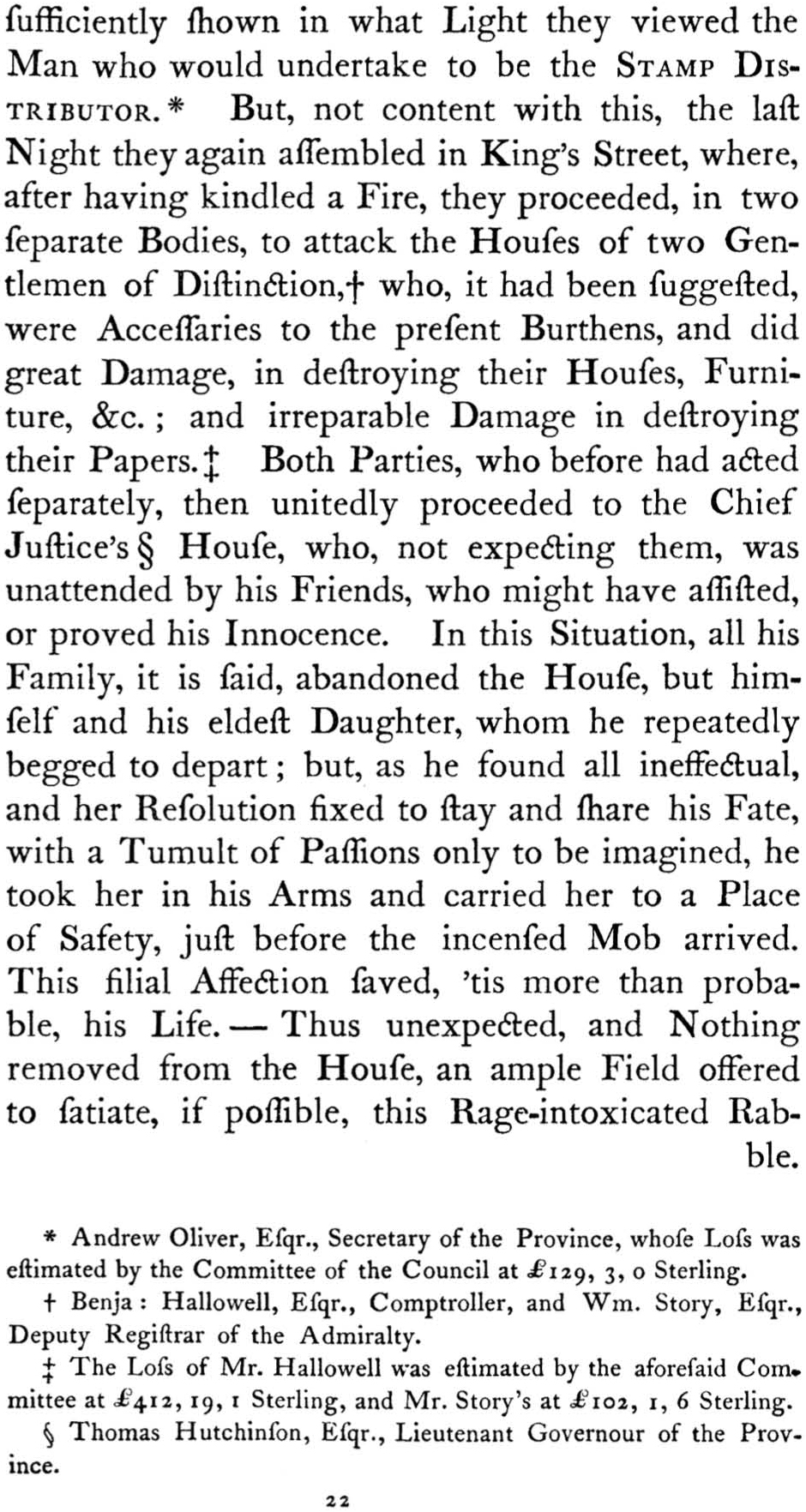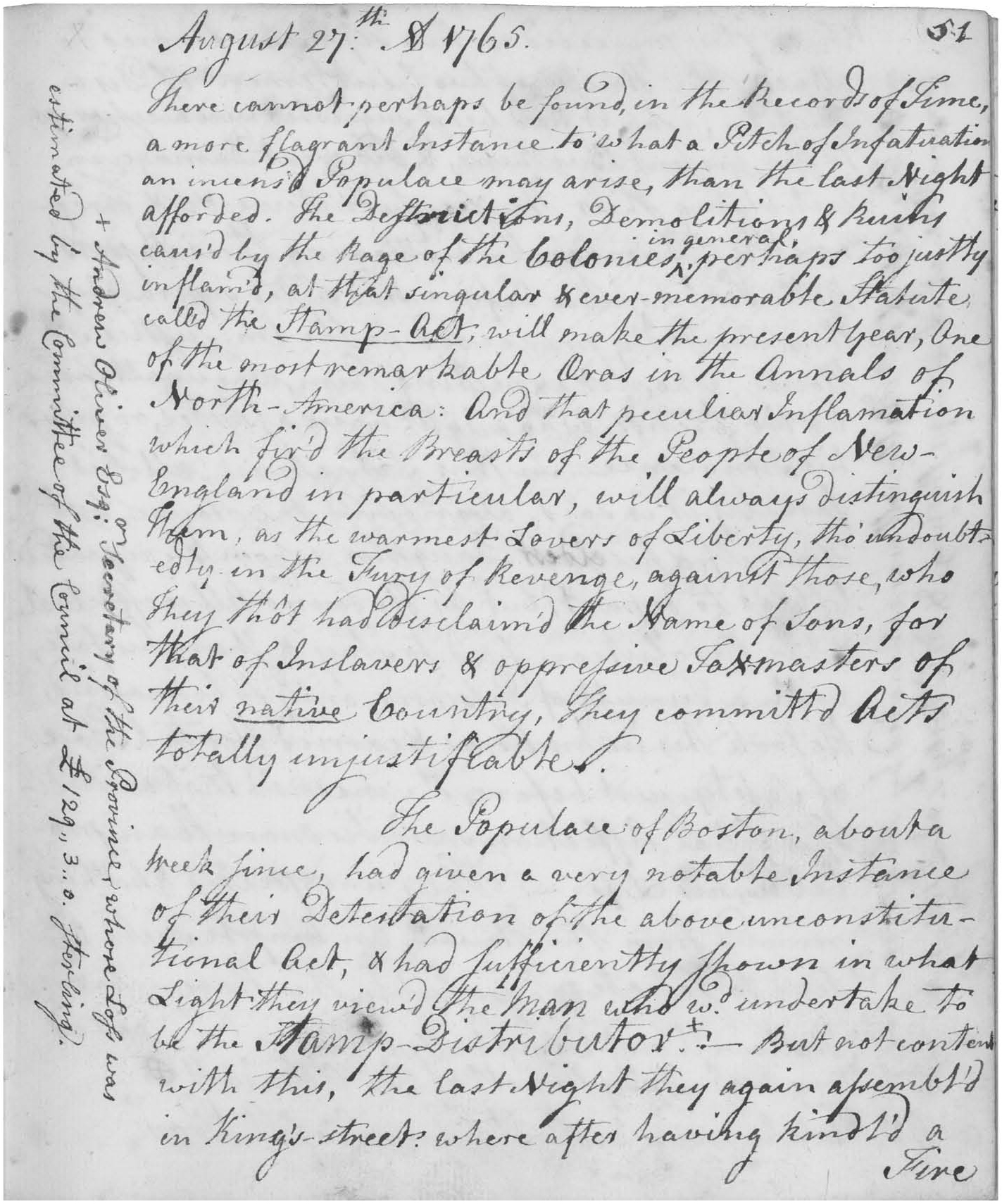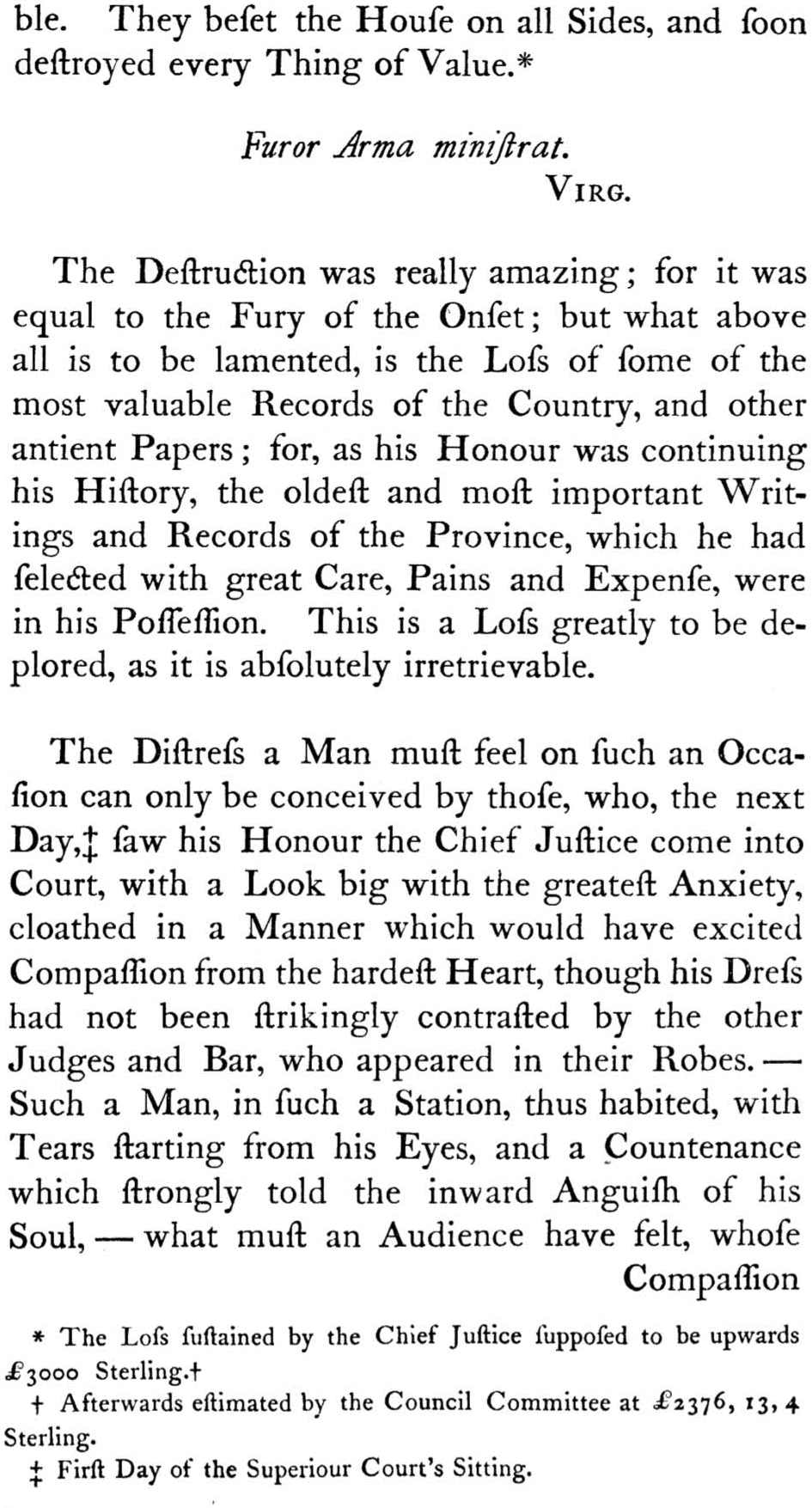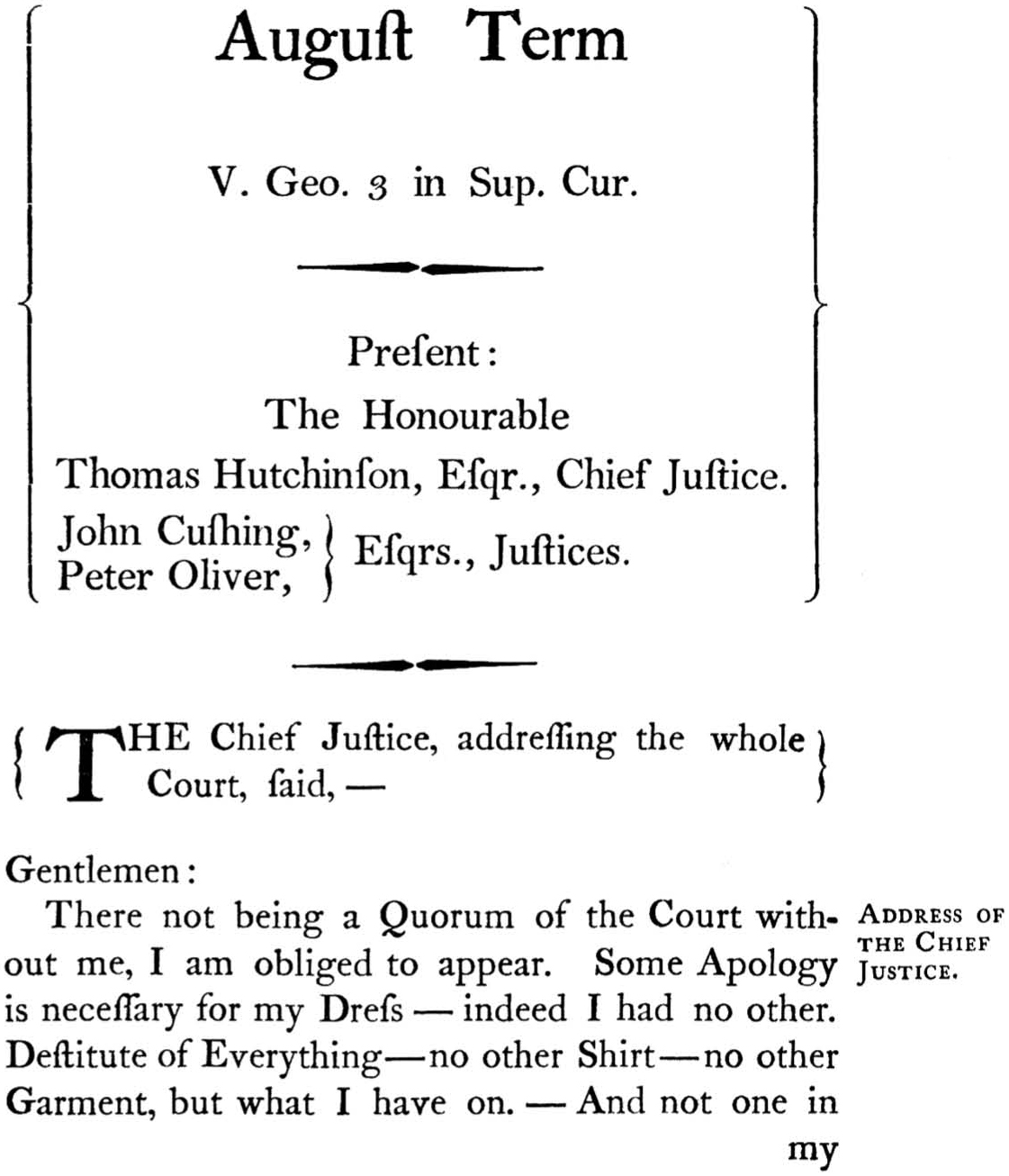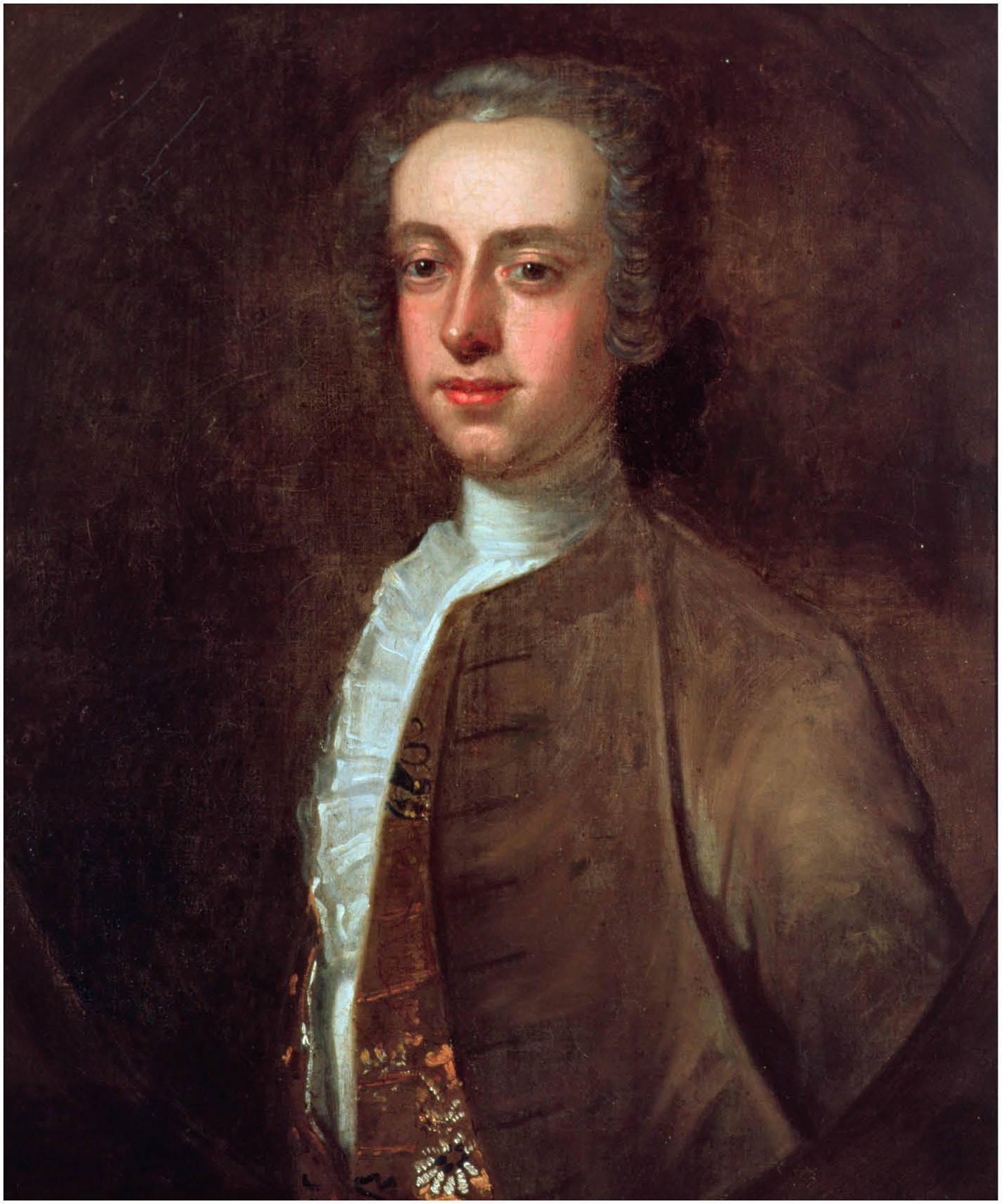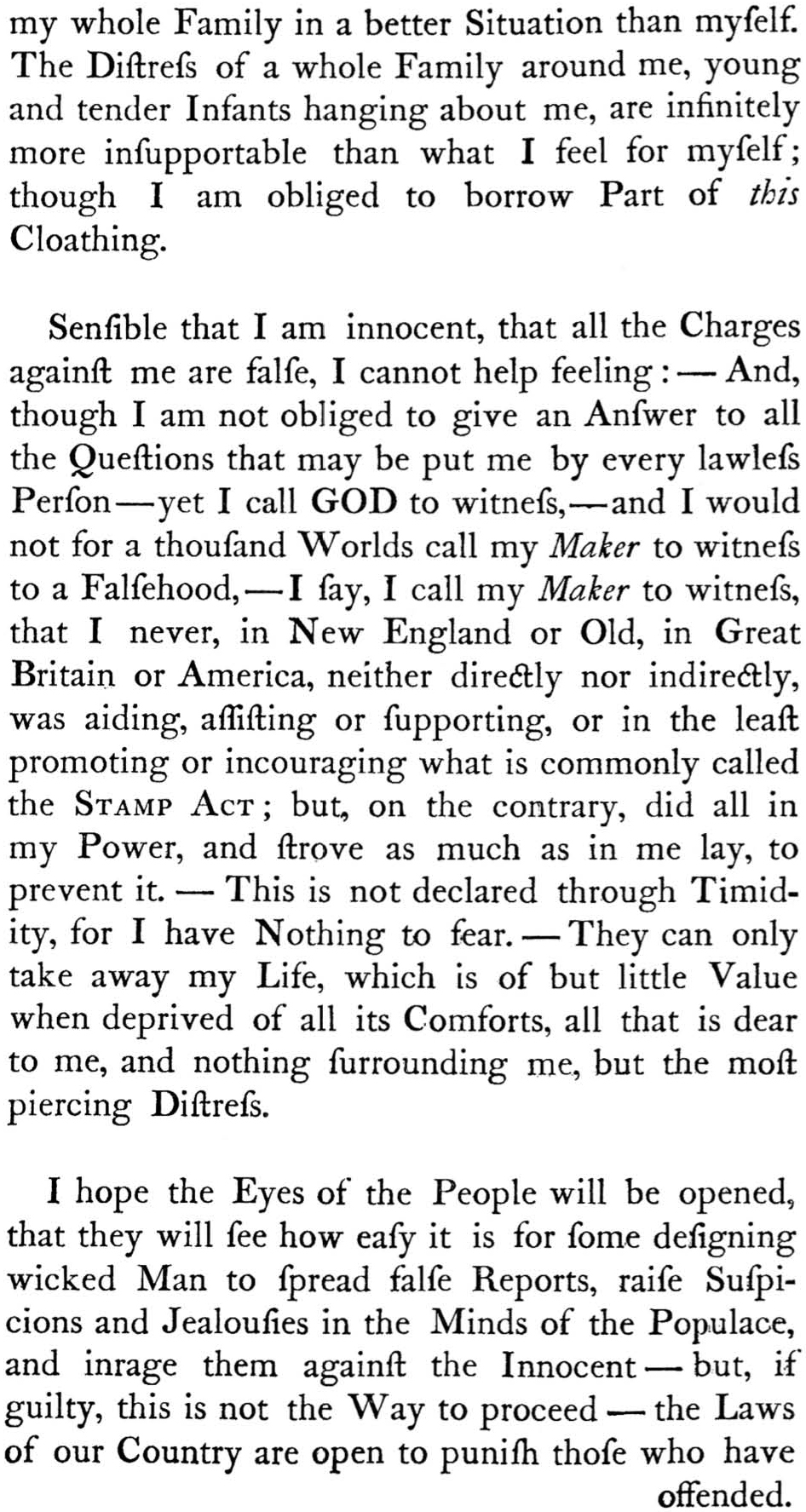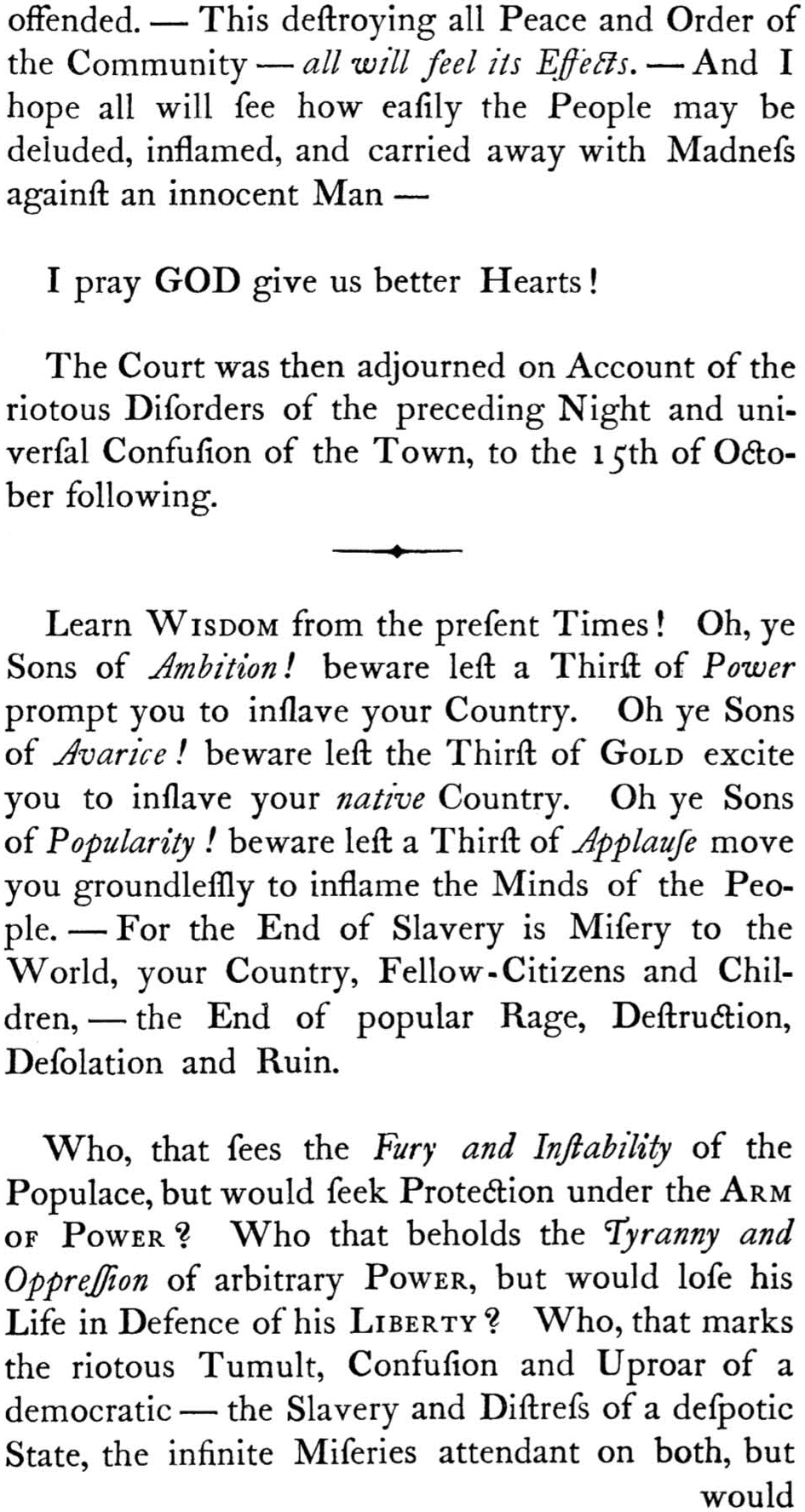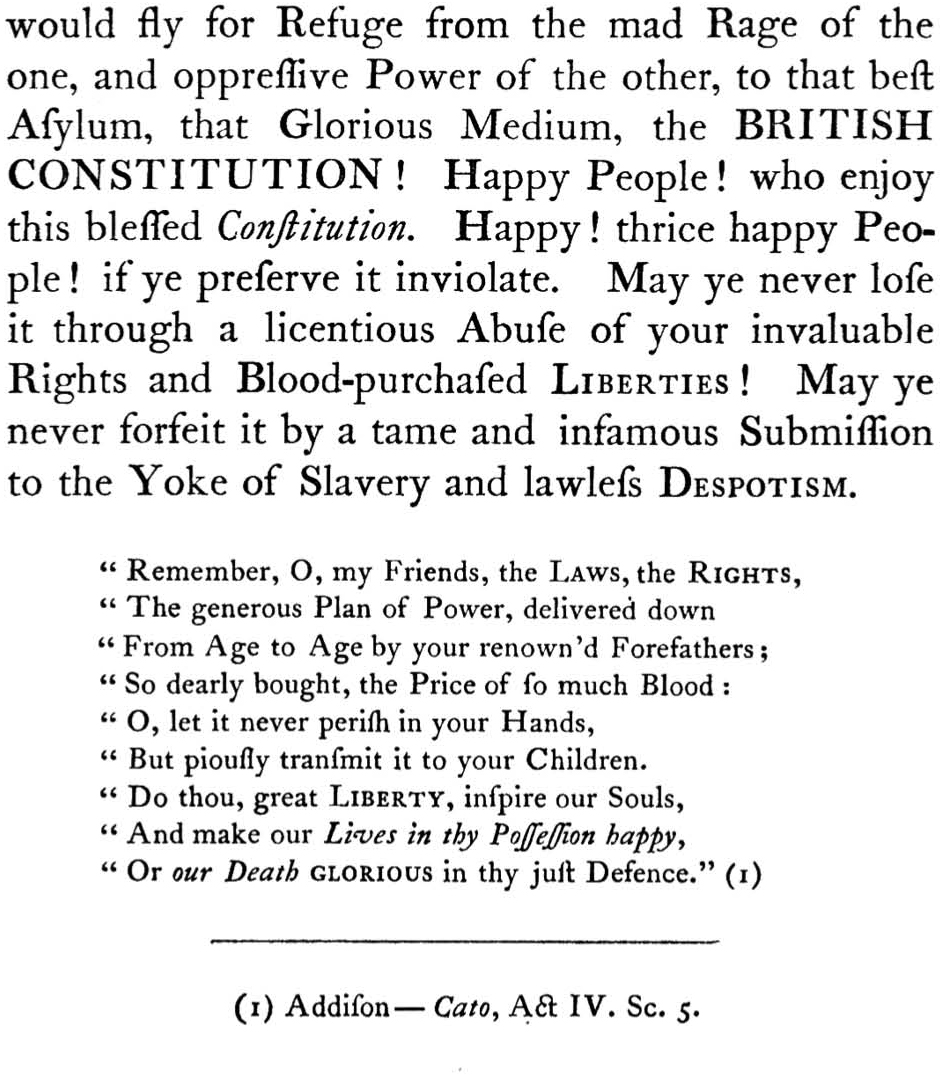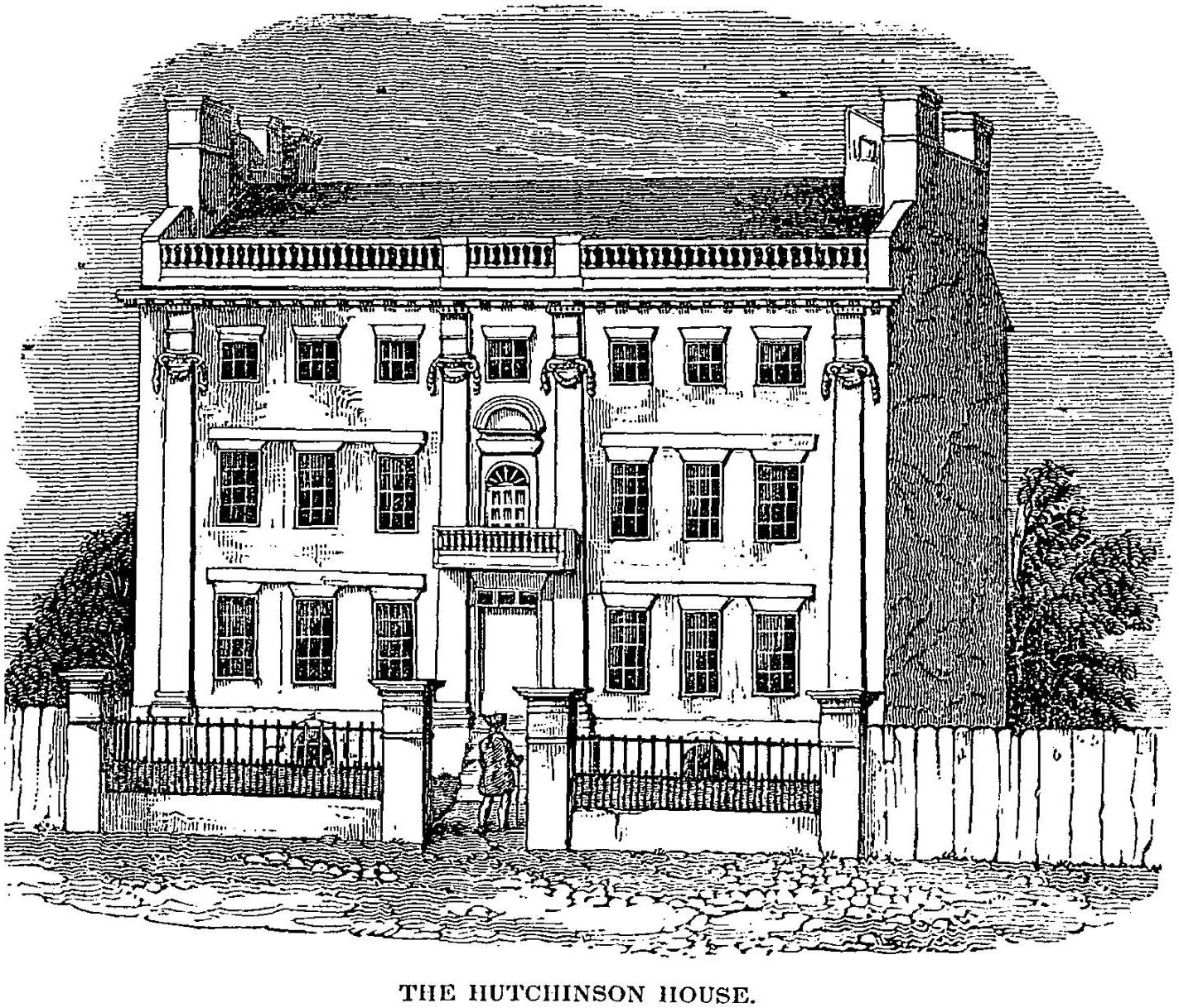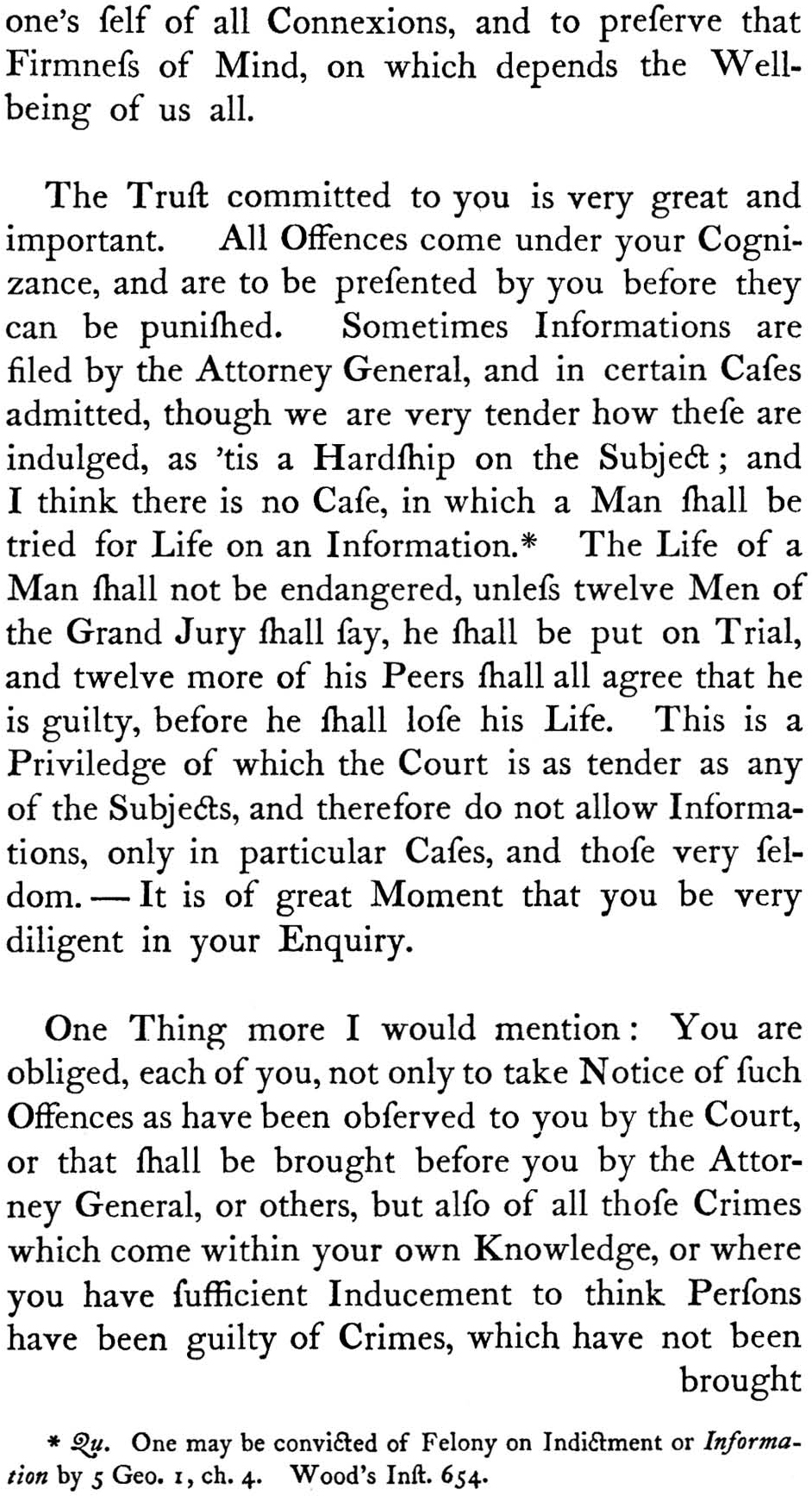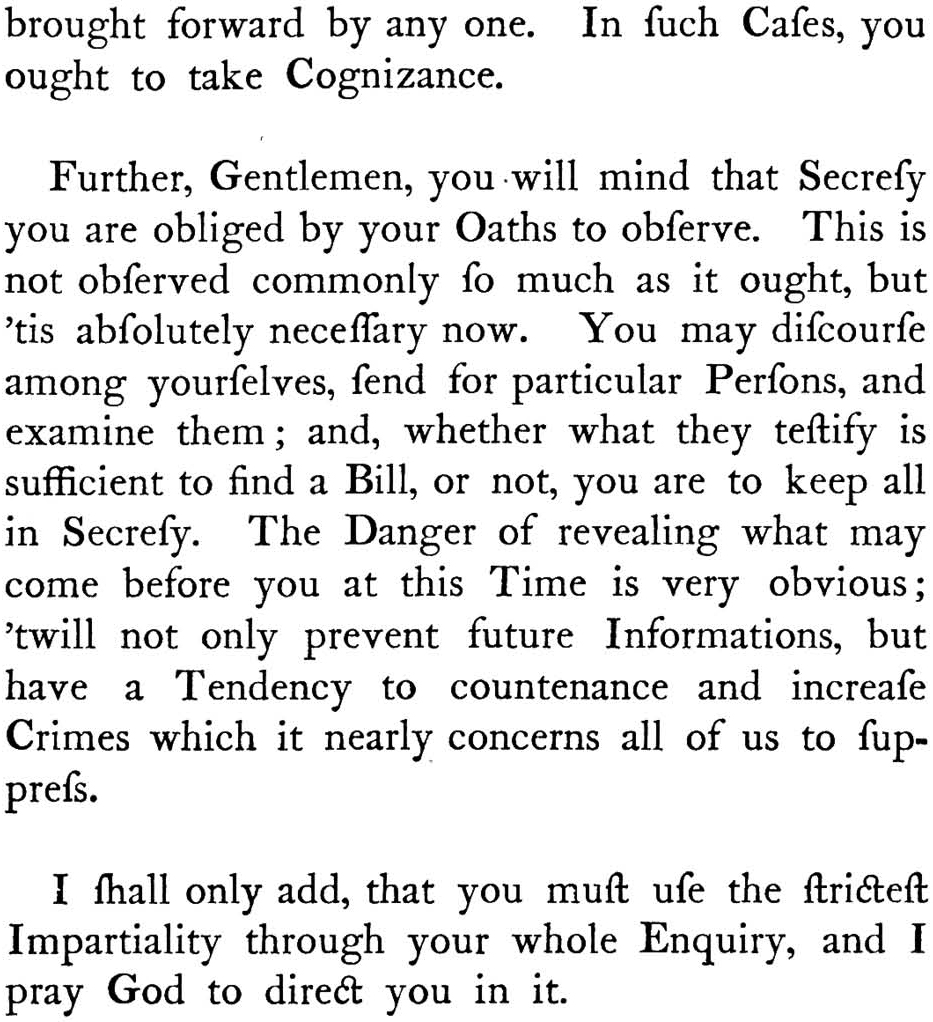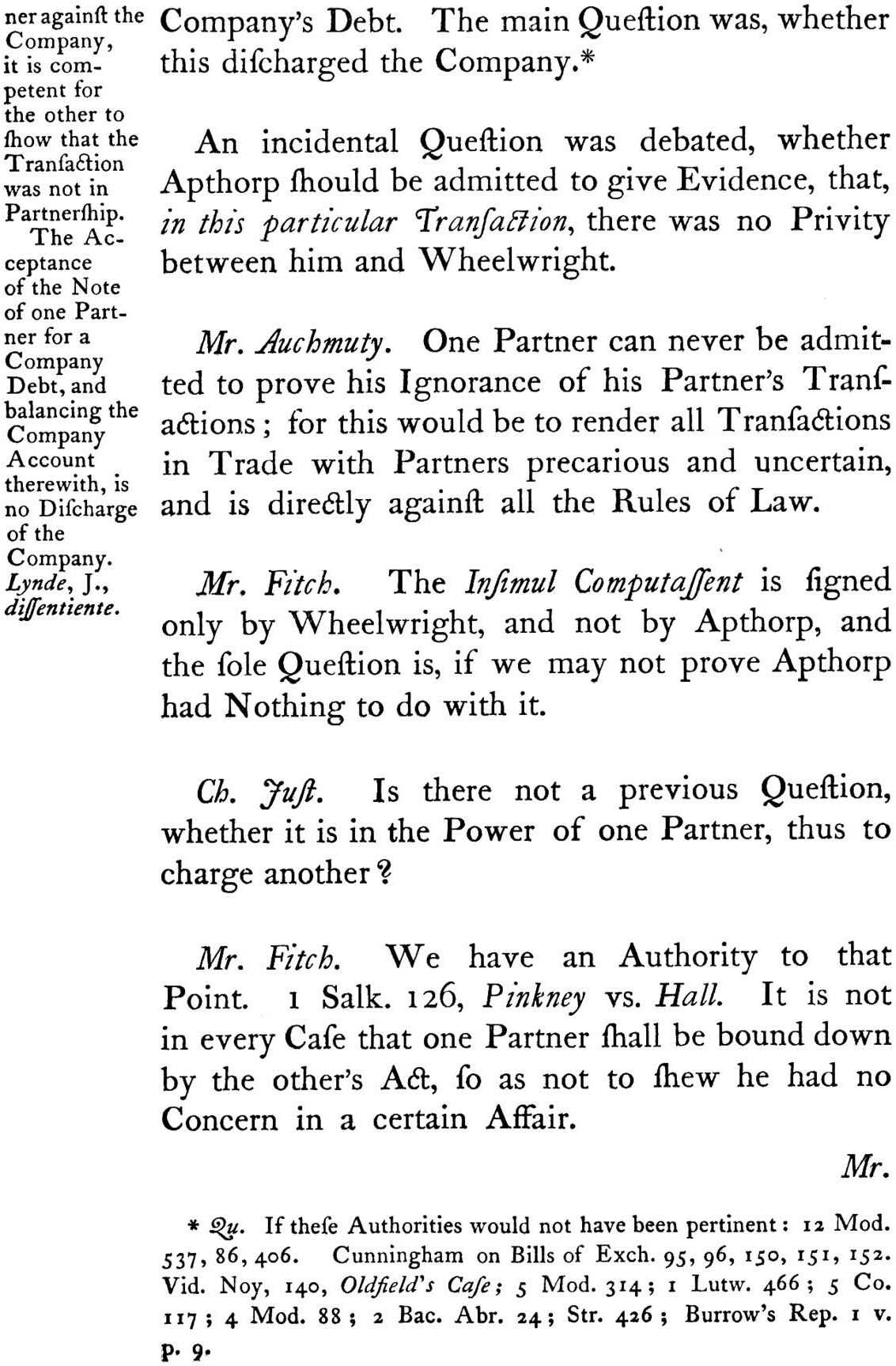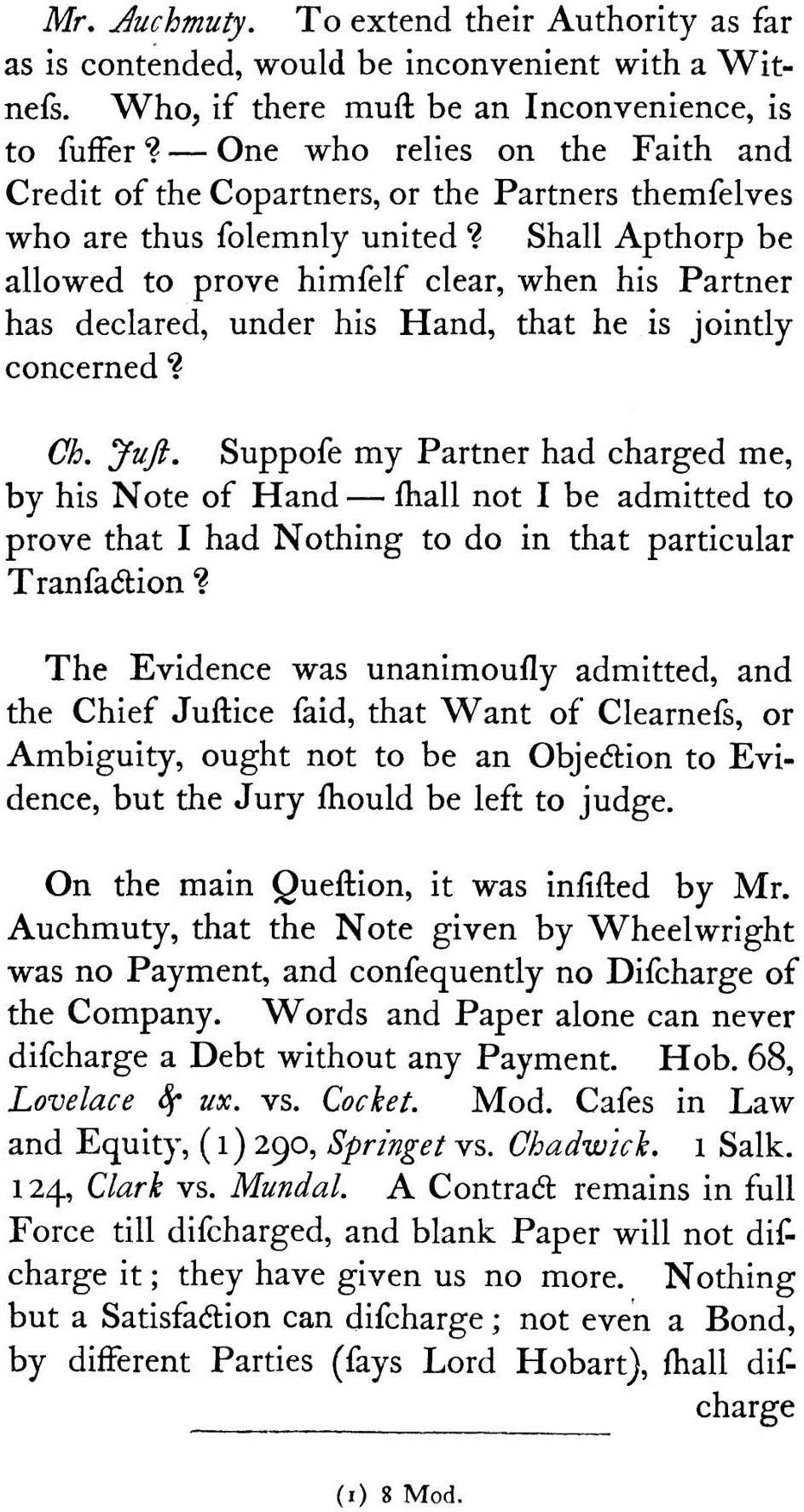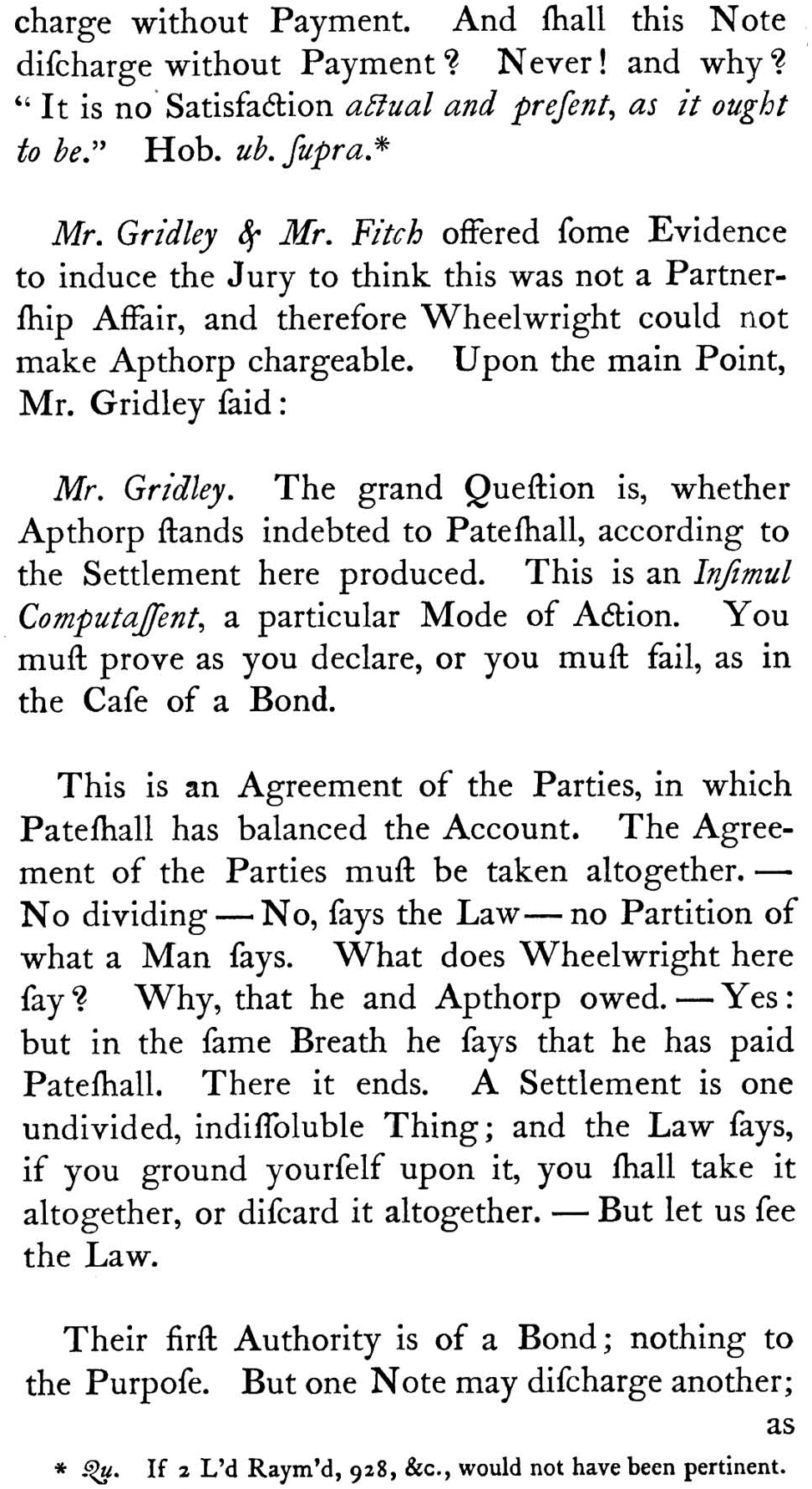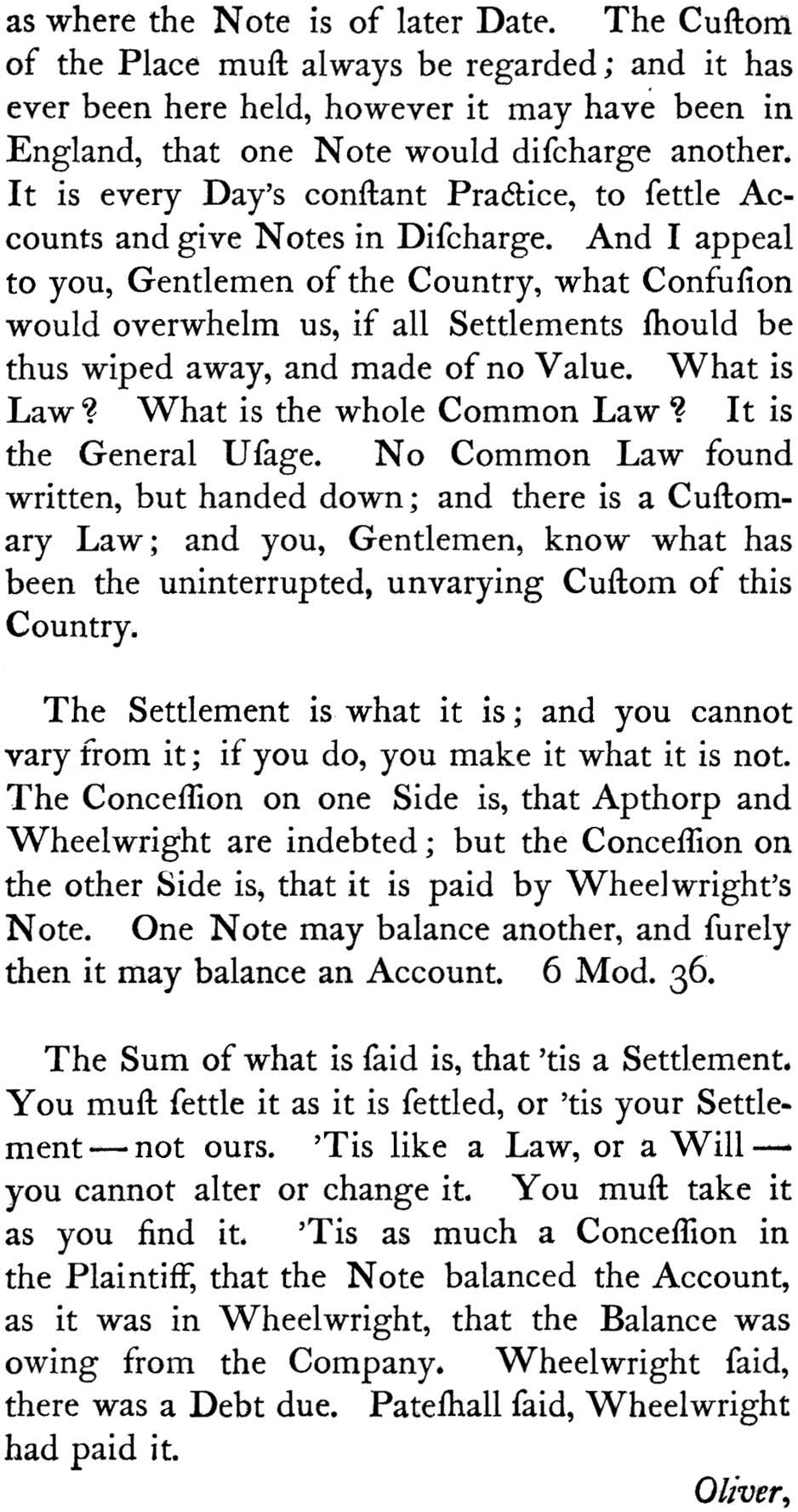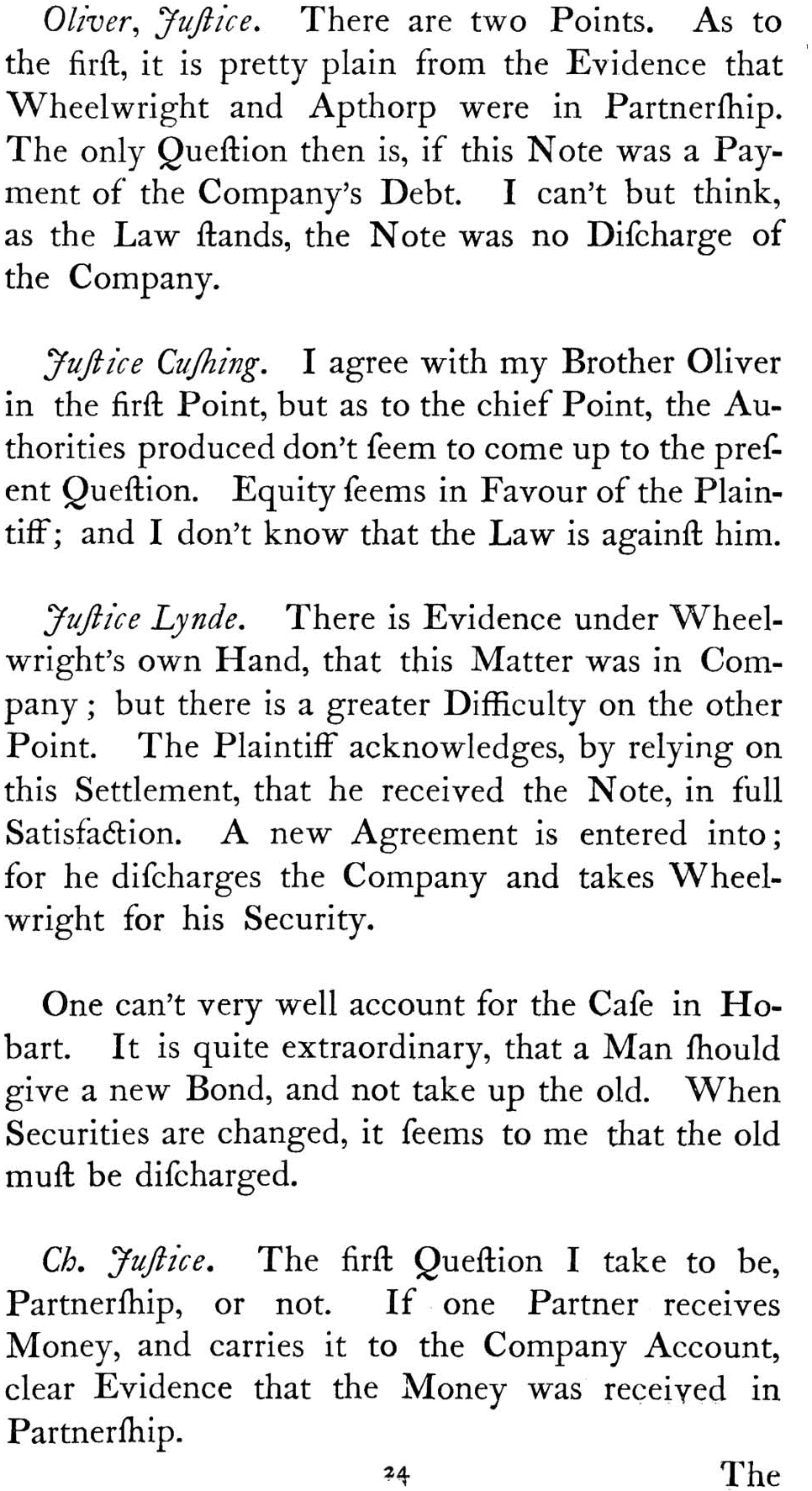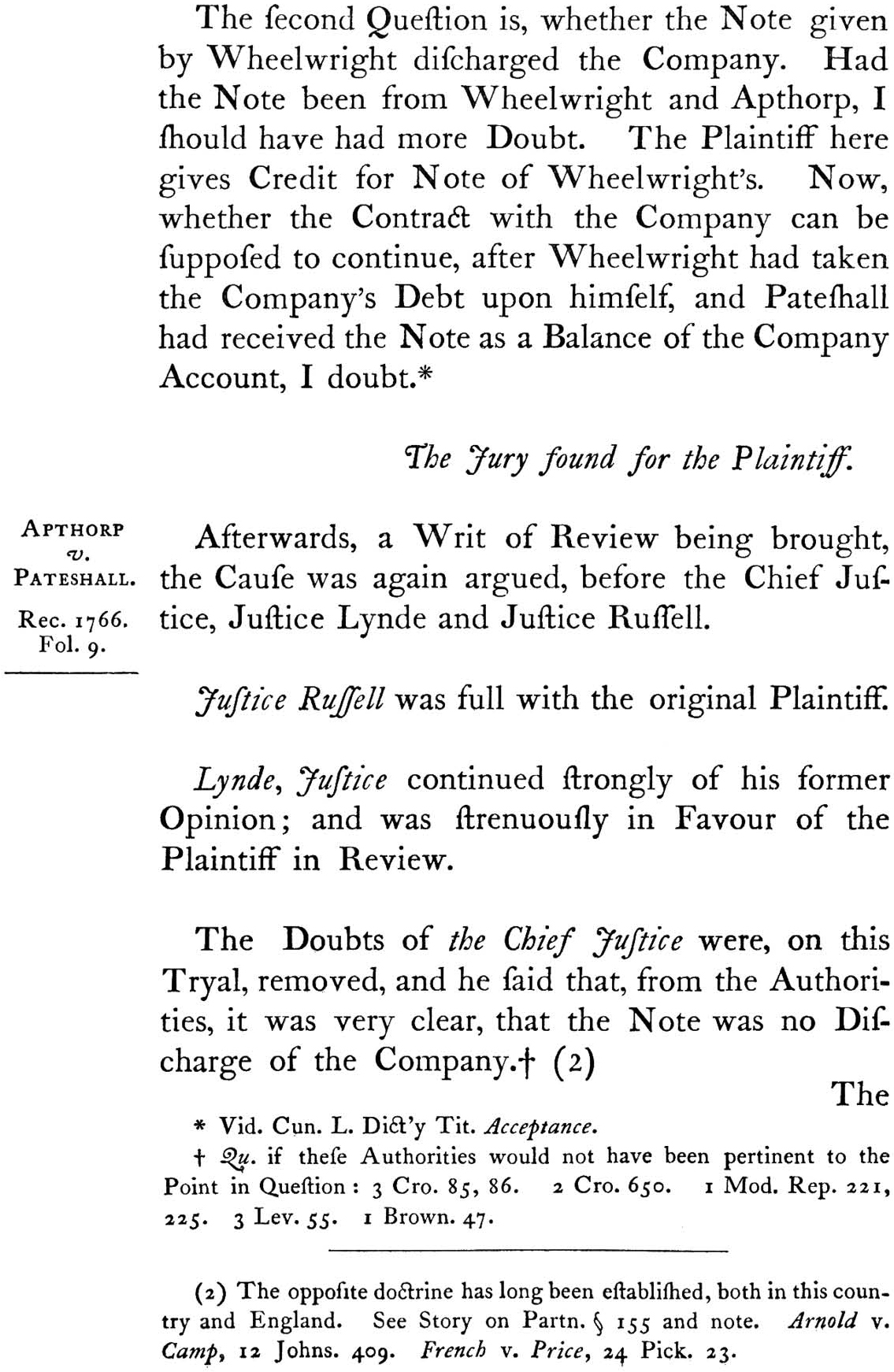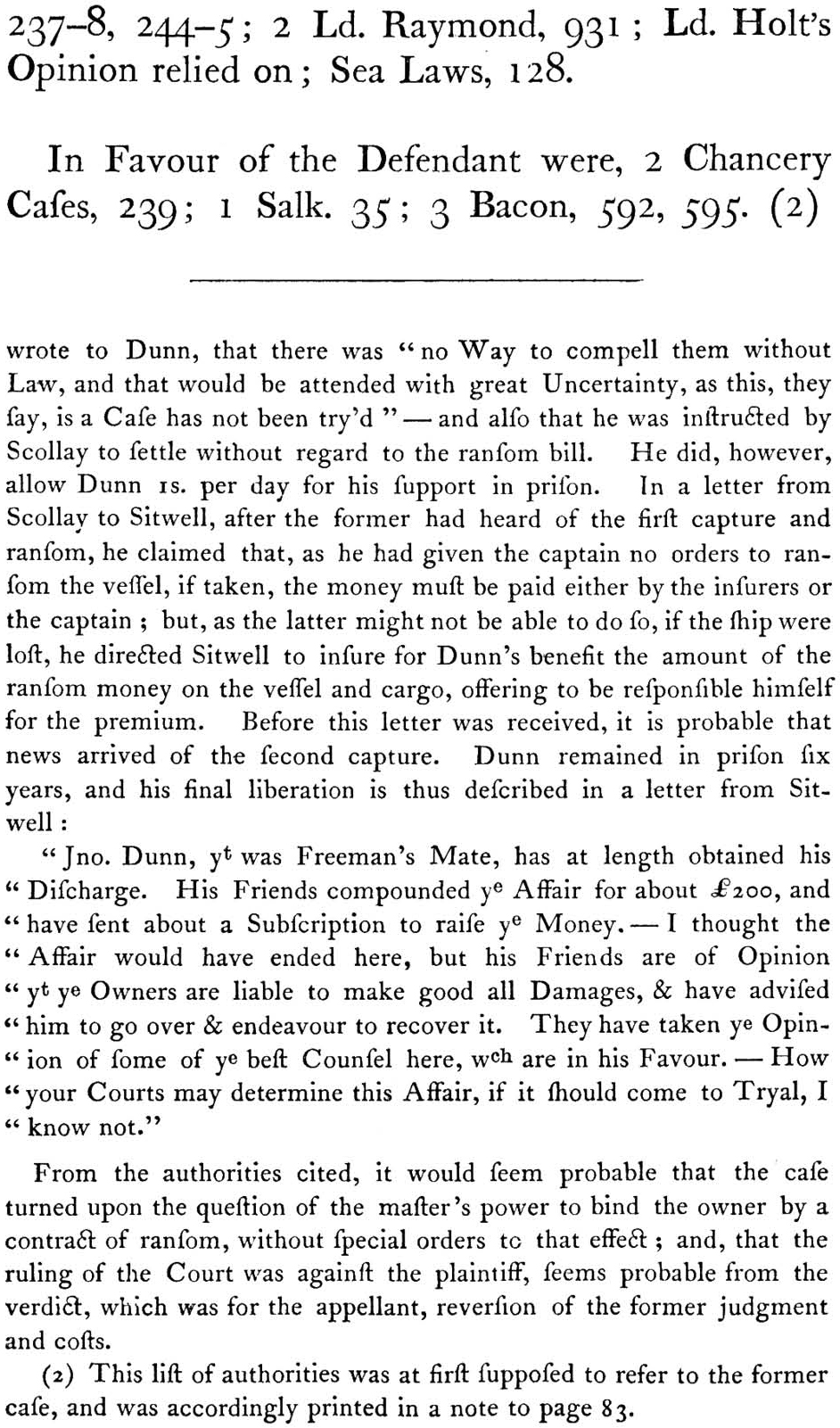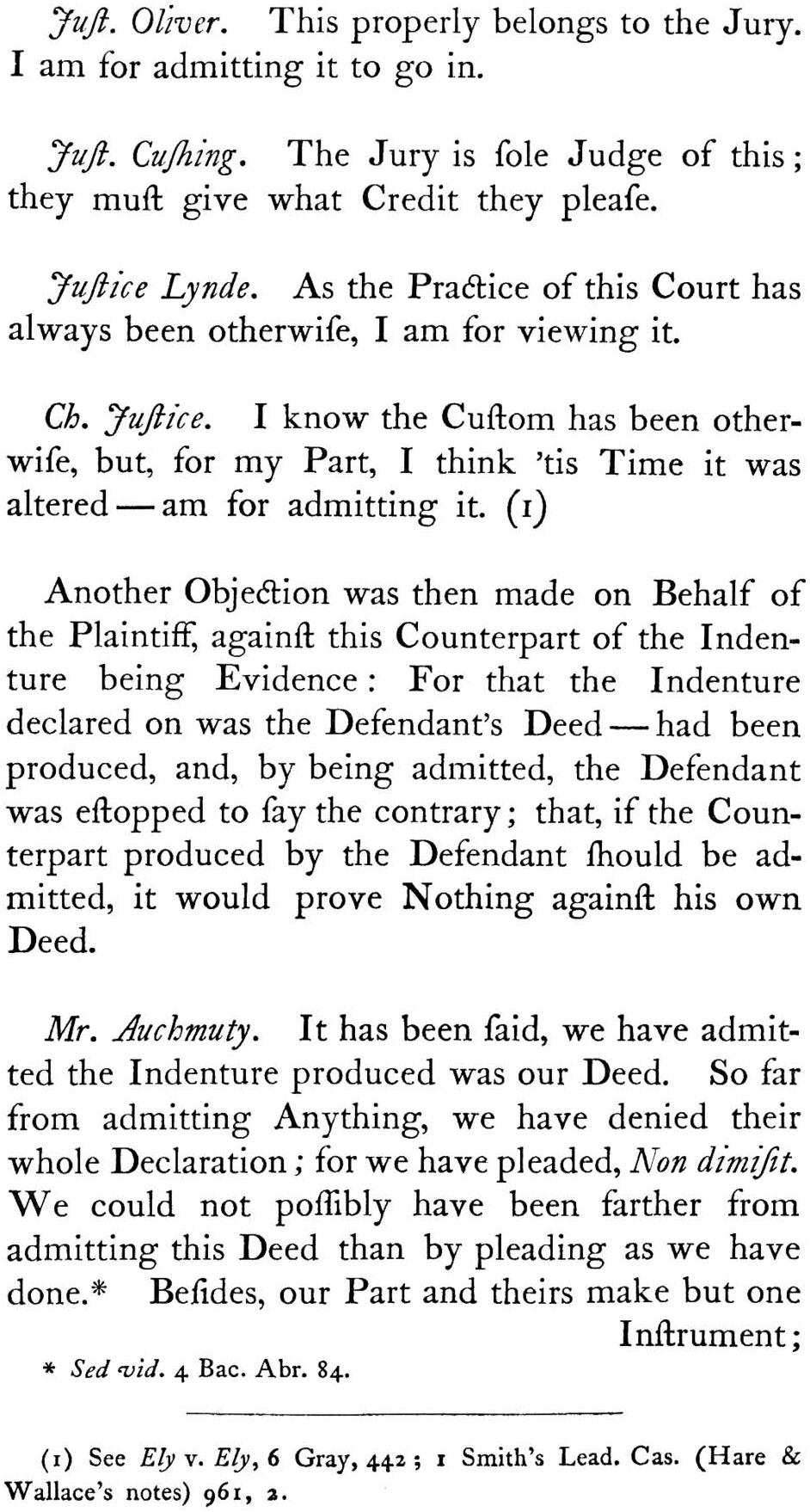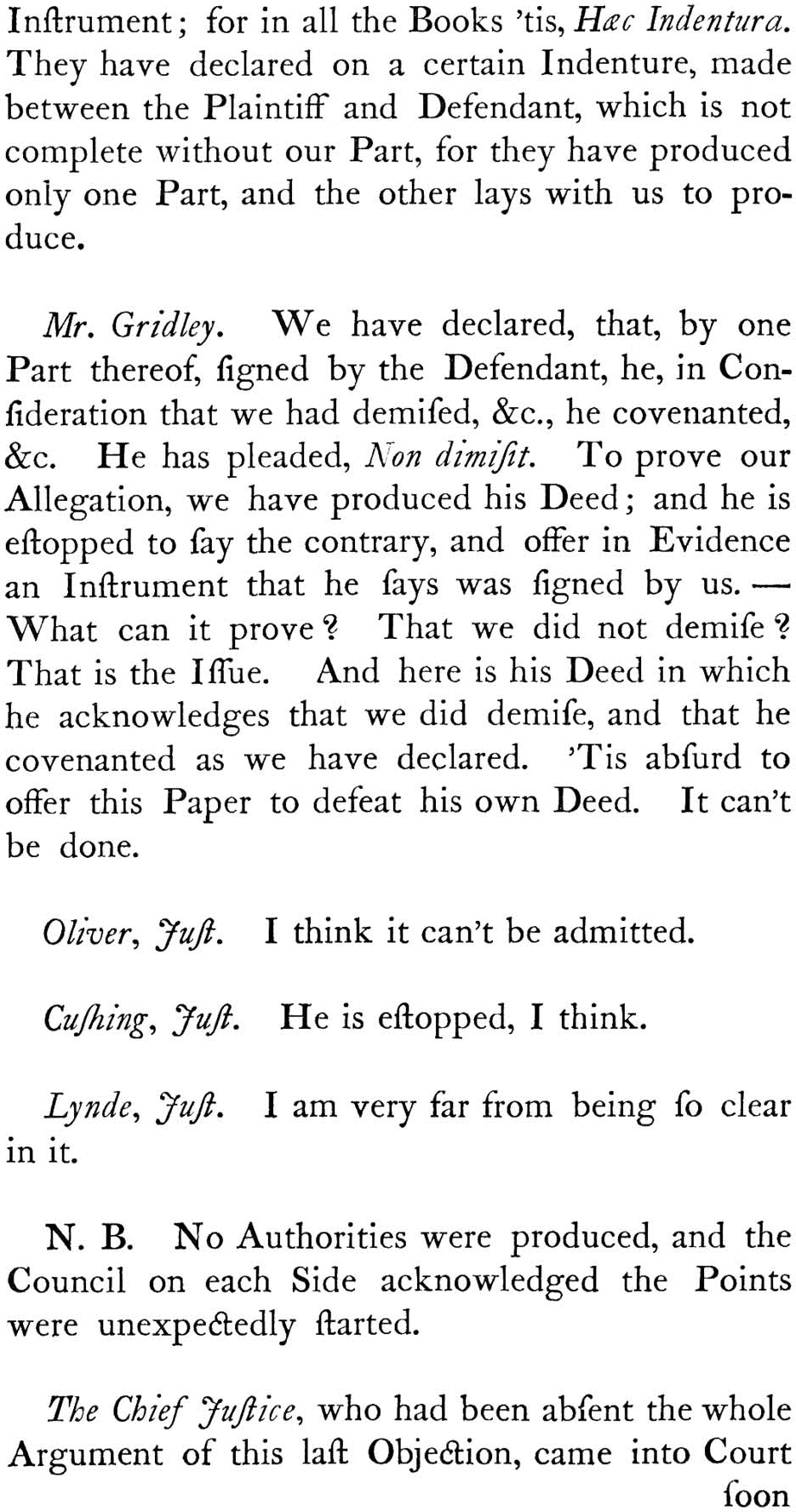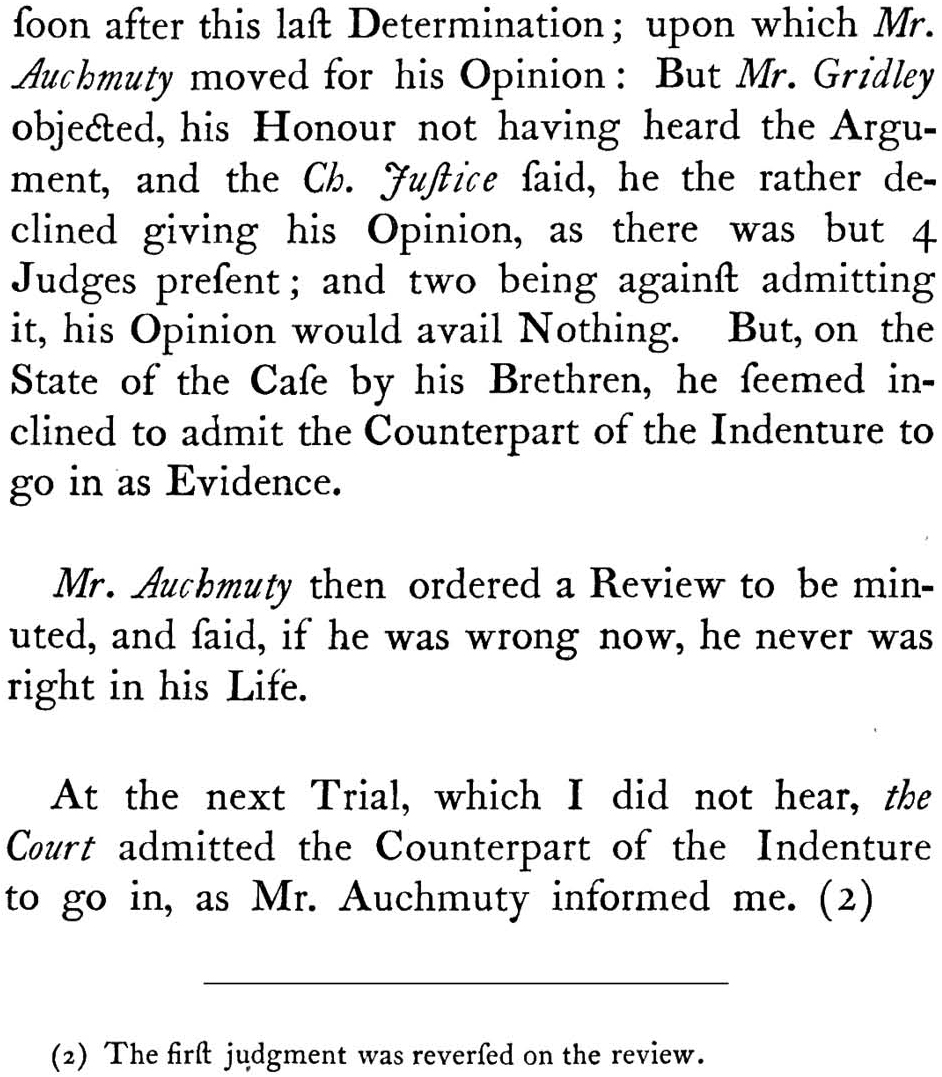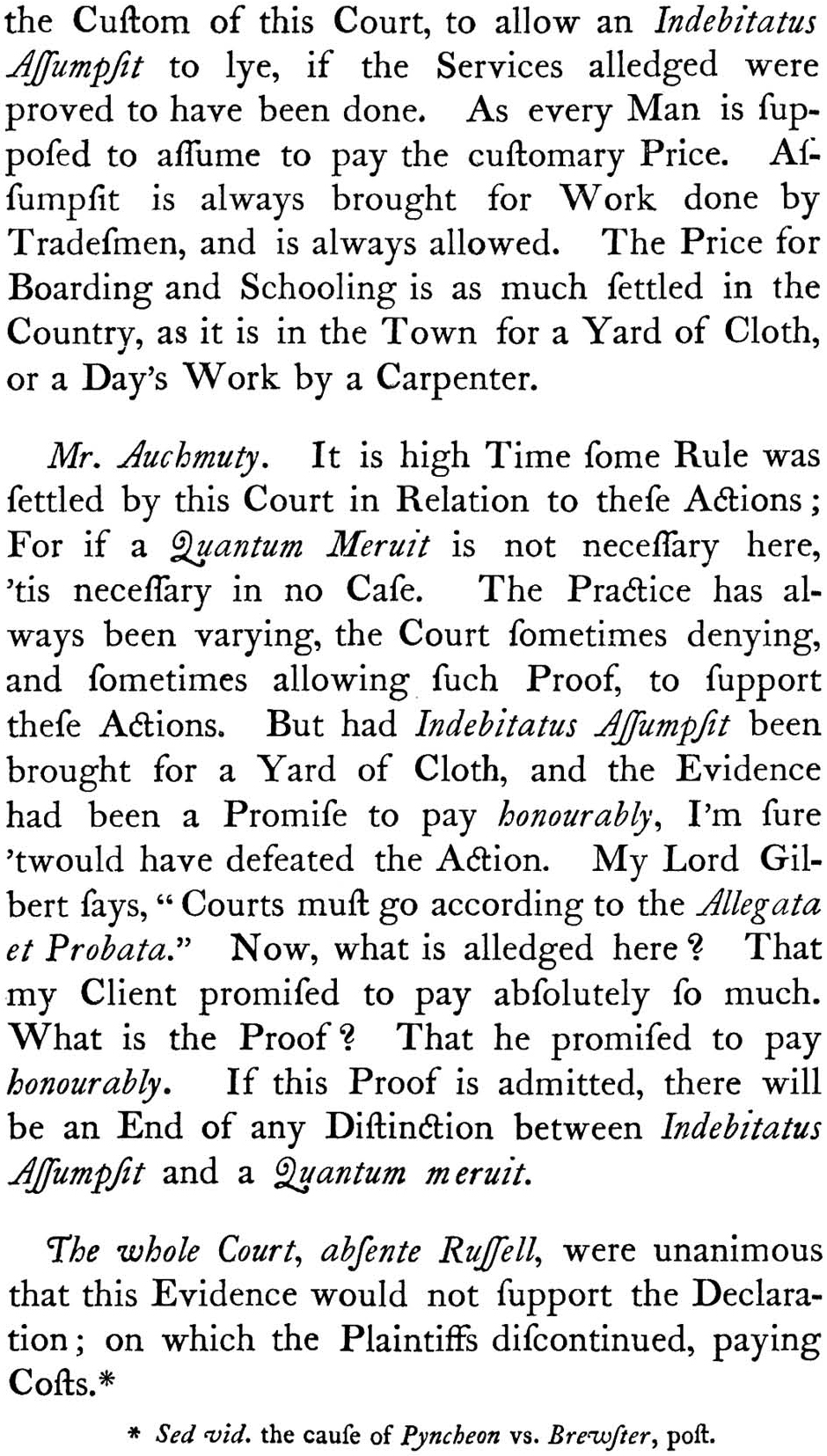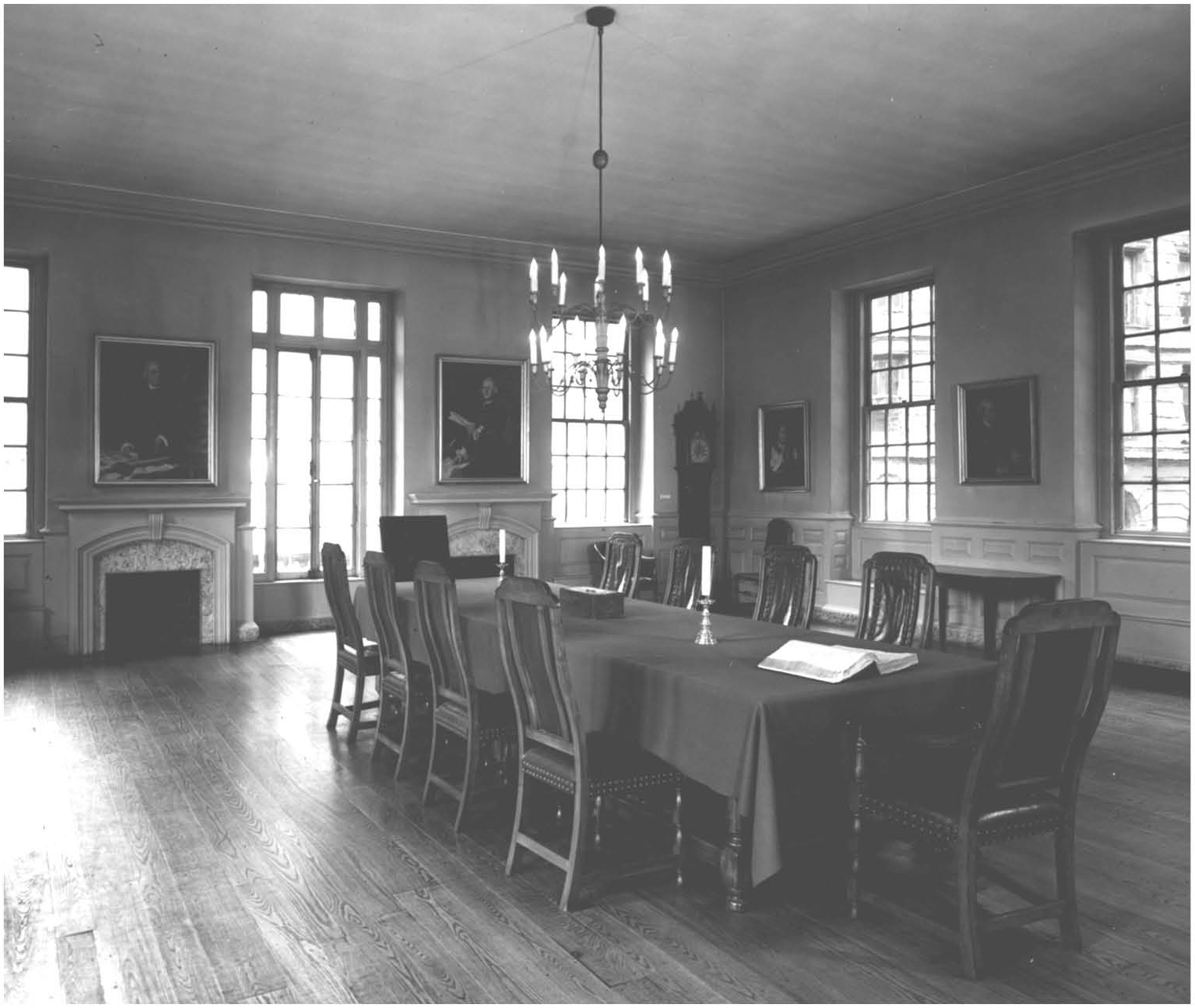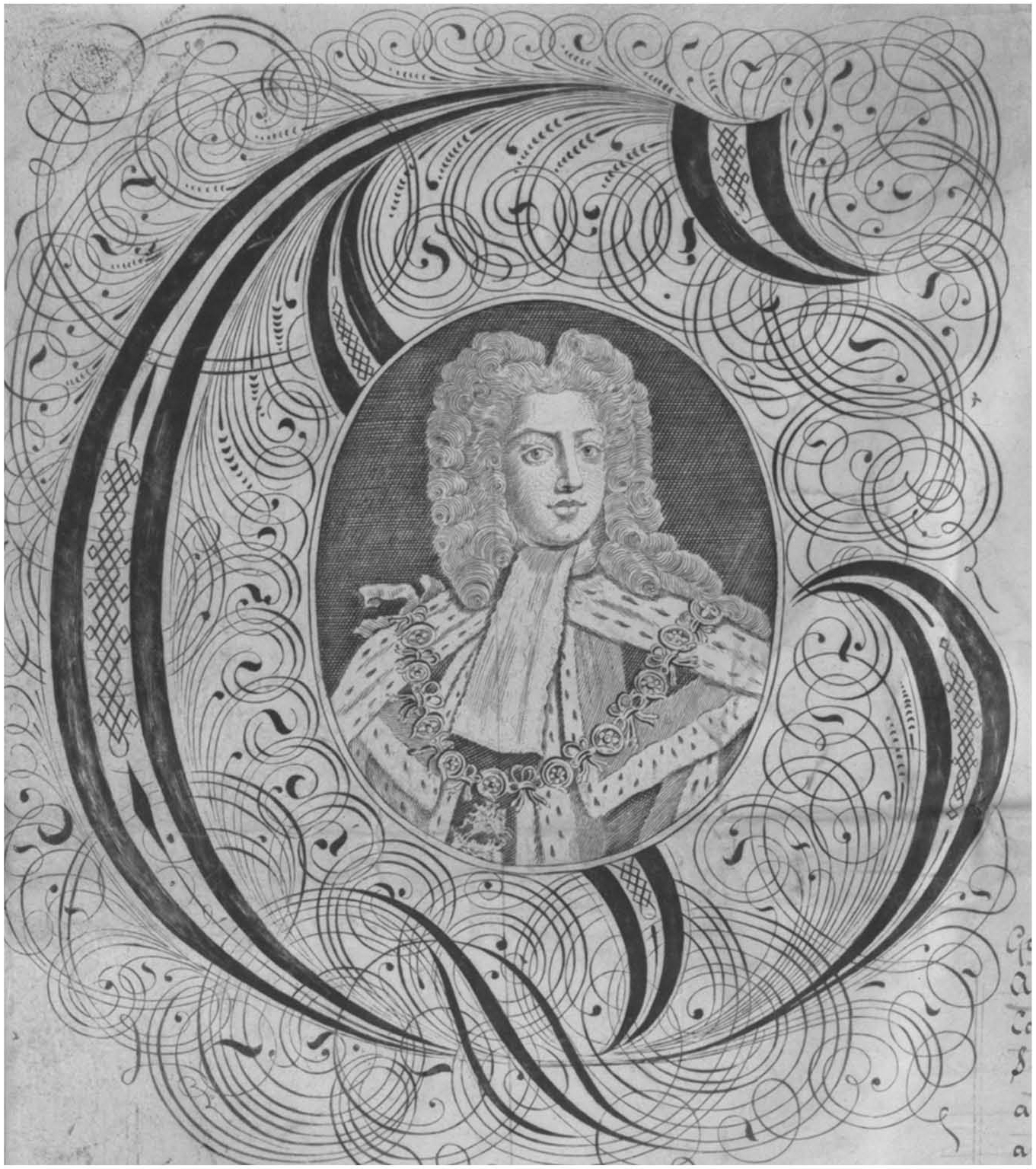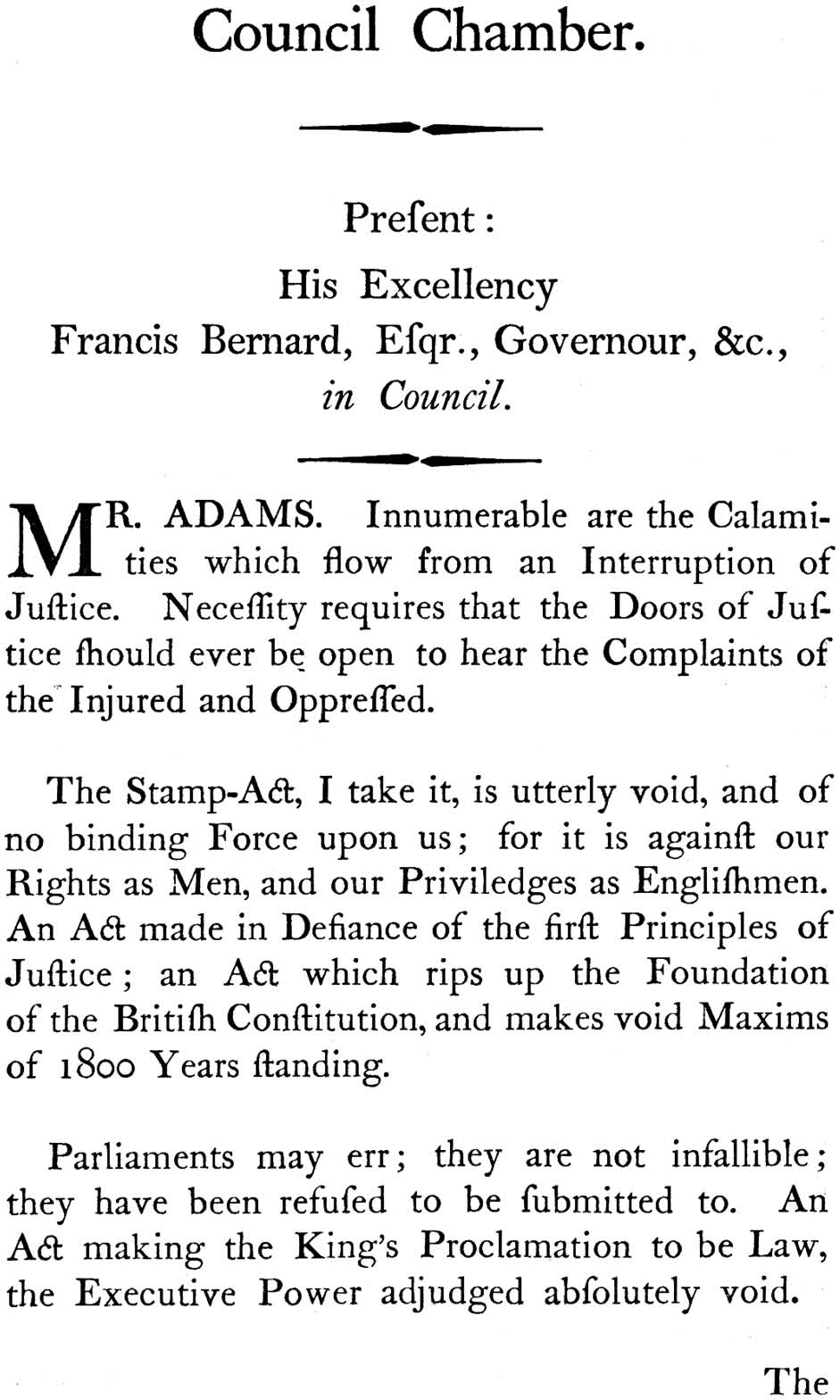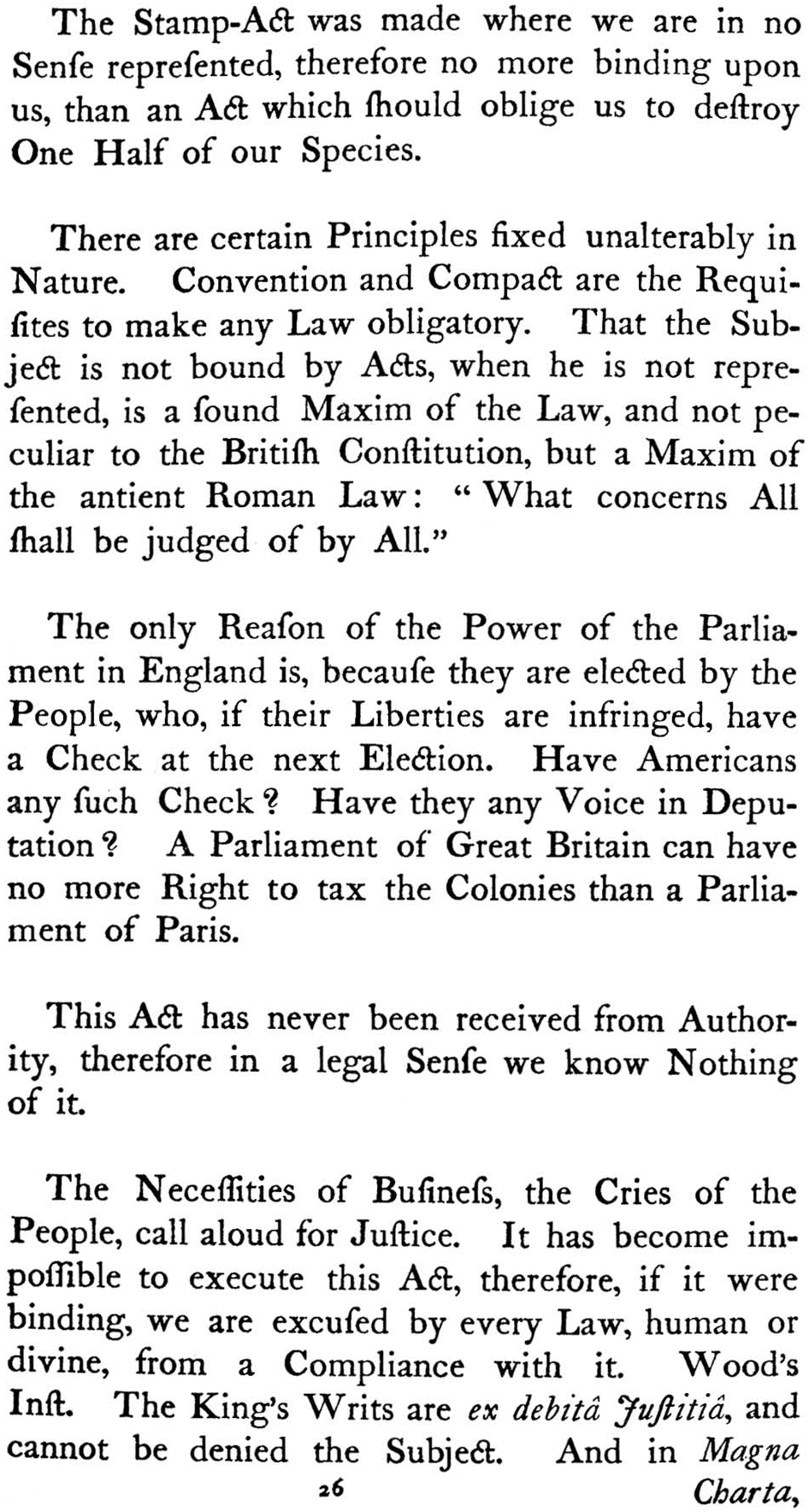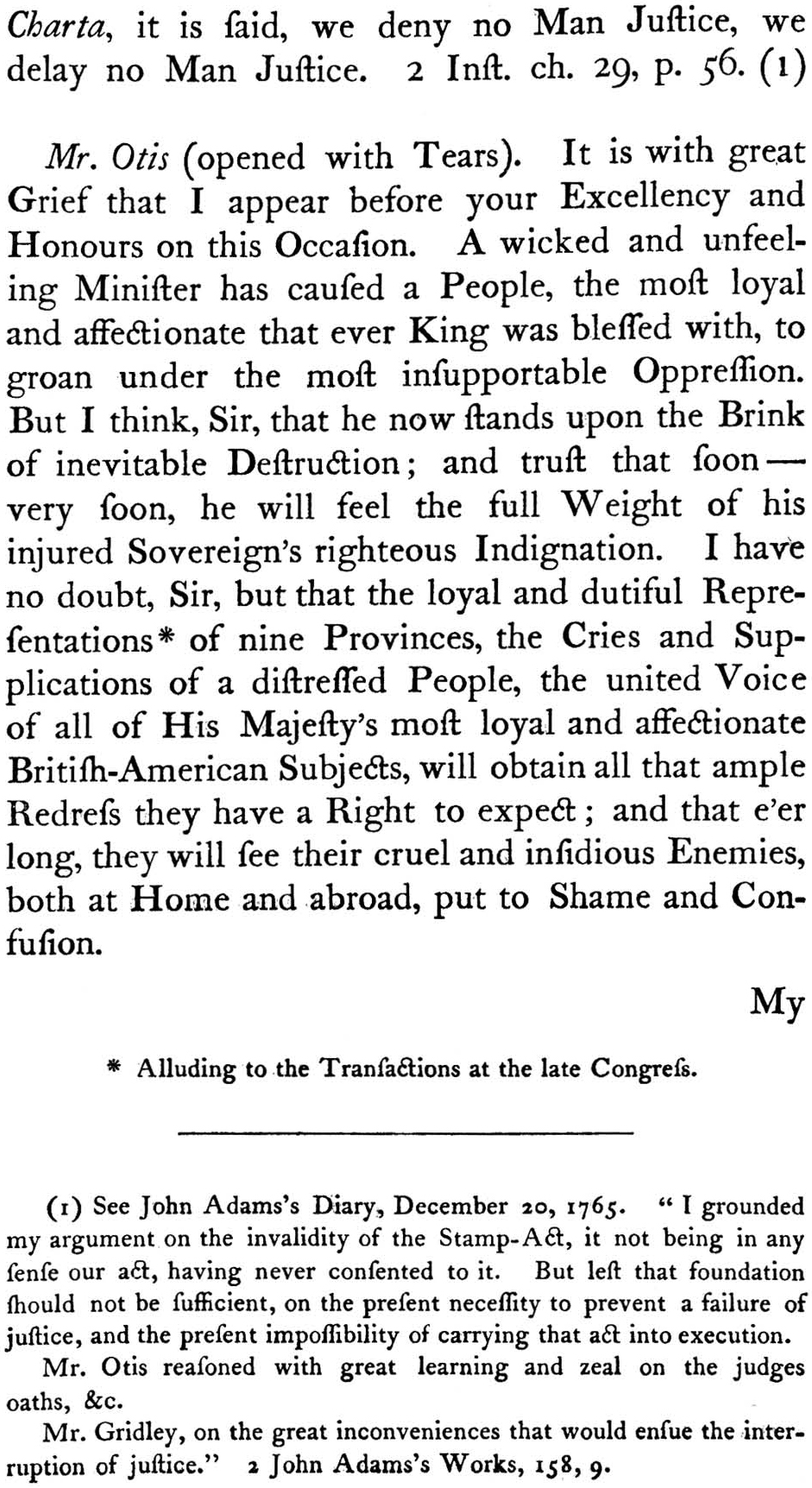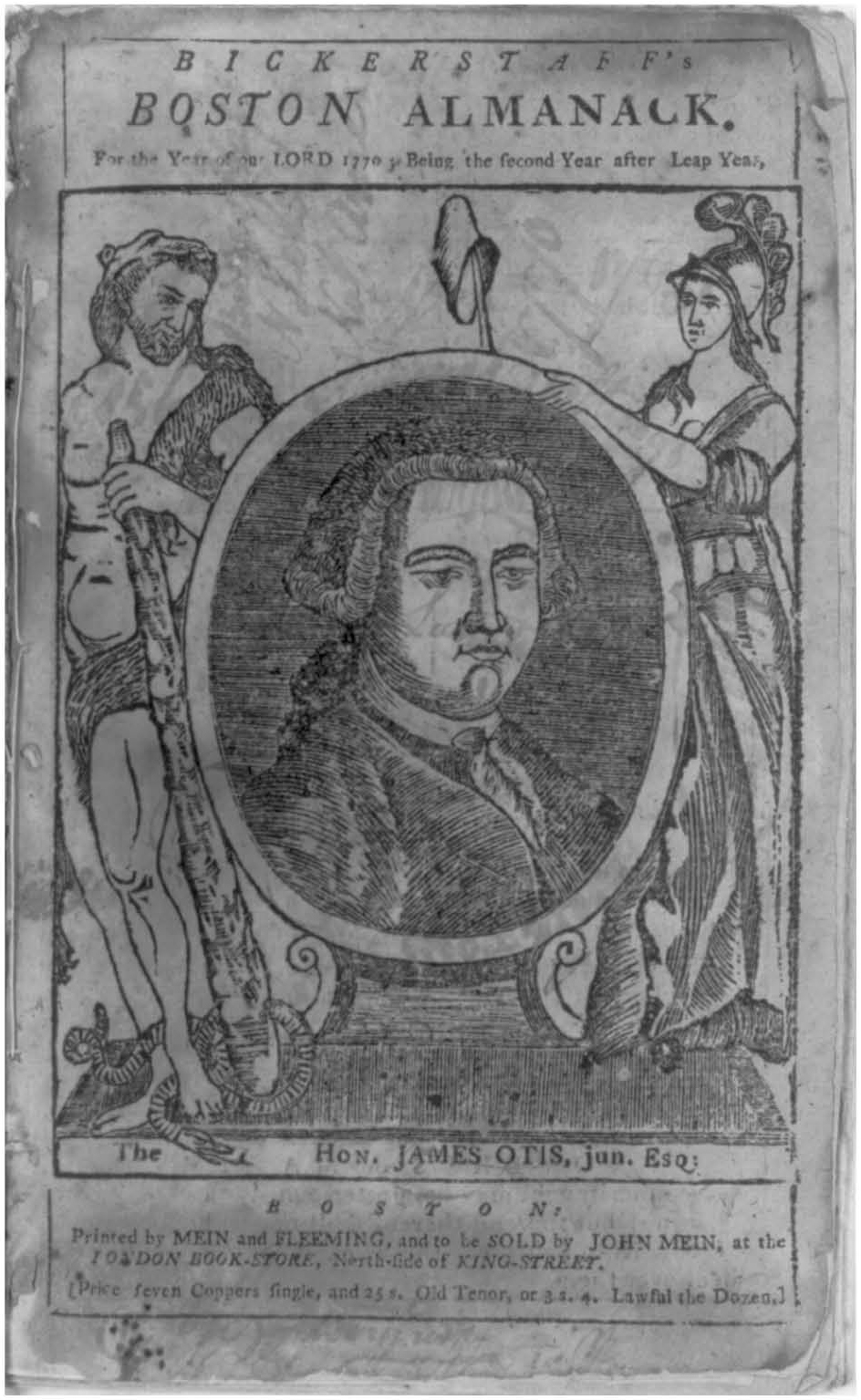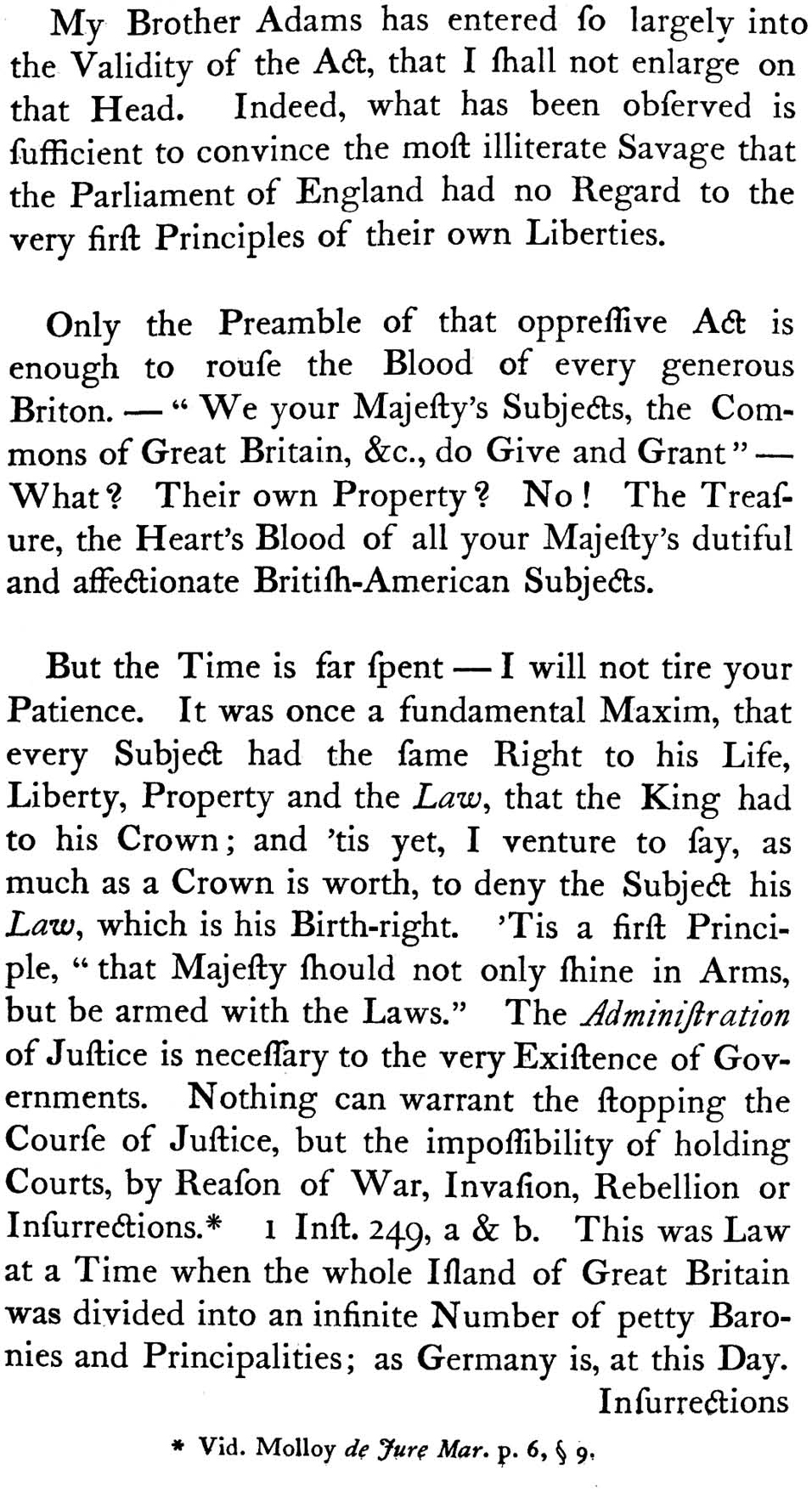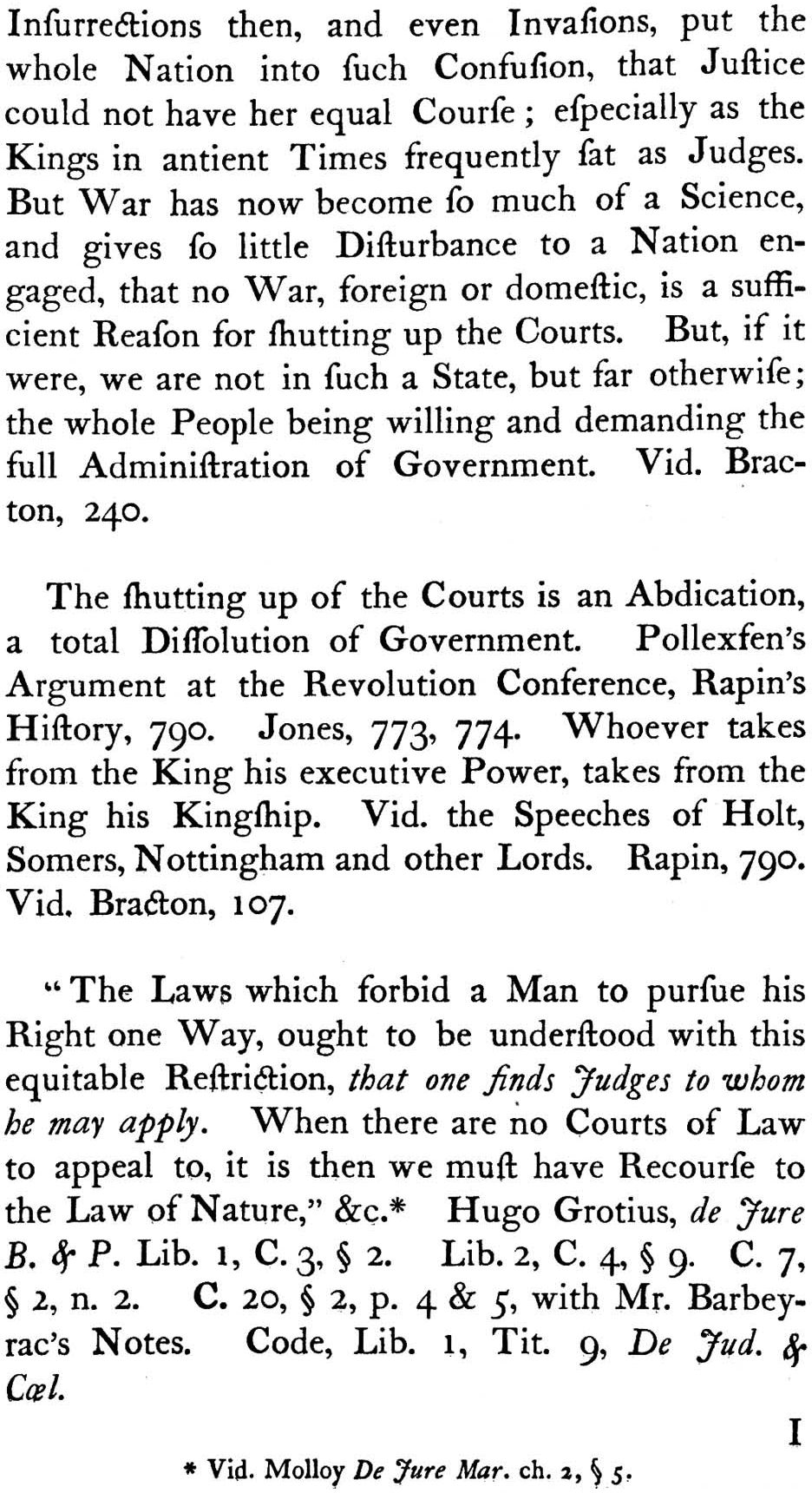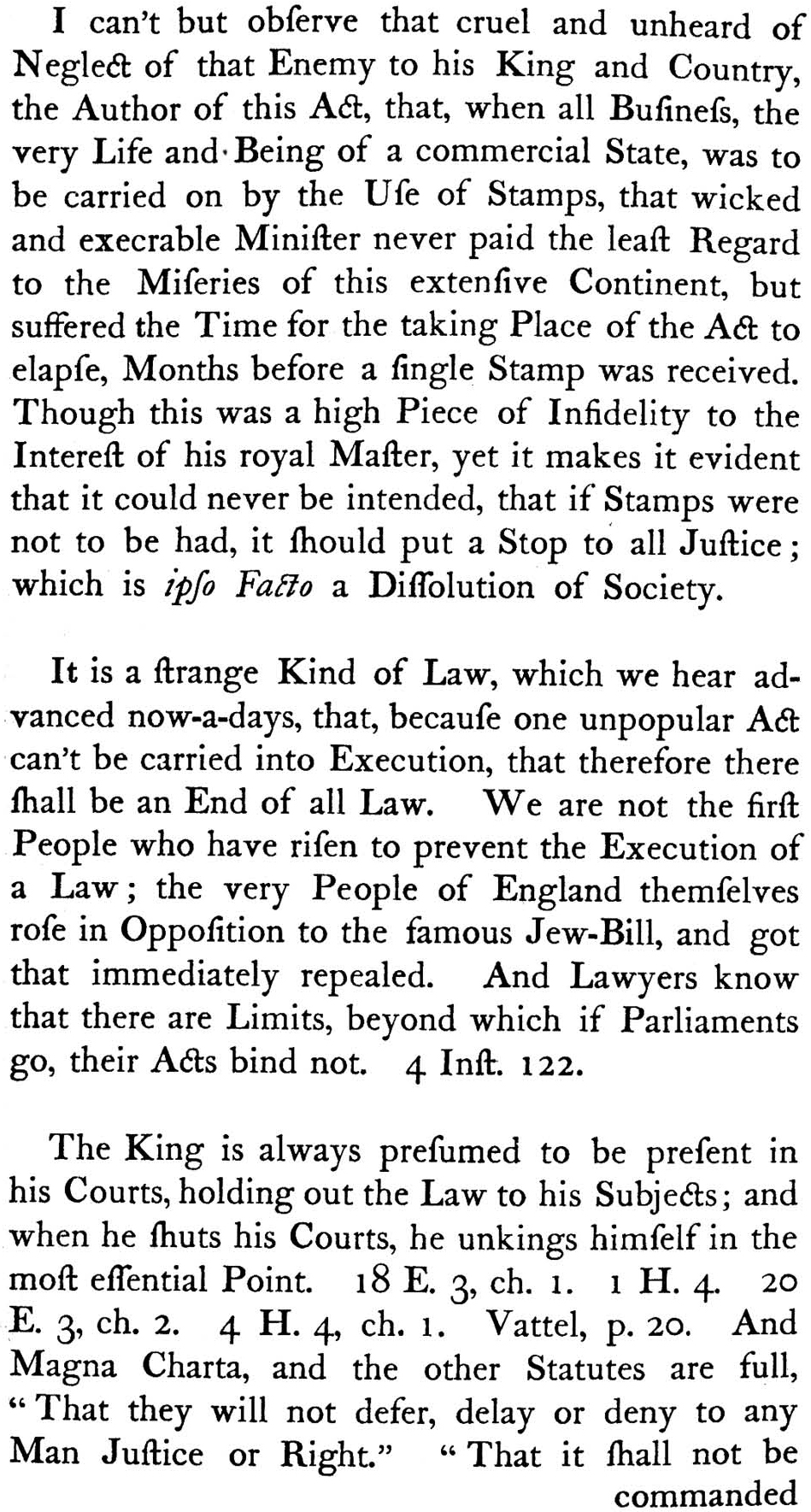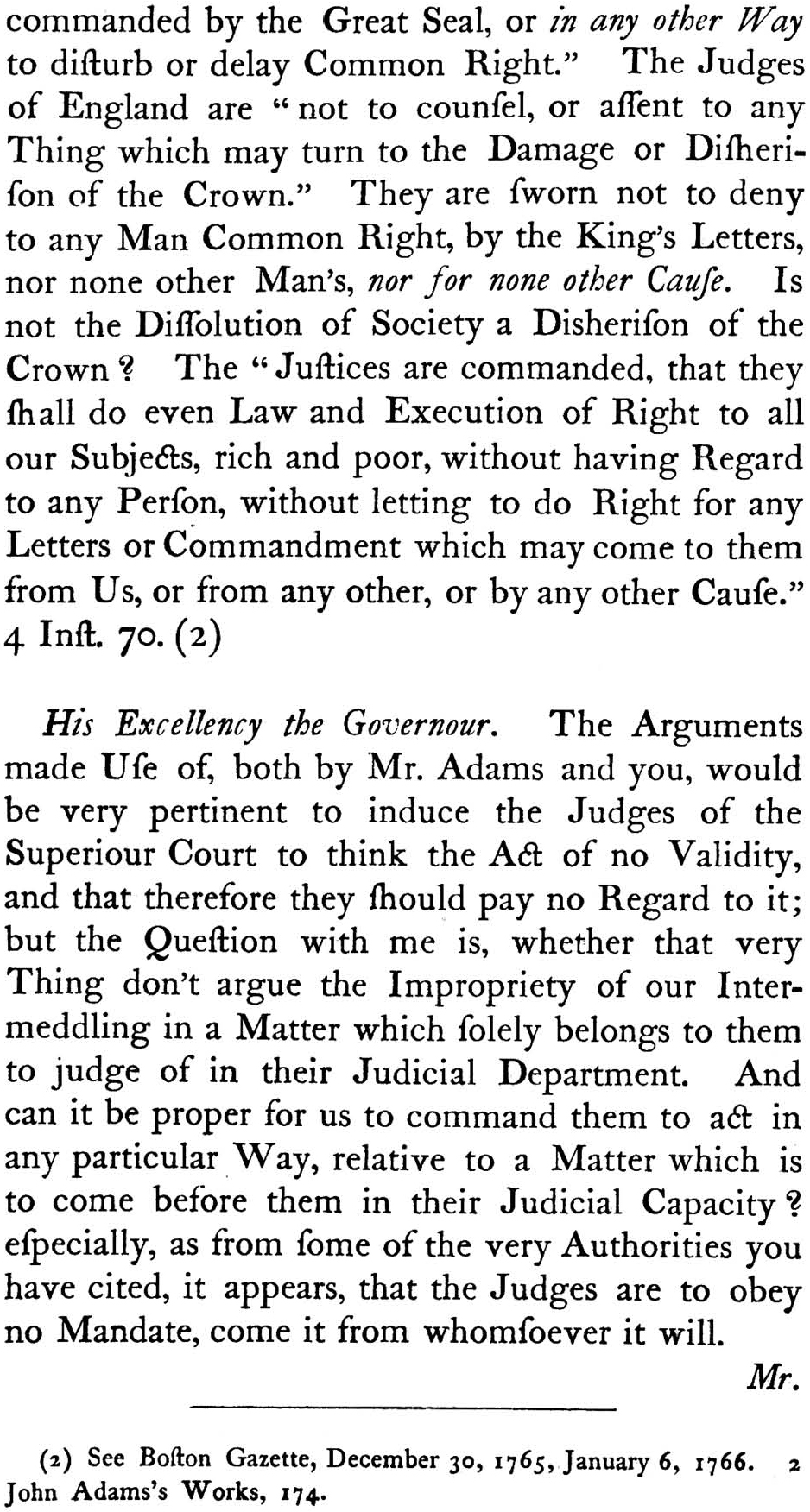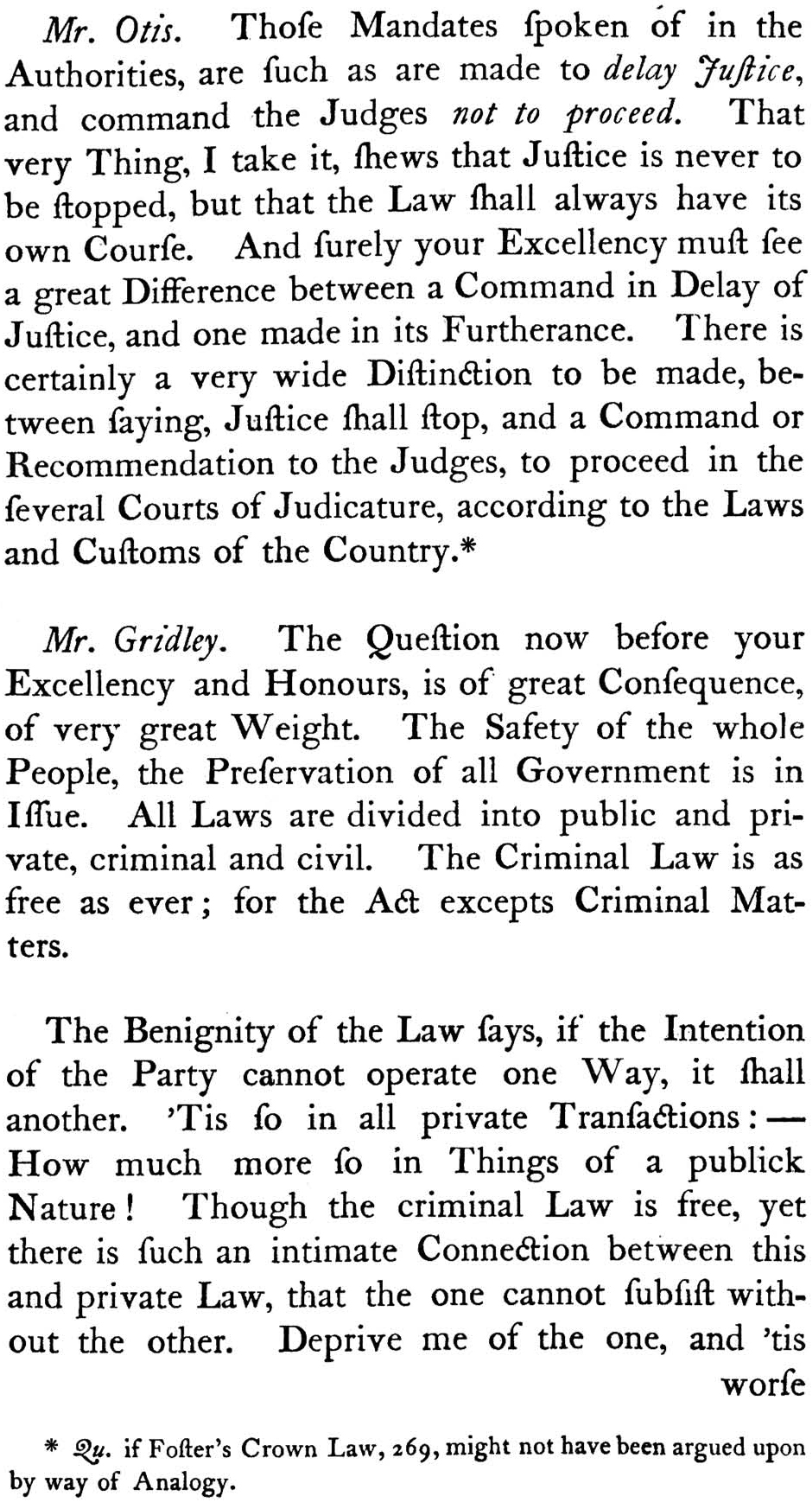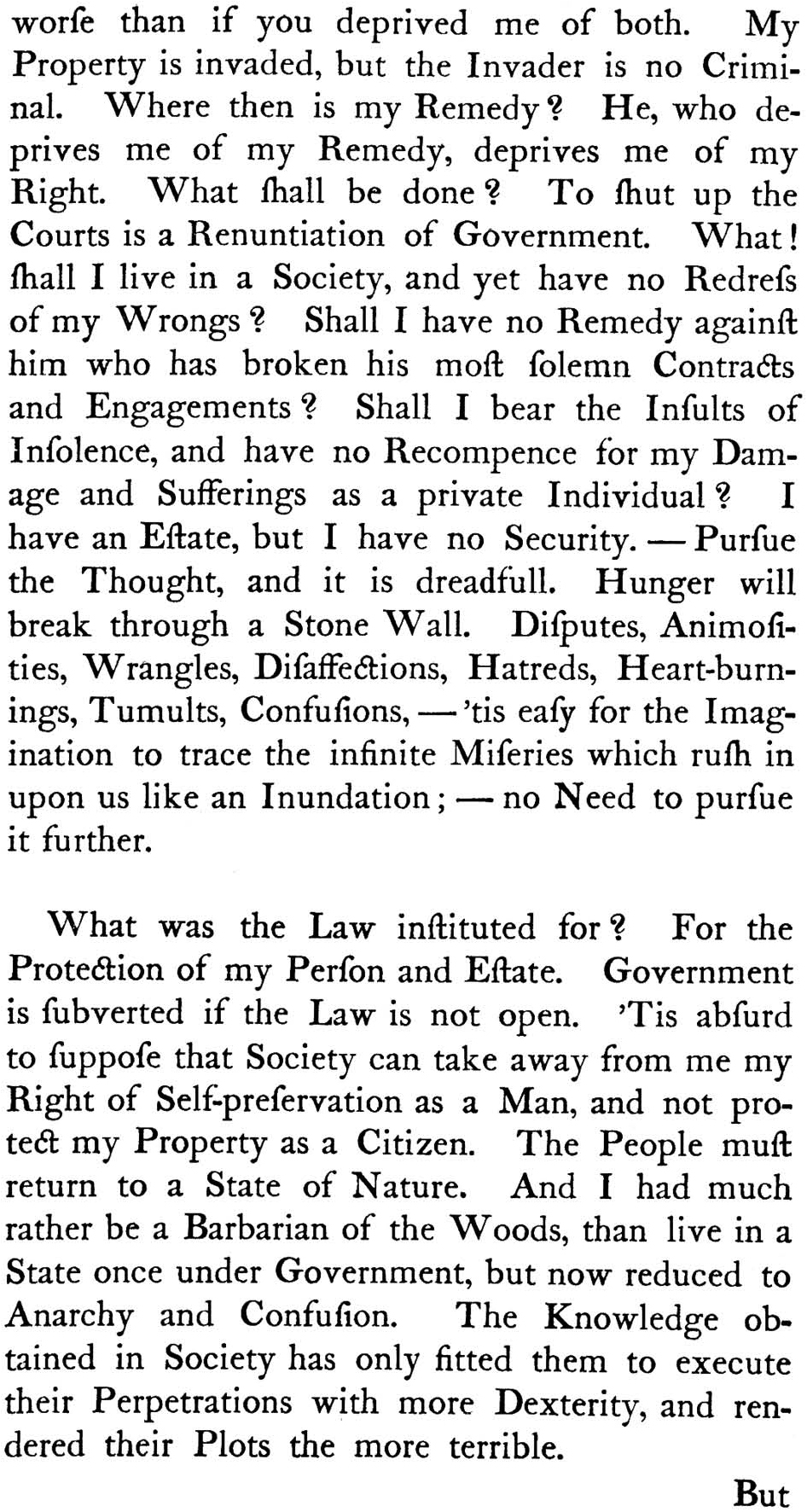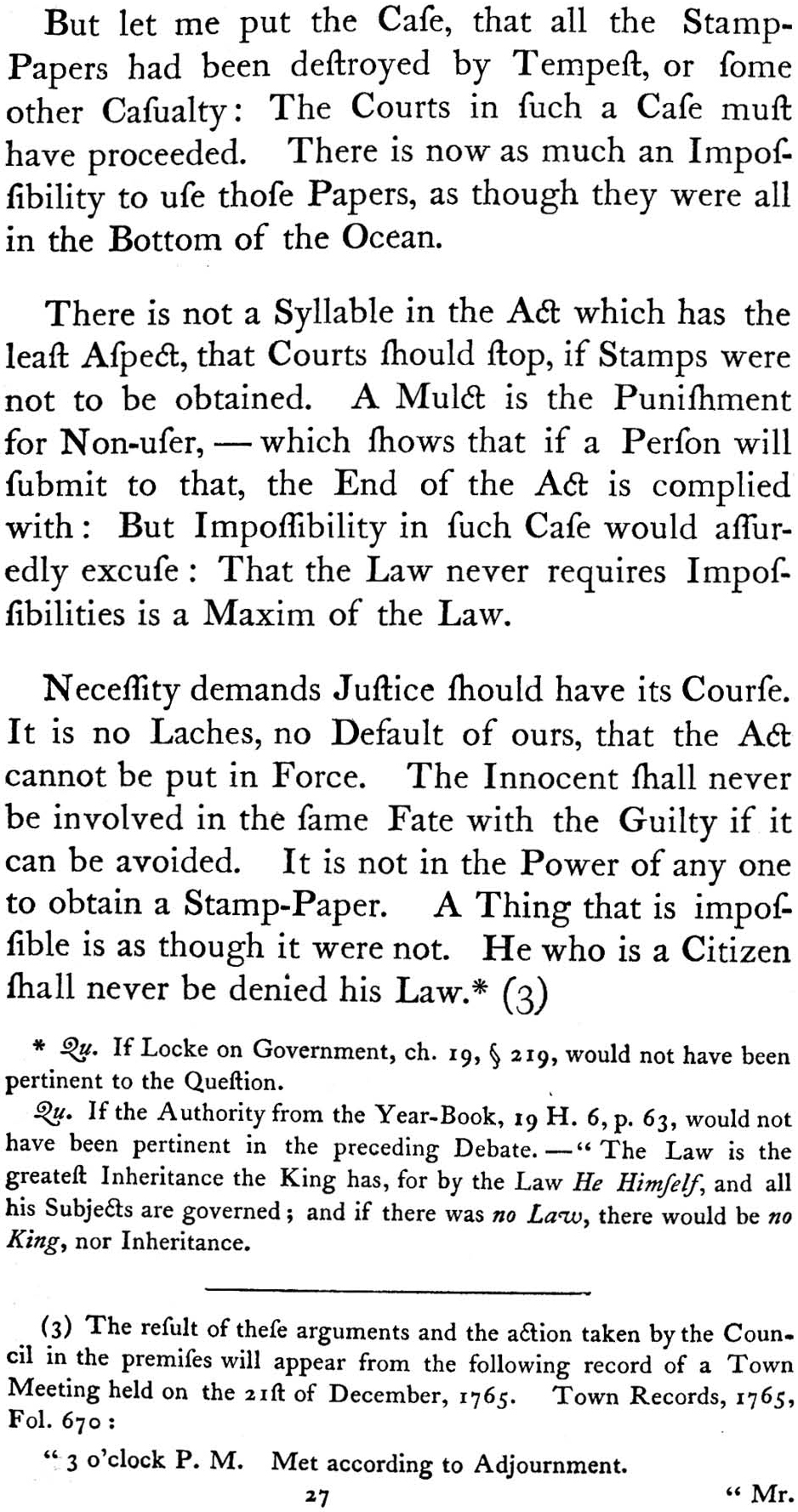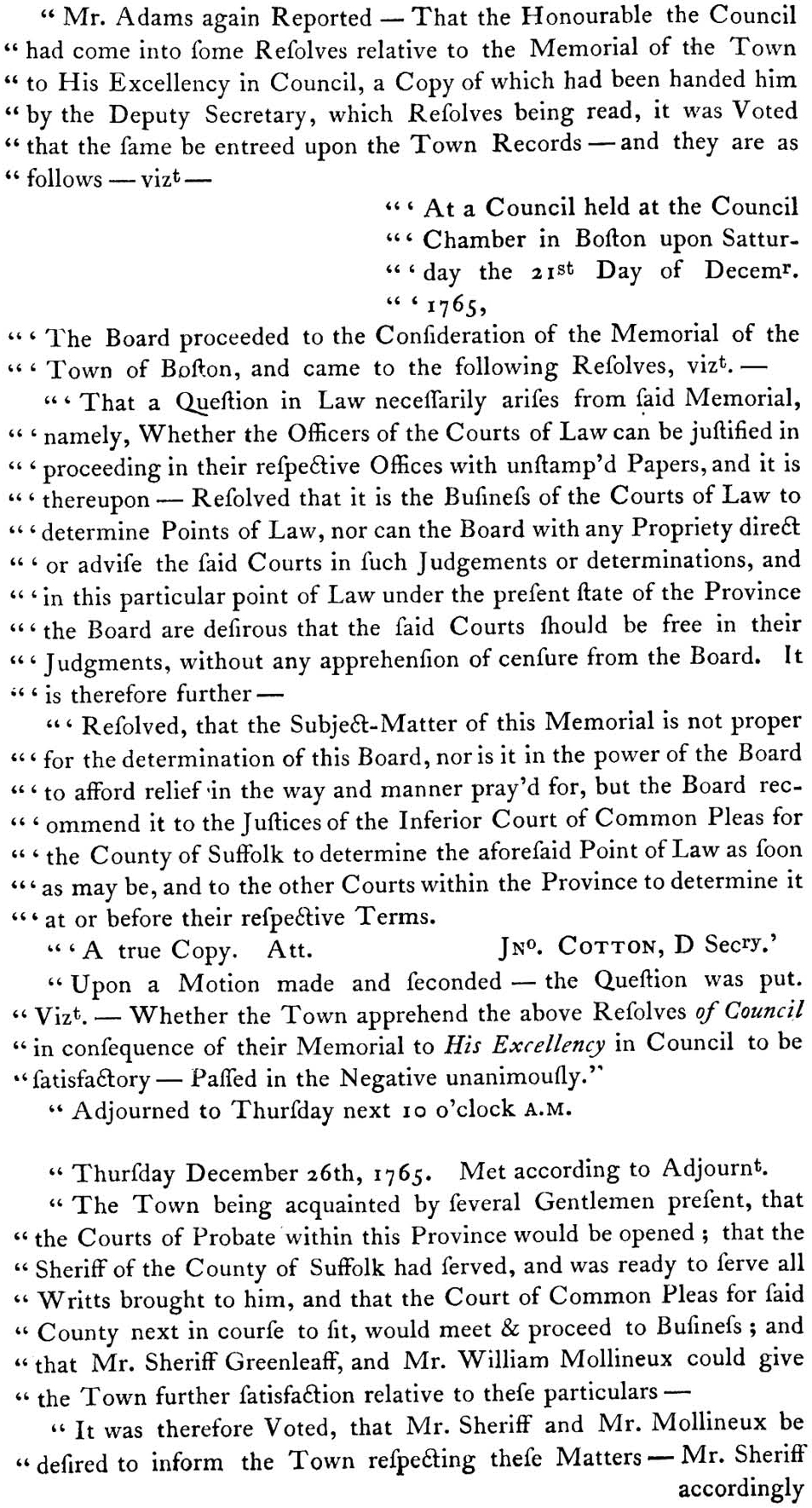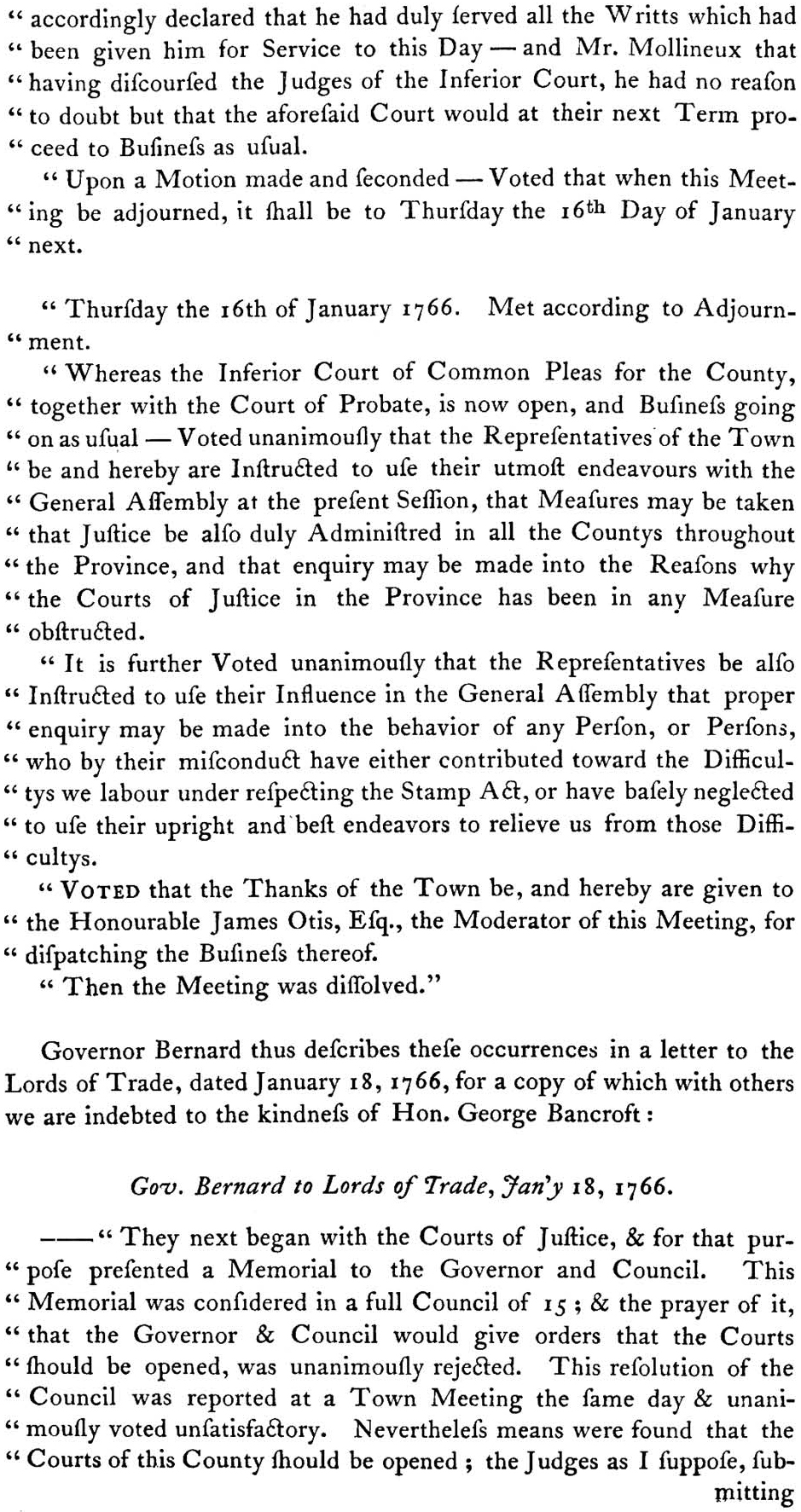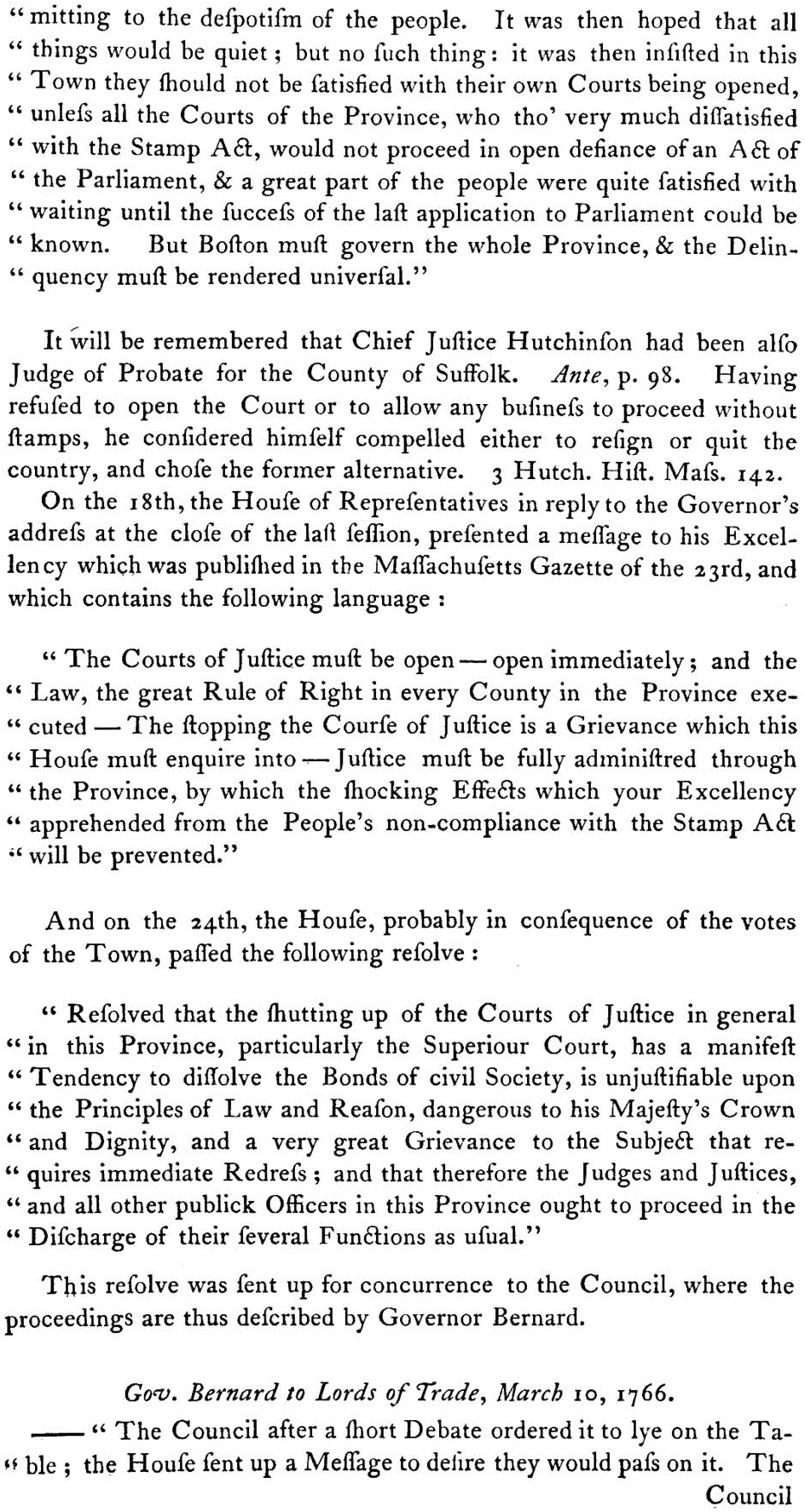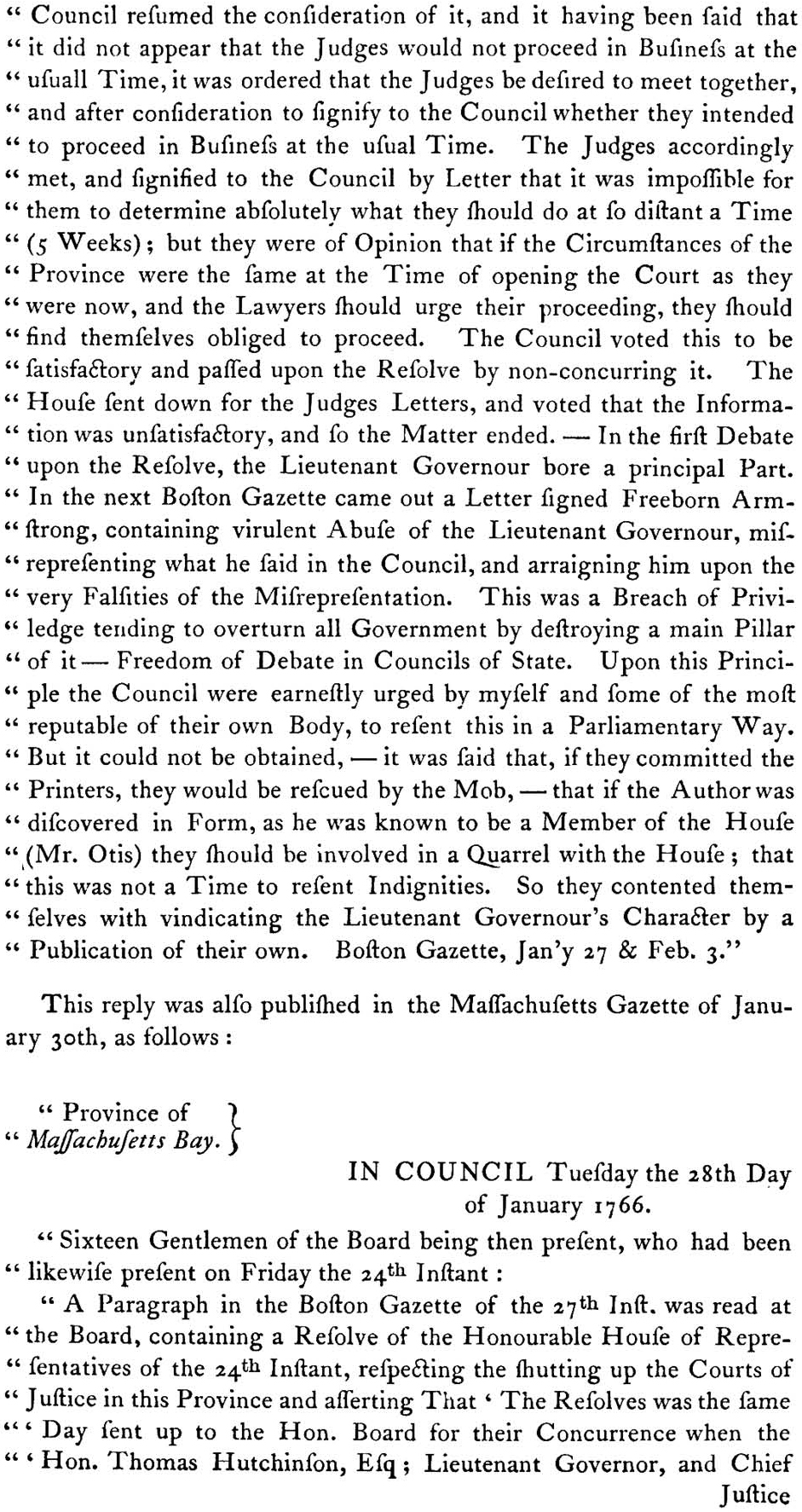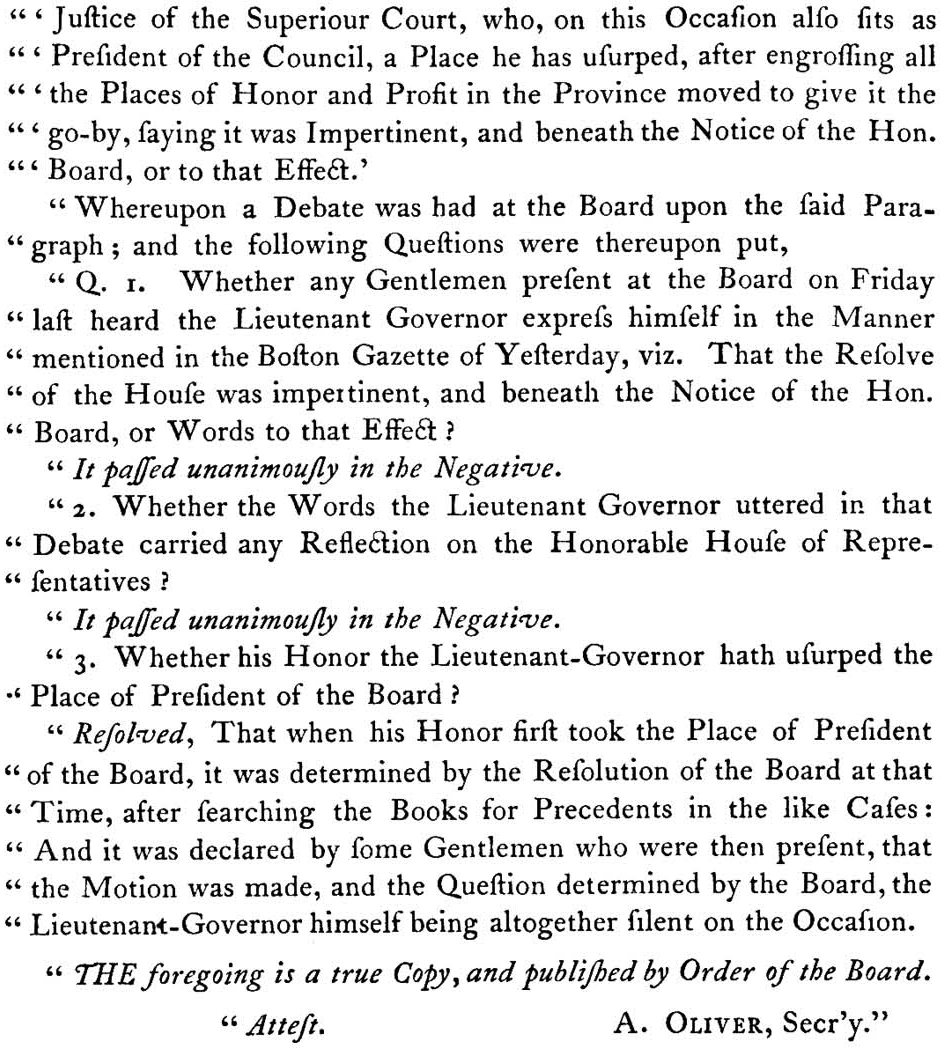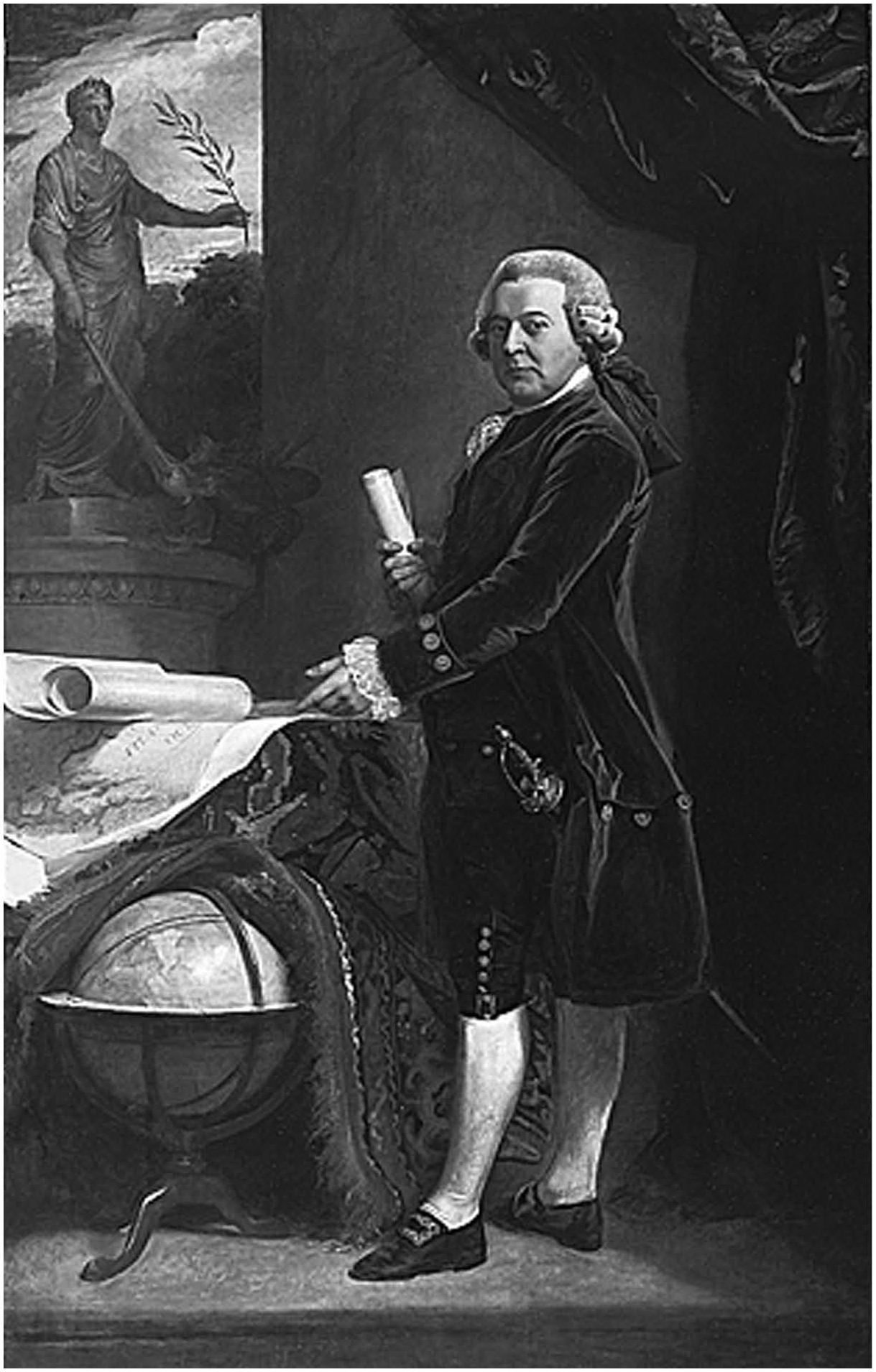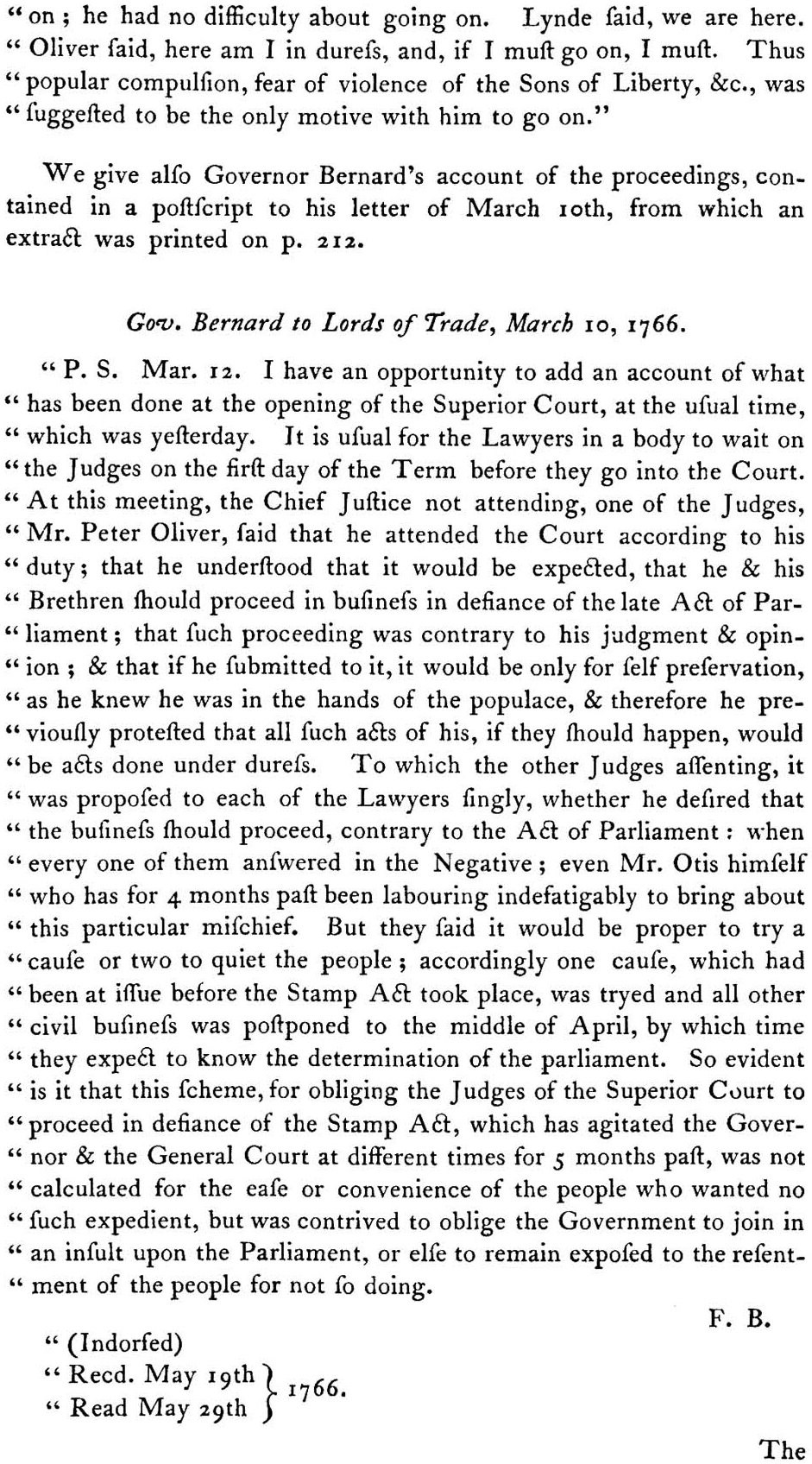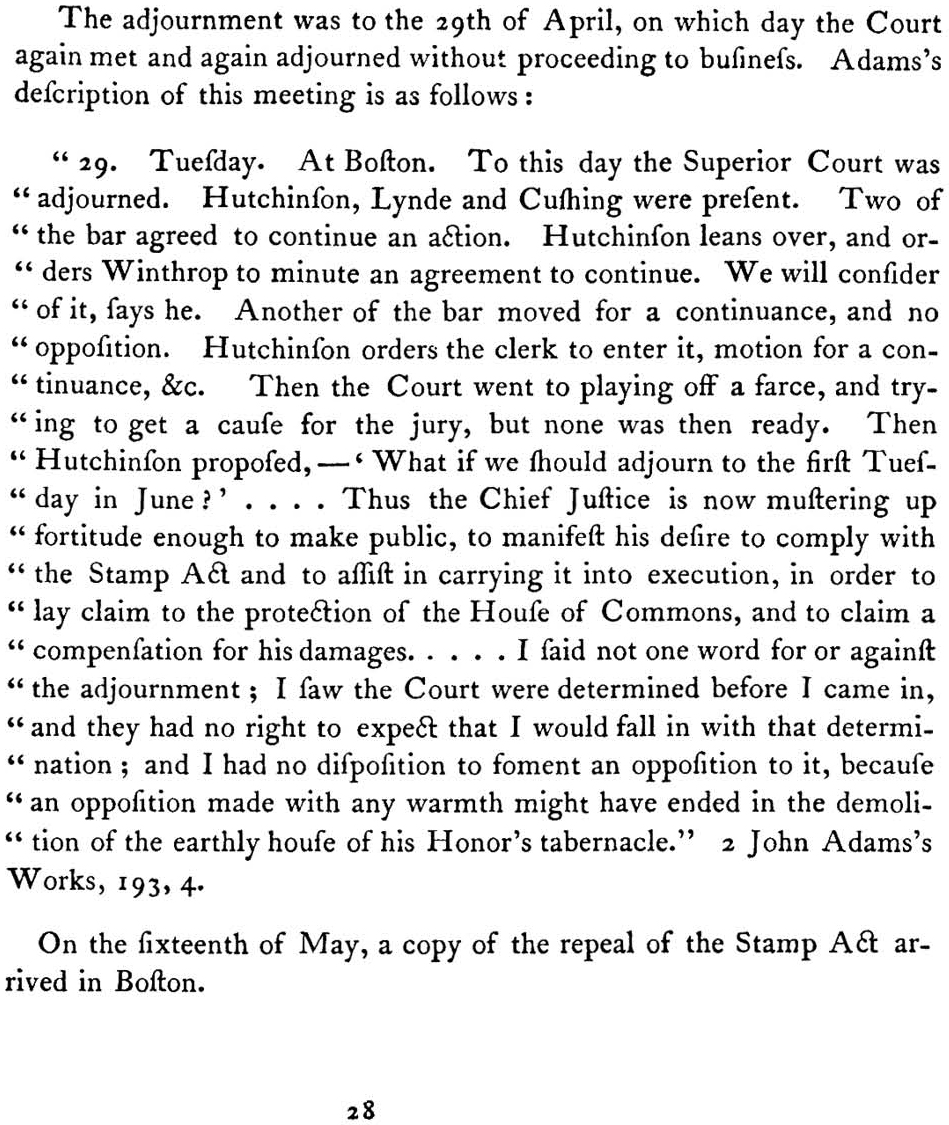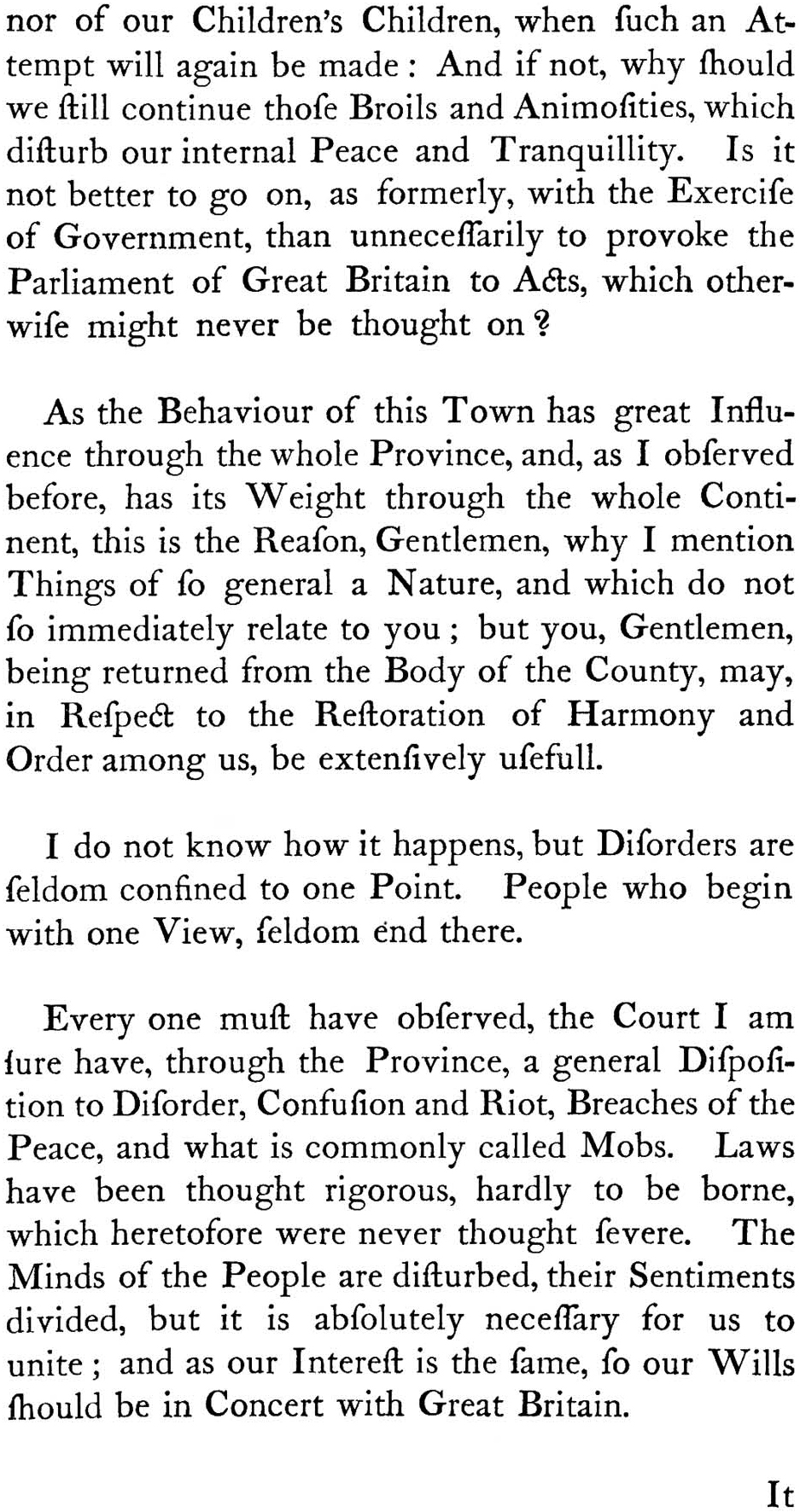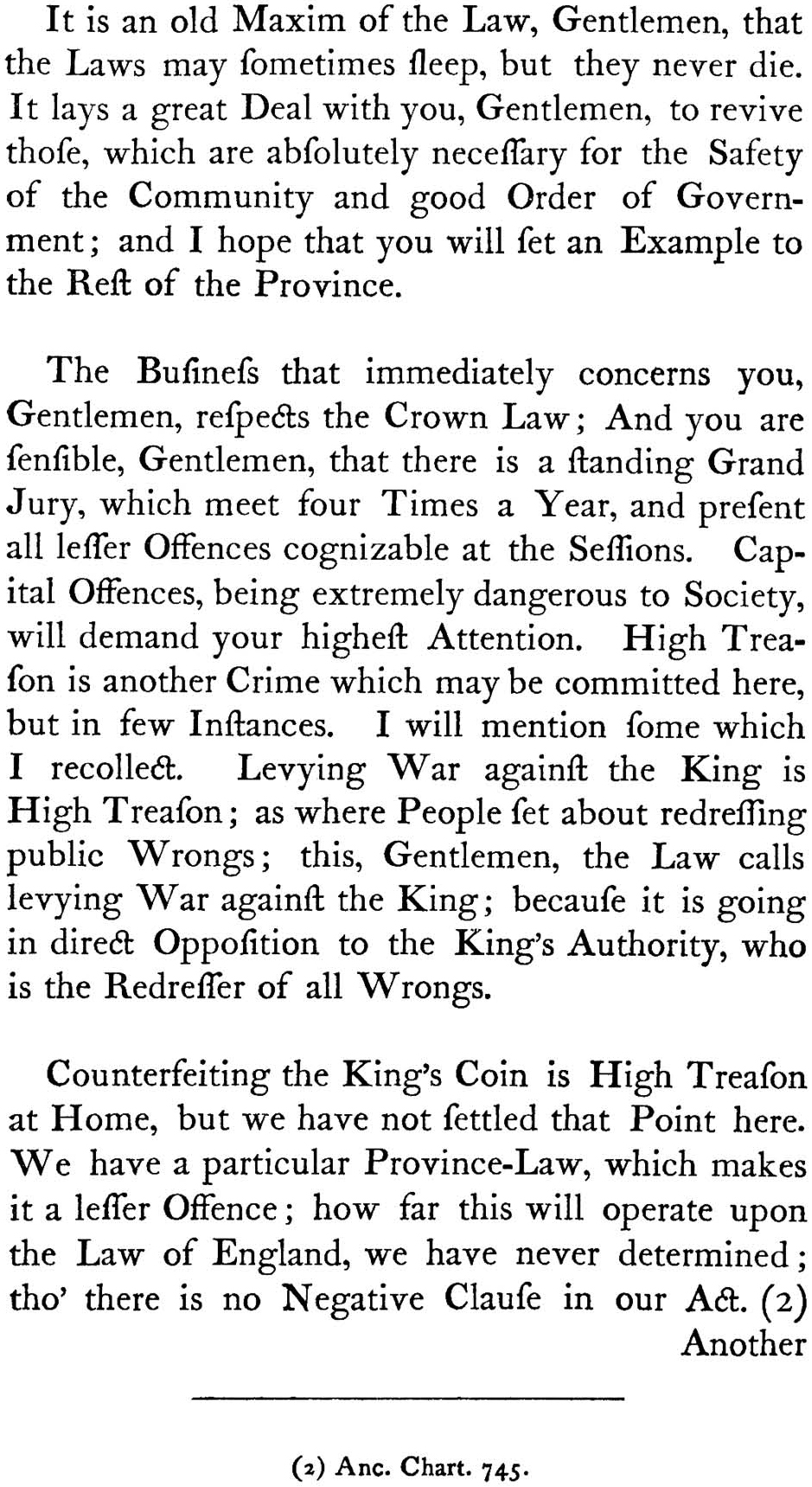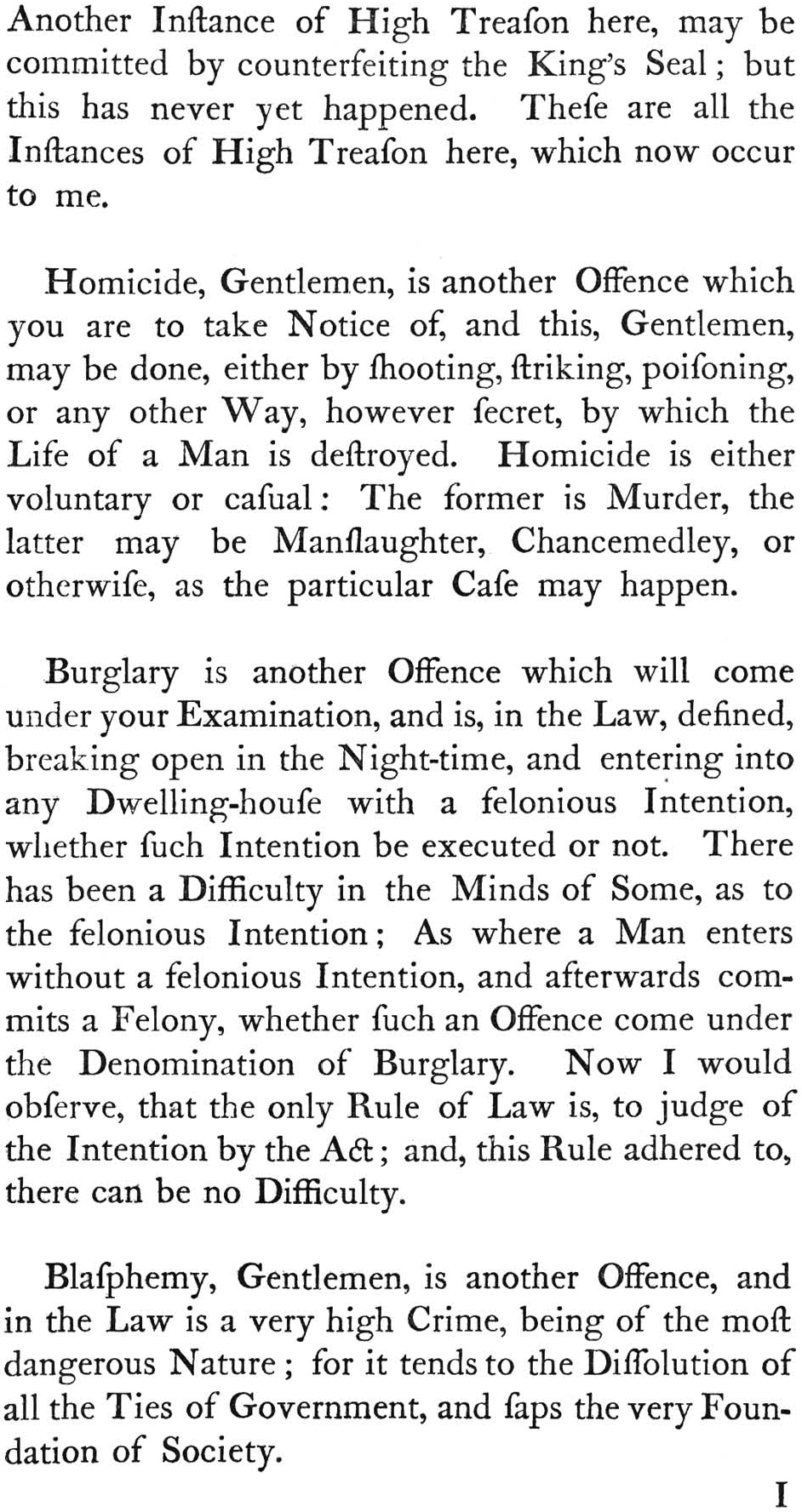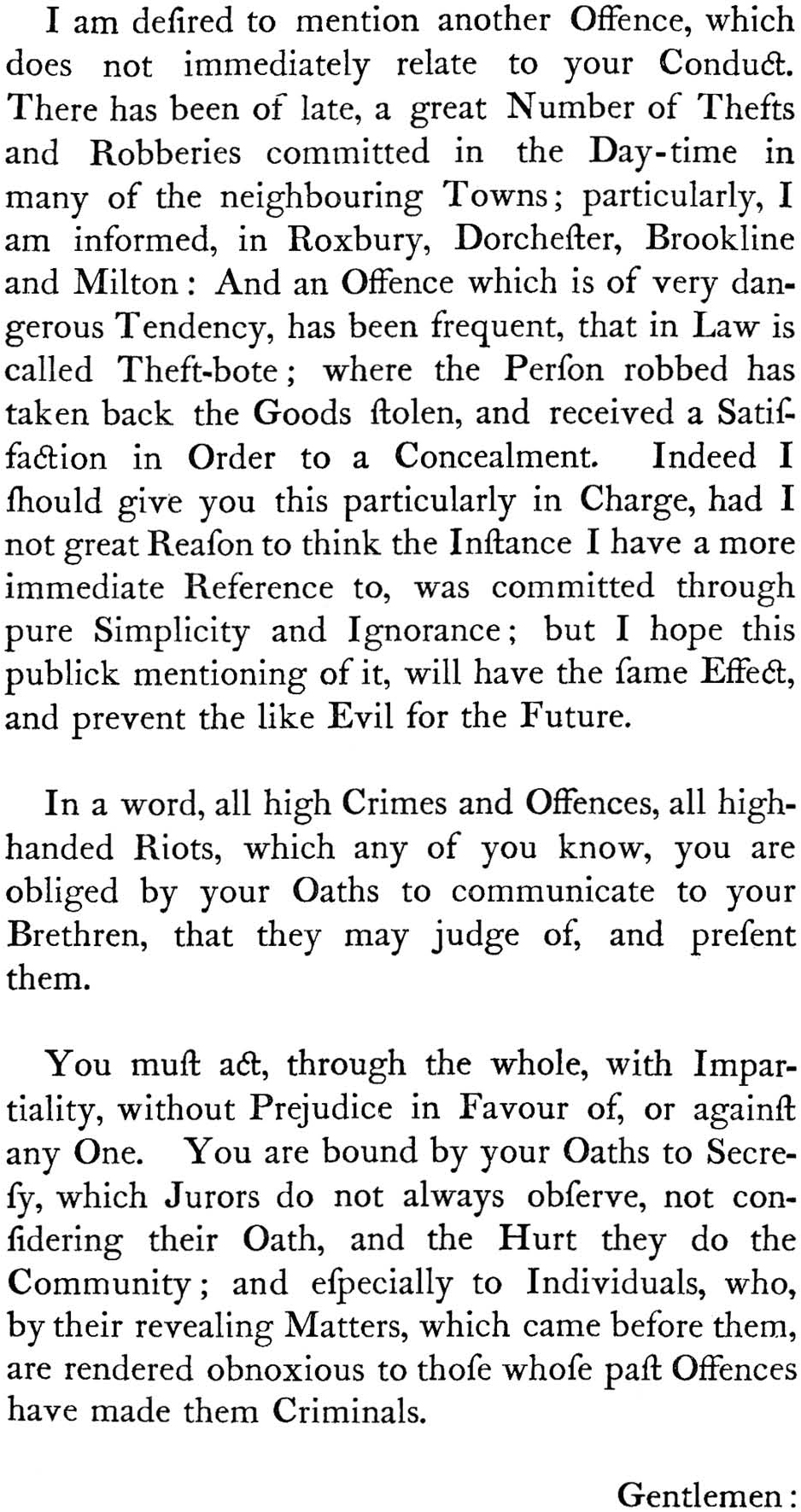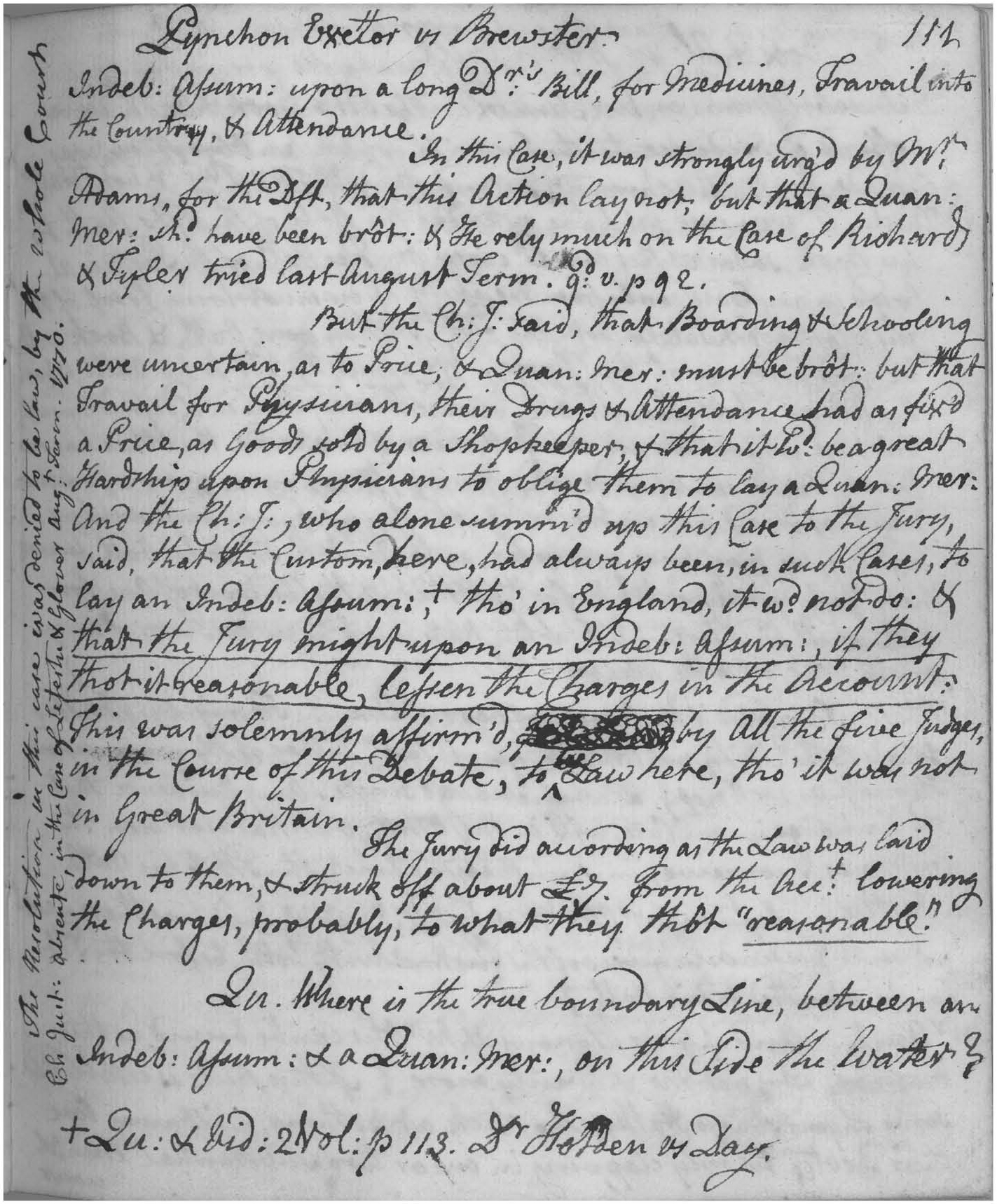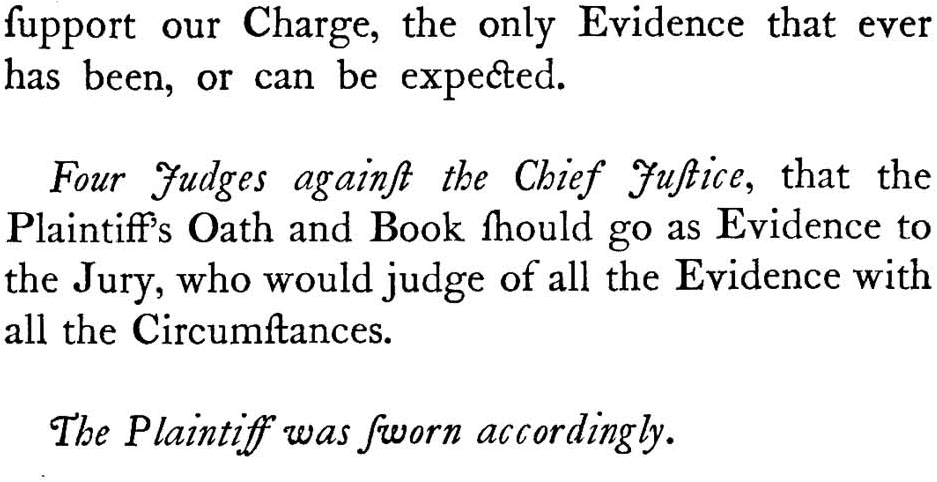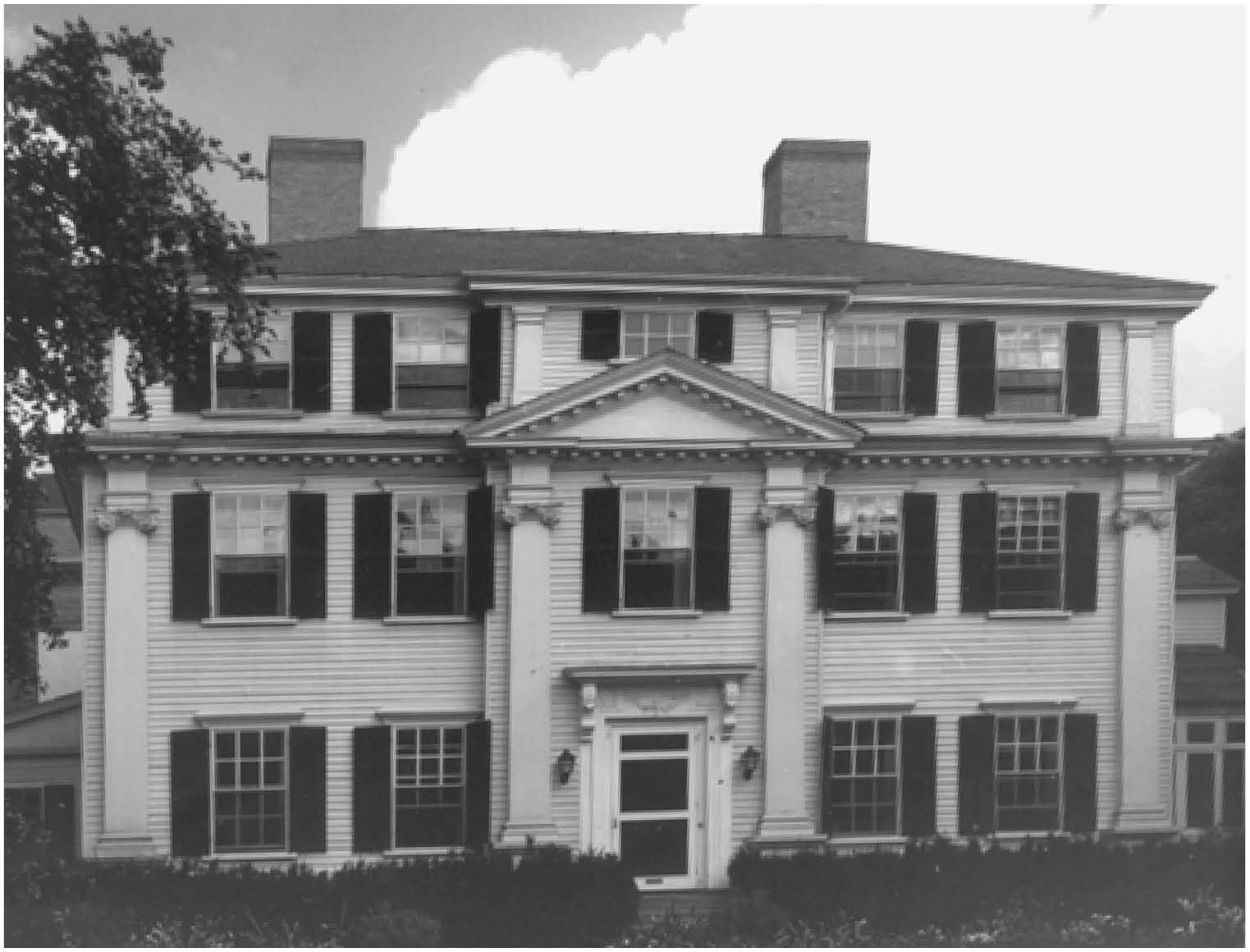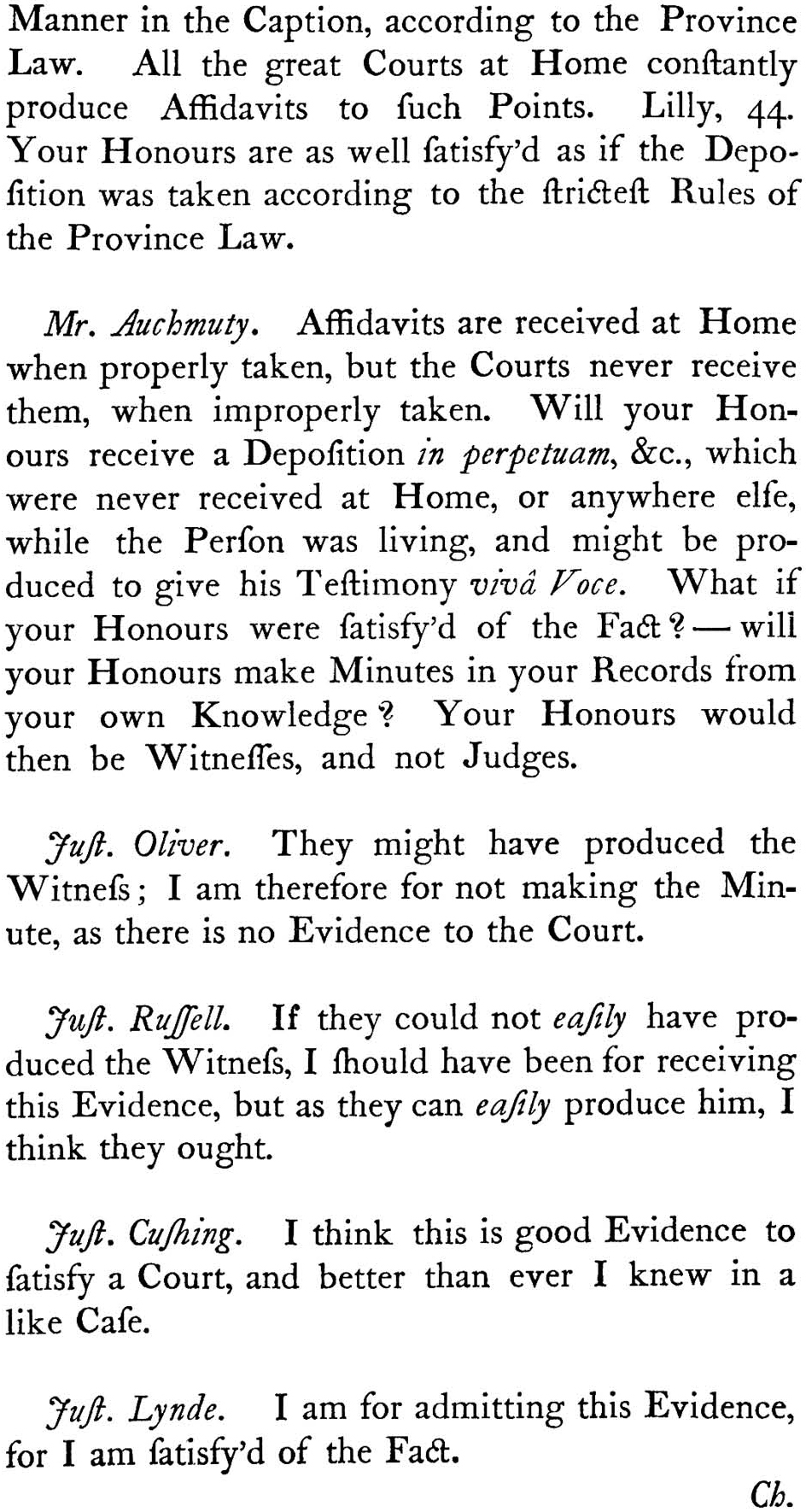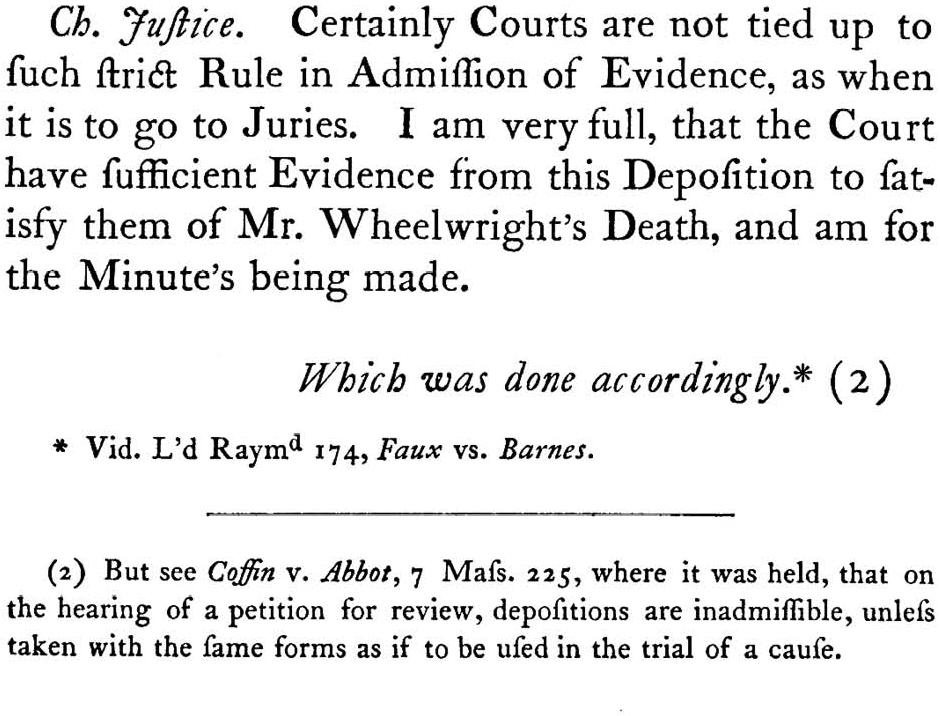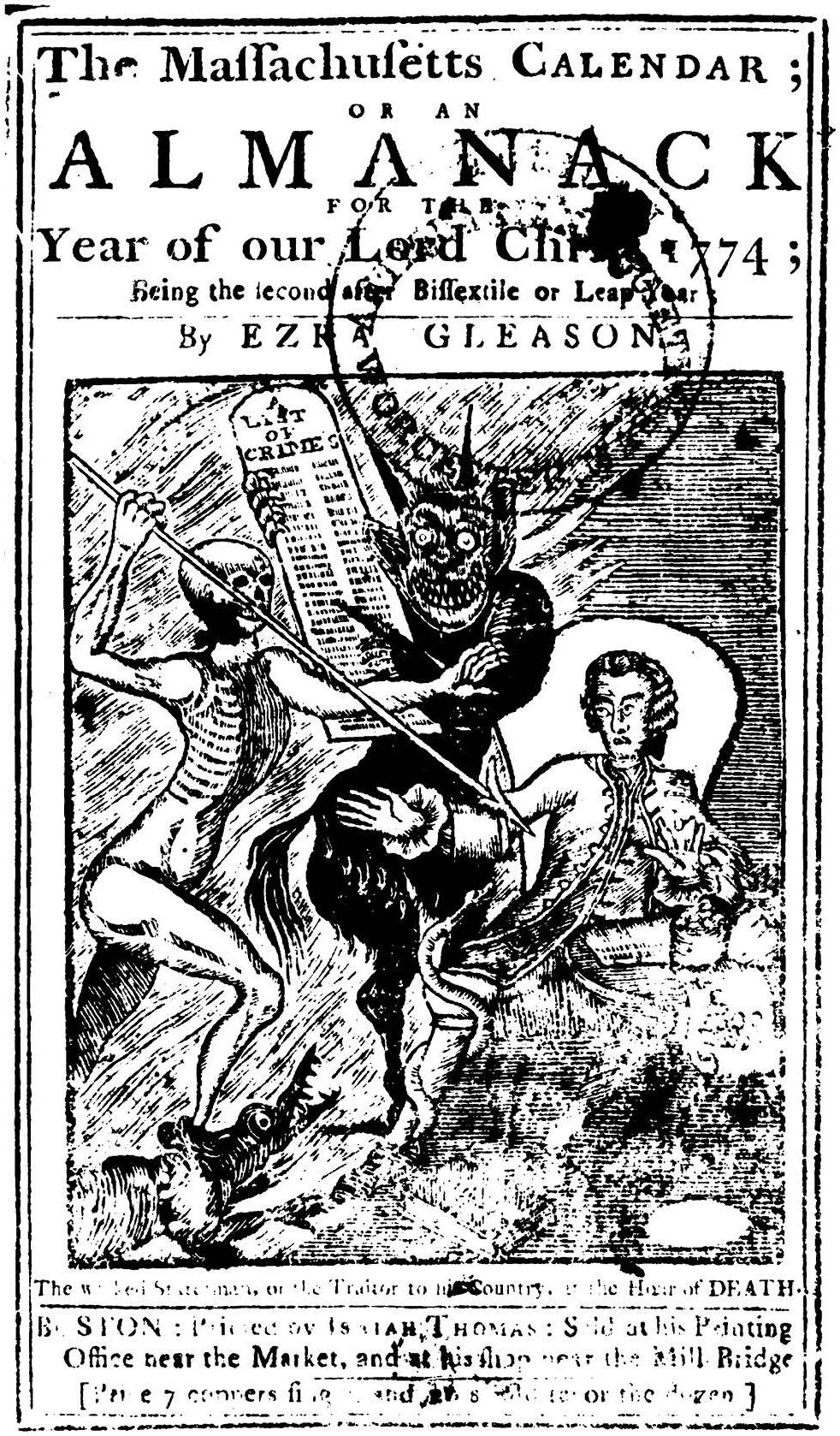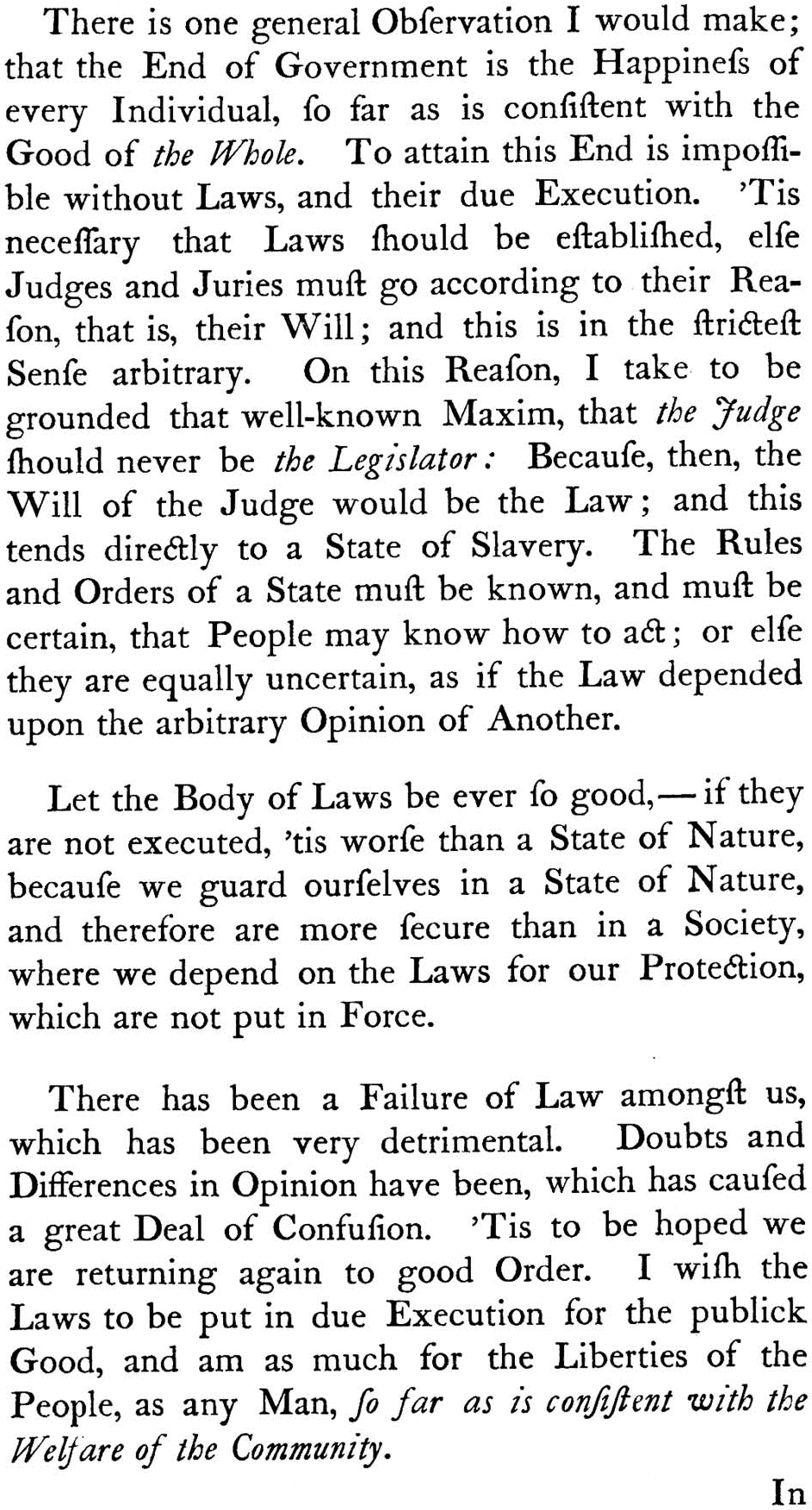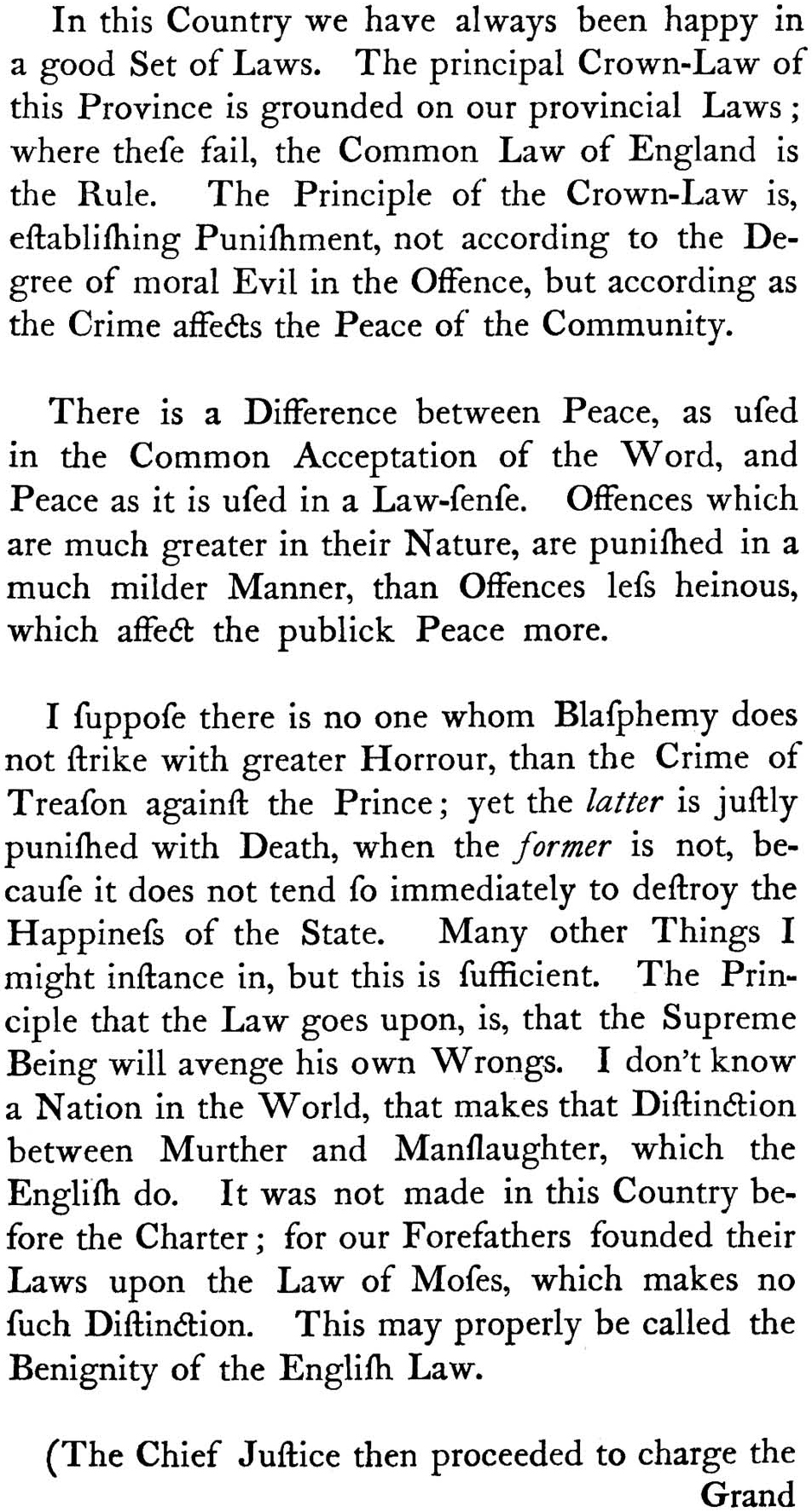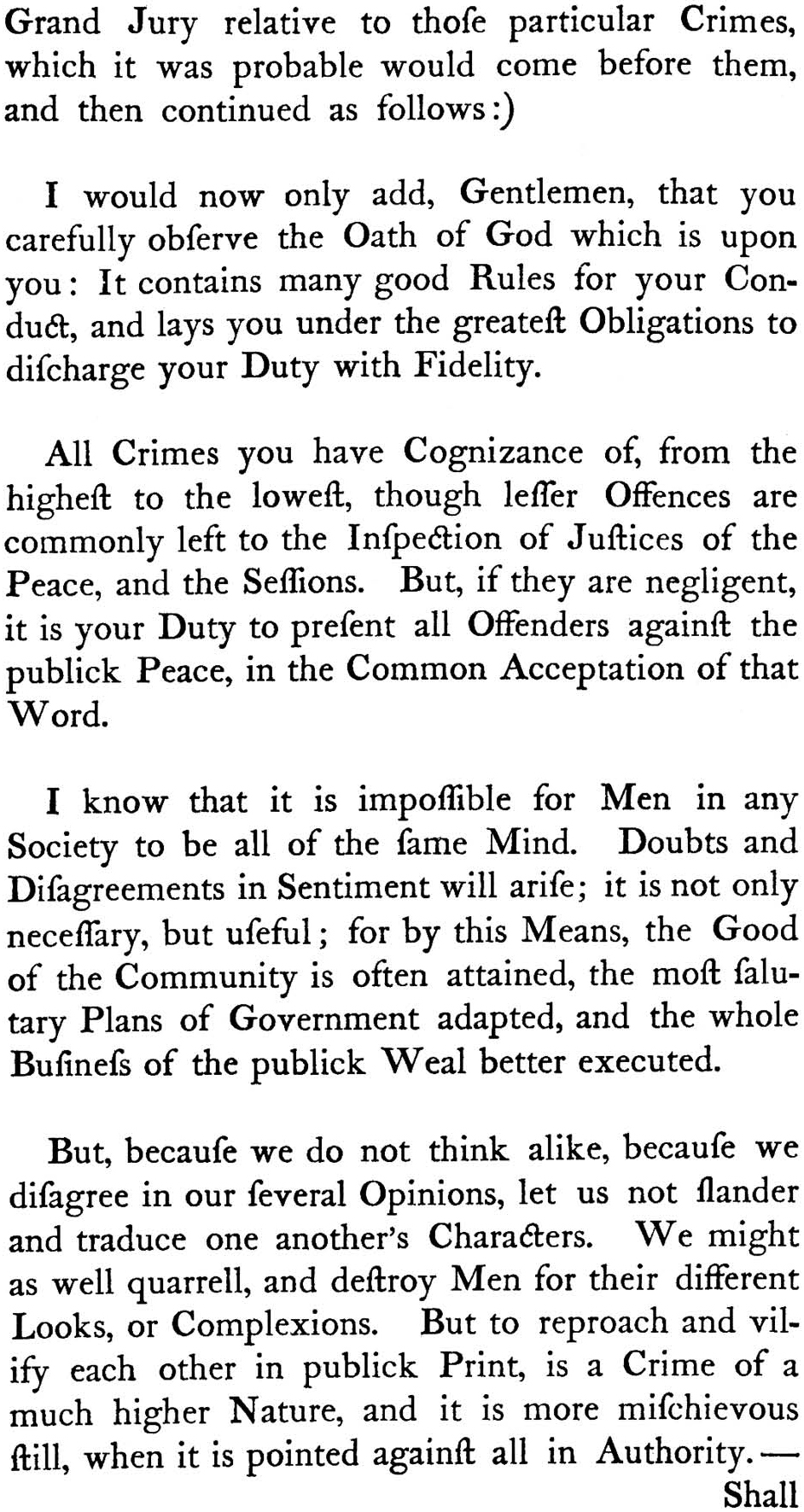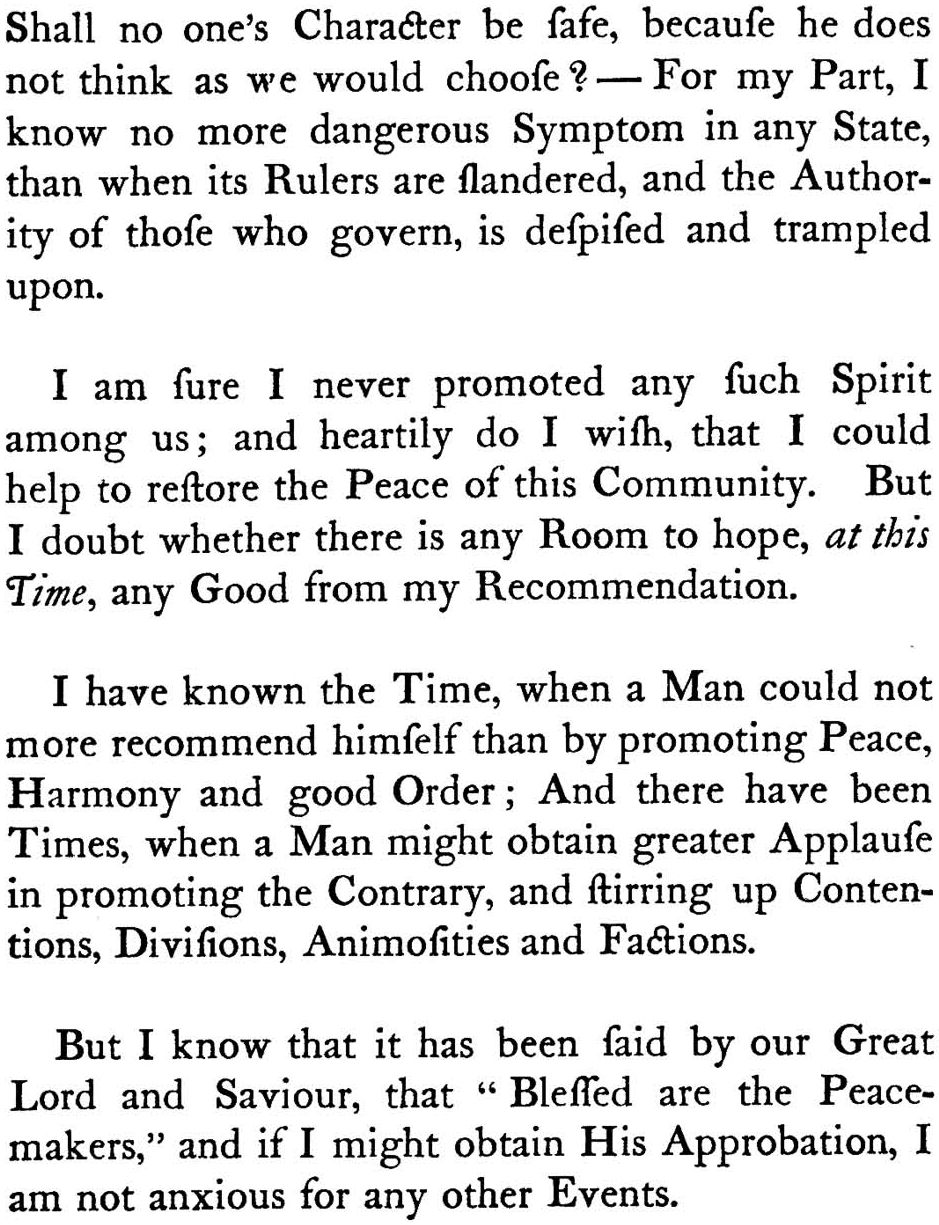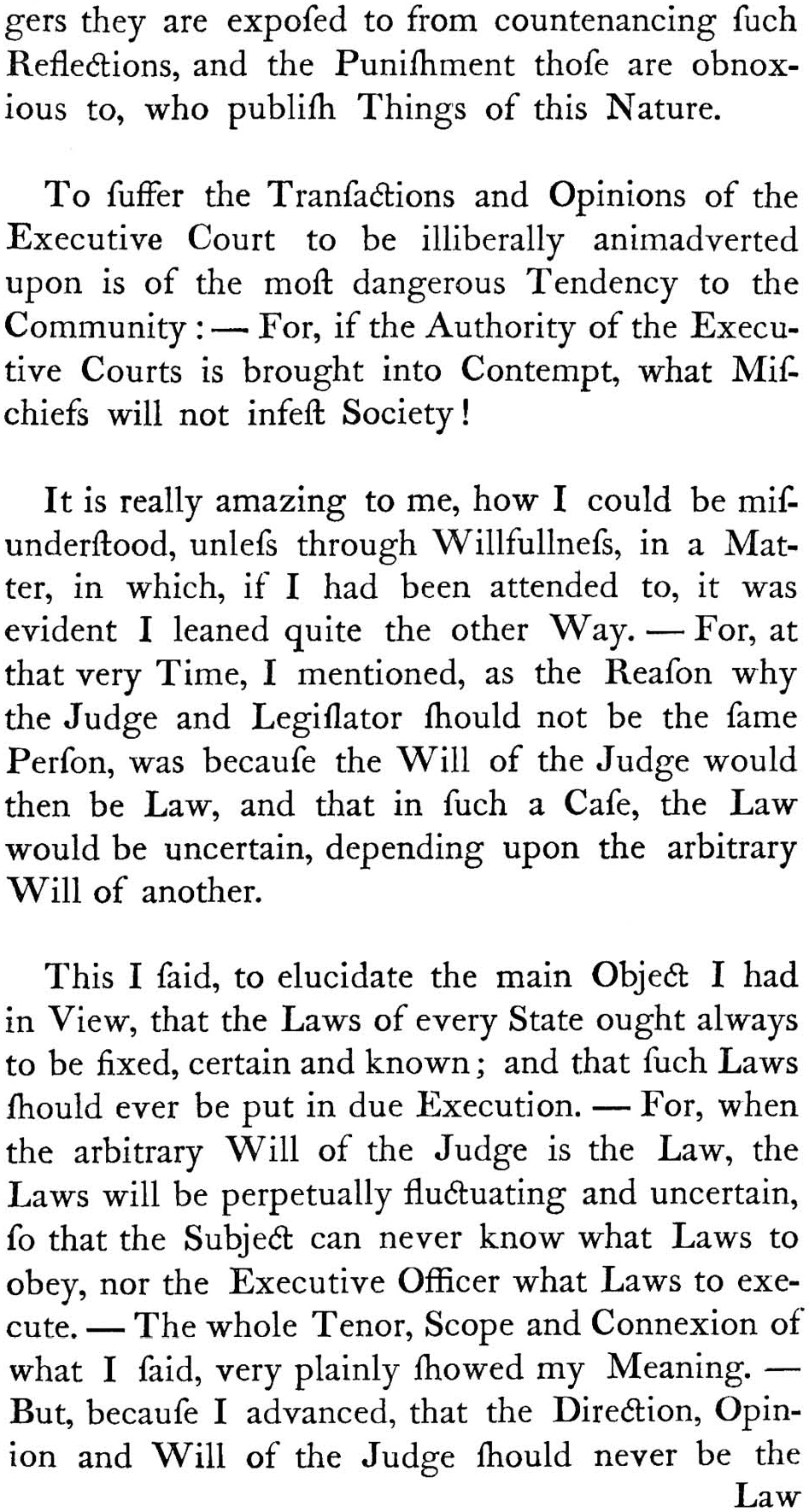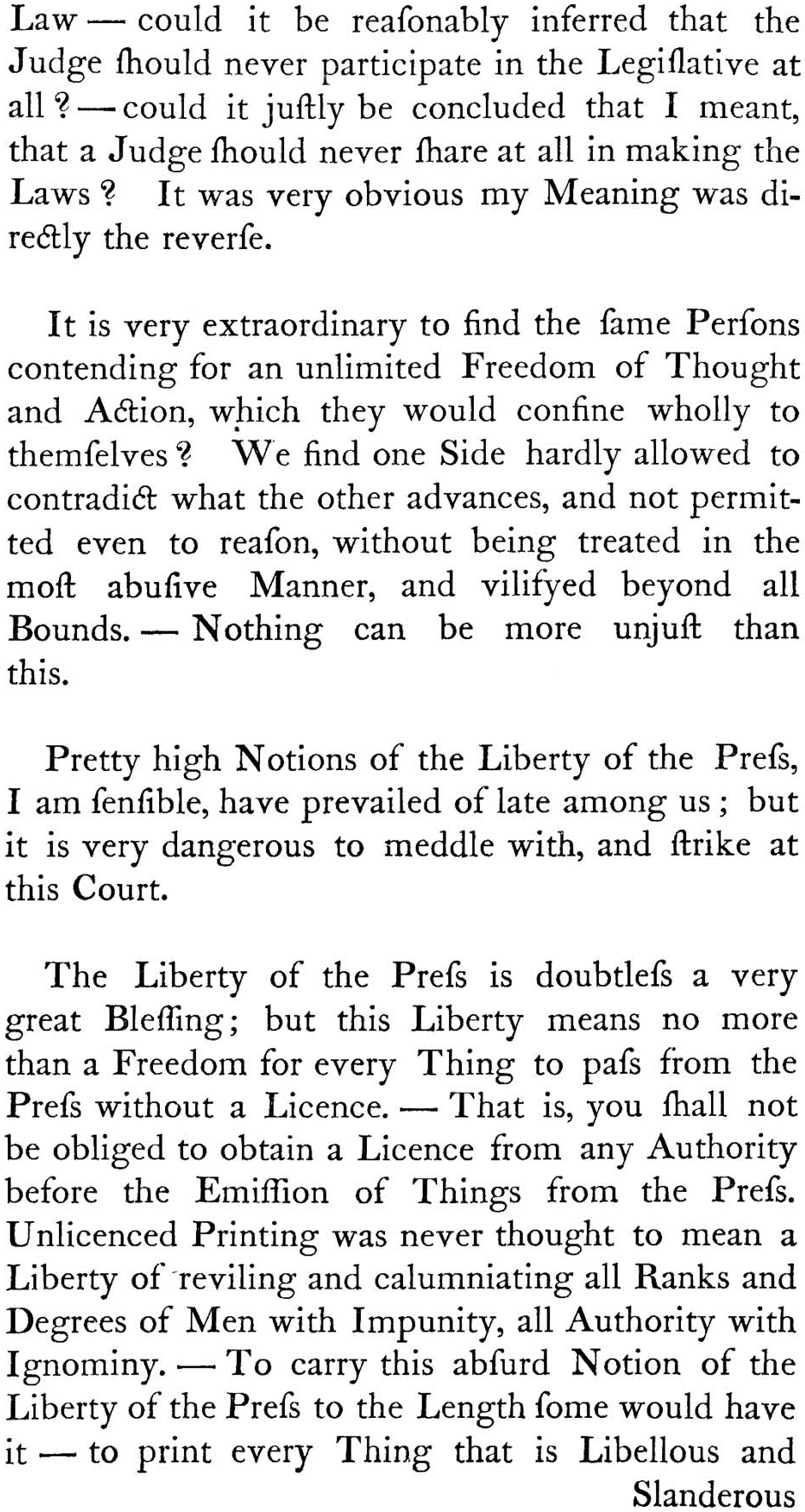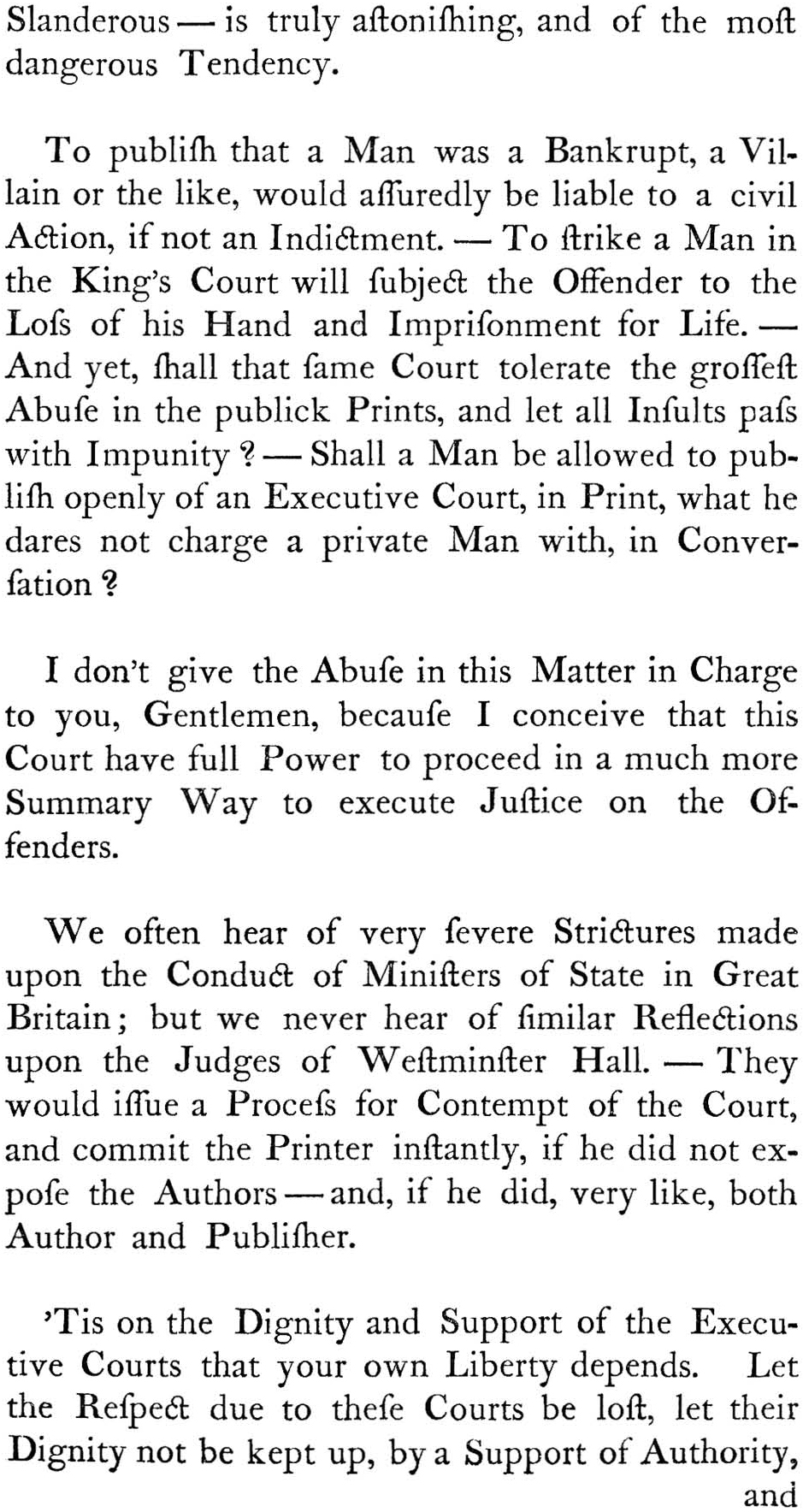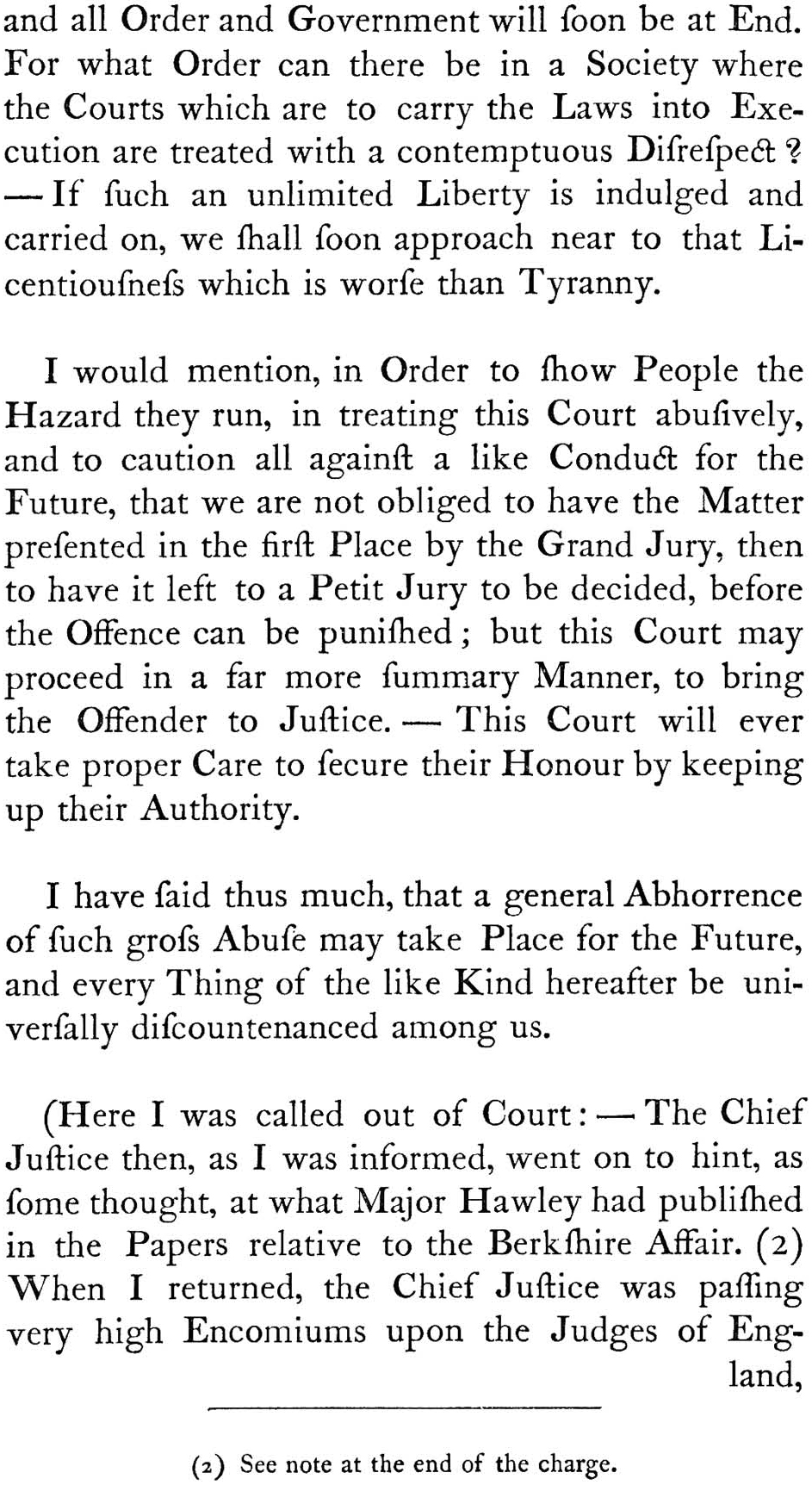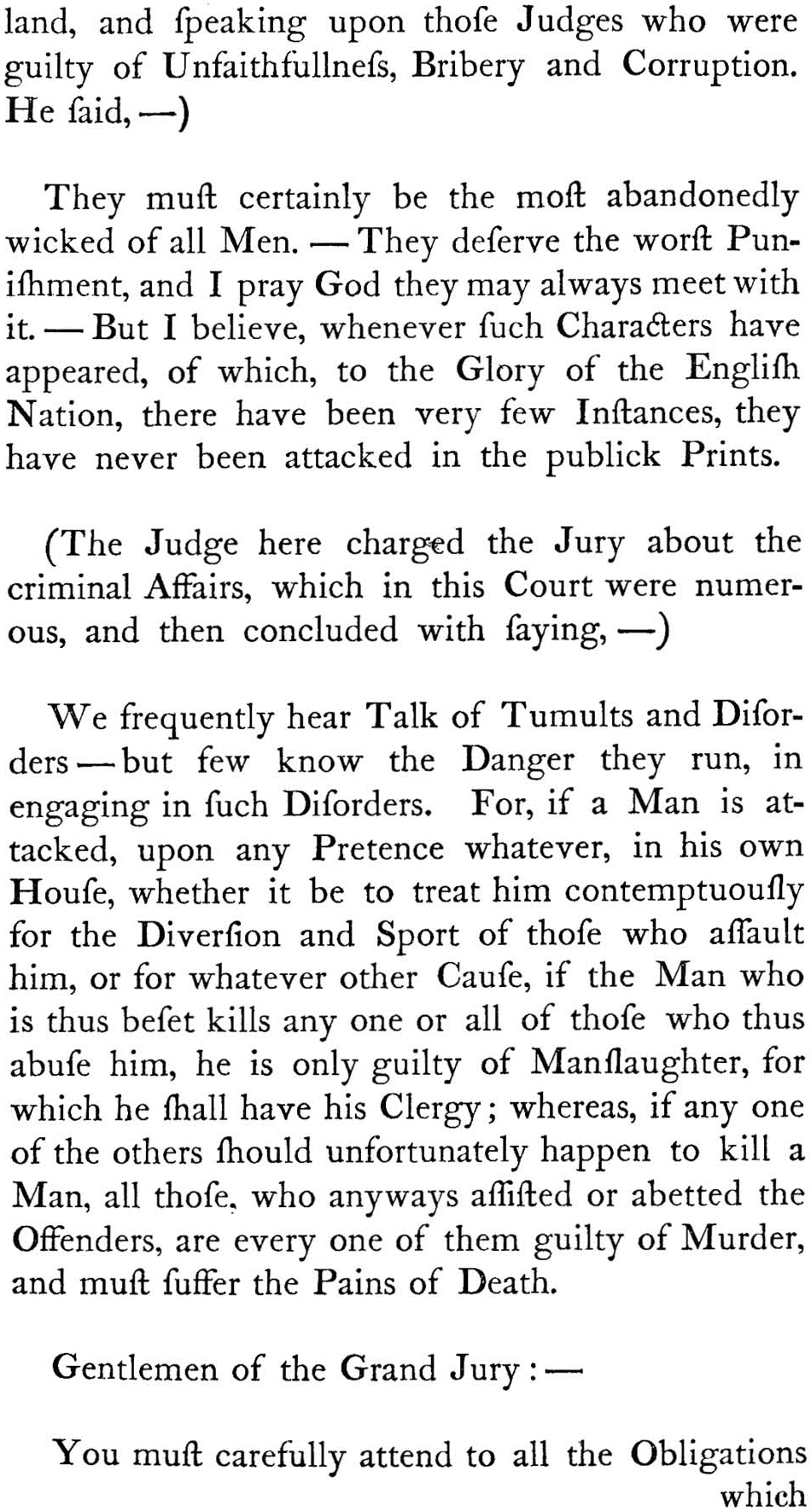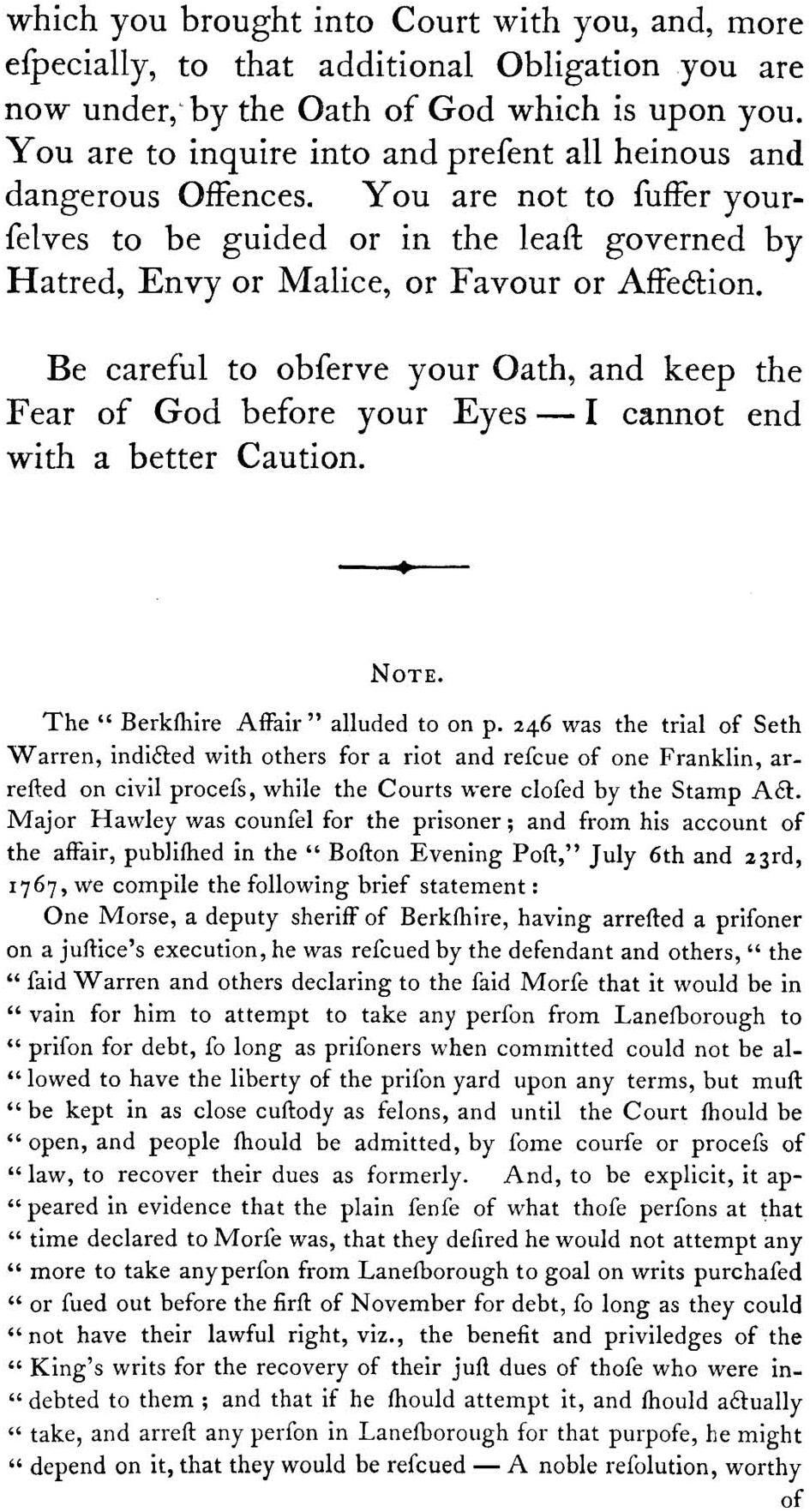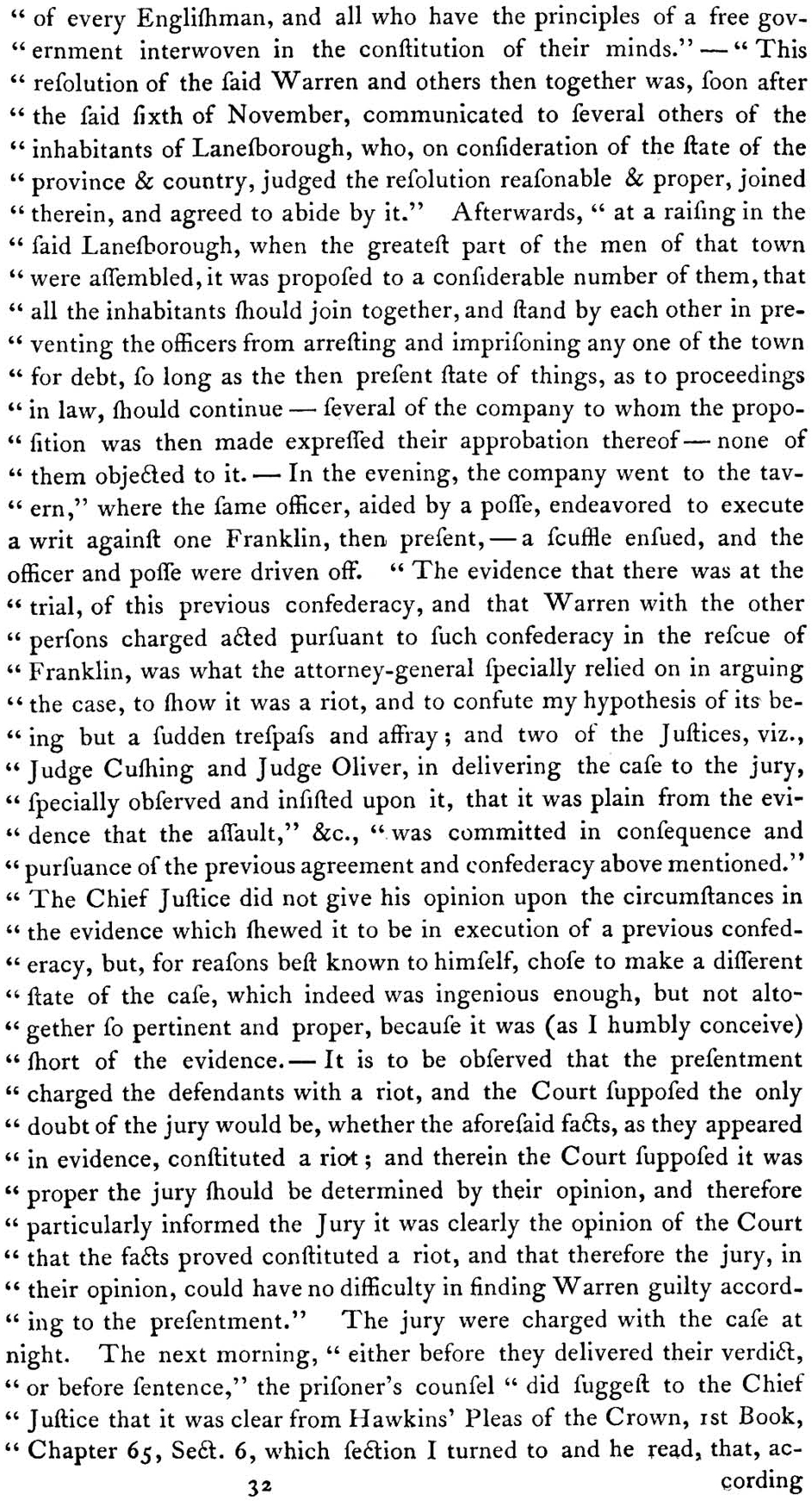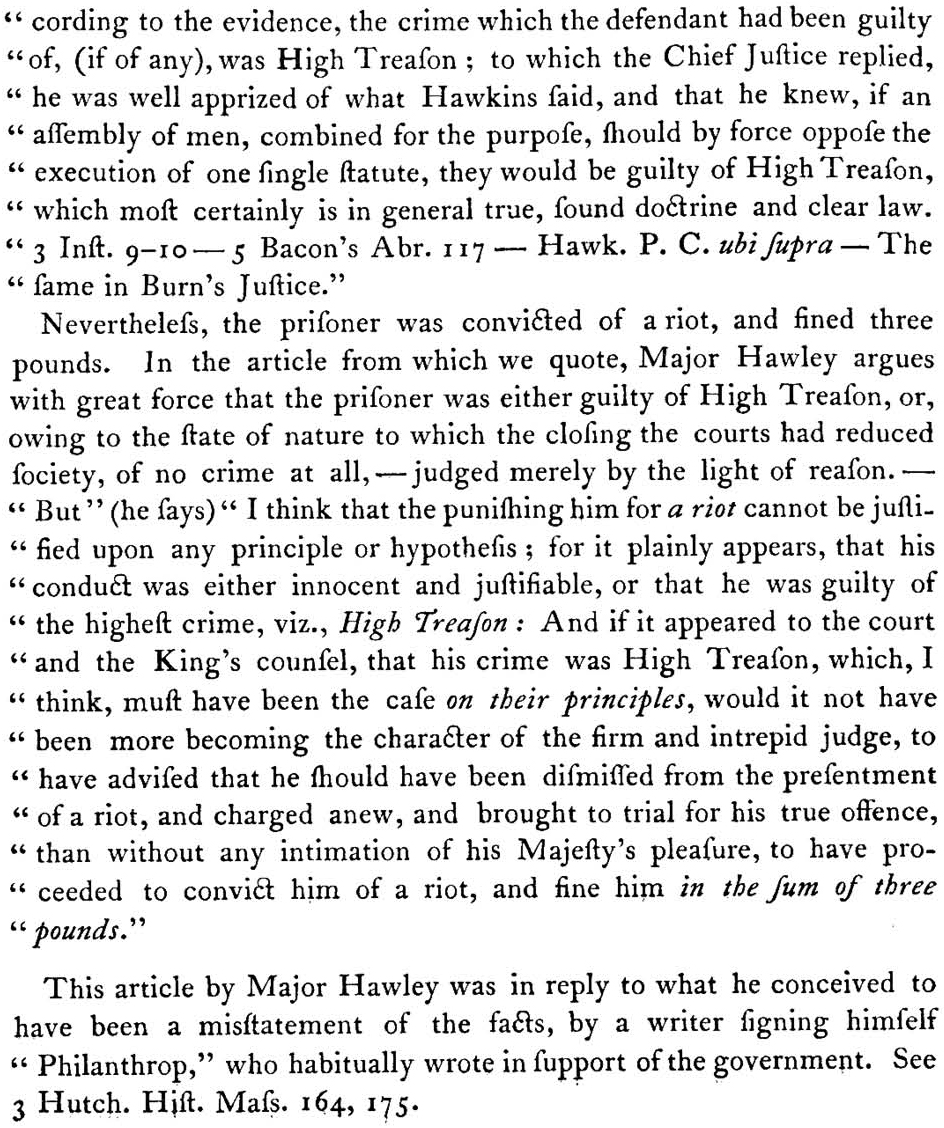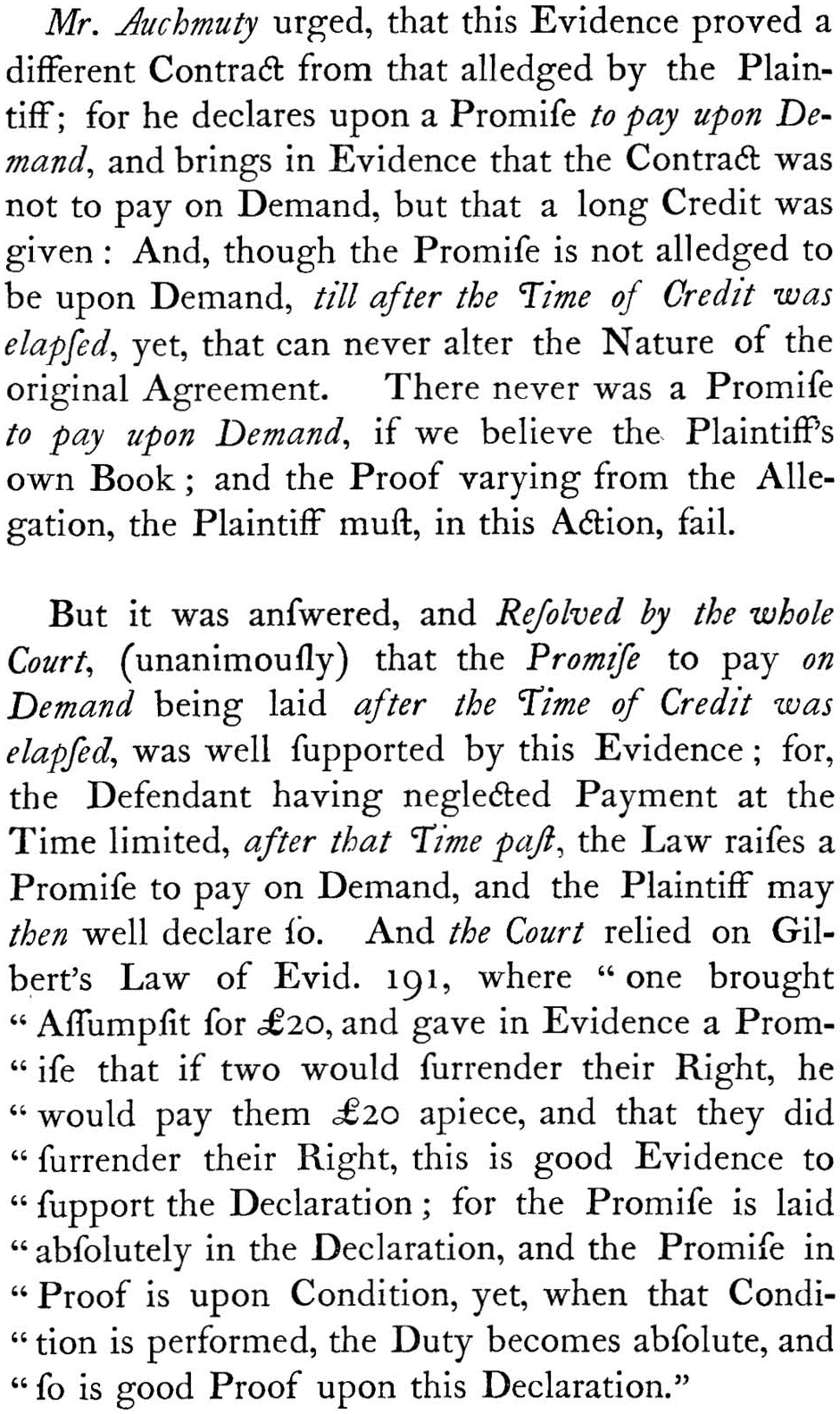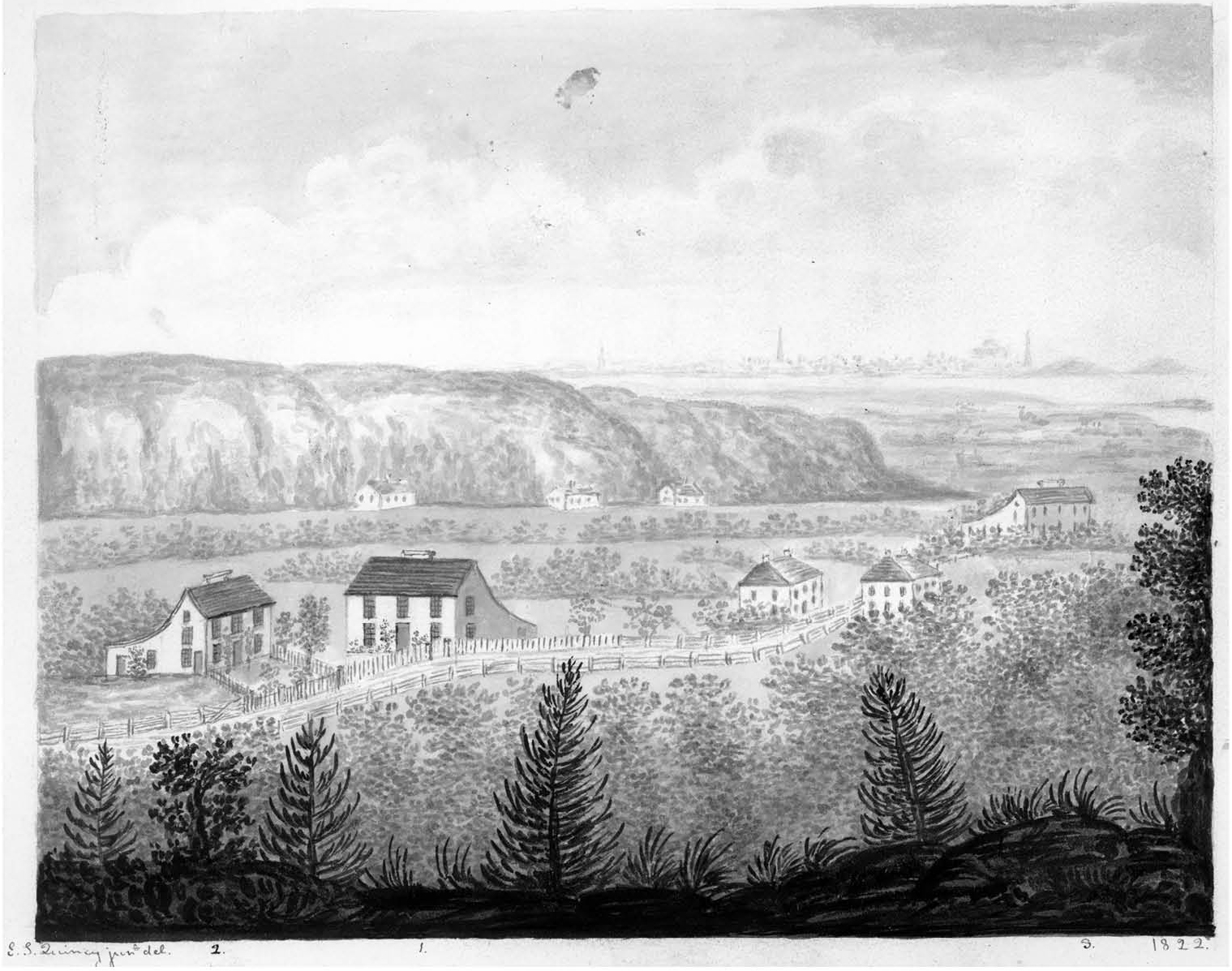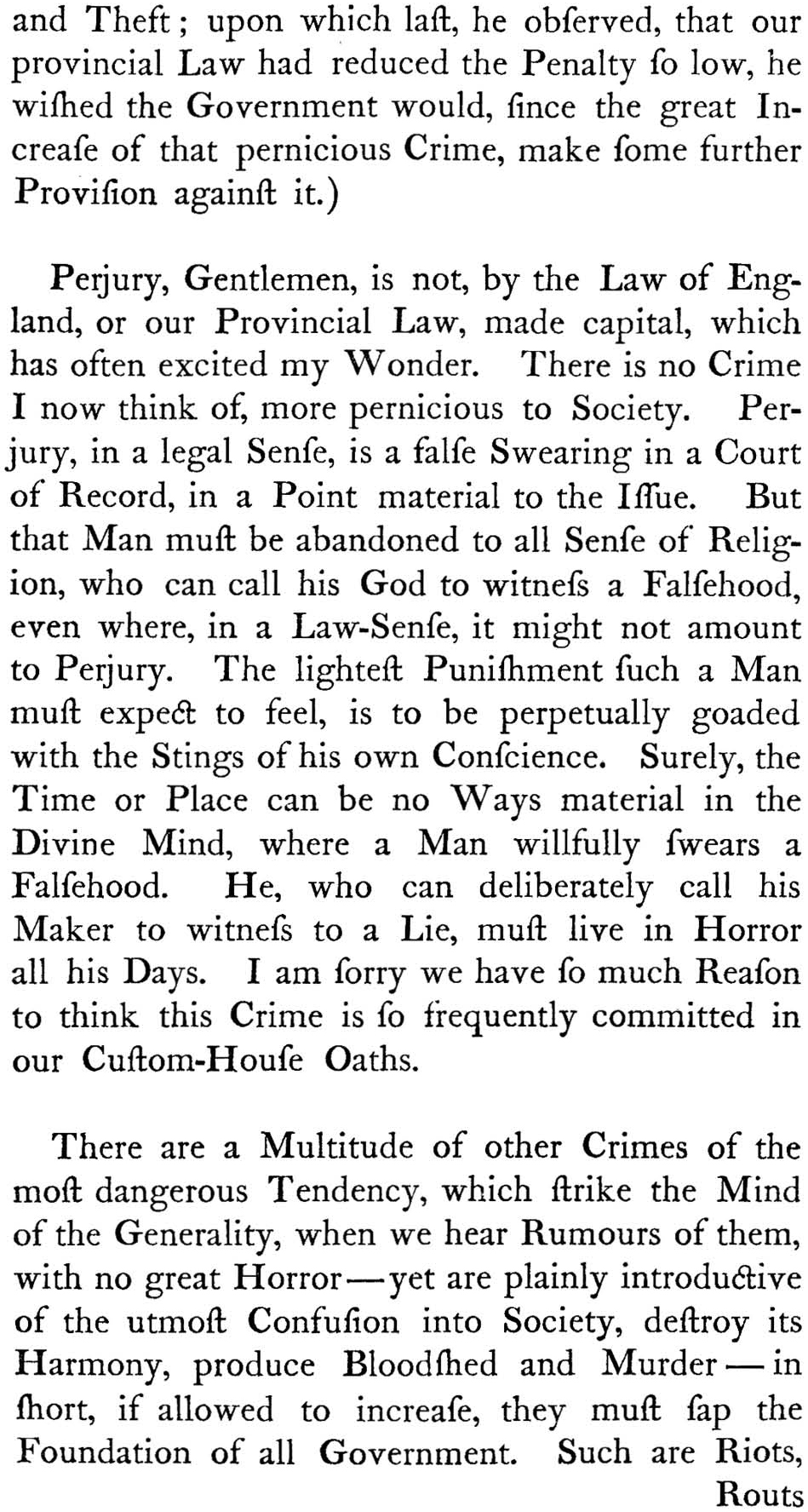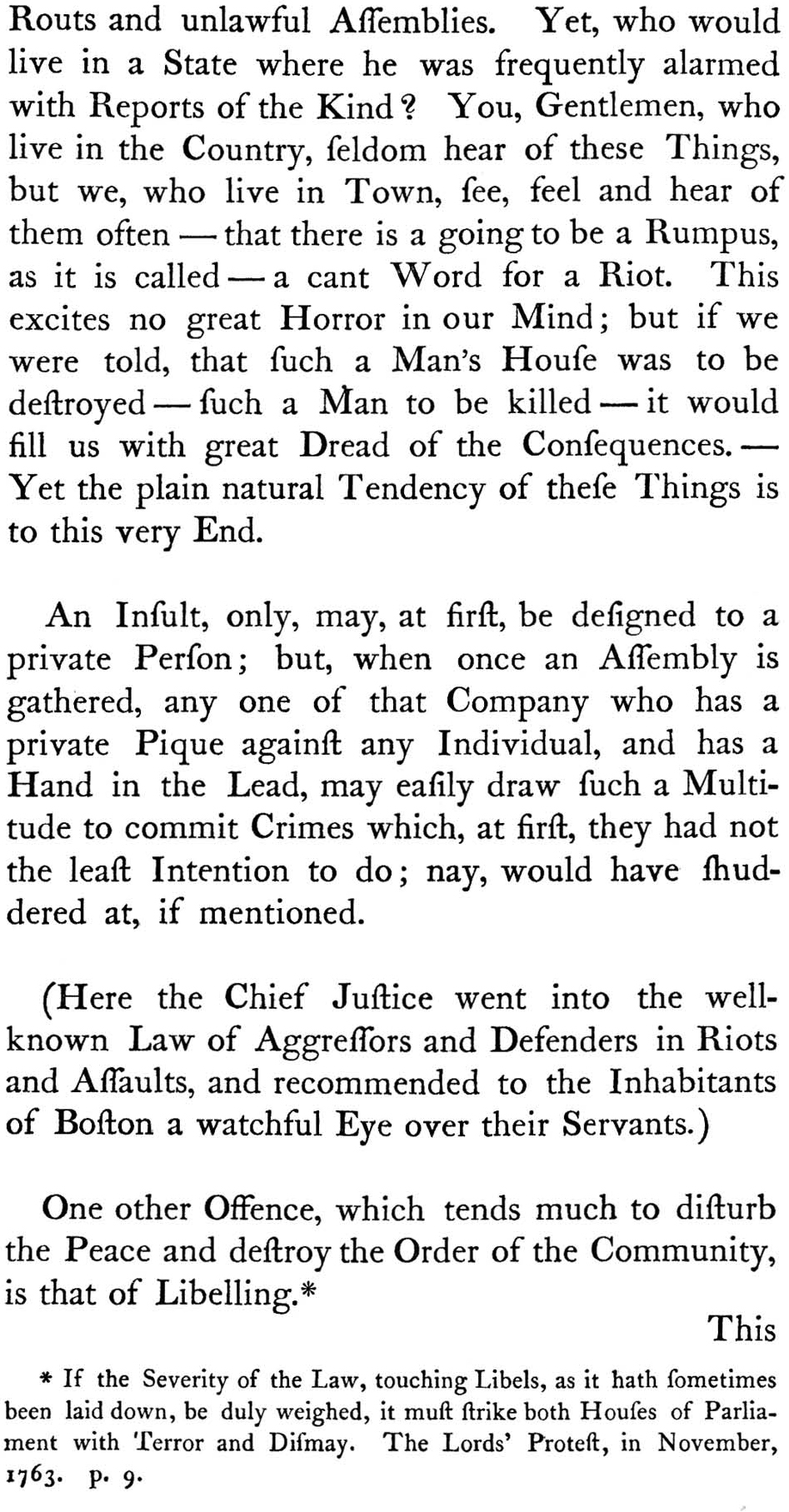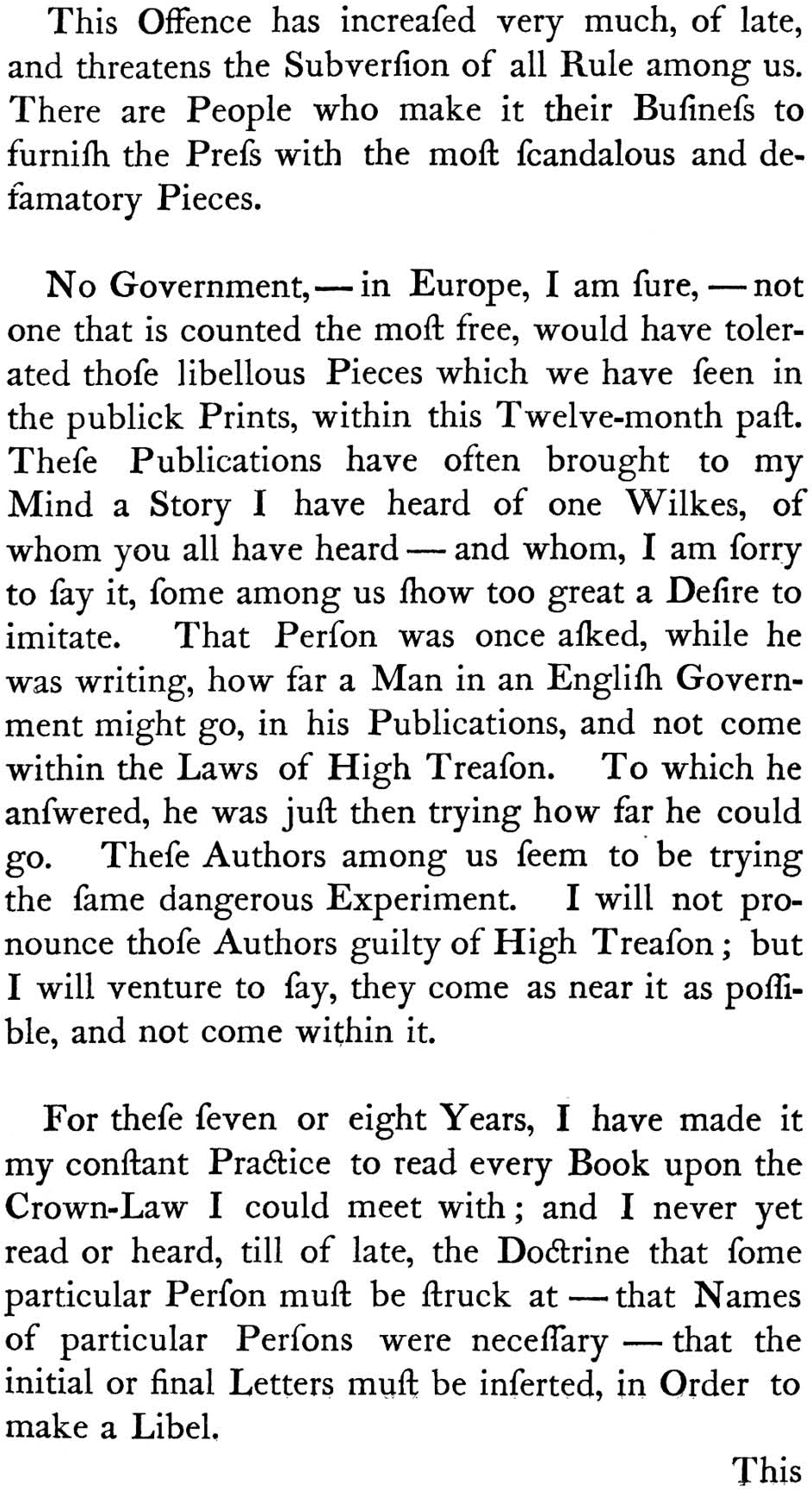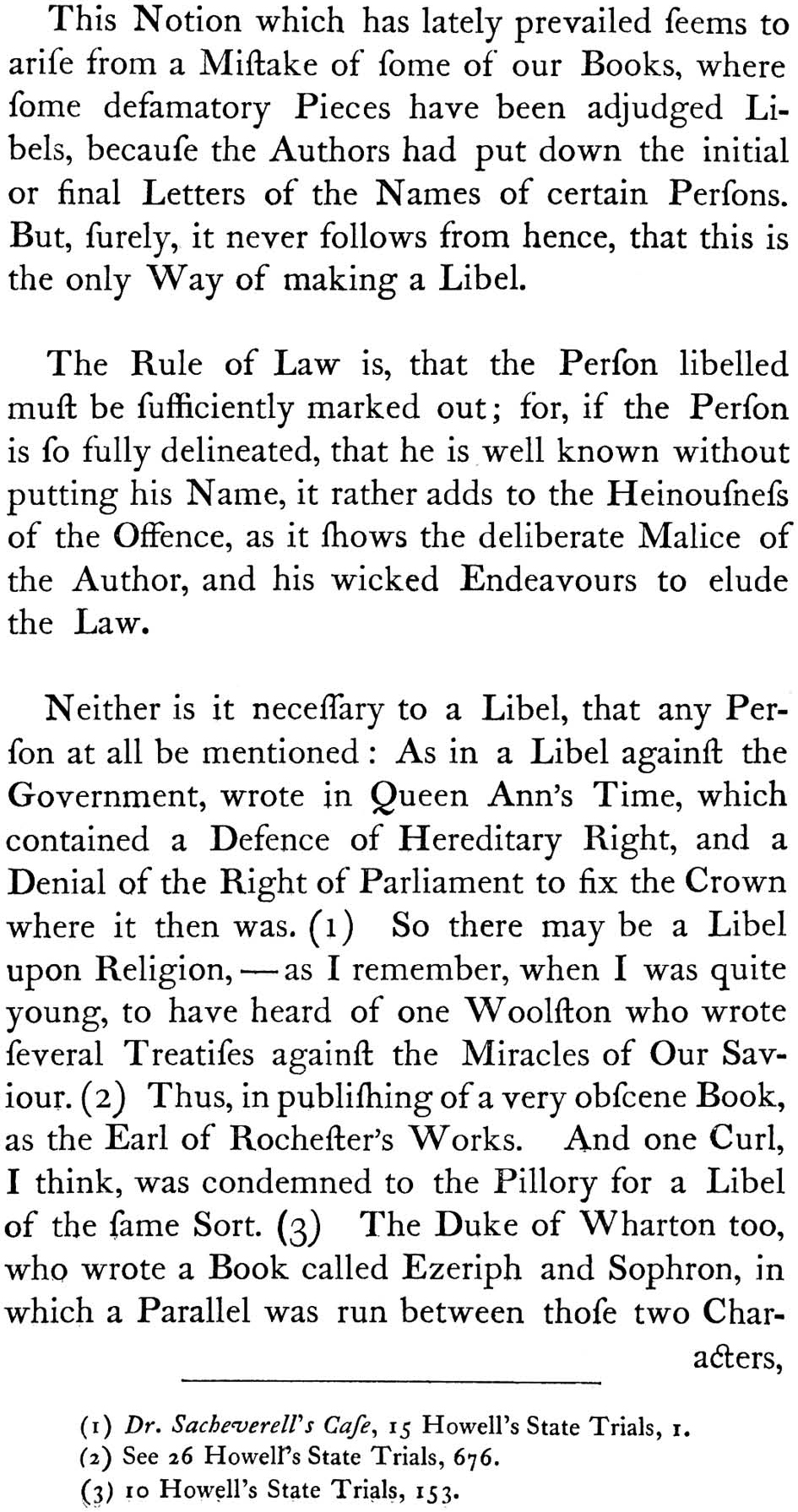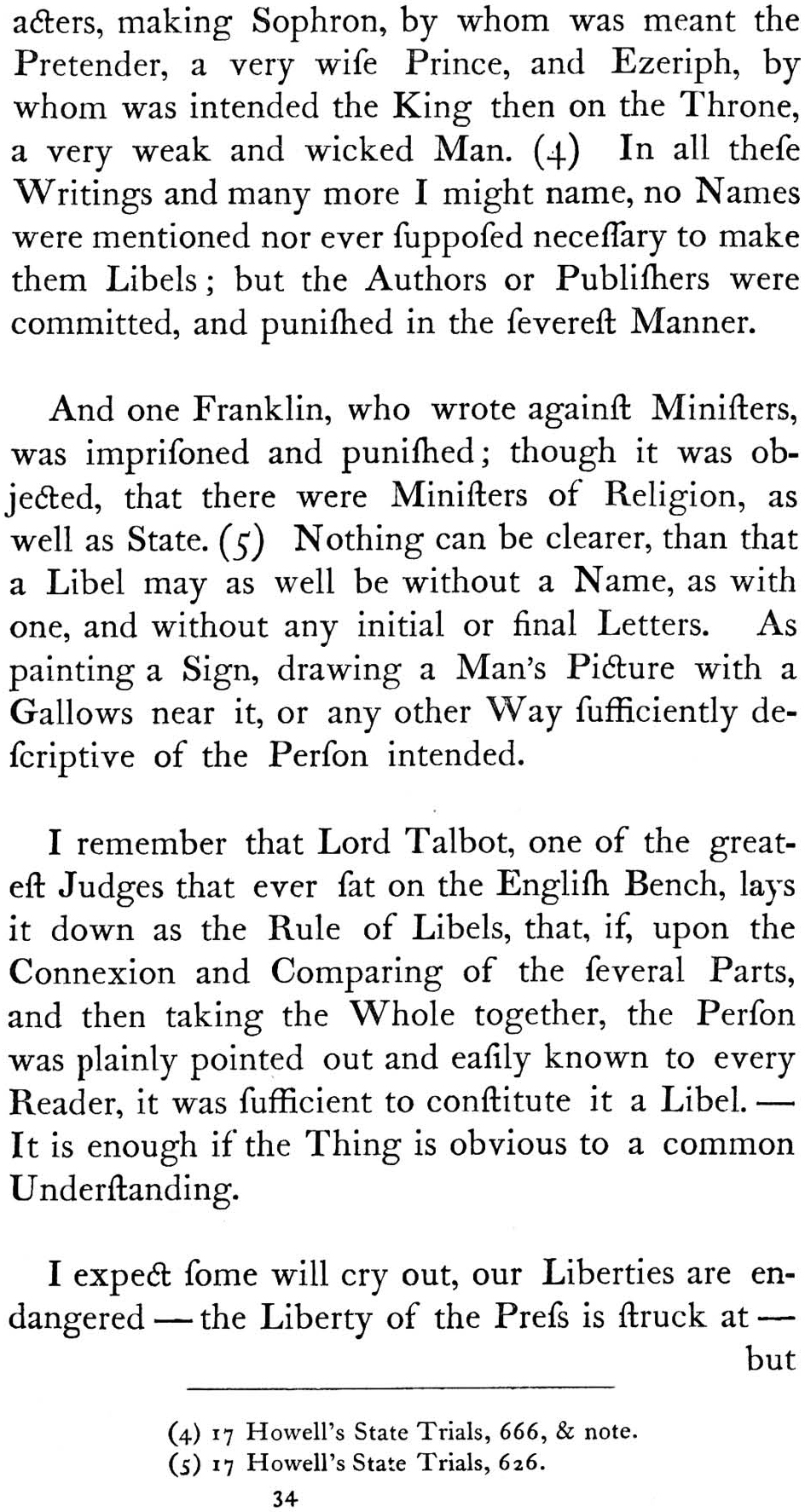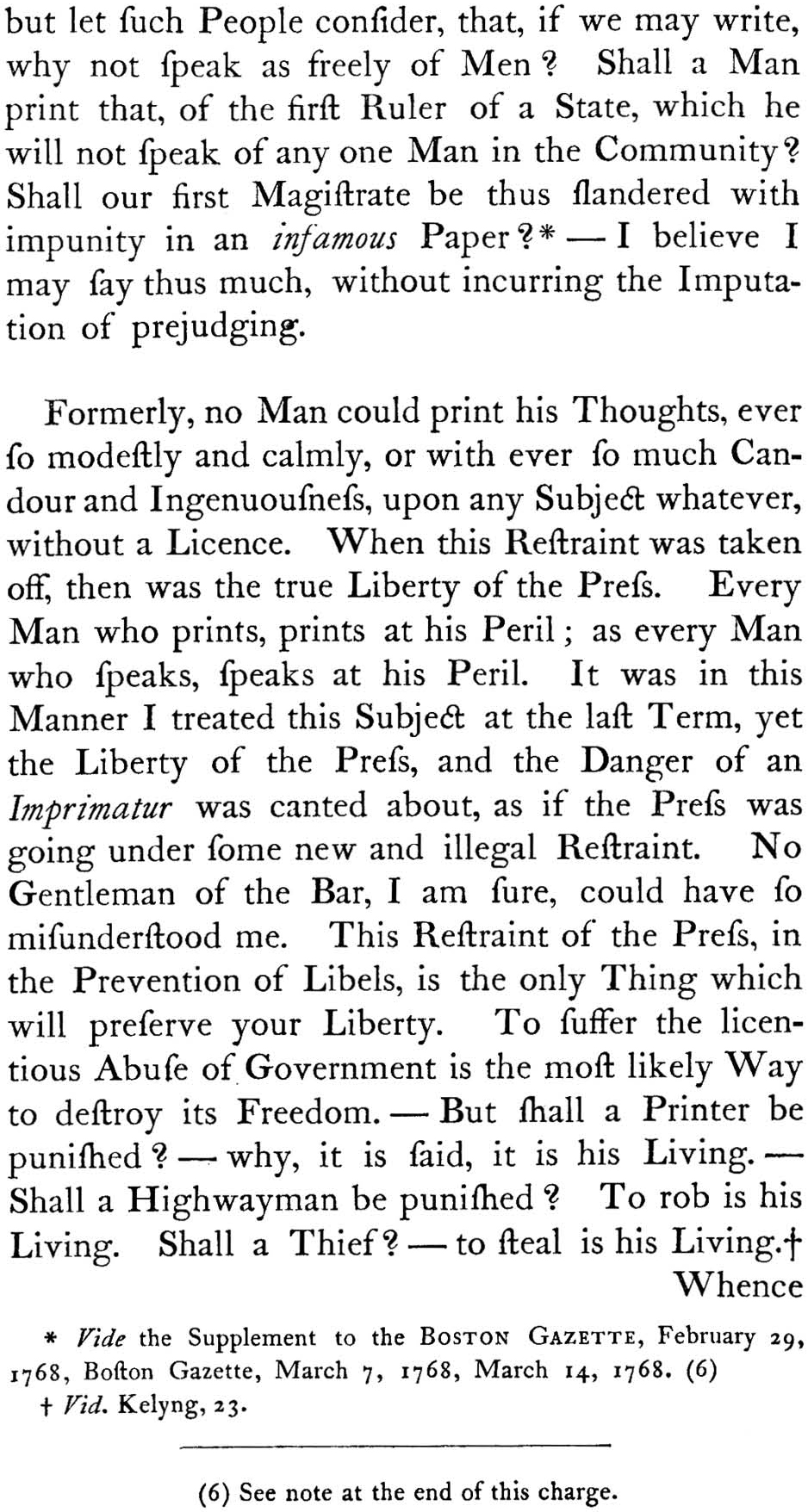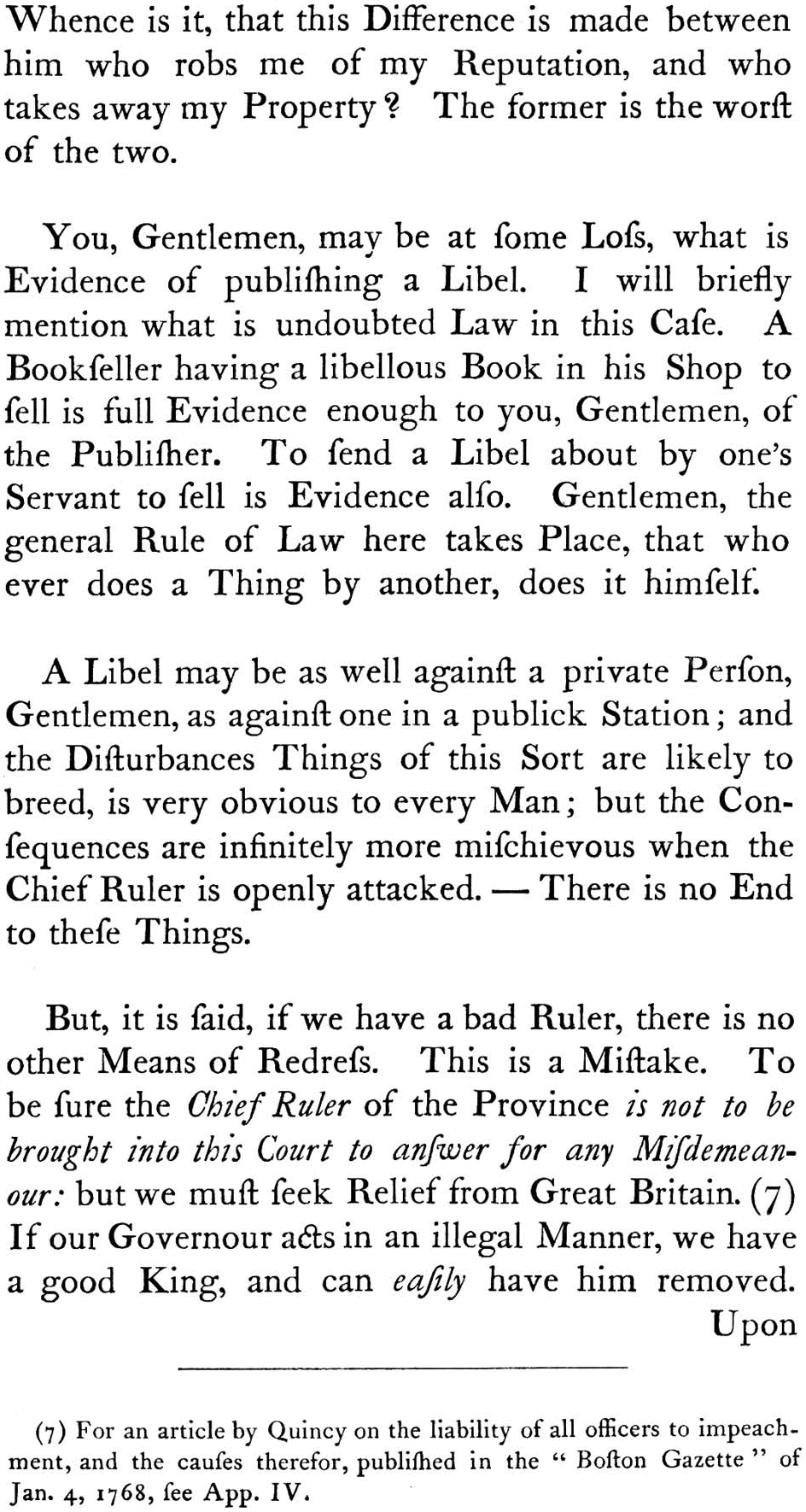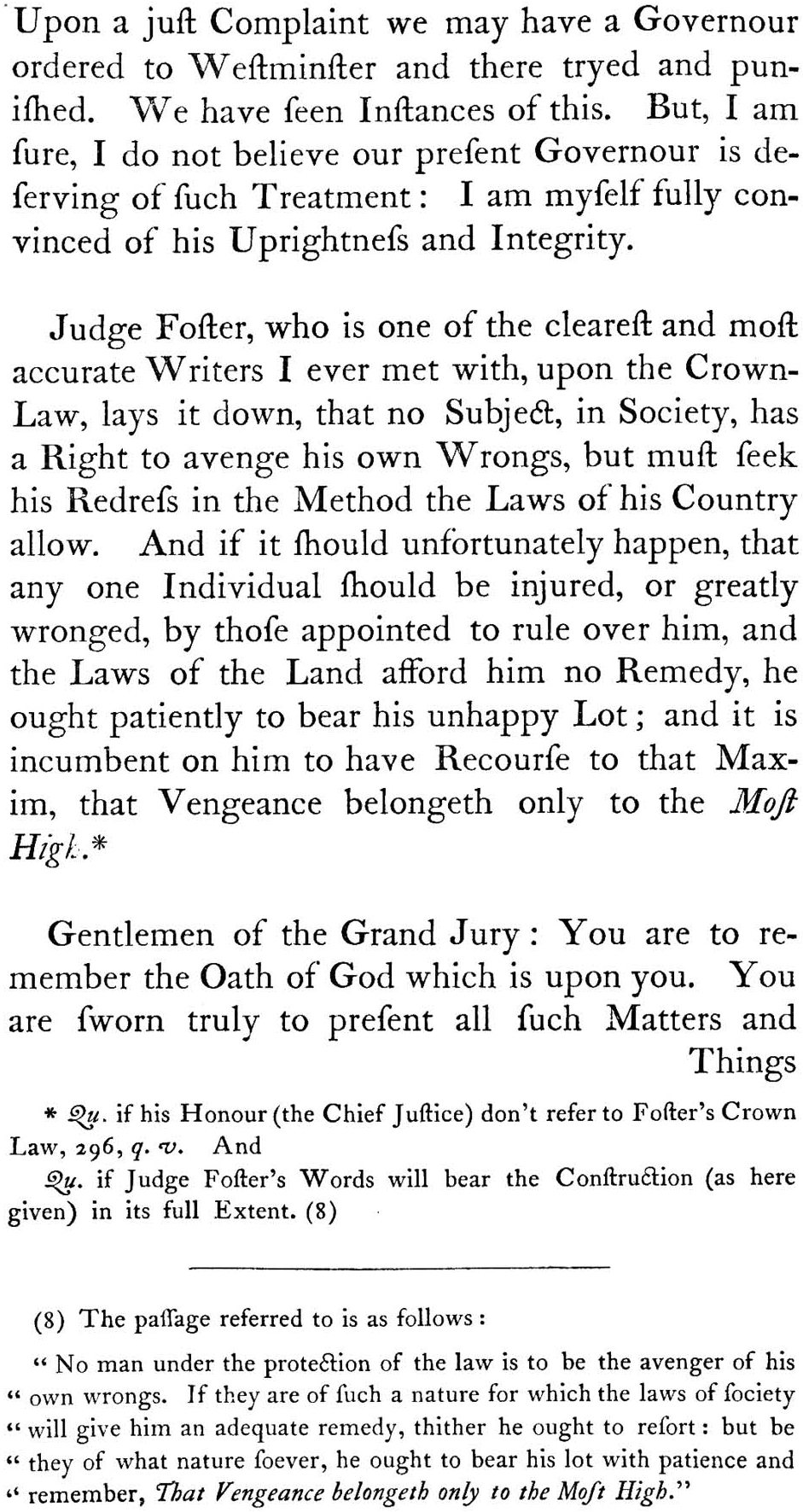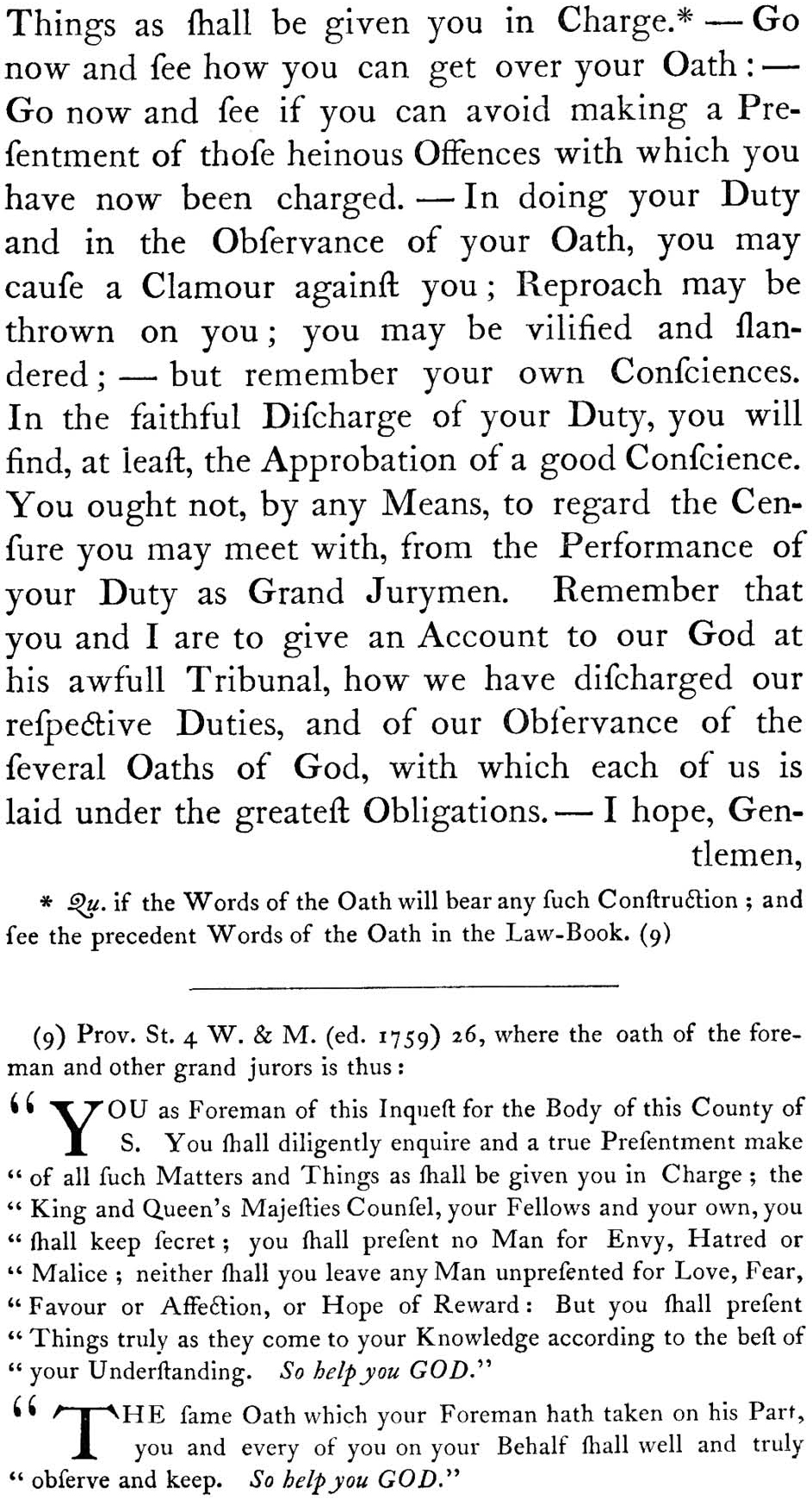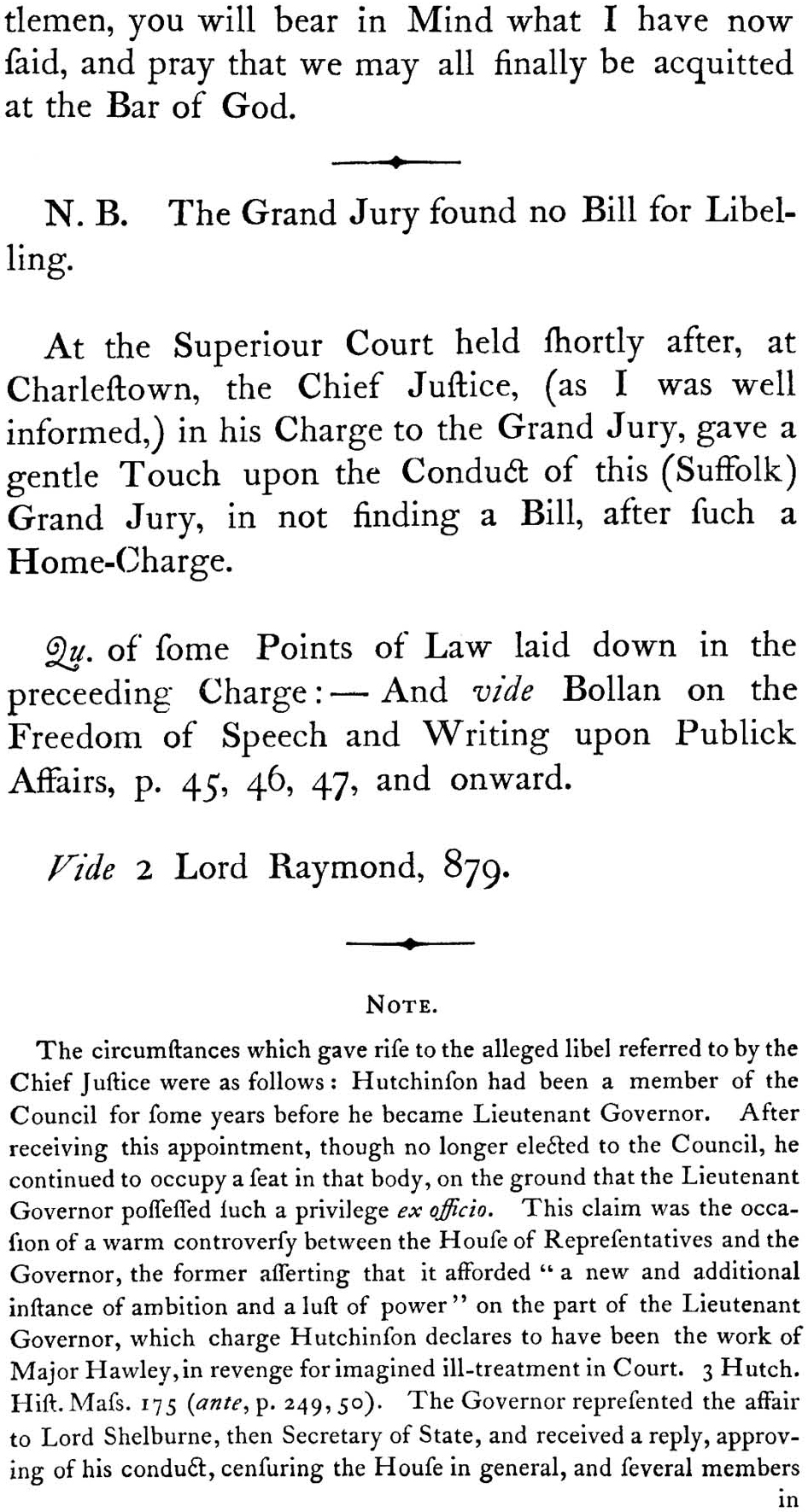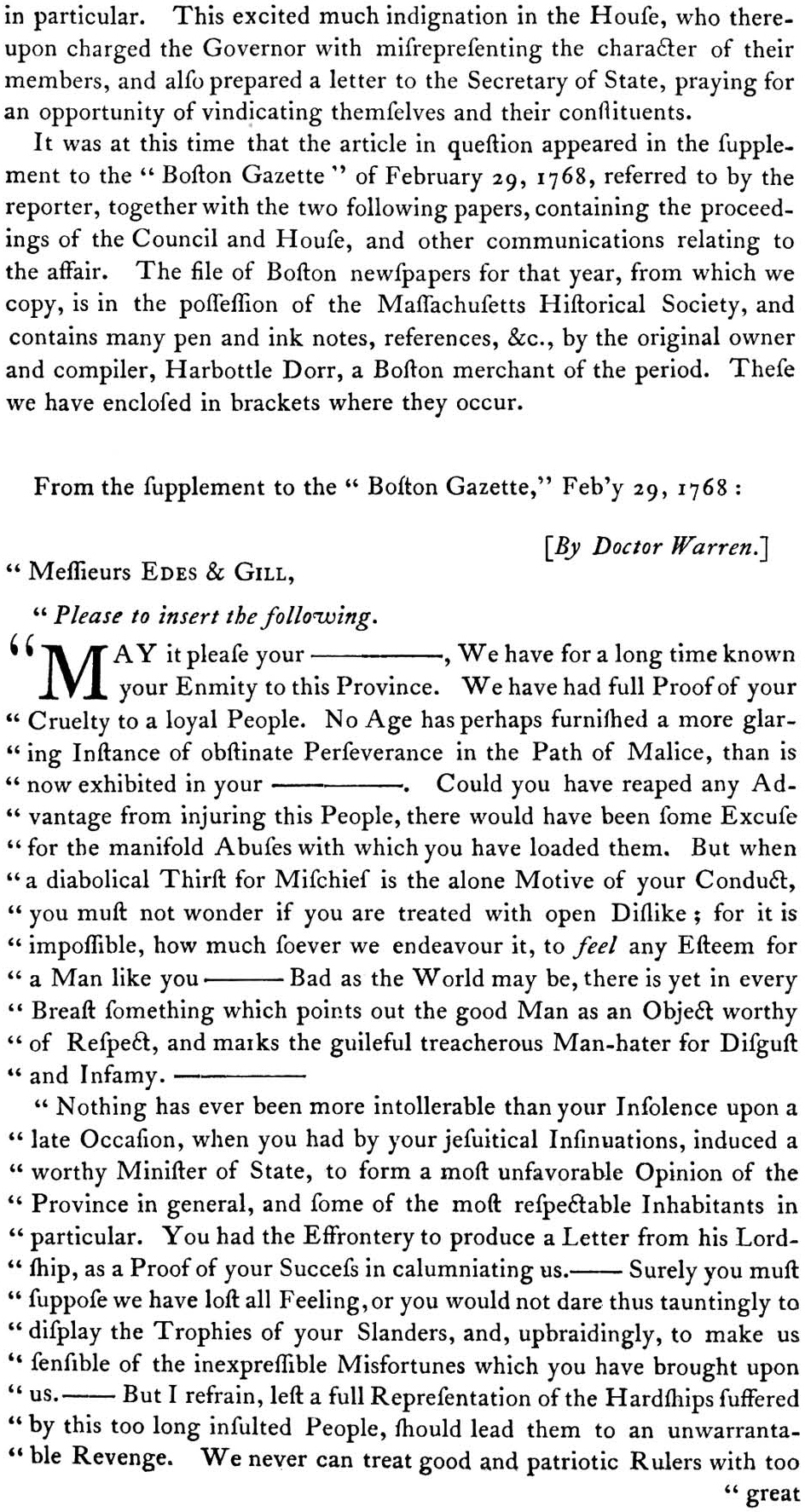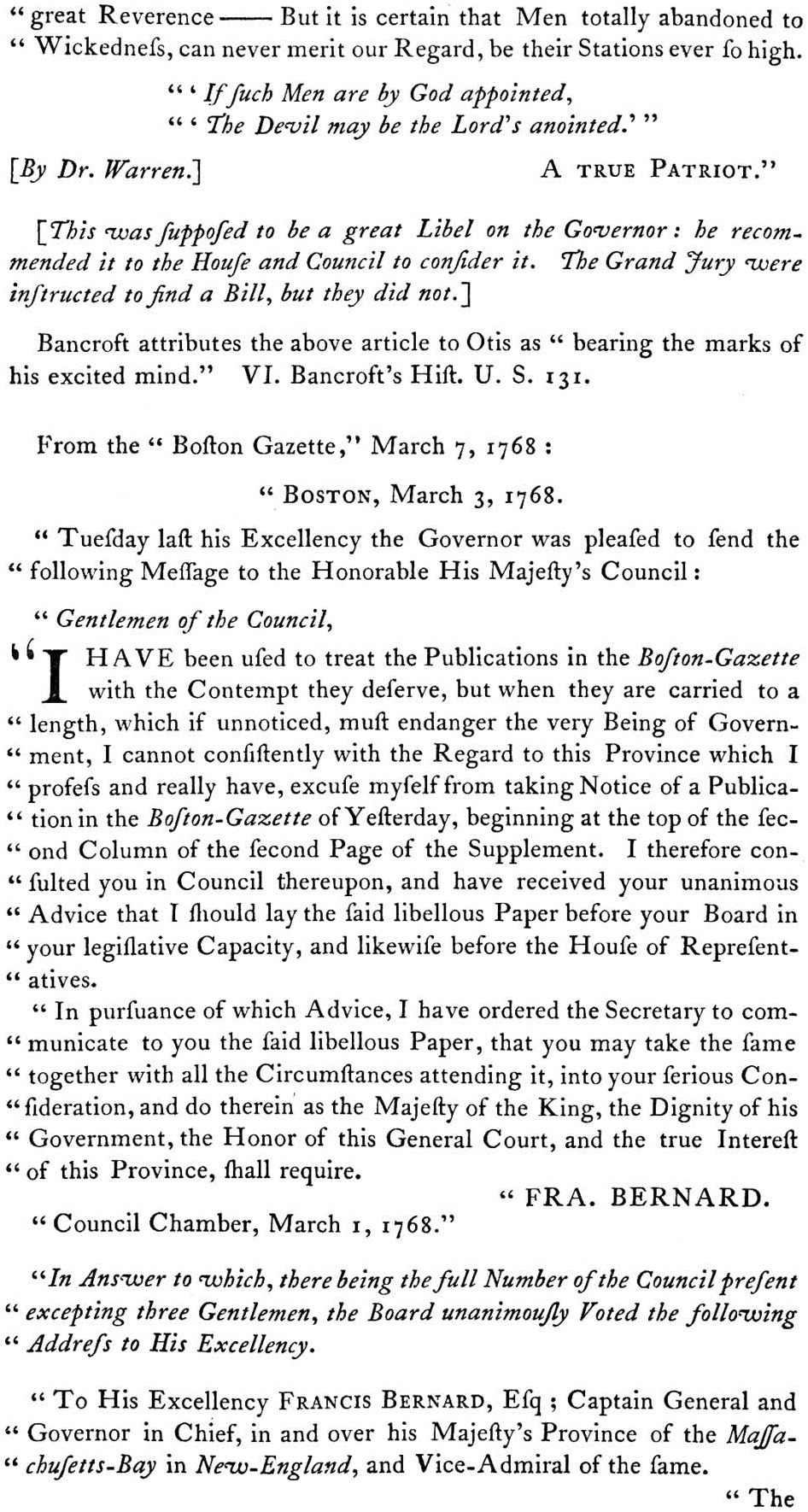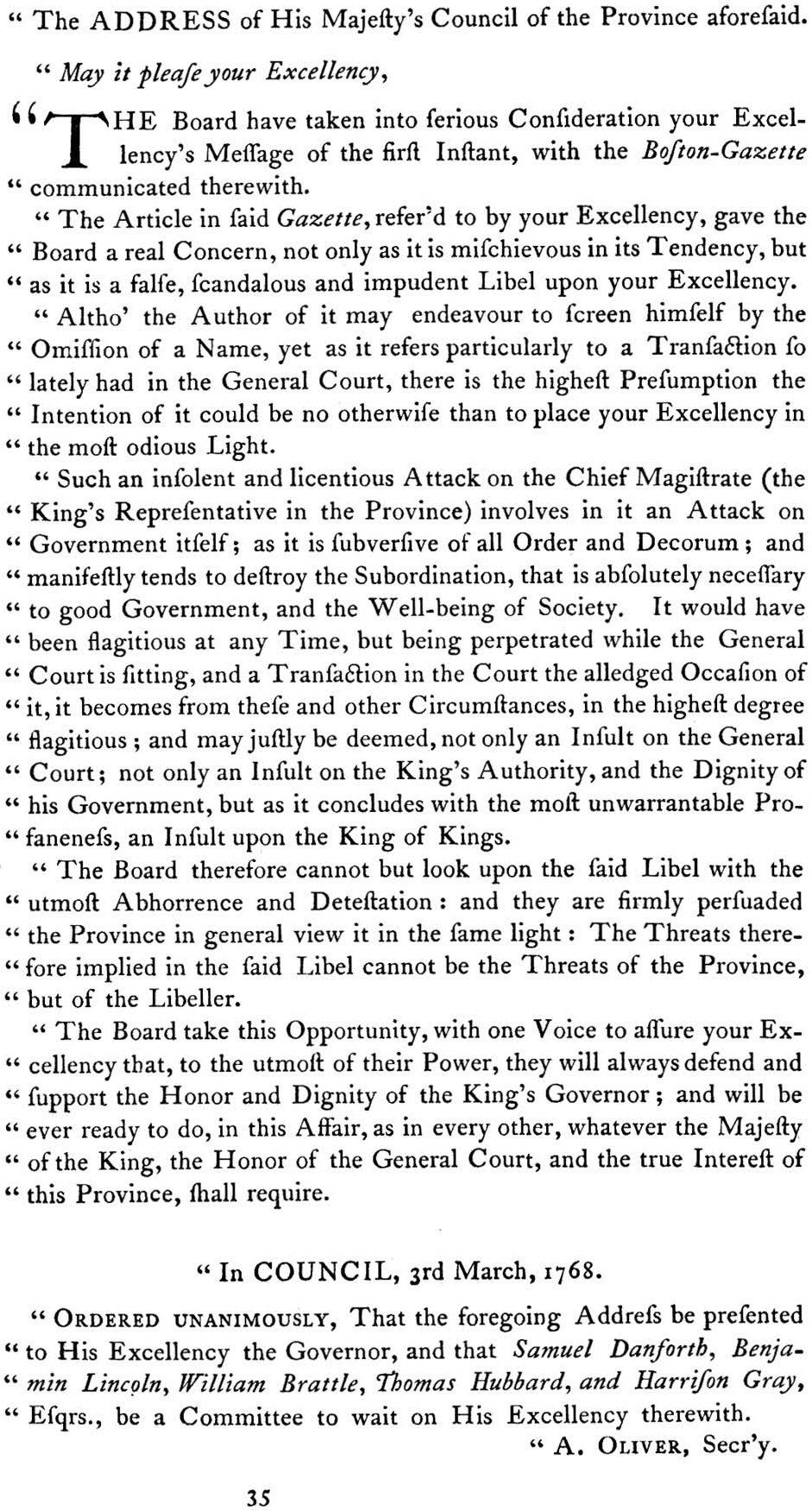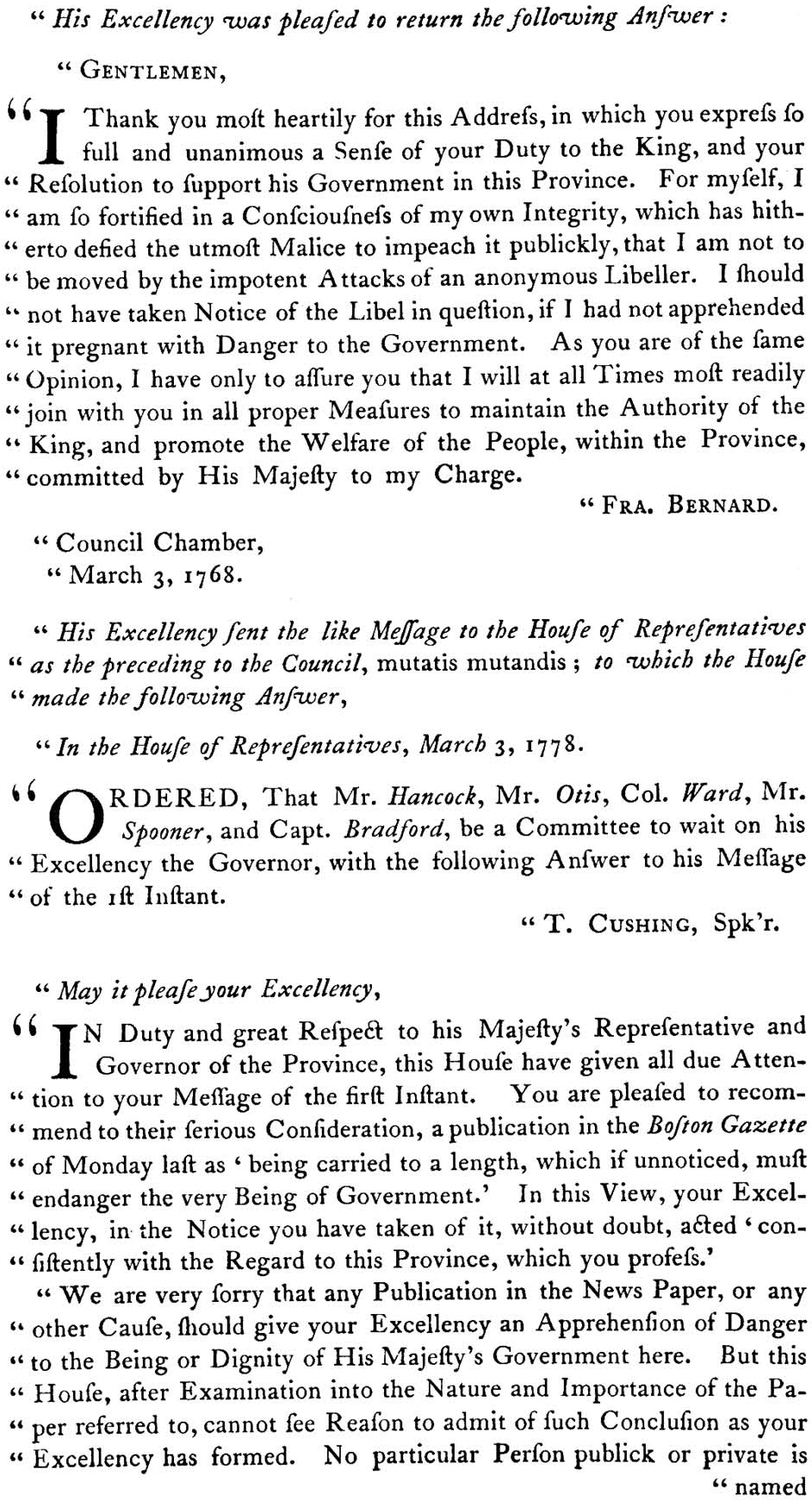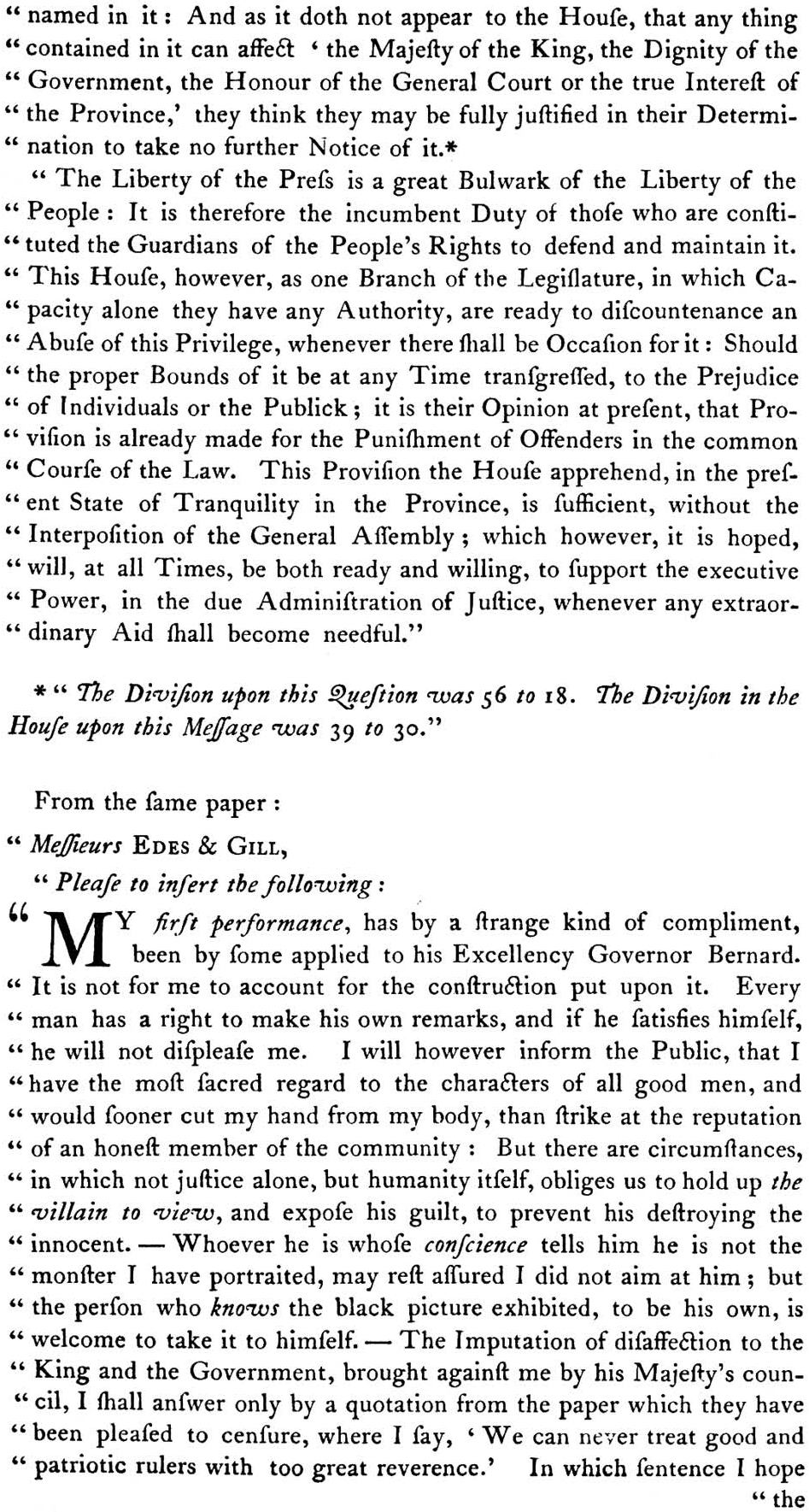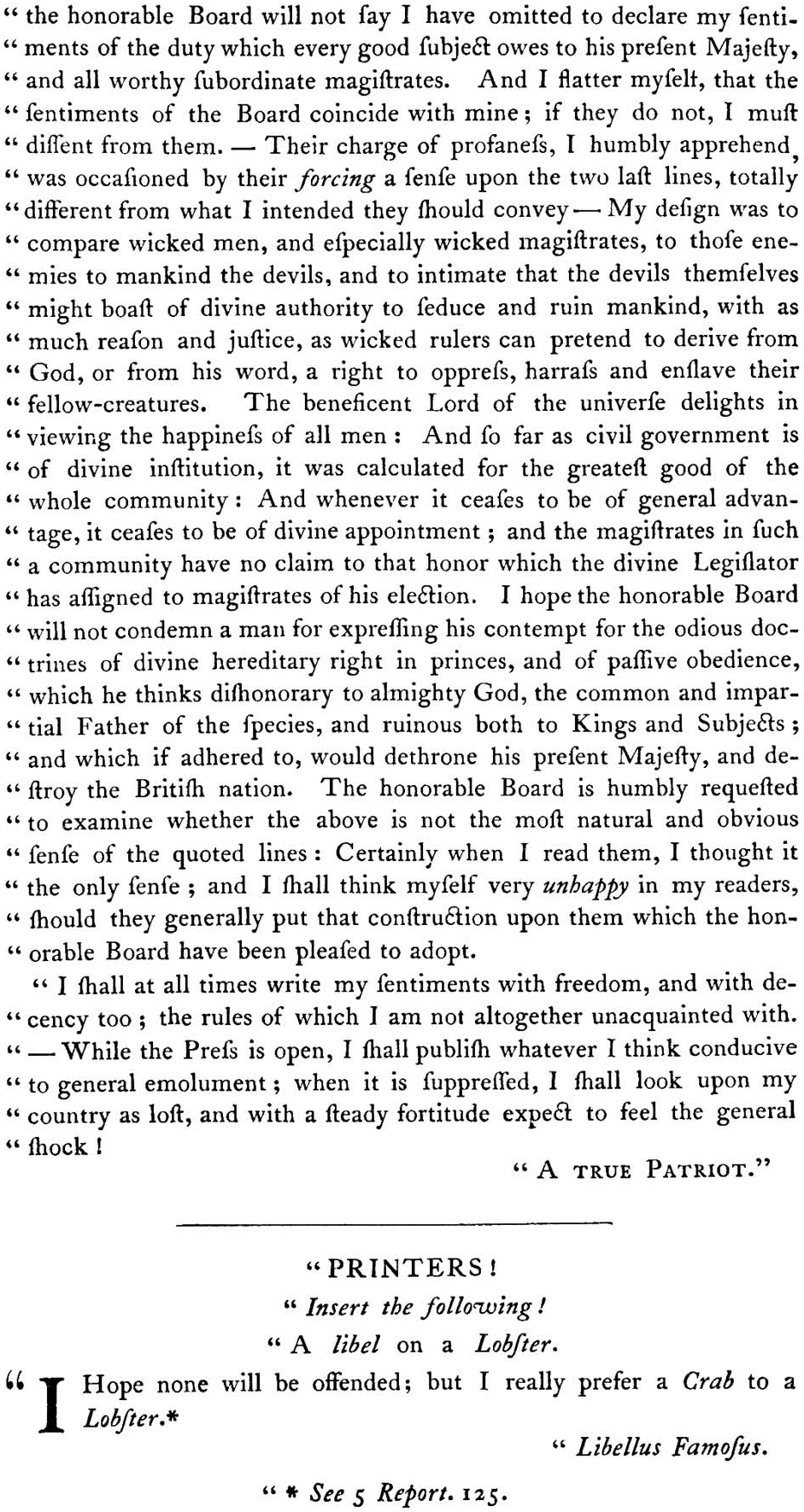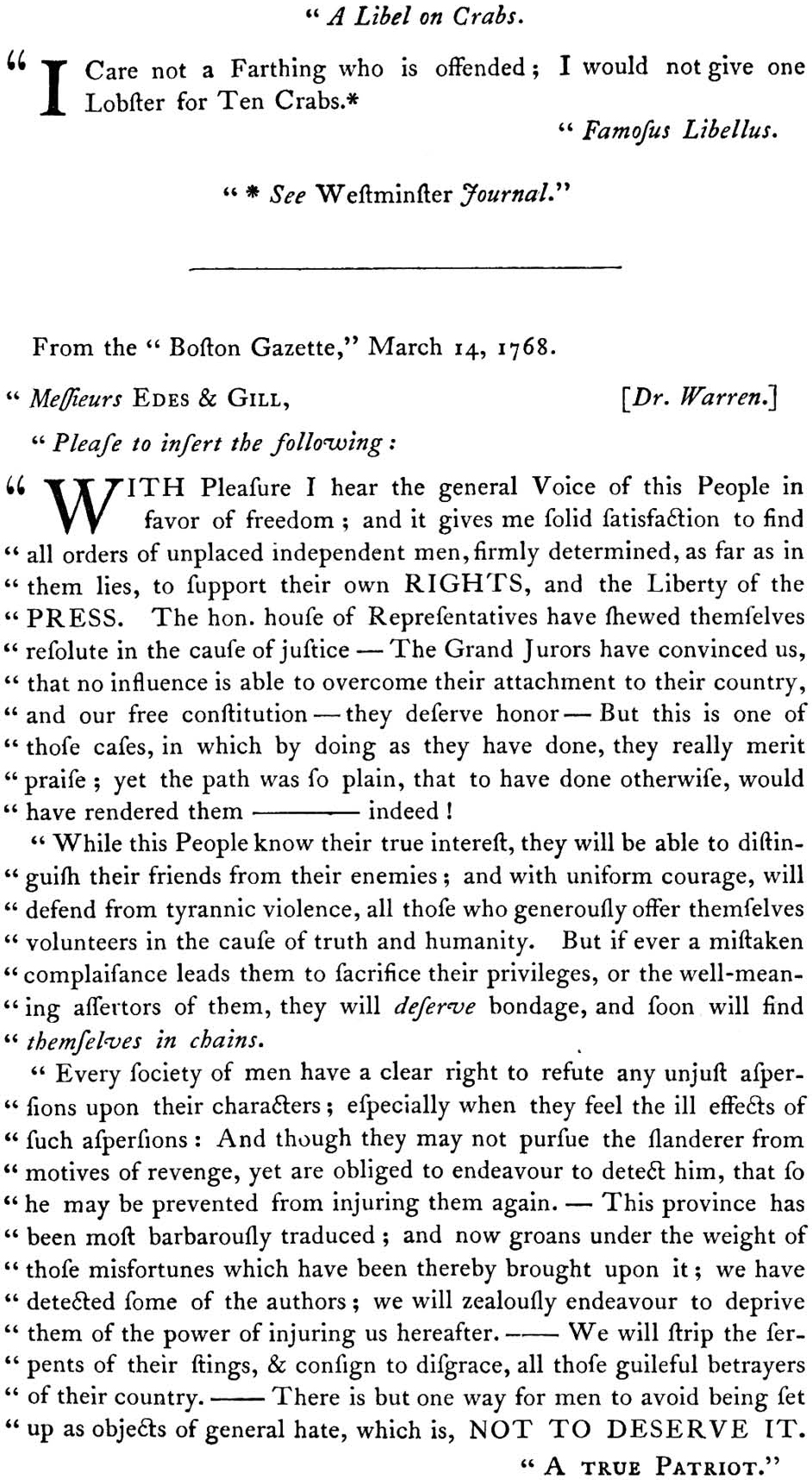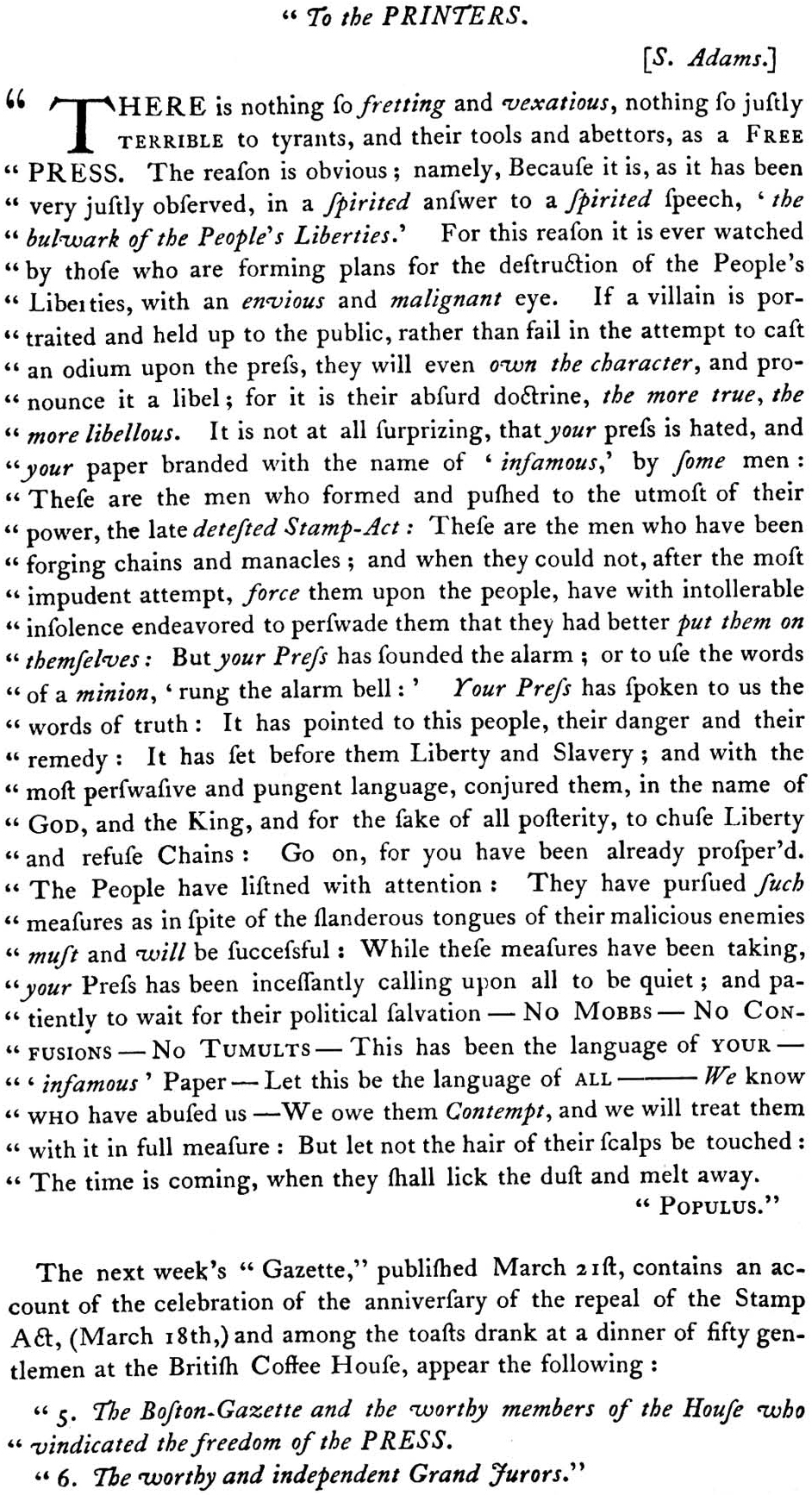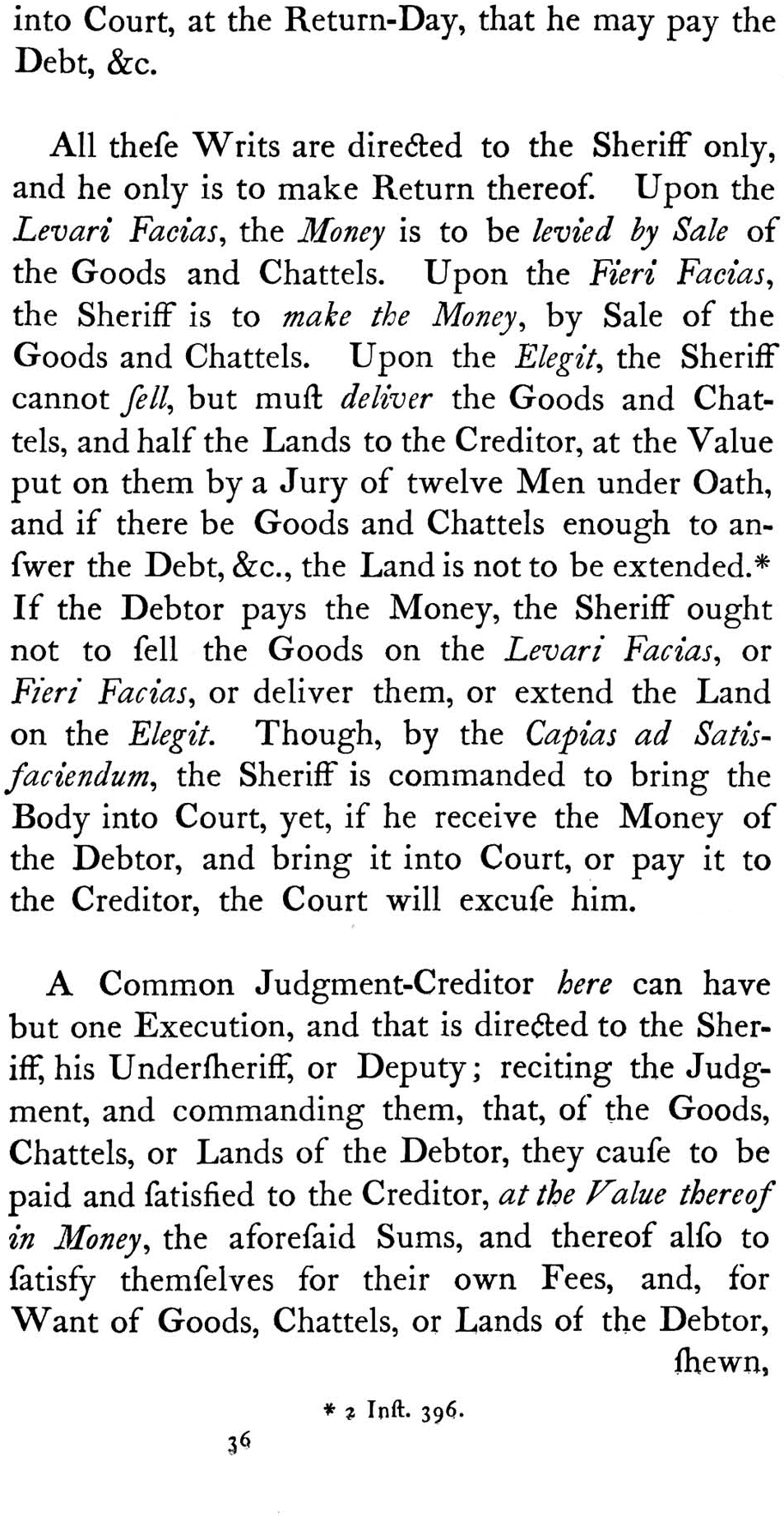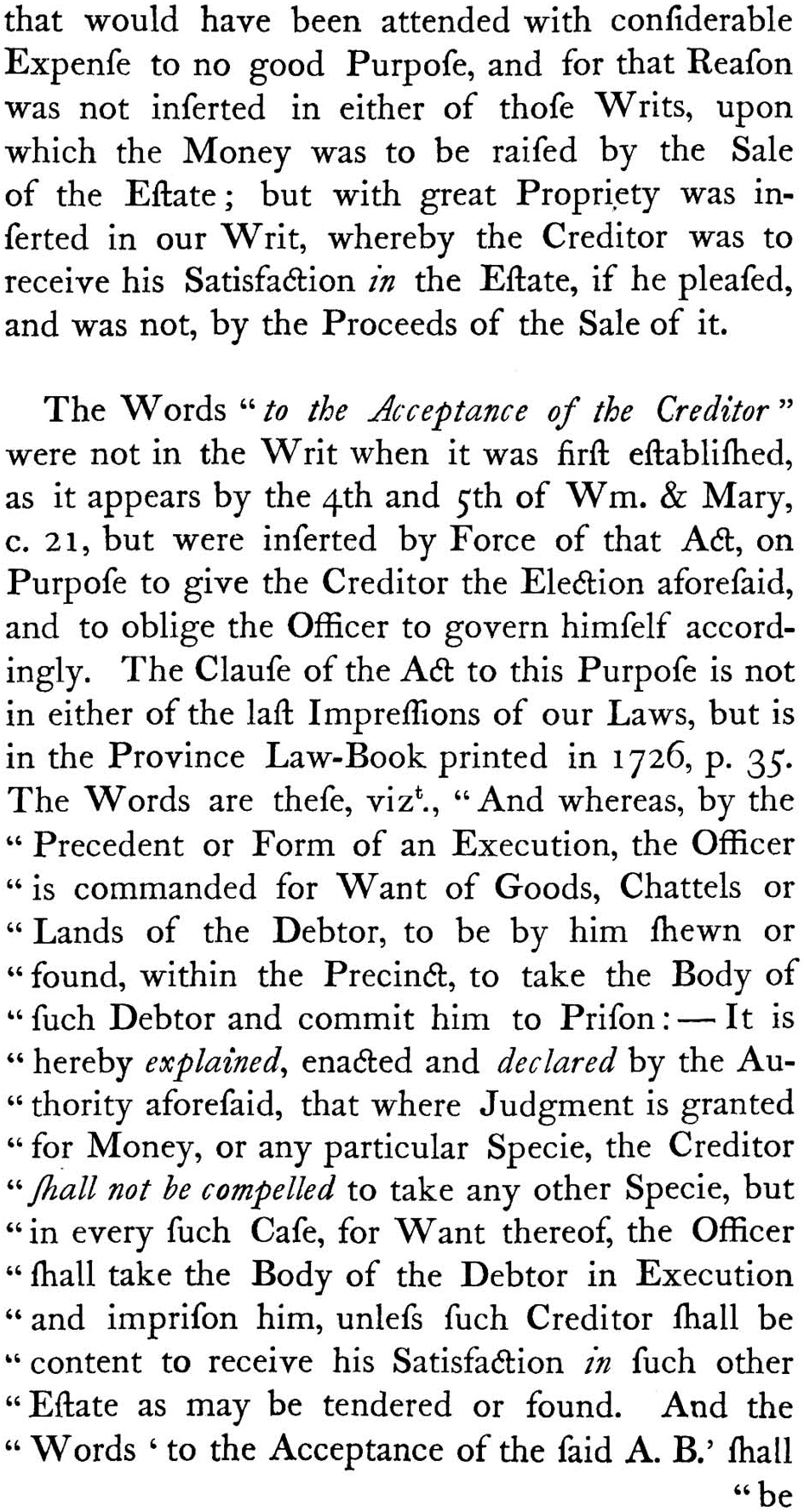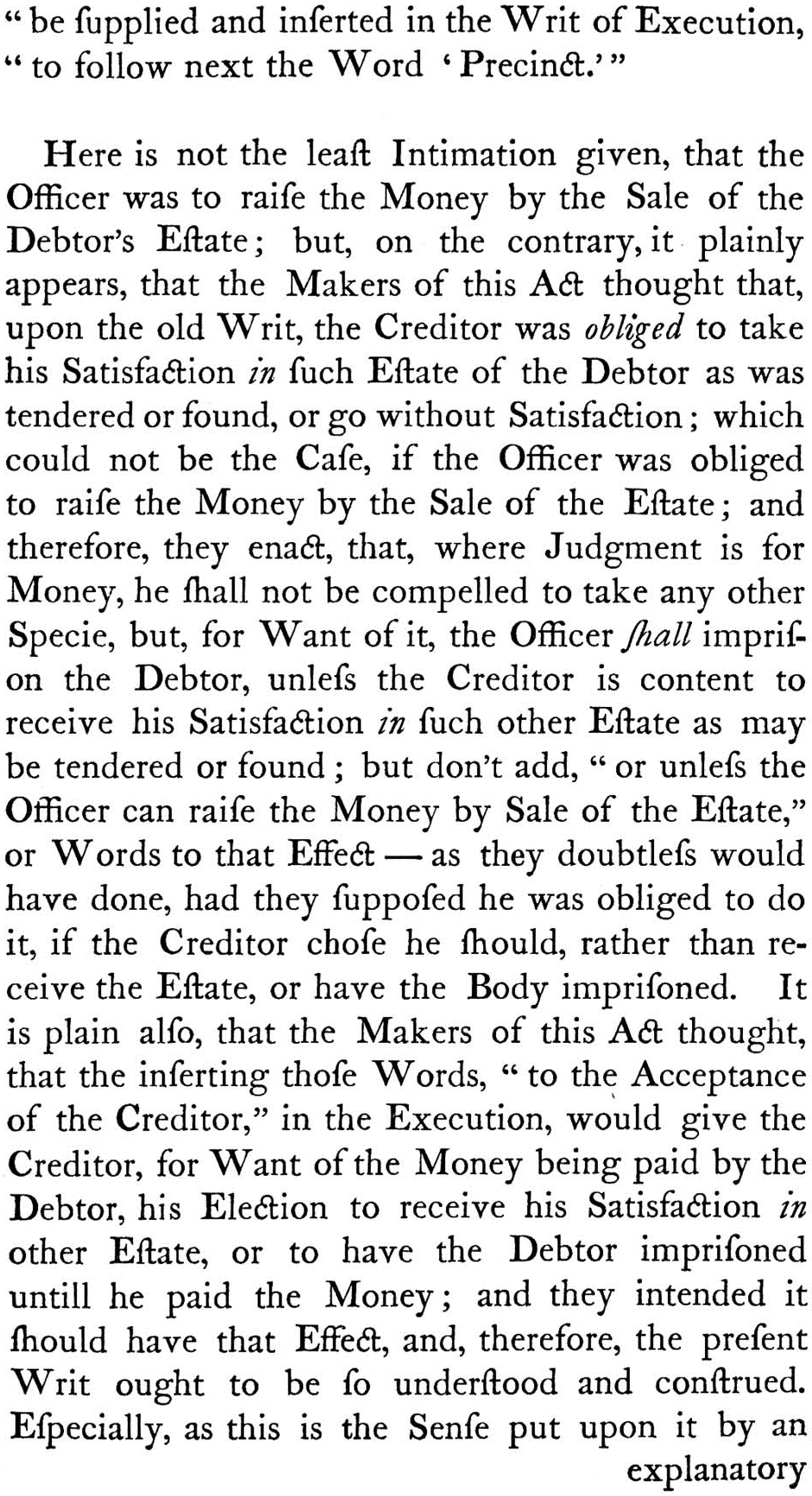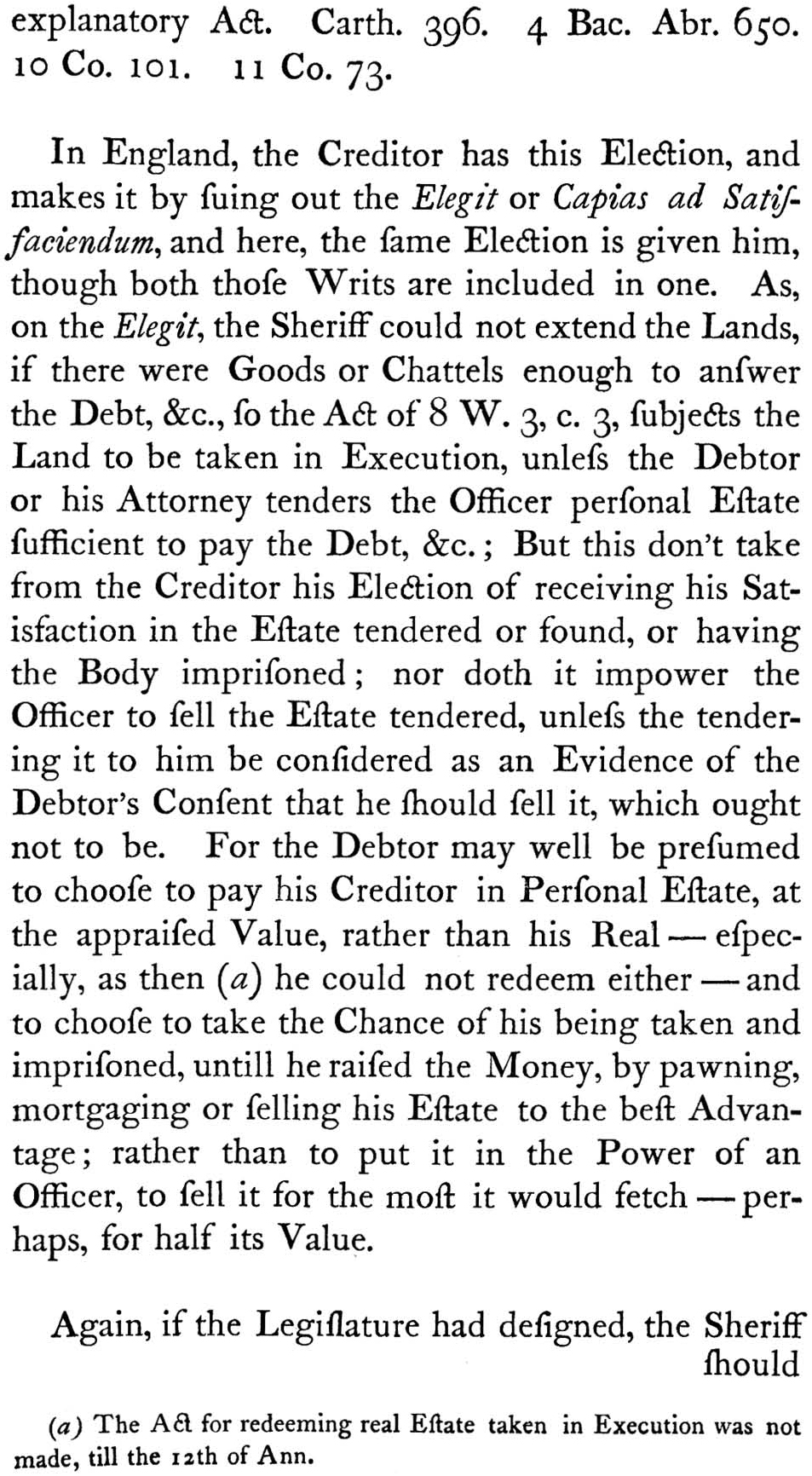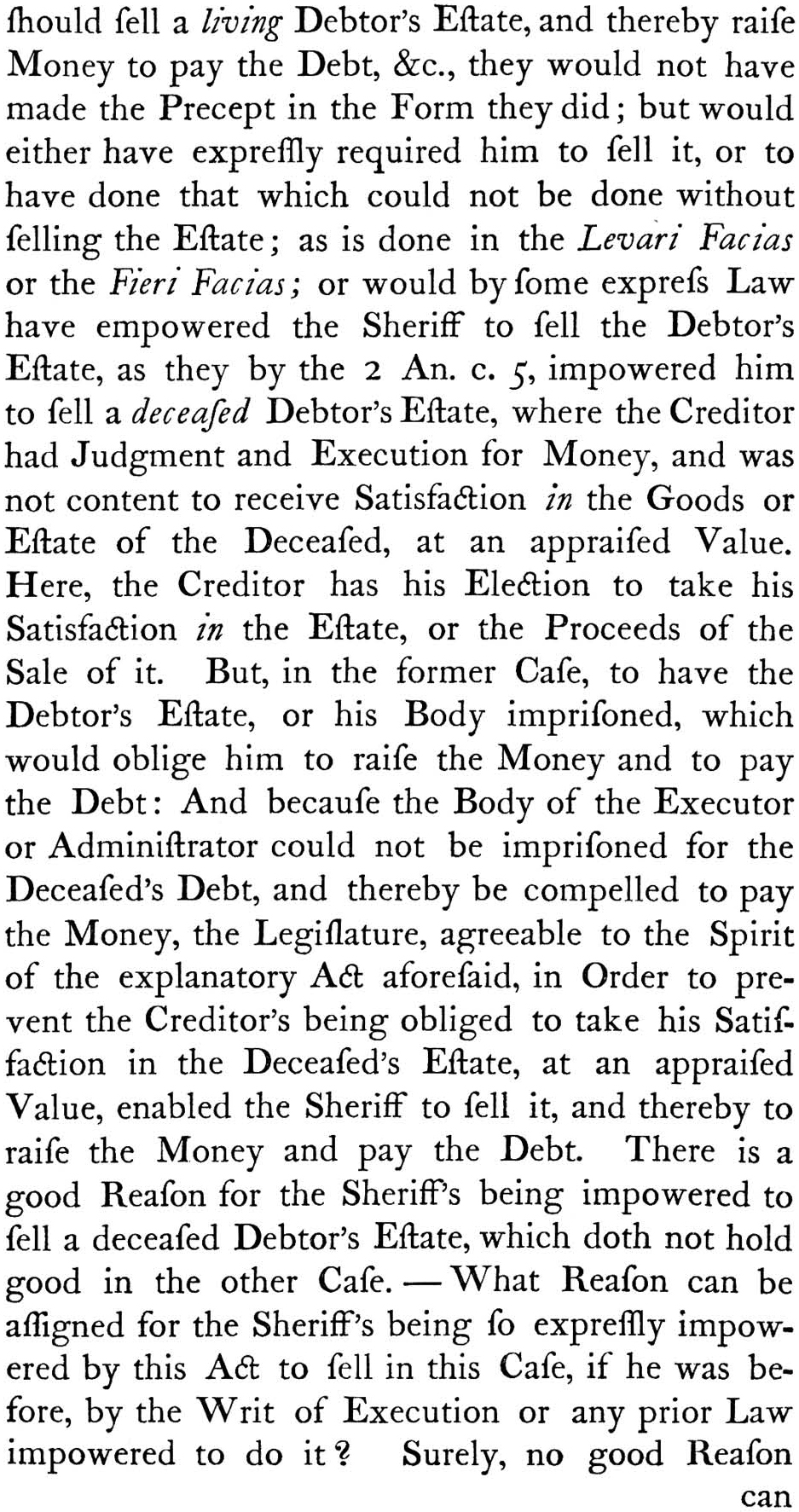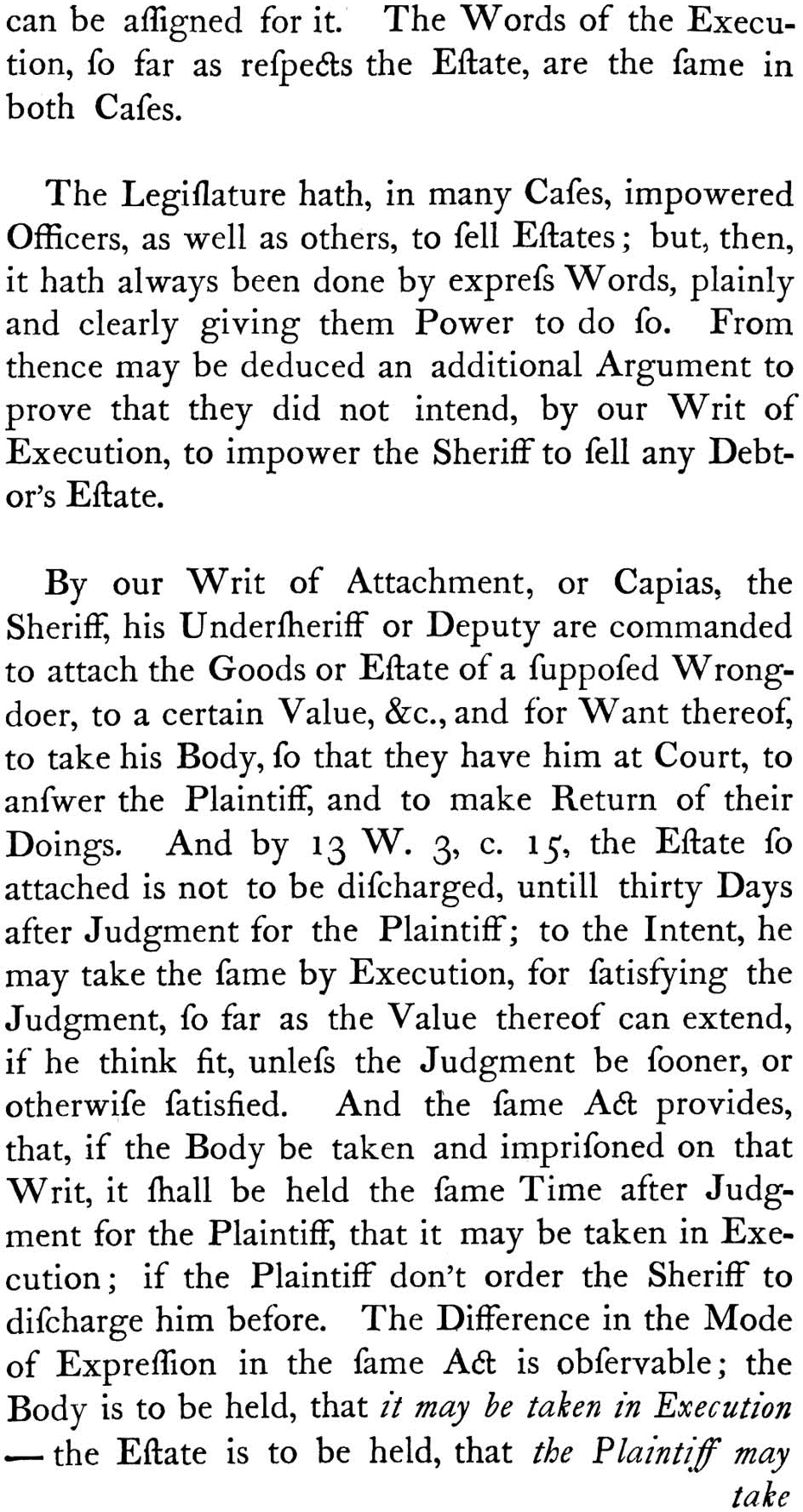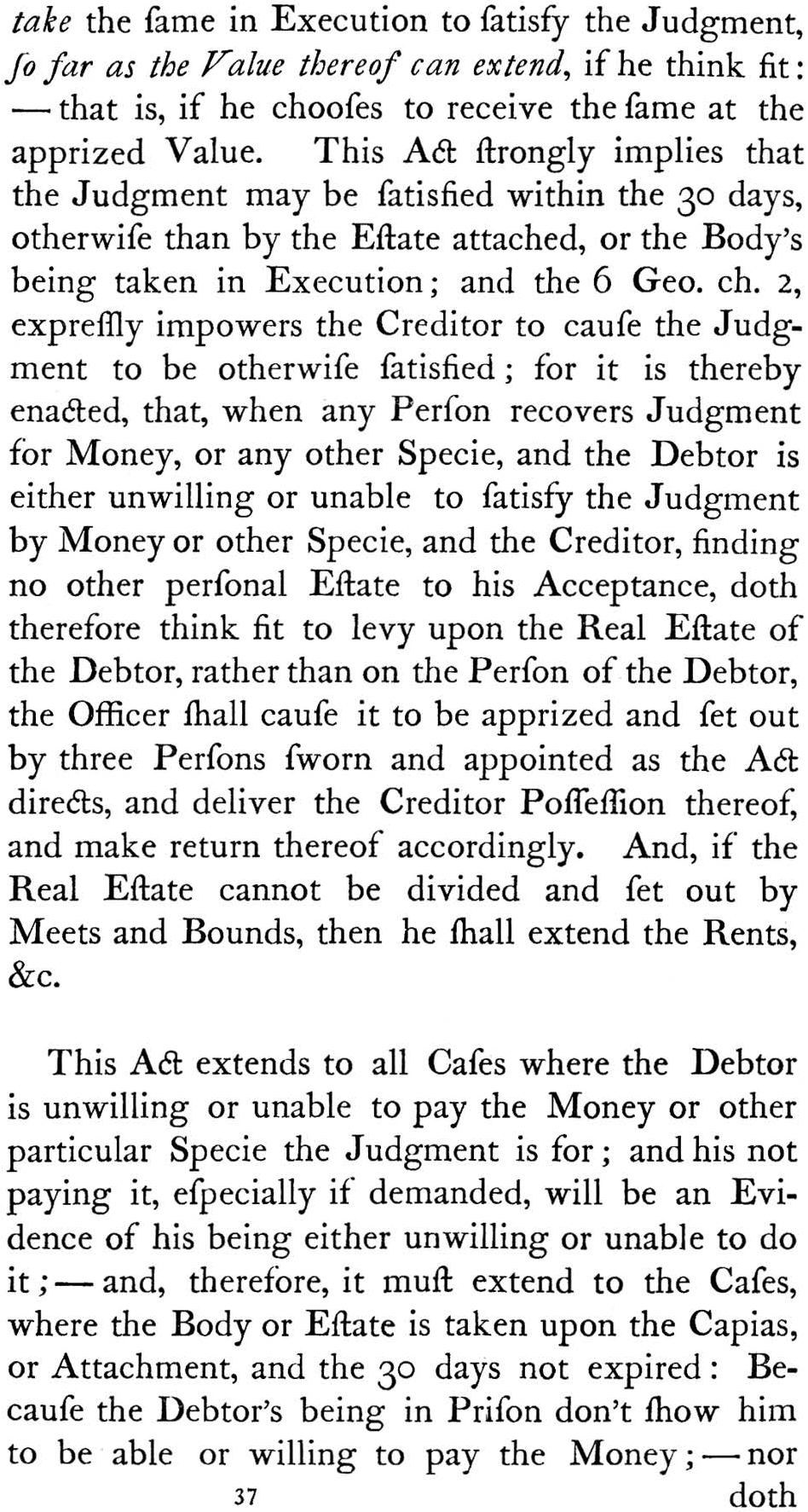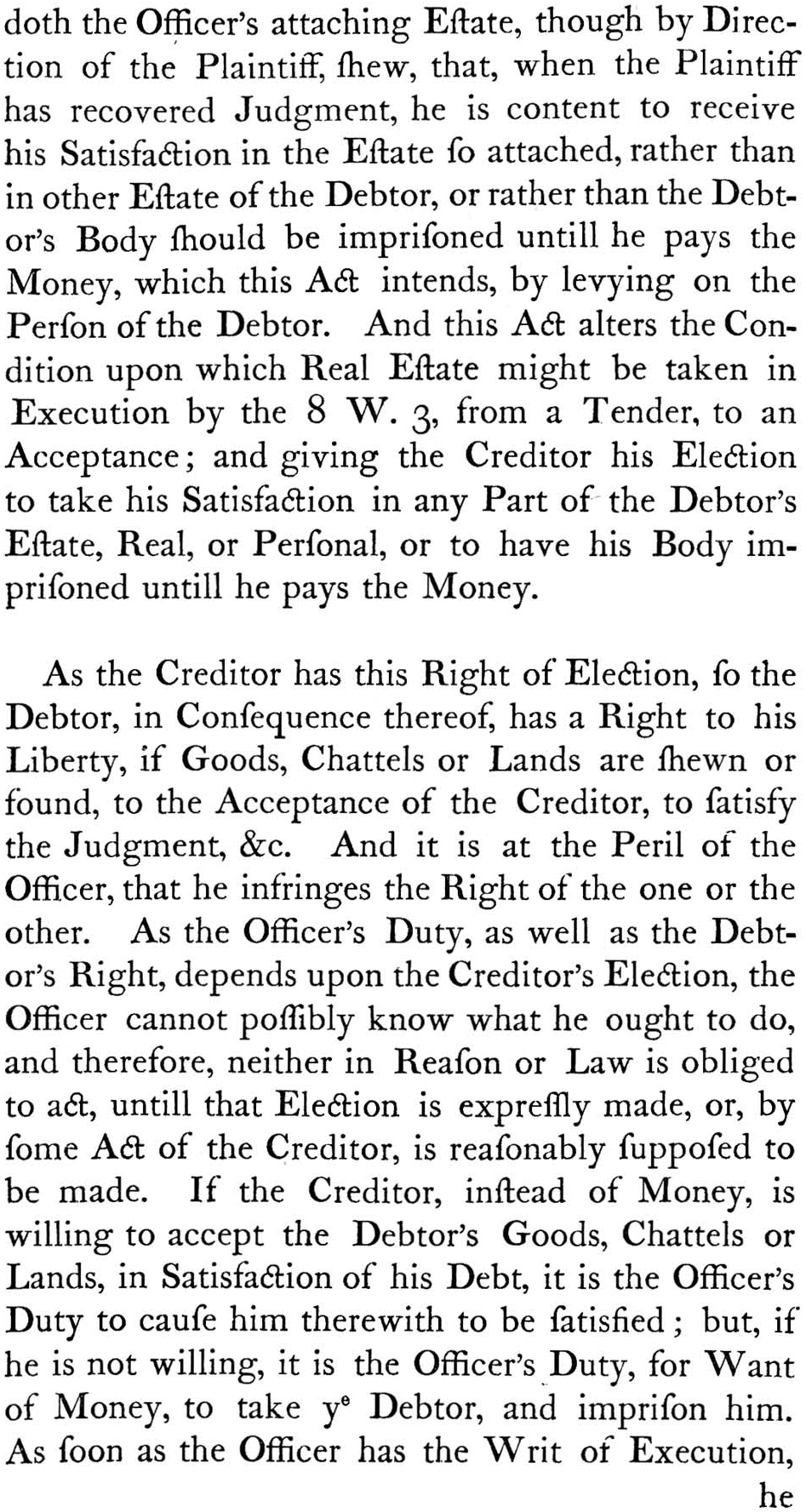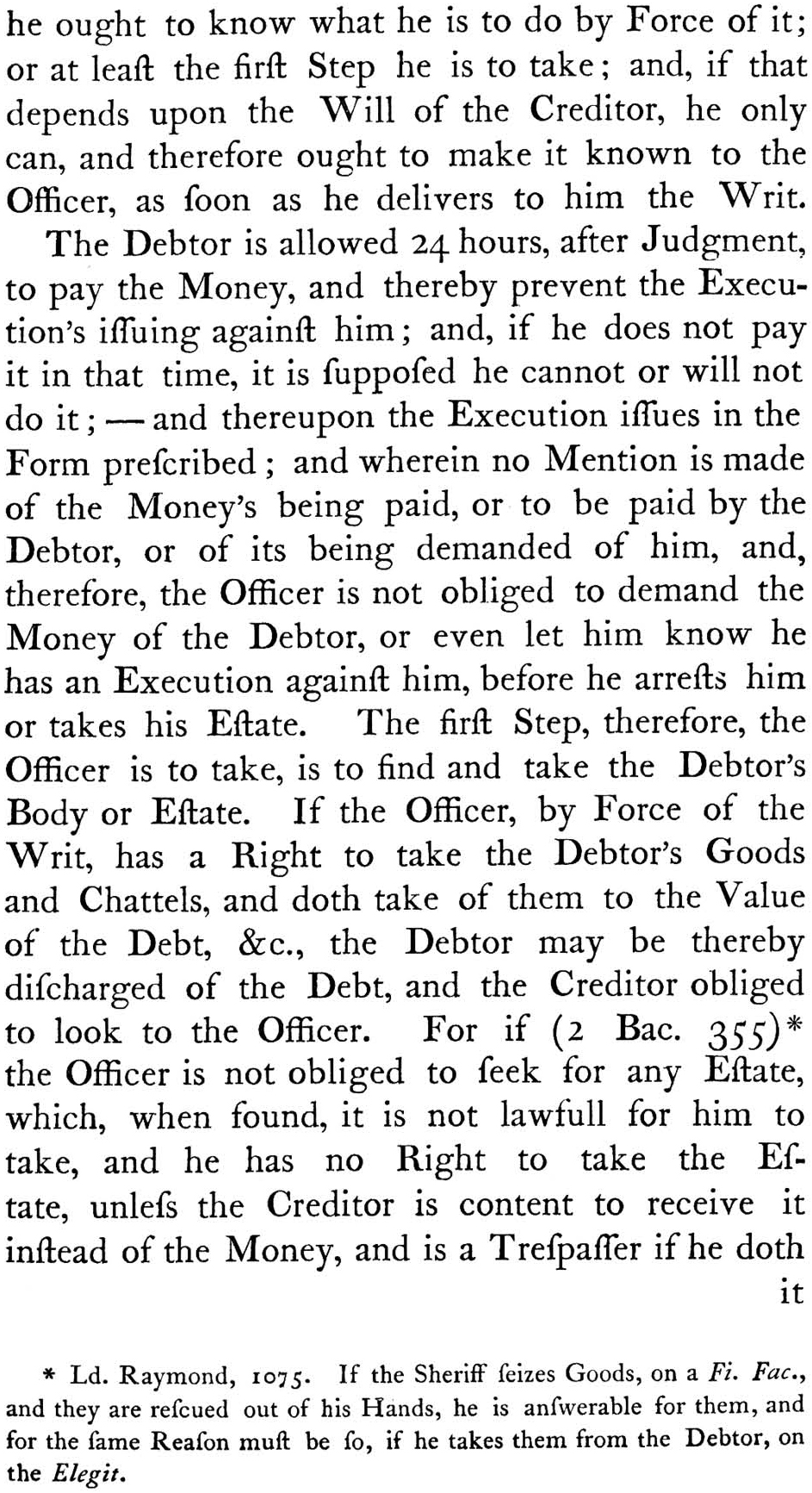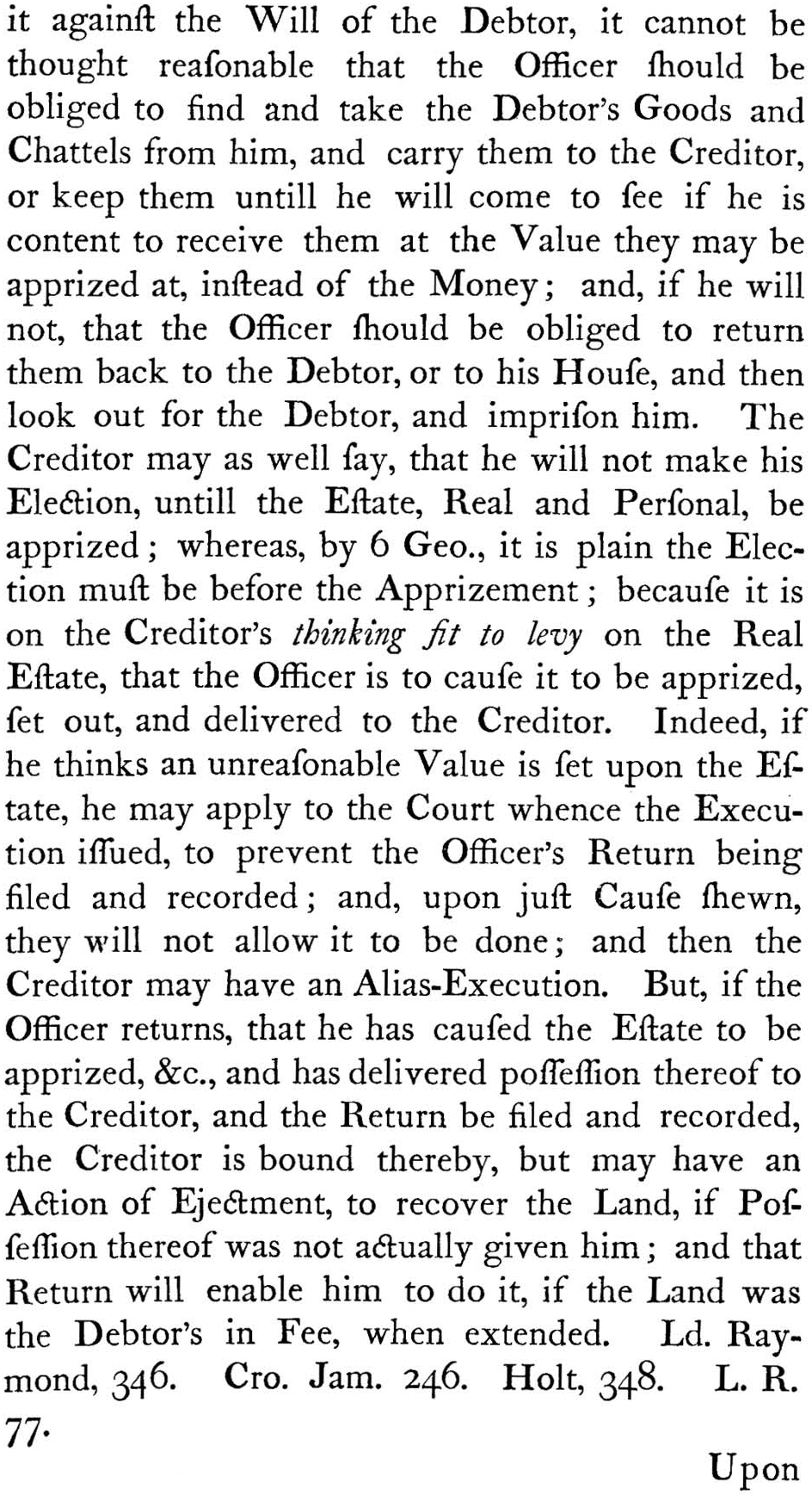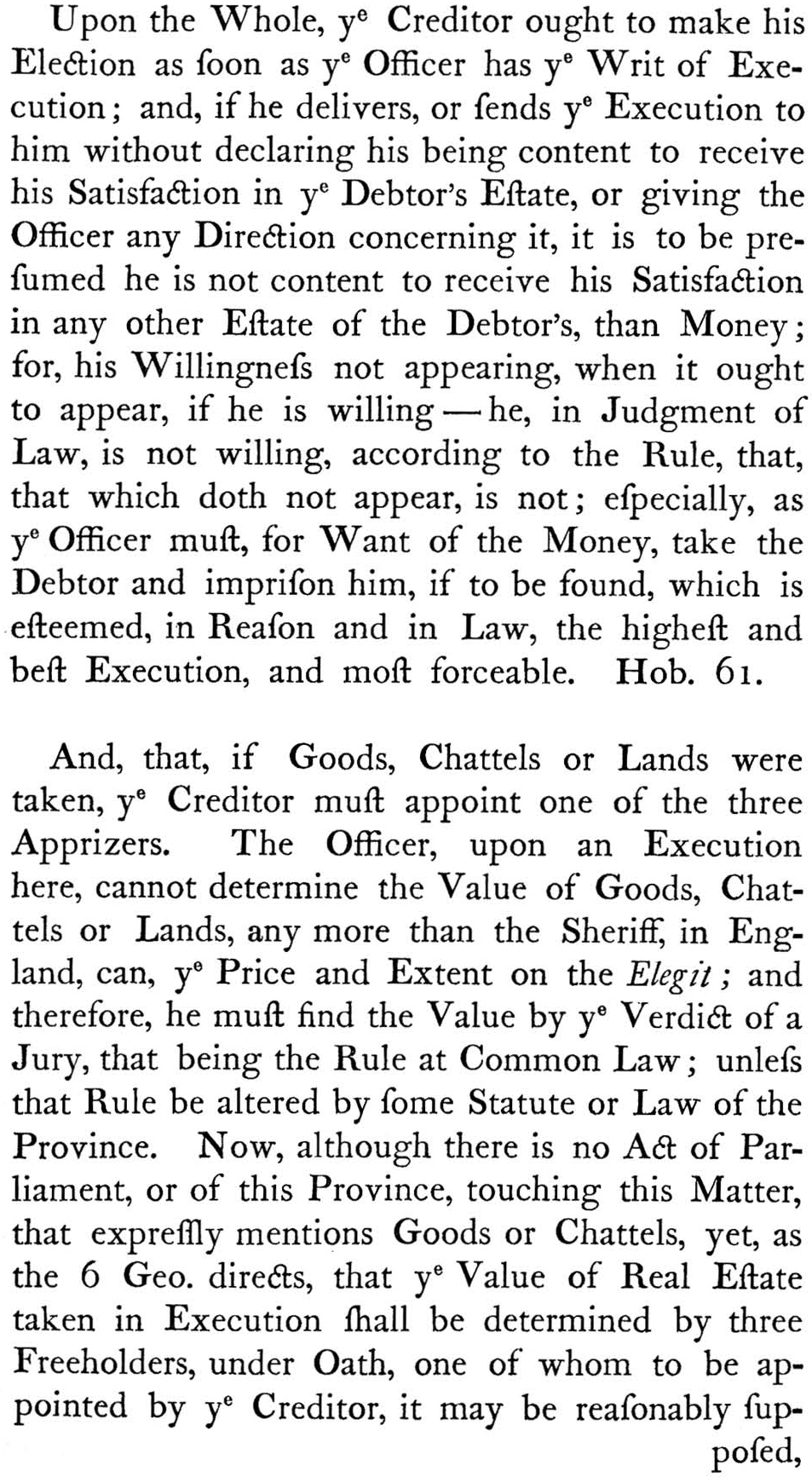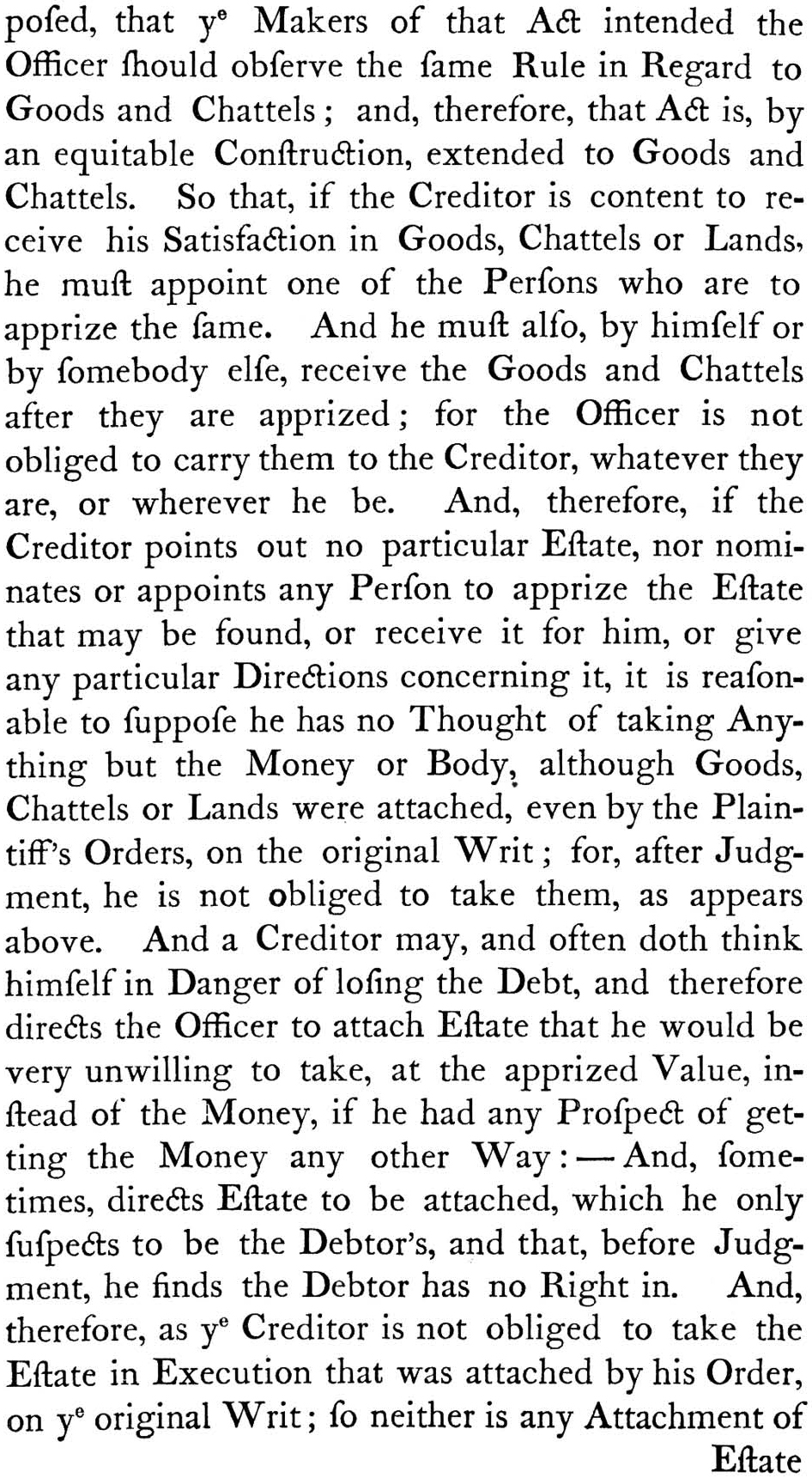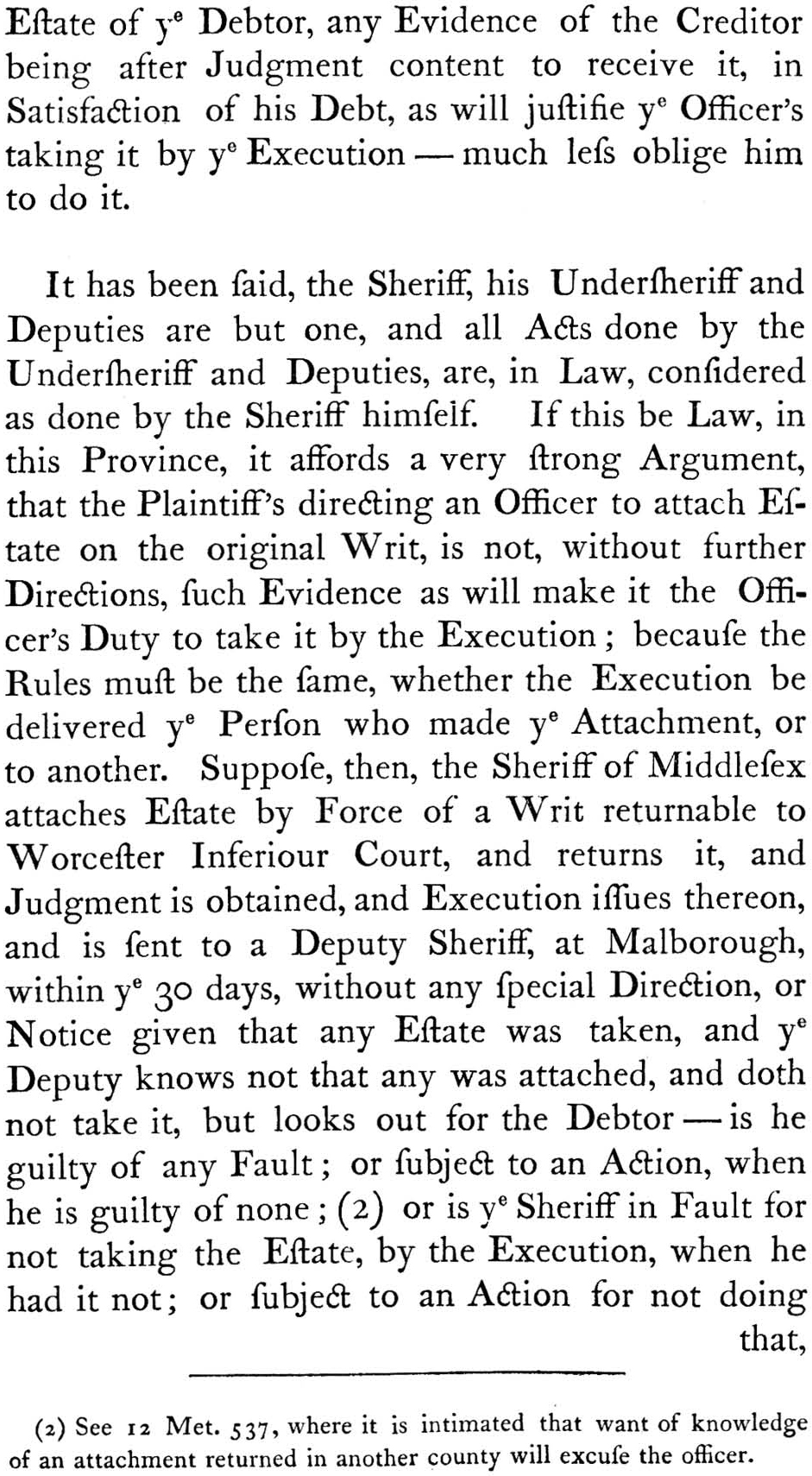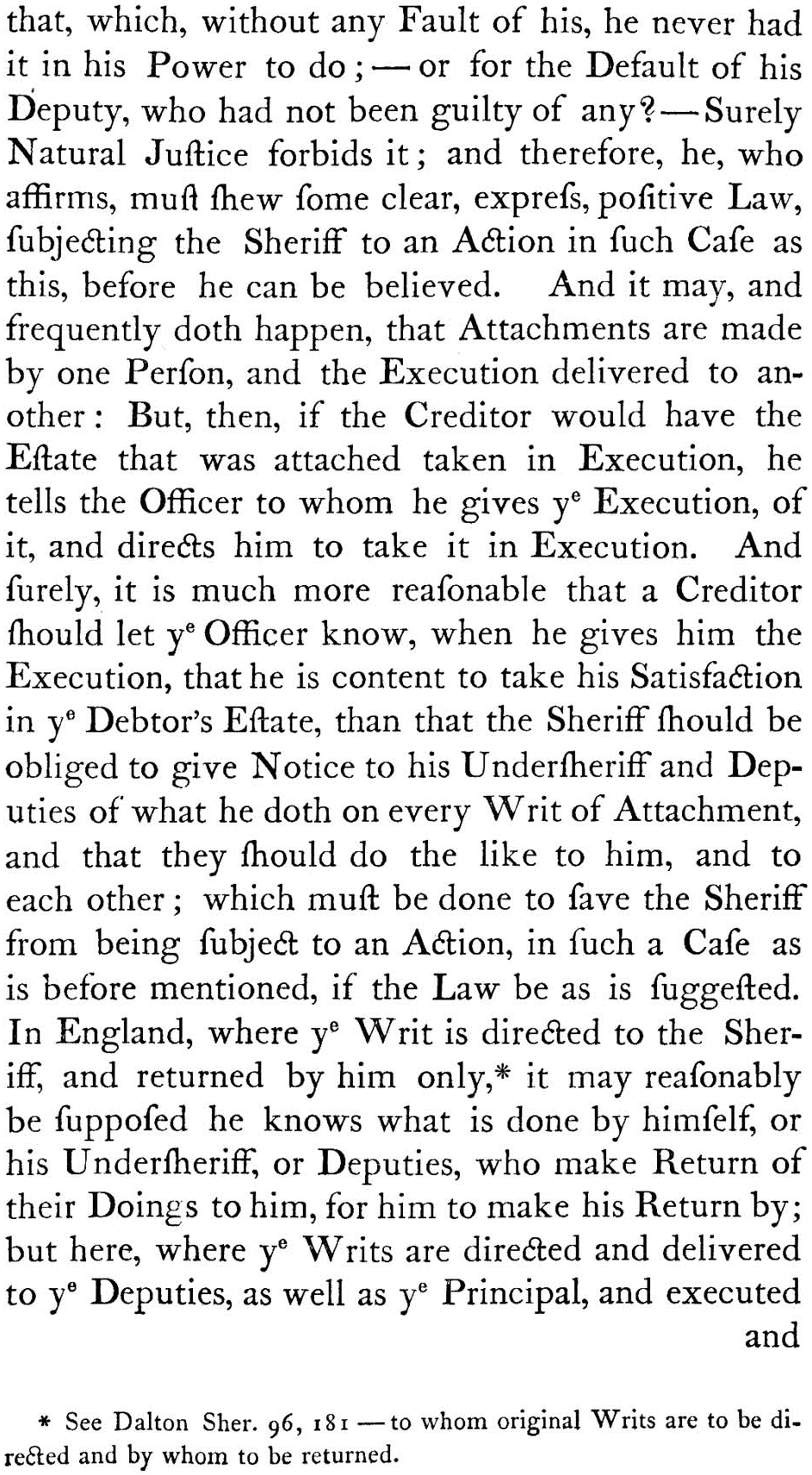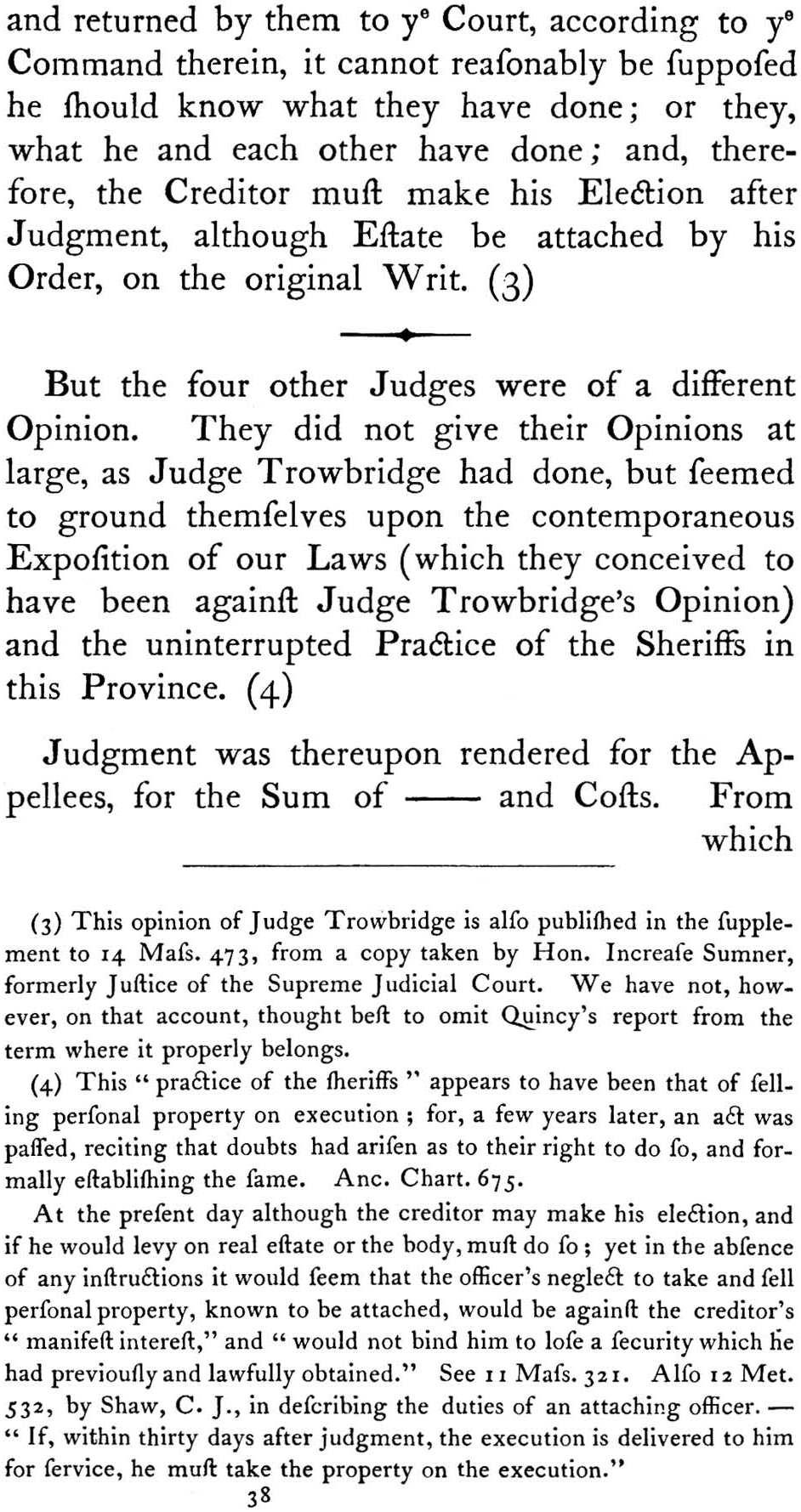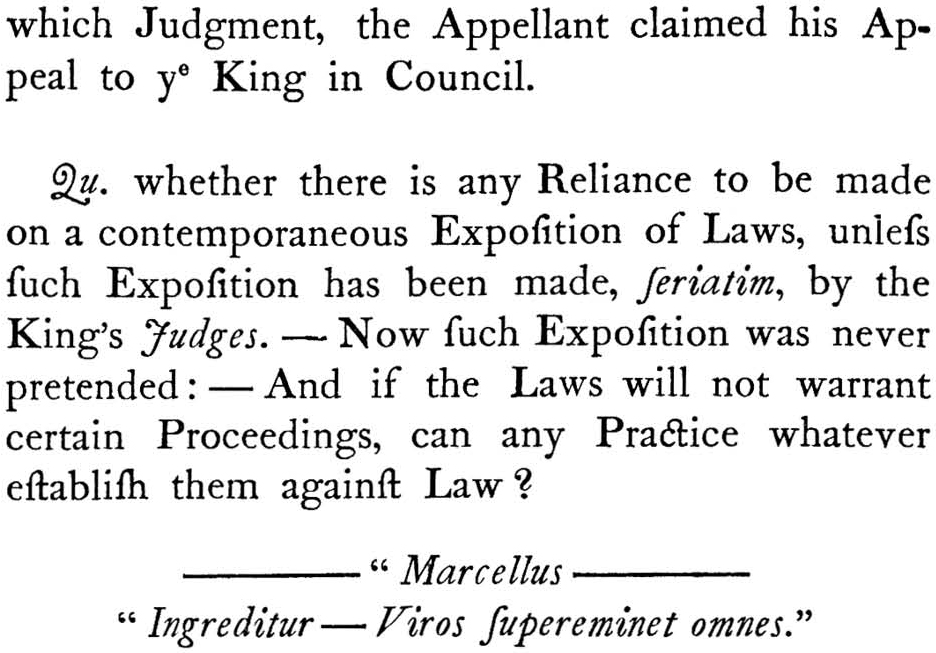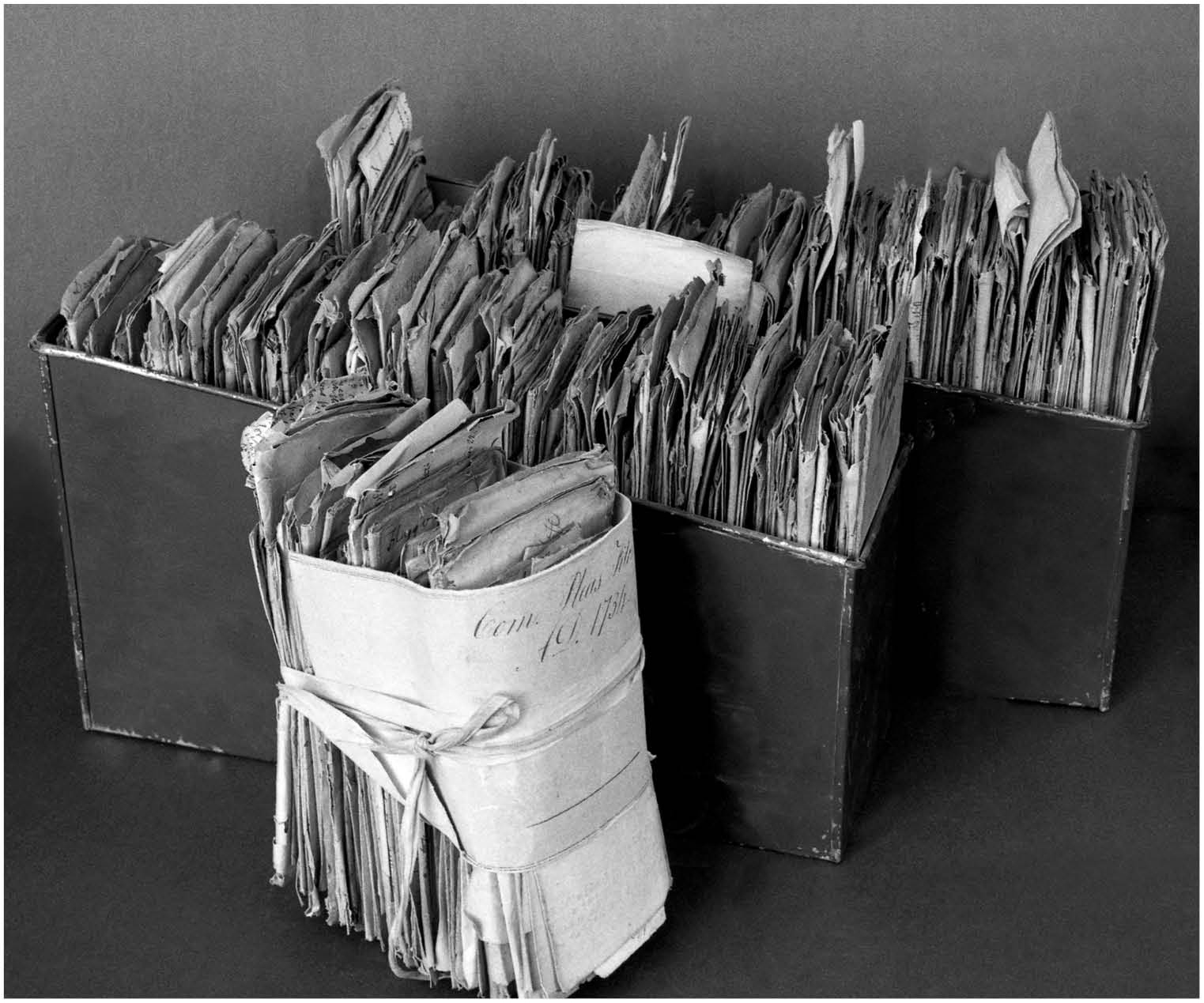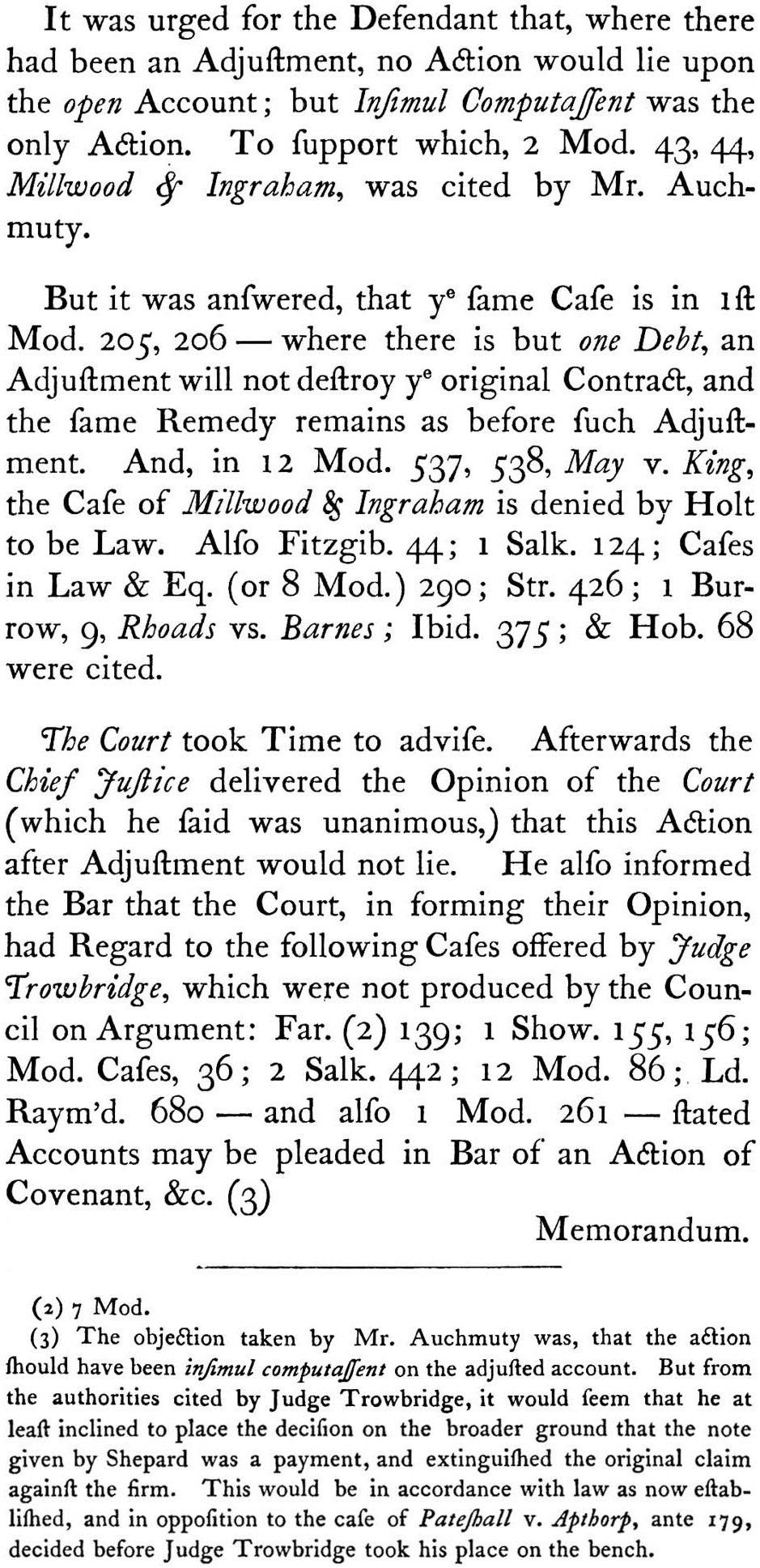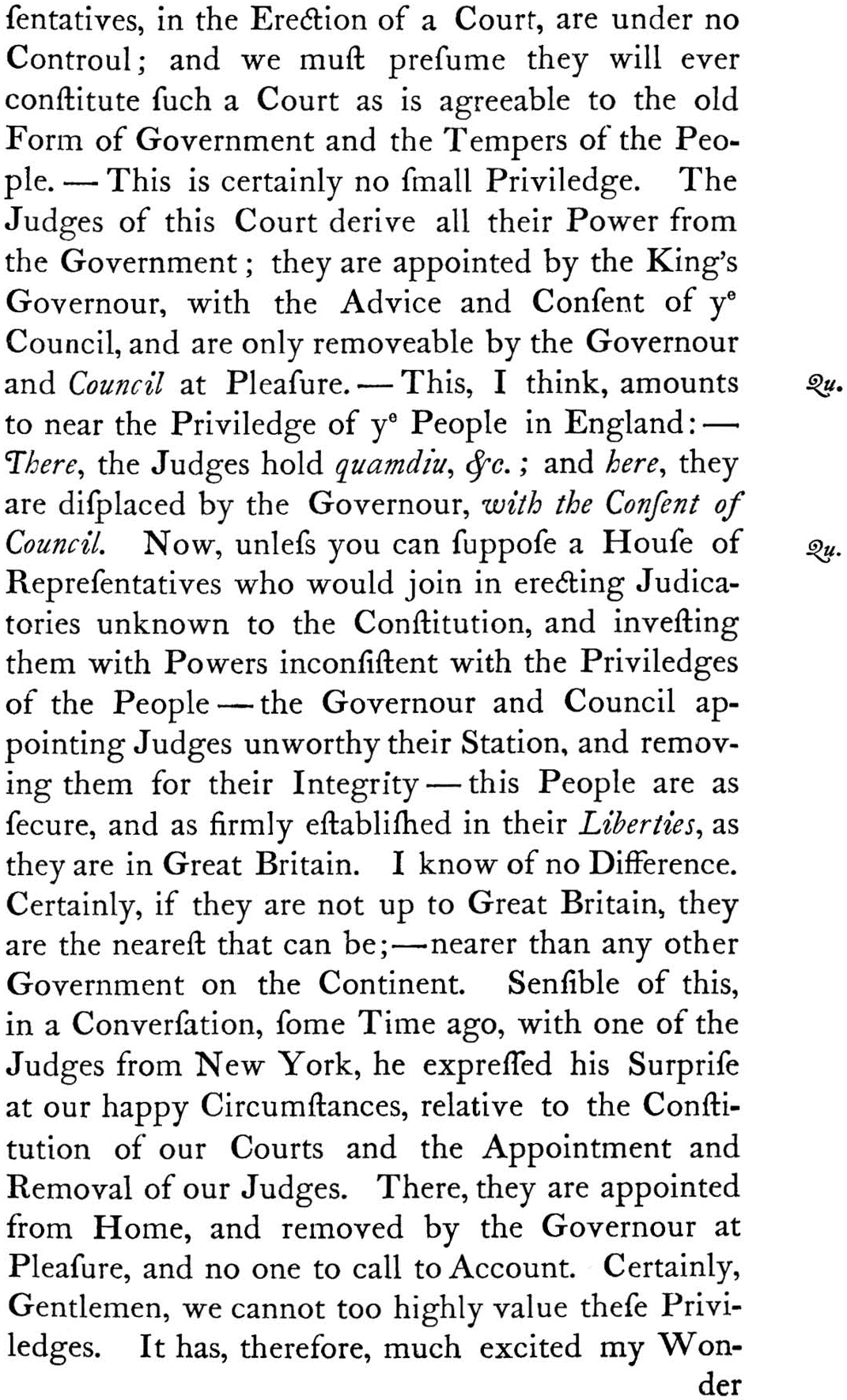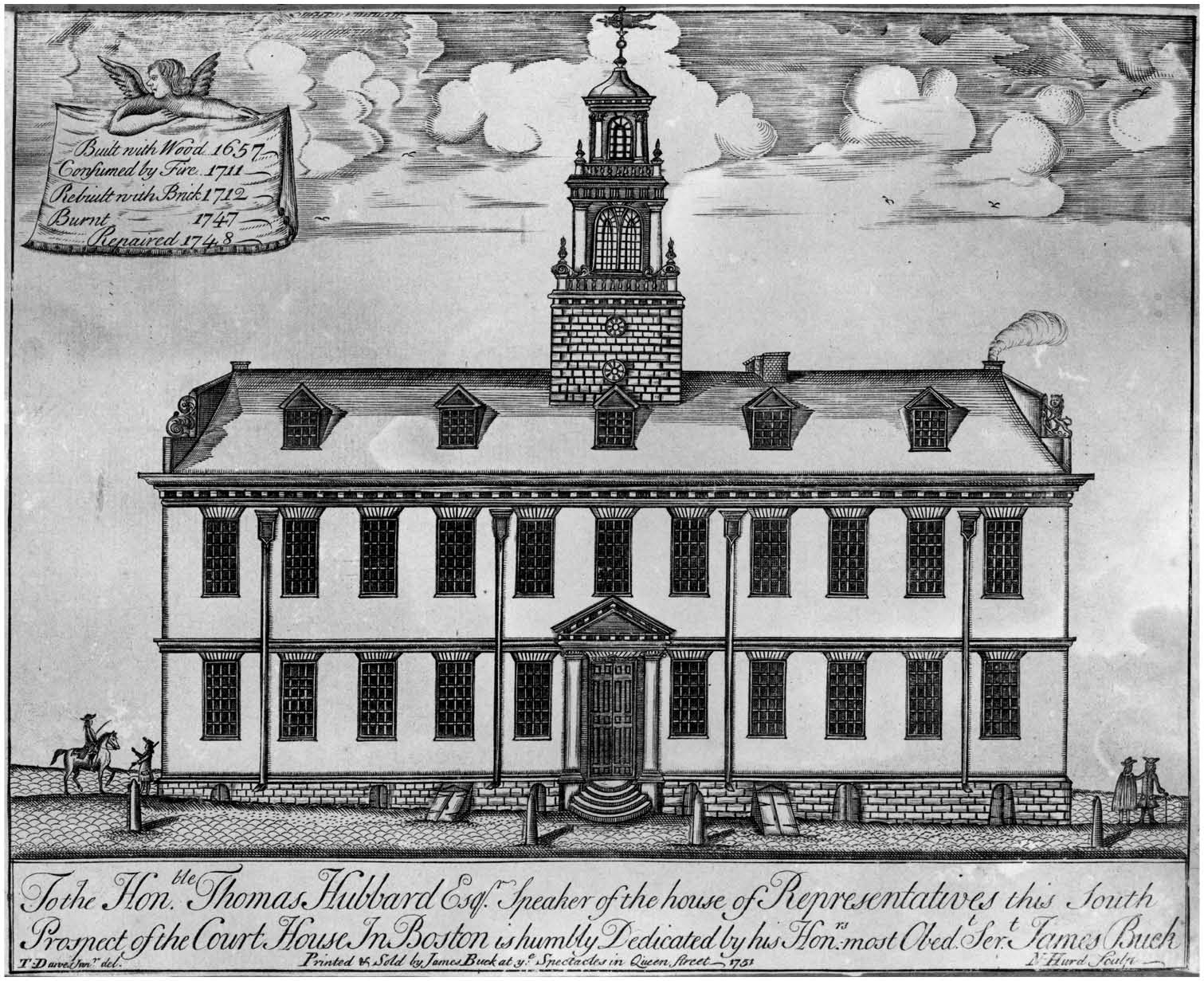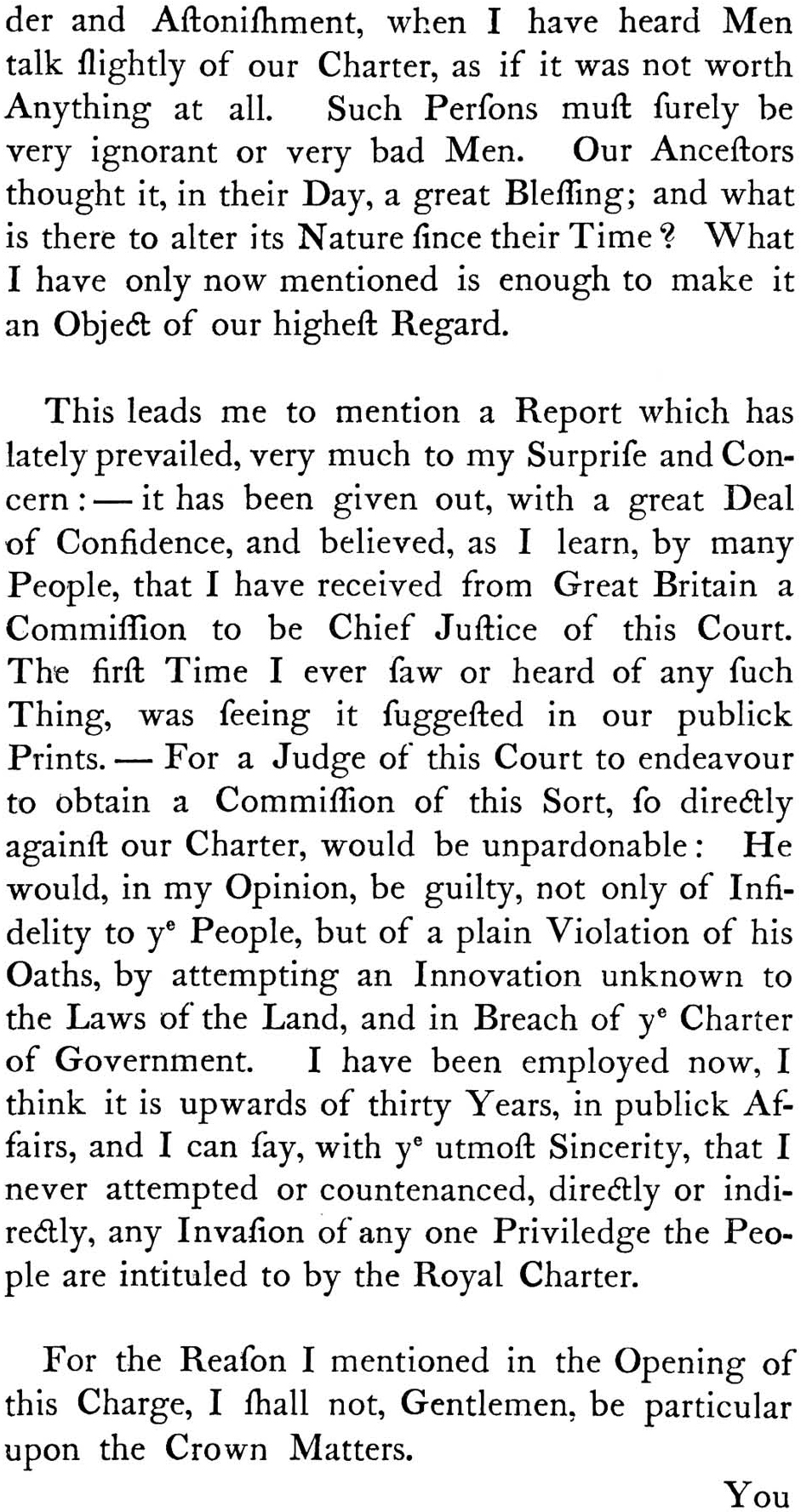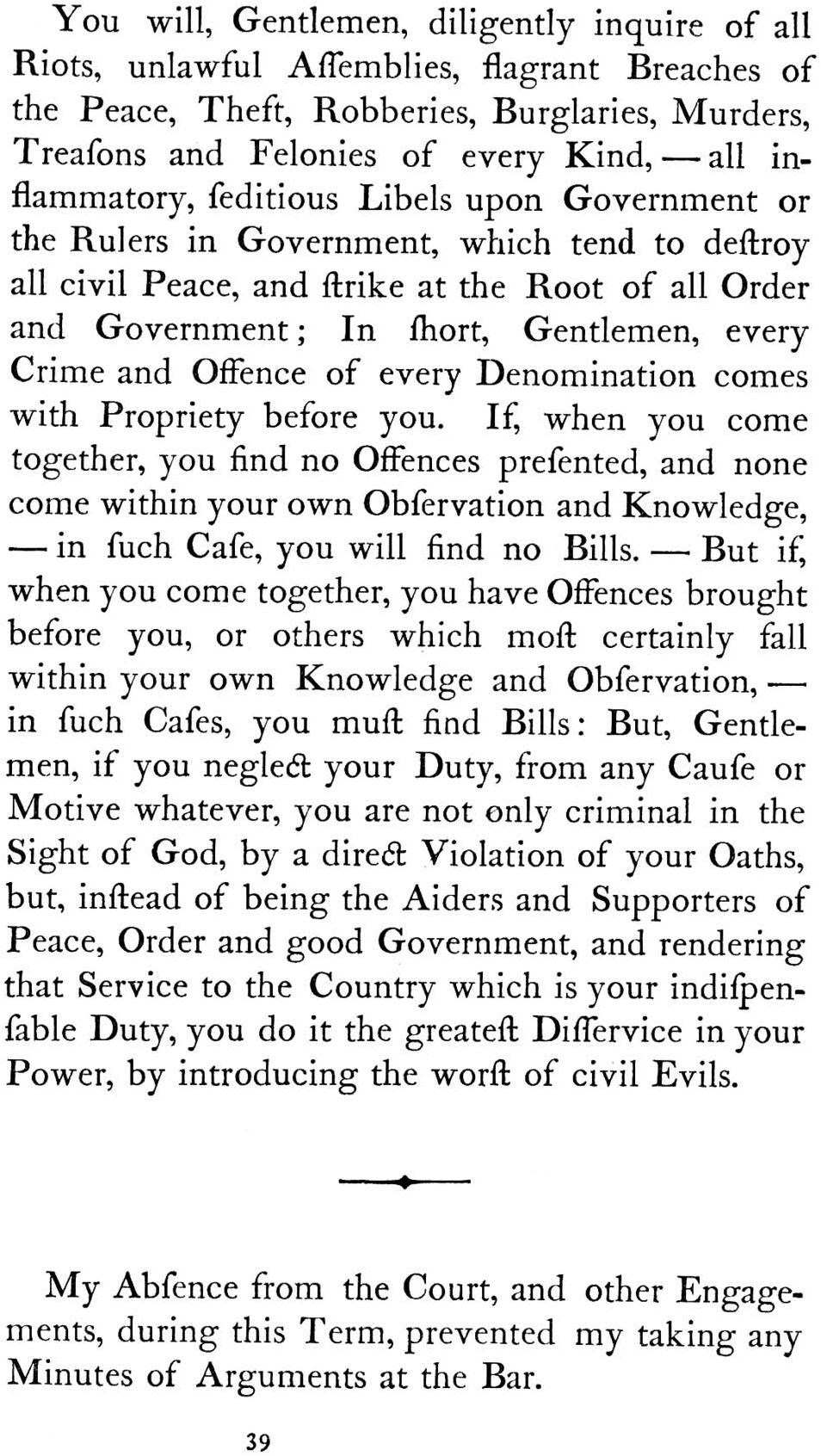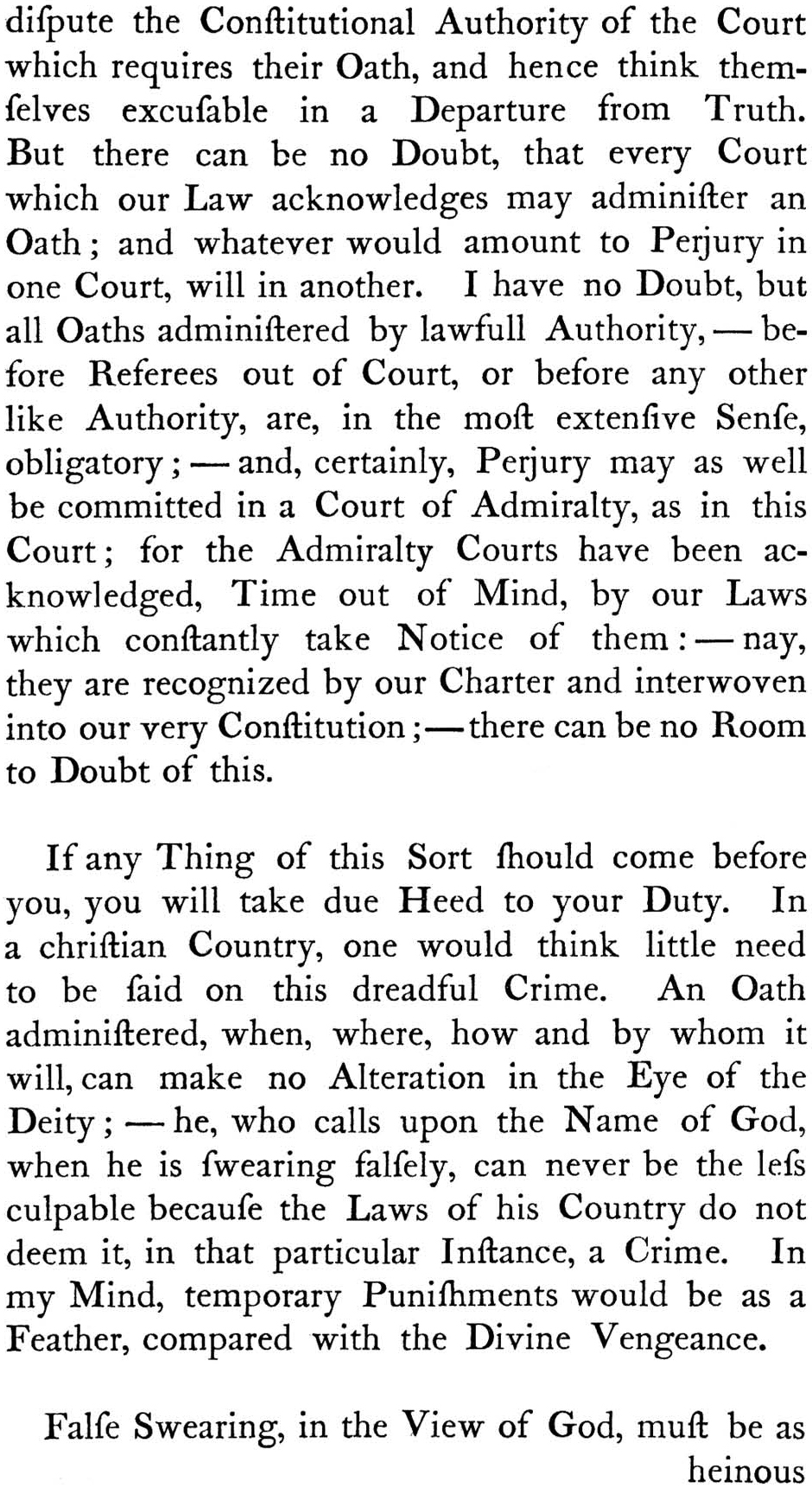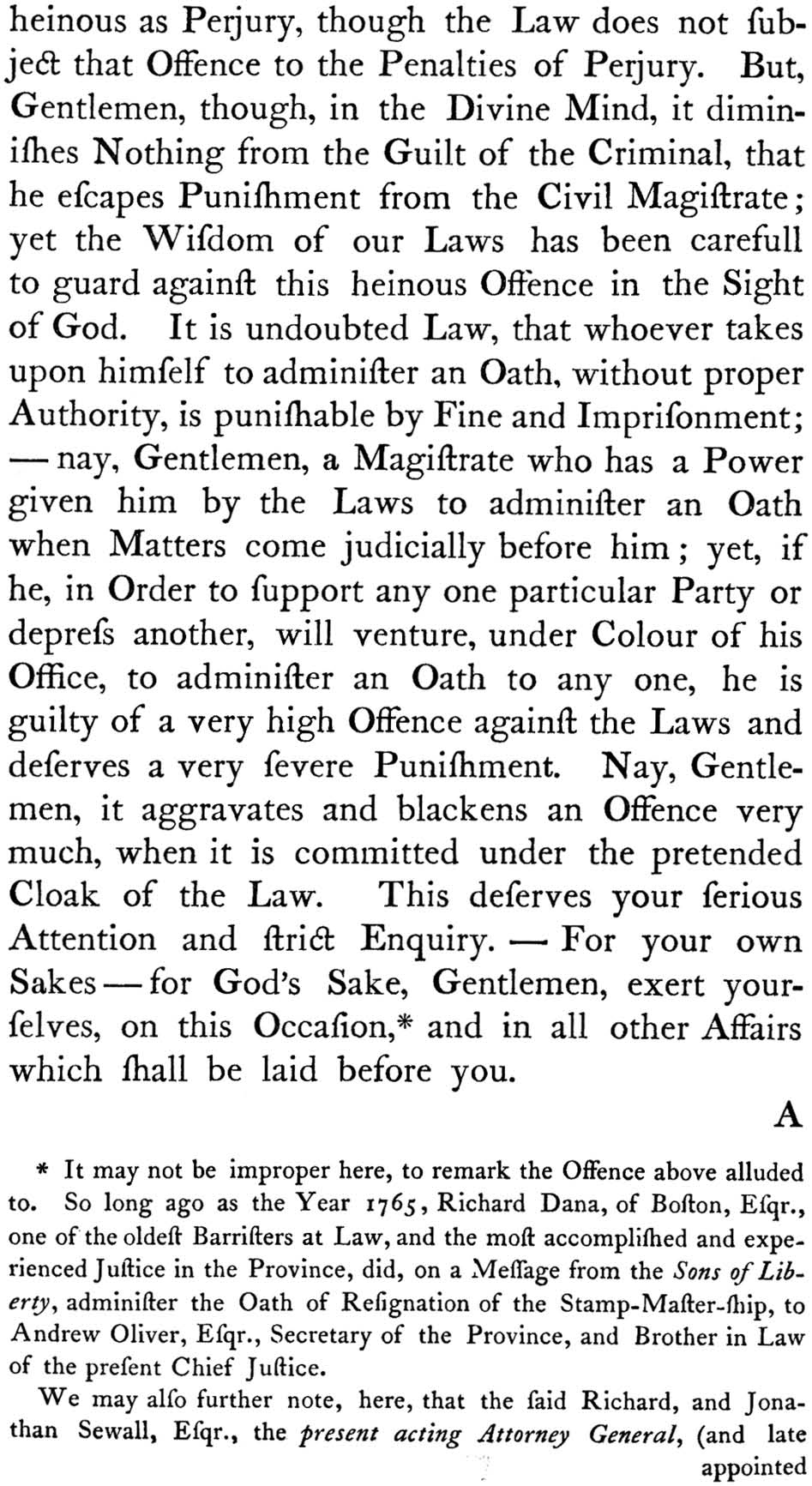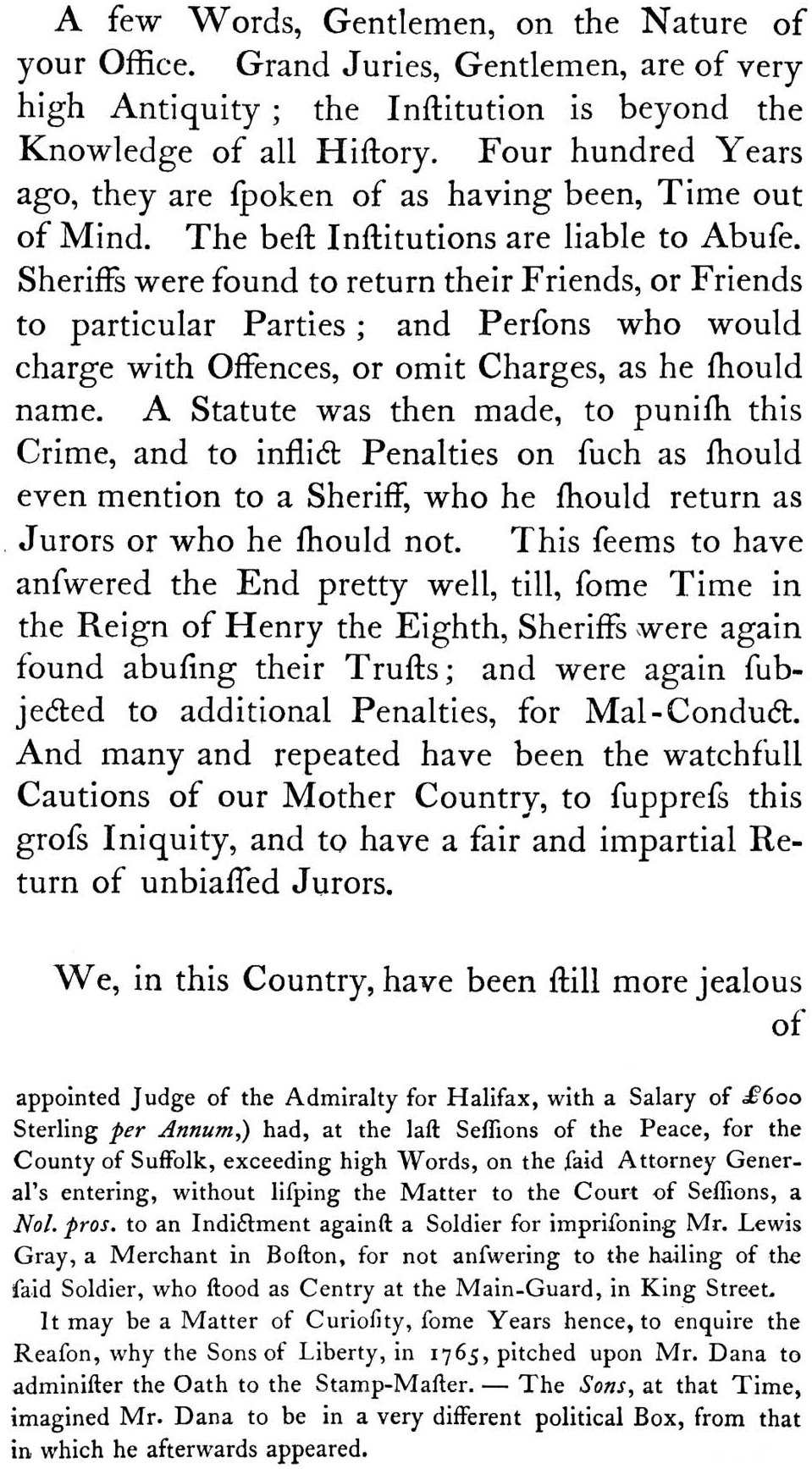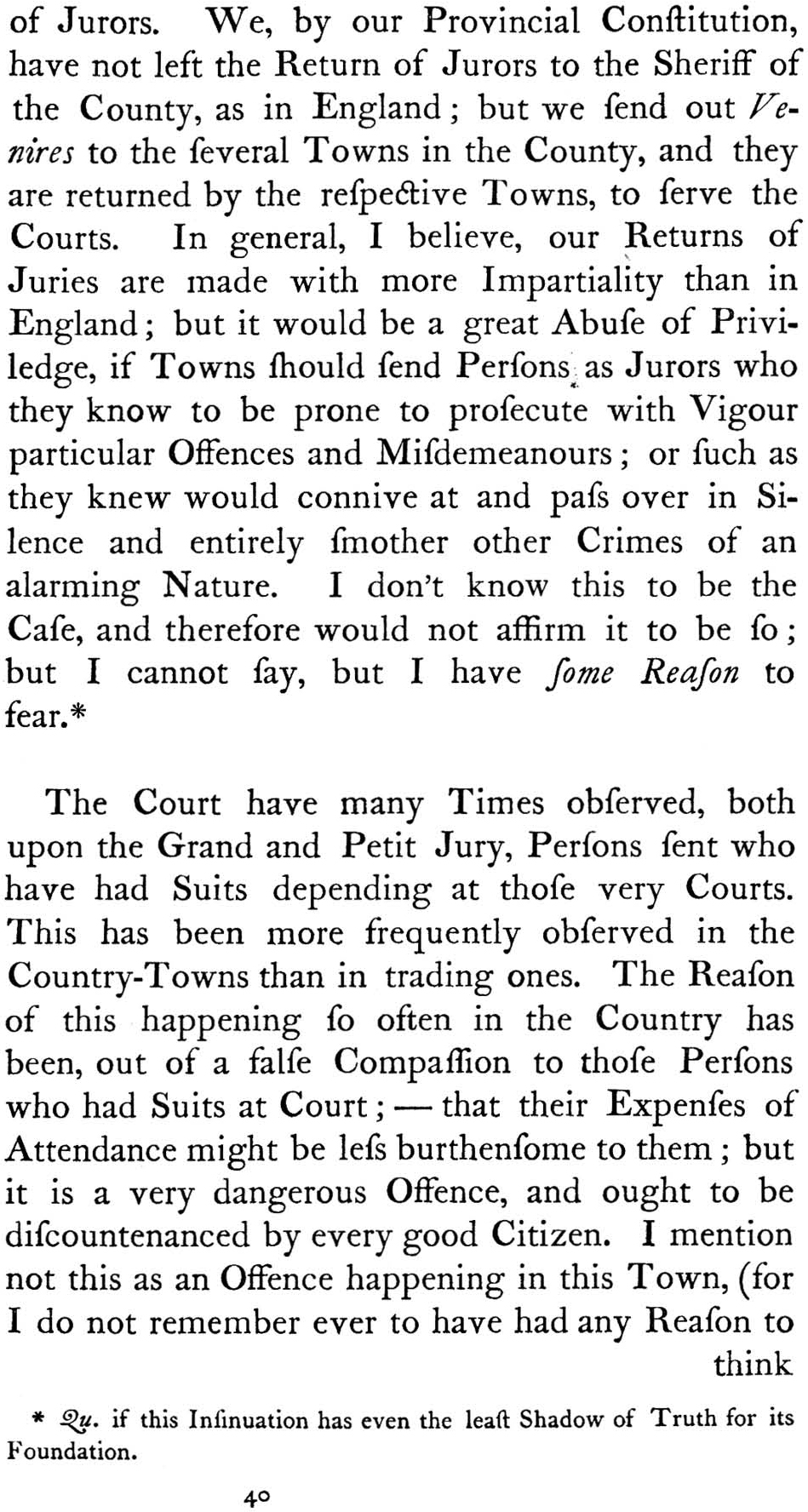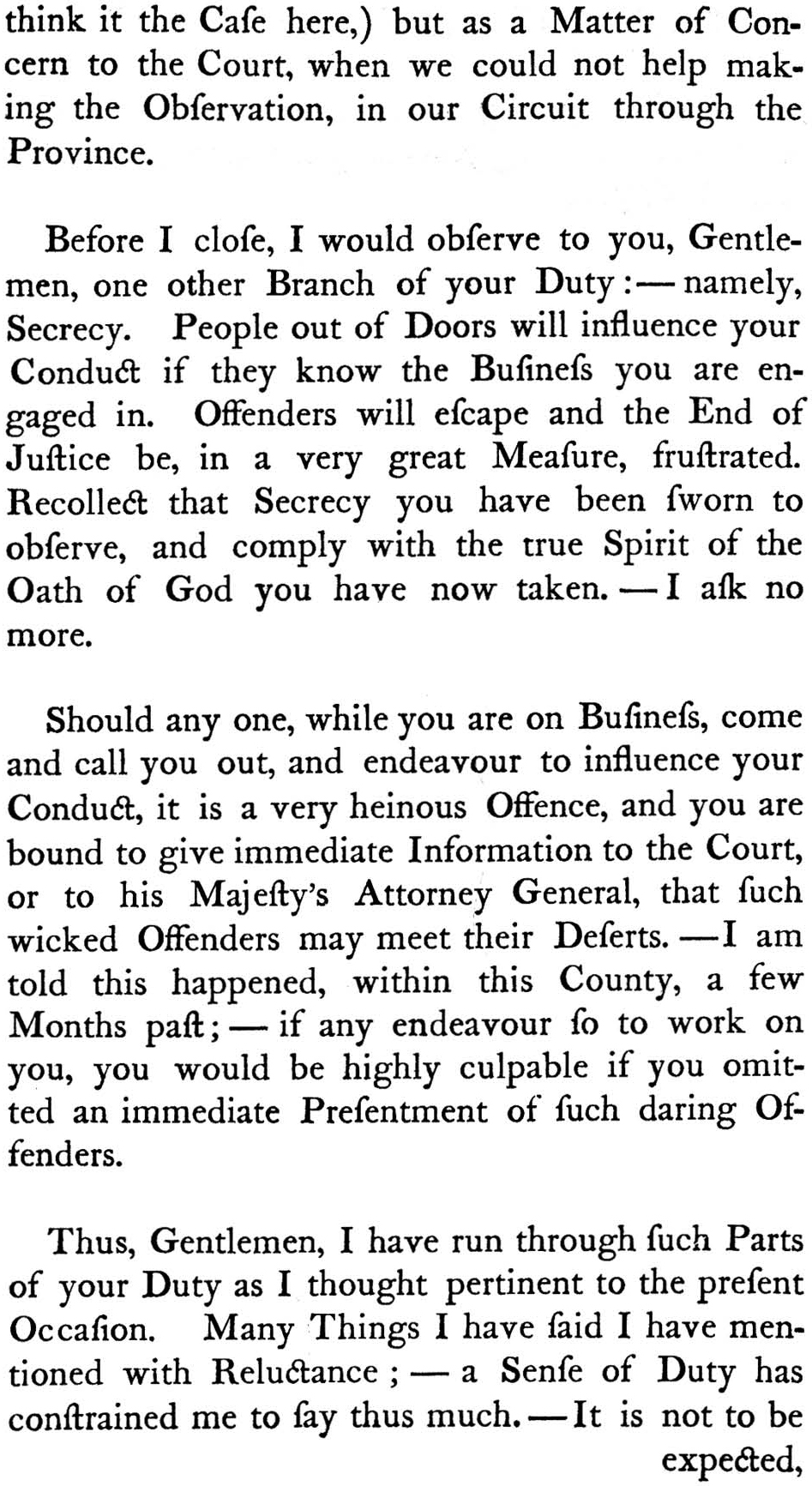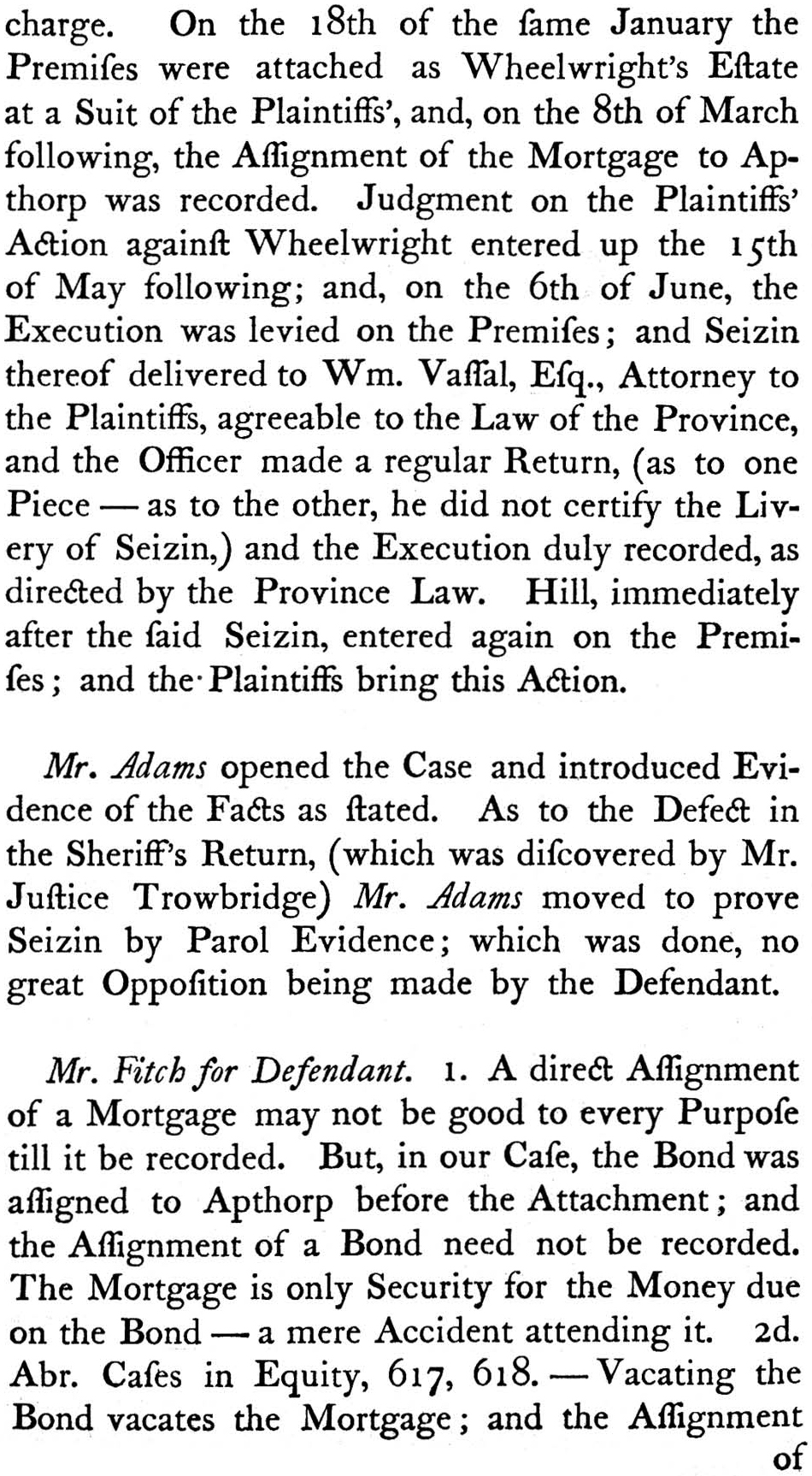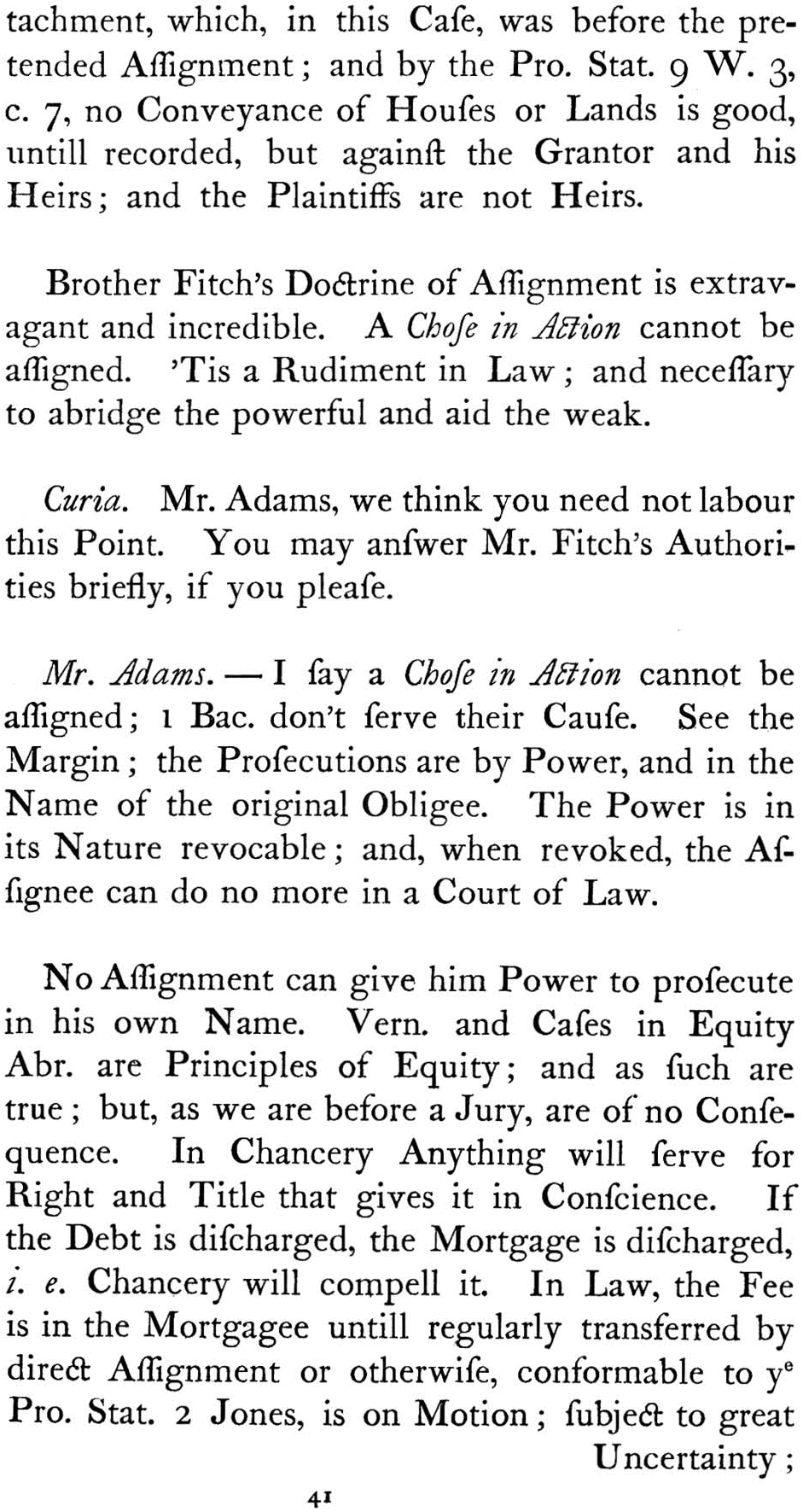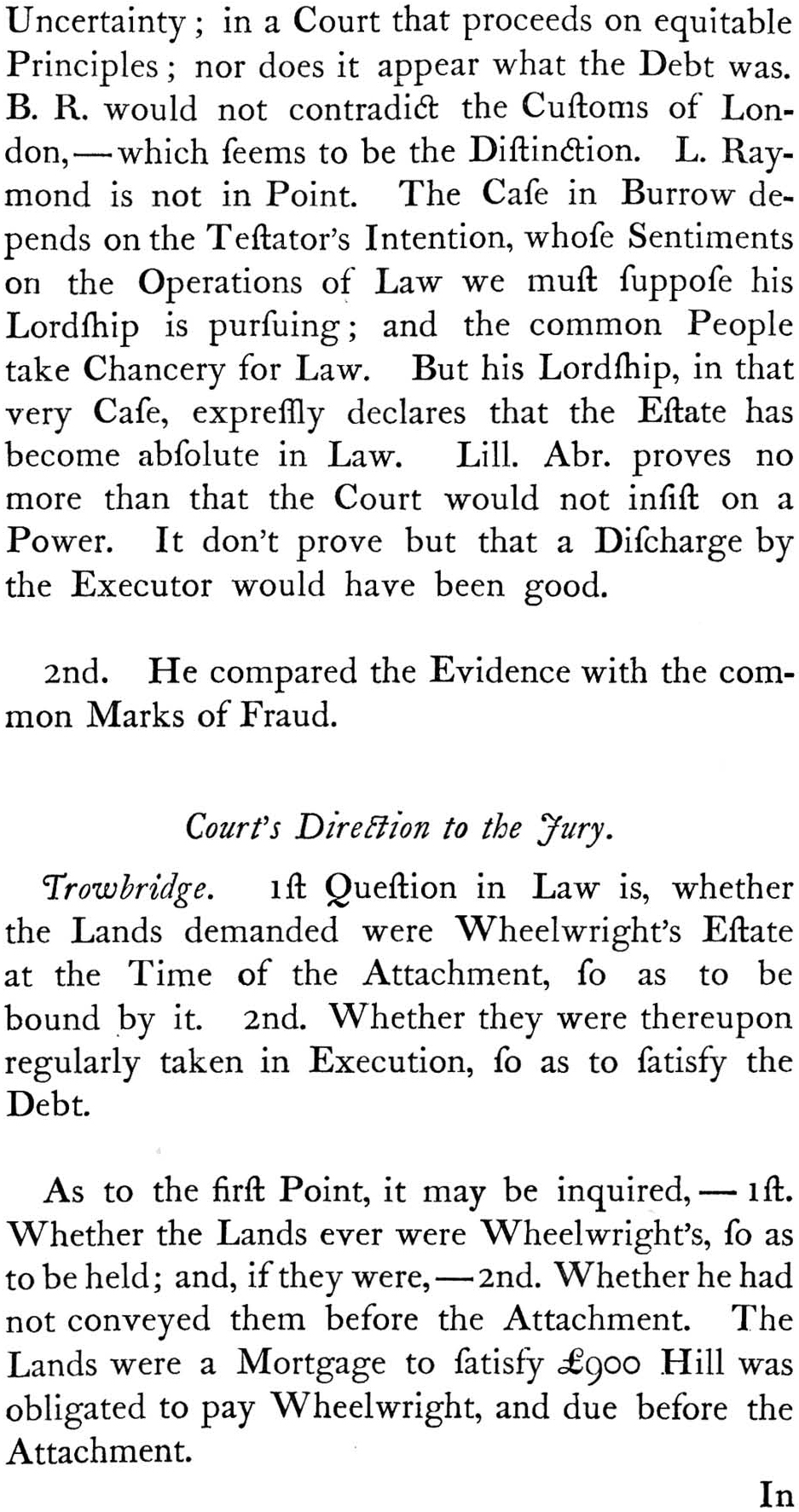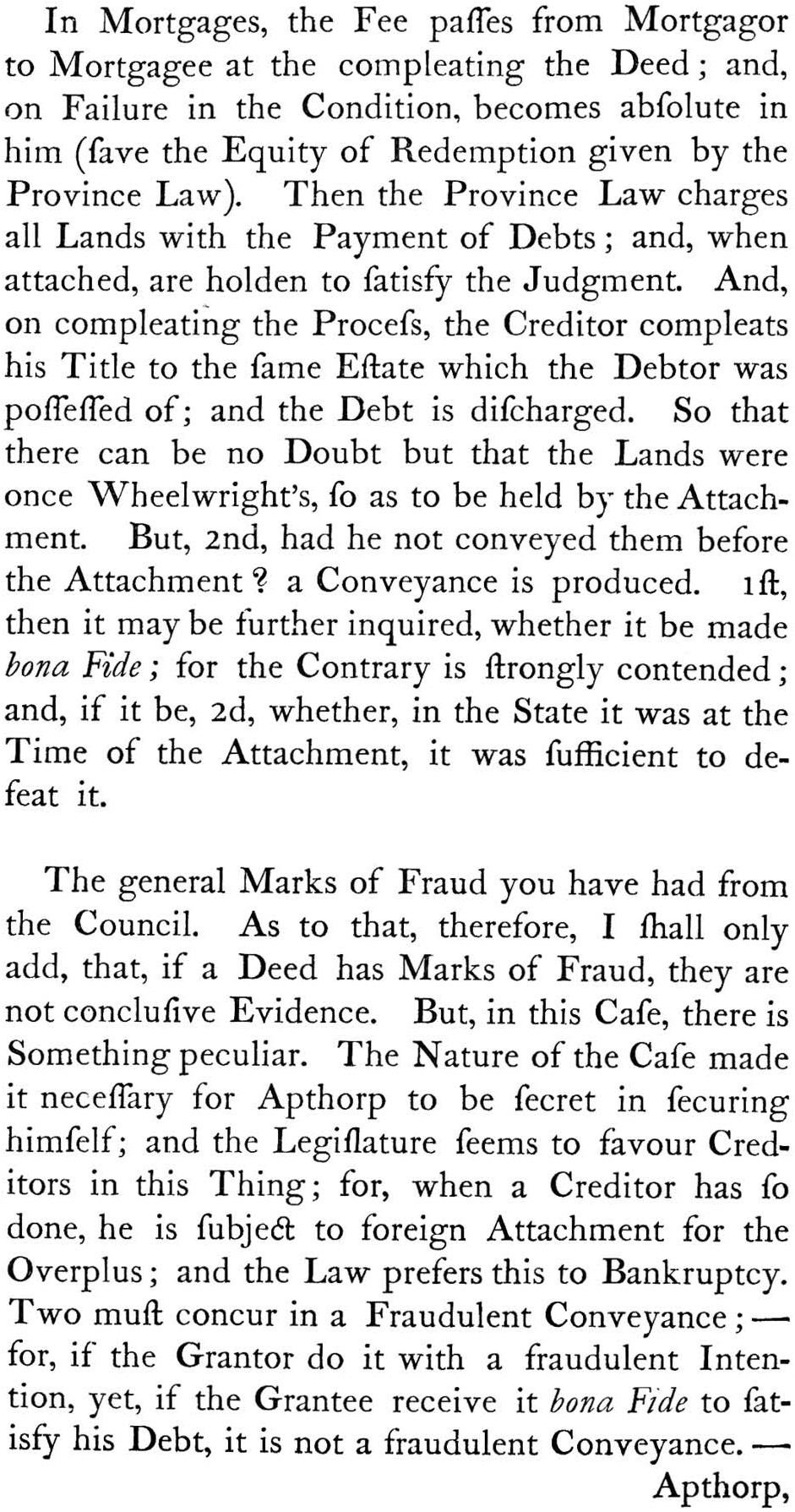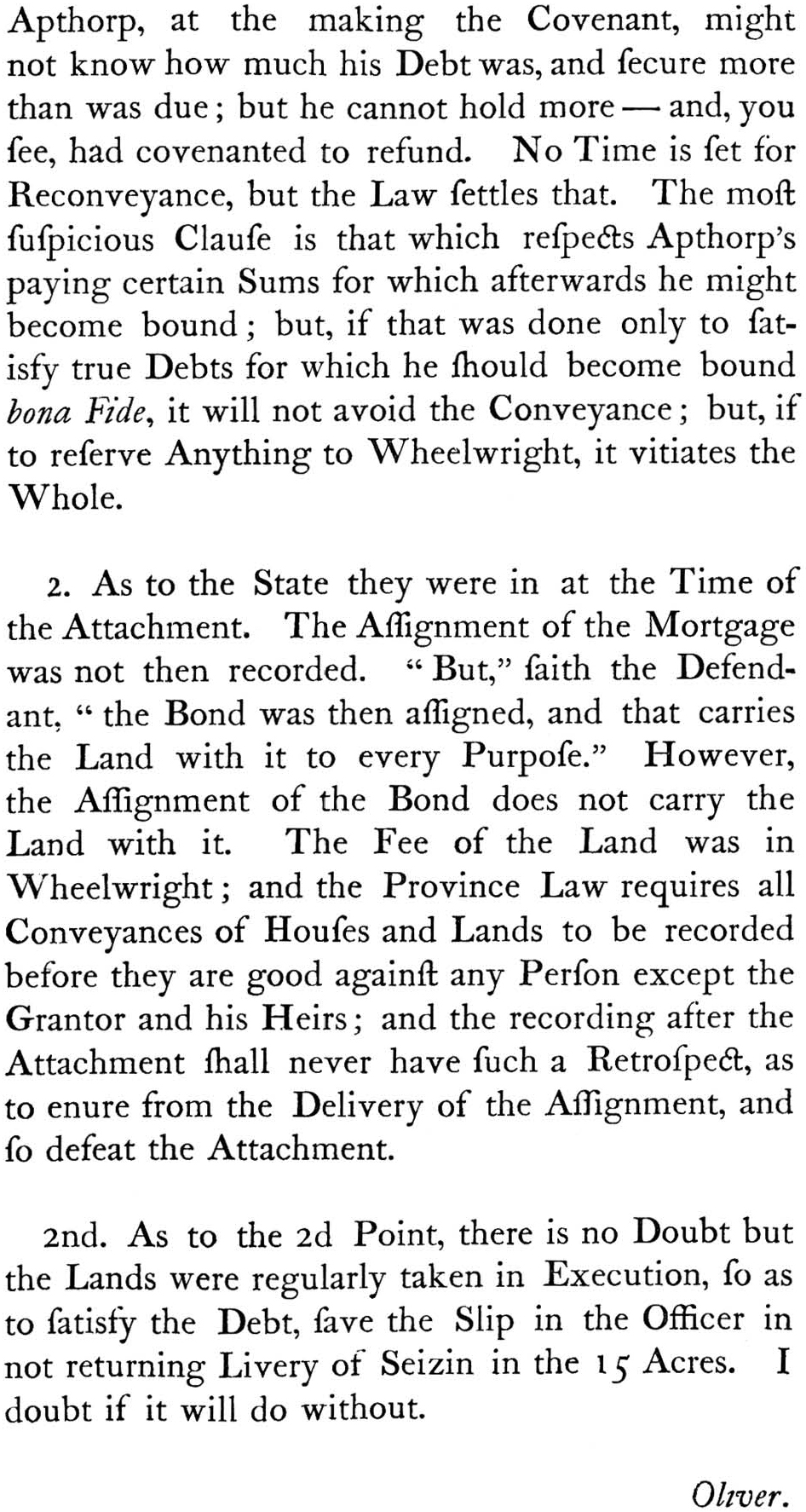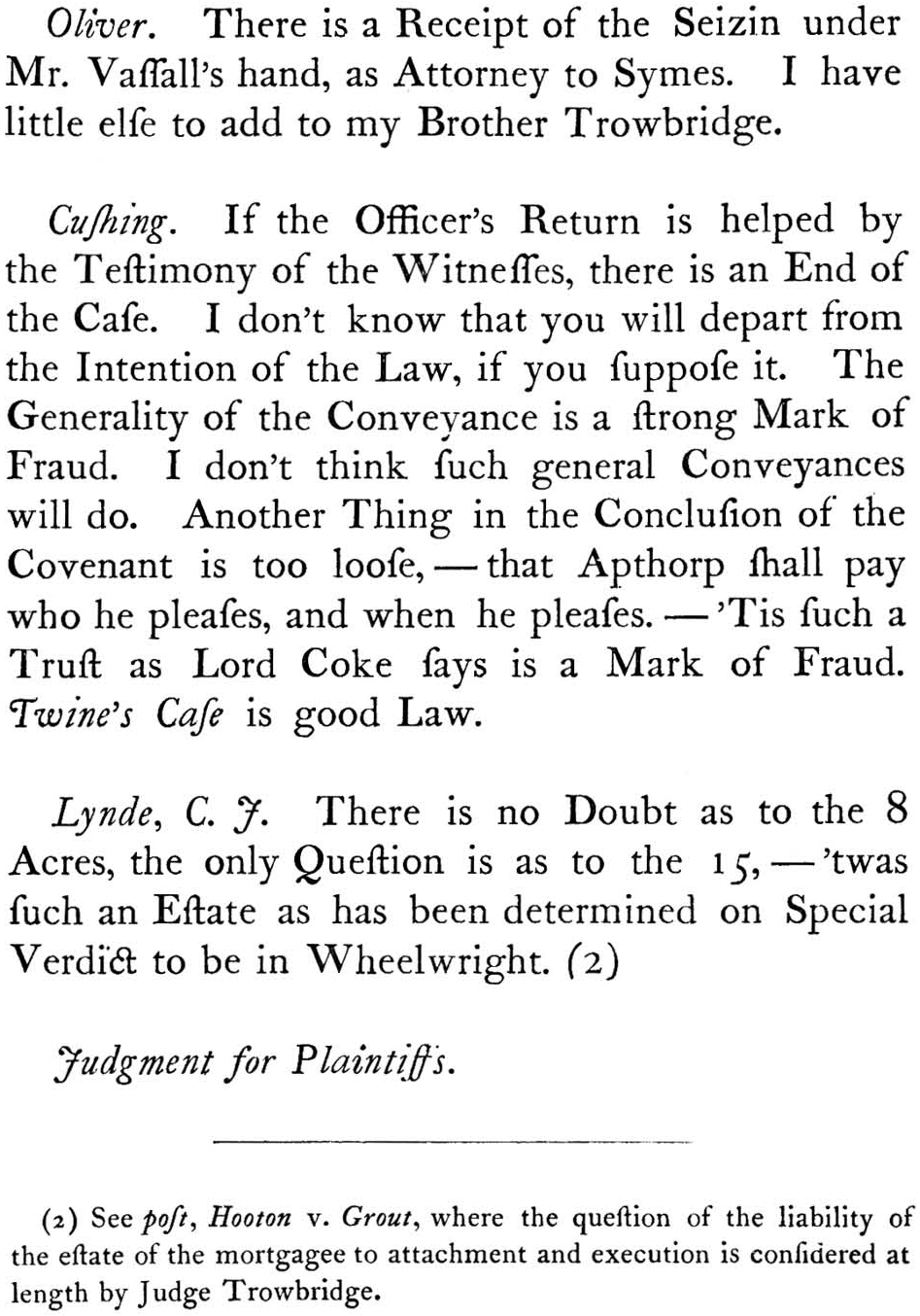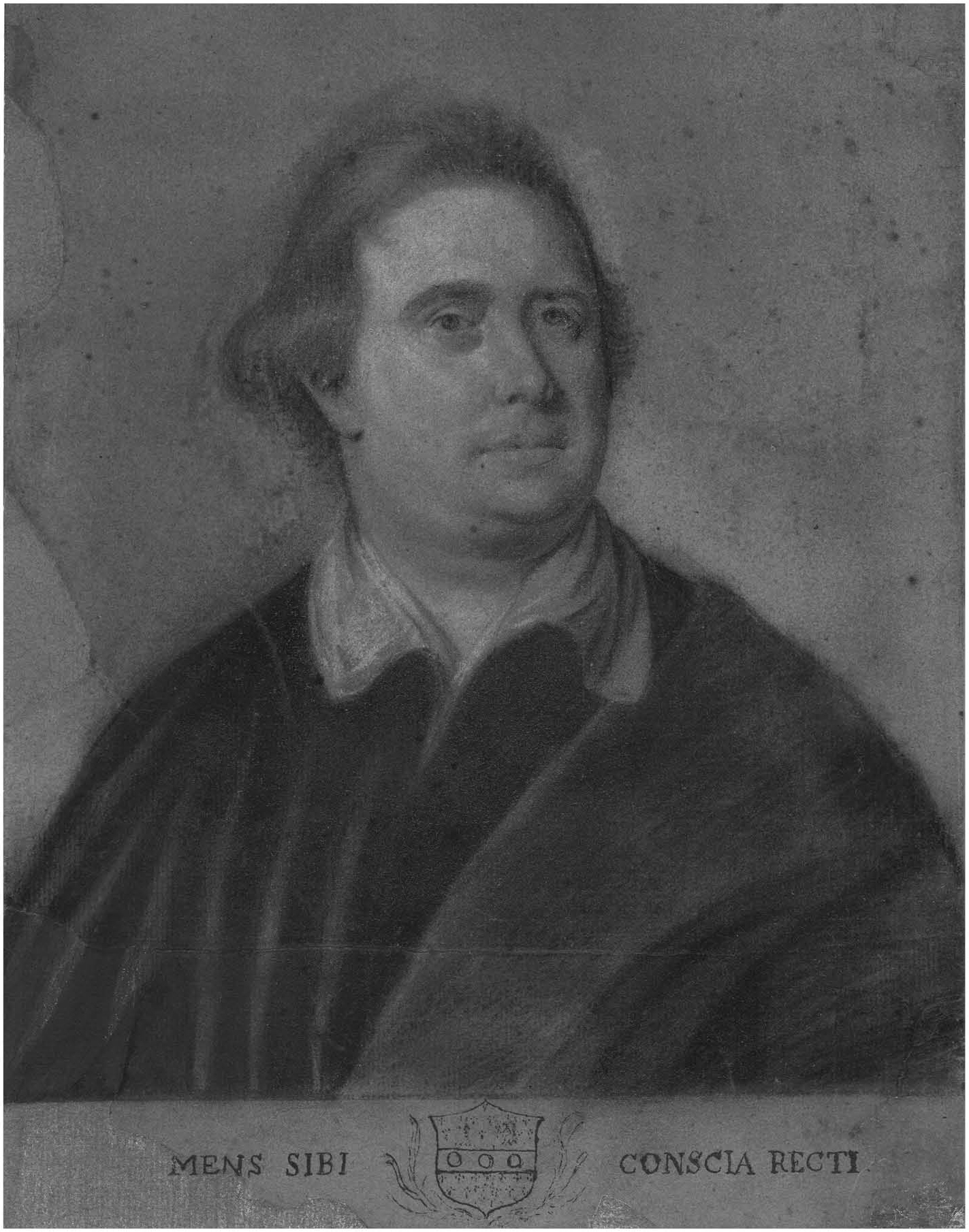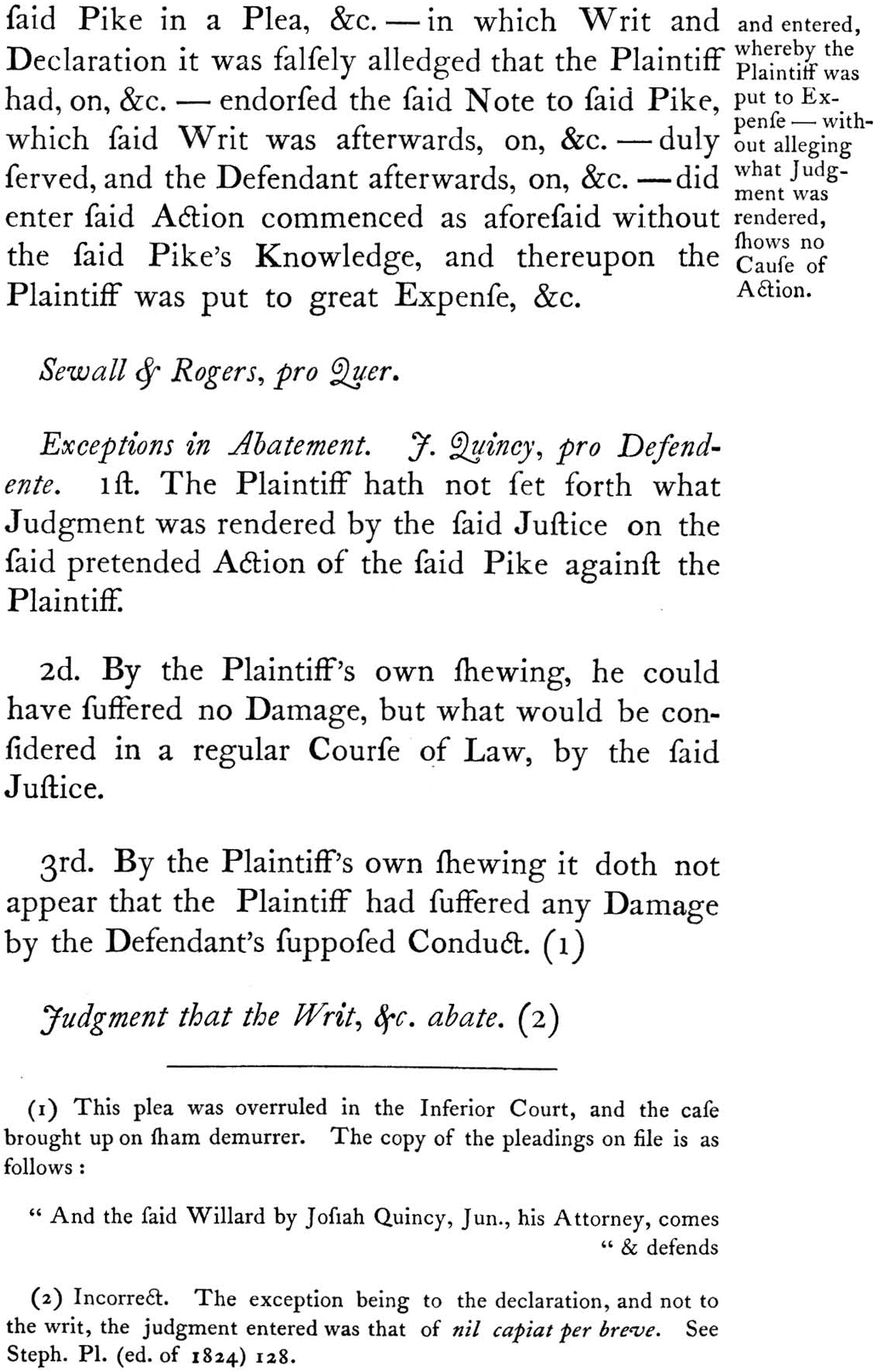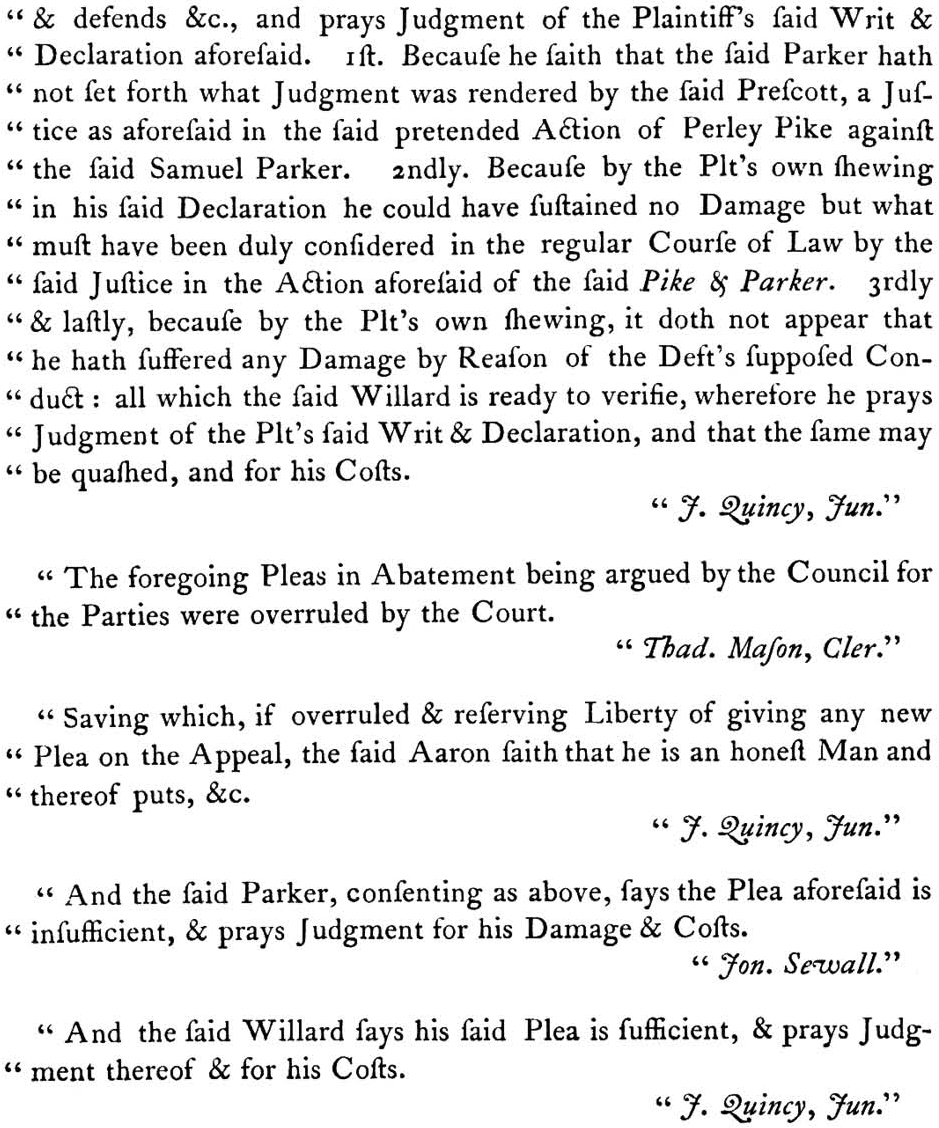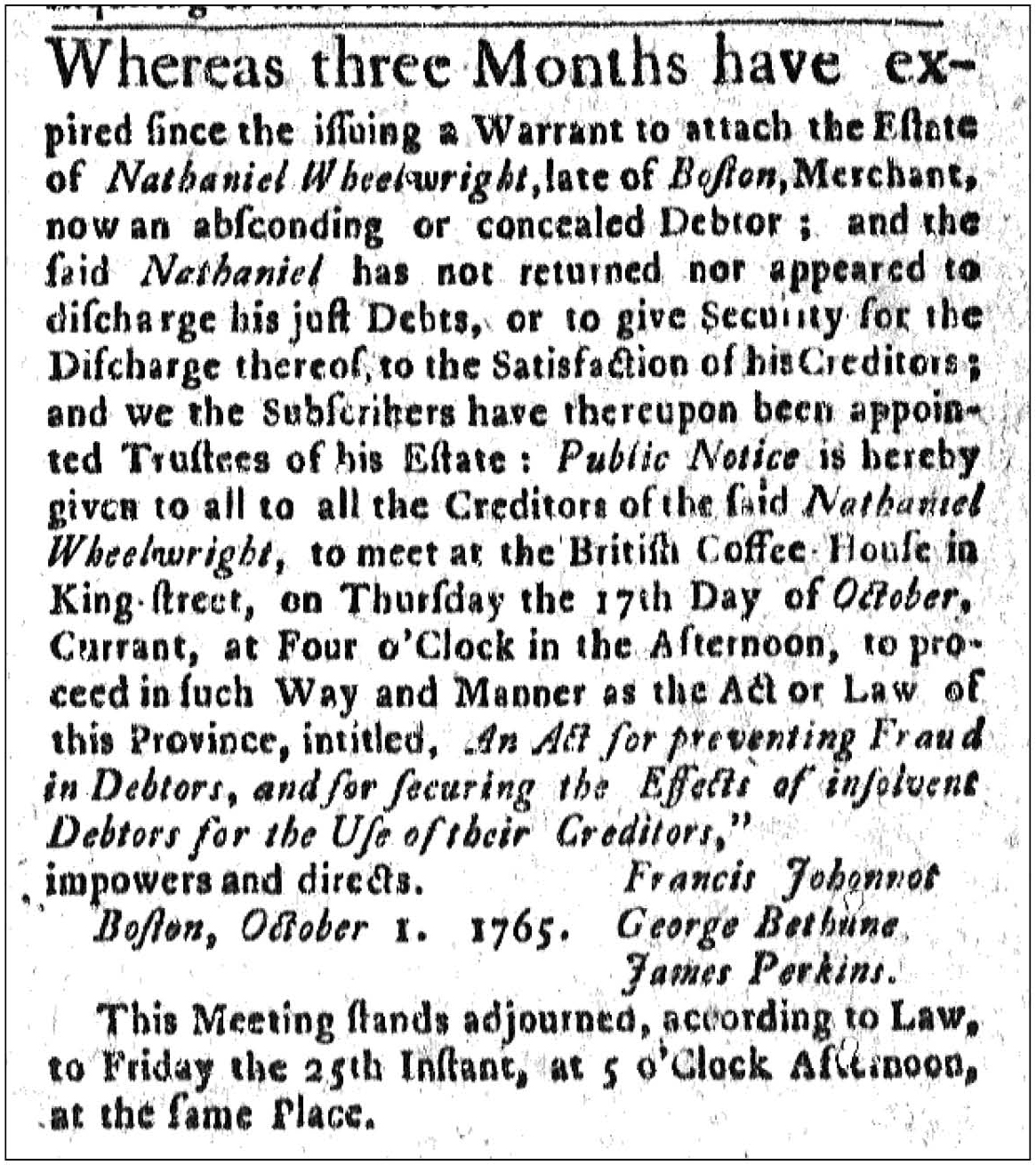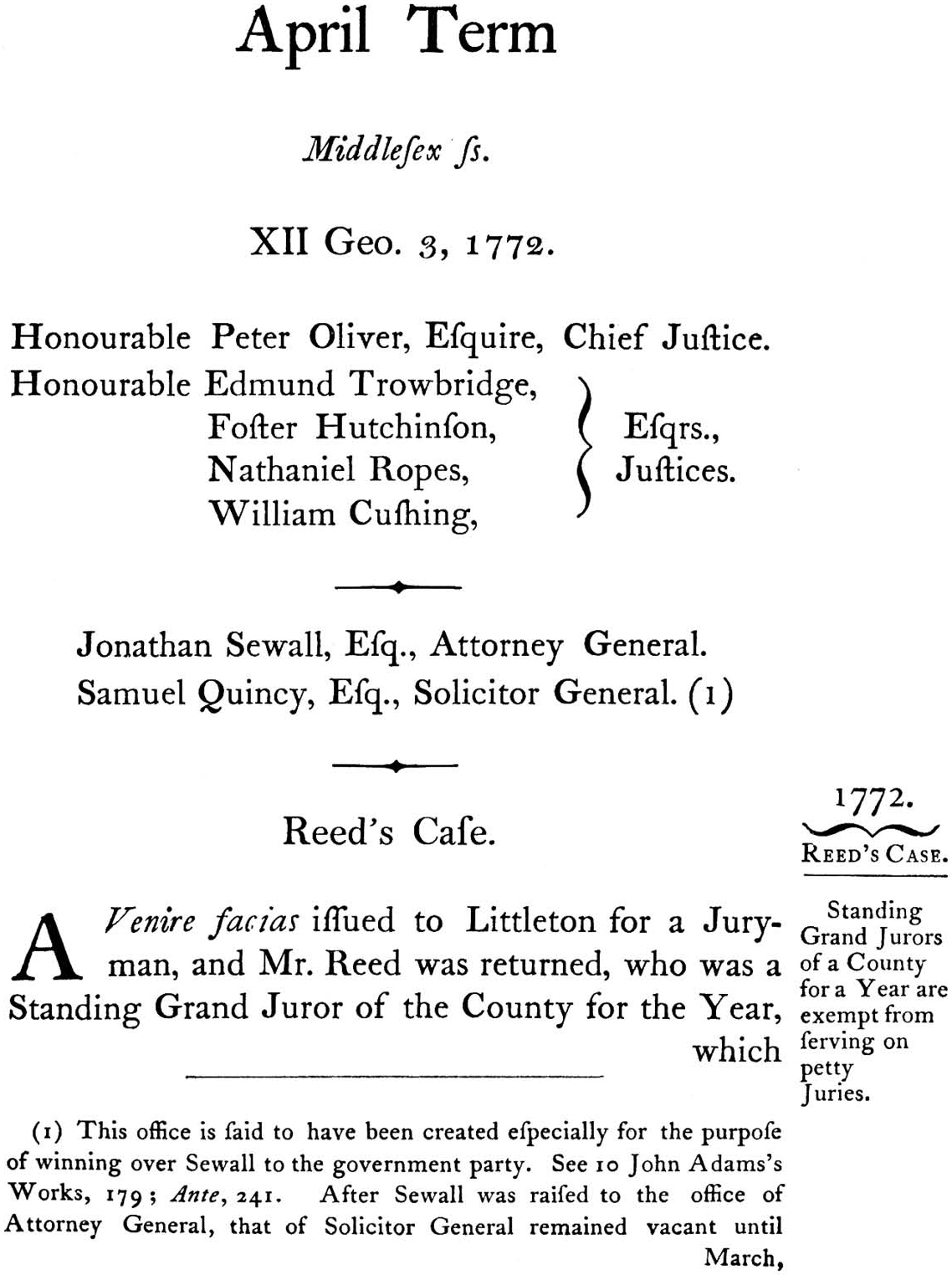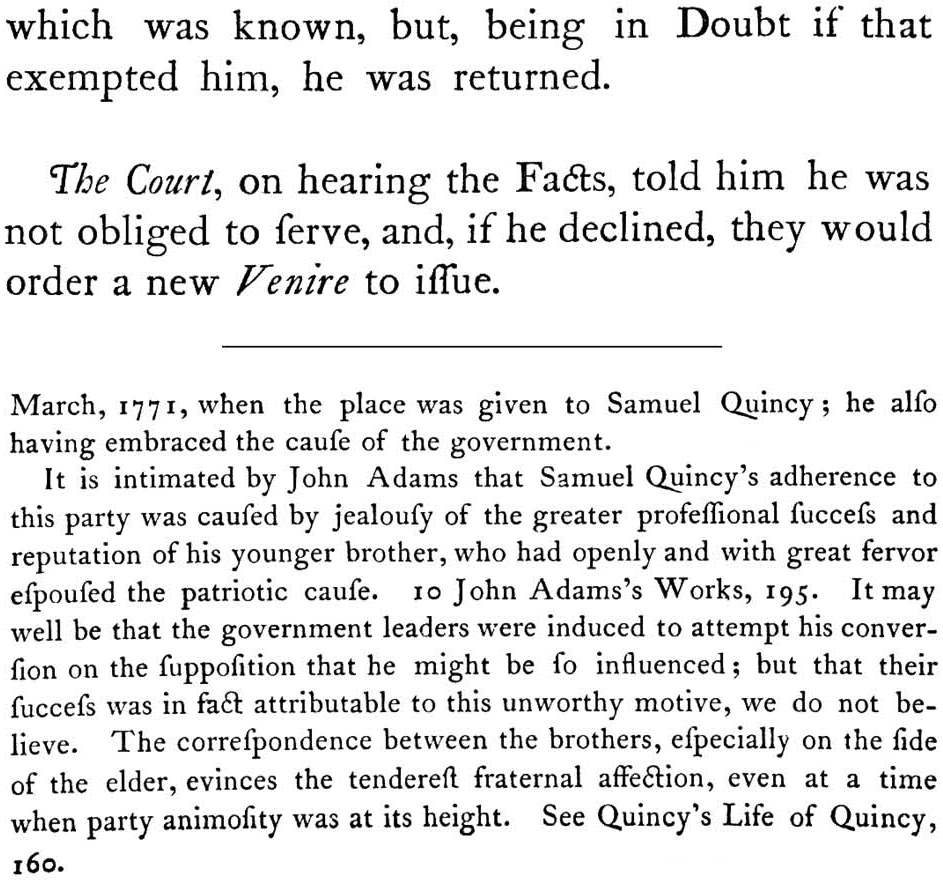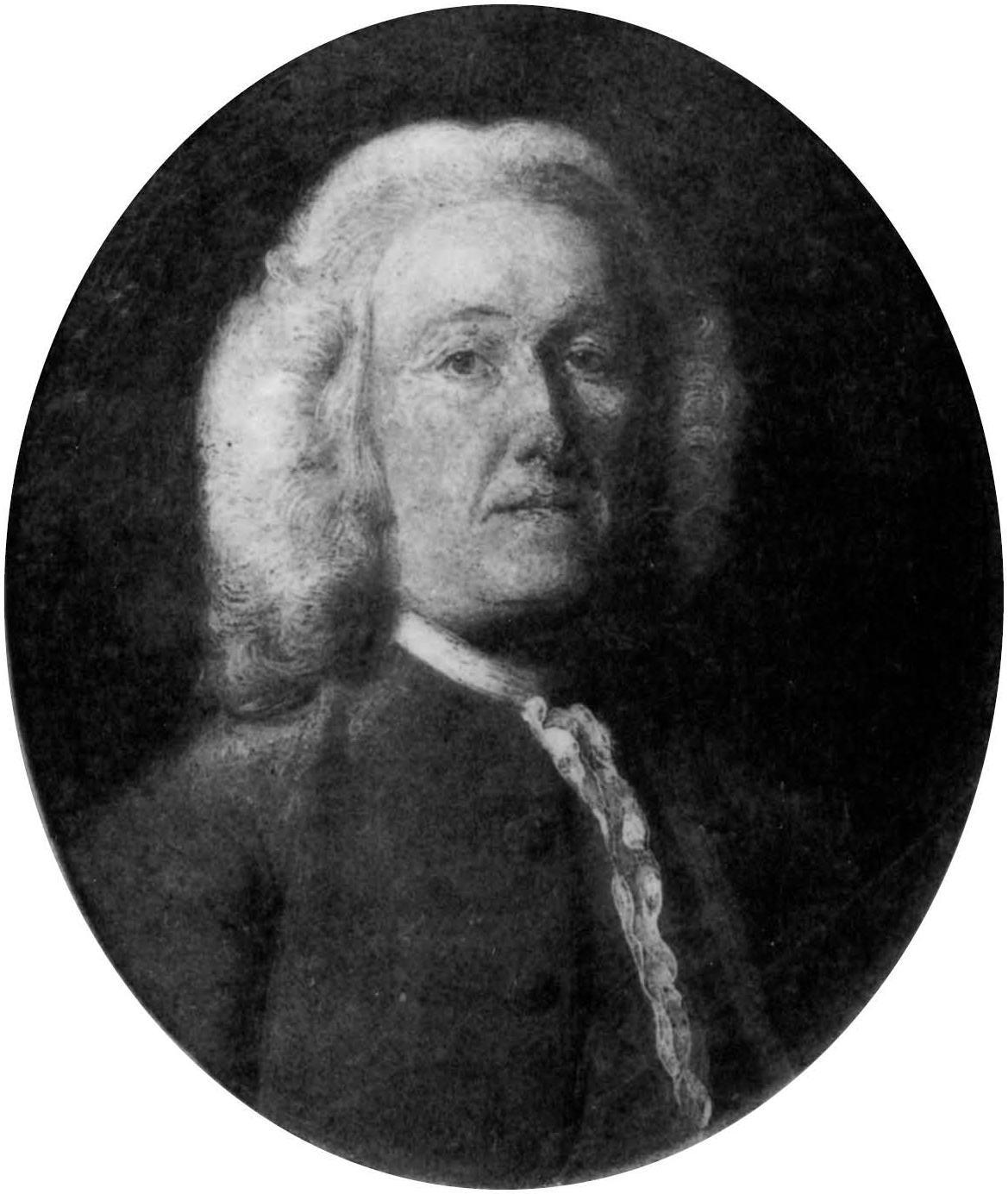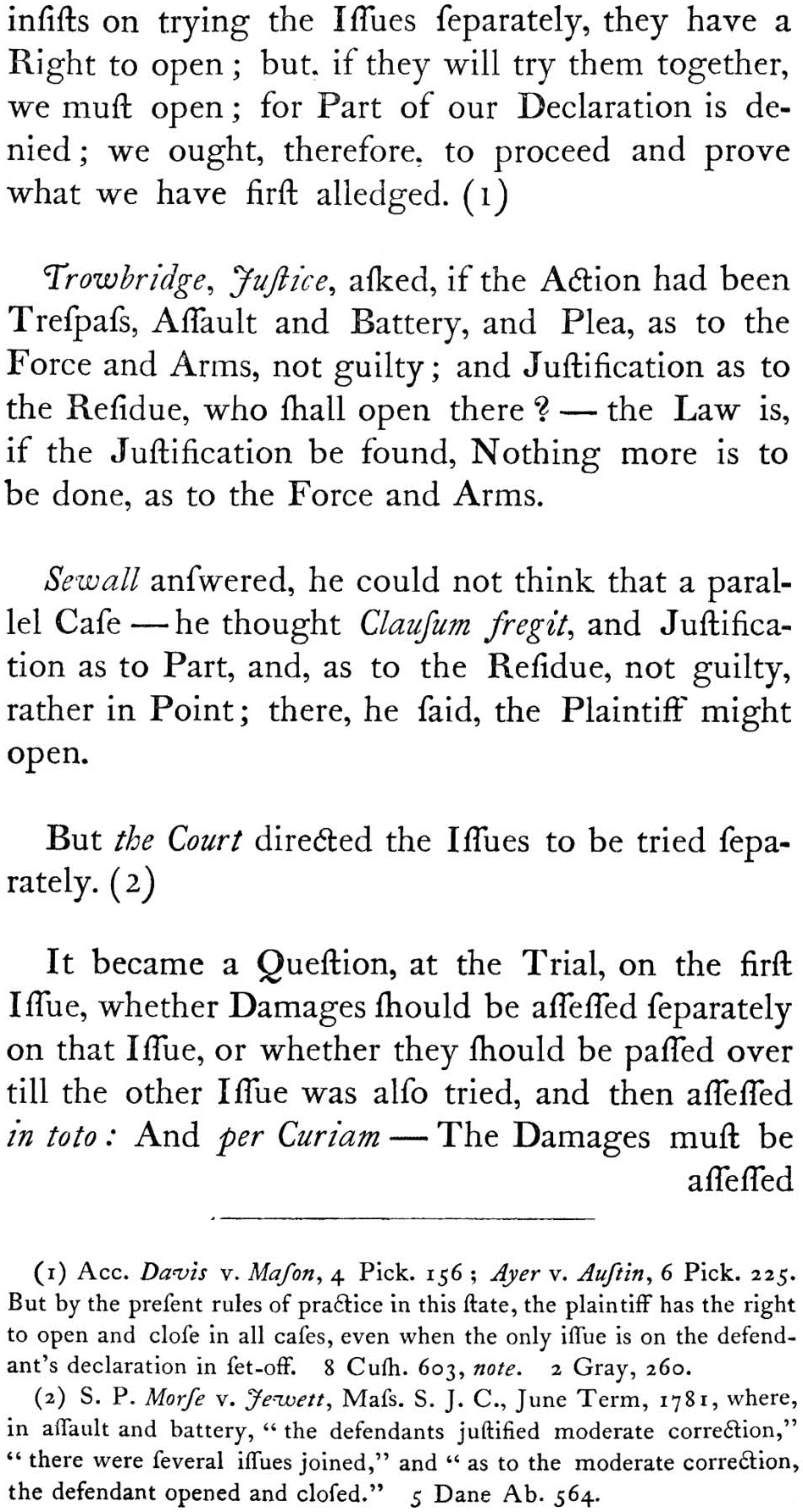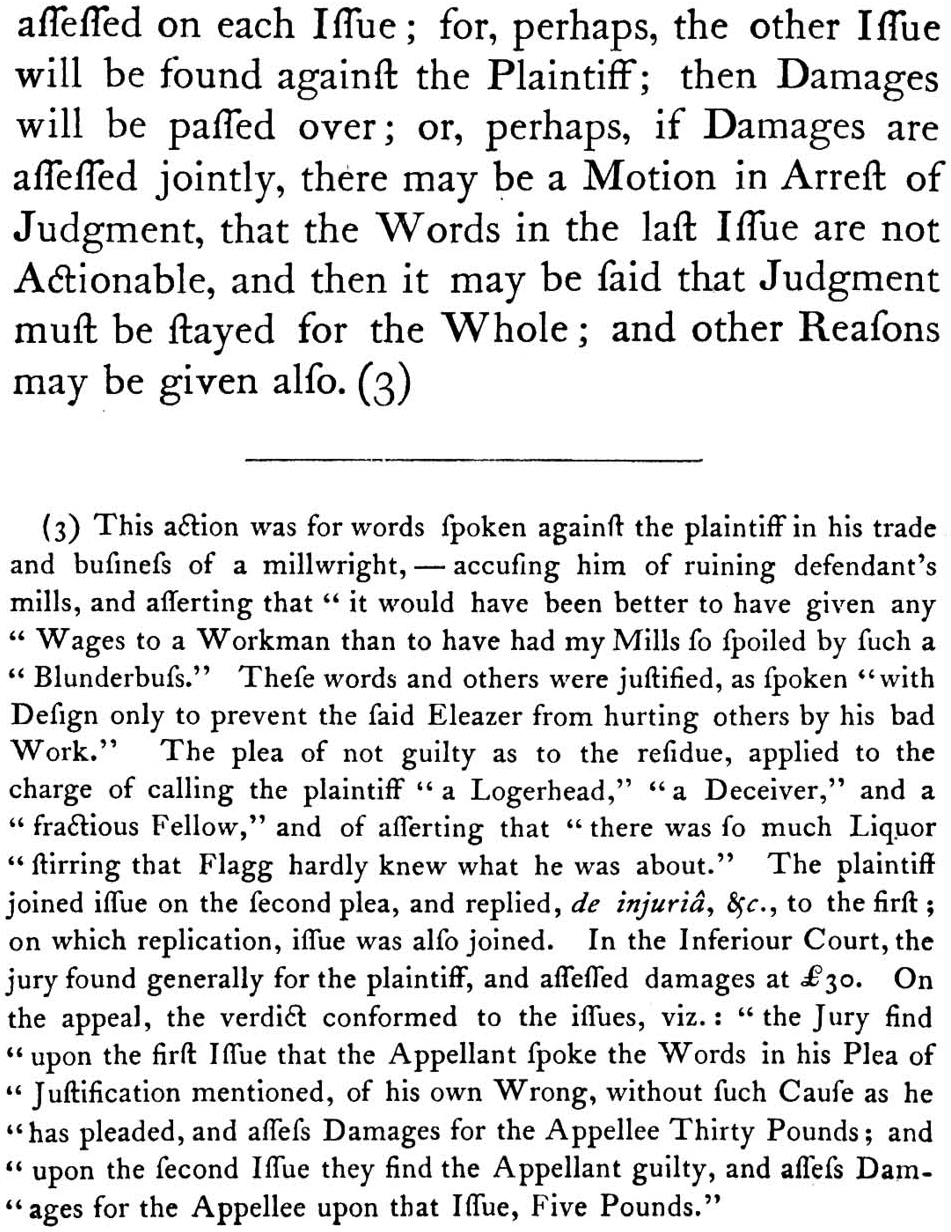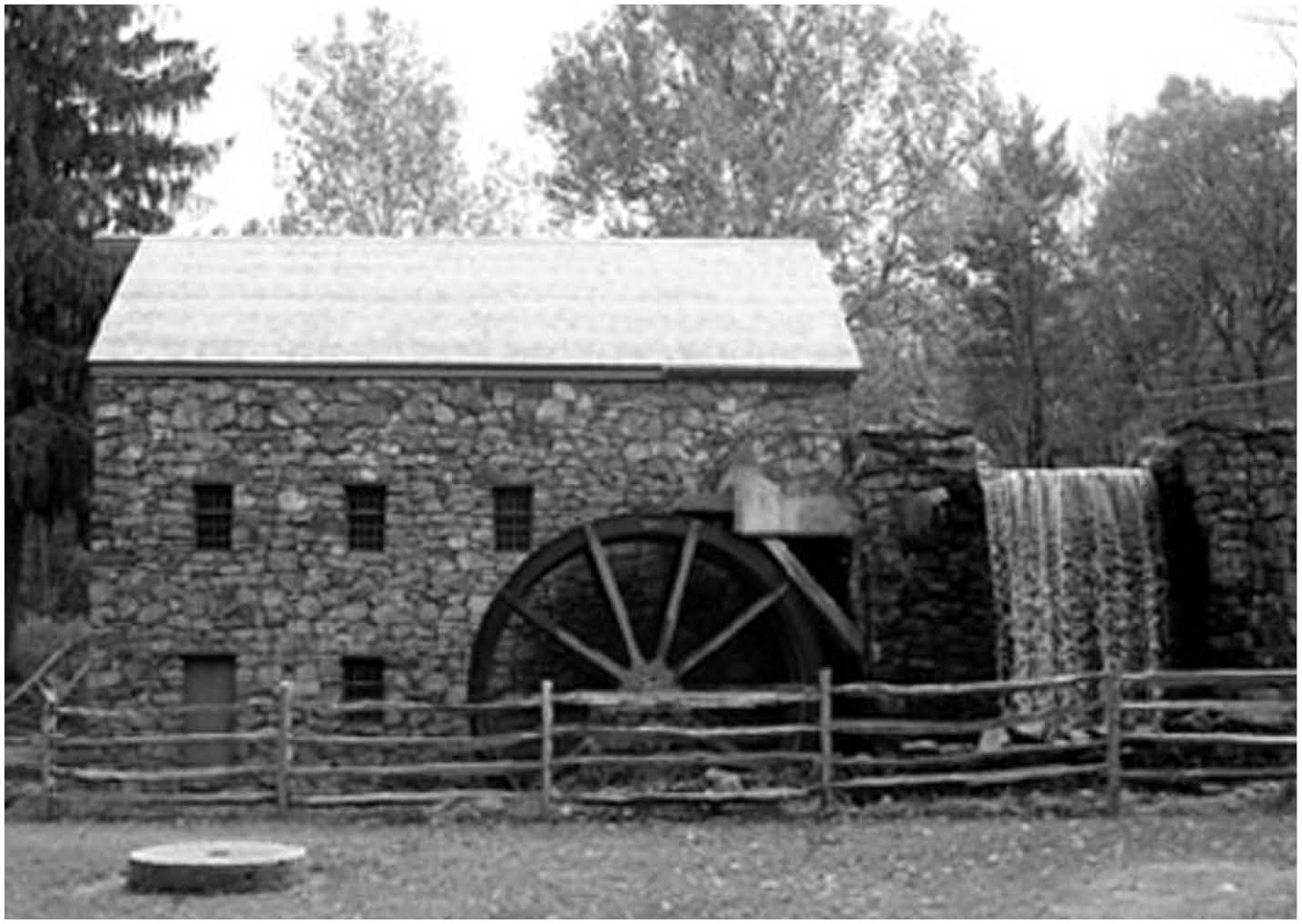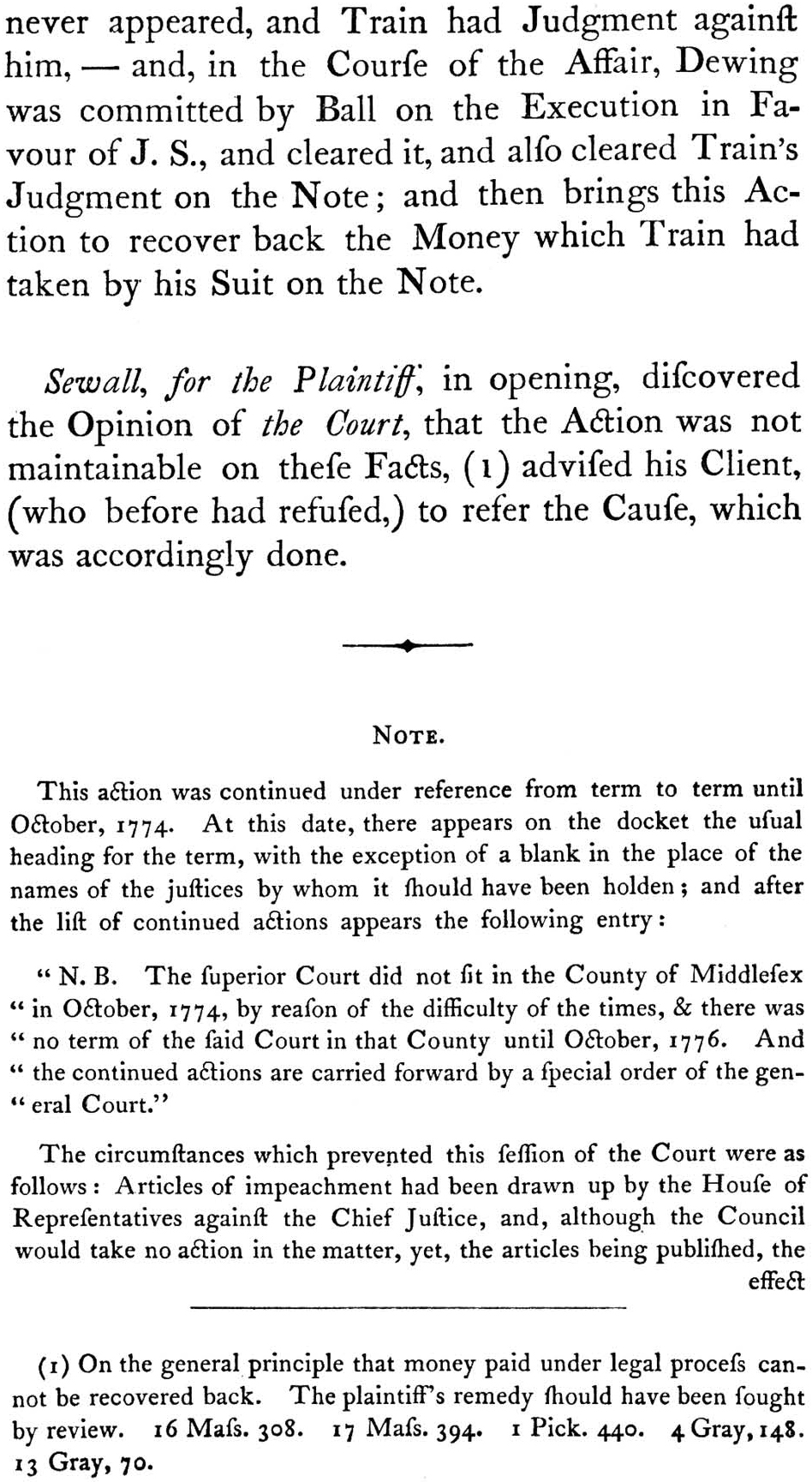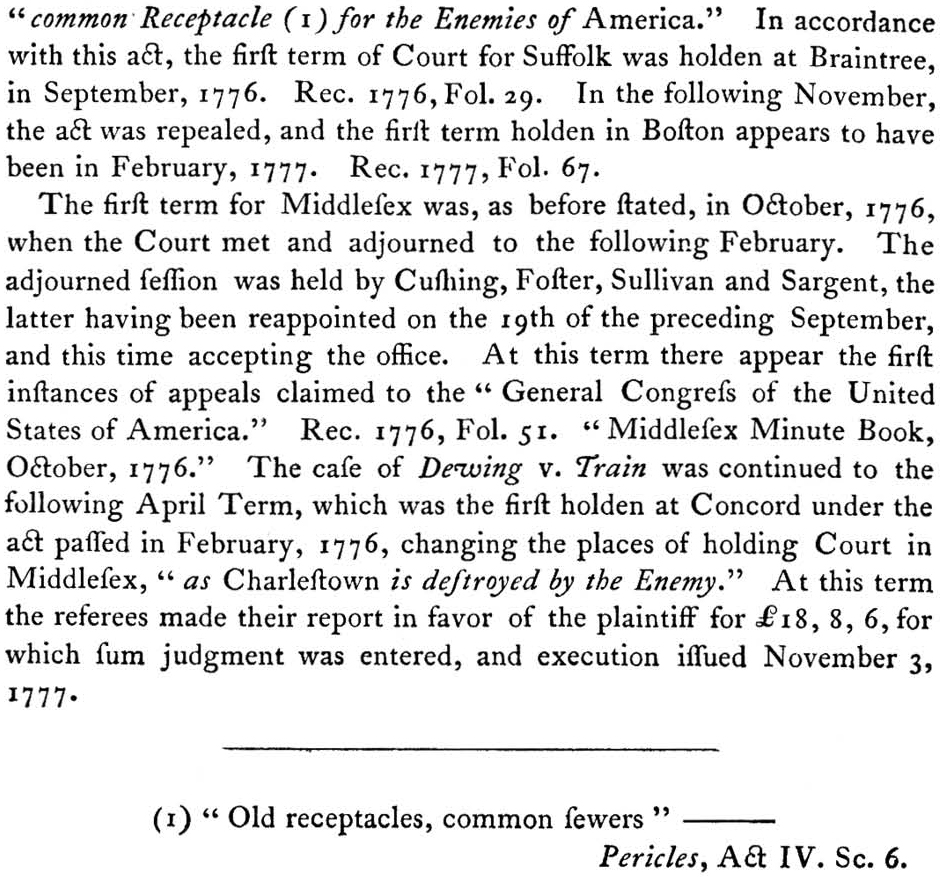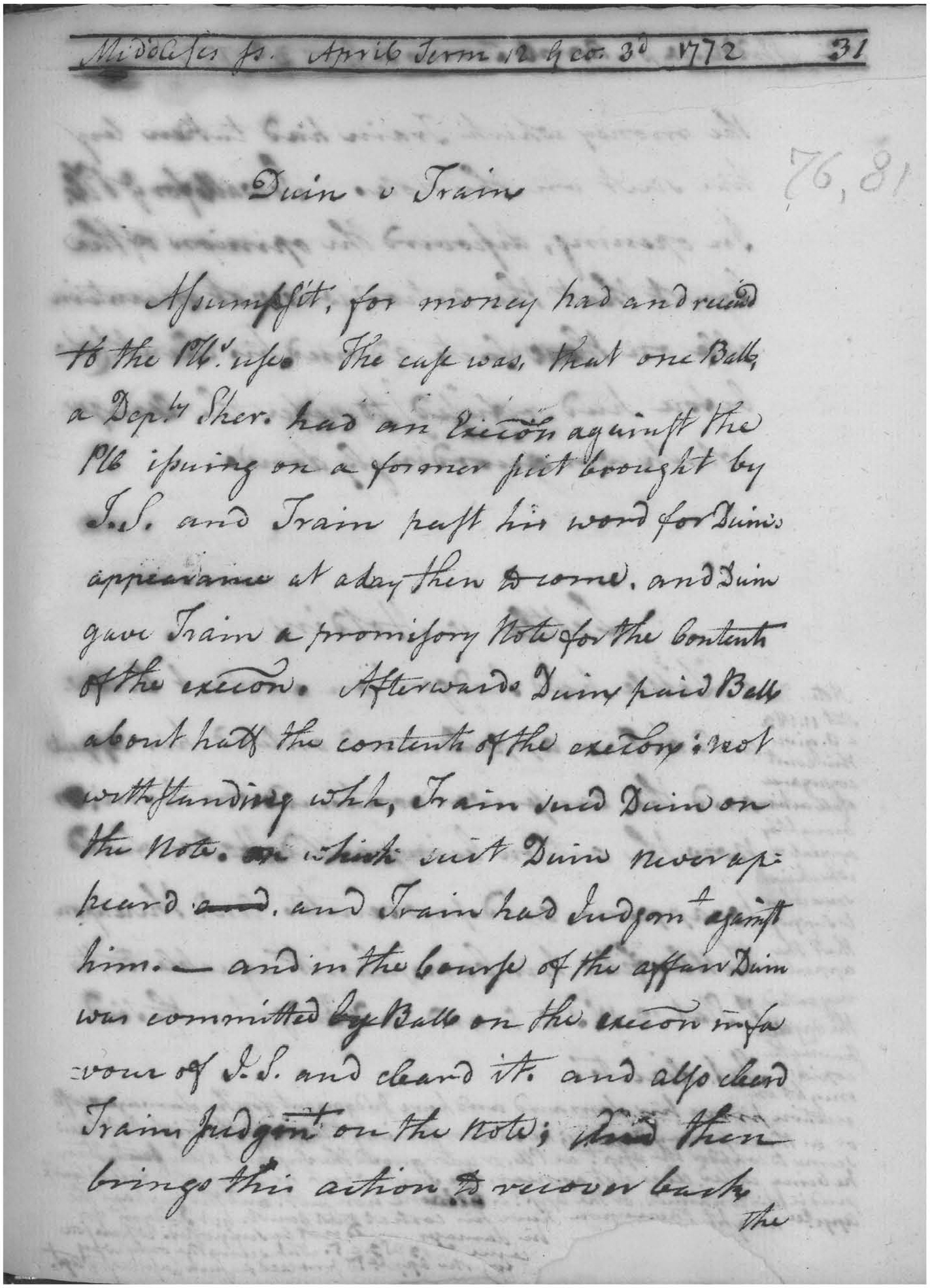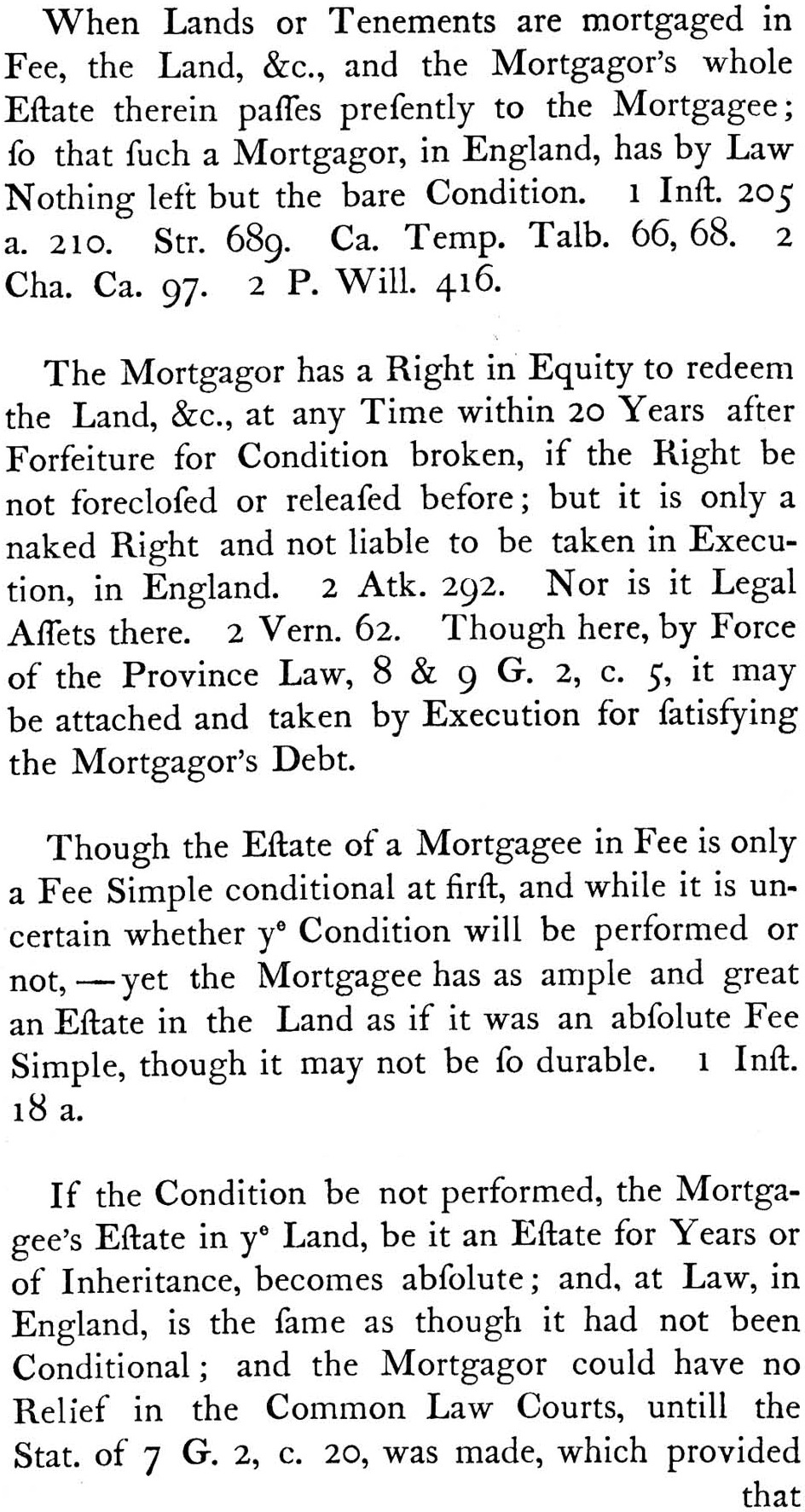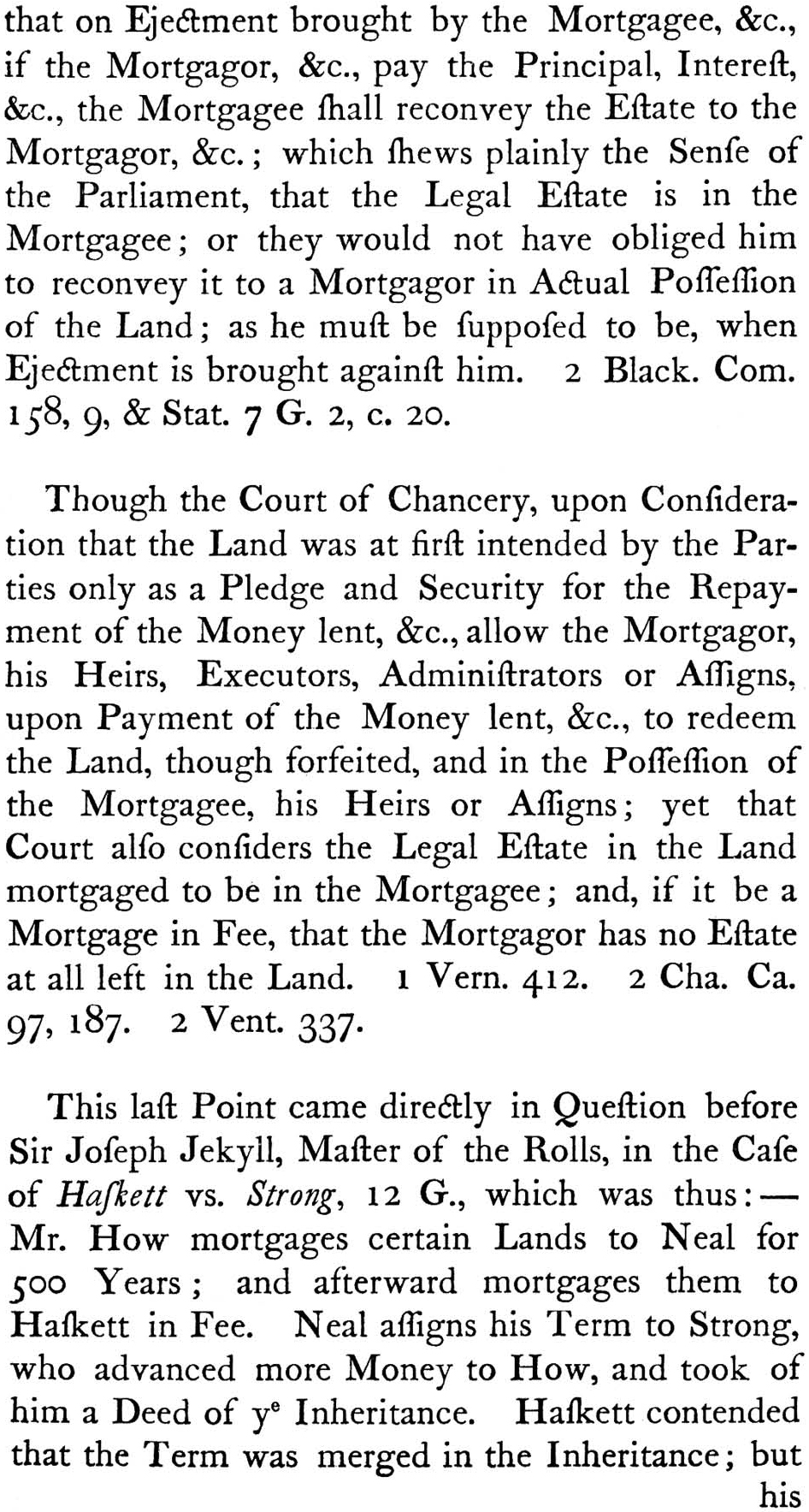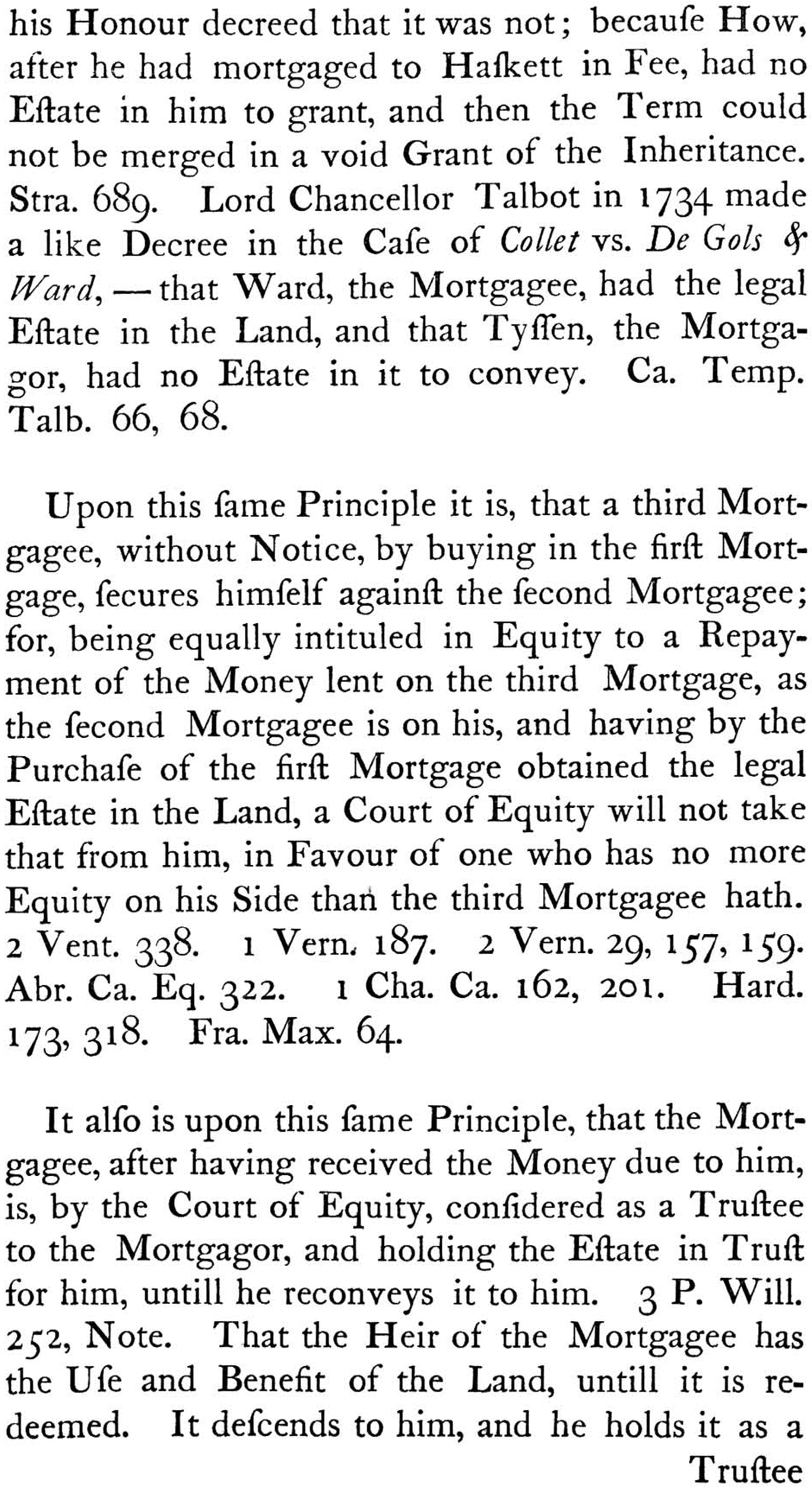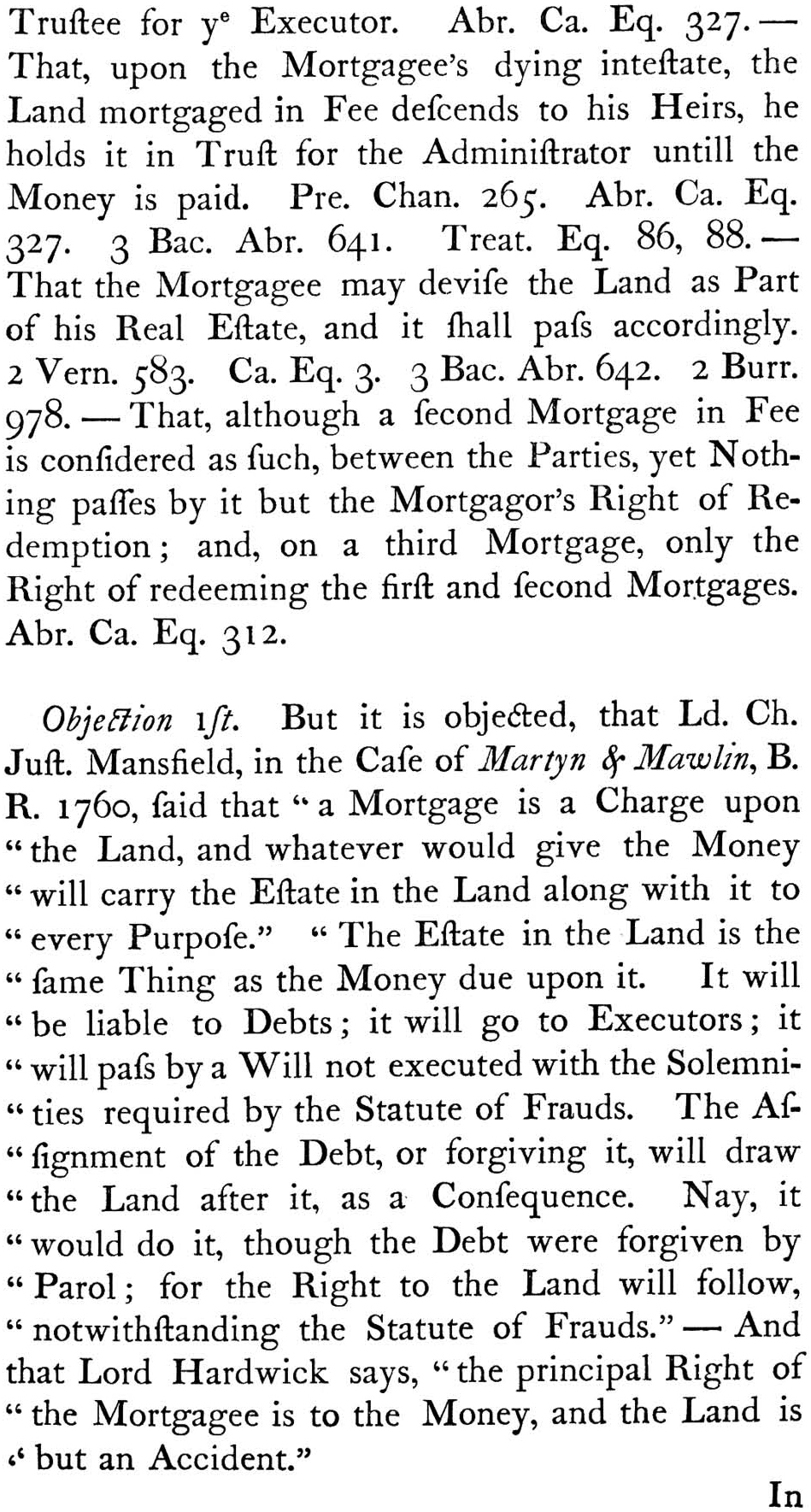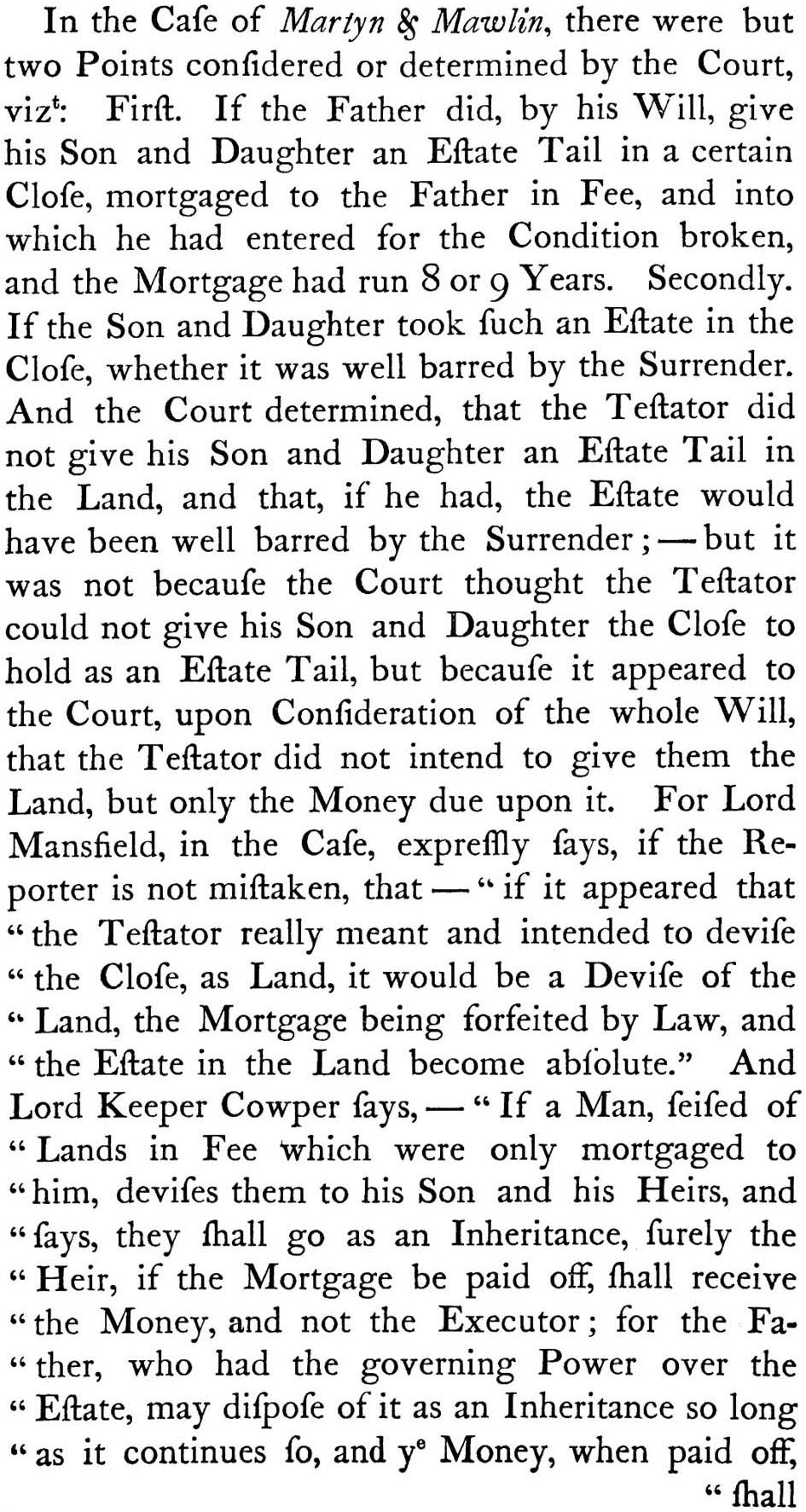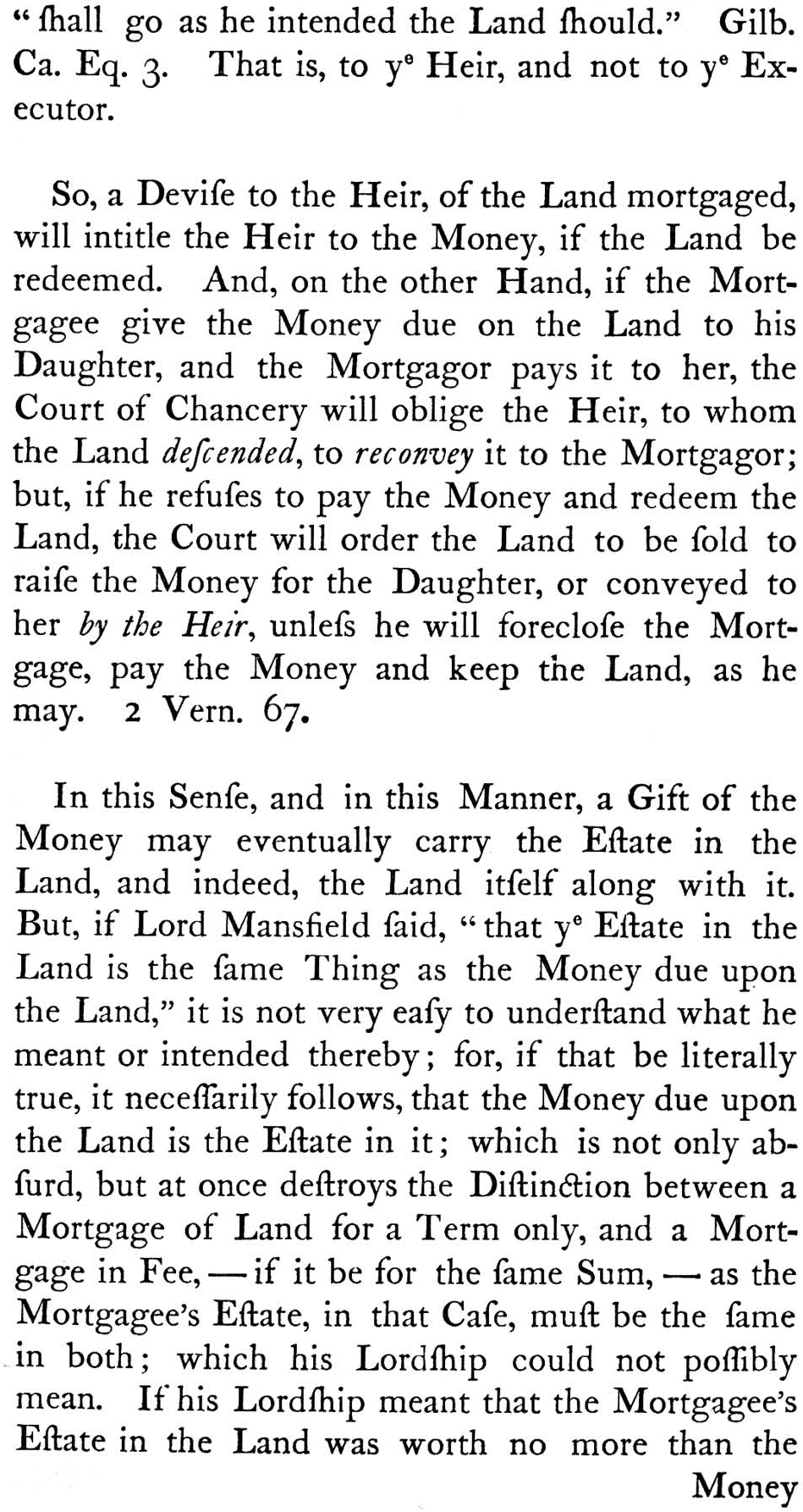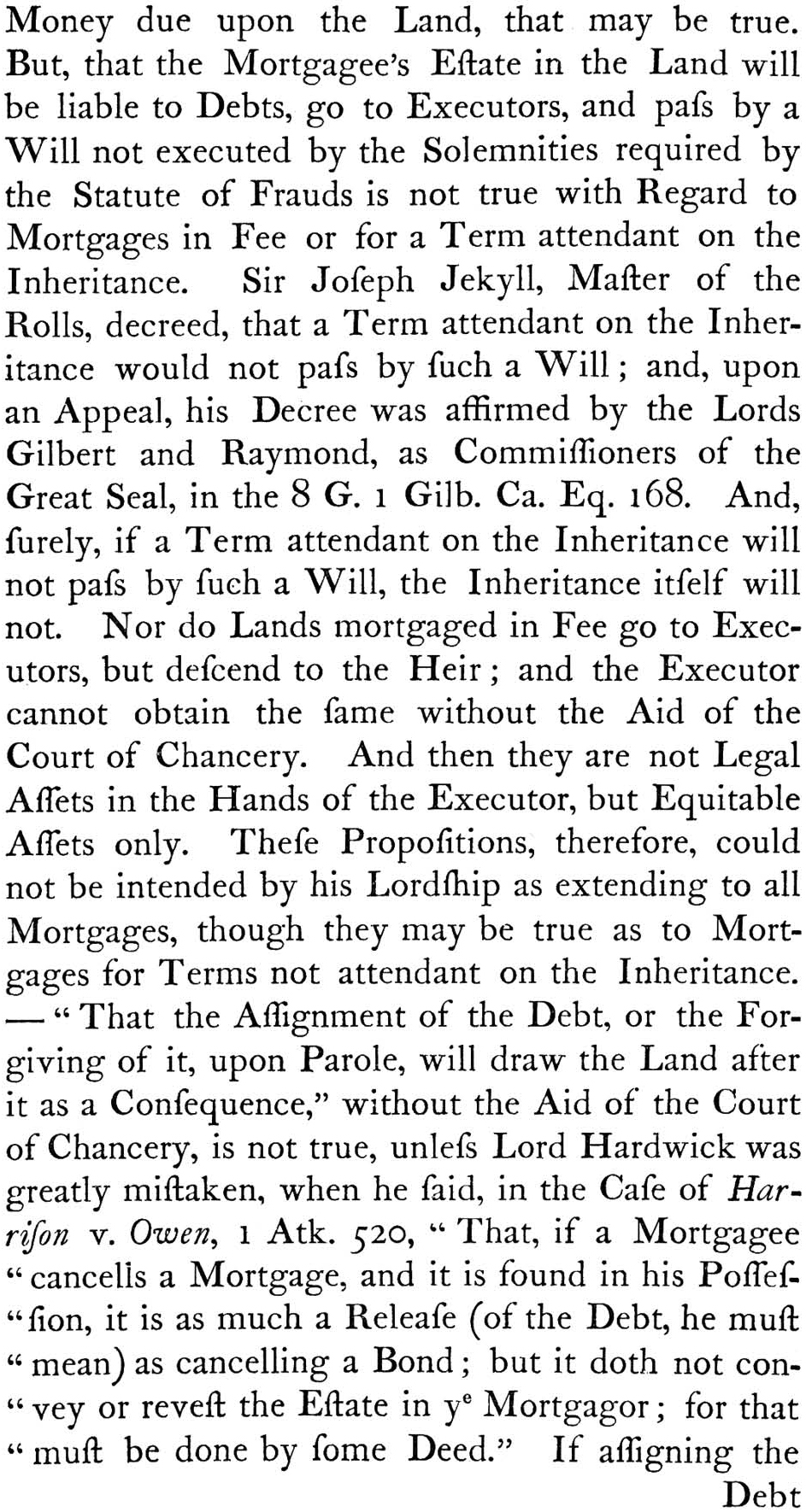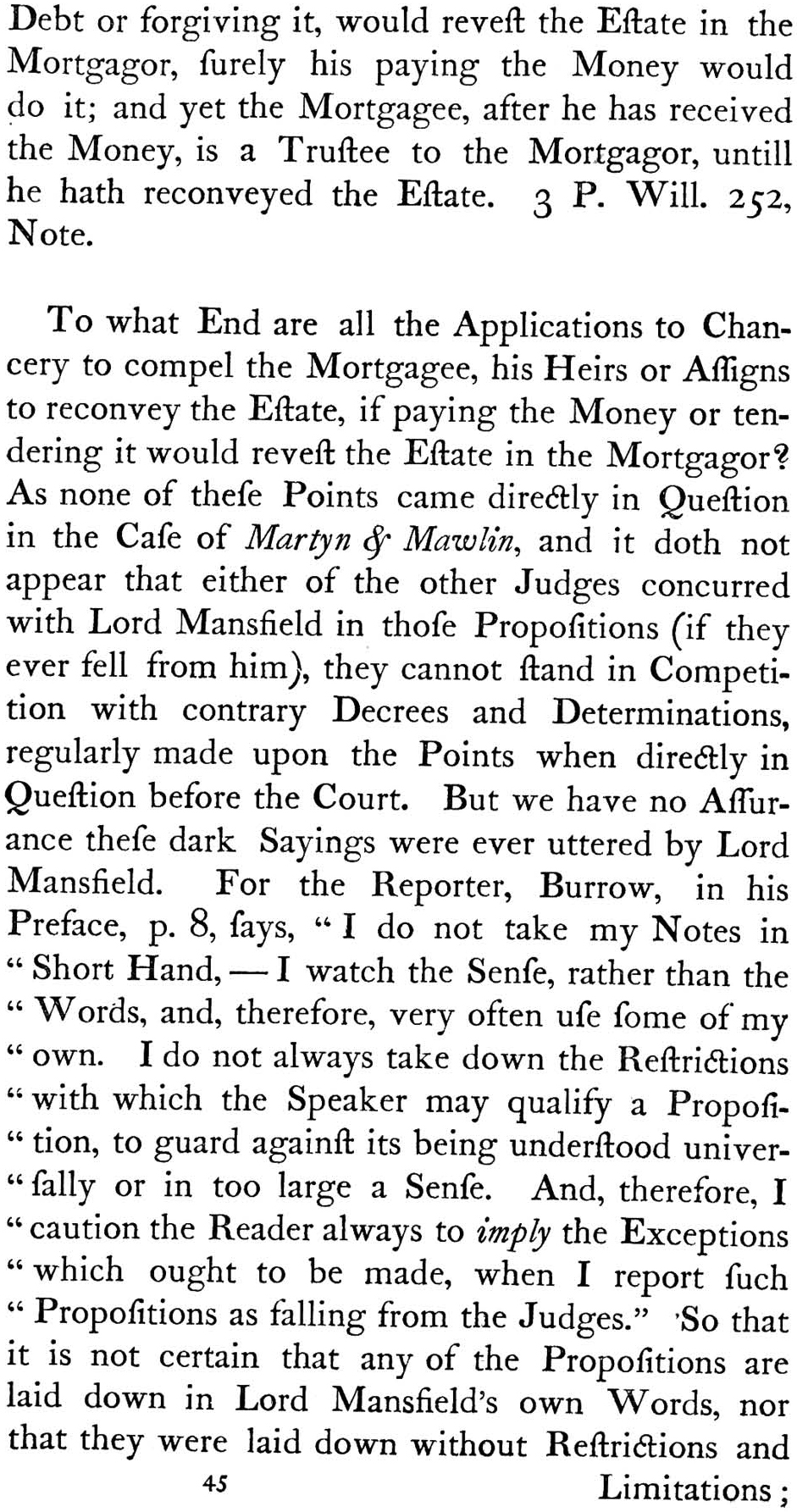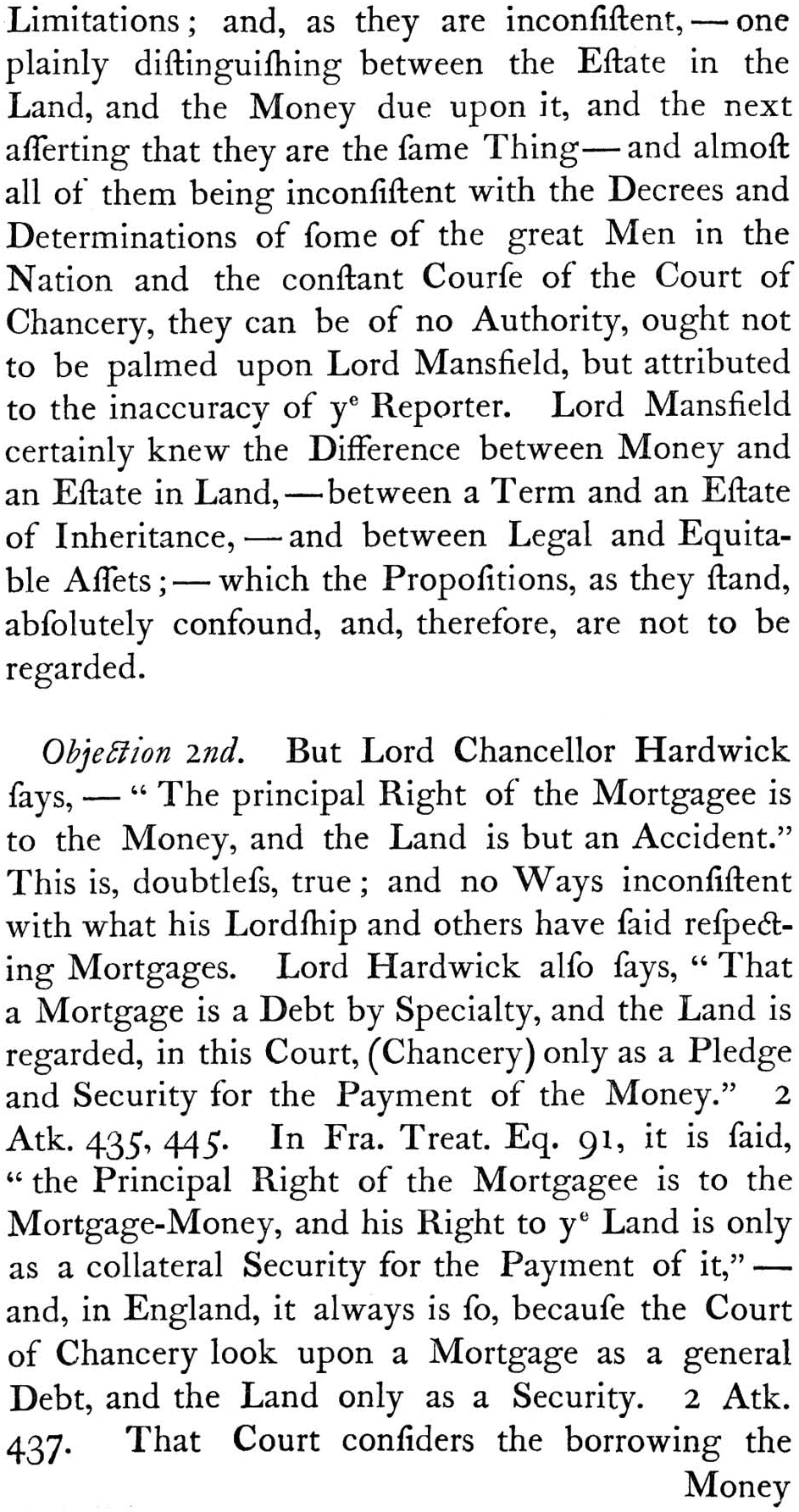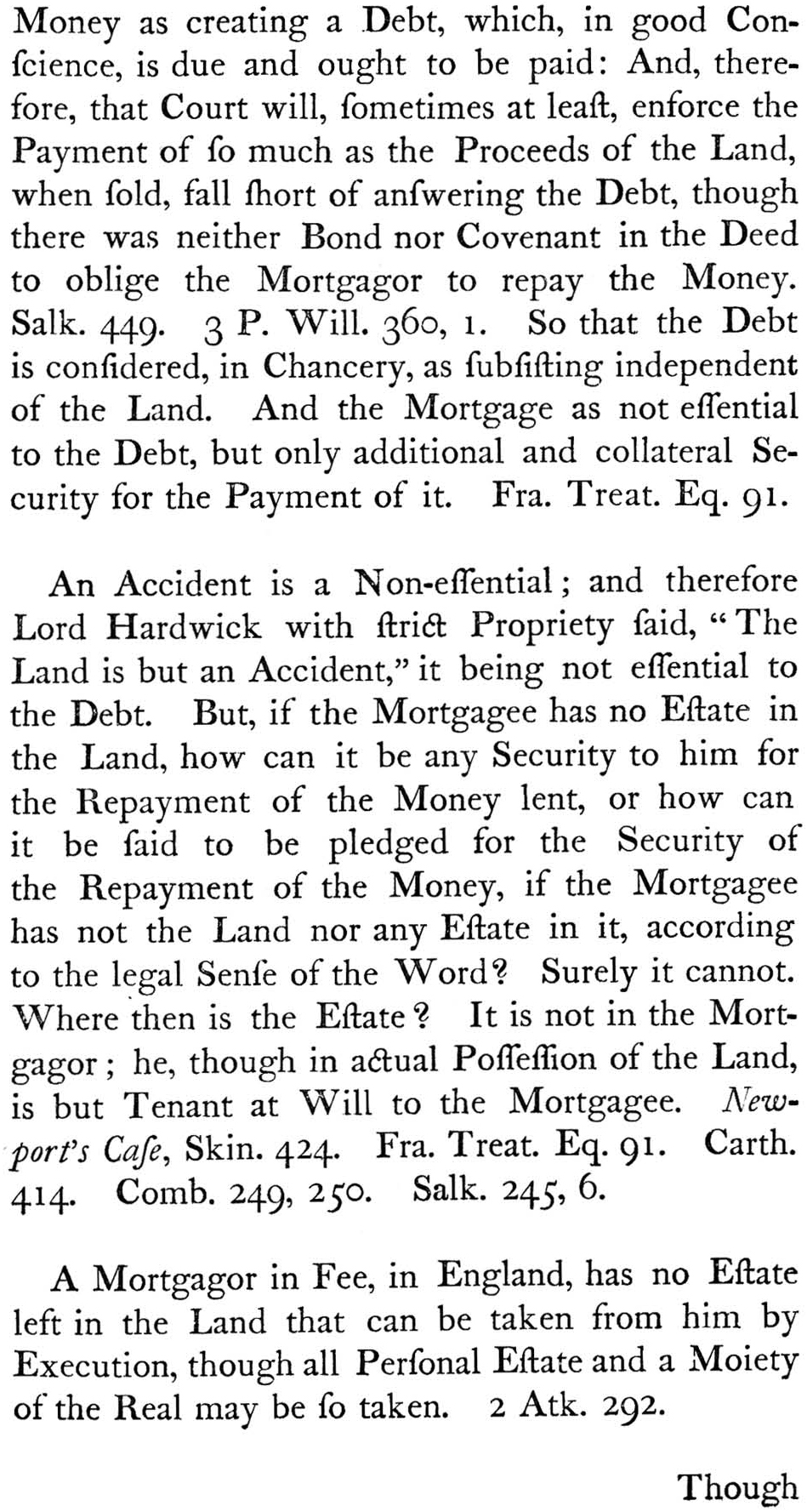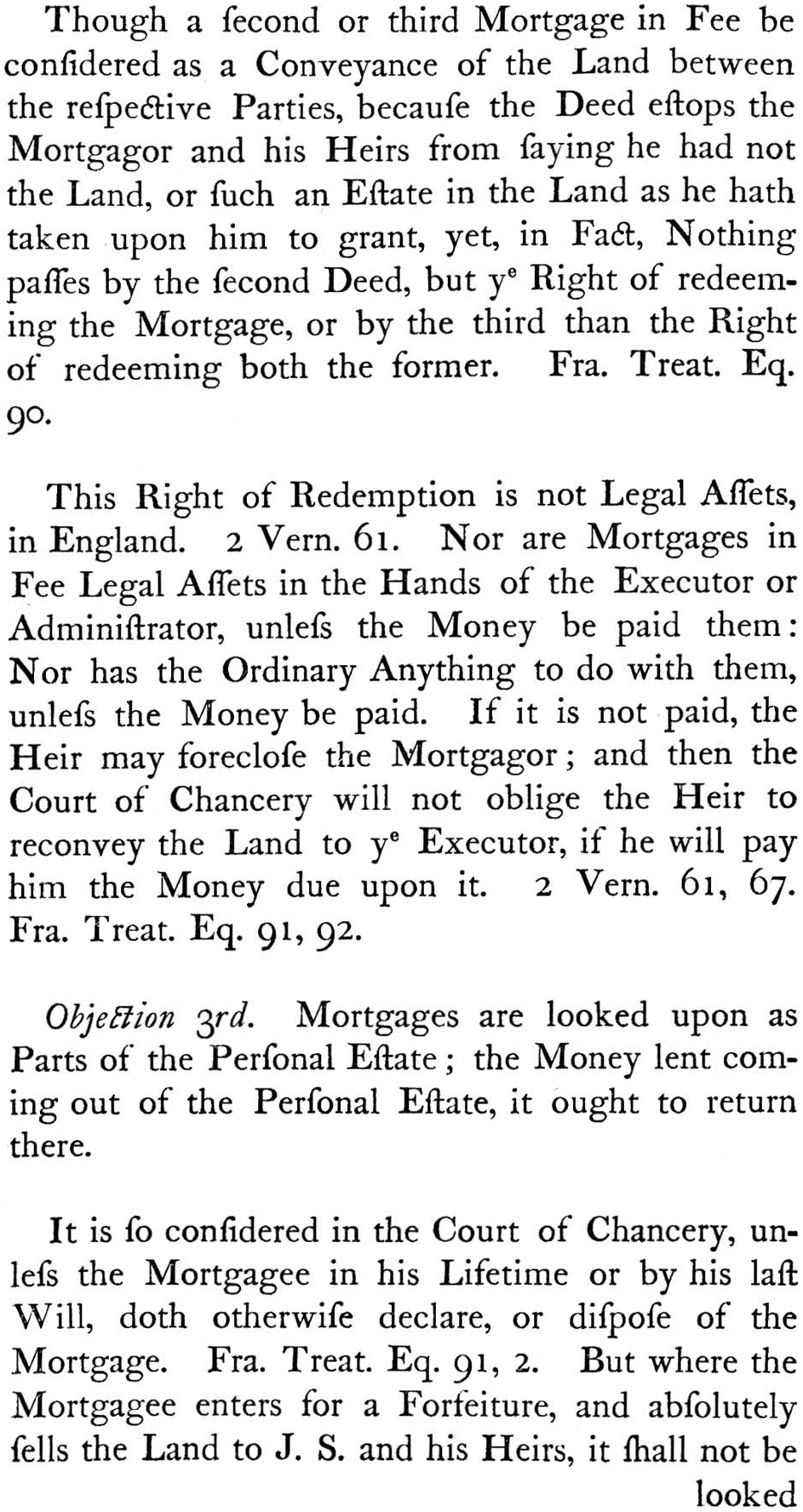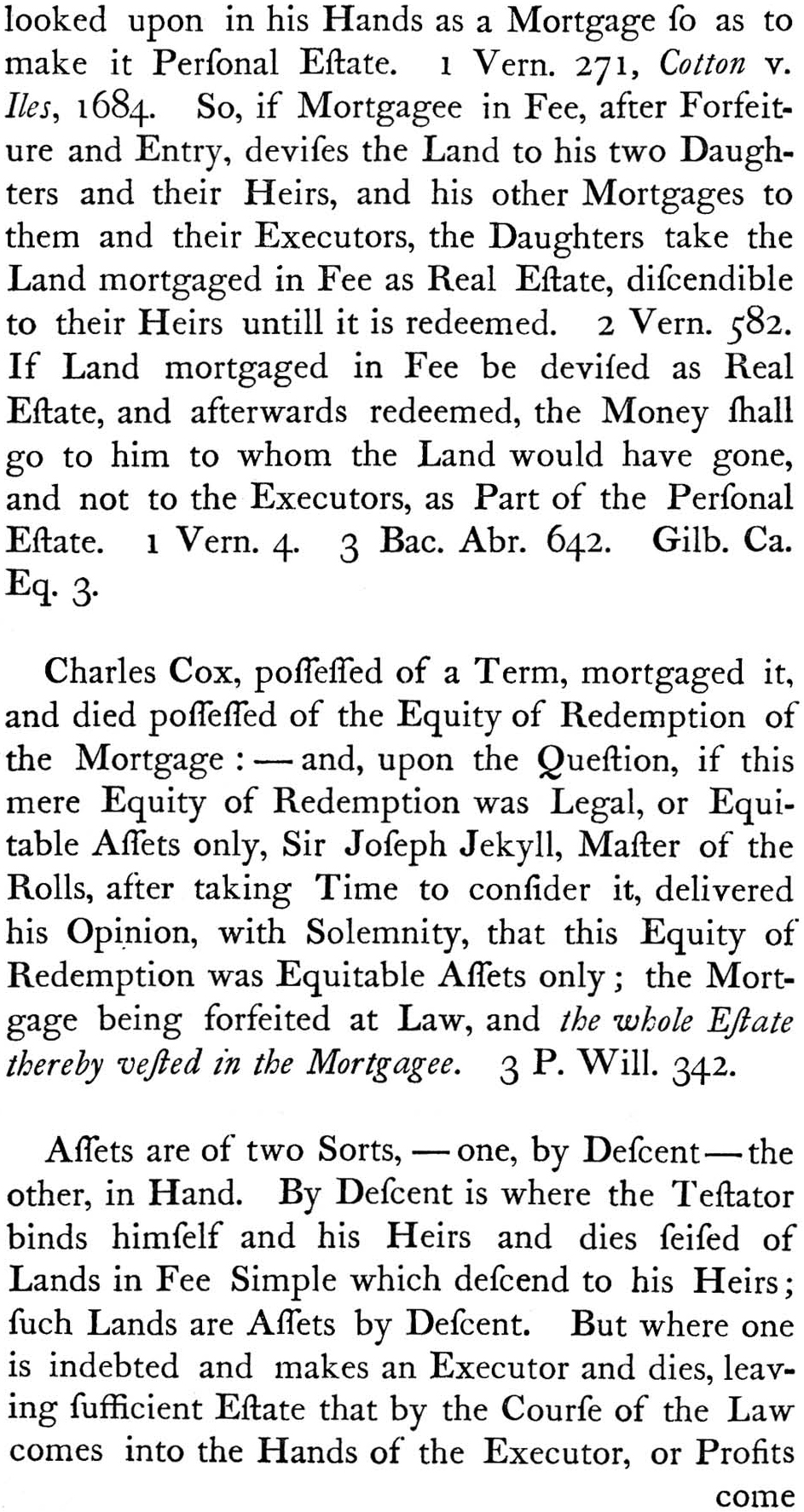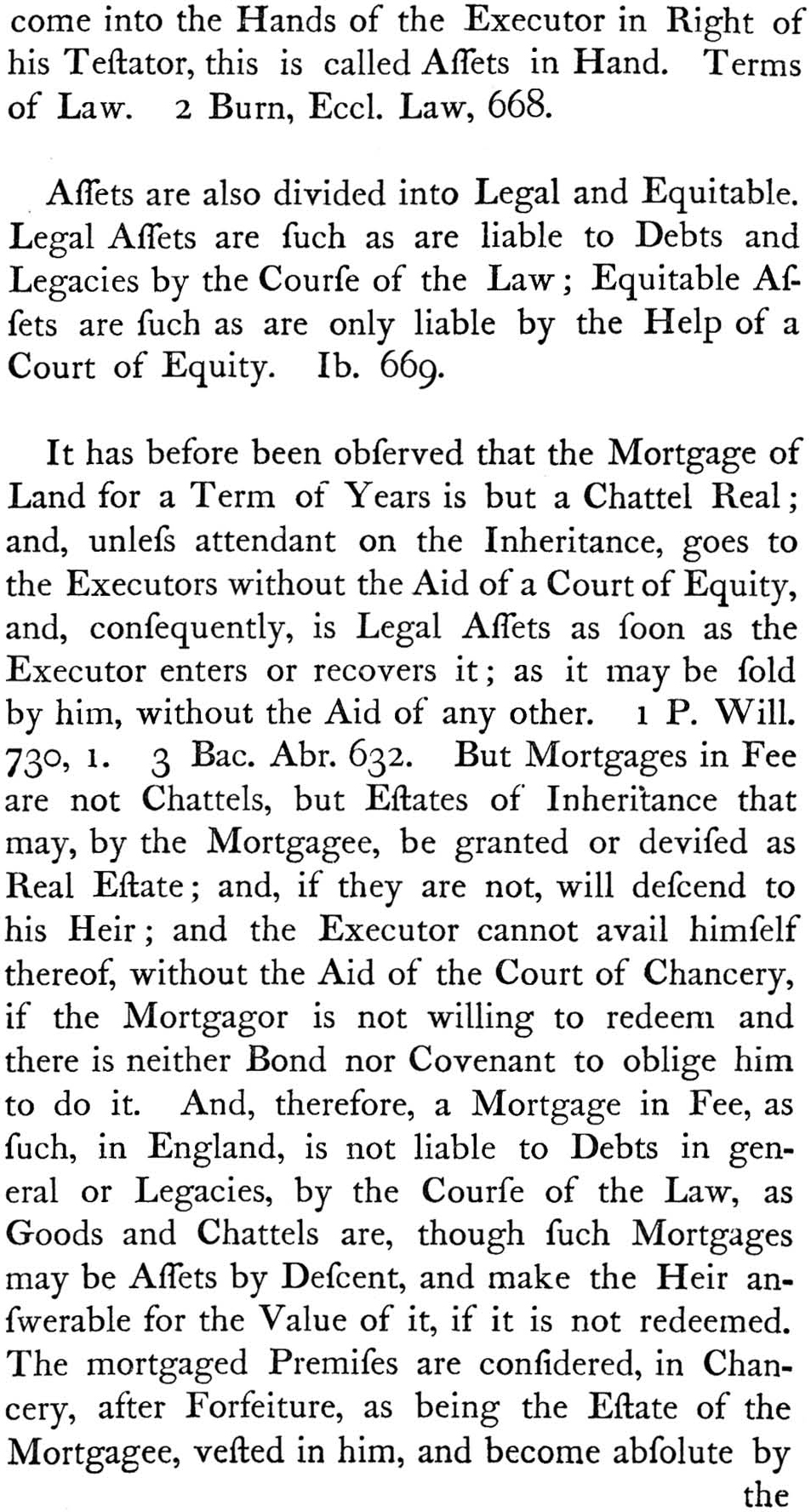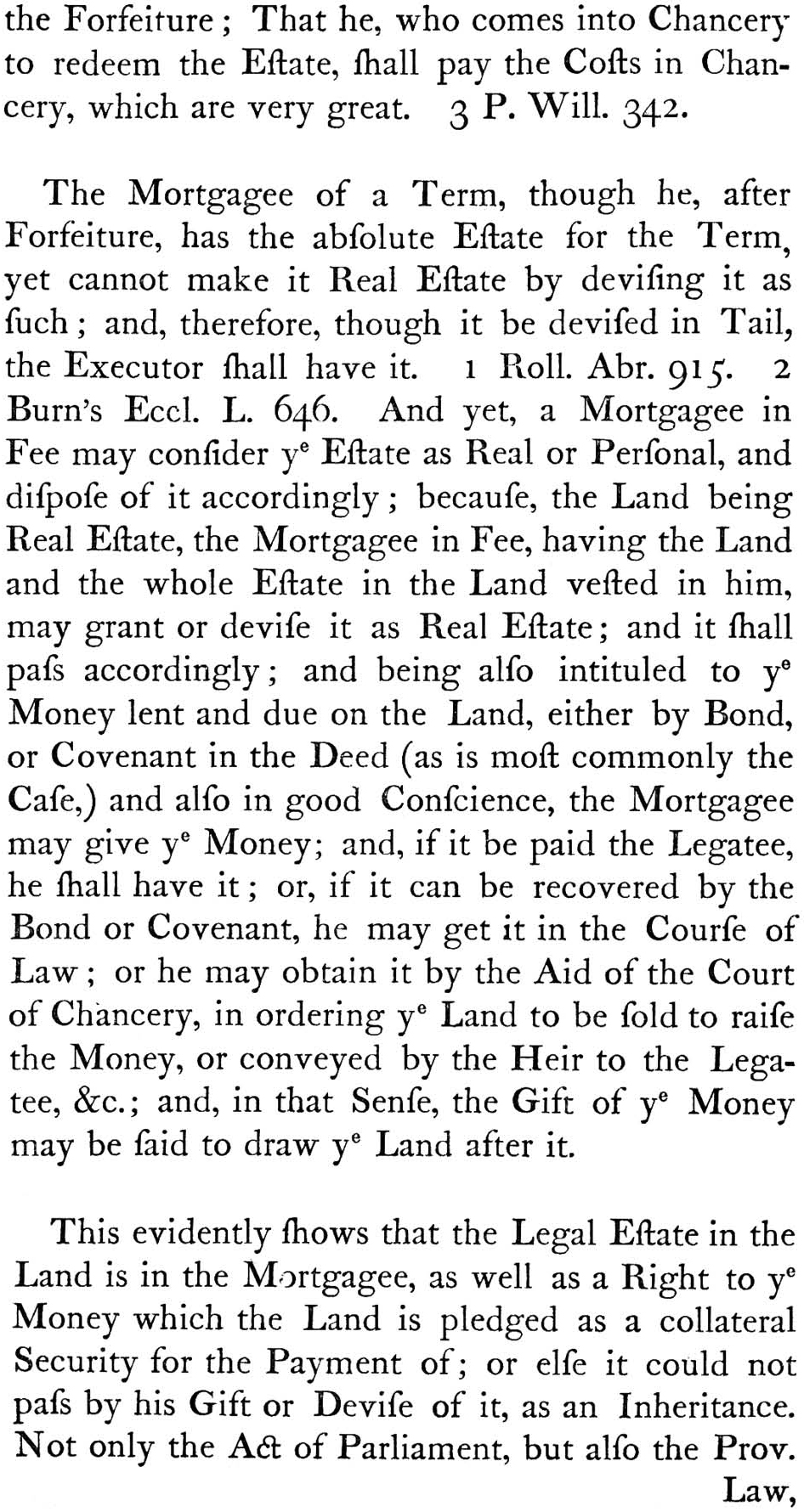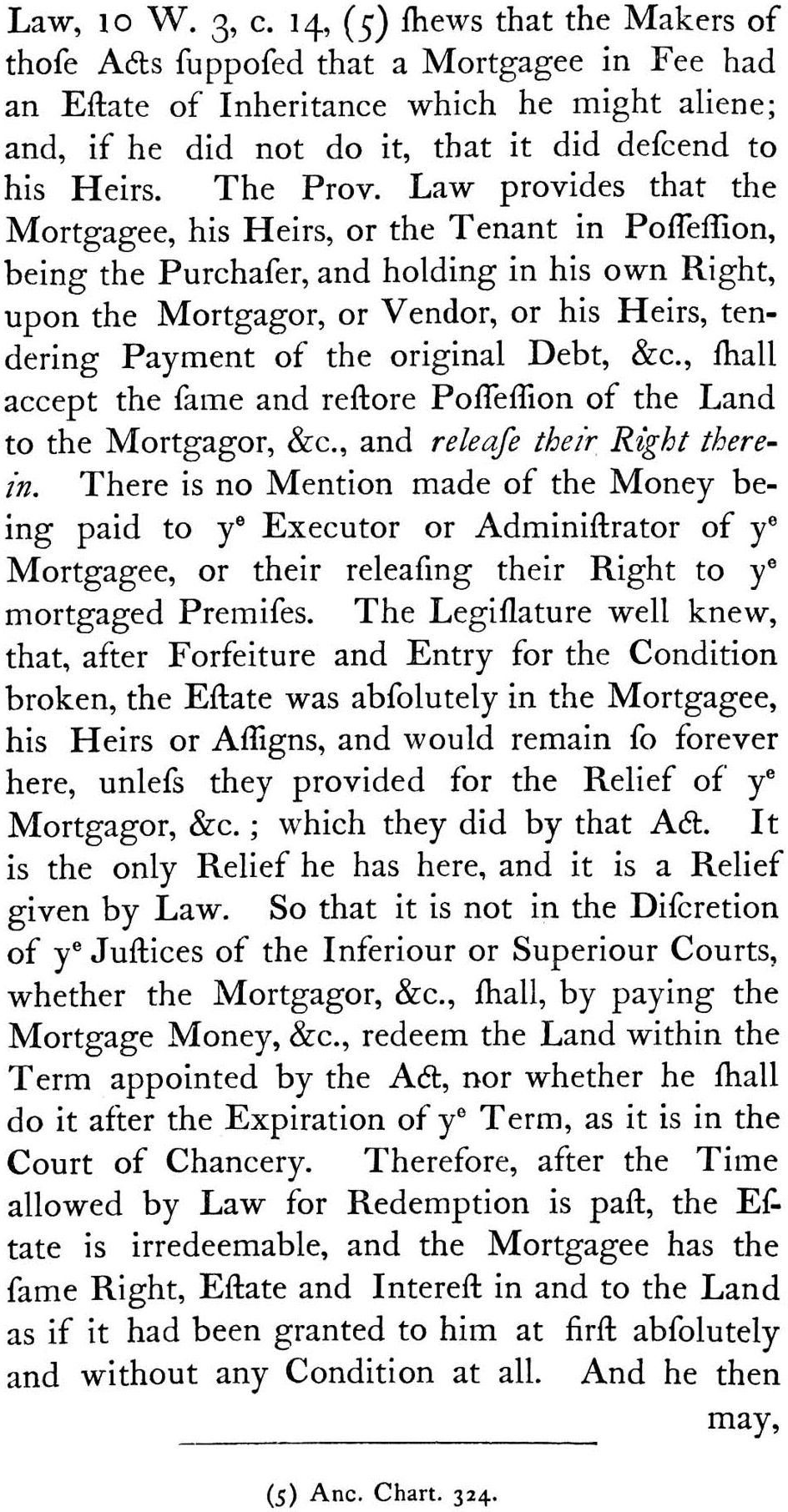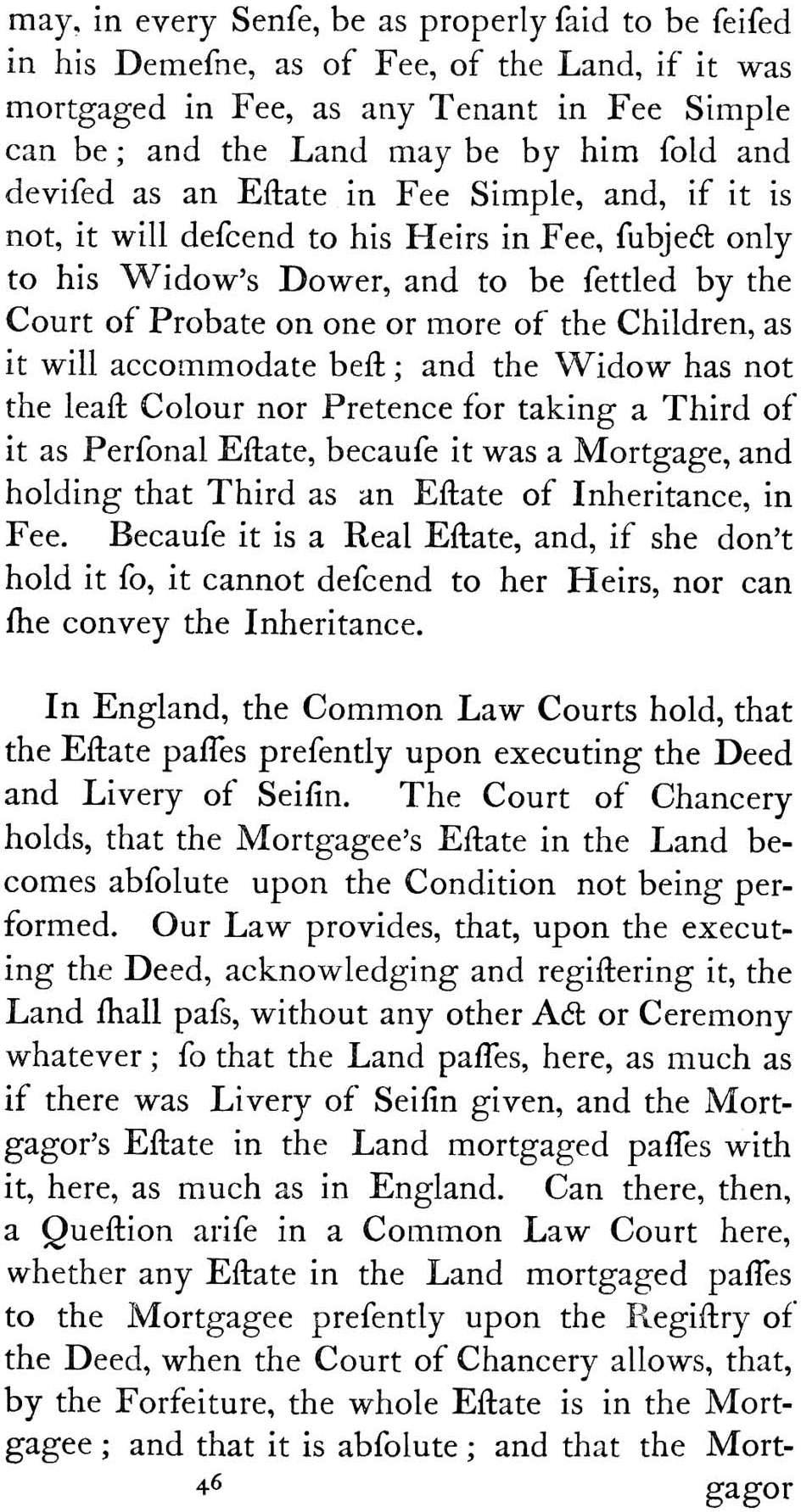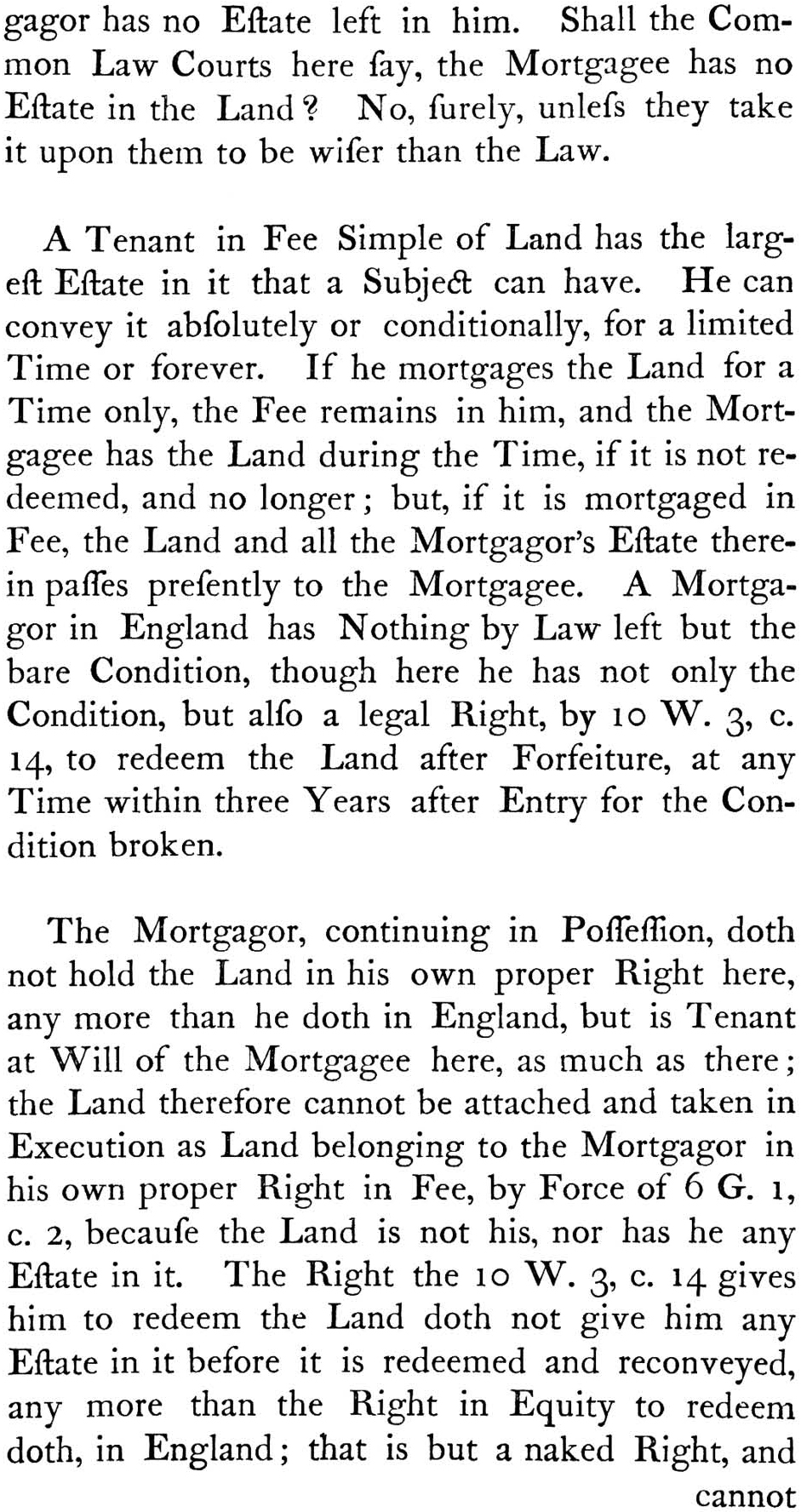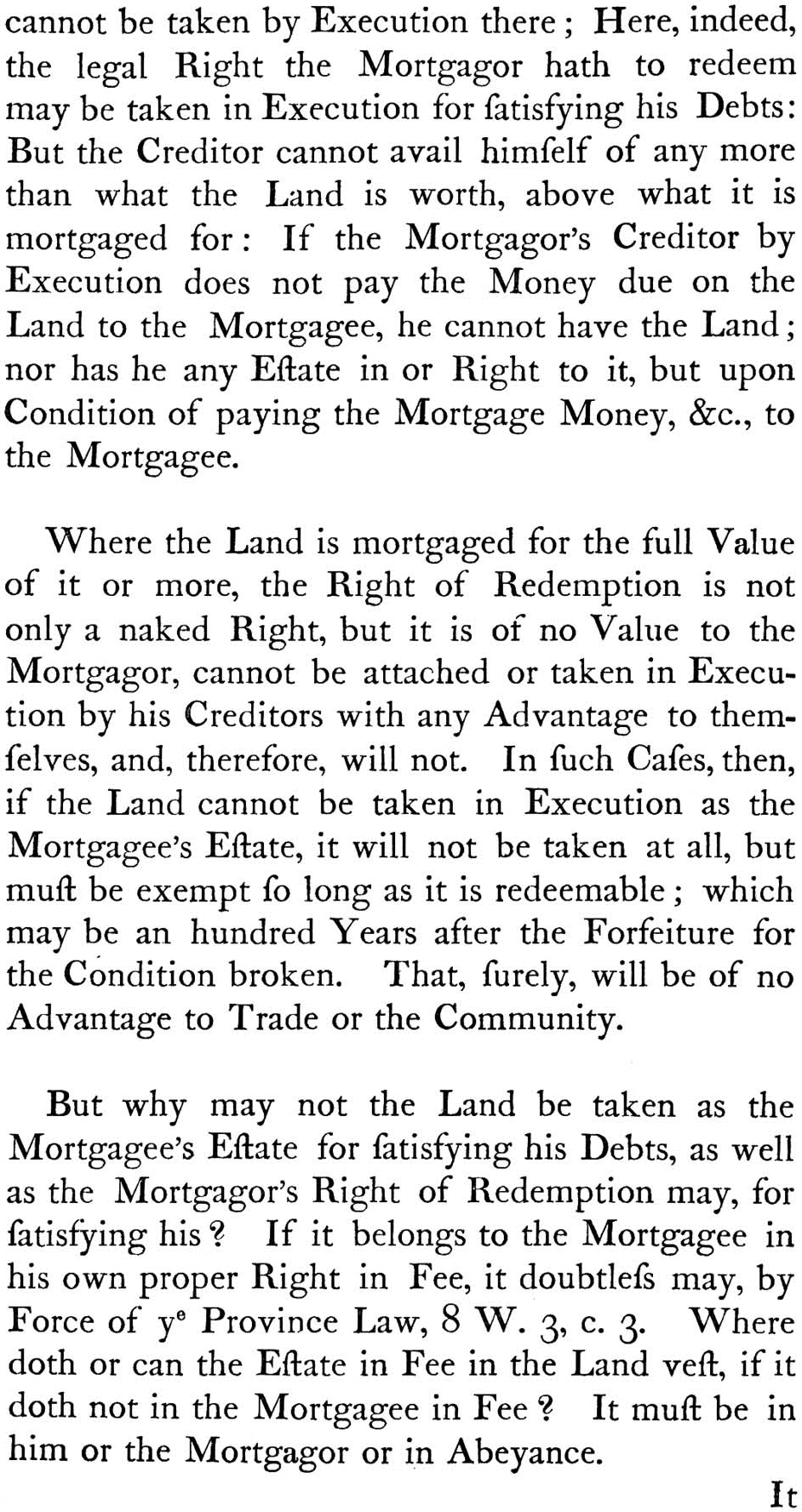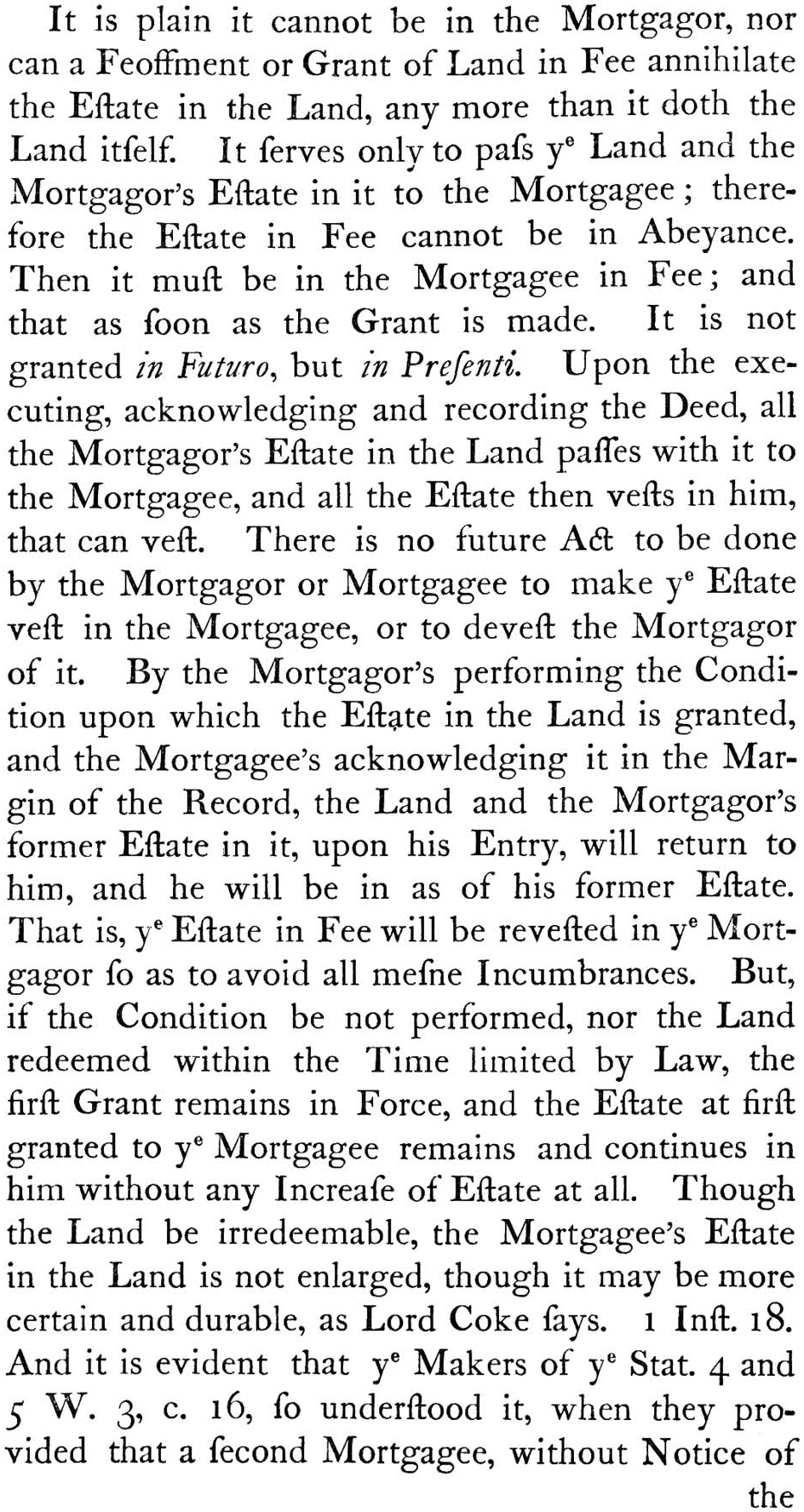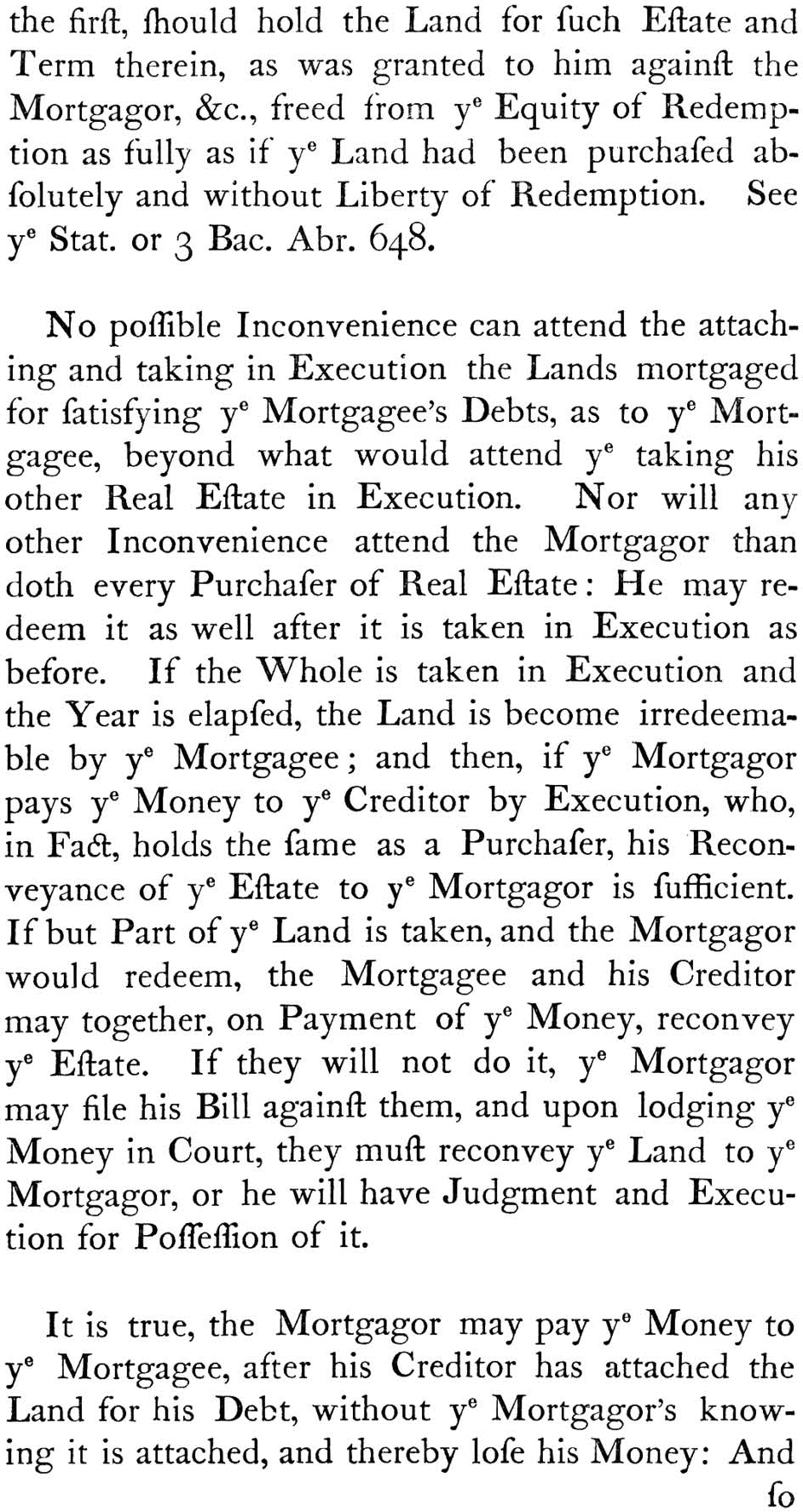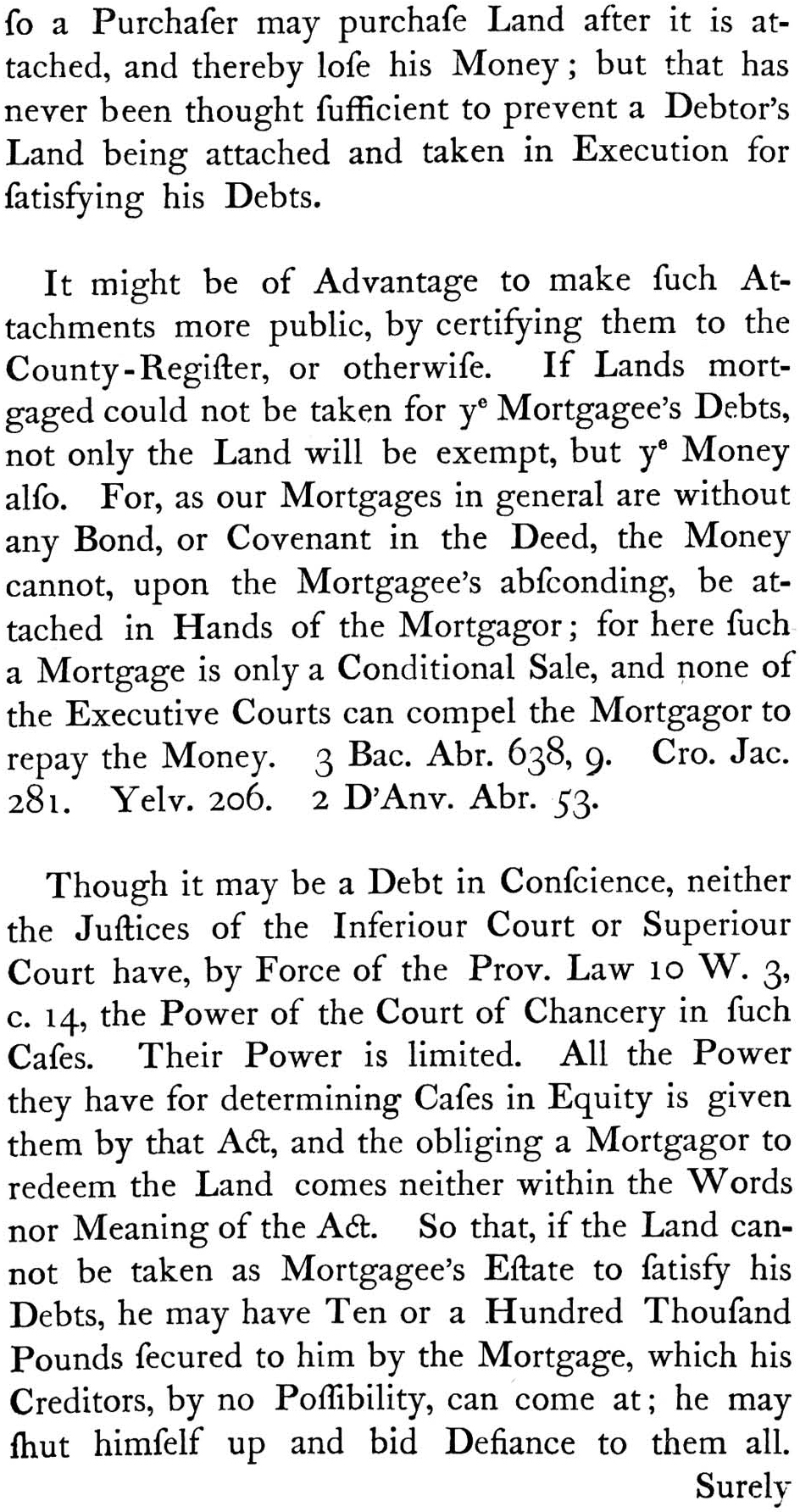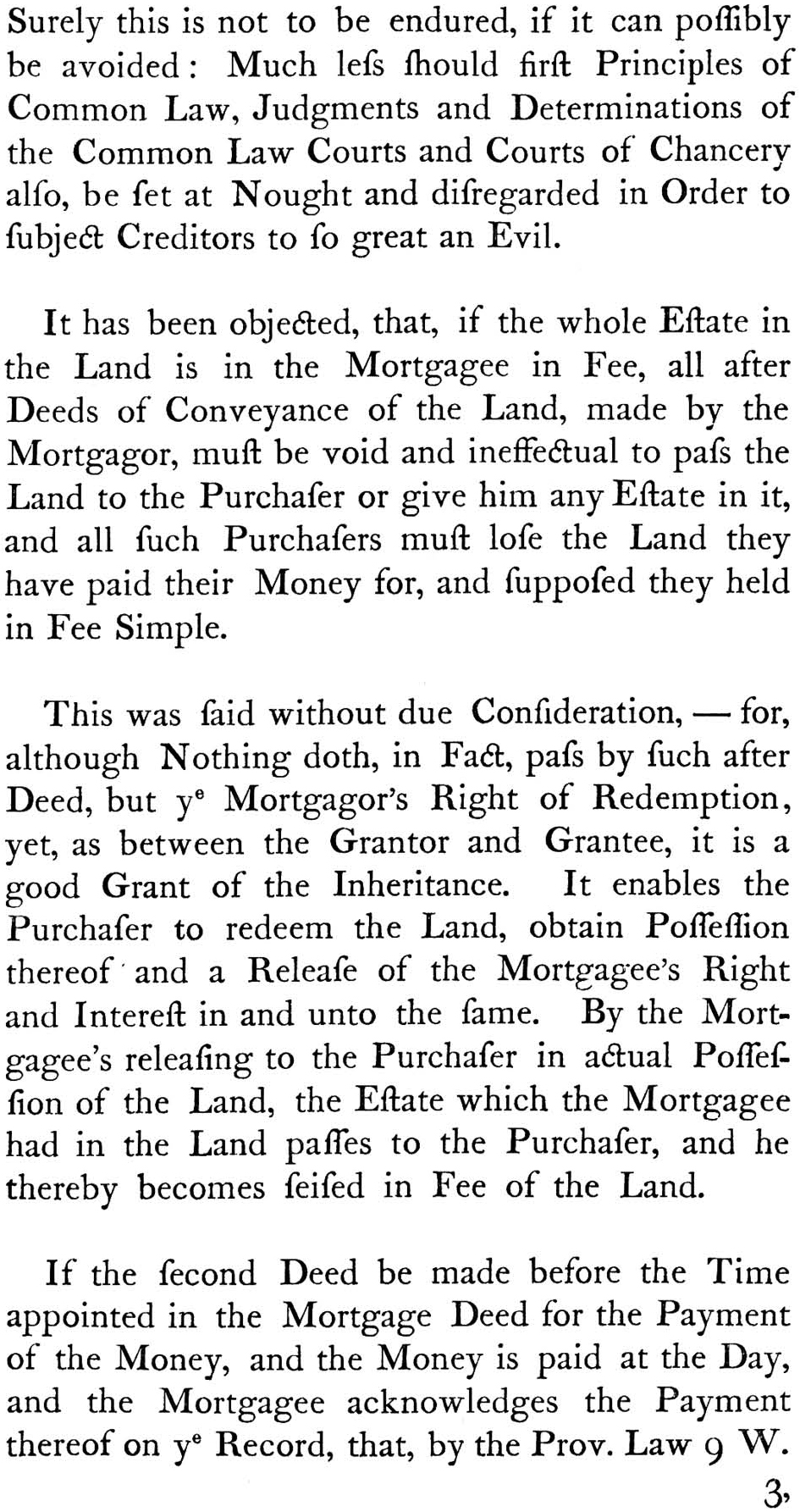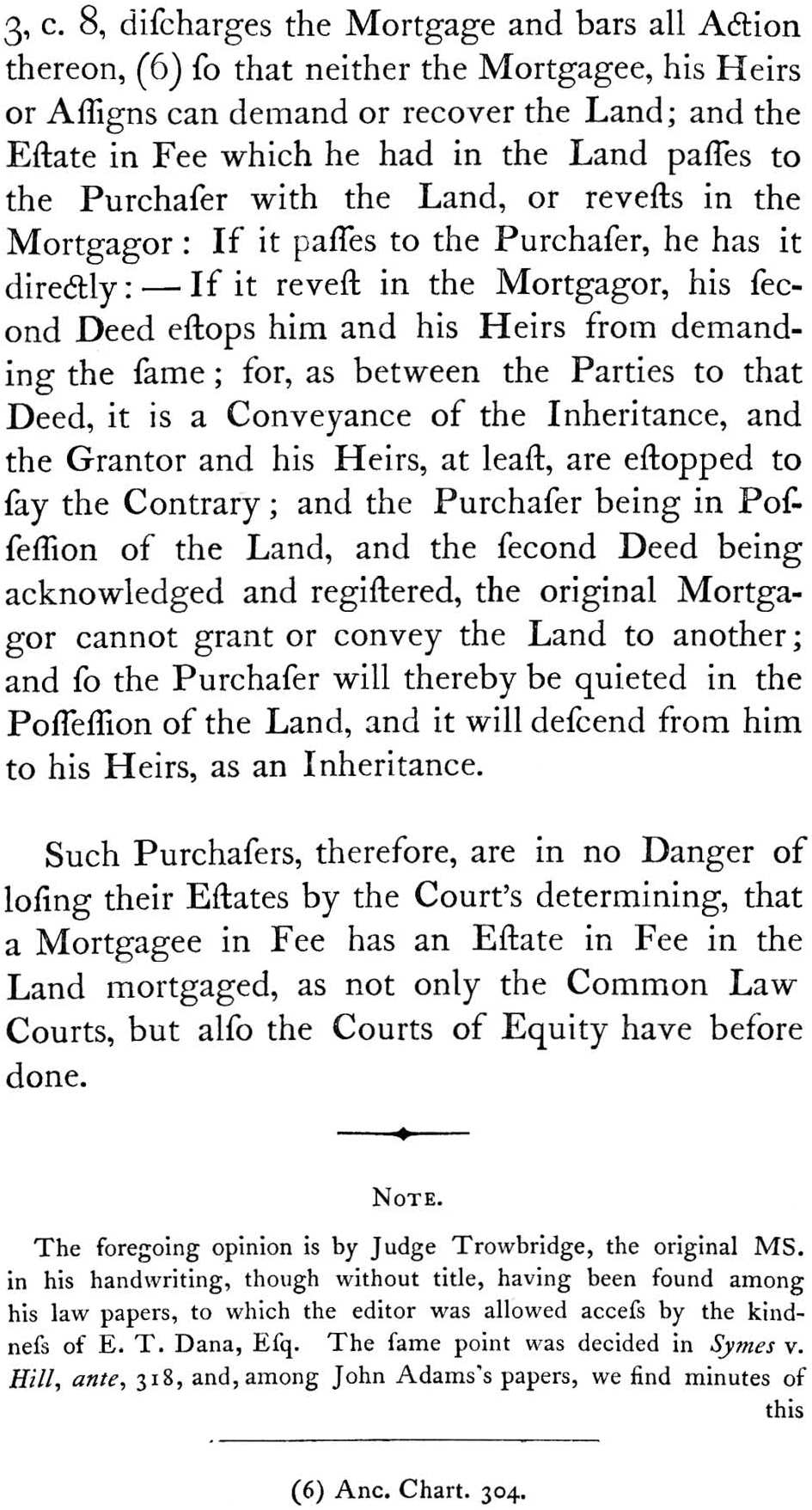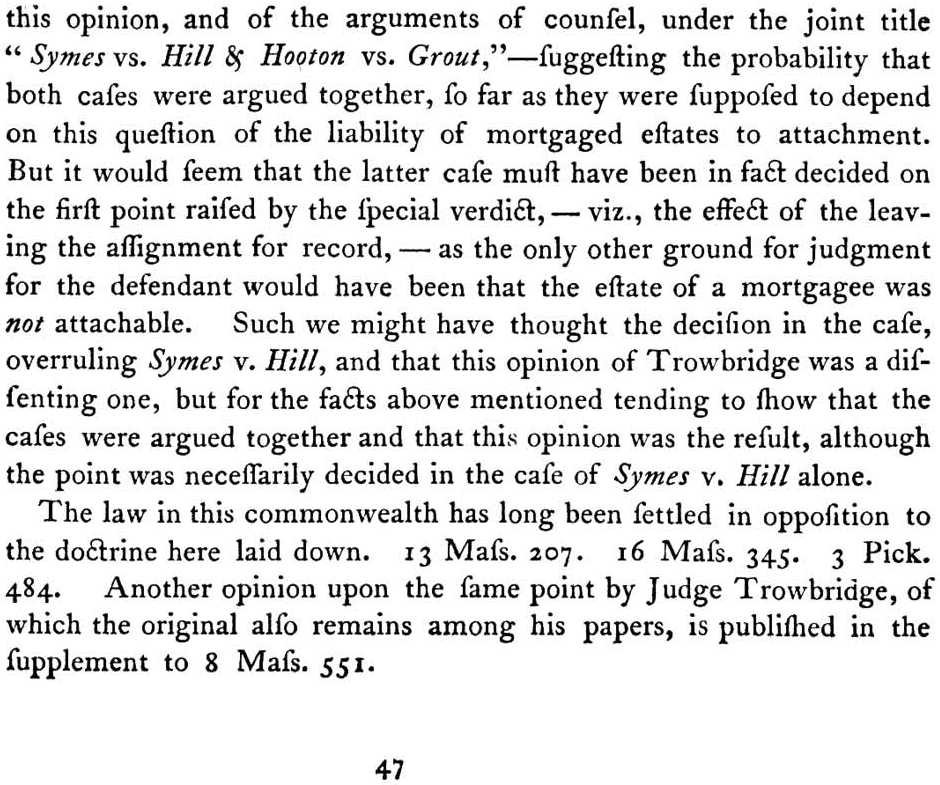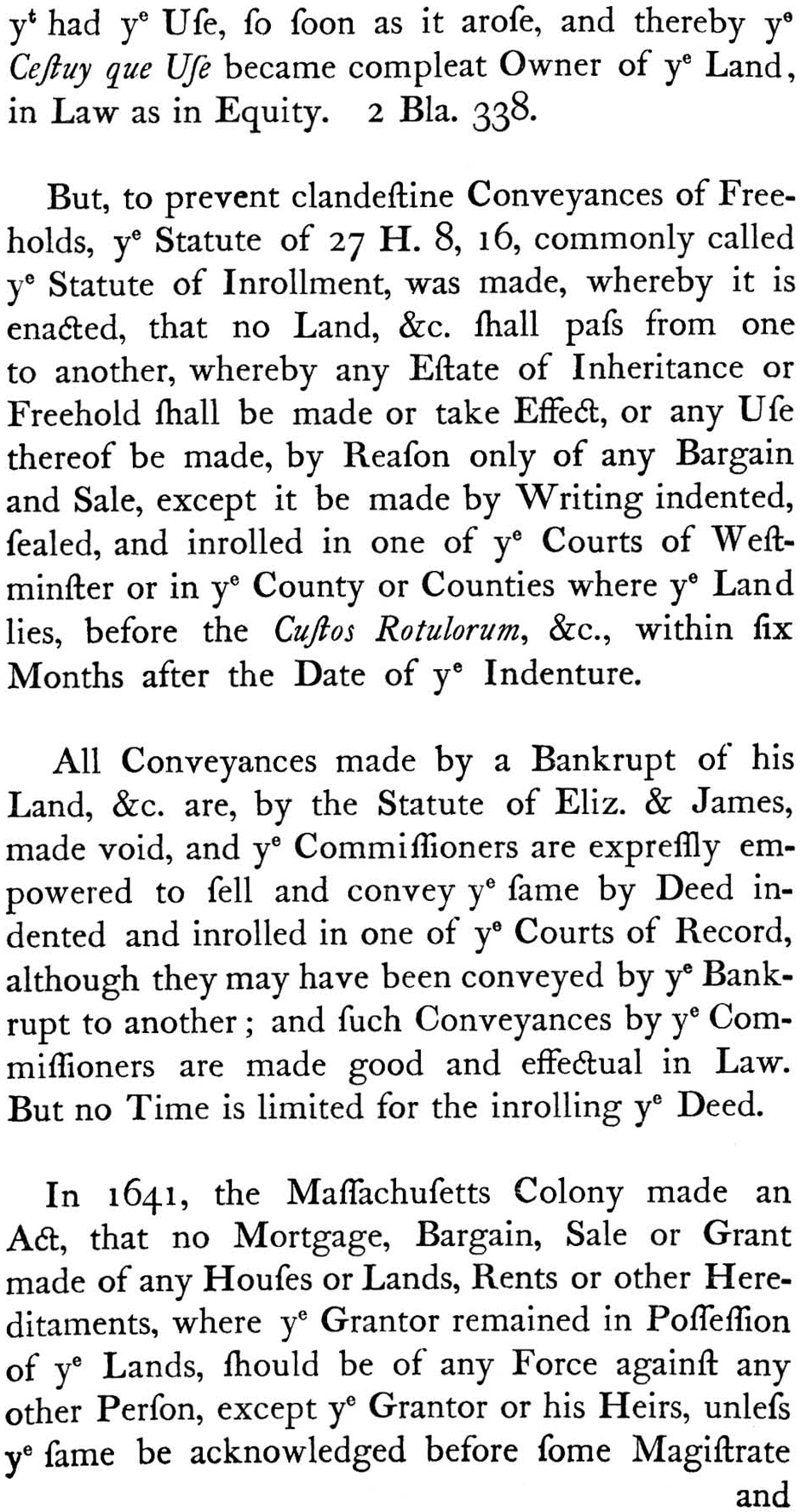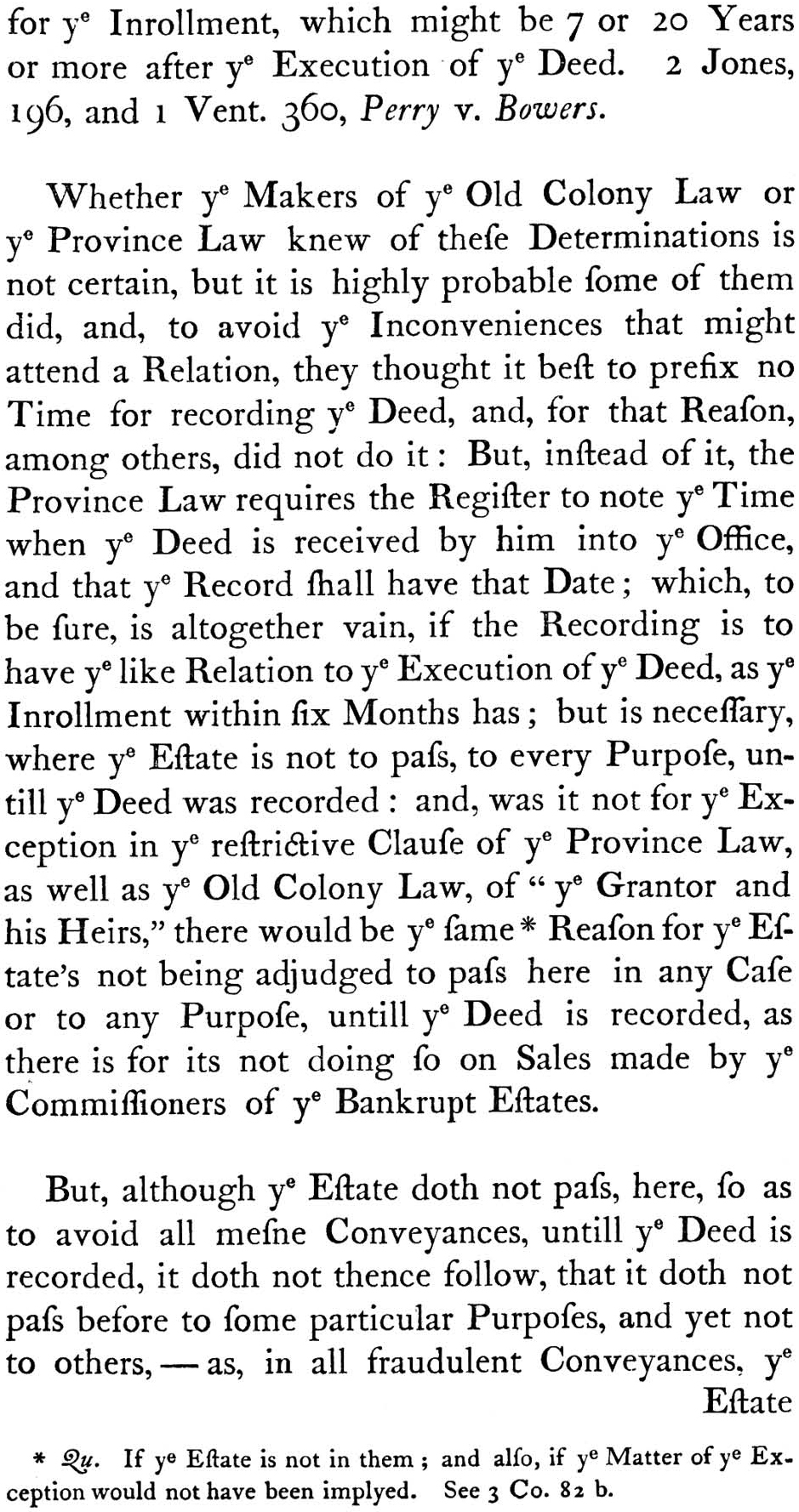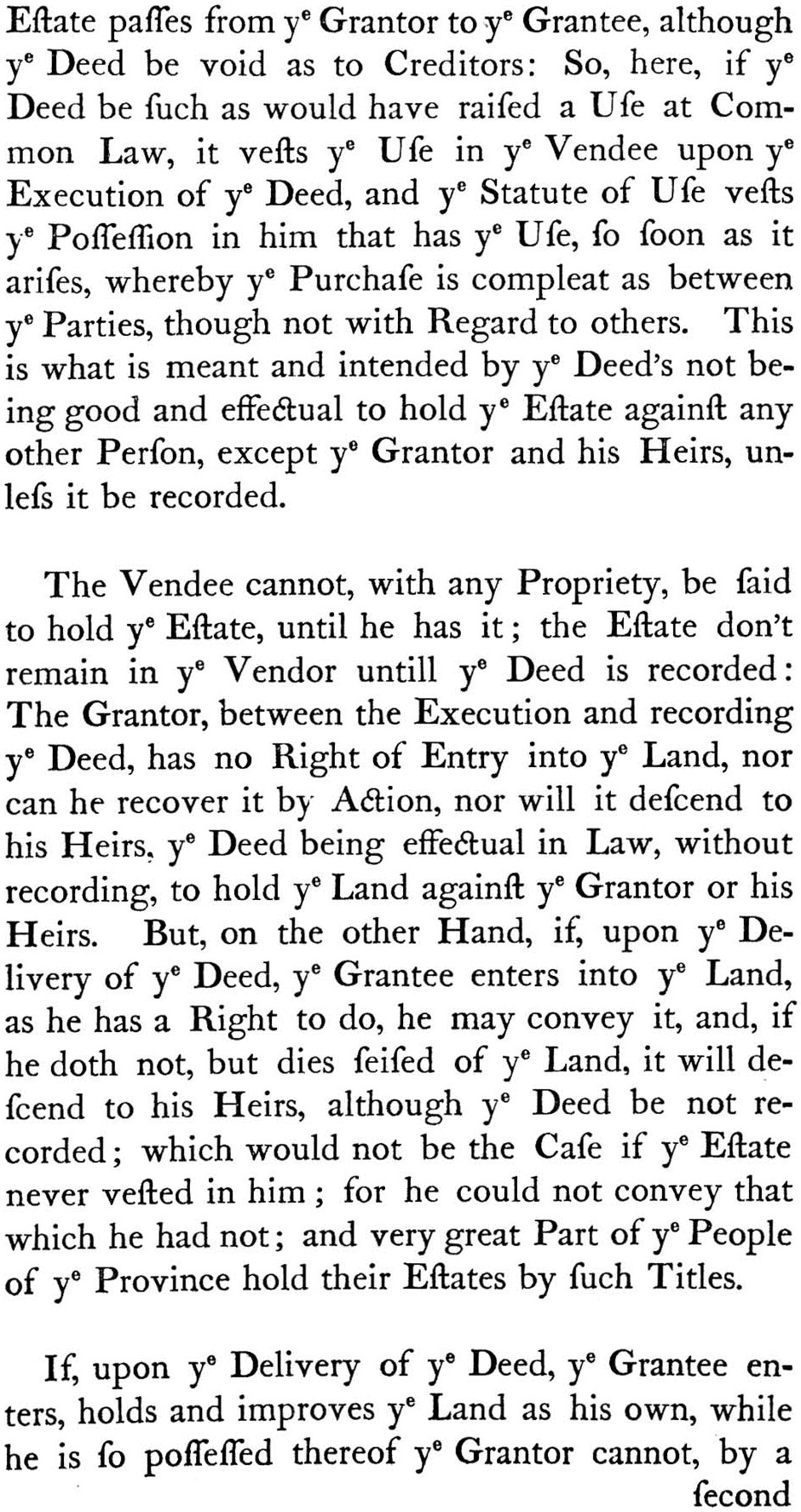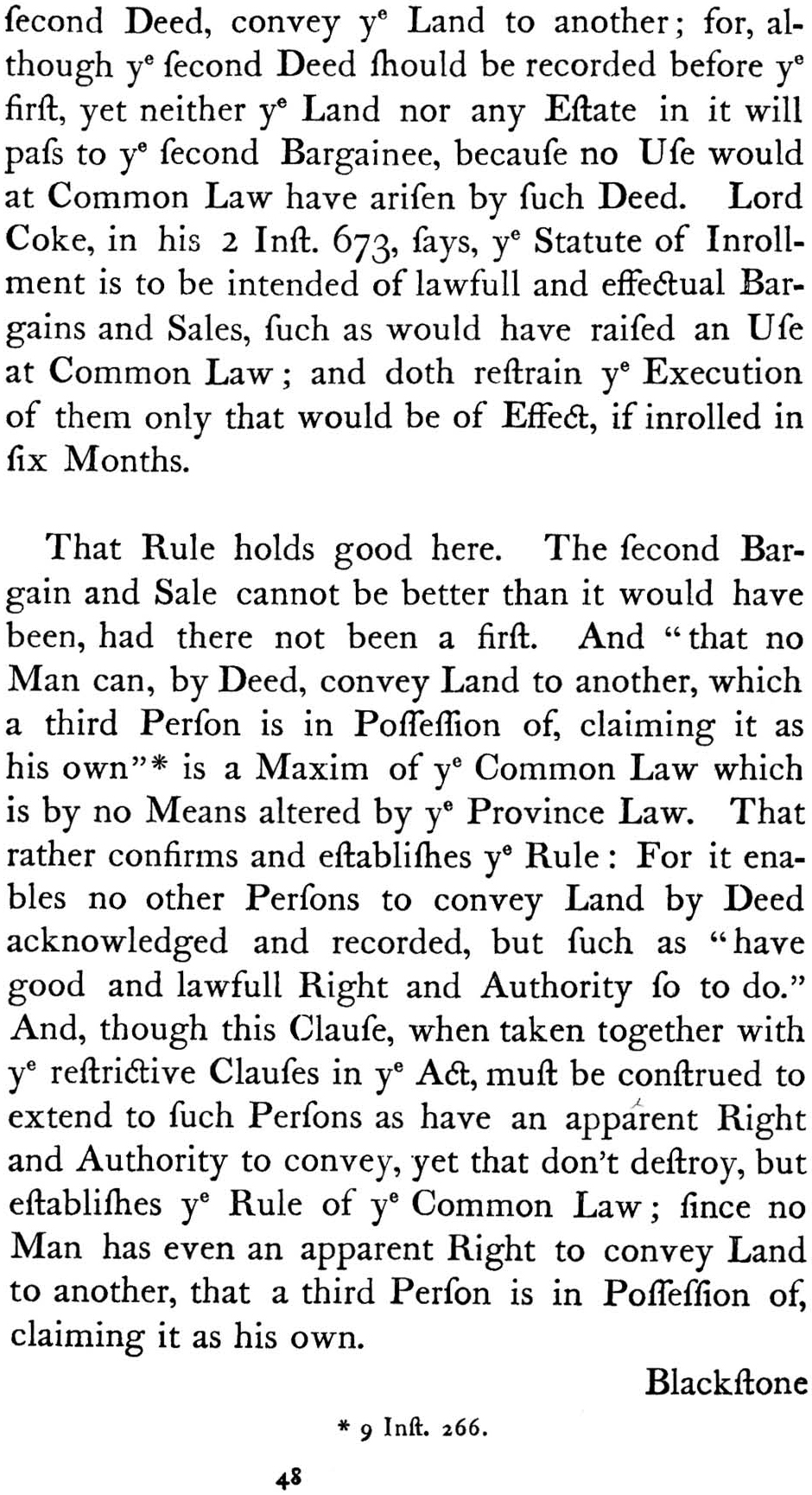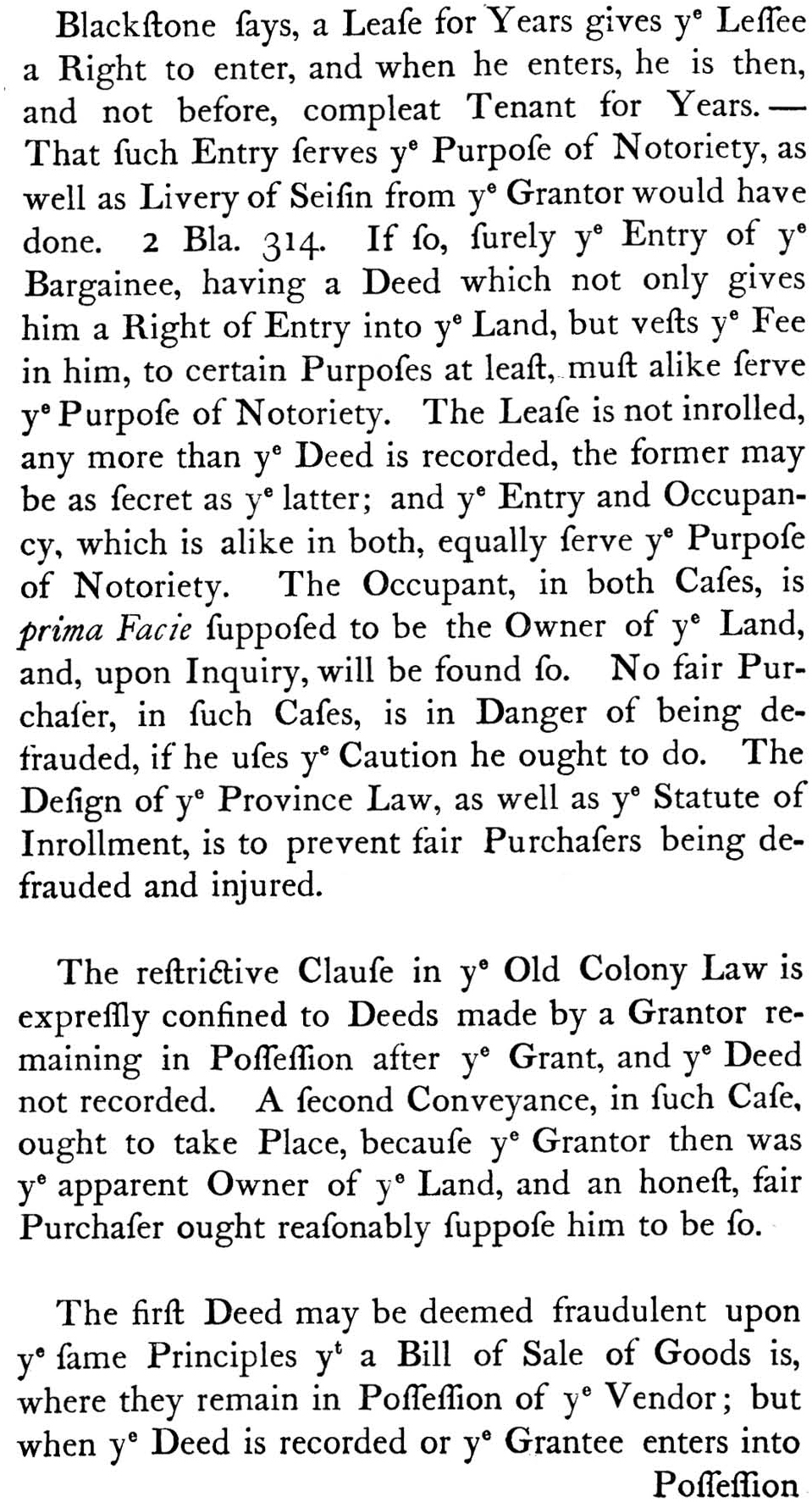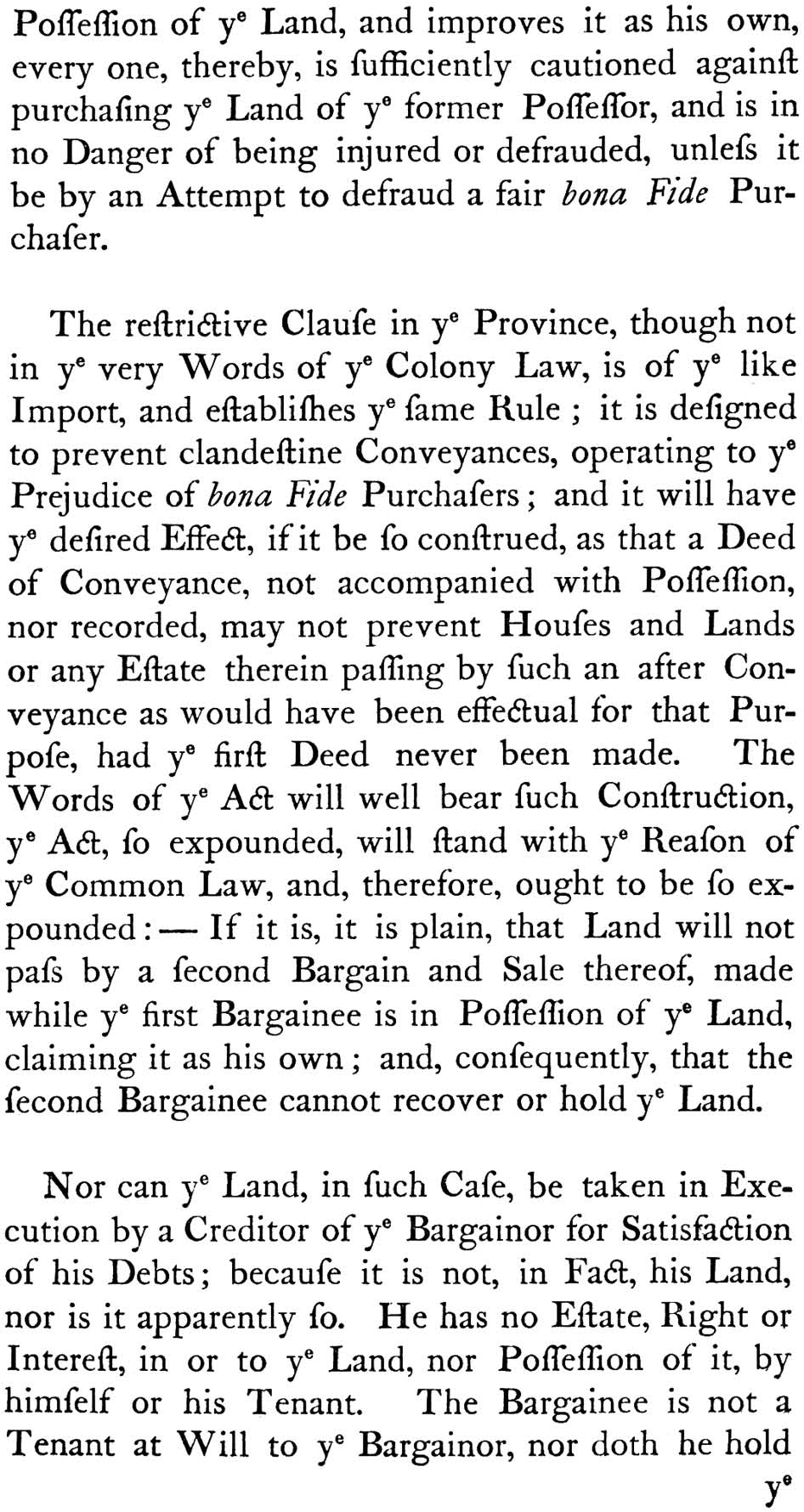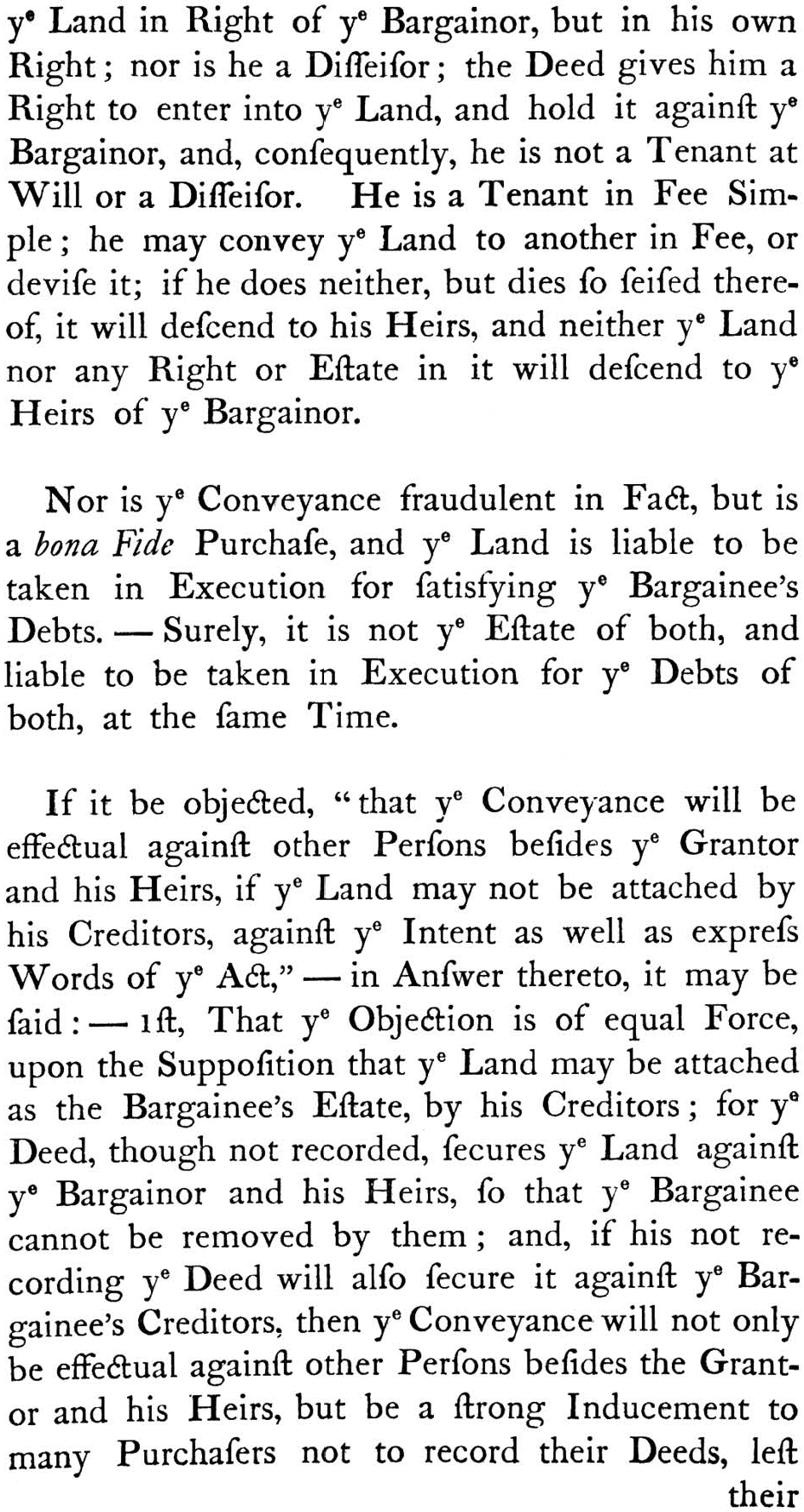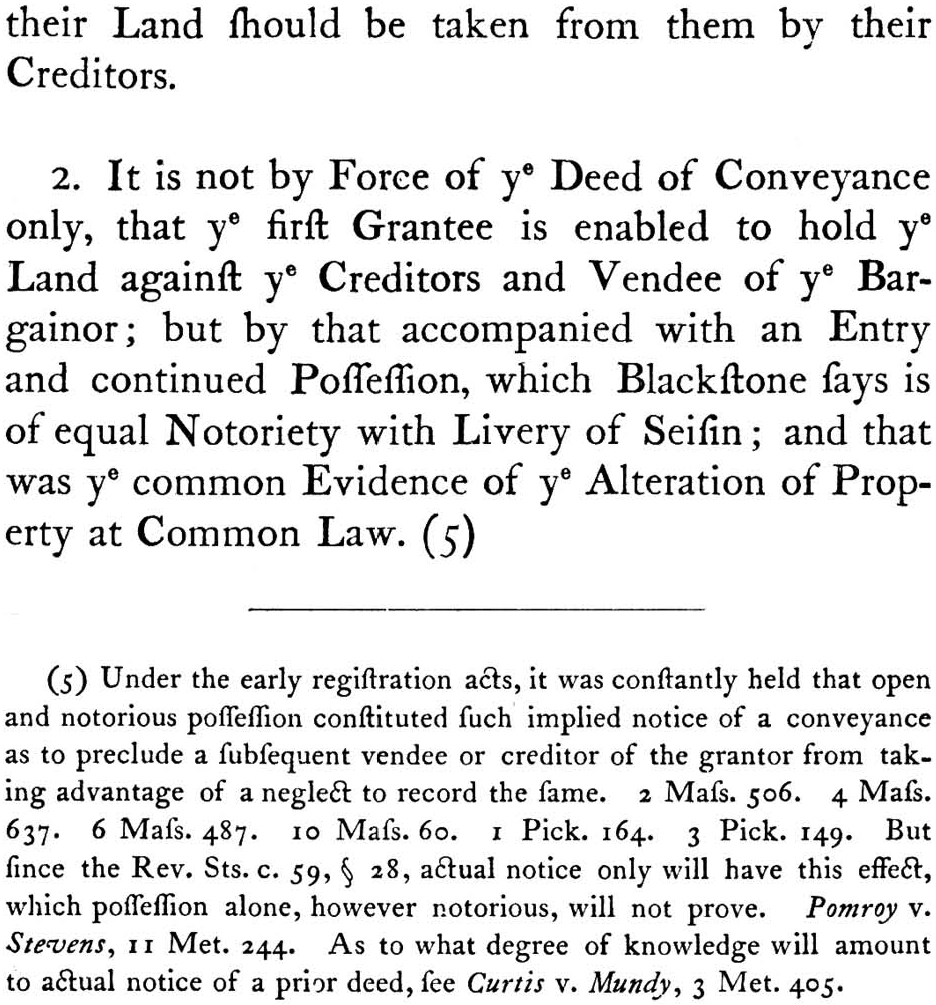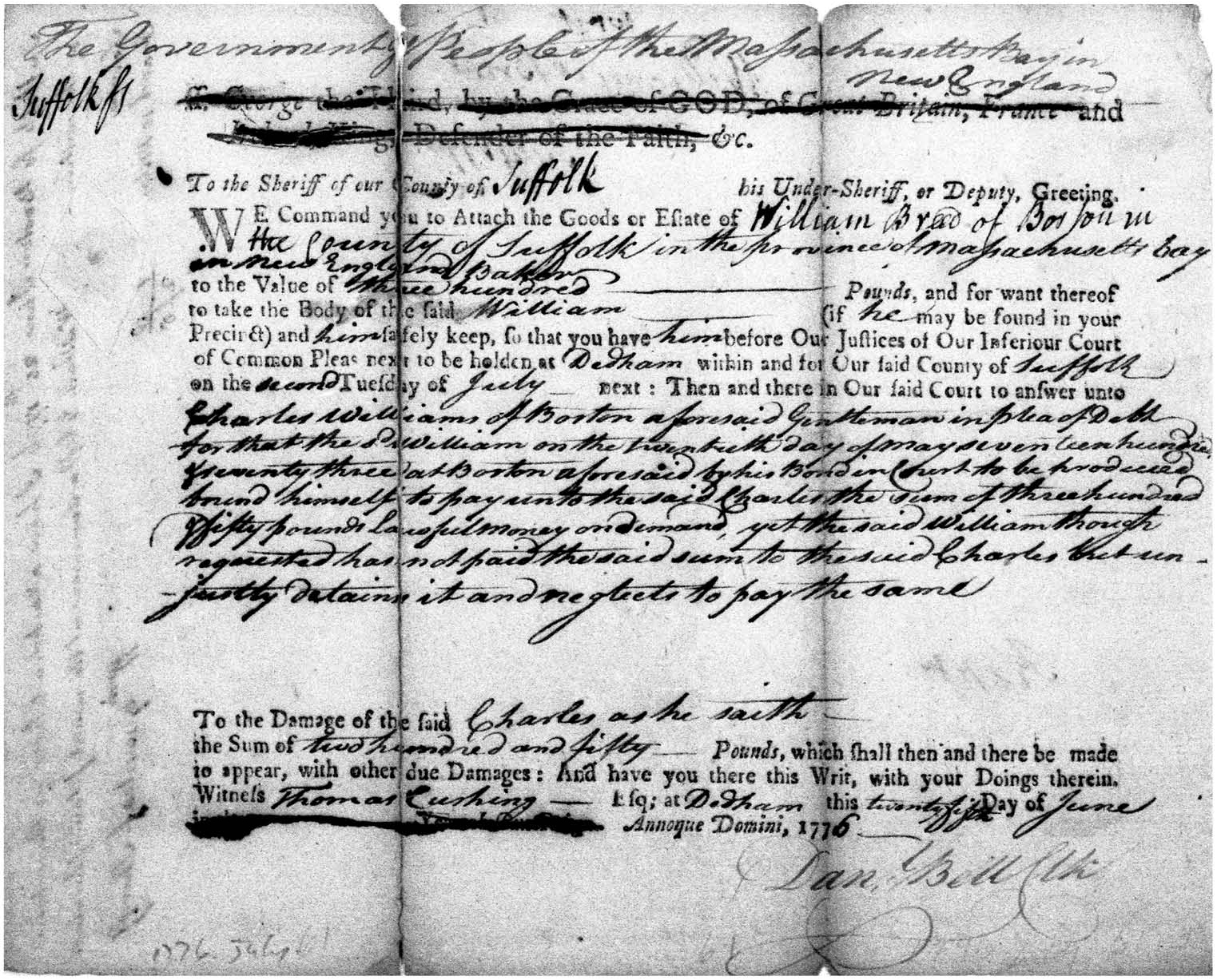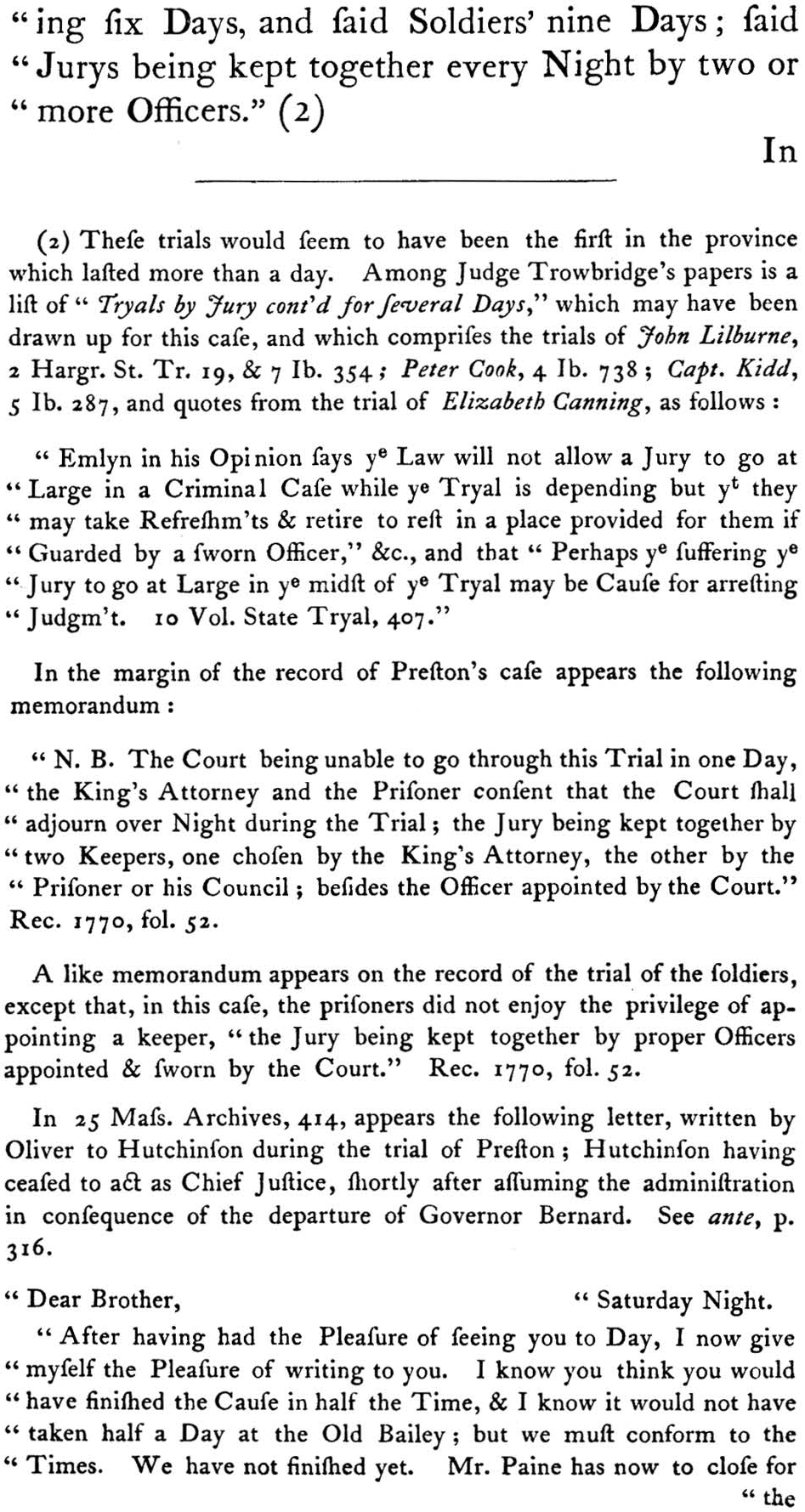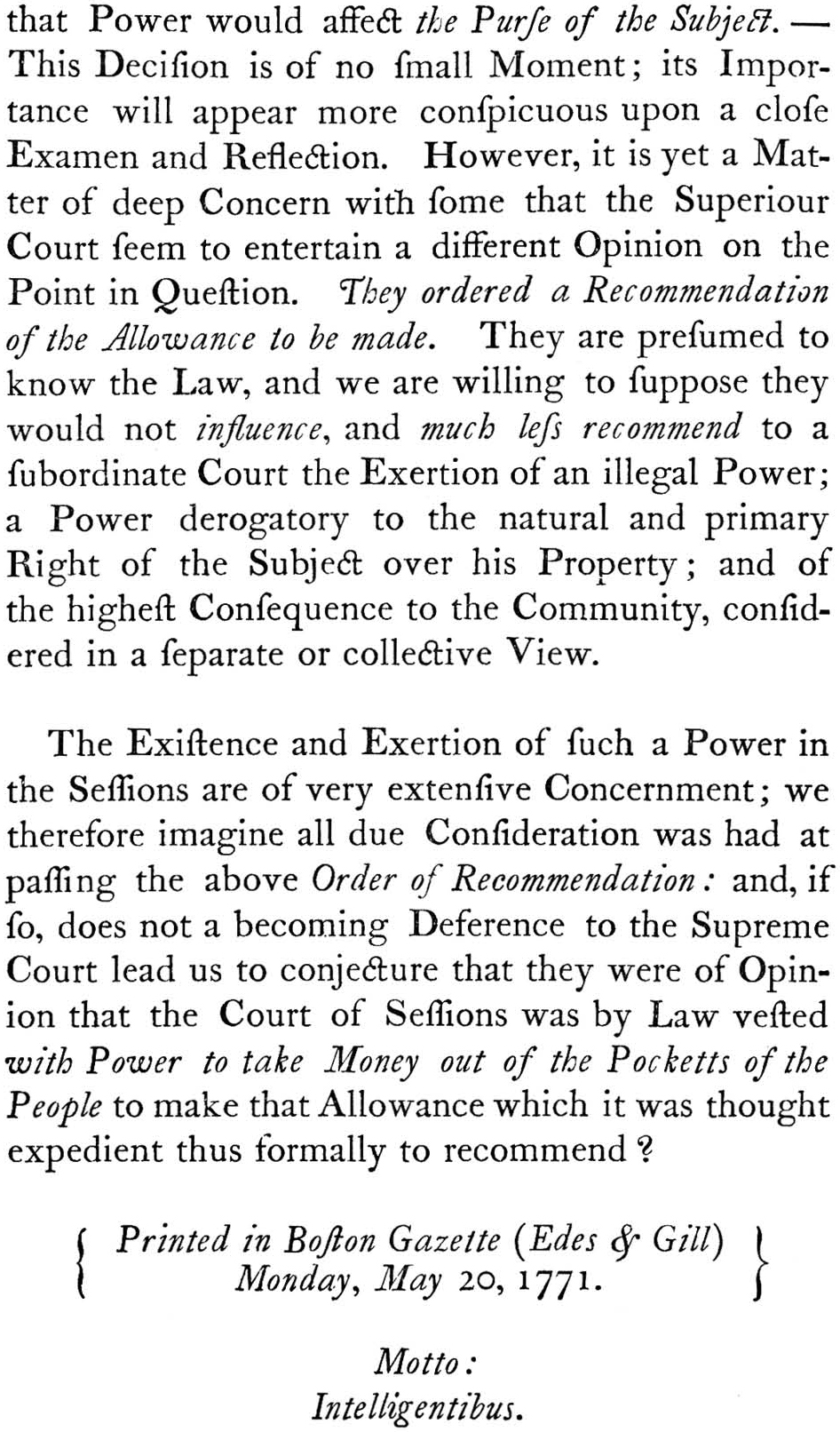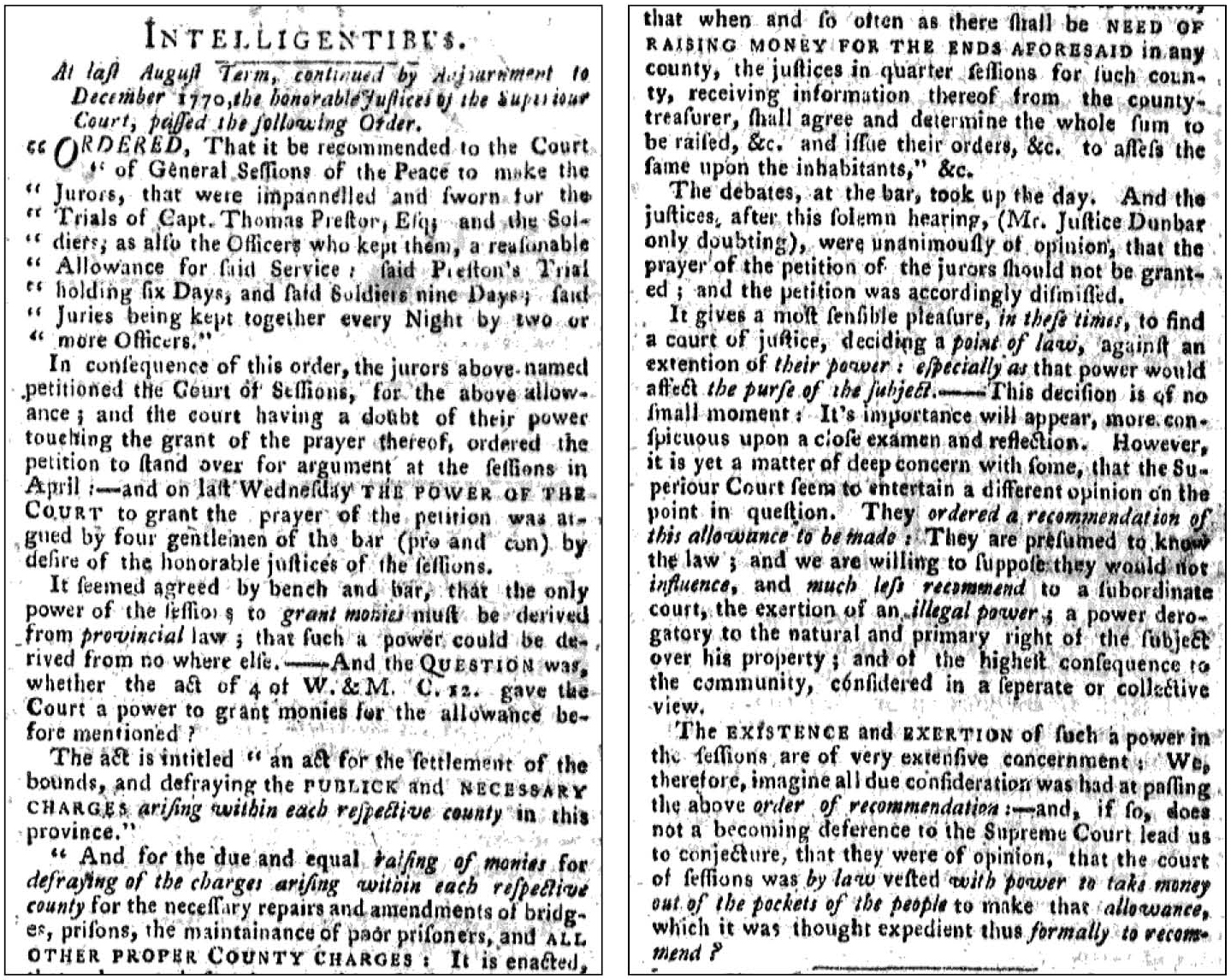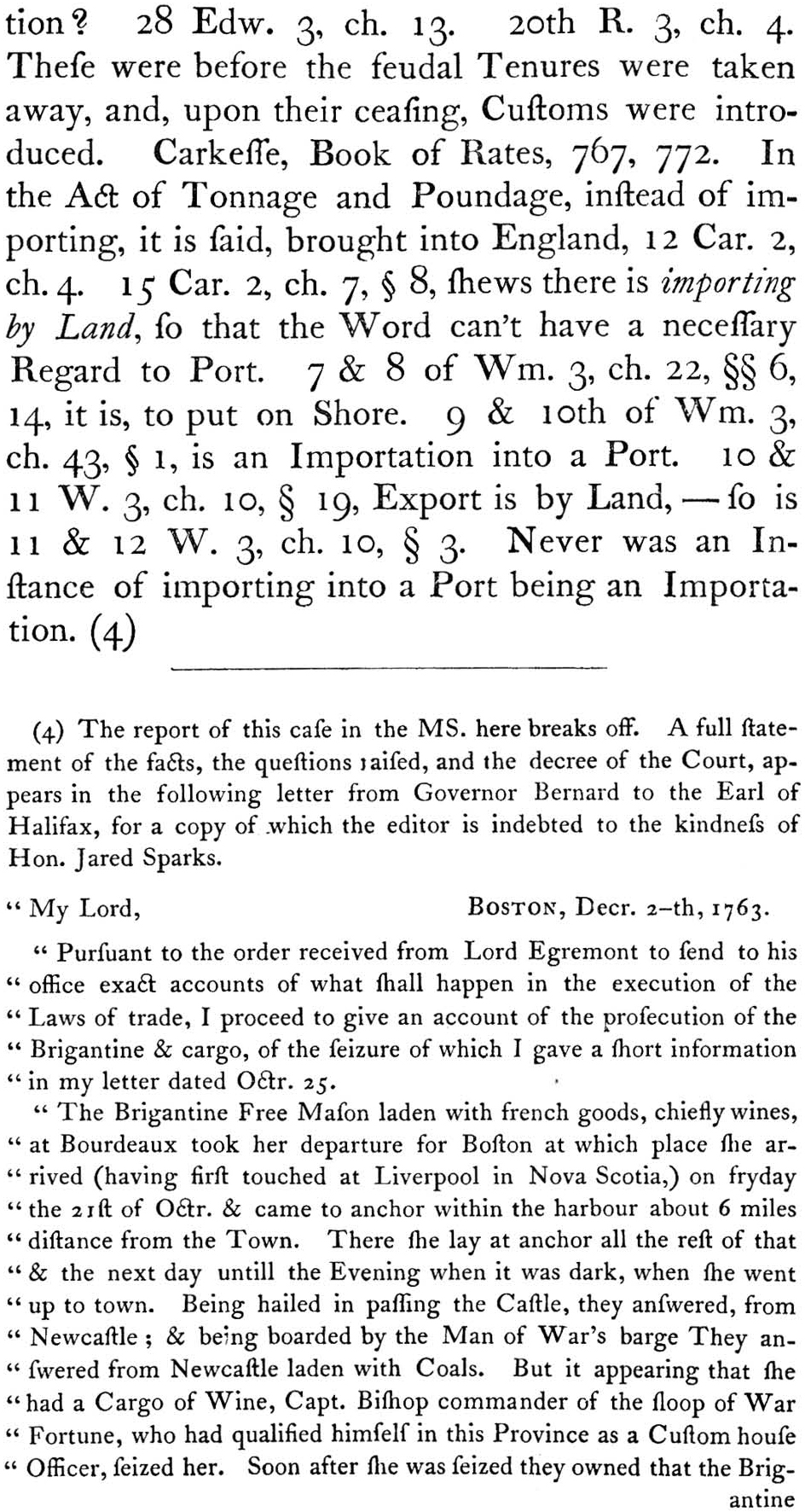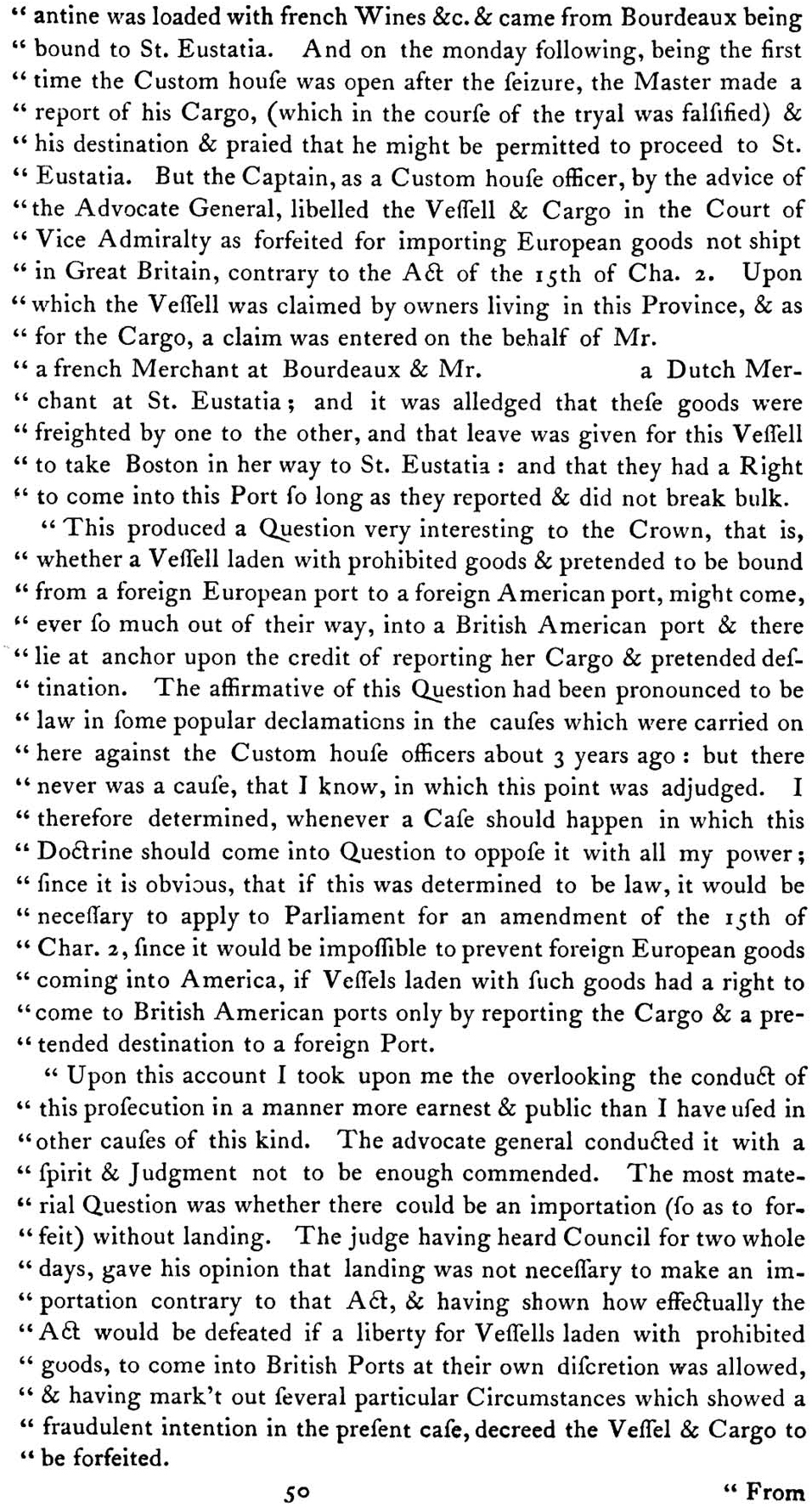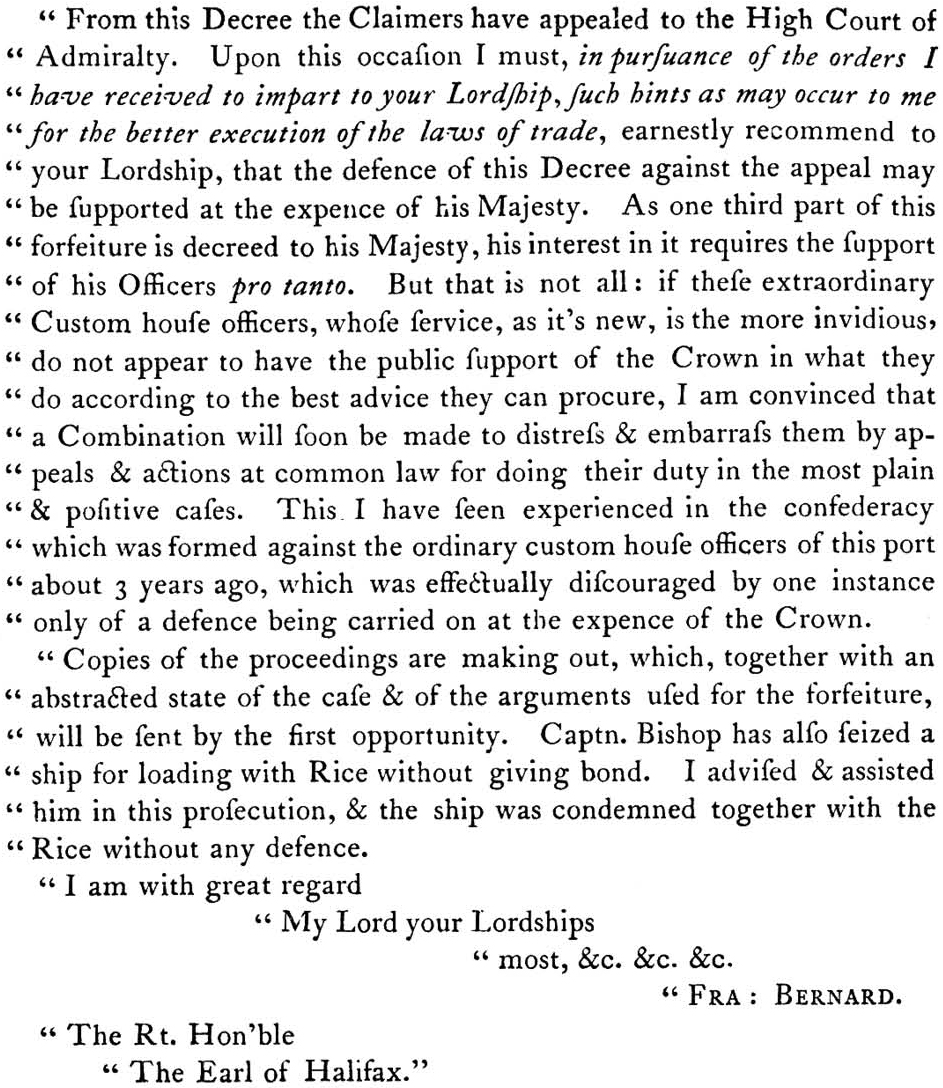THE REPORTS
PART TWO
1765–1772

NOTE: AUGUST 27, 1765
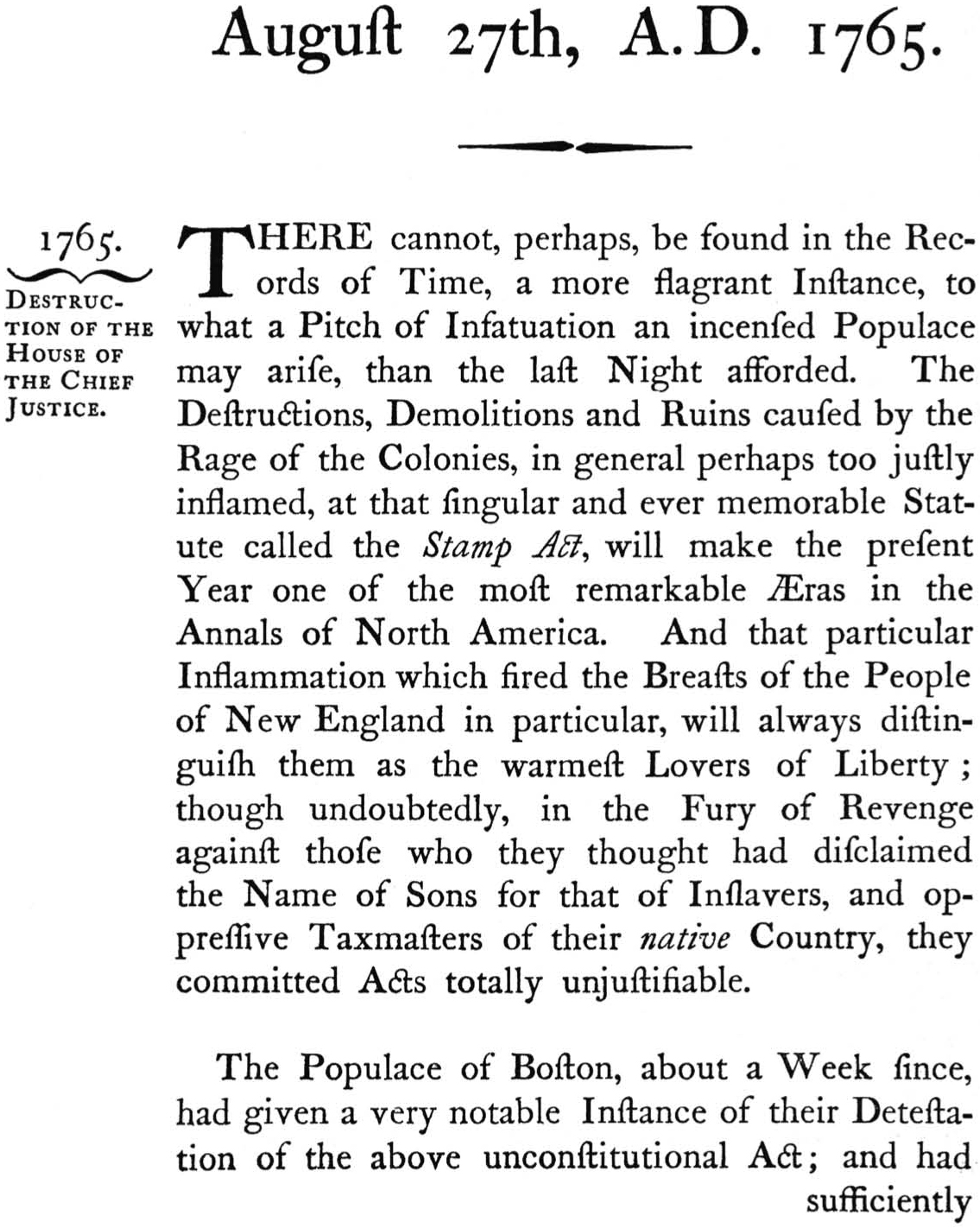
[P. 168]
No passage in Quincy’s writing better illustrated his liberal politics and his belief in a rule of law than his description of these events. Incited by the passage of the 1765 Stamp Act, the Boston mob destroyed Chief Justice Hutchinson’s house. Quincy detested the Stamp Act as “unconstitutional,” but believed that “in the Fury of Revenge against those who they thought had disclaimed the Name of Sons for that of Inslavers, and oppressive Taxmasters of their native Country, they committed Acts totally unjustifiable.” Reports, 168.
The next day, the Chief Justice appeared in Court, with Oliver and Cushing, “[t]here not being a Quorum . . . without me, I am obliged to appear.” Reports, 171. He was in partly borrowed clothes. Quincy reported Hutchinson’s speech with great compassion, including his denial of “in the least promoting or incouraging what is commonly called the STAMP ACT.” Reports, 172. The sole purpose of the Court session was apparently to hear the Chief Justice, as it then promptly adjourned to October 15, 1765.
Quincy noted that Hutchinson was writing a history of the colony, and that “some of the most valuable Records of the Country” were destroyed, “a Loss greatly to be deplored, as it is absolutely irretrievable.” Reports, 170. But his most telling observation was his emphasis of the need for moderation and restraint on both sides. Neither the “Tyranny and Oppression of arbitrary Power” nor the “riotous Tumult, Confusion and Uproar of a democratic [Power]” were the answer. Rather, it was “that Glorious Medium, the BRITISH CONSTITUTION” which must be preserved “inviolate.” Reports, 174. Both Quincy’s Voyage to England and his Political Commonplace struck the same note. Neither the “Fury and Instability of the Populace” nor the “tame and infamous Submission to the Yoke of Slavery” were acceptable. Id., 173–174. Both were “totally unjustifiable.” Reports, 168. Here was the very essence of a liberal faith in the rule of law!
[P. 169]
ILLUSTRATION 2: Initial manuscript page of Quincy’s entry for August 27, 1765, describing the destruction of Chief Justice Hutchinson’s house. Quincy’s Reports, 168–169. Courtesy, Massachusetts Historical Society.
[P. 170]
[P. 171]
[P. 171]
ILLUSTRATION 3: Thomas Hutchinson (1711–80), Chief Justice of the Superior Court of Judicature, 1761–1769, Governor, 1771–1774, by Edward Truman, dated 1741, when the sitter was thirty. Image courtesy Massachusetts Historical Society and the Bridgeman Art Gallery. There is another portrait of Hutchinson at the Massachusetts Historical Society attributed to John Singleton Copley (1738–1813).
[P. 172]
[P. 173]
[P. 174]
ILLUSTRATION 4: Chief Justice Hutchinson’s house in Boston, before it was attacked in the Stamp Act Riots of August 26, 1765. It was originally built by Hutchinson’s grandfather, John Foster, between 1685 and 1692. See Bernard Bailyn, The Ordeal of Thomas Hutchinson (Cambridge, Mass., 1974), 204 (1). From The American Magazine of Useful and Entertaining Knowledge, 2 (February 1836).
CHARGE NO. 2
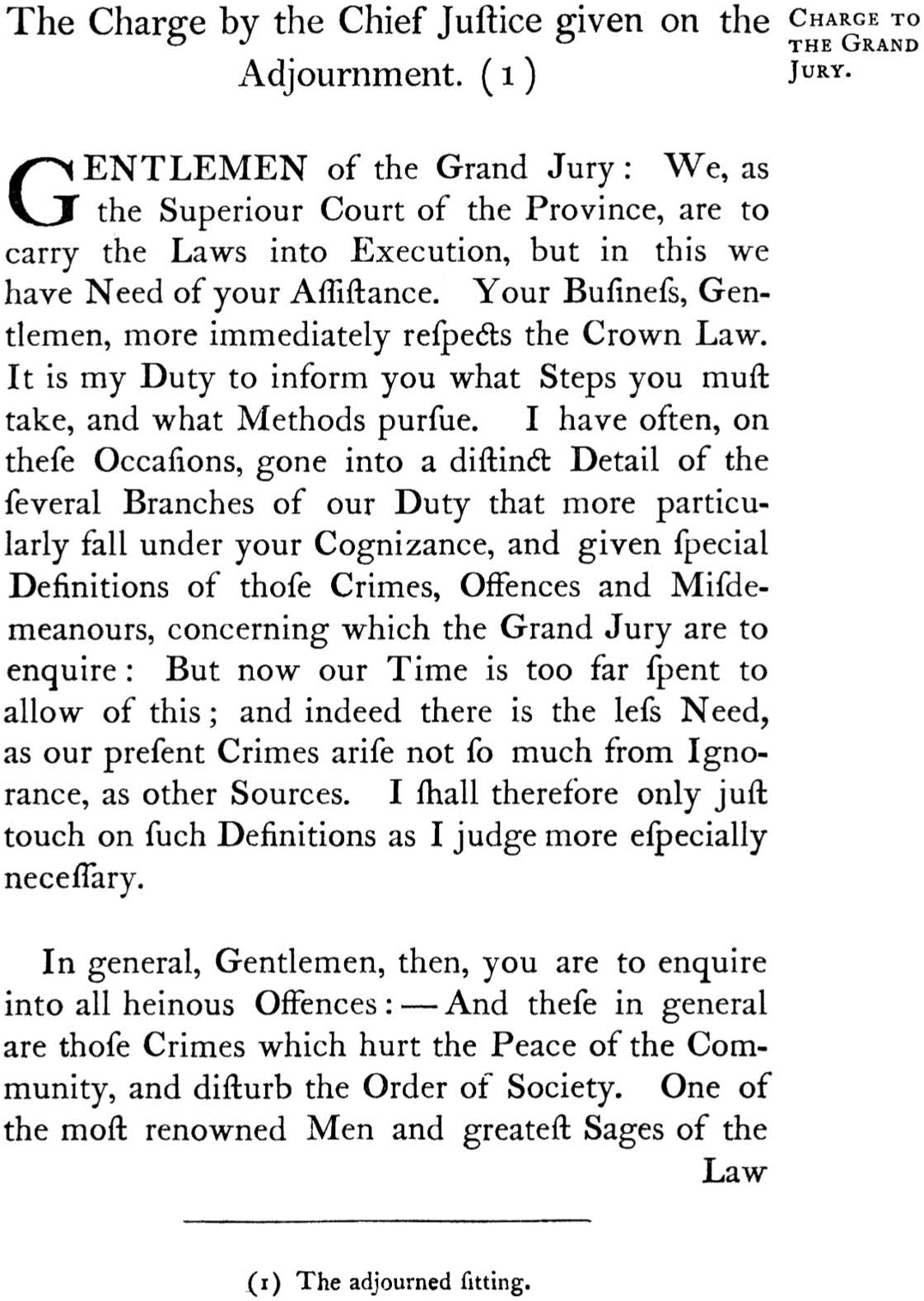
[P. 175]
Charge to The Suffolk Grand Jury by Chief Justice Hutchinson
1765-August Term
note
This charge has to be seen against the backdrop of the 1765 Stamp Act violence, including the burning of Hutchinson’s house. See Reports, 169–171. Unlike the March 1765 Term Charge, Reports, 110, Charge 1, supra, treason is emphasized. “[Y]ou are not to think there can be no Treasons at this Distance from the Throne.” Reports, 176. Burglary and riot are also mentioned, again offenses suffered directly by Hutchinson on the terrible August night of the Stamp Act riot. Indeed, Hutchinson emphasized that Burglary need not be a solitary breaking into a house in the nighttime, but “it may be as well done when a Great number are present. . . .” Reports, 177. But Hutchinson also emphasized the Grand Jury’s role as a protector of the innocent. “The Life of a Man shall not be endangered unless twelve Men of a Grand Jury (majority of twenty three) shall say, he shall be put on Trial and twelve more of his Peers shall all agree that he is guilty (unanimous vote).” Hutchinson also emphasized that the Attorney General’s power to proceed on Information, rather than Indictments, should be exercised with great care, and he doubted whether “a Man shall be tried for Life on an Information.” Reports, 178. (Quincy, citing the statute 5 George I, Ch. 4, rightly disagreed.) Finally, Hutchinson repeated his earlier emphasis on the power of the Grand Jury to act “within your own knowledge,” as well as an offence “brought before you by the Attorney General, or others . . . ,” Reports, 178, as well as the vital need for secrecy, “[t]he Danger of revealing what may come before you at this Time is very obvious. . . .” Reports, 179.
The Stamp Act was enacted by the British Parliament to raise revenue in the colonies to pay for the expenses related to the French and Indian War (1763–1764). It was passed in the House of Commons on February 27, 1765, in the House of Lords on March 8, 1765, and became effective on November 1, 1765. Sir George Greenville was the primary sponsor of the Act, citing that it would allow them to meet at least half of the costs from the War. The colonists called for equal rights and refused to be taxed without having representation. They protested through riots, stamp burning, and harassment of the colonial stamp distributors. The Act was repealed on March 18, 1766. Greenville wanted to use the army to enforce the Act, while Pitt took the opposing view, voting to repeal.
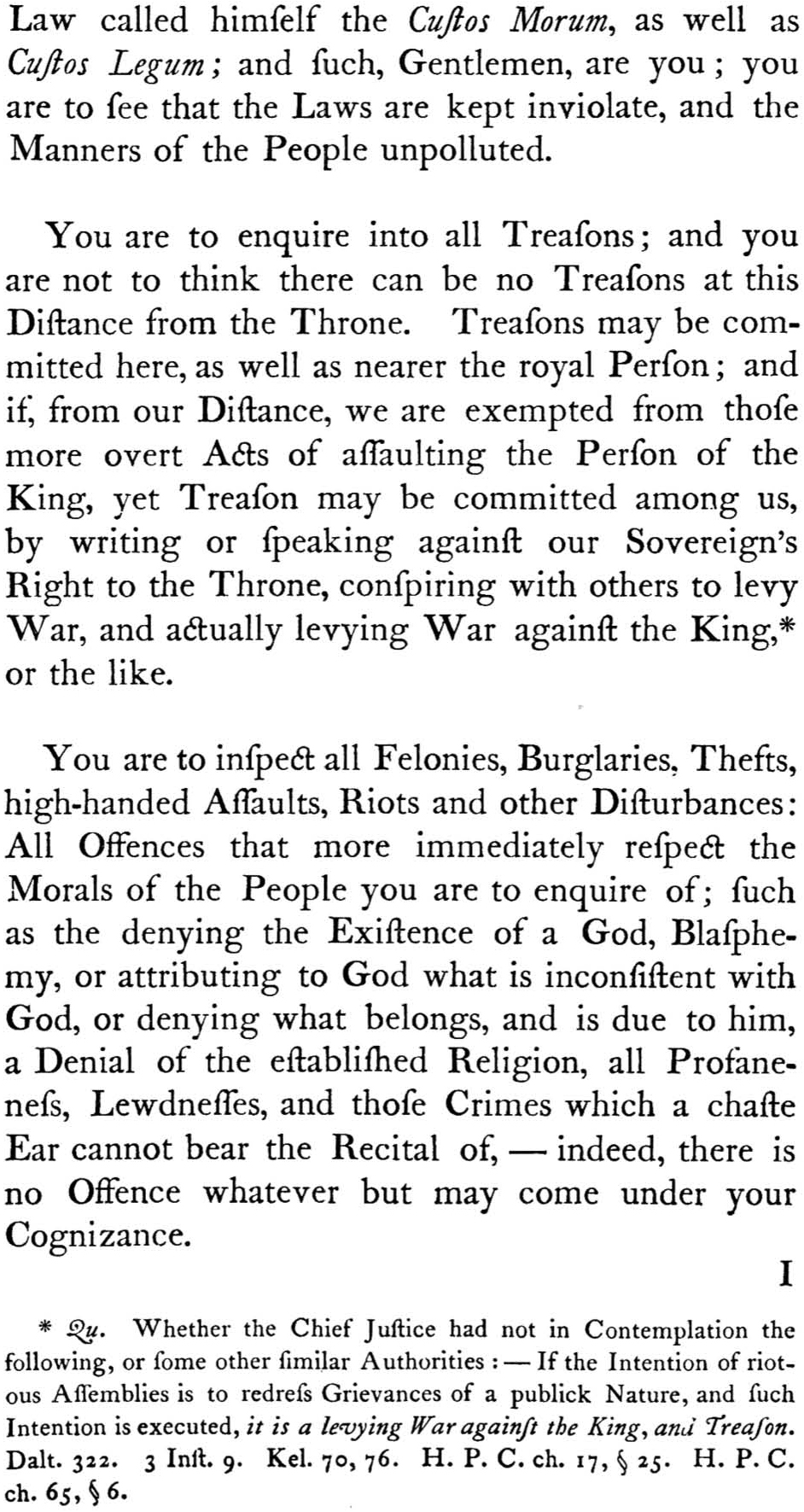
[P. 176]
There was considerable puzzlement among British politicians and the British public about why things went so awry. The tax was aimed at commercial and luxury goods, such as legal papers, cards, dice, and newspapers, and was similar to taxes long in use in England. The Boston Gazette of January 27, 1766, reprinted comments “from a late London Paper” arguing:
“The occasion of the riotous behaviour of the Bostonites is peculiarly remarkable: Had the Parliament taxed their small beer an half penny a quart, the tax would then have been most severely felt; they would naturally murmured; and an improper conduct on such an occasion had been less a matter of surprise; and perhaps ought left so have roused the Indignation of government: But in the present case, the tax led to be levied affects none of the necessaries of life; will never fall upon the poor; and will touch very gently and very seldom such of them will light upon:”
There was even some support in Boston. “Must we not determine ourselves under infinite Obligations to Great Britain, for the Aid and Assistance she so kindly afforded to these Colonies when surrounded by their French and Indian Enemies?” argued “Judaeus Appella” in the December 9, 1765, Boston Gazette. See David A. Copeland, Debating the Issues in Colonial Newspapers (Greenwood Press, Connecticut, 2000), 202–203. See also Opposing Viewpoints in American History (B. Leone, ed.) (San Diego, 1996), vol. 1, 77–92.
The speed of the repeal is another historical puzzle. Protests of merchants and traders in England certainly played a part, as did the fact that Greenville’s ministry had collapsed in May 1764. Greenville himself was unpopular with the King. The new ministry, led by Lord Rockingham, was believed more sympathetic, and Quincy’s later Voyage to London was in part to gain favor with the “New Whigs,” plus other perceived allies, such as Pitt and Edmund Burke. See Quincy Papers, vol. 1, 219–269. Benjamin Franklin’s testimony to the House of Commons was also important and “dispelled many popular illusions regarding the colonies, as for instance their fabulous wealth, and gave convincing proof of their determination to resist the act to the bitter end.” See Helen H. Hodge, “The Repeal of the Stamp Act,” 19 Political Science Quarterly (June 1904), 255.
The repeal of the Act led, of course, to assertion of Parliamentary authority to tax the colonies in the Declaration Act, passed the same day, and eventually to other taxes under Townsend’s ministry as Chancellor of the Exchequer. Quincy’s views were graphically recorded in his personal copy of volume 1 of Blackstone’s Commentaries (3d ed., Oxford, 1978) where, as Horace Gray Jr. observed, there are “marginal notes in his [Quincy’s] handwriting, in which “Qu.” is written opposite every assertion of the power of Parliament to legislate for Ireland or the Colonies.” Reports, Appendix I, 520, no. 22. See William Blackstone, Commentaries on the Laws of England (3d ed., Oxford, 1768) vol. 1, 103–108. See also Reports, Appendix I, 526–527, note 26. I am indebted to Patricia Tarabelsi for assistance with this note.
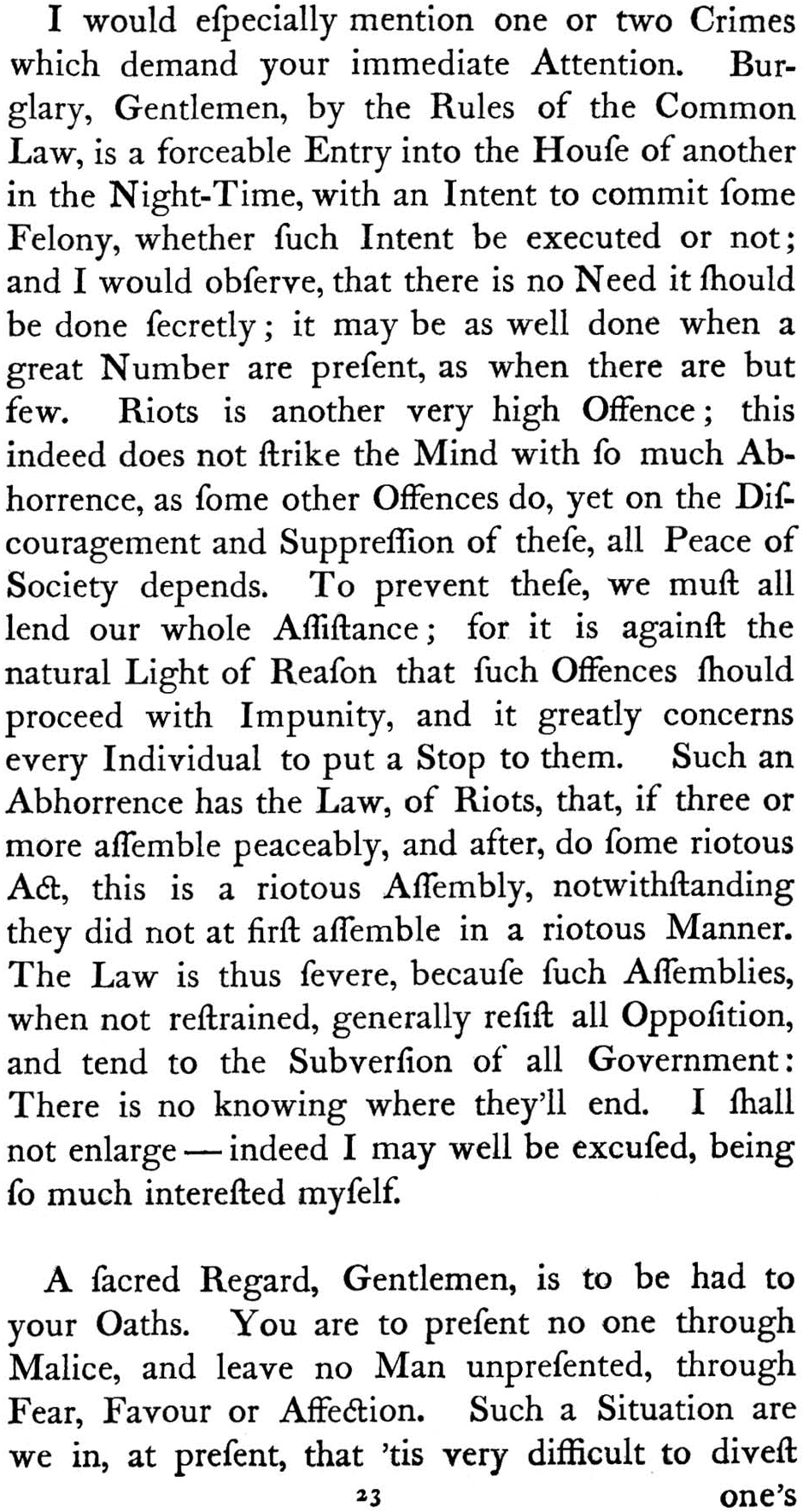
[P. 177]
[P. 178]
[P. 179]
CASE 46
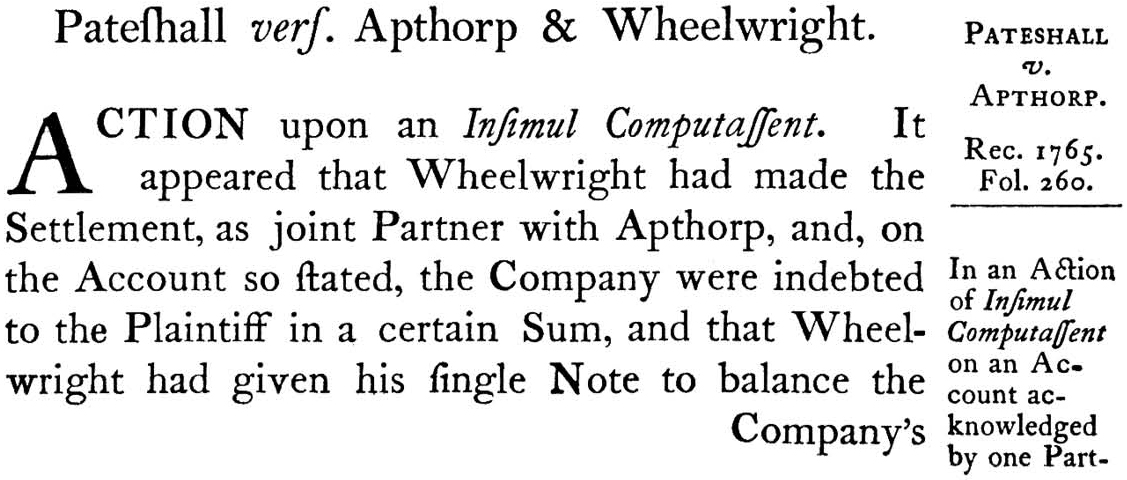
[P. 179]
Pateshall v. Apthorp & Wheelwright (1765)
5 George III (Aug.) in the Superior Court of Judicature
1 · brief description
This was a writ of action of account, or insimul computassent (“he accounted together” which lay at common law for recovery of a sum “found owing” between merchants. See Earl Jowitt, supra, 979. Pateshall had accepted a note from Wheelwright, a partner of a Company with Apthorp, to settle the Company’s account with Pateshall. The note was not paid, since Wheelwright had failed in a spectacular personal bankruptcy. Did the acceptance of Wheelwright’s note discharge Apthorp and the Company? Held, as a preliminary matter, that Apthorp could testify to the jury that-in this particular transaction-he had nothing to do with Wheelwright’s note. After a Jury verdict for Pateshall, the Court, in a 2 to 1 decision, held that the note did not discharge the Company. Appeal granted to Privy Council.
2 · court records
Available at Rec. 1765, fol. 260.
3 · professionals involved
For the original Plaintiff, Pateshall, appeared Robert Auchmuty (1723–1788). For the original Defendants, Apthorp & Wheelwright, appeared Samuel Fitch (1724–1799) and Jeremy Gridley (1701/02–1767). Both Auchmuty and Fitch were admiralty and commercial law specialists. Auchmuty became Judge of the Vice Admiralty Court (1767–1776), and Fitch was Advocate General of the Admiralty pro tempore (1768–1770) and then Advocate General of the Admiralty (1770–1776). Both were proscribed in 1778. See brief biographies in Appendix 6, infra.
4 · authority
This case is fascinating because of the debate about “the Custom of England” and the difference between that and “the Common Law.” There was also a heavy reliance on explicit policy arguments. Fitch and Gridley relied on a popular English authority, Pinkney v. Hall (1696), 1 Salkeld’s Reports 126 (London, 1717). See Law Commonplace, [32], n. 7. This held that a partner could not bind another if the matter did not concern the other partner. Reports, 180. Auchmuty objected: “Their Authority is not in Point, for it is founded upon the Custom of England.” Gridley replied “No: the Common Law.” Reports, 181.
[P. 180]
The “incorporation” of mercantile customs into common law was a particular feature of the eighteenth-century English common law courts, particularly under the leadership of Sir William Murray, Lord Mansfield, Chief Justice of the King’s Bench from 1756–1788. See D. R. Coquillette, “Legal Ideology and Incorporation IV: The Nature of Civilian Influence on Modern Anglo-American Law,” 67 Boston Univ. L. Rev. 887, 934–970 (1987). Gridley argued that if the authority were “only a particular custom,” it could be countered by policy arguments, i.e., “[i]f it is once known that a Man may thus slip his Neck out of the collar, who will have Anything to do with Partners?” Reports, 181. While arguing that they were supported by English law, Gridley and Fitch also made policy arguments “can it be imagined that one Person has a Power by his Notes, his Bills, his Bonds, at his Caprice to charge his Partner? If this is Law, an End of Partnerships.” Reports, 181.
Quincy, in a note, cited extensive English authority from Pinnel’s Case (1602) 2 Coke’s Reports 117a, 117b, to Lord Mansfield’s decision in Roades v. Barnes (1756), 4 Burrow’s Reports 9. See Sweet & Maxwell, supra, vol. 1, 294:20, Law Commonplace, [32], n. 5. Asking “[I]f these Authorities would not have been pertinent,” Quincy apparently saw the case as an example of a promissory note being used in bar to an action upon simple contract, “it being long decided at English law that a note was a lesser consideration that did not bar the underlying action.” See Roades v. Barnes, supra, at 9.
5 · later citations
None. As Samuel Quincy observed, the opposite result has “long been established” in both England and America. See Joseph Story, Commentaries on the Law of Partnership (1841), §155, 239–241. Compare Apthorp v. Shepard (1768), Reports, 298, Case 62, which did not directly overrule Pateshall, but where Justice Trowbridge’s authorities suggested a different rule. Reports, 298, Case 62 (1768), infra, Note 6.
6 · notes
This case grew out of the spectacular Wheelwright bankruptcy of 1765. See J. L. Bell, “A Bankruptcy in Boston, 1765,” Massachusetts Banker (4th quarter, 2008), 14. It had two components. First, could Apthorp testify to a jury that the entire affair did not concern him? It was held that he could-as otherwise partners could bind each other in matters utterly unrelated to their joint affairs. The jury heard this testimony, and nevertheless found for Pateshall-this was clearly a matter relating to Apthorp and the Corporation because the note from Wheelwright to Patershall was to settle the Company’s accounts.
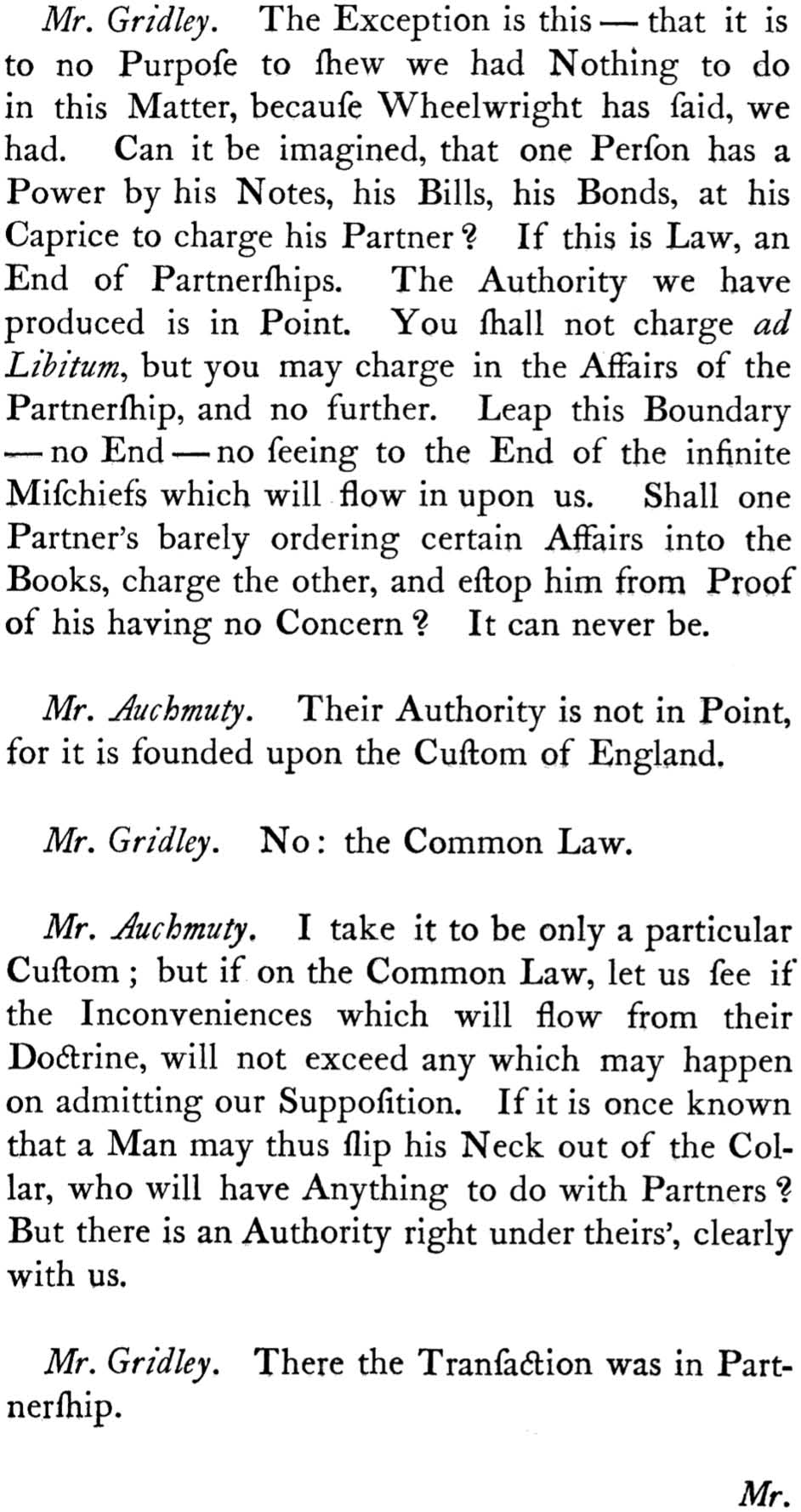
[P. 181]
Then the question was whether the note would extinguish the underlying action on the account against the Company. Pateshall accepted, against the account, something he did not have before, a note from Wheelwright. But Wheelwright did not pay on the note. Since at least the time of Pinnel’s Case, supra, in 1602, the common law has held that a lesser sum can never “be satisfaction for the whole.” Id., at 117a. On the other hand, something different-say “a horse, hawk, or robe etc,” can be good satisfaction. Id., at 117a–117b. Was the note sufficiently different to extinguish the obligation?
Initially, the Chief Justice was leaning this way. “[W]hether the Contract with the Company can be supposed to continue after Wheelwright had taken the Company’s Debt upon himself, and Pateshall had received the Note as a Balance of the Company Account. I doubt.” Reports, 186. Lynde was strongly of that view. “A new Agreement is entered into; for he [Pateshall] discharges the Company and takes Wheelwright for his Security.” Reports, 185. On the other hand, Cushing and Oliver believed “as the Law stands” the note was “no Discharge.” Reports, 185. Further, in Cushing’s words, “Equity seems in Favor of the Plaintiff; and I don’t know that the Law is against him.” Reports, 185.
After the Jury found for the original Plaintiff, Pateshall, a Writ of Review was brought before Justice Russell, Lynde and the Chief Justice. Lynde held to his original position, that the note was satisfactory. Russell took up the argument of Cushing and Oliver, for the original Plaintiff, Pateshall. The Chief Justice, however, switched, “The Doubts of the Chief Justice were . . . removed.” The second Jury “[w]as of the Same Opinion” as the first, and judgment was entered for Pateshall. Most interestingly, Gridley then moved-unopposed-for an “Appeal Home,” i.e., to the Privy Council in London, under the “personal action” provision of the Second Charter, the value of the case apparently exceeding the £300 limit. See Charters and General Laws, supra, 32. The case was duly docketed by the Privy Council, but the last entry says that the appeal was dismissed for non-prosecution. See Acts of the Privy Council, Colonial Series, vol. 5, 122–123 (January 15, 1768, February 17, 1768) and the Privy Council Register for George III, vol. 6, 7, 55, 60. (My thanks, as always, to Sharon H. O’Connor.) For a full discussion see Banister v. Henderson (1766), Reports, 119, Case 42, Note 6, vol. 4, supra.
Today, there would be little doubt that Pateshall’s acceptance of Wheelwright’s note would discharge the Company. See Appendix 5, “Latest Citations,” supra.
[P. 182]
[P. 183]
[P. 184]
[P. 185]
[P. 186]
[P. 187]
NOTE: DUNN V. SCOLLAY CASE 30[B]
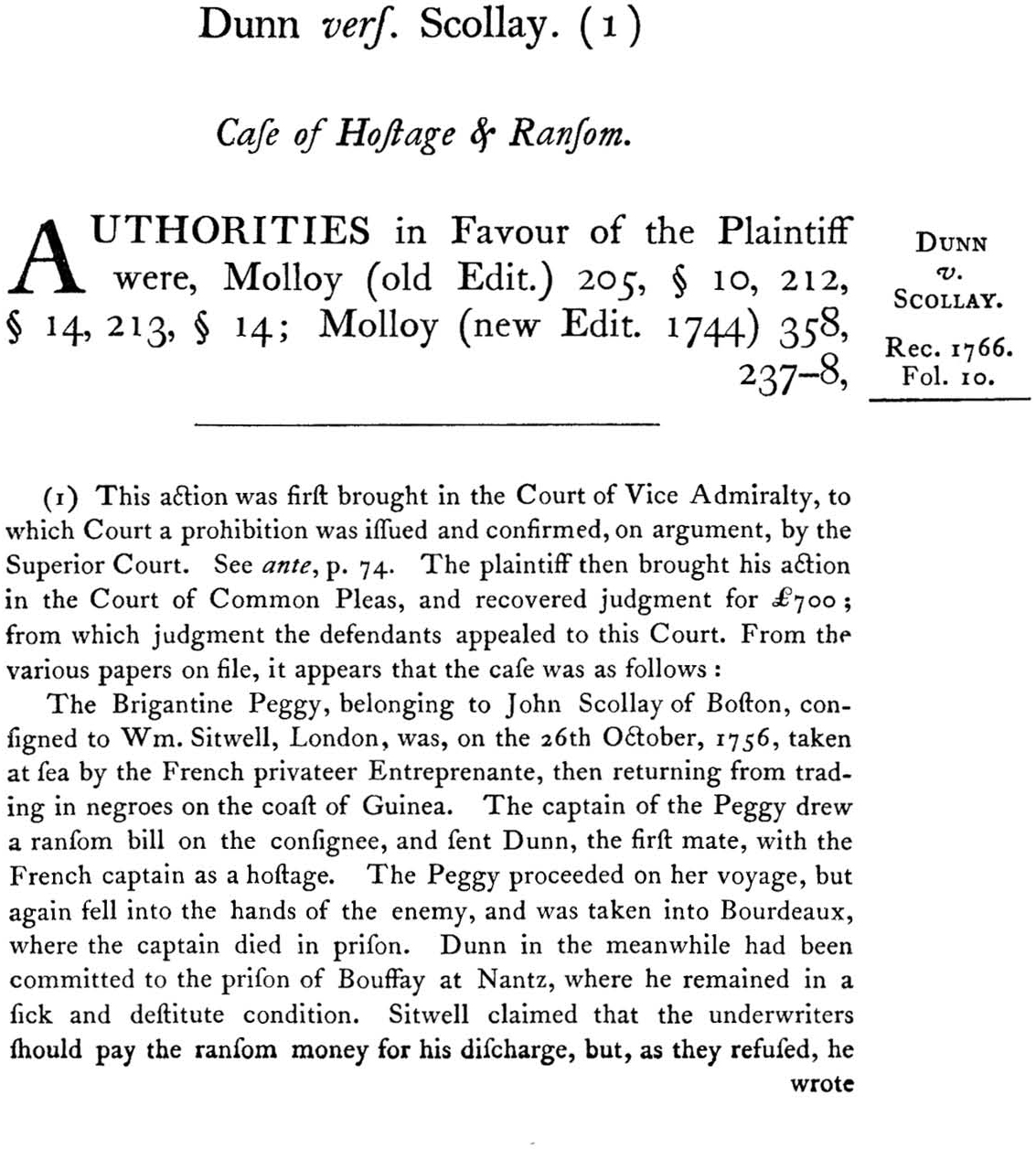
[P. 187]
“Case of Hostage & Ransom.”
See full discussion at Scollay v. Dunn (1763), Reports, 74, Case 30, vol. 4, supra. This was technically a second case, which followed Scollay v. Dunn after the Superiour Court confirmed a writ of prohibition to the Court of Vice Admiralty. The case was then brought by Dunn, the unfortunate first mate, in the Court of Common Pleas, and he received a verdict of £700. This case was an appeal from that verdict by the ship’s owner, John Scollay (1712–1790).
The authority cited all relate to the power of a ship’s master to bind an owner in this type of ransom contract, without special orders. See Samuel Quincy’s note 1, Reports, 188. For example, Charles Molloy, an established English admiralty authority, is relied upon by the Plaintiff. See Charles Molloy, De Jure Maritimo et Navali (London, 1676) “old edition,” (London, 1744) “new edition.” Sweet & Maxwell, supra, vol. 1, 64; Daniel R. Coquillette, The Civilian Writers of Doctors’ Commons, London (Berlin, 1988), 124–148. According to Molloy, “When Voyages are undertaken, the Master is there placed in by the Owners, and they ought to make good the Masters fact and deed . . . as the whole care and charge of Ship and Goods are committed to the Master.” Molloy, supra, (6th ed., 1707), 234.
Authorities for the Defendant owner included the popular Matthew Bacon’s A New Abridgement of the Law, supra, vol. 3, 592, 595. See Law Commonplace, [37], n. 5. Bacon sets out the statute 7 George 2, c. 15 (1734), which provided that Owners are not liable for loss of merchandise to any third party, unless there was “privity [to] and knowledge” of the Agreement. Id., 592. It further stated that, where “a Ship happens to be taken, and the Master to redeem the Ship and Lading out of the Enemies or Pirates Hands, promises a certain Sum of Money, for Performance whereof himself becomes a Pledge or Captive . . . It is to be redeemed at the Costs and Charges of the Ship and Lading.” (not, by implication, at the charge of the master personally). Id., 595. In this case, the Plaintiff apparently could not get a lien on the Peggy, the ship itself, and so had to pursue the owner. See the discussion at Scollay v. Dunn, Reports, 76–77, Case 30, supra.
[P. 188]
As Samuel Quincy observed, the record shows a verdict for the appellant owner, and a reversal of the former judgment for the Plaintiff Dunn, and costs. See Rec. 1766, fol. 10, Reports, 187–188, S. Quincy, Note 1. The principle must have been the old distinction, whereby the Master could bind the ship (hypothecation), but could not bind the Owner. See discussion at Reports, 74, Case 30, supra, S. Quincy, Note 6.
Despite the importance of the case, leave to appeal to the Privy Council was denied, and there is no evidence of the case in the Privy Council records. See full discussion at Scollay v. Dunn (1763), Reports, 74, Case 30, Note 6, vol. 4, supra.
CASE 47
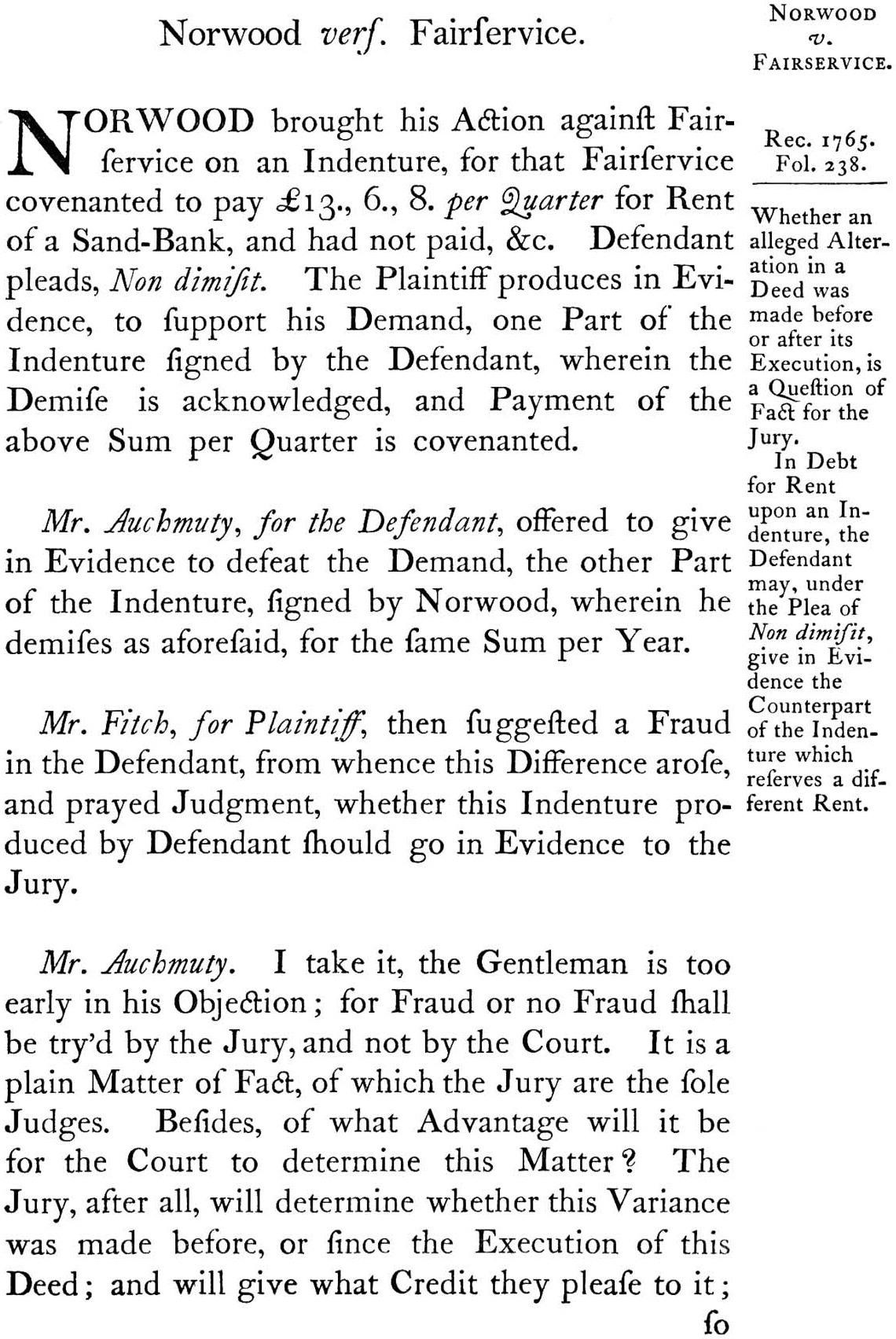
[P. 189]
5 George III (Aug.) in the Superior Court of Judicature
1 · brief description
This was a rather amazing action in debt upon an indenture. An “indenture” was a deed between two or more parties formalizing some agreement. “Formerly it was usual when a deed was made between two parties to write two copies of it on one piece of parchment or paper, and then to cut it in two in an indented or toothed line, so that each copy of the deed fitted the other. . . .” Jowitt, supra, 957–958. In this case, one half of such an indenture provided a rent of £13.6.8 per quarter, and the other side, £13.6.8 per annum! The copy in possession of the Plaintiff, Norwood, signed by the Defendant, Fairservice, had the per quarter provision; the copy in the Defendant’s possession, signed by the Plaintiff, had the per annum provision. Held: the Defendant may give in to the Jury evidence his copy of the indenture to support his plea of non dimisit (“he [the landlord] did not demise i.e., grant the lease”). At least two judges, Oliver and Cushing, initially dissented, arguing that it was an issue for the Court, not the Jury.
2 · court records
Available at Rec. 1765, fol. 238.
3 · professionals involved
Samuel Fitch (1724–1799) and Jeremy Gridley (1701/02–1767) appeared for the Plaintiff, Norwood. Robert Auchmuty (1723–1788) appeared for the Defendant, Fairservice. See brief biographies in Appendix 6, infra.
4 · authority
None given, which is rather surprising given the ample literature on indentures and pleading. Quincy himself helpfully provided a citation to the popular New Abridgement of the Law by Matthew Bacon. See Quincy Papers, vol. 2, Law Commonplace, [37], n. 5. Bacon stated that, “In Debt for Rent, if it be by Deed, the proper Plea is Non est factum (“not his deed”), but if it be without Deed, the Defendant may plead Non dimisit, Nothing in Arrear, or that he never entered. . . .” Matthew Bacon, New Abridgment, supra, vol. 4, 84.
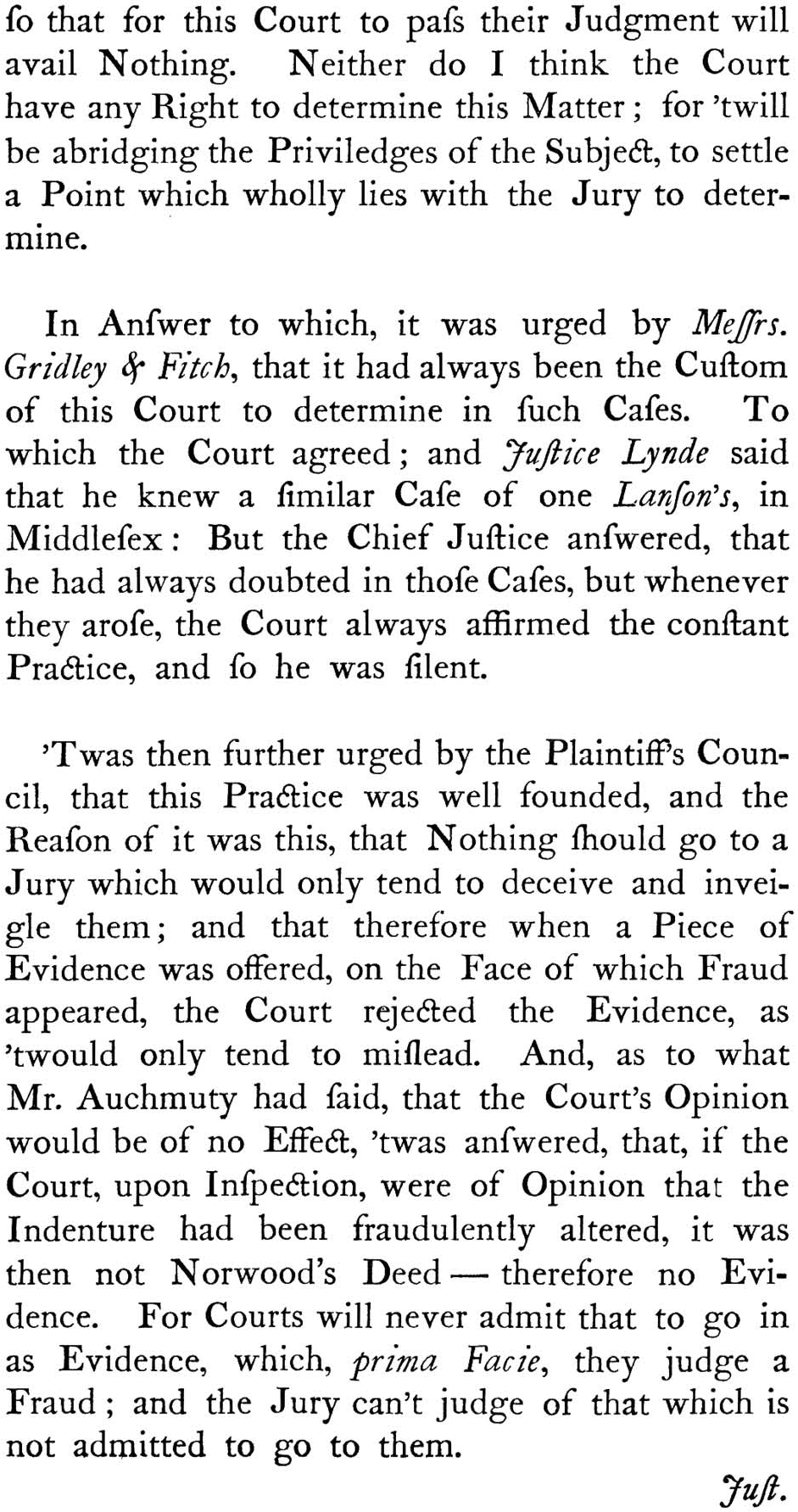
[P. 190]
The problem, of course, was that it was the Defendant’s deed. “We have admitted the Indenture produced was our Deed,” Reports, 191, so non est factum was not a good plea. Auchmuty wished to challenge the whole transaction. His non dimisit plea was intended to admit the signature, but deny the deed. “We could not possibly have been farther from admitting this Deed, than by pleading as we have done.” Reports, 191.
There was also the fundamental issue, treated as a matter of colonial law, about whether the Court should view the indenture and determine whether there was fraud or whether, as Auchmuty urged, it was “A plain Matter of Fact, of which the Jury are the sole Judges.” Reports, 189. While there was much reference to a “custom” or “Practice of this Court,” there was no authority actually cited by counsel. Justice Lynde remembered “a similar Case of one Lanson’s in Middlesex.” Reports, 190. The Chief Justice replied “that he had always doubted in those Cases, but whenever they arose the Court always affirmed the constant Practice, and so he was silent.” Reports, 190. Later, the Chief Justice felt little compunction about breaking from that precedent. “I know the custom has been otherwise, but, for my Part, I think ’tis Time it was altered-am for admitting it [the other cons of the indenture, in evidence before the jury.]” Reports, 191. See further discussion in connection with Gibbs v. Gibbs (1762), Reports, 251, Case 57, Note 6.
At the conclusion of the arguments, Gridley raised an ingenious point, that the Defendant, having admitted that he signed the deed produced by the Plaintiff, was estopped from denying that he entered into the lease. “To prove our Allegation, we have produced his Deed; and he is estopped to say the contrary . . . ’Tis absurd to offer this Paper to defeat his own Deed. It can’t be done.” Reports, 192. Quincy observed “N.B. No Authorities were produced, and the Council [sic] on each Side acknowledged the Points were unexpectedly started.” Reports, 192.
5 · later citations
Quincy cited this case in his report of Carpenter v. Fairservice (1767), Reports, 239, Case 55.
[P. 191]
6 · notes
This would make a great law school examination question. Technically, the only appropriate defense to an indenture is non est factum [“not his deed”]. But it was the Defendant’s deed, and the Plaintiff had duly signed the Defendant’s document. The underlying issue, of course, is the possibility that one of the two parties changed the deed in their possession by forgery, or that there was a fraud. (Note, if the part of the indenture in the Plaintiff’s hands had the lower rent figure, it would be a more likely mistake.) If so, who should decide? Was it an issue of law for the Court, in which case the Court should view the defendant’s half of the indictment, or was it an issue of fact for the Jury?
Initially, the case went for the Plaintiff, apparently on the grounds that the Defendant was estopped from denying the deed in the Plaintiff’s possession (“He is estopped, I think” Cushing, Just.) or that the counterpart of the Plaintiff’s indenture should not go to the jury. (“I think it can’t be admitted.” Oliver, Just.) See Reports, 192. But Auchmuty “ordered a Review to be minuted, and said, if he was wrong now, he was never right in his Life.” Reports, 193. Quincy “did not hear” the trial on review, but the Court admitted “the Counterpart of the Indenture to go in” and the Defendant won.
[P. 192]
[P. 193]
CASE 48
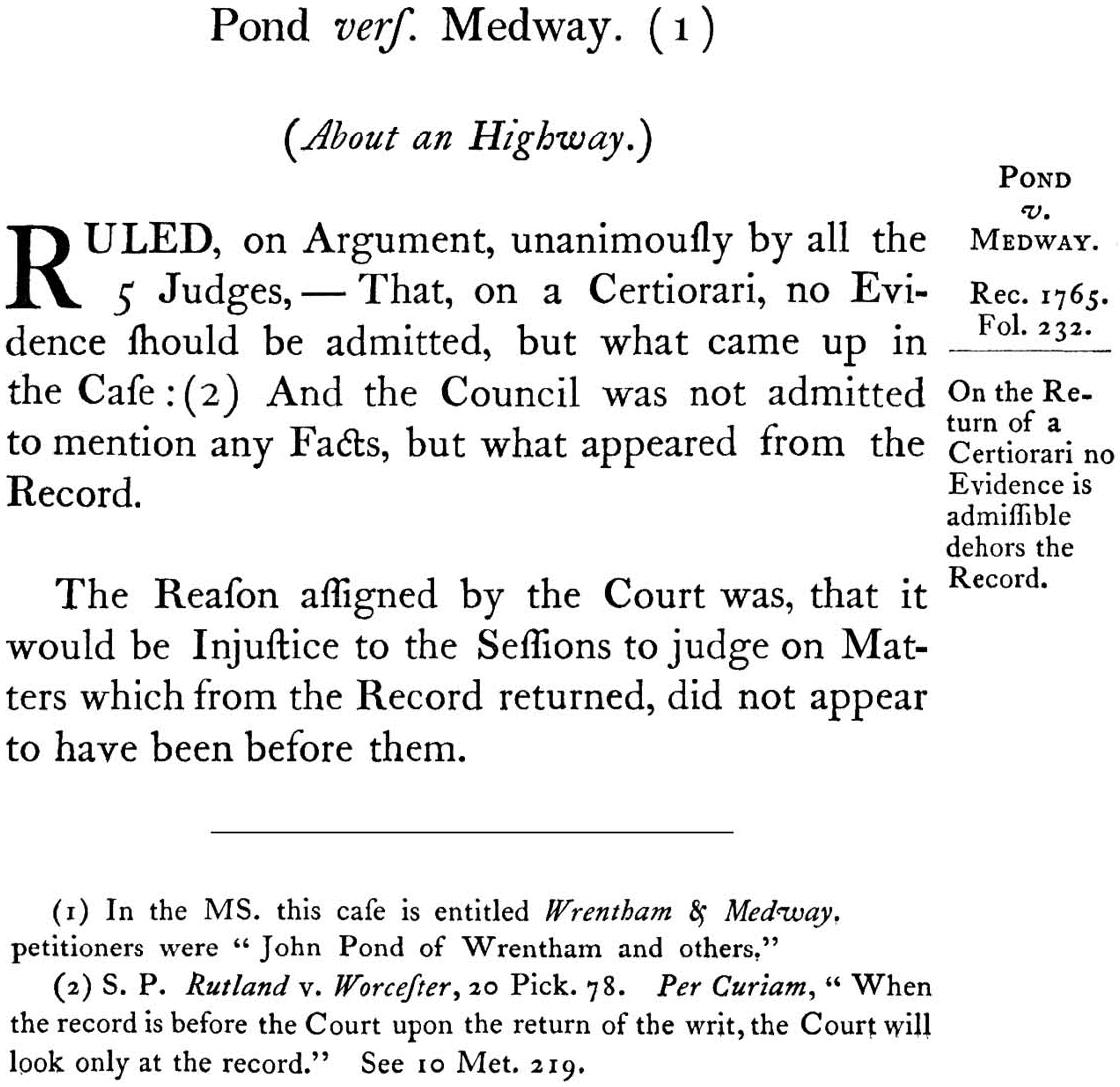
[PP. 193–194]
5 George III (Aug.) in the Superior Court of Judicature
1 · brief description
On a writ of certiorari, no evidence or argument should be admitted except that in the Record.
2 · court records
Available at Rec. 1765, fol. 232. Part of these records appear to be missing. See the manuscript of “Wrentham & Medway.”
3 · professionals involved
None Indicated.
4 · authority
None Given.
5 · later citations
This case was cited in Farmington River Water Power Co. v. Co. Commissioner, 112 Mass. 206, 214 (1873) for the proposition that a petitioner for a writ of certiorari cannot introduce evidence to contradict or vary its statement in the Record. See Appendix 5.
6 · notes
A writ of certiorari (“to be more fully informed of”) was one of the prerogative writs of the King’s Bench, and was limited to the official record in the case. See Jowitt, 335. See also J. H. Baker, An Introduction to English Legal History, supra, 148–150. It was “originally a means of supplying information to a superior court by way of certification, especially from another court of record.” Today, the principle of Pond v. Medway still applies, although the definition of “record” has been greatly expanded. See id., 149. See also S. A. de Smith, “The Prerogative Writs” (1951) 11 Cambridge L.J., 40–56.
CASE 49
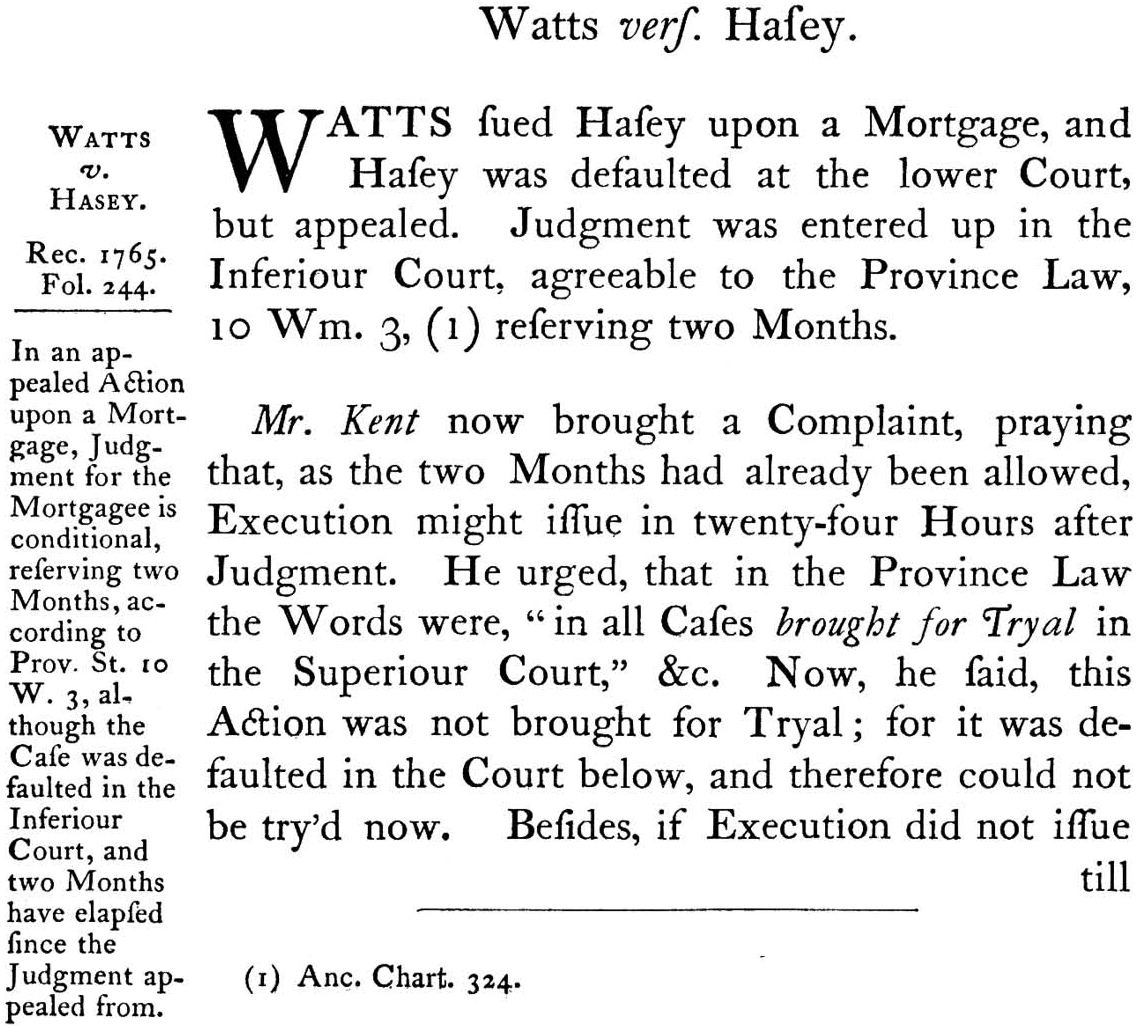
[P. 194]
5 George III (Aug.) in the Superior Court of Judicature
1 · brief description
A provincial statute provided that a judgment on a mortgage was conditional for two months. (Prov. St. 10 William III, [1698], Charters and General Laws, supra, chap. 58, sec. 1, 324.) Here, Defendant defaulted in the Inferior Court, but took an appeal to the Superior Court. Held: the two month period does not run from the entry of the Defendant default below, but from entry of judgment in the Superior Court.
2 · court records
Available at Rec. 1765, fol. 244.
3 · professionals involved
Benjamin Kent (1708–1788) represented the Plaintiff mortgager. See the short biography in Appendix 6. It is unclear if any lawyer represented the Defendant mortgagee, who was appealing from the default judgment below. No name was given.
4 · authority
None cited, except for the Statute, Prov. St. 10 William III, (1698), Charters and General Laws, supra, chap. 58, sec. 1, 324. The Justices referenced “uninterrupted usage” and the “Construction of the Law thereby established” in rejecting the Plaintiff’s argument for “innovation.” Reports, 195. The Chief Justice observed, “nolumus mutare Leges Angliae.” (Usually “nolumus leges Angliae mutare” for “we will not have the laws of England changed.”) This repeated the famous comment of the Barons to the Statute of Merton, 20 Hen. 3, cc. 1–11. See P. G. Osborn, A Concise Law Dictionary (London, 1964), 222. Reports, 195.
5 · later citations
This case was cited in Holbrook v. Bliss, 91 Mass. 69, 9 Allen 69, 71 (1864) as an example of a proceeding pursuant to Prov. St. 10 William III, (1698), Charters and General Laws, supra, chap. 58, sec. 1, 324, apparently to establish that the courts of the Commonwealth had historically been vested with equity powers in cases of writs of entry to foreclose mortgages of real estate. See Holbrook v. Bliss, supra, 71.
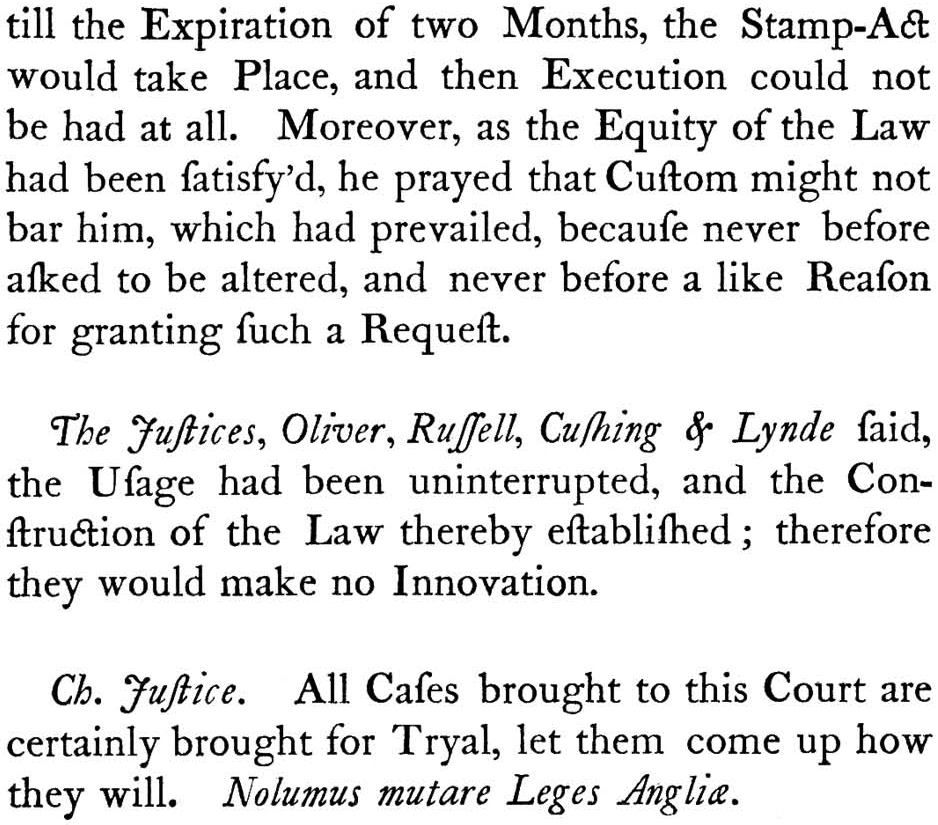
[P. 195]
6 · notes
The Justices unanimously rejected Kent’s argument that an appeal from a default judgment below to the Superiour Court was somehow not a case “brought for Tryal in the Superiour Court,” in the words of Prov. St. 10 William III, (1698), Charters and General Laws, supra, chap. 58, sec. 1, 324. The Justices observed that “Usage . . . uninterrupted” construed the statute so that the final two-month statutory period ran from the entry of the Superiour Court judgment, not from the Inferior Court judgment below. Reports, 195. (Incidentally, the Statute used the words “brought for trial in the Superior Court or in the Inferiour Court for Commission pleas”-so the statutory language actually was ambiguous.)
So what was this case really about? Kent ended up pleading with the Justices “if Execution did not issue till the Expiration of two Months, the Stamp Act would take Place, and then Execution could not be had at all.” Reports, 195. Making the dubious assertion that the “Equity of the Law had been satisfy’d,” Kent wanted a blatant exception, because “never before a like Reason [existed] for granting such a request.” Reports, 195. It was a desperate argument, more about the political reality of the Stamp Act, than about the law. See discussion of the Stamp Act (1765) in Introduction to the Reports, Section IV. D.
CASE 50
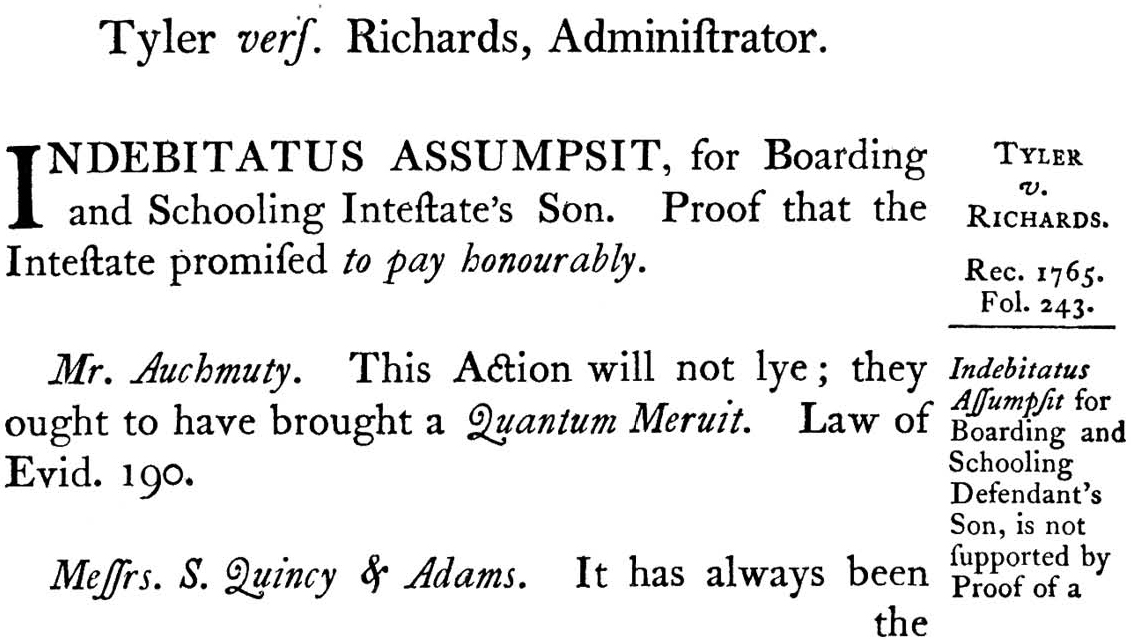
[P. 195]
Tyler v. Richards, Administrator (1765)
5 George III (Aug.) in the Superior Court of Judicature
1 · brief description
An intestate (whose estate administrator was the Defendant) promised the Plaintiff that he would “pay honourably” for the board and schooling of his son. Plaintiff brought the general contractual action of indebitatus assumpsit (“being indebted, did promise”) against the estate. Held, this was the wrong cause of action. It should have been a quantum meruit, an action for restitution of unjust enrichment in the absence of an explicit contract.
2 · court records
Available at Rec. 1765, fol. 243.
3 · professionals involved
Samuel Quincy (1734–1789) and the Patriot John Adams (1735–1826) represented the Plaintiff. Samuel Quincy was the brother of the Reporter. With his co-counsel Adams, he was one of the most junior members of the bar. The two were, in fact, listed 26 and 27 respectively, out of 27, by the Memoranda of August Term, 2 George III, at Reports, 35. Both were admitted as barristers in the Superiour Court in 1762. Unlike his brother Josiah, Samuel Quincy was a loyalist, and became Solicitor General of the colony in 1771. He was proscribed in 1778, and became a successful barrister in the West Indies (1779–1789). John Adams, of course, went on to become Vice President (1789–1797) and President (1797–1801) of the United States. See brief biographies in Appendix 6.
4 · authority
Auchmuty relied on one English source in arguing that quantum meruit was required. “Law of Evidence” refers to Geoffrey Gilbert’s Law of Evidence by a Late Learned Judge, 1st ed. Dublin, 1756. See Sweet & Maxwell, vol. 1, 379.
[P. 196]
Adams and Samuel Quincy relied solely on “the Custom of this Court.” Reports, 196. As Quincy noted, a very similar issue was presented in the later case Pynchon, Executor v. Brewster, Reports, 224, Case No. 51 (1766). In that case, John Adams appeared for the defendant and argued almost exactly the opposite proposition, that quantum meruit should have been brought, not assumpsit. In that case, he “relyed much” on the decision against his client in this case. See Reports, 224.
It is a long-established principle of the legal profession that arguing contradictory positions of law in unrelated cases is not necessarily unethical or unprofessional. See ABA Model Rule 1.7, Comment 24 (2007 ed.). Indeed, law students are routinely trained by arguing opposing positions in moot court cases.
The history of the colony’s development of quasi-contractual law was almost exactly contrary to the prevailing English authority of the day. See discussion at Note 6, supra, and at Notes 4 and 6, Pynchon, Executor v. Brewster, (1766), Reports, 224, Case 51.
5 · later citations
This case was relied on by John Adams in Pynchon, Executor v. Brewster (1766), Reports, 224, Case 51. See Glover v. Le Testue (Aug. 1770), Reports, 225, S. Quincy n. 1. See also note 31 in John Adams, Legal Papers (L. K. Wroth, H. B. Zobel, eds., 1965), vol. 1, 37.
6 · notes
Quantum meruit (“as much as he has earned”) was an action to receive the value of goods or services rendered, rather than a negotiated contract price. “If a person ordered goods or services without first fixing the sum to be paid for them, he could be sued upon an assumpsit to pay what the goods were worth (quantum valebant) or what the performance of the services deserved (quantum meruit).” J. H. Baker (3d ed. 1990), supra, 415. As Baker observed, usually in such a case “it is a fair guess that the undertaking was to be implied from the circumstances.” Id., 415. Today, this is often called “quasi-contract.” See Earl Jowitt, supra, 1452–1453.
It is also conceivable that “there may in some cases have been an express promise to pay whatever was deserved; but this seems inherently unlikely.” J. H. Baker (3d ed. 1990), supra, 415. But this was such a case-with an express promise to pay “honourably.” As there was no contract price agreed, this case today would clearly be regarded as quasi-contractual, i.e., quantum meruit. The issue in 1765 was whether the plaintiff had the right cause of action for such a quasi-contractual recovery. Theoretically, indebitatus assumpsit grew, by legal fiction, out of a debt action, which required a sum certain. See discussion at Reports, 224, Case 51, supra, Note 6. But it became a general contract remedy in practice. In this case, the Court correctly held that the quantum meruit was the proper action where there was no sum certain agreed upon. In Pynchon, Executor v. Brewster (1766), Reports, 224–225, Case 51, the action was on a specific doctor’s bill, with a sum certain, but it had not been agreed upon. There the Court permitted an indebitatus assumpsit action, to Adams’s dismay, as he was now arguing the other side of the issue! See Note 4, above. Even so, the Justice permitted the jury “if they thought it reasonable, [to] lessen the charges in the [doctor’s] Account,” a quasi-contractual approach. Reports, 225. Four years later, in Glover v. Le Testue (Aug. 1770), they apparently reversed themselves, and held that indebitatus assumpsit would not lie for a doctor’s “visits and Medicines” “because no Contract for a certain Price for the Visits or Druggs.” Legal Papers of John Adams (L. K. Wroth, H. B. Zobel, eds., 1965), vol. 1, 37, n. 31; and Samuel Quincy’s note at Reports, 225–226, n. 1.
The great importance of this legal dispute lay in the Court’s independence from English authority. As Samuel Quincy observed, English law in 1765 supported the decision in this case, requiring an exact agreed sum for indebitatus assumpsit, and was contrary to the later holding in the Pynchon Case in 1766. See Reports, 225–226, S. Quincy n. 1. But, by 1770, when Pynchon was overruled in Glover v. Le Testue, the English law had changed to permit such a use of indebitatus assumpsit. Compare Thompson v. Spencer, 8 Geo. 3 in KB (1768) with Bagnal v. Sachaverell, 1 Croke’s Reports (Eliz.) 292 (1595). See the discussion in Reports of Sir George Croke, Knight (5th edition corrected with “Marginal Notes and References to Later Reports by Thomas Leach, Esq.,” Dublin, 1791), 292; Edward Lawes, A Practical Treatise on Pleading on Assumpsit (London, 1810), 429. (My thanks, as always, to Mark Sullivan.)
The Massachusetts Court was, in the end, indifferent, or uninformed, about the prevailing English law of the day. In this case, they applied the English law correctly, but later reversed themselves in Pynchon, where they contradicted the English rule. When the English law changed to support the Pynchon holding, the Court reversed itself again in Glover! If the Court could be presumed to know the correct English law, it was being perverse indeed!
CLOSE OF AUGUST TERM (1765)
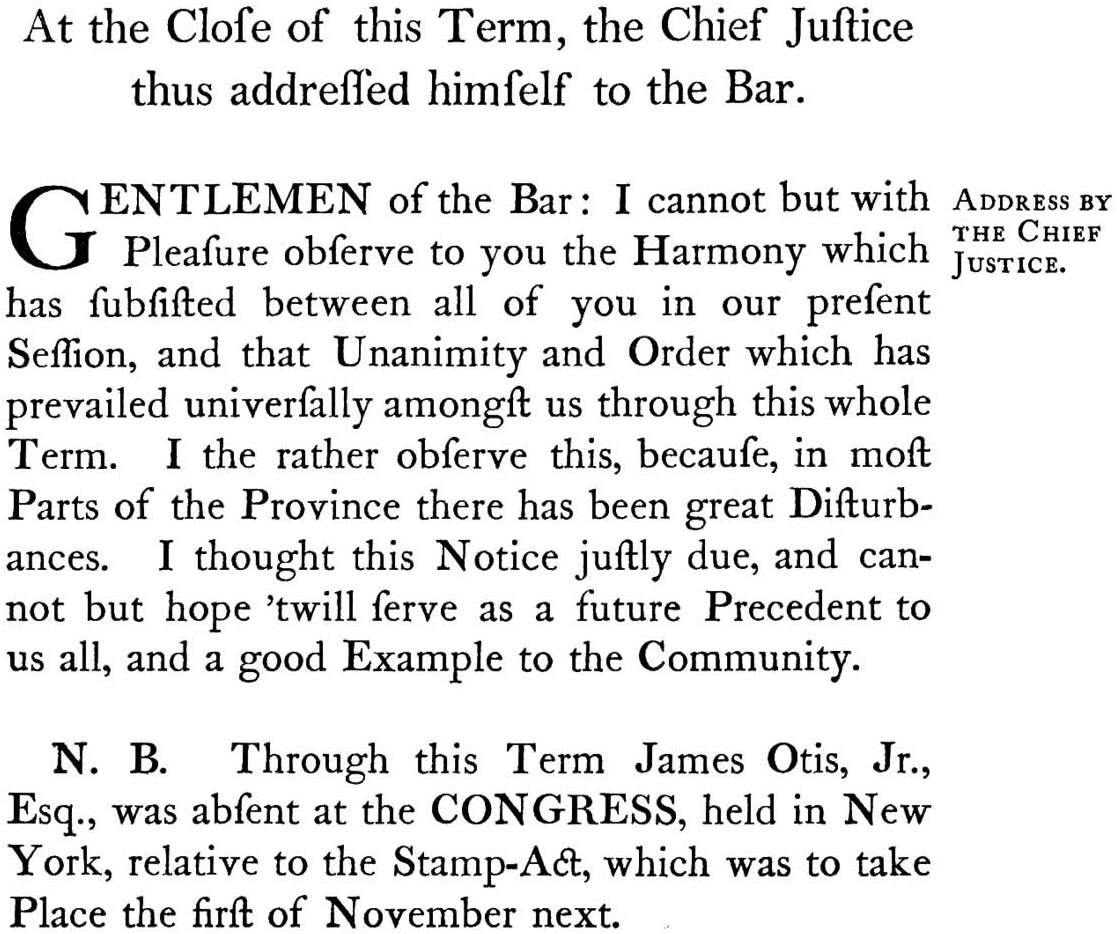
[P. 197]
The “great Disturbances” of 1765 included the burning of Chief Justice Hutchinson’s house on August 27, 1765. See Reports, 169–174, and accompanying notes. Quincy’s comments at that time explain how his patriotic fervor was consistent with the professional “Harmony” that the Chief Justice praised. His outrage at the Stamp Acts and his horror at the mob violence flowed from a consistent source, his belief in legal due process. As Quincy observed:
“The Destructions, Demotions and Ruins caused by the Rage of the Colonies, in general perhaps too justly inflamed, at that singular and ever memorable statute called the Stamp Act, will make the present year one of the most remarkable Æras in the Annals of North America.” Reports, 168. He saw error on both sides:
“And that particular Inflammation which fired the Breasts of the People of New England in particular, will always distinguish them as the warmest Lovers of Liberty; though undoubtedly, in the Fury of Revenge against those who they thought had disclaimed the Name of Sons for that of Inslavers, and oppressive Taxmasters of their native Country, they committed Acts totally unjustifiable.” Reports, 168. (See, for a full discussion, “Introduction to the Reports,” Section IV D.) Even Hutchinson himself was careful to emphasize his personal opposition to the Stamp Act. Reports, 171–172. John Adams also saw no inconsistency between his belief in the Patriot cause and his commitment to the professionalism of the bar. See D. R. Coquillette, “Justinian in Braintree: John Adams, Civilian Learning, and Legal Elitism, 1758–1775,” in Law in Colonial Massachusetts (Coquillette, Brink, Menand, eds., Boston, 1984), 395–400.
Quincy noted that James Otis Jr. (1725–1783) was absent from the harmonious professional group, being at the Stamp Act Congress in New York. Quincy’s “N.B.” (i.e., “nota bene,” note well) was clearly intended as a cautionary note on the Chief Justice’s optimistic view that the bar’s cohesiveness “’twill serve-as . . . a good Example to The Community.” Reports, 197. See the brief biographies in Appendix 6.
MEMORIAL OF THE TOWN OF BOSTON
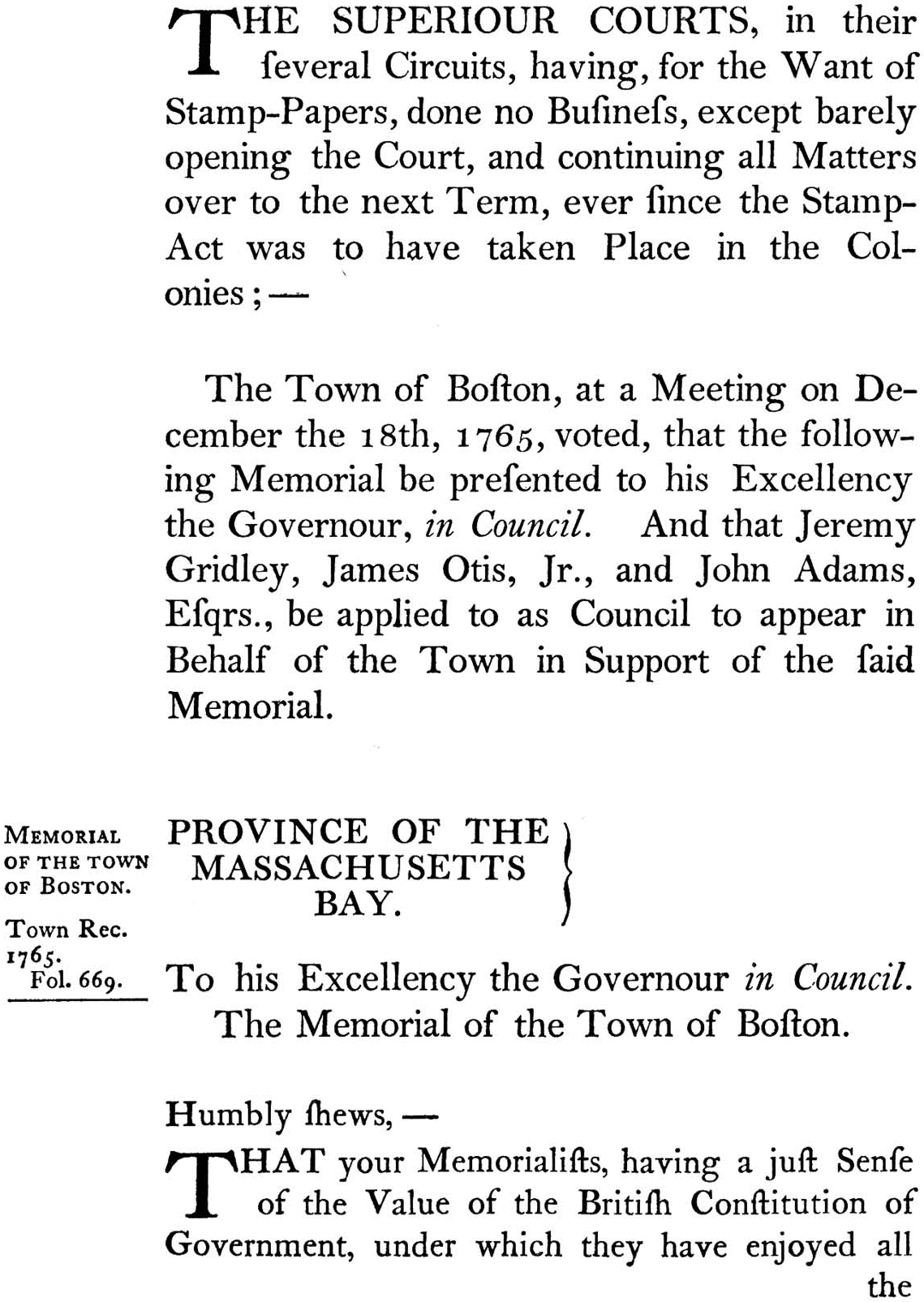
[P. 198]
Memorial to His Excellence the Governor in Council from the Town of Boston
December 18, 1765
Following the effective date of the Stamp Act on November 1, 1765, it became clear that the courts could not function legally unless there was stamped paper. Indeed, this was-for all practical purposes-the effect on the Superior Court itself, which essentially shut down. See “Note” to “Charge No. 3, March Term, 1760,” Reports, 215, supra. The Town of Boston hired Jeremy Gridley (1701/2–1767), James Otis Jr. (1725–1783), and John Adams (1735–1826) as advocates to represent them before the Governor and Council in presenting a Memorial urging the Governor to use his executive power to order the courts to function. It was a curious choice of lawyers. Adams and Otis were, of course, known patriots, but Gridley was a greatly respected moderate, who was to be appointed Attorney General on March 25, 1767, only to die on September 10, 1767. Gridley’s huge funeral demonstrated his popularity and status, despite having defended the unpopular writs of assistance against his old students, Otis and Thatcher. See Appendix 6, note 3.
Adams’s Diary recounts that each of the three lawyers had a different role to play in the advocacy before the Governor in Council. Adams would attack the validity of the Stamp Act because it was enacted by legislative body on which the colonists were not represented, a radical argument. Otis would argue that closing the courts would be in violation of the judicial oaths, and Gridley would focus on “the great inconvenience that would ensue the interruption of justice,” clearly the most moderate argument. See John Adams’s diary entry for December 20, 1765, Diary and Autobiography of John Adams (eds., L. H. Butterfield, L. C. Faber, W. D. Garnett, New York, 1964) vol. 1, 266–267. (Hereafter, “Diary and Autobiography of John Adams.”)
It is likely from Quincy’s notes on the delivery of the arguments, including his description of Otis “with Tears” Reports, 292, that he transcribed the arguments himself, and did not rely on circulated copies.
The arguments, delivered before Governor Bernard and his Council, were exceptionally important for the sophistication of their theoretical structure and the cosmopolitan nature of the authority cited. Adams looked to the conventional common law sources to establish “our Rights as Men, and our Privileges as Englishmen,” including Coke on Littleton (First Institute, London, 1628); Coke’s Fourth Institute (London, 1644) on court jurisdiction, Wood’s Institute of the Laws of England (1720) and Coke’s Second Institute (London, 1642) on statutes, citing to Chapter 29 on the Magna Carta, 56. “Wee shall not sell, deny, or delay Justice and right.” Reports, 201–202. But Adams also cited to a Roman law maxim “of 1800 years standing”: “what concerns All shall be judged of by All.” Reports, 200.
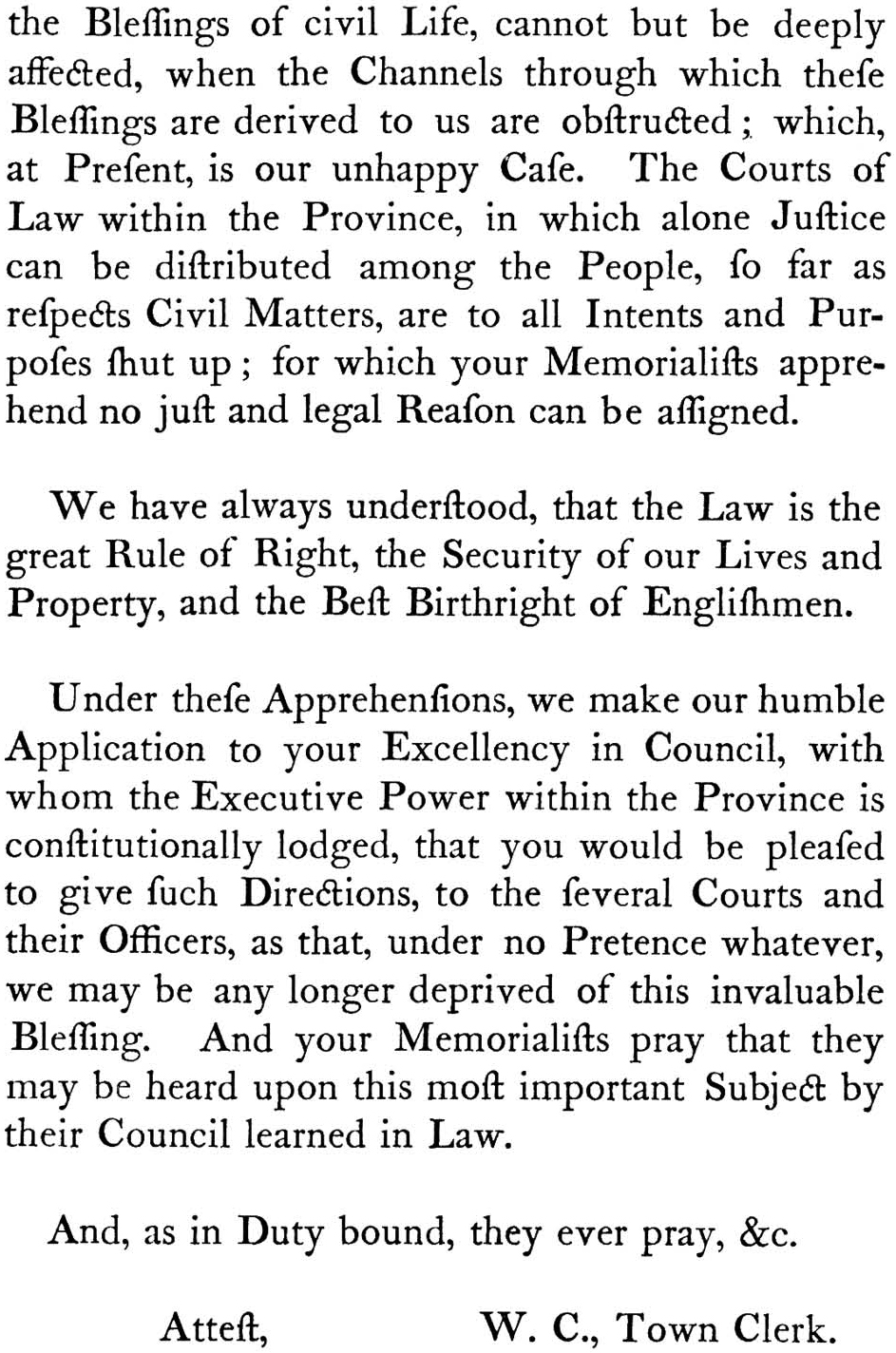
[P. 199]
Arguing from maxims, as opposed to arguing from treatises or decided cases, is very rare today, but it was common in Adams’s day. It was closely related to civil law modes of analysis, and was advanced in England by the English civilian jurists of Doctors’ Commons. The notion, in Adams’s words, that “[t]here are certain Principles fixed unalterably in Nature” was a profoundly civilian, and Roman, idea. See Elizabeth Papp Kamali’s masterful “Quincy’s Legal Maxims,” Appendix 1, The Law Commonplace, Quincy Papers, vol. 2, 325–427. See also Daniel R. Coquillette, The Civilian Writers of Doctors’ Commons, London (Berlin, 1988), 32–46. In addition, the great English genius, Francis Bacon, advocated the storage of legal knowledge and authority as maxims. See Francis Bacon, A Collection of Some Principal Rules and Maxims of the Common Lawes, first written about 1597, first published in his posthumous The Elements of the Common Lawes of England (London, 1631), and discussed at length in Daniel R. Coquillette, Francis Bacon (Stanford, 1992), 35–48. Bacon’s influence on Quincy’s generation was profound. Jefferson organized his library according to Bacon’s categories, and Quincy’s portrait by Stuart shows Bacon’s Works in the background. See Thomas Jefferson’s Library (eds. James Gilreath, Douglas L. Wilson, Washington, 1989), 2–3.
Adams’s maxim in his Memorial argument was drawn from Justinian’s Institutes, a copy of which Adams had acquired from the library of Jeremiah Gridley, his tutor. See Daniel R. Coquillette, “Justinian in Braintree: John Adams, Civilian Learning, and Legal Elitism, 1758–1775,” from Law in Colonial Massachusetts, supra, 365.
Otis also began his argument with a “fundamental Maxim,” “[t]is a first Principle ‘that Majesty should not only shine in Arms, but be armed with the Laws.’” This, too, is from Justinian’s Institutes, from the very first lines of the Proemium, “Imperatoriam maiestatem non solum armis decoratam, sed etiam legibus oportet esse armatam.” See Imperatoris Iustiniani Institutionum (J. B. Moyle, ed., Oxford, 1912), 95. These lines were repeated at the beginning of the great medieval English law treatise, Bracton (c. 1230 a.d.) “To rule well a king requires two things, arms and laws . . . For each stands in need of the other.” See Bracton on the Laws and Customs of England (S. E. Thorne, trans., Cambridge, Mass., 1968), 19. Otis then went on to argue from Bracton repeatedly for the proposition that “shutting up the Courts” robbed the King of “his executive Power,” using page citations to the second edition of 1640.
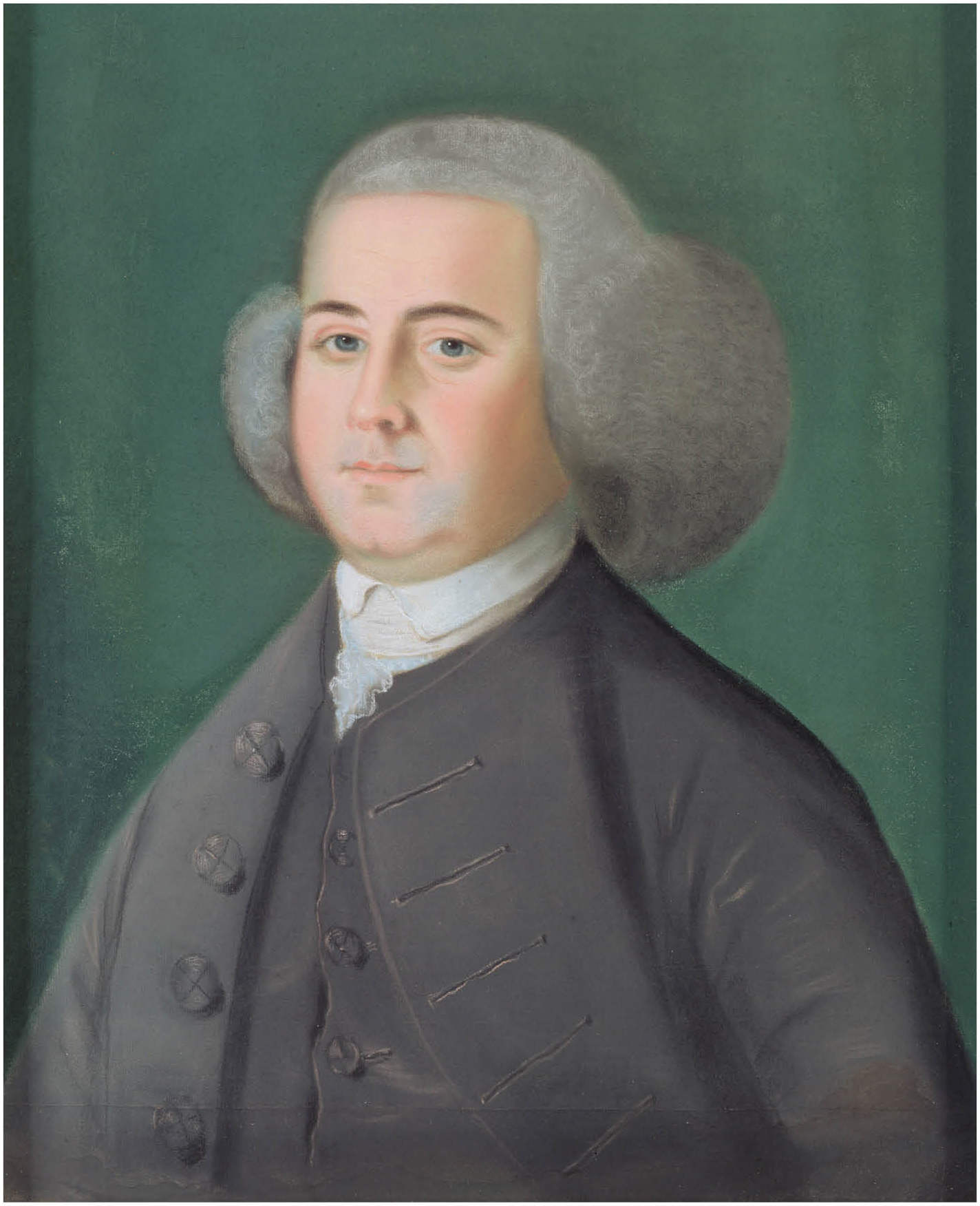
ILLUSTRATION 5: John Adams (1735–1826), President of the United States (1796–1800), by Benjamin Blyth (1746–after 1786), pastel on paper, 1766. Adams would be age 31, and this portrait would be just after the arguments in the Memorial of Boston (1765), Quincy’s Reports, 198–214. There was a companion piece of his wife, Abigail Smith Adams (1744–1818), who was a cousin of Josiah Quincy Jr. See Witness to America’s Past: Two Centuries of Collecting by the Massachusetts Historical Society (Boston, Mass., 1991), 104–106. Image courtesy of the Massachusetts Historical Society and the Bridgeman Art Library.
Even Gridley’s argument, that the statute should be interpreted as if “all the Stamp-Papers had been destroyed by Tempest, or some other Casualty,” and that the Courts should regard use of those papers as an impossibility, was founded on argument from maxims. In particular, Gridley argued “. . . Impossibility in such Case would assuredly excuse: that the Law never requires Impossibilities is a Maxim of the Law.” Reports, 209. This, too, comes from the civilian maxim nemo tenetur ad impossibilia. See Herbert Broom, Legal Maxims (ed. R. H. Kerslen, 10th ed., 1939), 162–165. See also Justinian’s Institutes (Sanders, 7th ed., 1883), lib. 3, tit. 19, s. 1, 343. It was repeated by Coke in 1628 in his classic, Coke on Littleton, supra, 231 b, “lex cogit ad impossibilia.”
In addition, Otis’s argument showed direct familiarity with both classical English sources, such as Coke’s Institutes and civilian sources, including Vattel, Grotius, and Barbeyrac’s editions of the Corpus Juris. See Reports, 204–205. Even more interesting, Quincy’s own notes showed that he was following Otis’s arguments with a copy of Charles Molloy’s text, De Jure Maritimo et Navali, Michael Foster’s Discourses upon a few branches of the Crown law (Oxford, 1762; see Sweet & Maxwell, vol. 1, 367), and John Locke’s Two Treatises on Government (London, 1690), the Locke at least being in Quincy’s library at his death. See Appendix 8, Reports, infra, entry 43. Quincy also demonstrated his familiarity with the Year Books, adding 19 Henry VI, 63, to the four cited by Otis, all on the point that the King “unkings himself In the most essential Point” if the courts are shut. Reports, 205, 209.
The sophistication in legal research of both the advocates and the reporter was impressive and is historically significant. Otis, Quincy and Adams were the products of apprenticeship by training, and never darkened the door of any institutional law school. Yet, like John Marshall, Joseph Story and Abraham Lincoln they were accomplished, not only in traditional literature of the common law, but in continental civilian services as well. See the “Introduction” to Quincy’s Law Commonplace, Quincy Papers, vol. 2.
ILLUSTRATION 6: The Council Chamber, Old State House, Boston (1748). The original interior was destroyed by the fire of December 9, 1747. Only the brick walls survived from the structure of 1713, which in turn replaced a wooden building of 1658. That wooden building was destroyed by the great fire of 1711. The Bostonian Society attempted to recreate the appearance of the room in 1760–1883. The Superior Court of Judicature frequently met in this building before 1769. Photograph taken by George M. Cushing in 1966. Image courtesy Bostonian Society. Note the portrait of James Otis Jr. (1725–1783) by Joseph Blackburn (1700–1780) in the right corner. See Illustration 8, Quincy Papers, vol. 4. The room now has a very different appearance, and is used to display historic artifacts.
ILLUSTRATION 7: King George III (1738–1820), King of Great Britain and Ireland (1760–1820). Portrait printed on an official document confirming his royal authority over trade and immigration in the American Colonies, dated January 18, 1773. Courtesy of the Rare Books and Manuscripts Department, Boston Public Library.
[P. 200]
Otis, in particular, also demonstrated a good grasp of English constitutional history. Relying on John Jones’s Works (London, 1650) and Paul Rapin de Thoyras’s Acta Regia (first published Portsmouth, 1726, with Otis apparently using the 1732 or 1733 single-volume folio edition), he was clearly aware of English Civil War antecedents. In particular, Otis was mindful of the English judicial oath, which played such an important role in the Case of the Commendams (1616), Acts of the Privy Council (1615–1616), 595. Coke’s refusal, in that proceeding, to stay the judicial process at the direct order of the King, led directly to Coke’s dismissal and, indirectly, to Civil War. Otis set out in full the crucial words of the oath, citing Coke’s Fourth Institutes, Concerning the Jurisdiction of Courts (London, 1644), 70, which cites in turn to Bracton.
Otis also cited to “the famous Jew-Bill,” which was “immediately repealed” due to public outcry in England. The purpose was to demonstrate that the English, as well as the colonists, could be inflamed to resistance to an Act of Parliament. That bill, passed in 1753, permitted foreign-born Jews to be naturalized. (Jews born in England were British subjects.) Following a spate of anti-Semitic newspaper articles, the act was repealed the next year.
Gridley’s arguments, by contrast, were intended to be practical. With the exception of the civilian maxim on impossibility, he cited to no authority, but rather argued the dire practical consequences of closing the Courts. “The Innocent shall never be involved in the same Fate with the Guilty if it can be avoided.” Reports, 209. Quincy, perhaps concerned with the relative lack of authority, added marginal notes suggesting citations to Sir Michael Foster’s Discourses upon a few branches of the Crown law (Oxford, 1762), Locke’s Two Treatises on Government (London, 1690) and a year book case of 19 Henry VI, 63, as discussed before.
Ironically, given the wealth of the learning demonstrated by the arguments, Governor Barnard’s sole recorded query went, not to substantive law, but to jurisdiction. If the Stamp Act was “of no Validity,” was that not a matter for the judiciary? “[T]he Question with me is, whether that Thing don’t argue the Impropriety of our Intermeddling in a Matter which belongs to them to judge of in their Judicial Department.” Reports, 206. Indeed, that was the basis of the Council’s final decision, entered December 21, 1765, Reports, 210.
[P. 201]
[P. 202]
ILLUSTRATION 8: James Otis Jr. (1725–1783), woodcut by Meir and Fleming, Boston, 1771 (from the Boston Almanac, 1770). The likeness would be five years after Otis’s great argument in the Memorial of Boston (1765), Quincy’s Reports, 202–206. Image courtesy of the Library of Congress.
[P. 203]
[P. 204]
[P. 205]
[P. 206]
[P. 207]
[P. 208]
[P. 209]
[P. 210]
[P. 211]
[P. 212]
[P. 213]
[P. 214]
ILLUSTRATION 9: John Adams (1735–1826). Adams was the first Chief Justice of Massachusetts following the Revolution, appointed in 1775. (He never actually sat.) He was elected Vice President (1788, 1792) and President of the United States (1796). From a portrait painted by John Singleton Copley (1738–1815) in London in 1783. Courtesy, Harvard University.
CHARGE NO. 3
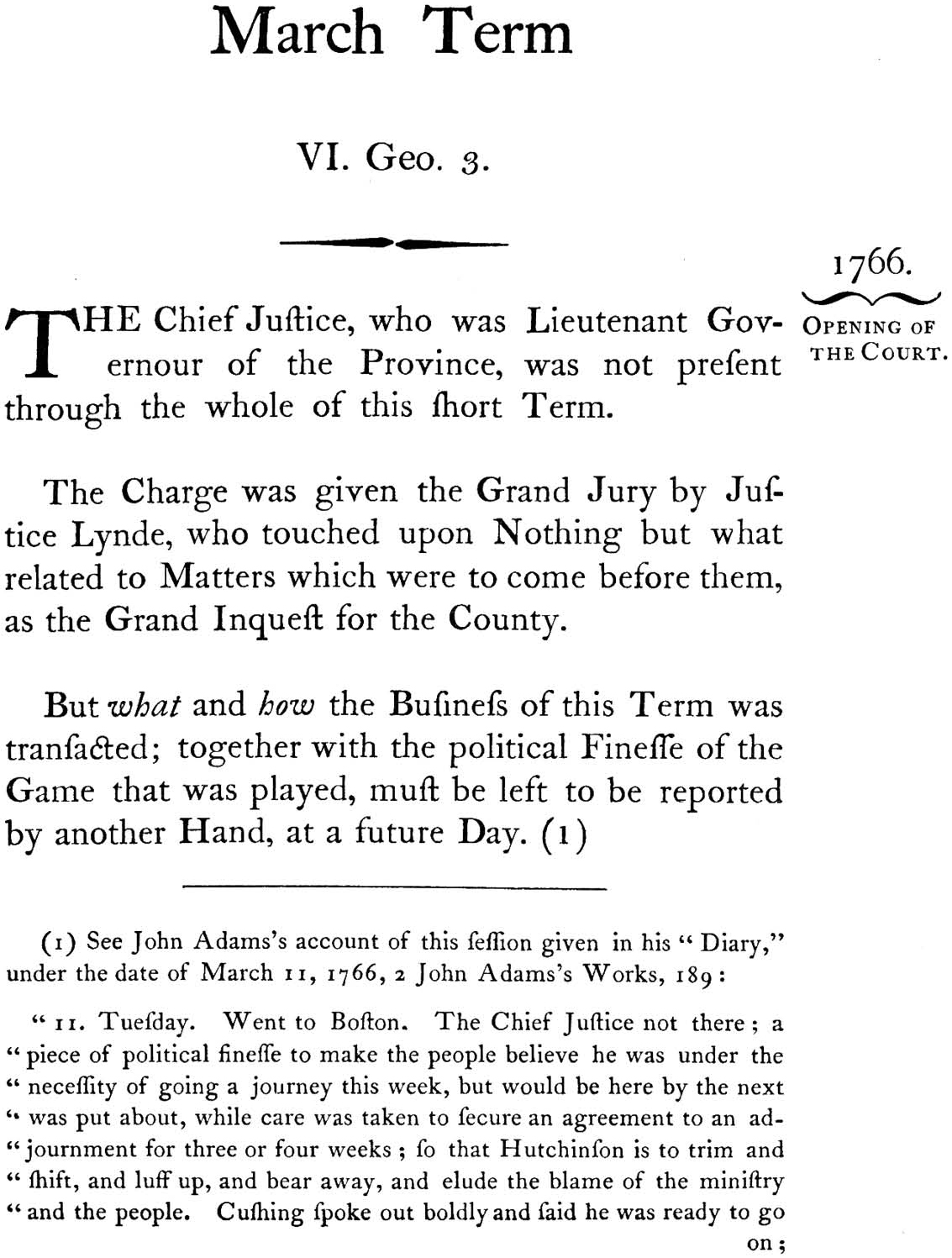
[P. 215]
Charge to The Suffolk Grand Jury by Justice Lynde
1766-March Term
note
The Court was on the horns of a dilemma. The Stamp Act had come into effect on November 1, 1765, and any official proceedings without compliance would be in contempt of Parliament. But it was also perfectly clear to all that compliance would bring about a riot, as would shutting the Court down completely.
Under these circumstances, Chief Justice Hutchinson made an excuse, and simply left town. See John Adams, Diary, March 11, 1766, Diary and Autobiography of John Adams, supra, vol. 1, 305. “So that Hutchinson is to trim, and shift, and luff up and bear away. And elude the Blame of the Ministry and the People.” Id. Three Justices, Cushing, Lynde and Oliver, said they were ready to go on, Lynde and Oliver pointing out that they were “under duress,” doubtless trying to cover themselves against the wrath of Parliament, while placating the populace by ostensibly being ready to hold proceedings. Cushing, the only justice to survive the Revolution, was, at least according to Adams, more courageously sympathetic to ignoring the Act. Id., vol. 1, 305. “Cushing spoke out boldly and said he was ready to go on.” Id. See Appendix 6, note 18. Russell died in 1766 and was replaced by Edmund Trowbridge in 1767. See brief biographies in Appendix 7.
As Quincy indicated, the term was a farce from a legal perspective and there was nothing worth noting in Justice Lynde’s Charge, except perhaps that the Chief Justice was not there to give it. The news of the Stamp Act repeal arrived in Boston on May 16, 1766, thus ending the crisis.
[P. 216]
[P. 217]
CHARGE NO. 4
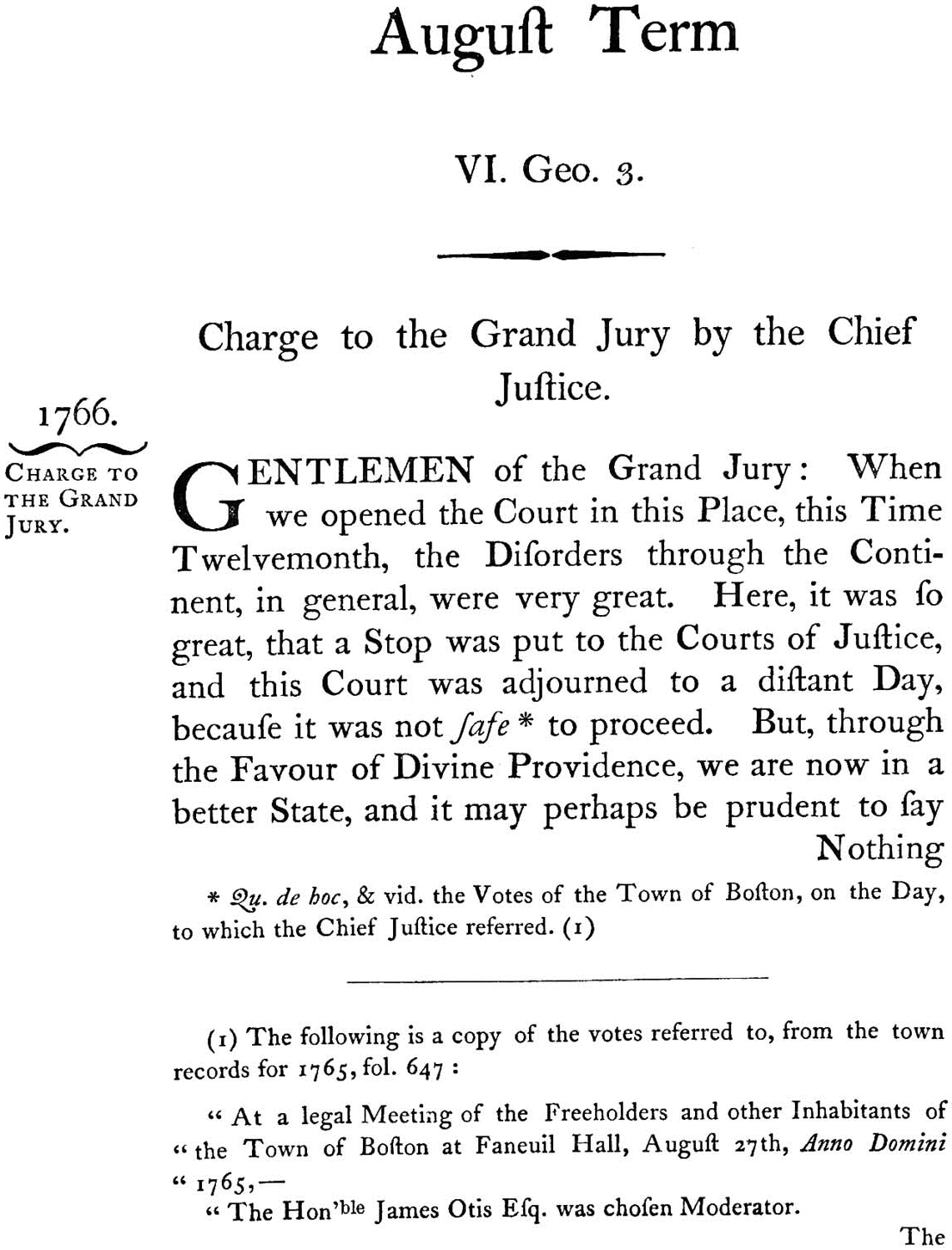
[P. 218]
Charge to The Suffolk Grand Jury by Chief Justice Hutchinson
1766-August Term
note
Having literally “skipped town” to avoid dealing directly with the Stamp Act dilemma in the August proceeding of 1765, Hutchinson was in a difficult diplomatic position opening the Court twelve months later. (Justice Lynde, by default, delivered the earlier charge. See Note, Reports, 215, Charge No. 3.) Hutchinson’s explanation, that “the Disorders” were “so great, that a Stop was put to the Courts of Justice,” appears to be questioned by Quincy, and the contemporary votes of the Town he referenced, set out by Samuel Quincy, certainly do not support the allegation. Naturally enough, Hutchinson suggested that “it may perhaps be prudent to say Nothing of what is past.” Reports, 219.
Nevertheless, Hutchinson had to observe that “for Persons under the Pretence of Rectifying publick Wrongs, to invade private Rights is highly criminal.” Reports, 219. As everyone in the courtroom knew, Hutchinson’s house had been attacked during a Stamp Act riot the previous August. See Reports, 168–174. The repeal of the Act on March 18, 1766, however, found Hutchinson, at least publicly, in a conciliatory mood, referring to the removal of “our Grievances” and suggesting that “it will be but for us to return to our usual Order.” Reports, 219. Certainly his pious hope that “an Attempt” would not be made again for the indefinite future, not perhaps during the lives of our “Children’s Children,” certainly overestimated the wisdom of Townshend in London, who was already planning new taxes. See the Note to the Charge for the August Term of 1765, Reports, 175, Charge No. 2, supra.
The charge is even more political than those preceding, emphasizing High Treason and Blasphemy. “Levying War against the King is High Treason, as where People set about redressing public Wrongs. . . .” Reports, 221. Even the regular charges on homicide and burglary are defined with care to include events that could occur during a riot, Reports, 232, and Grand Jury secrecy is, again, observed to be a problem-doubtless because such secrecy was becoming vital to the safety of government informants. Reports, 223. Only towards the end did Hutchinson finally focus on routine public safety, i.e., the increase of “day-time” robbery and tendency to “theft-bote,” i.e., buying back stolen goods. As was typical, Hutchinson made no citation to authority, relying on the “common law” of the English pleas of the crown. There is not even a reference to Dalton’s Countrey Justice or other treatises designed to aid laymen in administering criminal law. See Percy H. Winfield, The Chief Sources of English Legal History (Cambridge, Mass., 1925), 324–329.
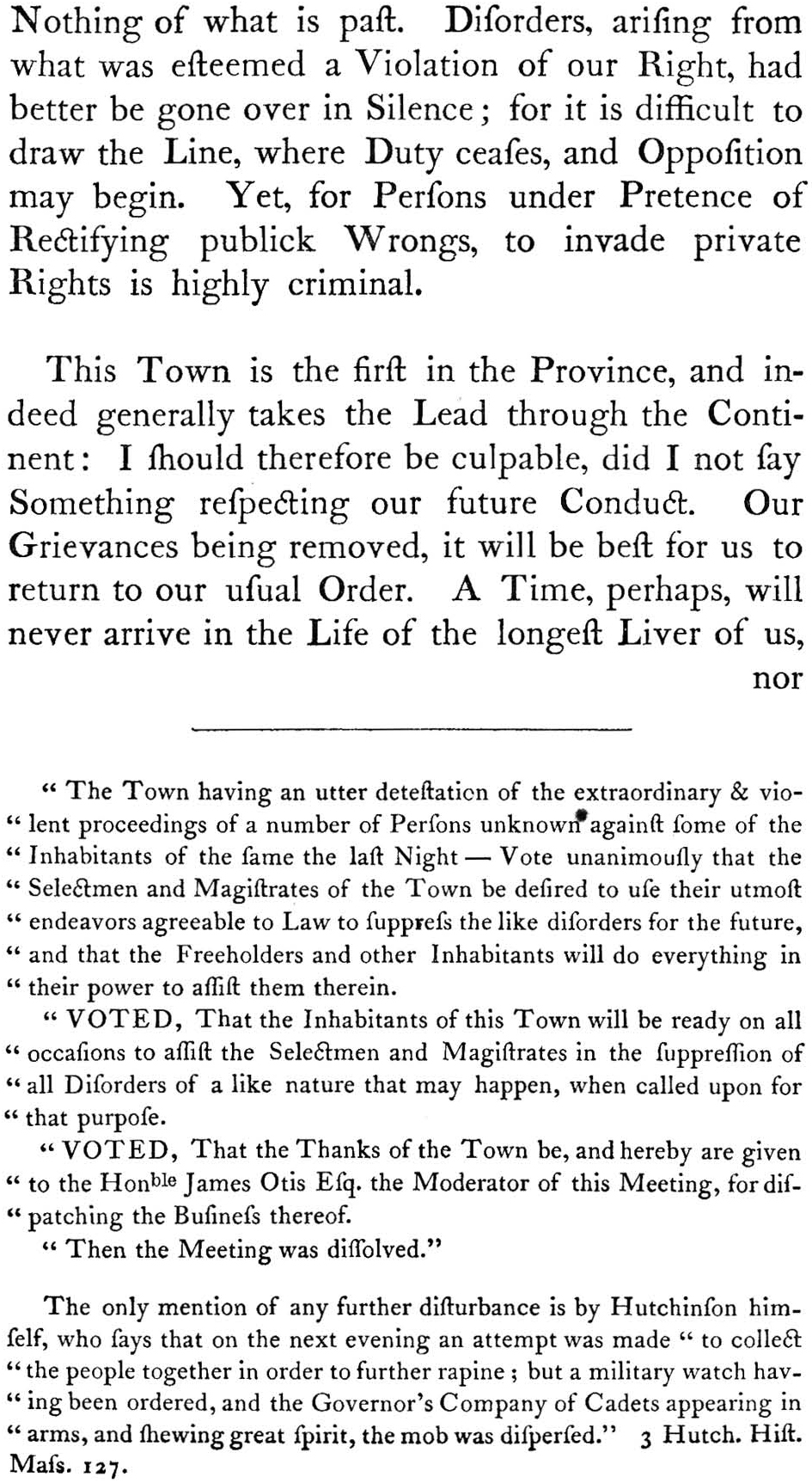
[P. 219]
Interestingly enough, this charge was cited in American Medical Ass’n v. U.S., 130 7 2d 233, 248 (1942) (D.C. Circuit Court of Appeal) in an appeal by two medical associations from their conviction of a conspiracy to restrain trade. In response to the argument that the trade restraints were committed with the purpose of enforcing the law, the Court of Appeals held that the restraints were not justified, and quoted Chief Justice Hutchinson’s language about “levying war against the King . . . as where people set about redressing public wrongs.” See Appendix 5, infra.
[P. 220]
[P. 221]
[P. 222]
[P. 223]
[P. 224]
ILLUSTRATION 10: Manuscript of Pynchon, Executor v. Brewster (1766), Reports, 224, Case 50. Courtesy, Massachusetts Historical Society. (P347, Reel 4, QP58)
CASE 51
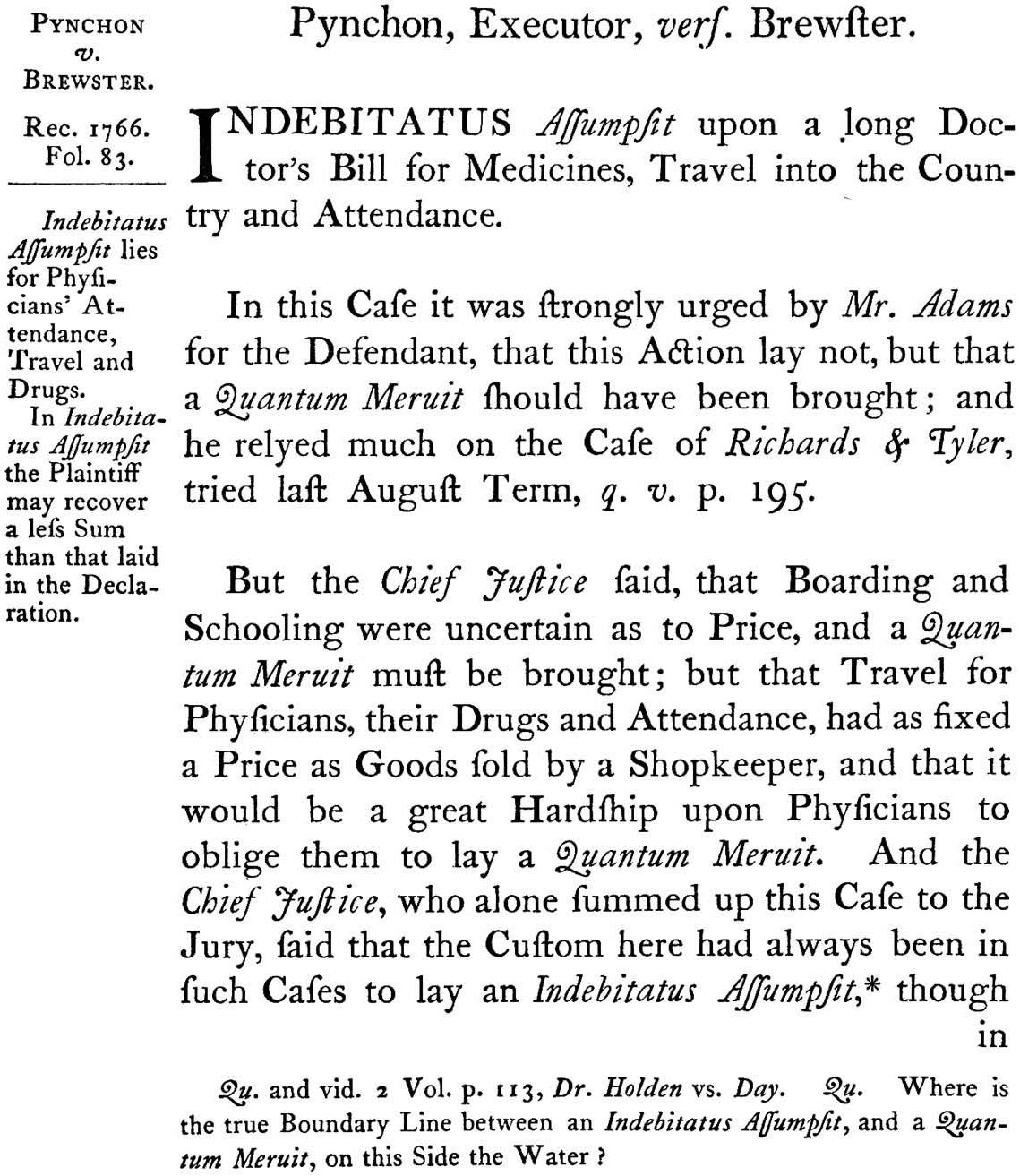
[P. 224]
Pynchon, Executor v. Brewster (1766)
6 George III (Aug.) in the Superior Court of Judicature
1 · brief description
This was an indebitatus assumpsit action to collect on bills for medical services owed to the deceased. The defense argued that the action should have been quantum meruit, as the prices had not been agreed. (See Tyler v. Richards, Administrator [1765], Case 50 for a description and their differences.) Held: indebitatus assumpsit by “custom” lay in such cases, even though there was no agreed price. In addition, although the case was indebitatus assumpsit, the Jury could reduce the account by £7, “to what they thought ‘reasonable.’” Reports, 225.
2 · court records
Available at Rec. 1766, fol. 83.
3 · professionals involved
John Adams (1735–1826), the Patriot, argued for the Defendant. It was not clear who represented the Plaintiff, if anyone. See short biography in Appendix 6. Adams was arguing against the indebitatus assumpsit action, and for quantum meruit as the proper remedy, which was exactly the opposite of his position, which lost, in Tyler v. Richards (1765), Reports, 195, Case 50.
4 · authority
Adams, naturally, “relyed much on the Case of Richards & Tyler tried last August term.” No other specific authority was argued, although Quincy mentioned Dr. Holden v. Day in his note challenging the outcome. This case was apparently reported in Quincy’s lost 2nd volume of his legal notebooks. See Law Commonplace, [21], n. 16. Quincy observed, “Where is the true boundary line between an indebitatus assumpsit, and a Quantum Meruit, on this Side the Water?” Reports, 224. Apparently the Justices believed that the law could be different between the colony and England. “This was solemnly affirmed by all the five Judges, in the Course of this Debate, to be Law here; though it was not, in Great Britain.” Reports, 225. See full discussion at Tyler v. Richards, Reports, 193, Case 50, supra, Notes 4 and 6.
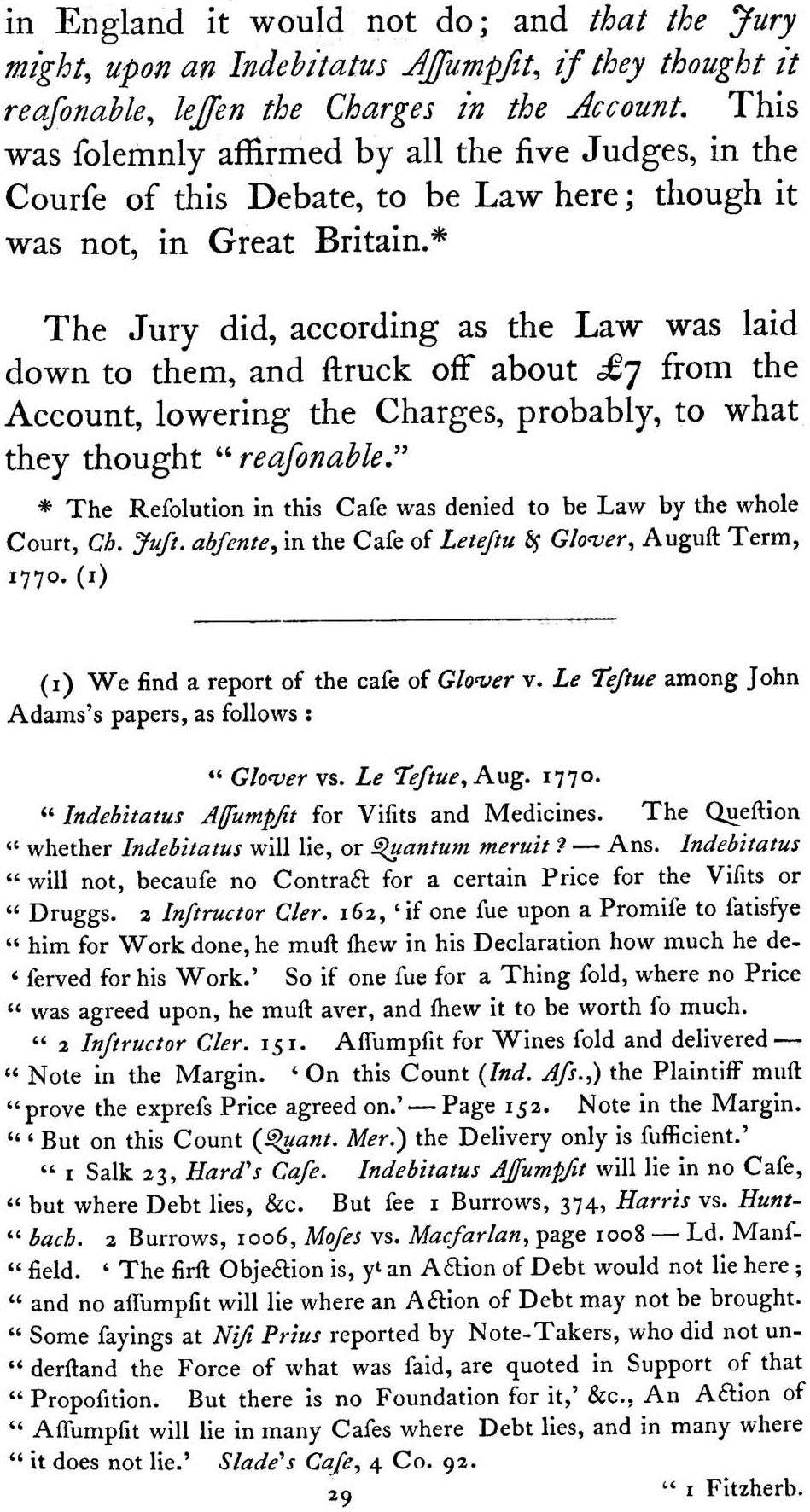
[P. 225]
5 · later citations
This issue was revisited again in August term, 1770 in Glover v. Le Testue. See Samuel Quincy’s note 1, Reports, 225; Legal Papers of John Adams (K. Wroth, H. B. Zobel, eds., 1915), vol. 1, 37, n. 31; Adams Papers, Microfilm, Reel No. 185. See also the pleading in Haynes v. Shaw, Legal Papers of John Adams, supra, vol. 1, 37–39. I have not found a citation to Pynchon v. Brewster in any of these later cases, and it was apparently overruled in Glover. “The Question whether Indebitatus will lie, or Quantum meruit?-Ans. Indebitatus will not, because no Contract for a certain Price for the Visits or Druggs.” See Reports, 225, S. Quincy n. 1.
6 · notes
Contracts are either express or implied. If the contract is express, the bargain is usually set out with particularity, and the defendant explicitly agrees. A usual action would be indebitatus assumpsit for the price agreed on. Problems arose where there was an express agreement but no specific price-as in the promise to “pay honourably” in Tyler v. Richards (1765), Reports, 196, Case 50, or where there was a specific account, with prices, as in this case. In one, the price is implied, and in the other, the consent is implied. The practical solution was to permit the Jury to protect the Defendant in both cases by limiting liability to what they believed was reasonable, a remedy which today would be regarded as “quasi-contractual.” In this case, they reduced the doctor’s itemized account by the substantial sum of £7. See Reports, 225.
The unresolved issue was one of legal theory. Indebitatus assumpsit counts “alleged very generally an indebtedness in a sum certain and a fictitious promise by the defendant to pay the debt.” See Legal Papers of John Adams, supra, vol. 1, 37, n. 31. (For a history of the development of the “fictitious promise” and the evolution of indebitatus assumpsit to supercede the old action in debt in most cases, see J. H. Baker, supra, 347–350.) In Massachusetts, an “immemorial practice” permitted an indebitatus assumpsit count on an account annexed, as here. Legal Papers of John Adams, supra, vol. 1, 37, n. 31. There were also the two quasi-contractual counts of “Quantum meruit” (“as much as he has earned”) to recover the value of the plaintiff’s services, or “Quantum valebant” (“as much as they were worth”) to recover the value of goods supplied. See P. G. Osborn, supra, 261. So which cause of action best fits cases where either the promise or price was implied, and the jury was free to adjust recovery to a “reasonable” amount?
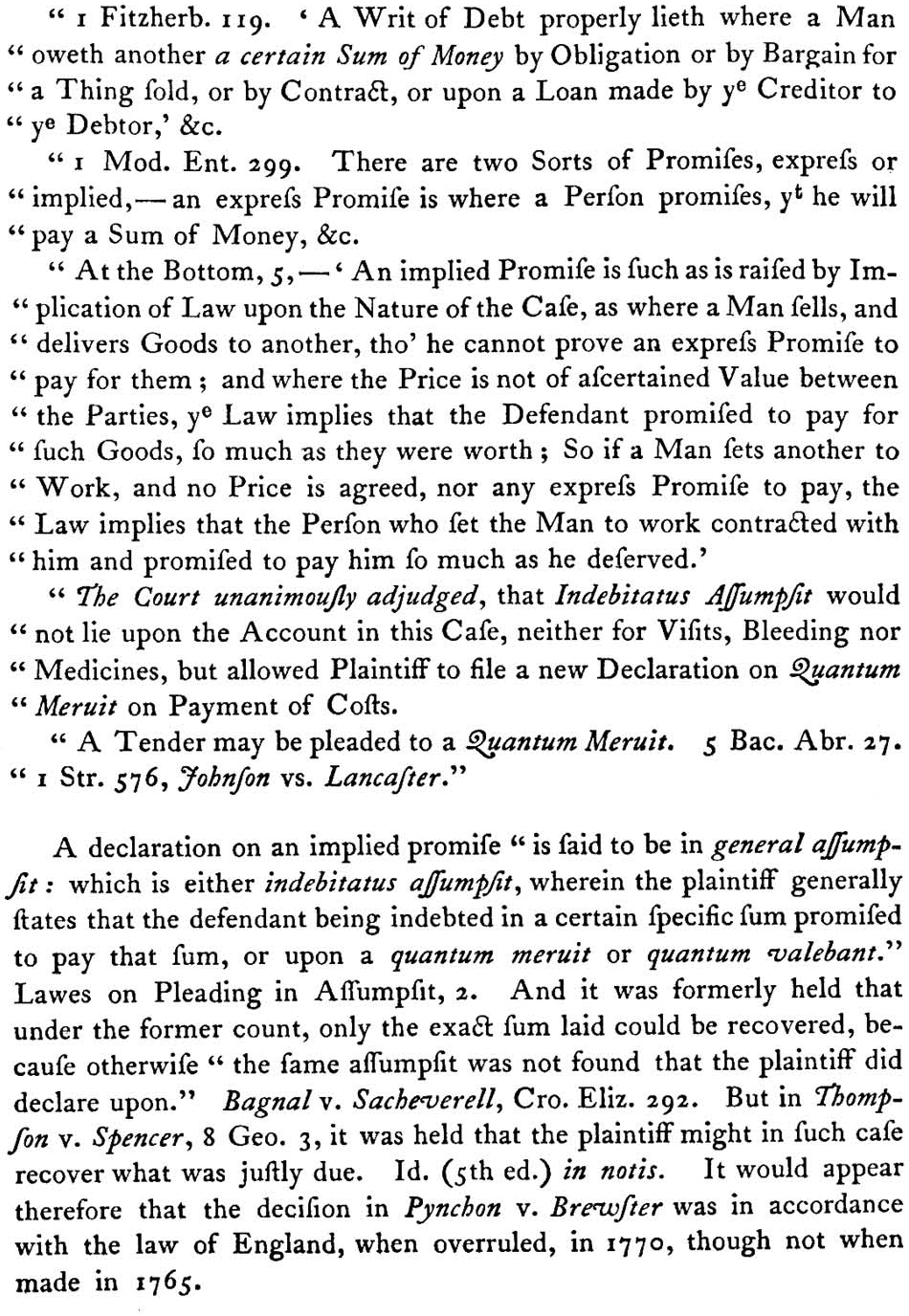
[P. 226]
The final resolution in Glover v. Le Testue makes sense. The indebitatus assumpsit action should be reserved for general contracts where there is “a certain Price,” and the plaintiff can receive the “benefit” of an express bargain. Otherwise, the goal is to prevent unjust enrichment, and the action should be quasi-contractual. This reasonable outcome would be consistent with Tyler v. Richards (1765), Reports, 196, Case 50, but not the decision in this case. “It became usual for a plaintiff to declare alternatives upon an Indebitatus assumpsit, where he claimed a fixed sum of money, and upon a Quantum meruit, where he claimed a reasonable sum.” See C. H. S. Fifoot, History and Sources of the Common Law: Tort and Contract (London, 1949), 363–371, describing English law of the early eighteenth century. But, as Samuel Quincy observed, indebitatus assumpsit evolved in England to include such “just recovery” cases. Reports, 226, S. Quincy n. 1. Samuel Quincy cited Edward Lawes’ A Practical Treatise on Pleading in Assumpsit, of which an 1811 edition was published in Boston with additions from American Courts. Citations to Bagnal v. Sache-verell and Thompson v. Spencer can be found in the notes on page 330. See also Tyler v. Richards (1765), Reports, 195, Case 50, Note 6. This evolution occurred through the development of the “common” or “indebitatus” counts, and the eventual adoption of the Common Law Procedure Act of 1852. See the discussion at C. H. S. Fifoot, supra, 363–371.
CASE 52
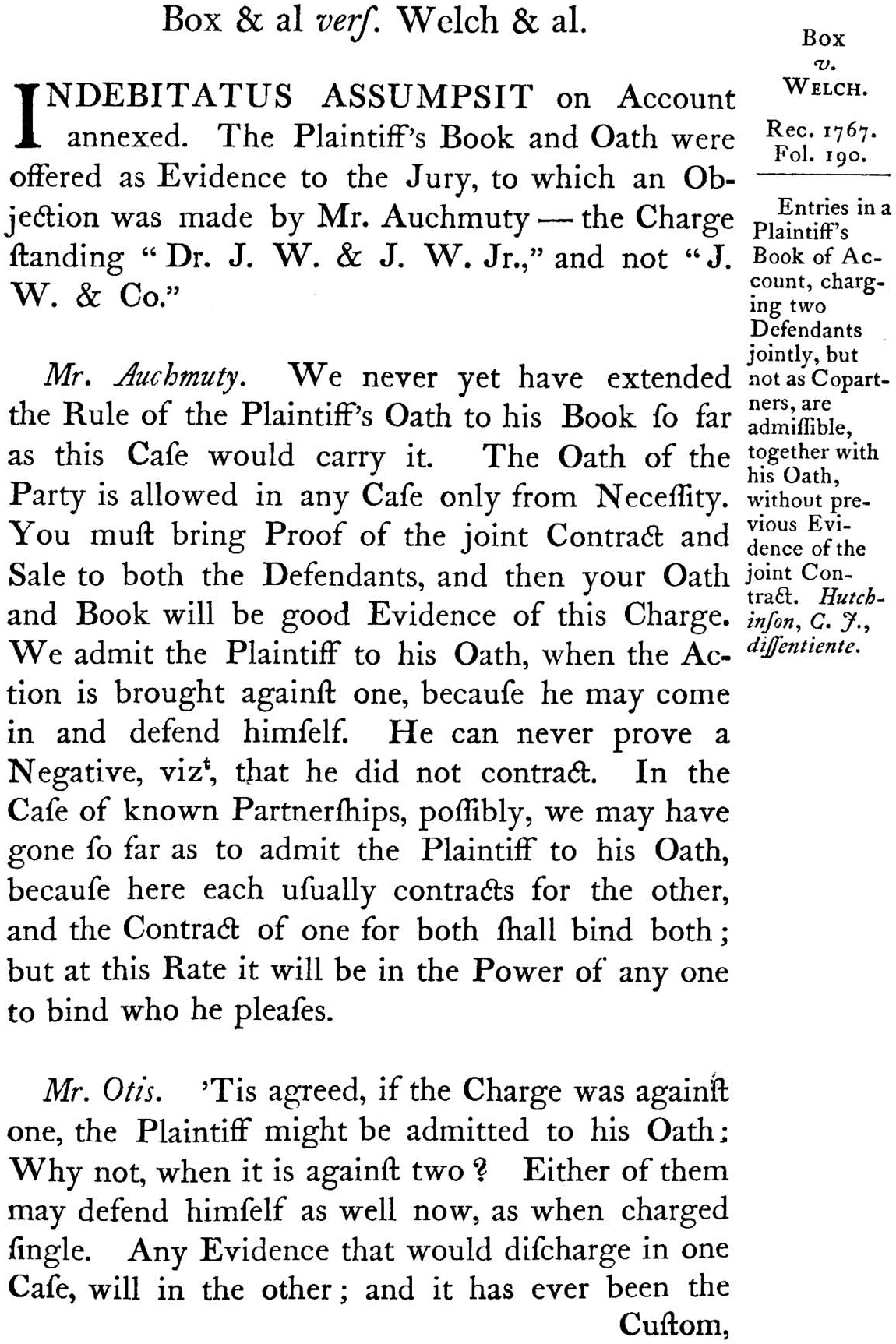
[P. 227]
Box & al v. Welch & al. (1767)
6 George III (Aug.) in the Superior Court of Judicature
1 · brief description
Another case of indebitatus assumpsit “on account annexed,” but this time the sole issue was whether the Plaintiff’s account book, supported by his oath, could go to the jury as to two Defendants “Dr. J.W. & J.W. Jr.,” rather than just one, in the absence if any “proof of joint contract and sale to both.” Held: the book and oath can go to the jury, who will then judge “all the Circumstance,” with Chief Justice dissenting.
2 · court records
Available at Rec. 1767, fol. 190.
3 · professionals involved
Robert Auchmuty (1723–1788) for the Defendant and James Otis Jr., the Patriot (1725–1783), for the Plaintiff. See biographies at Appendix 6. This case is an excellent example of free exchange between the bench and bar. In the absence of formal judicial opinions, Quincy’s notes of such exchanges give us our best idea of how and why colonial judges decided cases. See discussion at Note 6, infra.
The Chief Justice was a common dissenter on the Court, second only to Justice Oliver. See Appendix 1, infra.
4 · authority
None cited.
5 · later citations
None.
6 · notes
Auchmuty argued that, where there is no corporation or partnership, the Plaintiff who names two, or more, jointly liable Defendants must introduce proof of joint liability before the account and oath goes to the jury. The response, by Otis, was that the two Defendants could defend themselves just as well as one. “Either of them may defend himself as well now, as when charged single.” Reports, 227.
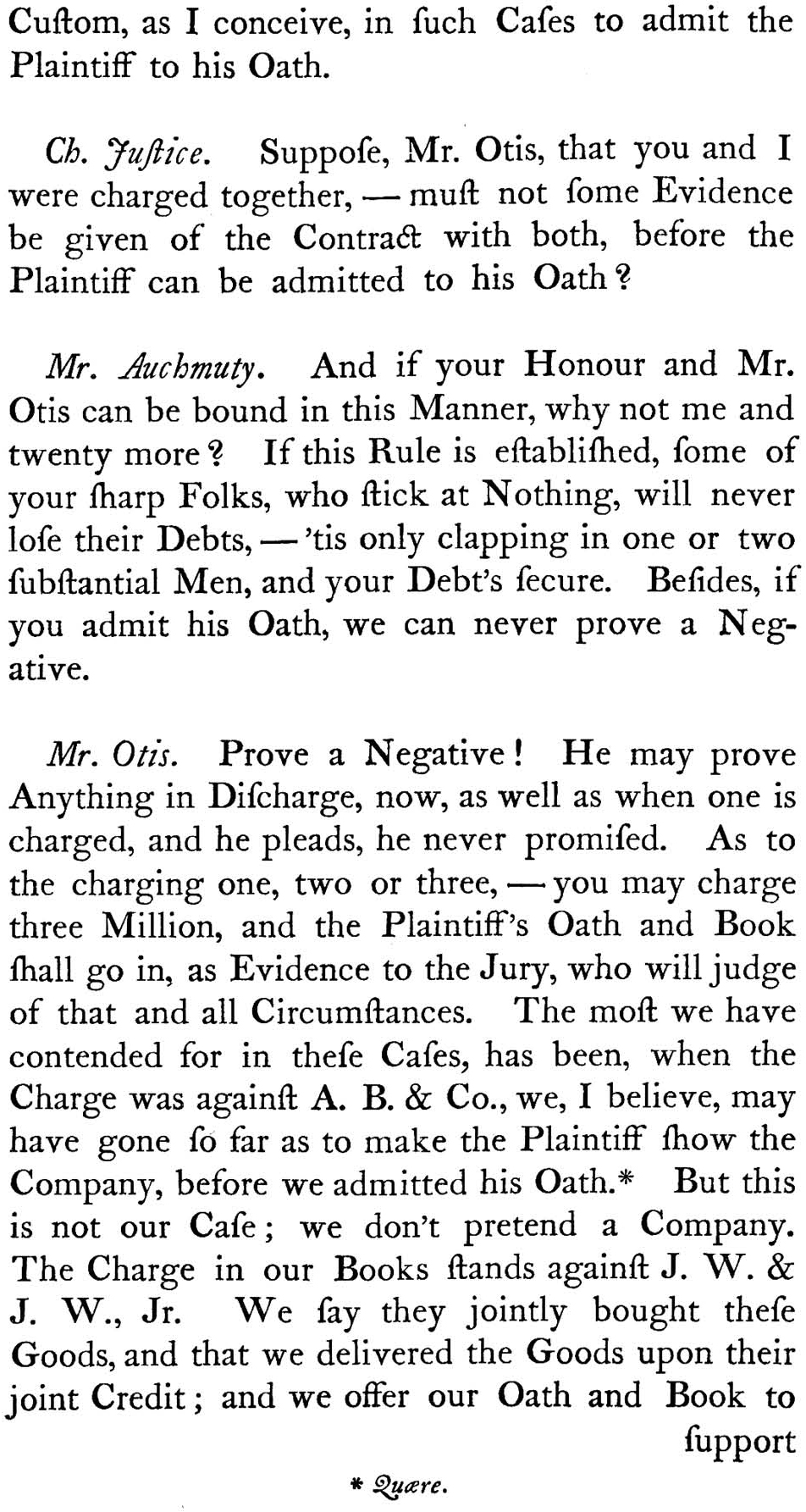
[P. 228]
The Chief Justice was sympathetic to Auchmuty’s argument, apparently to discourage vexations recovery actions. As Auchmuty observed, “If this Rule is established, some of your sharp Folks, who stick at Nothing, will never lose their Debts,—’tis only clapping in one or two substantial Men, and your Debt’s secure.” Reports, 228.
Otis’s answer, of course, was that the Jury can figure this out easily enough. If a co-defendant pleads “he never promised,” the Jury will want credible evidence of the promise. The real issue was whether the jury or the bench, should decide. Reports, 228–229. Four of the five Justices agreed that it was for the Jury “who would judge of all the Evidence with all the Circumstances.” Id., 229. The Chief Justice dissented. Thus the significance of the case lies in the reaffirmation of jury power to decide factual issues.
[P. 229]
ILLUSTRATION 11: Apthorp House (1760). Now part of Adams House, Harvard College. Photograph c. 1885–1895. This was the home of East Apthorp, minister of Christ Church. See Bainbridge Bunting, Harvard: An Architectural History (Cambridge, Mass., 1985), 184, 186. The Rev. Apthorp was one of the eighteen children of Charles Apthorp, the wealthy founder of the Apthorp dynasty. He was brother to Charles Ward Apthorp of the Apthorp Company, and brother-in-law to Nathaniel Wheelwright, the spectacular bankrupt. See Apthorp v. Eyres (1766), Reports, 229, Case 53, and Patershall v. Apthorpe & Wheelwright (1765), Reports, 179, Case 46. My special thanks to Mark G. Sullivan. Courtesy of the Cambridge Historical Society, 3A.00274 chs.
CASE 53
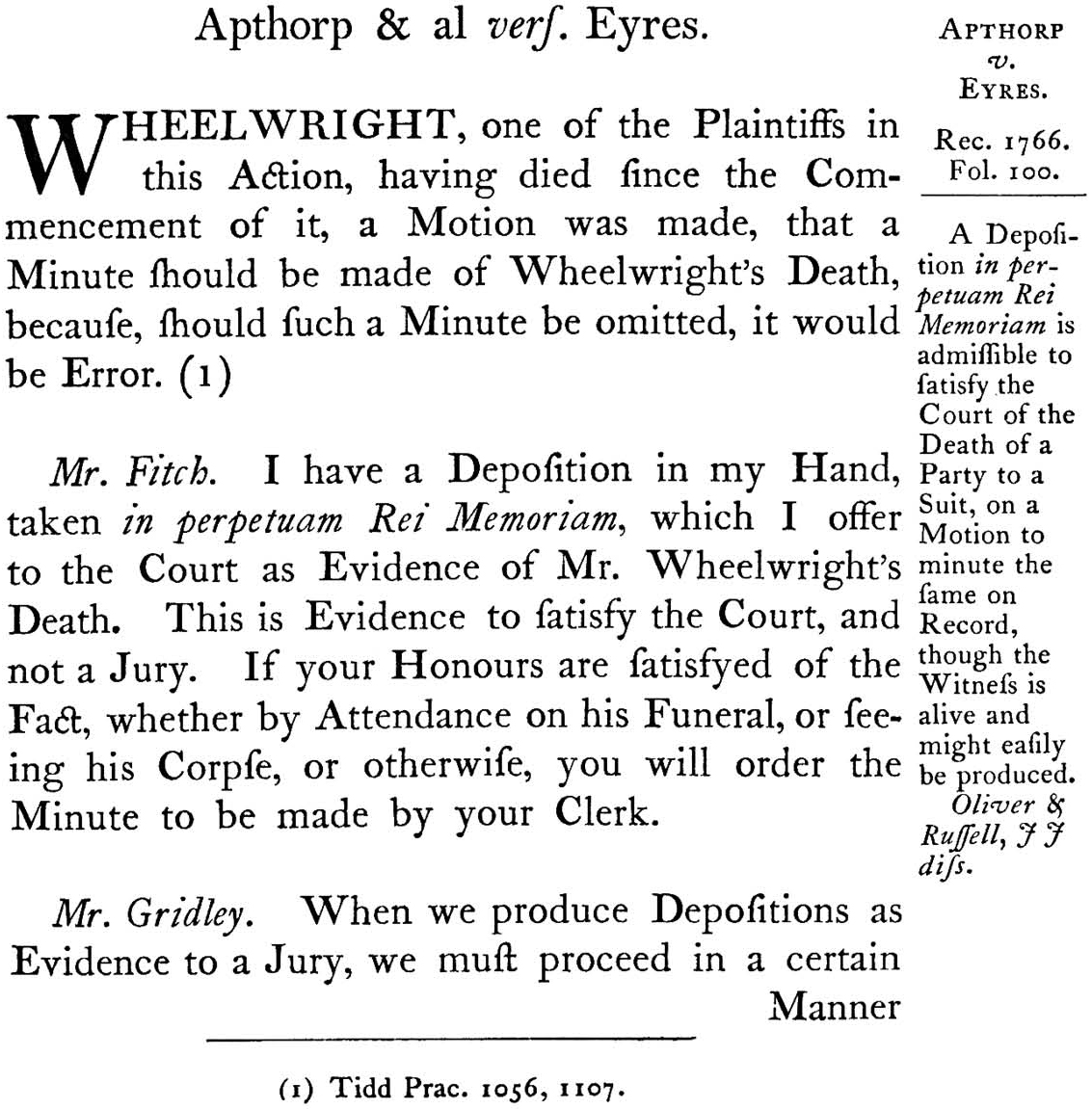
[P. 229]
6 George III (Aug.) in the Superior Court of Judicature
1 · brief description
The sole issue in this case was whether a deposition could be admitted to satisfy the court of a fact, when the witness was easily available. (The “Home,” or English, Law would require production of the witness.) Held: by a closely split court, three Justices to two, the deposition was admissible, the Chief Justice distinguishing between evidence to the Court and stricter rules for evidence to a jury. Reports, 231.
2 · court records
Available at Rec. 1766, Fol. 100.
3 · professionals involved
Samuel Fitch (1724–1799) and Jeremy Gridley (1701/2–1767) proposed the admission of the deposition as evidence of Plaintiff Wheelwright’s death. Robert Auchmuty (1723–1788) was in opposition. See short biographies in Appendix 6, infra. The Justices split, with Justices Oliver and Russell against admission, and Justices Cushing, Lynde, and the Chief Justice for admission. Close splits were rare, 58 out of 78 of the decisions were unanimous. Oliver was a leading dissenter, with seven dissents. Russell had three. See Appendix 1, infra.
4 · authority
The only authority cited was by Gridley to Lilly’s Collection of Modern Entries: or, Select Pleadings in the Court of King’s Bench etc. (London, 1723, 1st English edition, London, 1741), 44, to establish that “[a]ll the great Courts at Home constantly produce Affidavits to such Points.” Reports, 230. Auchmuty denied that, stating “Affidavits are received at Home when properly taken, but the Courts never receive them, when improperly taken.” Id., 230. Quincy added a citation from one of his favorite reports, Lord Raymond, Faux v. Barnes (1697), Lord Raymond’s Reports, 174 (London, 1743), translated into English, 2nd ed., 1765.
[P. 230]
5 · later citations
None. Samuel Quincy noted that Massachusetts law did not follow Apthorp v. Eyre in creating a “two-track” stand for deposition. Rather, depositions submitted to the Court must meet the standards for use at trial. Reports, 231.
6 · notes
As a practical matter, this case was ridiculous. Nathaniel Wheelwright’s spectacular bankruptcy had made him one of Boston’s most notorious citizens, and his death of yellow fever was as well known as that of Elvis Presley or Michael Jackson today. See J. L. Bell, “A Bankruptcy in Boston, 1765,” Massachusetts Banker (4th quarter, 2008), 14. (My gratitude, as always, to Mark E. Sullivan.) As Fitch argued, “If your Honours are satisfied of the Fact, whether by Attendance on his Funeral, or seeing his Corpse, or otherwise, you will order the Minute [of death] to be made by your Clerk.” Reports, 229. See Illustrations 17 and 18, supra.
The legal issue was whether the Court would follow English formalities, i.e., of the “great Courts at Home.” Oliver and Russell supported formality, at least when it was “easy” to produce a witness and satisfy the technical rule. Justices Cushing, Lynde and the Chief Justice thought the formality was pointless, as they were, in Lynde’s words, “satisfy’d of the Fact.” Reports, 230.
[P. 231]
ILLUSTRATION 12: Chief Justice Hutchinson caricatured. Ezra Gleason, The Massachusetts Calendar; or an Almanack (Boston, 1774), cover.
CHARGE NO. 5
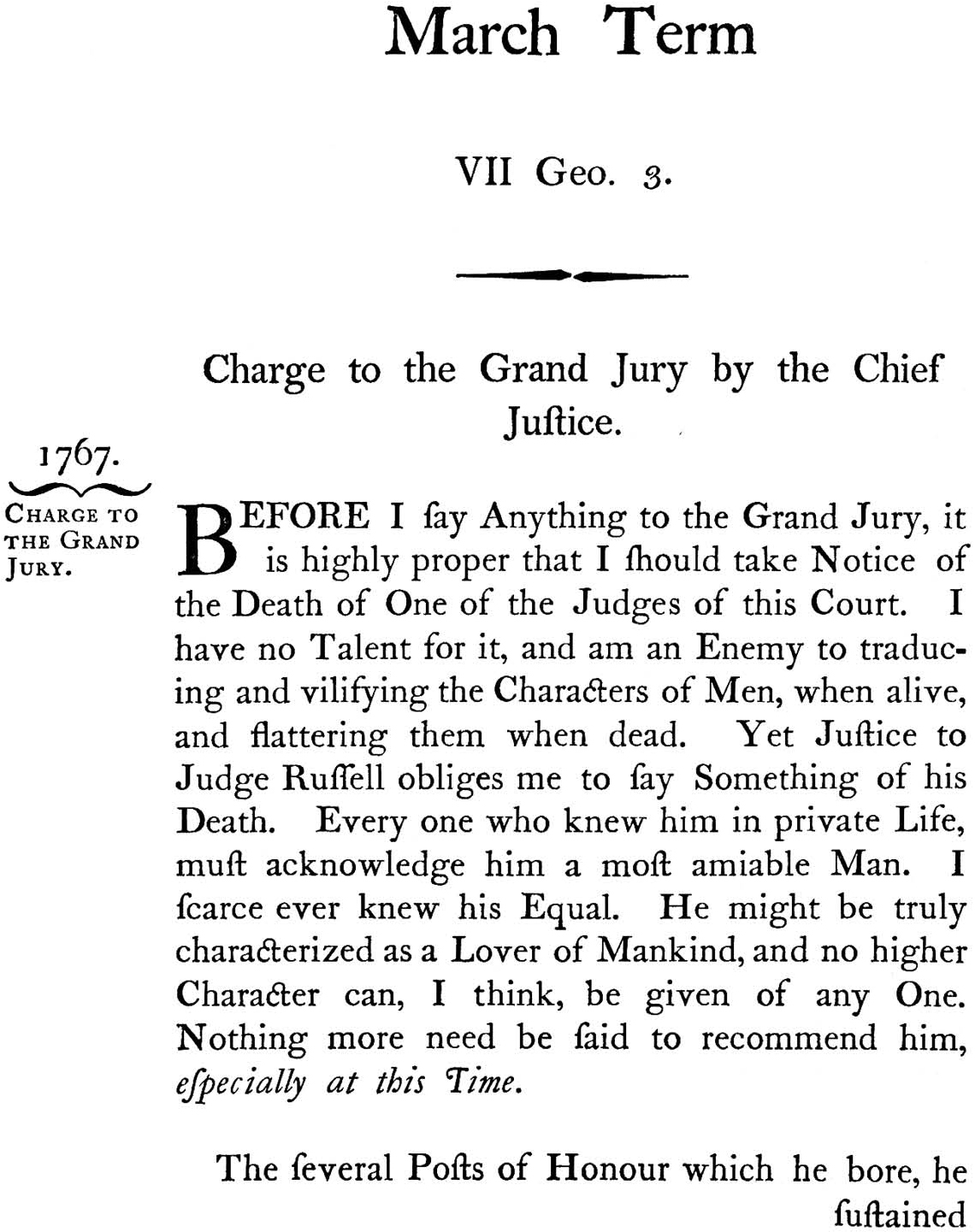
[P. 232]
Charge to The Suffolk Grand Jury by Chief Justice Hutchinson
1767-March Term
note
Hutchinson began this charge with a pointed reference to the character of Judge Chambers Russell (1713–1766), recently deceased. Russell had been appointed to the Court after a term as Judge of the Inferior Court of Common Pleas for Middlesex and as Vice Admiralty Judge. He was, by all accounts, an amiable moderate. See a brief biography in Appendix 7, and in William T. Davis, History of the Judiciary of Massachusetts (Boston, 1900), 91–92. Hutchinson made a pointed reference to this virtue. “Nothing more need be said to recommend him, especially at this Time.” Reports, 232 (original italics). His purpose was obvious, to encourage the grand jurors to set aside “Party-spirit and Animosities” and just do their job according to the law.
In the body of the charge, Hutchinson emphasized the point that the judiciary should follow the will of the legislature, and not be a law unto itself-another obvious warning against jury activism. In so doing he used an unfortunate phrase, which he would later regret, arguing from a “well-known Maxim,” that “the Judge should never be the Legislator.” Reports, 234 (original italics). This would later be seized upon by an article in the Boston Gazette of April 27, 1767, signed by a “Freeborn American,” which observed that “this very Judge for a long time was elected a legislator, and served as such,” overlooking-to Hutchinson’s fury. See a full discussion at Notes, Charge No. 6, Reports, 241.
It was obvious that civil order was problematic, despite the repeal of the Stamp Act. “’Tis to be hoped we are returning again to good Order.” Reports, 234. Hutchinson also pointedly emphasized to the jurors that the “principal Crown-Law of this Province is grounded on our provincial Laws.” Id., 235. Only “where these fail,” does one turn to the “Common Law of England.” Id., 235. With a special mention of blasphemy and treason, Hutchinson then went through the usual list of domestic crimes, concluding with another appeal for bipartisanship, mutual respect and-particularly-avoiding the press. “[L]et us not slander and traduce one another’s Characters. We might well quarrell, and destroy Men for their different Looks or Complexions. But to reproach and vilify each other in publick Print, is a Crime of a much higher Nature. . . .” Id., 236. To Hutchinson, the Boston Gazette was a greater threat to “all in Authority” than racism!
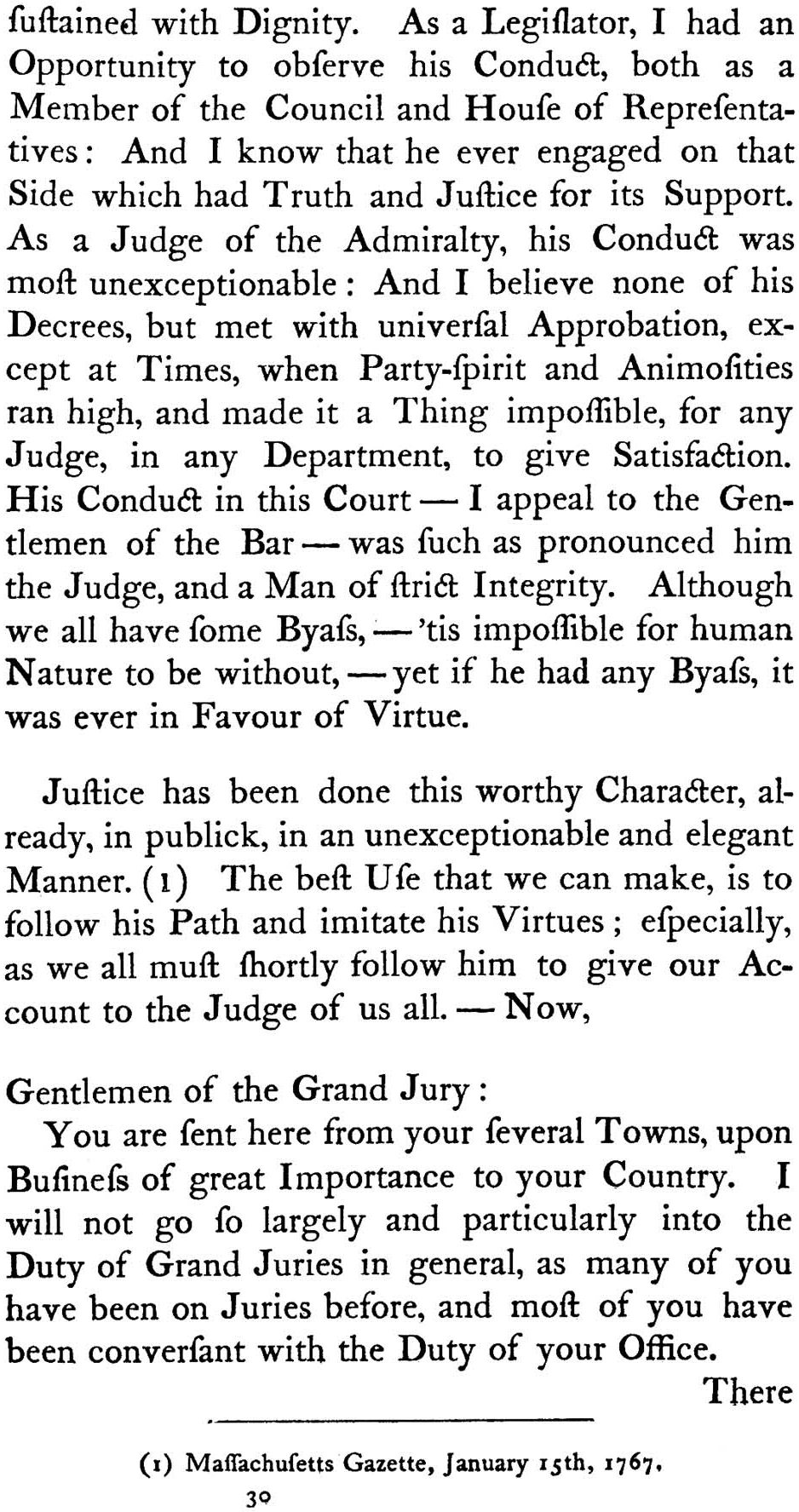
[P. 233]
[P. 234]
[P. 235]
[P. 236]
[P. 237]
CASE 54

[P. 237]
7 George III (March Term) in the Superior Court of Judicature
1 · brief description
This was a plea in abatement on the grounds that the writ described Defendant Lovejoy as “Yeoman” when he held a Captain’s Commission, and was thus a “Gentleman.” Held: where the Defendant was a gentleman by commission and “curtesy,” the writ must abate for calling him “Yeoman.” Otherwise, if he was a gentleman, “by reputation only.”
2 · court records
Available at Rec. 1767, fol. 190.
3 · professionals involved
Appearing for the Plaintiff was James Otis Jr. (1725–1783). Appearing for the Defendant was Robert Auchmuty (1723–1788). See short biographies in Appendix 6, infra.
4 · authority
Both sides cited extensive English authority as to this ridiculously technical point. Viner’s General Abridgment of Law and Equity (London, 1741–1753) was cited by Otis for the quite sensible point that both the term “Yeoman” and “Gentleman” are not essential parts of the name but “additions ad Libitum [“at pleasure”].” See Jowitt, supra, 52 [as in “ad lib.”]. Auchmuty rather lamely relied on Edward Coke’s First Institutes (London, 1628) and Second Institutes (London, 1642), described at Law Commonplace, [2], n. 1, [7], n. 9 and [21], n. 6, supra. (Neither citation was in point.) Quincy added a citation to Lord Raymond’s Reports (London, 1743), one of his favorite reporters. The case was Bennett v. Purcell (1702), vol. 2, 849. See Law Commonplace, [26], n. 2. He further cited Bacon’s Abridgement (London, 1736). See Law Commonplace, [37], n. 5. Quincy’s authorities were on point, and the Bacon’s Abridgement states that where “a Yeoman is named Gentleman; and such Matter is pleaded in Abatement; and found for the Person who pleads it, the Writ shall abate.” Id., vol. 3, 618. Further, Bacon, supra, referred to the statute 1 Hen. 5, Cap. 5 (1413) requiring “in every original Writ of Actions . . . additions shall be made for heir [the defendants] Estate or Degree.” Id., vol. 3, 617–618.
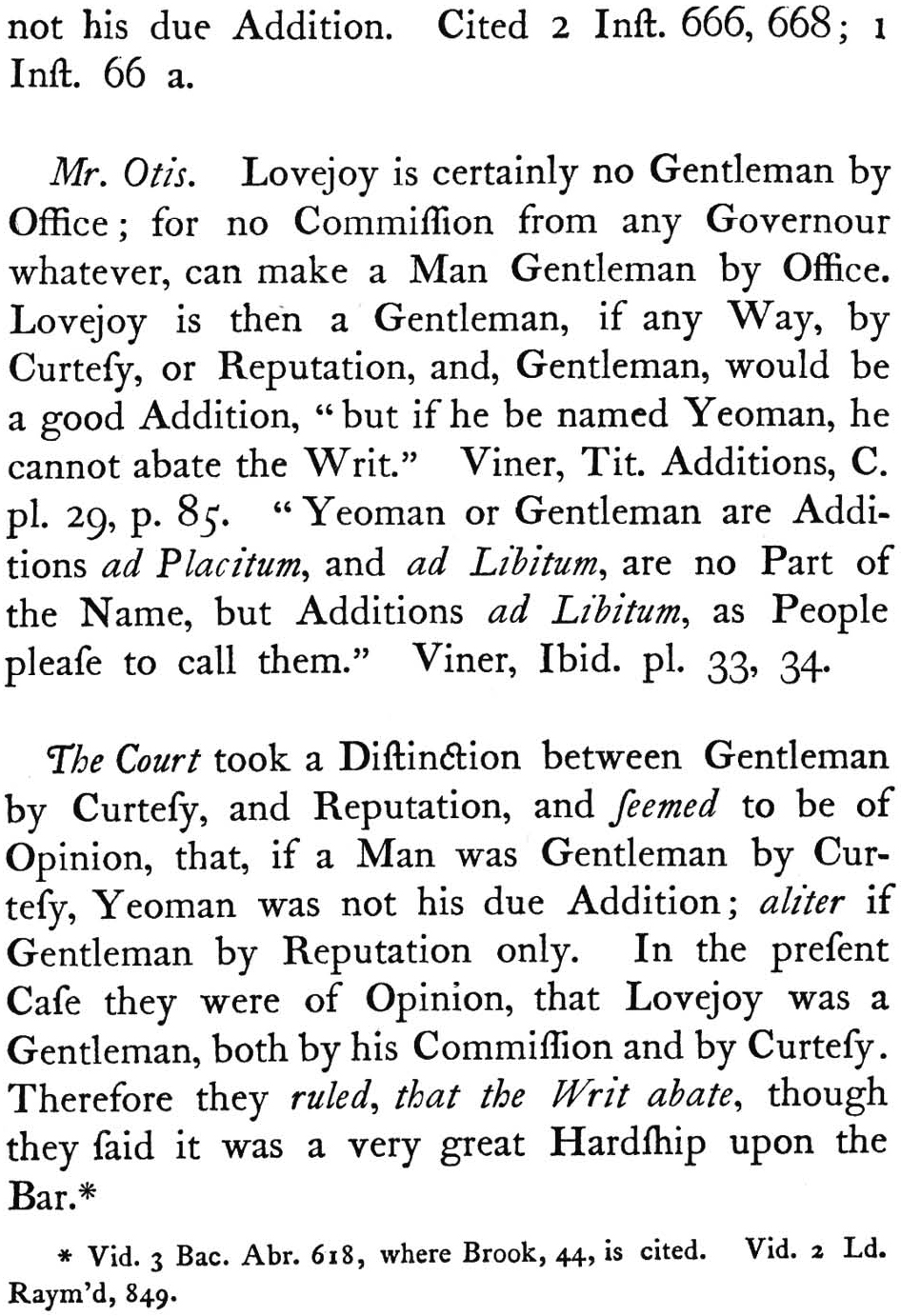
[P. 238]
5 · later citations
None.
6 · notes
This case, ridiculous to a modern perspective, was a triumph of formalism over convenience and justice. The Court in abating the writ, admitted that the decision was “a very great Hardship upon the Bar.” Reports, 238. The only practical concession was the apparent distinction between “Gentleman by curtesy,” i.e., one whose official position or title confers the status, and “Gentleman by Reputation,” where it was an issue of breeding and social rank. See the complex definition in Coke’s Second Institutes (London, 1642), 666, 668, cited by Auchmuty. (Quincy reported that the Court “seemed” to make that distinction. Reports, 238.) In this case, the captain’s official commission created a “Gentleman by Curtesy,” so “Yeoman was not his due addition.” The pleader, one supposes, would have some notice of such official titles or commissions. Where it was just an issue of “reputation,” the addition to name would not abate the writ. Even so, this type of technicality was, truly, “a very great Hardship upon the Bar.” Id., 238.
CASE 55
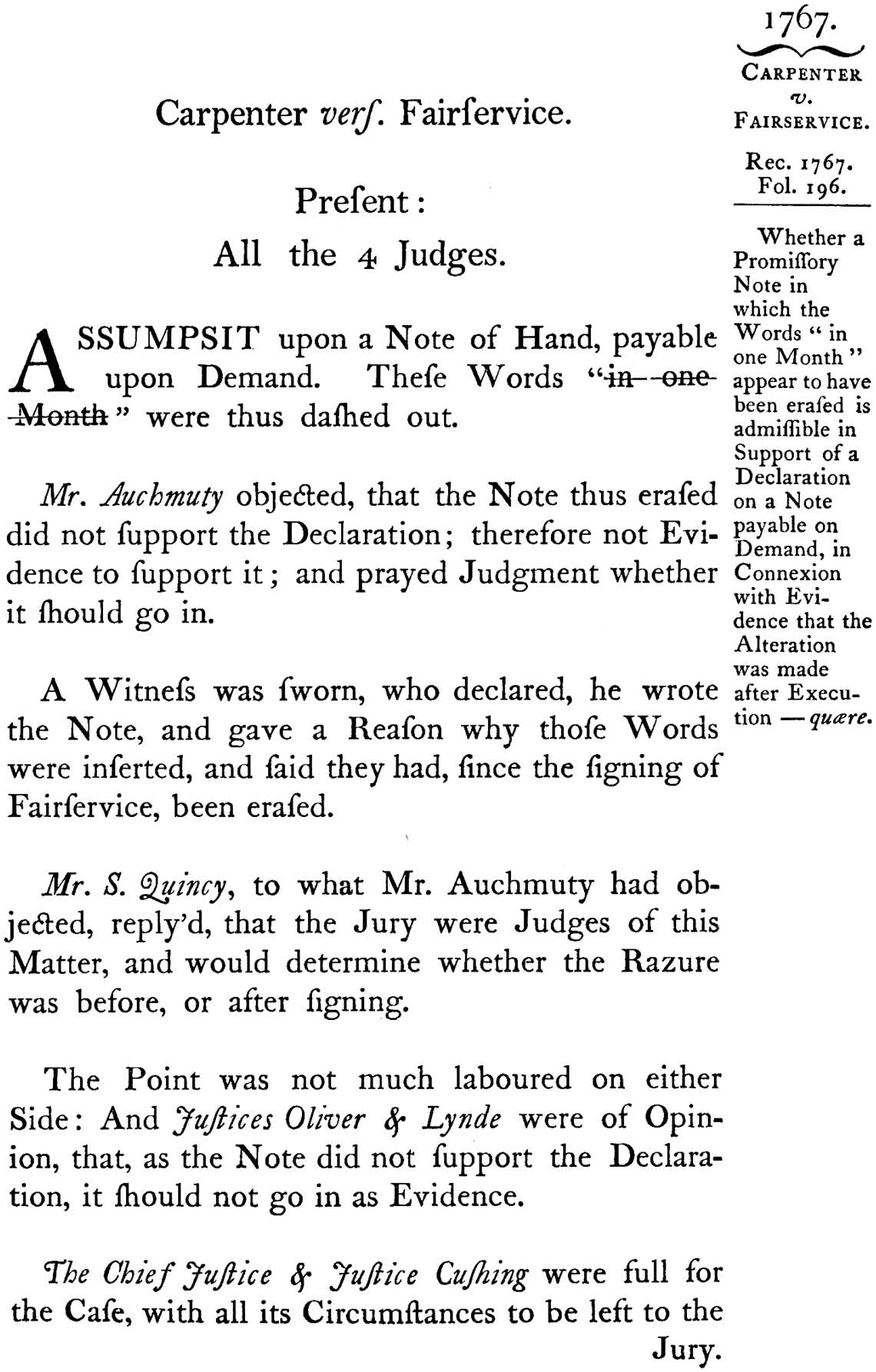
[P. 239]
Carpenter v. Fairservice (1767)
7 George III (March Term) in the Superior Court of Judicature
1 · brief description
This was an action of assumpsit upon a note, payable on demand. The note itself had the words “in one Month” crossed out. The Plaintiff had a witness ready to testify that the words were crossed after the note was signed by the Defendant. If so, the Defendant should be held to the note with the words intact. Otherwise, the declaration was faulty, and the action should be dismissed. The issue was whether the note should go to the Jury to decide whether the “razure” was before or after signing. The Court split equally-there being only four appointed Justices-so decision for the Defendant that the note does not support the action as a matter of law, and, thus, cannot go to the jury. Plaintiff paid costs.
2 · court records
Available at Rec. 1767, fol. 196.
3 · professionals involved
Robert Auchmuty (1723–1788) appeared for the Defendant and Samuel Quincy (1734–1789), the Reporter’s brother, appeared for the Plaintiff. See the short biographies at Appendix 6, infra.
The Court consisted of only four Justices, as Edmund Trowbridge (1709–1793) had not yet replaced Chambers Russell (1713–1766). See Appendix 7, infra, for short biographies and succession chart. Technically, the Chief Justice and Justice Cushing were “in dissent,” as the Plaintiff lost due to the evenly divided Court. Split courts were unusual. See Appendix 1, infra. Oliver and Lynde were the prevailing justices.
4 · authority
None cited. Quincy noted that Norwood v. Fairservice (1765), Reports, 189, Case 47, supra, was relevant. In that case, an indenture with different rents on each copy of the deed was permitted to go to the jury, although Lynde originally thought it was an issue of law for the Court, “[a]s the Practice of the Court has always been . . .” Reports, 191. In Norwood, Oliver originally was for sending the document to the jury. “This properly belongs to the Jury. I am for admitting it to go in.” Reports, 191. He then changed his mind, after hearing Gridley’s estopped argument. “I think it can’ t be admitted.” Id., 192. The Chief Justice was for changing the custom of court review, and voted in both cases to send the document to the Jury. “I know the Custom has been otherwise, but, for my Part, I think ’tis Time it was altered-am for admitting it.” Id., 191.
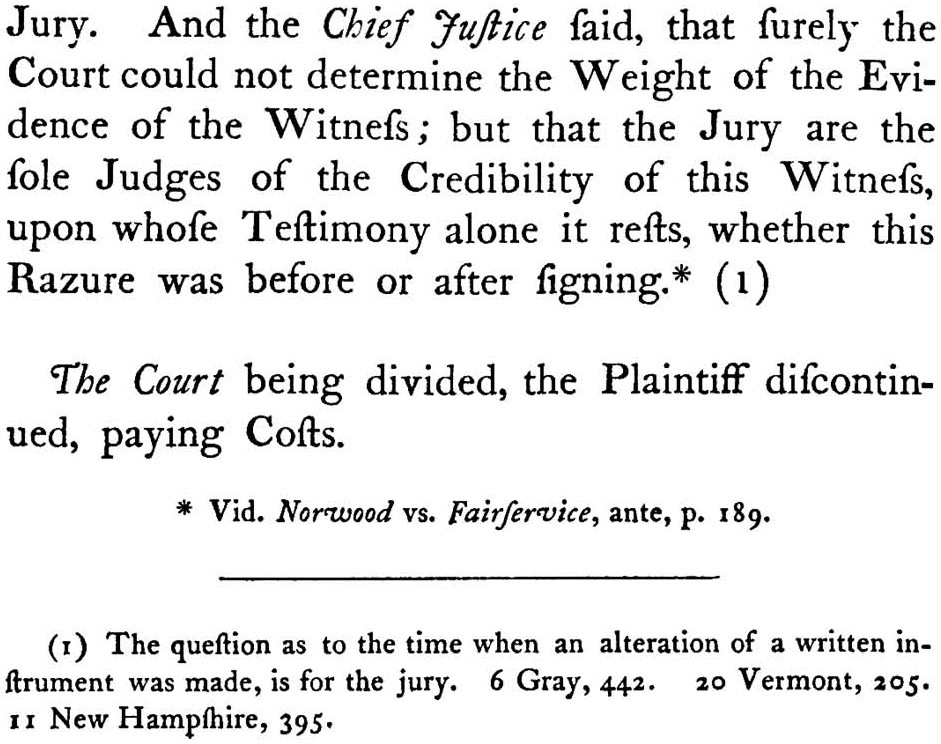
[P. 240]
In this case, Oliver and Lynde stuck by their view, and the Chief Justice stuck by his. In cases where there was no alteration of the document alleged, but where the legal significance was challenged, the Court unanimously agreed it should go to the Jury-as the legal issues would come to the Court on special verdict. See the discussion in Gibbs v. Gibbs, Reports, 251, Case 57, infra, Note 6.
5 · later citations
None. As Samuel Quincy pointed out, later Massachusetts law has consistently held that the time of an erasure or alteration to a document was a question of fact for the Jury. See Reports, 240, S. Quincy n. 1.
6 · notes
This case continued the debate as to whether the Court or the Jury should decide whether a document or instrument supported an action. The Court was closely divided on the issue, as both this case and Norwood v. Fairservice (1765), Reports, 189, Case 47, supra, demonstrated-with Norwood going the other way by another, at least initially, closely split the vote.
Today, we would have little doubt but that the question of a forgery or erasure is a question of fact for a jury, as the Chief Justice and, in this case, Justice Cushing believed. The contrary view was based on ideas of narrow common law pleading, i.e., that if “the Note did not support the Declaration, it should not go in as Evidence.” Reports, 239. But surely, Chief Justice Hutchinson was right, both then and now, to leave credibility, particular witness credibility, to the jury. In his words, “[T]he Jury are the sole Judges of the Credibility of this Witness, upon whose Testimony alone it rests, whether this Razure was before or after signing.” Reports, 240.
As a side note, it appears that the defendant in this case was the same “Fairservice” as in Norwood v. Fairservice (1765), Reports, 189, Case 47. If so, the same Defendant was involved in two possible erasures or forgeries within two years!
CHARGE NO. 6
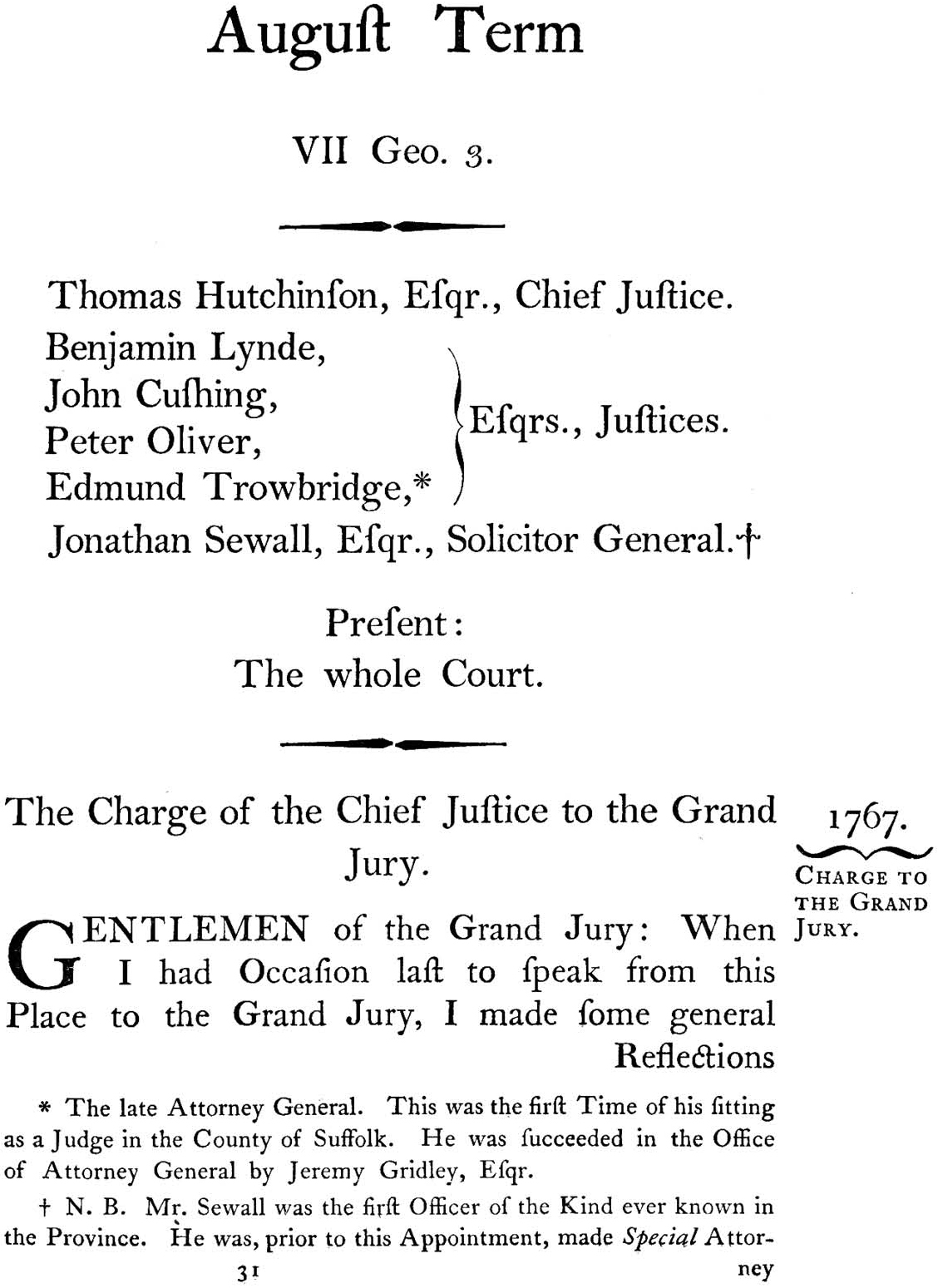
[P. 241]
Charge to The Suffolk Grand Jury by Chief Justice Hutchinson
1767-August Term
note
Here again, Hutchinson warned of the unchecked liberty of the press. Although his primary attack was on libelous or slanderous publishing, he inferred that there should be no toleration of false criticism of the judiciary, as “Liberty” depends on dignity and support of the courts. Further, he warned that the Court would punish those who are guilty of libel or slander against it more summarily than a private individual would be able to bring an indictment or civil action against a private defendant. Nevertheless, the Chief Justice admonished those judges who had actually been found guilty of corruption “as the most abandonedly wicked of all Men . . .” Lastly, he warned of the danger of engaging in disorders that involved an attack on any person in their own home. He warned that those who engaged in such attacks might be killed by the owner of the home, and that this homeowner would be guilty only of manslaughter. If the homeowner was killed, however, the killer, as well as anyone who assisted or abetted the killer, would be guilty of murder and would be executed.
This entire charge closely tracked Hutchinson’s own experience. He was furious over the personal attack in the Boston Gazette of April 27, 1767, concerning his remark in his March 1767 Charge to the Grand Jury that the role of the judge and the legislator should be separate. See Note, Reports, 237, Charge No. 5, March 1767, supra. Hutchinson continued to hold the position of Lieutenant Governor and to sit on the Council after being made Chief Justice. See full discussion in the Note, Reports, 258, Charge No. 7, March 1768. And, of course, the destruction of his house by the Stamp Act mob doubtless gave rise to the reflections on manslaughter. Since Hutchinson’s eldest daughter refused to leave his house, “whom he repeatedly begged to depart,” until he “took her in his Arms and carried her to a Place of Safety, just before the incensed Mob arrived,” these issues of killing in self-defense were not academic for him. See Reports, 169.
Despite his personal fury over the Gazette, Hutchinson told the Grand Jury that they were not charged with that particular matter, because the Court could issue a “Process for Contempt of the Court, and commit the Printer instantly, if he did not expose the Authors-and, if he did, very likely, both Author and Publisher.” Reports, 246. But Hutchinson was careful to focus the warning prospectively, and did not take on the Boston press immediately.
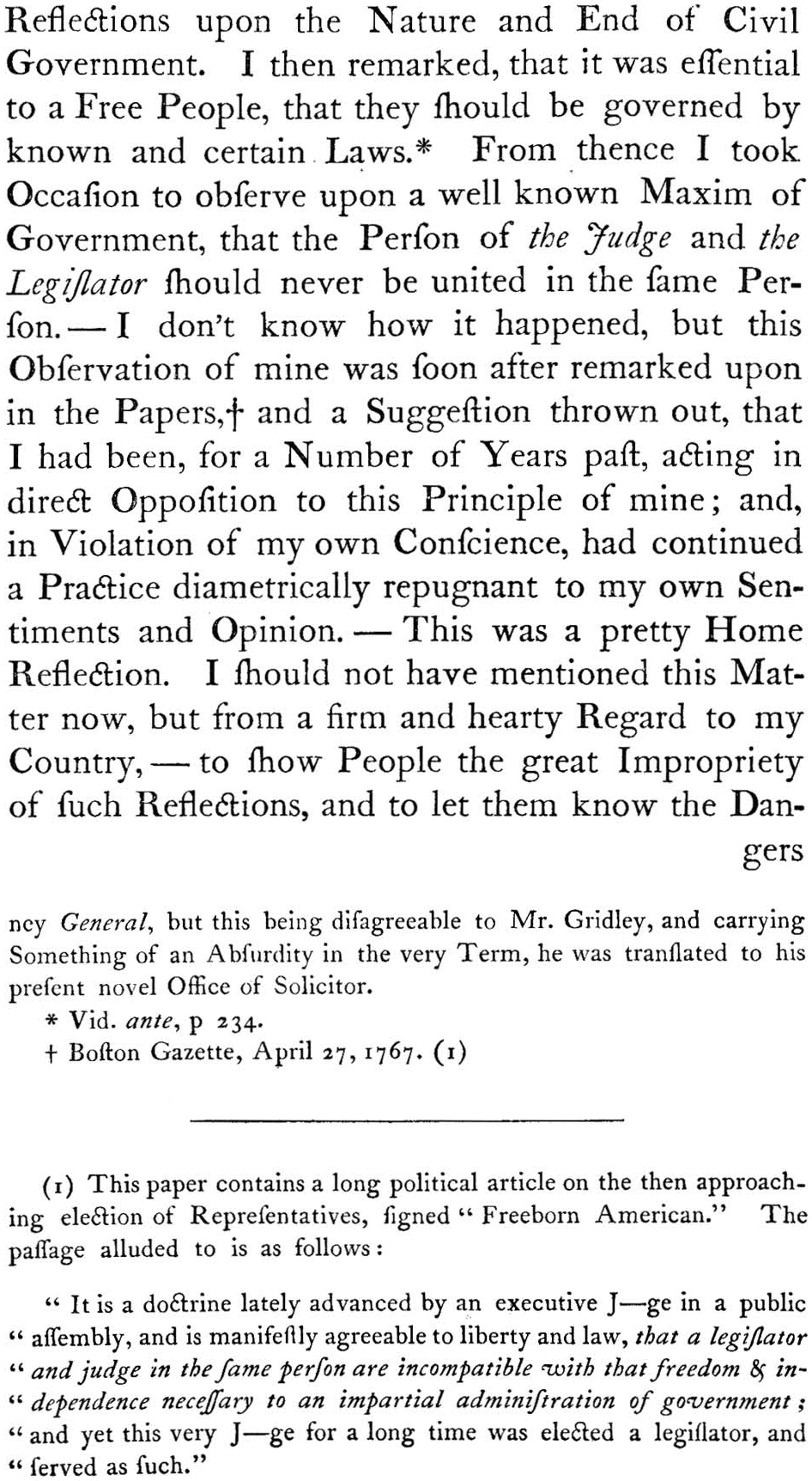
[P. 242]
At this point, Quincy had to leave the Court. Hutchinson then apparently alluded to the “Major Hawley” affair, which grew from the trial of one Seth Warren, arrested for rescuing a person held on civil process for debt while the courts were closed for lack of stamped paper. Hawley, representing Warren, argued that Warren was either guilty of high treason or “owing to the state of nature to which the closing of the courts had reduced society, of no crime at all.” Reports, 250. “Nevertheless, the prisoner was convicted of a riot, and fined three pounds.” Id., 250.
After Quincy’s return to the Court, Hutchinson charged the jury on “Tumults and Disorders,” emphasizing that any who attack a man “in his own House and accidentally kill him” are guilty of murder, and “all those, who anyways assisted or abetted the Offenders,” likewise guilty of murder, “and must suffer the Pains of Death.” Reports, 247. The implicit reference to the destruction of the Chief Justice’s own house in 1765 was unmistakable. Hutchinson obviously sought to balance the political allegiance of the typical Massachusetts juror with the universal desire to have a well ordered, secure neighborhood.
This charge has the distinction of being cited by Chief Justice Warren’s dissent in Times Film Corp. v. City of Chicago, 365 U.S. 43, 54 (1961), as to common-law understanding about freedom of the press. See Appendix 5, infra.
[P. 243]
[P. 244]
[P. 245]
[P. 246]
[P. 247]
[P. 248]
[P. 249]
[P. 250]
CASE 56
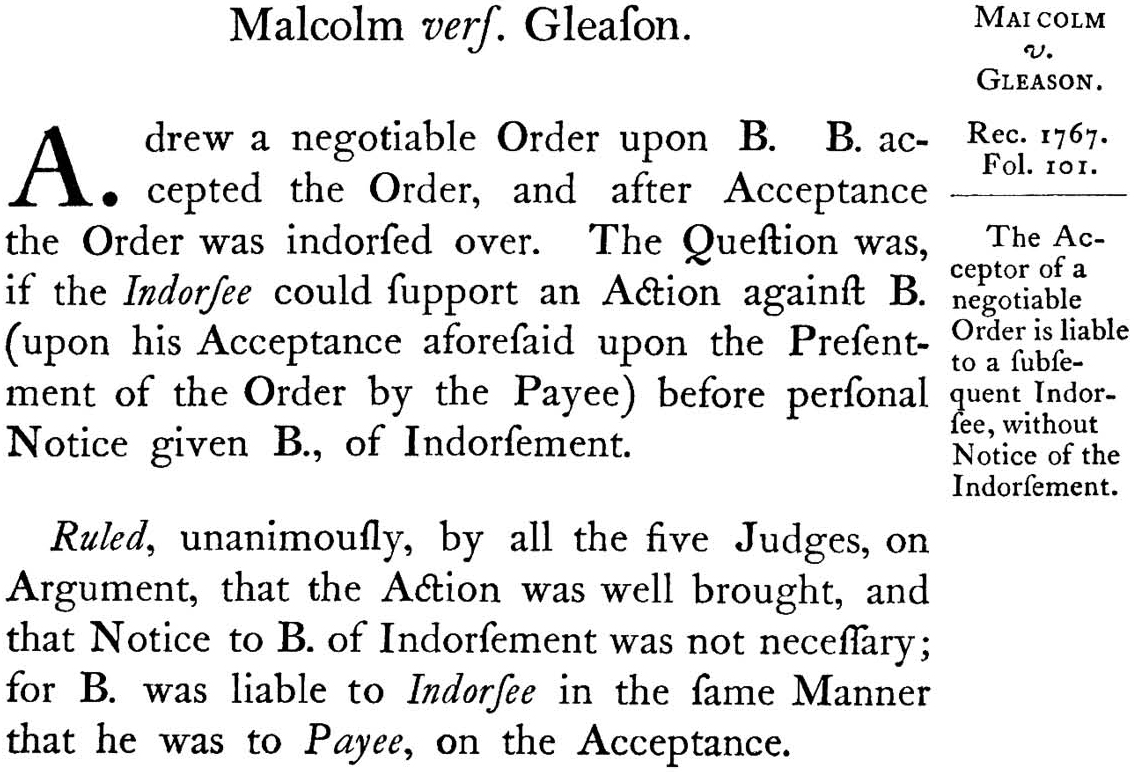
[P. 251]
7 George III (August Term) in the Superior Court of Judicature
1 · brief description
Once a negotiable order is accepted, notice is not required to make the acceptor liable to a subsequent indorsee.
2 · court records
Available at Rec. 1767, fol. 101.
3 · professionals involved
Not indicated.
4 · authority
None given.
5 · later citations
None.
6 · notes
This was a unanimous decision of all five Justices. The principle involved is fundamental to negotiable instruments. Once a negotiable instrument is in proper form, it should be like money. No notice to the drawee should be necessary to make the drawer as liable to an endorsee as to the payee. See James S. Rogers, The Early History of the Law of Bills and Notes (1995), 170–173. We exercise this principle if we take a bank check payable to us and endorse it to someone else, without calling the bank.
It is interesting that no authority was thought necessary for the unanimous opinion, which demonstrates that the colony was reasonably settled about some points of commercial law.
CASE 57
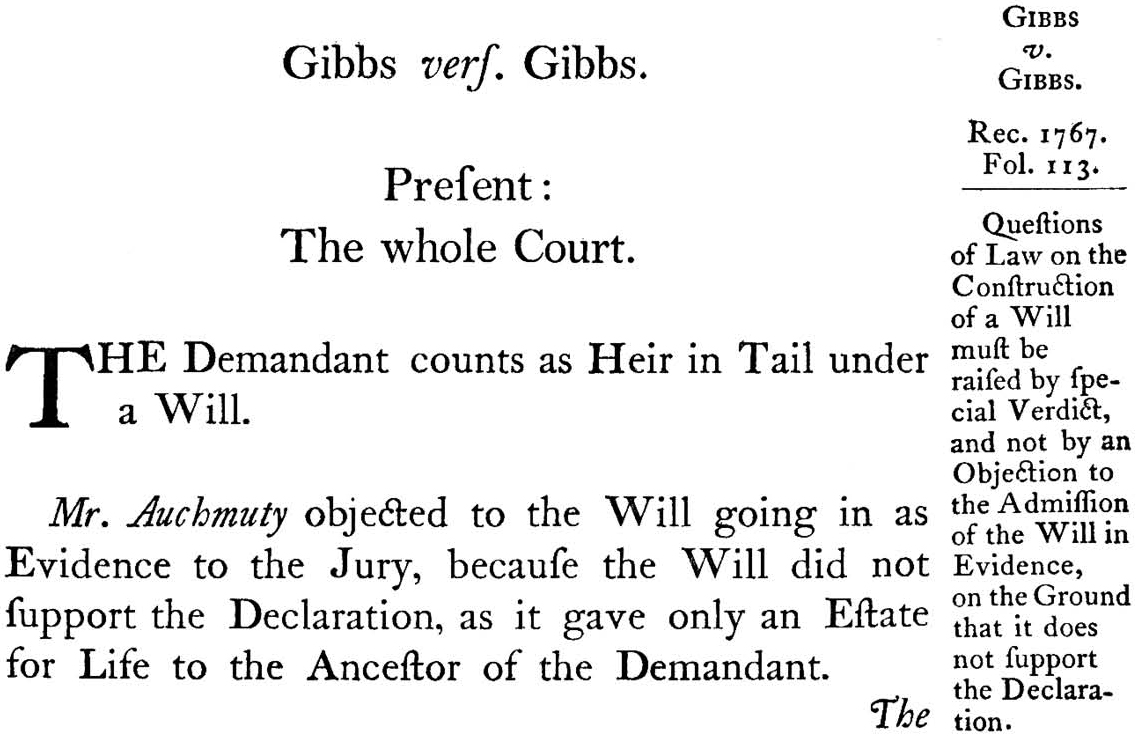
[P. 251]
7 George III (August Term) in the Superior Court of Judicature
1 · brief description
Proper construction of a will should be raised by special verdict, not by trying to bar the will in evidence.
2 · court records
Available at Rec. 1767, fol. 113.
3 · professionals involved
Robert Auchmuty (1723–1788) appeared for the Defendant, and opposed the will going to the jury. See brief biography at Appendix 6, infra. His unsuccessful argument was described by the Court as “the first of its Kind ever made; that if allowed, would destroy all Wills from being Evidence.” Reports, 252. This was not a compliment. See also, for a similar Auchmuty failure, Hall v. Miller (1767), Reports, 252, Case 58, Note 6.
4 · authority
None cited. “Uninterrupted Course of Practice” cited as the source of the ruling. Reports, 252.
5 · later citations
None.
6 · notes
It is very instructive to compare this case with split decisions in Carpenter v. Fairservice (1767), Reports, 239, Case 55, supra, and the close decision in Norwood v. Fairservice (1765), Reports, 189, Case 47. Both of these cases involved possible erasure or forgery of a document, a note and a deed, respectively. In the Norwood case, the deed eventually went to the jury, despite misgivings by Justice Lynde that “the Practice of this Court has always been otherwise.” Reports, 191. In the Carpenter case, the Court split 2 to 2 (Trowbridge had not yet been appointed) on whether the document should go to the Jury, the prevailing two Justices arguing that the note “did not support the Declaration.” Reports, 239. (These were Oliver and Lynde. Lynde’s position was consistent with his view in Norwood, but Oliver had argued that the document dispute in that case “properly belongs to a Jury.”)
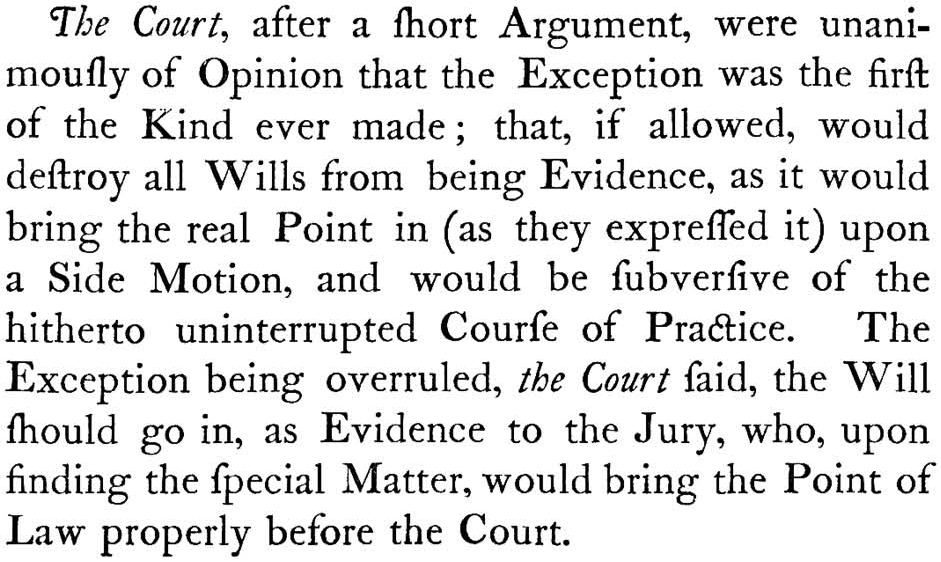
[P. 252]
This case was different in that there was no allegation that the will was altered in any way. Auchmuty wanted to keep it from the Jury because he claimed it provided for a life estate to the Demandant’s ancestor, not a fee tail, as alleged in the Declaration. Reports, 251. The issue was simply a matter of law, which would clearly come back to the Court on special verdict. The reason for the old custom of Court review of altered documents thus appears to be a desire to keep issues of altered documents from the Jury where they might be tempted, by legal ignorance, to come to the wrong conclusion. This temptation would not be present in this case, where the document was unaltered and the issues of law were clearly segregated. In any event, the Chief Justice was ready to send all such document issues, altered or unaltered, to the Jury. As he said in Norwood v. Fairservice (1765), Reports, 189, Case 47, supra, “I know the custom has been otherwise, but, for my Part, I think ’tis Time it was altered-am for admitting it.” Reports, 191.
CASE 58
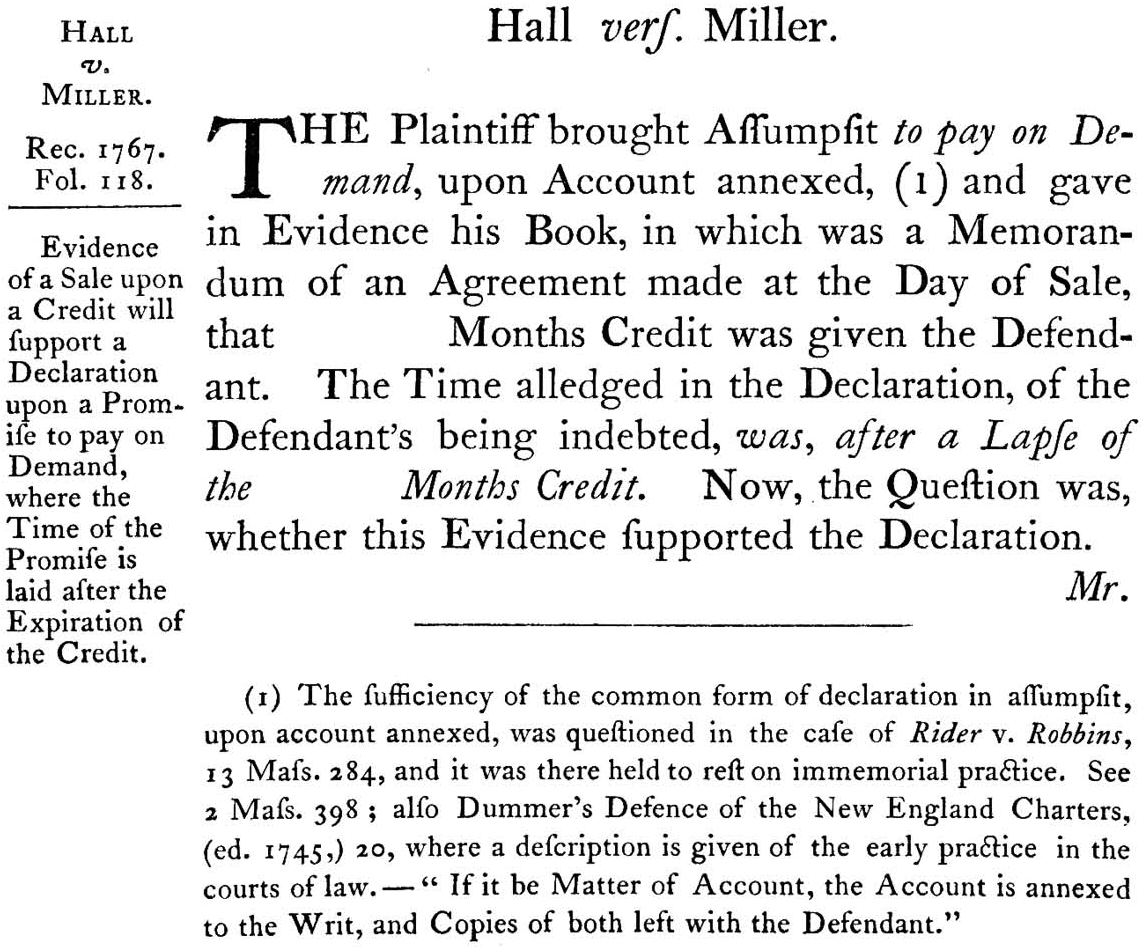
[P. 252]
7 George III (August Term) in the Superior Court of Judicature
1 · brief description
This was a typical assumpsit action upon an “account annexed,” a common practice in the colony. The issue was whether “to pay on Demand” was a good allegation when the original agreement provided for a period of credit, which had since expired. Held: once the credit period expires, the law “raises a Promise to pay on Demand.” Reports, 253.
2 · court records
Available at Rec. 1767, fol. 118.
3 · professionals involved
Robert Auchmuty (1723–1788) appeared on behalf of the Defendant. (Auchmuty seems to have lost a lot of these rather tenuous objections. See Gibbs v. Gibbs [1767], Reports, 251, Case 57, as another example.) No counsel was identified for the Plaintiff.
4 · authority
None cited.
5 · later citations
This case was cited in Turner v. Langdon, 112 Mass. 265 (1873) for the proposition that a Plaintiff can recover on an account for goods bargained and sold if the Jury finds that the goods were offered for delivery, and the Defendant failed to comply with the terms of the sale. Id., 112 Mass., at 266. In other words, once the conditional terms were met by the Plaintiff, the obligation was due-the analogy being to the expiration of the credit period in this case.
6 · notes
Auchmuty’s efforts at clever defensive pleading were defeated again by a common sense Court. See Gibbs v. Gibbs (1767), Reports, 251, Case 57.
[P. 253]
ILLUSTRATION 13: The birthplaces of John Adams and John Quincy Adams, by Eliza Susan Quincy (1798–1884). Watercolor and graphite on paper. Eliza was the Reporter’s granddaughter and biographer. See Quincy Papers, vol. 1, 10. See also D. Brenton Simons, Boston Beheld (Boston, 2008), 96–97. Courtesy Massachusetts Historical Society.
CASE 59
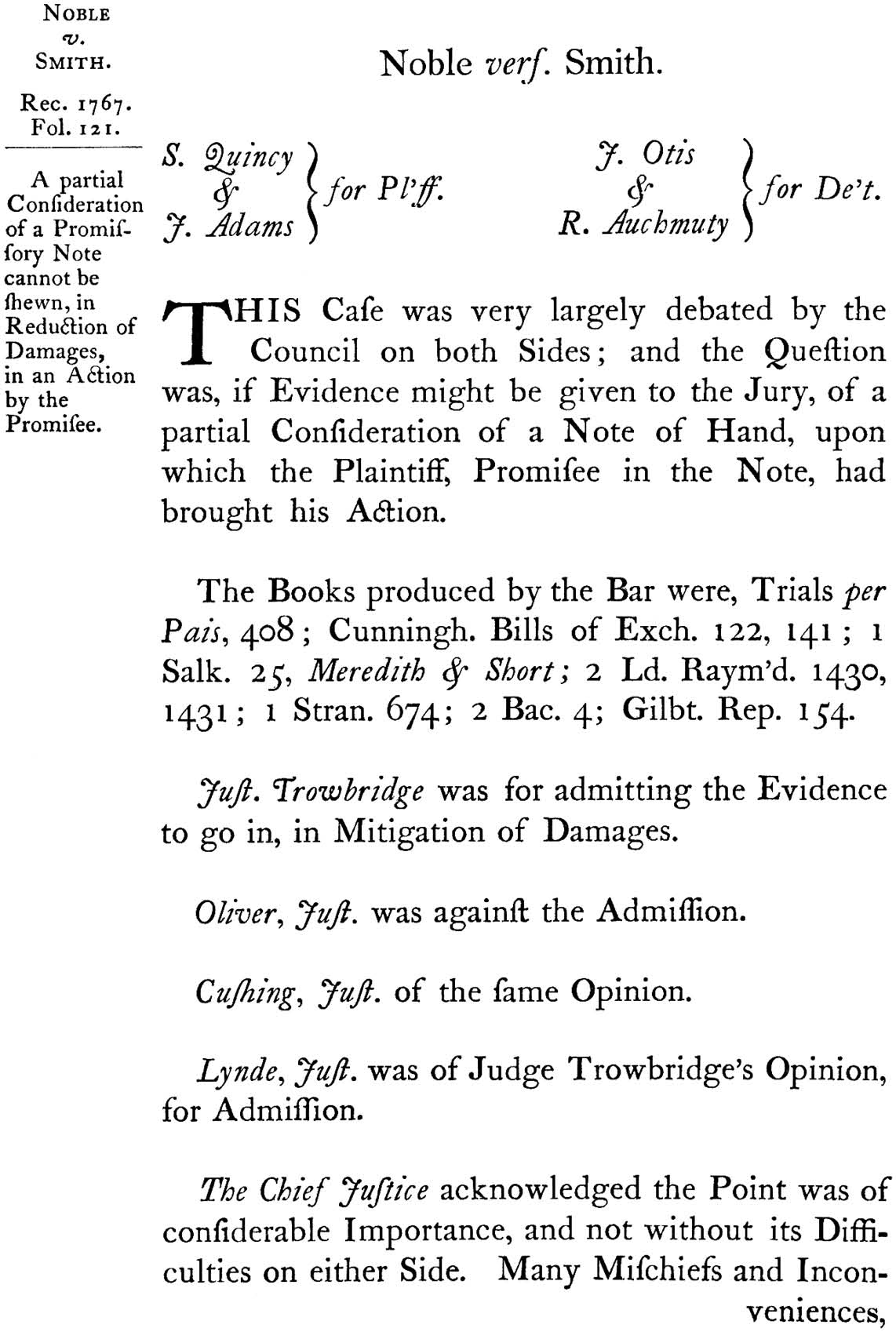
[P. 254]
7 George III (August Term) in the Superior Court of Judicature
1 · brief description
This was an important case. The issue was whether failure of full consideration for a promissory note could be entered into evidence by the Defendant promisor to reduce the damages to the Plaintiff promisee. In other words, suppose I gave you a note for $1,000 in return for your painting my house, but you only painted half of the house. Could I reduce the damages owed to you for failure to pay the note by the value of the unfinished paint job? Held: three to two, that the evidence of the failure of full consideration could not be admitted.
2 · court records
Available at Rec. 1767, fol. 121.
3 · professionals involved
Samuel Quincy (1734–1789), the Reporter’s brother, and John Adams (1735–1826), the Patriot, for the Plaintiff. James Otis Jr. (1725–1783) and Robert Auchmuty (1723–1788) for the Defendant. See brief biographies in Appendix 6. This lineup was sadly ironic given later historical events. John Adams and James Otis Jr. were reputed to be great patriots, and Adams, of course, became President. Samuel Quincy, unlike his brother Josiah, was a Tory, and became Solicitor General in 1771. Both he and Auchmuty were proscribed in 1778. See Charles R. McKirdy, “Massachusetts Lawyers on the Eve of the American Revolution: The State of the Profession” in Law in Colonial Massachusetts, supra, 339, 348, 350–351. This case was another loss for Auchmuty!
4 · authority
A series of English texts and cases were “produced by the Bar,” including Timothy Cunningham’s The Law of Bills of Exchange, Promissory Notes, Bank Notes and Insurances (1st ed., London, 1760), 122, 141 (see Sweet & Maxwell, vol. 1, 521), and G. Duncombe’s Trials per Pais (London, 1665; see Sweet & Maxwell, vol. 1, 408), neither of which were really on point. There was also a citation to Matthew Bacon’s popular A New Abridgement of the Law (London, 1736). See Law Commonplace, [37], n. 5. This simply asserted that “[i]n all actions which sound in damages, the Jury seem to have a discretionary Power of giving what Damages they think proper: for though in Contracts the very sum specified and agreed on is usually given, yet if there are any Circumstance of Hardship, Fraud or Deceit, though not sufficient to invalidate the Contract, the Jury may consider of them, and proportion and mitigate the Damages accordingly.” Id., vol. 2, 4. Also cited, and directly on point, was Jefferies v. Austin (1725), 1 Strange’s Reports (London, 1755), 674, which was an action on the case upon a promissory note by the promisee, like this one, where the Plaintiff held the note “in the nature of an escrow, viz. as a reward in case he procured the defendant to be restored to an office; which it was proved he did not effect, there was a verdict for the defendant.” Id., at 674. Citation was also made to the case of Meredith v. Short (1702), 1 Salkeld’s Reports (covering 1685–1712) 25 (see Law Commonplace, [19], n. 4 and [32], n. 7).
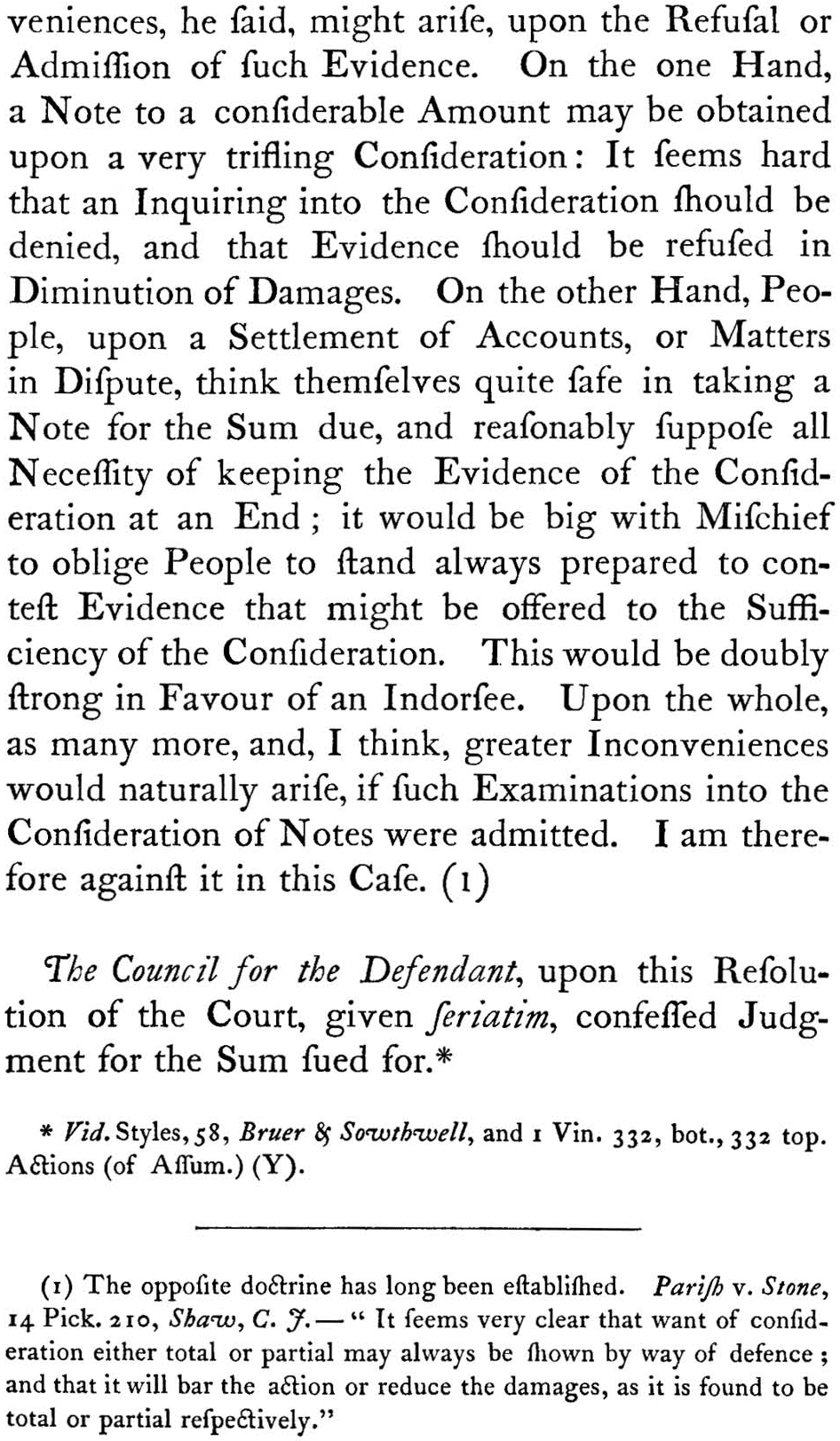
[P. 255]
5 · later citations
None. As Samuel Quincy noted, the law developed the other way in Massachusetts, permitting a “total or partial” defense for want of consideration. See Parish v. Stone, 31 Mass. 198, 14 Pickering 210 (1833), at 198. Of course, a bona fide endorsee for consideration of a negotiable instrument in proper form would be a different case. See James S. Rogers, The Early History of the Law of Bills and Notes, supra, 125–137, 241.
6 · notes
Justice Trowbridge, the new man on the bench, and Justice Lynde were for admission of the evidence to the jury; Justices Oliver and Cushing were opposed, leaving the deciding vote with the Chief Justice. He was conflicted, worrying about policy, “Difficulties on either Side.” It would certainly be unfair to a Defendant to enforce a note for full value if the consideration actually received was “very trifling” or had failed, as in Jeffries v. Austin, supra. On the other hand, he noted that “People, upon a Settlement of Accounts, or Matters in Dispute, think themselves quite safe in taking a Note,” and then do not keep the underlying evidence of consideration. Reports, 255. But he erred in arguing “[t]his would be doubly strong in Favour of an Indorsee,” because a bona fide endorsee for consideration of a negotiable instrument would be a very different policy case. See Note 5, supra. In the end, the Chief Justice came down against admitting the evidence of partial consideration to the jury, giving the defendant’s counsel, Otis and Auchmuty, no choice but to confess judgment “for the Sum sued for.” The Chief Justice’s decision was a mistake.
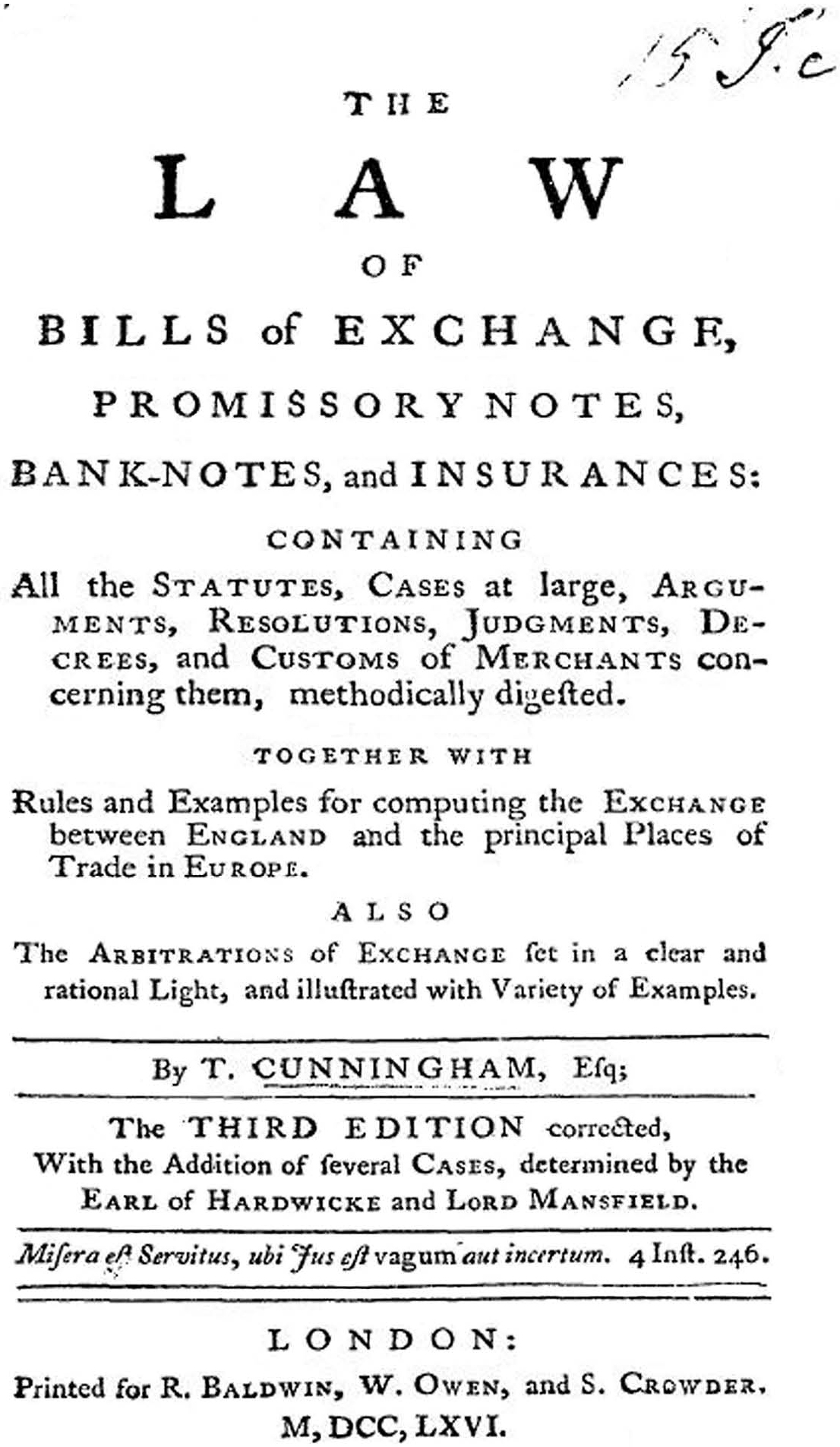
ILLUSTRATION 14: Title page, Timothy Cunningham’s The Law of Bills of Exchange, Promissory Notes, Bank Notes, and Insurances (London, 3rd ed., 1766). See Nobles v. Smith (1767), Reports, 254, Case 59.
Both Quincy and his grandson Samuel noted contrary authority, with Quincy citing Viner’s Abridgment (London, 1742–1753), vol. 1, 332. See Law Commonplace, [16], n. 2.
CASE 60
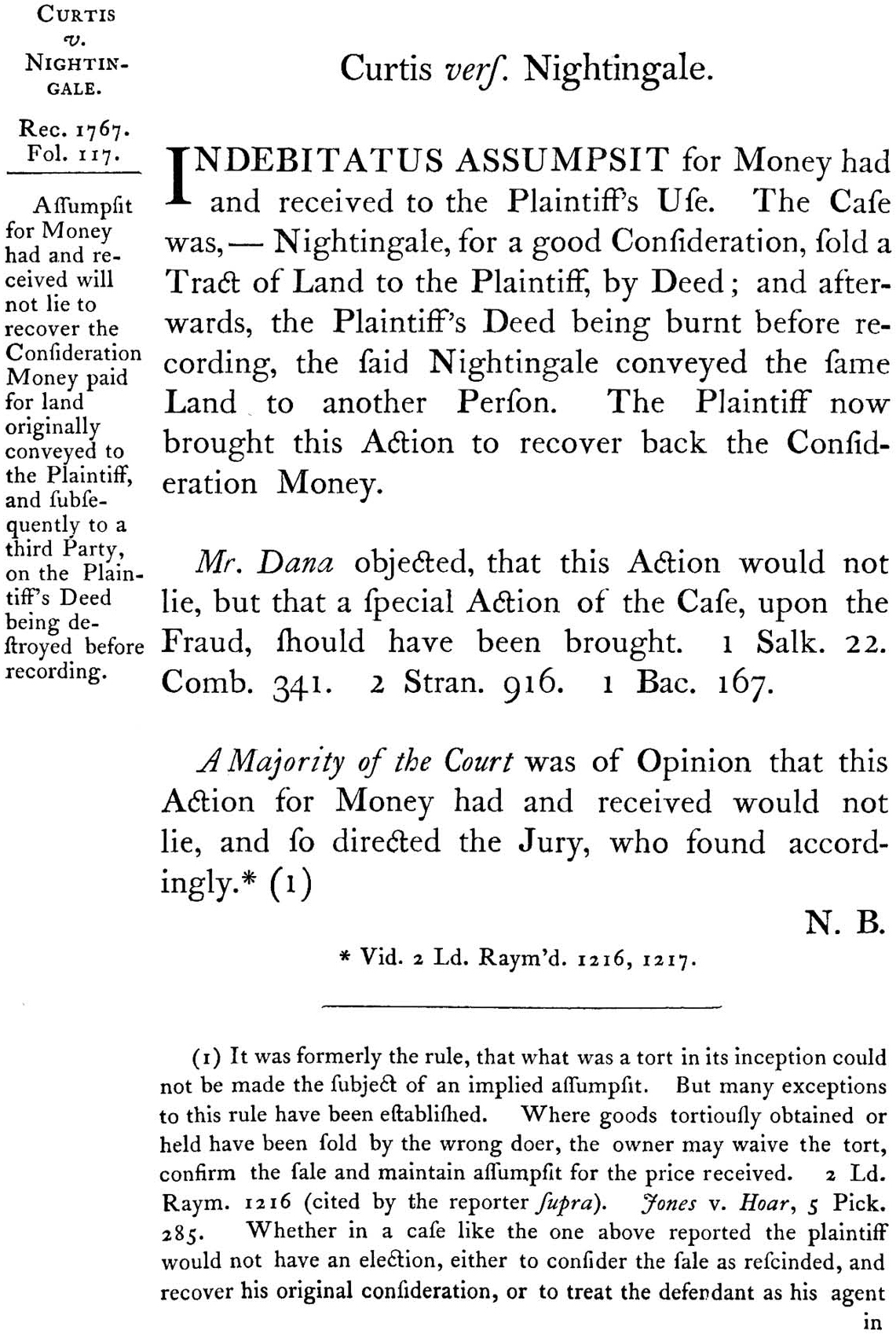
[P. 256]
7 George III (August Term) in the Superior Court of Judicature
1 · brief description
The issue was whether a contractual action, indebitatus assumpsit for money had and received, was appropriate to recover the purchase price of land which the Defendant conveyed twice, once to the Plaintiff Curtis, whose deed was burned before it could be recorded, and subsequently to another. Held: by a majority, this was the wrong action, the proper action being a special action on the case for fraud.
2 · court records
Available at Rec. 1768, fol. 139.
3 · professionals involved
Richard Dana (1700–1772) appeared for the Plaintiff. He was a senior member of the bar and a Justice of the Peace for Suffolk. Nevertheless, he strongly opposed the Stamp Act. An Overseer of the Poor, he was noted for giving free legal advice. See short biography in Appendix 6, infra.
4 · authority
Dana cited four English authorities, including the popular Matthew Bacon, A New Abridgement of the Law (1st ed., London, 1736), vol. 1, 167. That authority stated almost the opposite for what it was offered, i.e., “if a Man pays money upon a Policy of Insurance, supposing a Loss, when in Truth there was not any, he may bring Indebitatus assumpsit for so much Money received to his Use [note] . . . [a]nd whether he parts with his Money by Mistake, or though Fraud in the Receiver, it is the same. . . .” Id., vol. 1, at 167. Also cited by Dana was Astley v. Reynolds (1732), 2 Strange’s Reports (London, 1755), 915. See Law Commonplace, [21], n. 12. This was also off point for Dana, being concerned with a voluntary payment of interest over “the usurian contract” limit. 2 Strange’s Reports, supra, at 916. Nothing was “voluntary” about this case! Additional citations were to Tomkins v. Bernet (1693), 1 Salkeld’s Reports (covering 1689–1712) 22, see Law Commonplace, [19], n. 4 and [32], n. 7; and to Anonymous (1695), Comberbach’s Reports (covering 1685–1698), 341, see Sweet & Maxwell, vol. 1, 298.
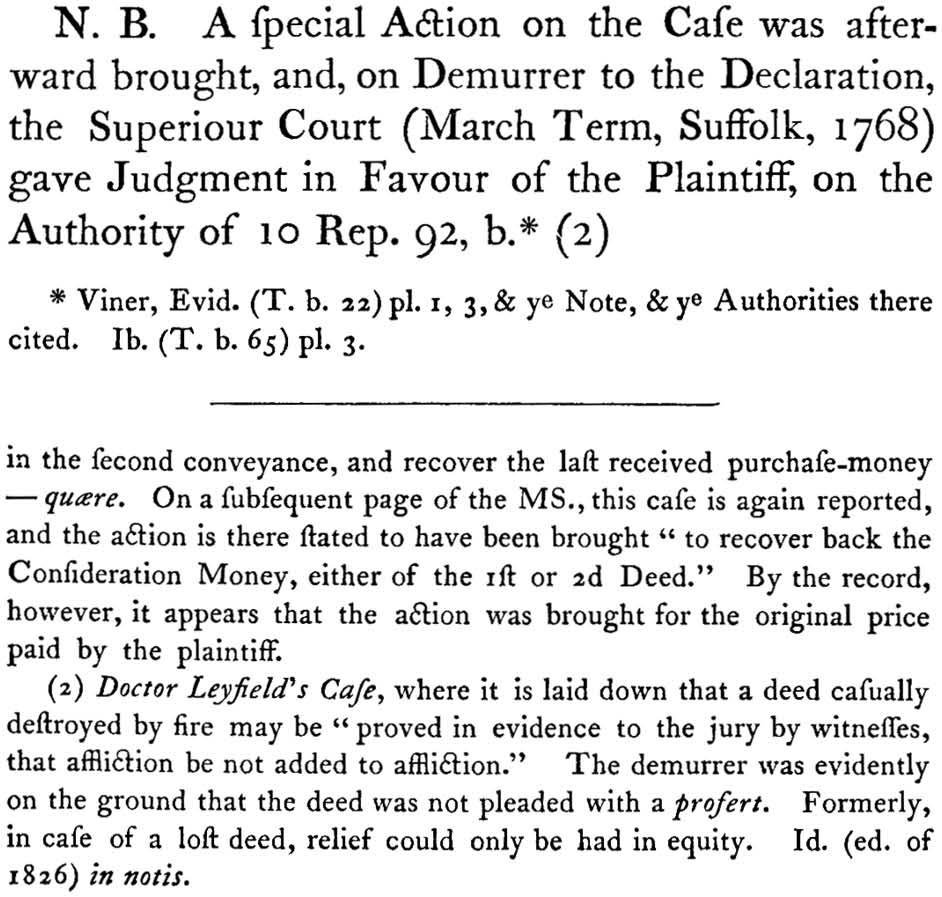
[P. 257]
Quincy himself cited Lamine v. Dorrell (1705), 2 Lord Raymond’s Reports 1216, at 1216, which was on point.
5 · later citations
None. Massachusetts law evolved in the opposite way. The conventional law was, and is, that the victim could “waive the tort” and sue on the contract. See Jones v. Hoar, 22 Mass. 285, 5 Pickering 285 (1827) at 290. See Samuel Quincy’s note at Reports, 256–257, S. Quincy n. 1.
6 · notes
Technically, what the Defendant did was a tort, and a special action on the case in fraud was the right way to proceed. (Indeed, it was a fraud on both purchasers.) In fact, such an action was later brought by the Plaintiff, and it succeeded. Reports, 257. The only issue was whether the Plaintiff should have been able to “waive the tort” and sue on the contract to sell the property-as, indeed, the Defendant’s acts made the contract worthless. Later law moved that way. See Note 5, supra. But the Superior Court of Judicature’s formalism required a second suit for the Plaintiff to get justice, even in such an obvious case.
CHARGE NO. 7
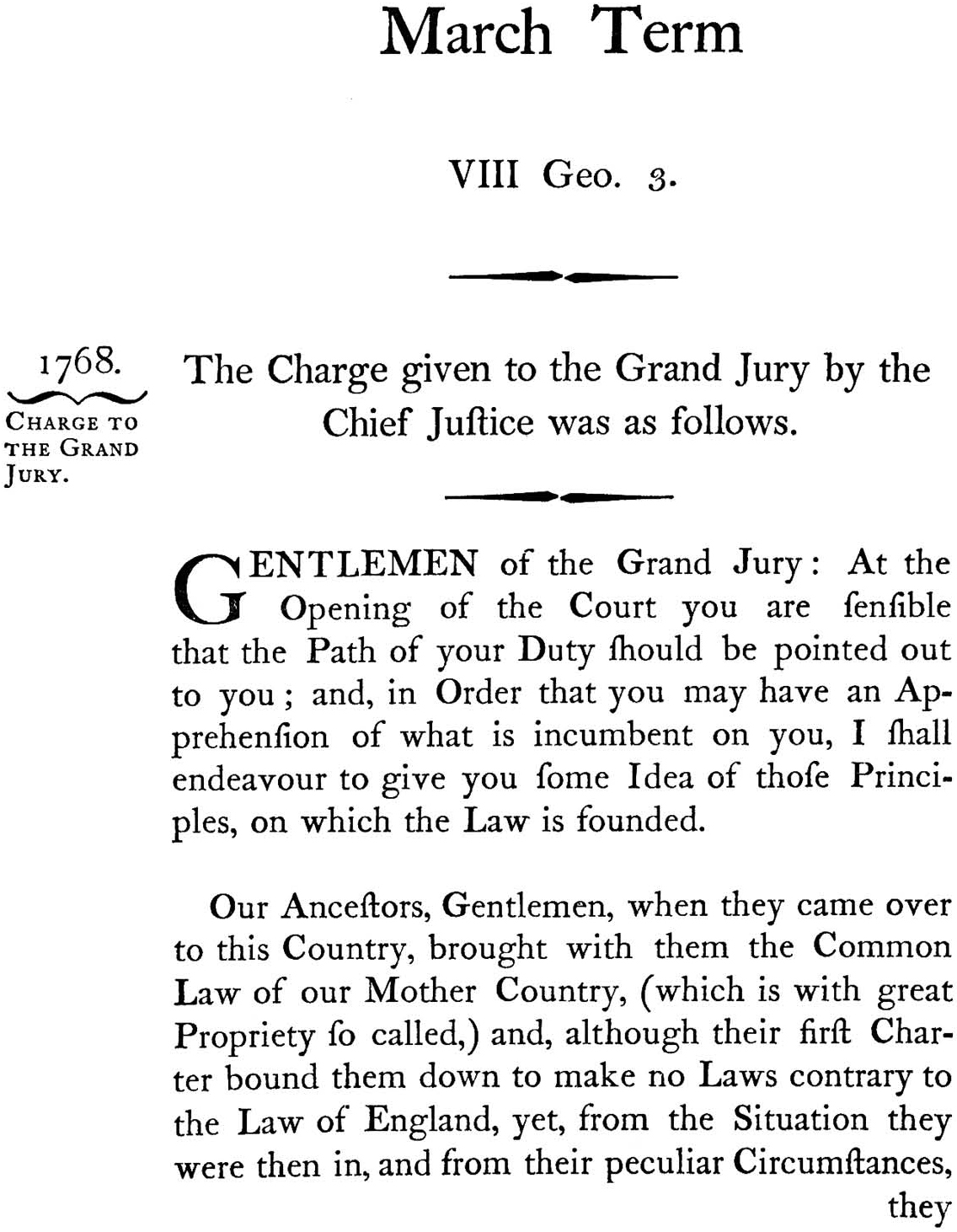
[P. 258]
Charge to The Suffolk Grand Jury by Chief Justice Hutchinson
1768-March Term
note
This was definitely one of the most interesting of Hutchinson’s charges, and Quincy was openly critical of some of the Chief Justice’s assertions. The charge opened with reference to the early laws of the colony, “they then apprehended they had a Right to adopt the Judicial Laws of Moses.” Reports, 259. Hutchinson could have been referring to John Cotton’s “Moses his Judicialls” of October 1636, which was never published in America, but was published in London in 1641 as An Abstract On [sic] the Lawes of New England, although Cotton’s draft was never adopted into law in the colony. See Daniel R. Coquillette, “Radical Lawmakers in Colonial Massachusetts: The ‘Countenance of Authoritie’ and the Lawes and Liberties,” 67 New England Quarterly (1994), 183–188 (hereafter Coquillette, “Radical Lawmakers”). More likely, given the list of capital crimes recited, Hutchinson was referring to the “Acts Respecting Capital Crimes” enacted in 1641 and 1642, and published in England as a “broadside,” in London in 1643. See The Charters and General Laws of the Colony and Province of Massachusetts Bay (Boston, 1814), 58–60 (hereafter “Charters”). Hutchinson’s point was clearly his “regret that we have departed so far from the Spirit of our Fathers,” i.e., that law and order is a home-grown idea rather than a British import. Reports, 259. Hutchinson then goes on to give the usual emphasis on “High Treason” and a “concise” survey of the crimes, but with a special emphasis on “perjury . . . so frequently committed in our Custom-House oaths,” and-especially-“Libelling.” Reports, 261.
Certainly no grand juror could misunderstand the message. The Chief Justice was concerned about riots and smuggling, but he was really cross about the Boston Gazette, particularly the articles on February 29, March 7, and March 14 of 1768. As carefully explained in Samuel Quincy’s note, Reports, 270, the issue was Hutchinson’s continuing to sit on the Council after being named Lieutenant Governor on the grounds that it was his right ex officio, although not elected. This resulted in an outcry in the House, leading to an appeal by the Governor to the Secretary of State, Lord Shelburne, who approved the Governor’s conduct and censured the House. This in turn led to publication of a letter by “A True Patriot” attacking the Governor for his “jesuitical Insinuations” which “induced a worthy Minister of State, to form a most unfavorable Opinion of the Province in general, and some of the most respectable Inhabitants in particular.” Reports, 271. For this the Governor labeled the Gazette a “libelous Paper” and sought an indictment from the Grand Jury and relief from the Council and the House. He got the expected expression of sympathy from the Council, but his case was rejected by the House, which noted that no particular person was named and that “[t]he Liberty of the Press is a great Bulwark of the Liberty of the People.” Reports, 274–275. Hence the effort now by Hutchinson to get an indictment through a charge to the Grand Jury.
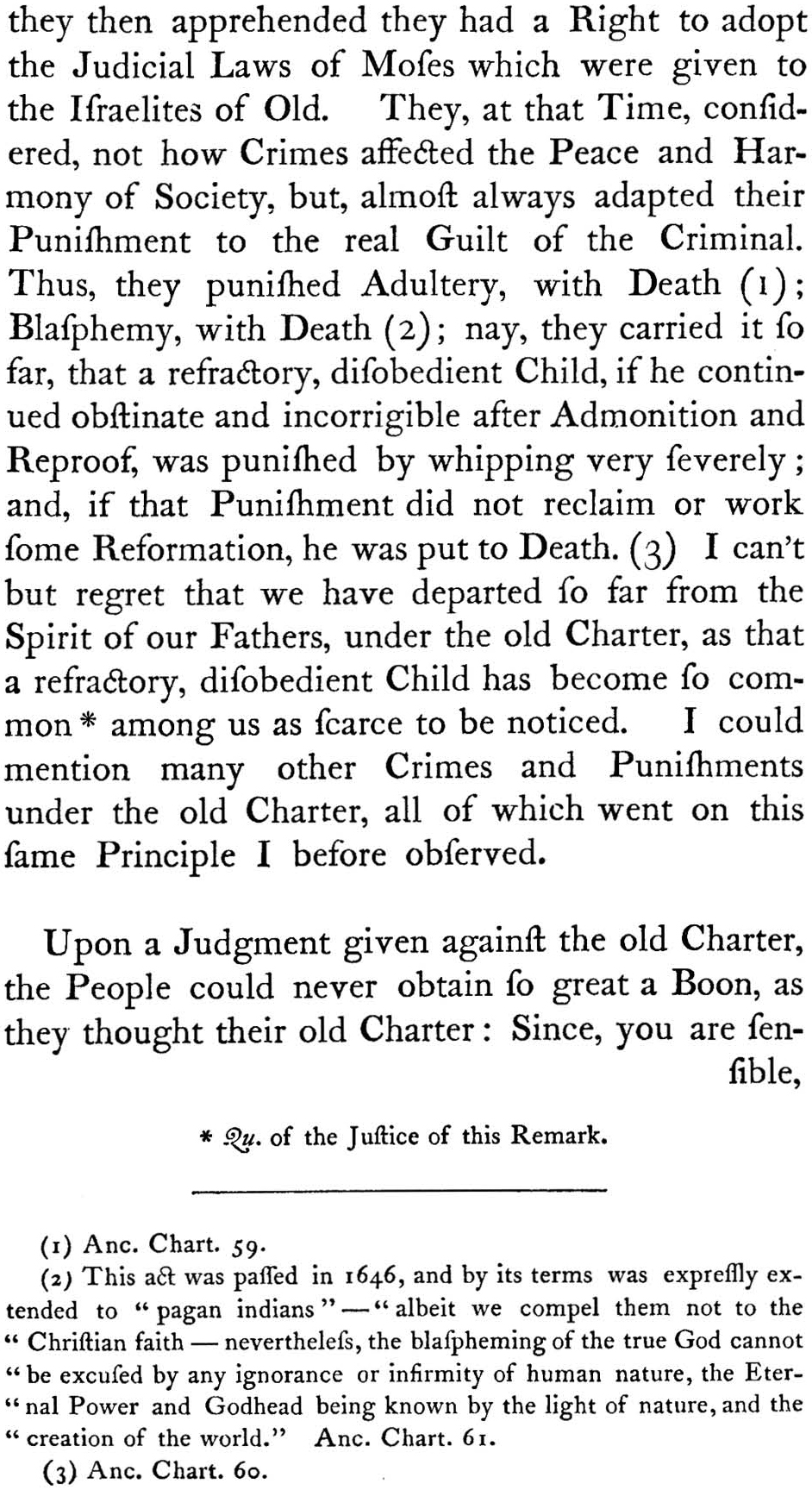
[P. 259]
Quincy was critical of the whole thing, beginning with Hutchinson’s appeal to the law and order of the good old Puritan days when disobedient children were punished “by whipping very severely” or, “if that Punishment did not reclaim . . . Death.” When Hutchinson remarked that “a refractory, disobedient Child has become so common among us as scarce to be noticed,” Quincy queried “the Justice of this Remark.” Reports, 259. More importantly, Quincy challenged the wisdom and fairness of a “severe” law of libel, “it must strike both House of Parliament with Terror and Dismay.” He also challenged Hutchinson’s assertion that the law provided no remedy to an individual “injured or greatly wronged by those appointed to rule over him,” and challenged Hutchinson’s assertion to the jurors that their oaths required them to present an indictment as to “all such Matters and Things as shall be given you in Charge.” Reports, 262, 268, 269.
On the second point, Quincy specifically rebutted Hutchinson’s reliance on Sir Michael Foster, who Hutchinson described as “one of the clearest most accurate Writers I ever met with, upon the Crown-Law.” As Quincy noted, Foster’s Discources Upon . . . Crown Law (Oxford, 1762) did not say there was no legal remedy at all for a “bad Ruler,” but rather referred only to bearing “with patience” injuries outside “the laws of society.” See Foster’s Discourse, supra, 296. As to the jurors’ oaths, Quincy again challenged Hutchinson, and accused him of misstating the oath to make indictment required of matters charged, rather than discretionary. Reports, 269. In both instances, the texts seem to support Quincy. See Reports, 268–269, S. Quincy, notes 8 and 9. In addition, Quincy added two of his own sources, William Bollan’s The Freedom of Speech and Writing upon Publick Affairs Considered (London, 1766) and the case of Regina v. Taylor (1703), 2 Lord Raymond’s Reports, King’s Bench and Common Pleas (covering 1694–1732) (London, 1743, republished in a 2nd edition in 3 volumes, 1765), 879. These both rebut Hutchinson’s strict application of libel law in a political setting. In any event, the Grand Jury itself took no notice of the libel charges, to Hutchinson’s displeasure. Reports, 270.
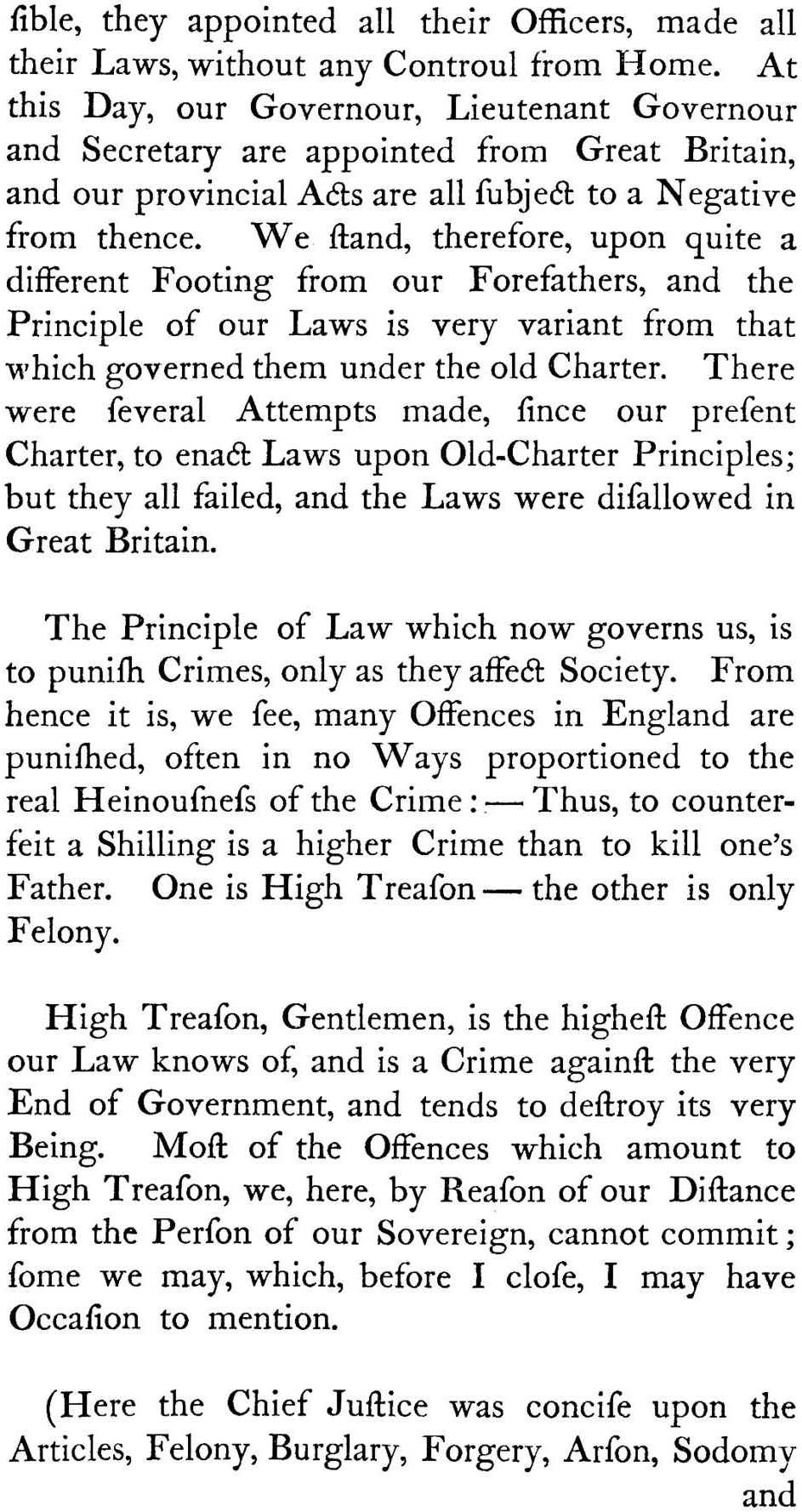
[P. 260]
Interestingly enough, the February 29, 1768, issue of the Boston Gazette featured “Letter XII” of “a Farmer in Pennsylvania,” this being John Dickinson (1732–1808). Quincy would visit Dickinson in 1773 during his trip to the South. See The Southern Journal (1773), Quincy Papers, vol. 3, 292–299 [147–150]. By today’s standards, both the language of the “Farmer” and the “Patriot” were mild, and would not be actionable libel even without a First Amendment. But there was no mistaking the venom. As the “Farmer” stated, “For though I have the highest opinion of the deference of the house for the King’s minister; and he may be so good-natured as not to put it to the test, except it be for the more and immediate profit of his master or himself.” “Letter from a Farmer in Pennsylvania,” Boston Gazette, February 29, 1768, 1–2. The “Patriot” wrote, “. . . I have the most sacred regard to the characters of all good men, and would sooner cut my hand from my body, than strike at the reputation of an honest member of the community: But there are circumstances, in which not justice alone, but humanity itself, obliges us to hold up the villain to view . . .” Boston Gazette, March 7, 1768, 2. (Italics in original.)
[P. 261]
[P. 262]
[P. 263]
[P. 264]
[P. 265]
[P. 266]
[P. 267]
[P. 268]
[P. 269]
[P. 270]
[P. 271]
[P. 272]
[P. 273]
[P. 274]
[P. 275]
[P. 276]
[P. 277]
[P. 278]
CASE 61
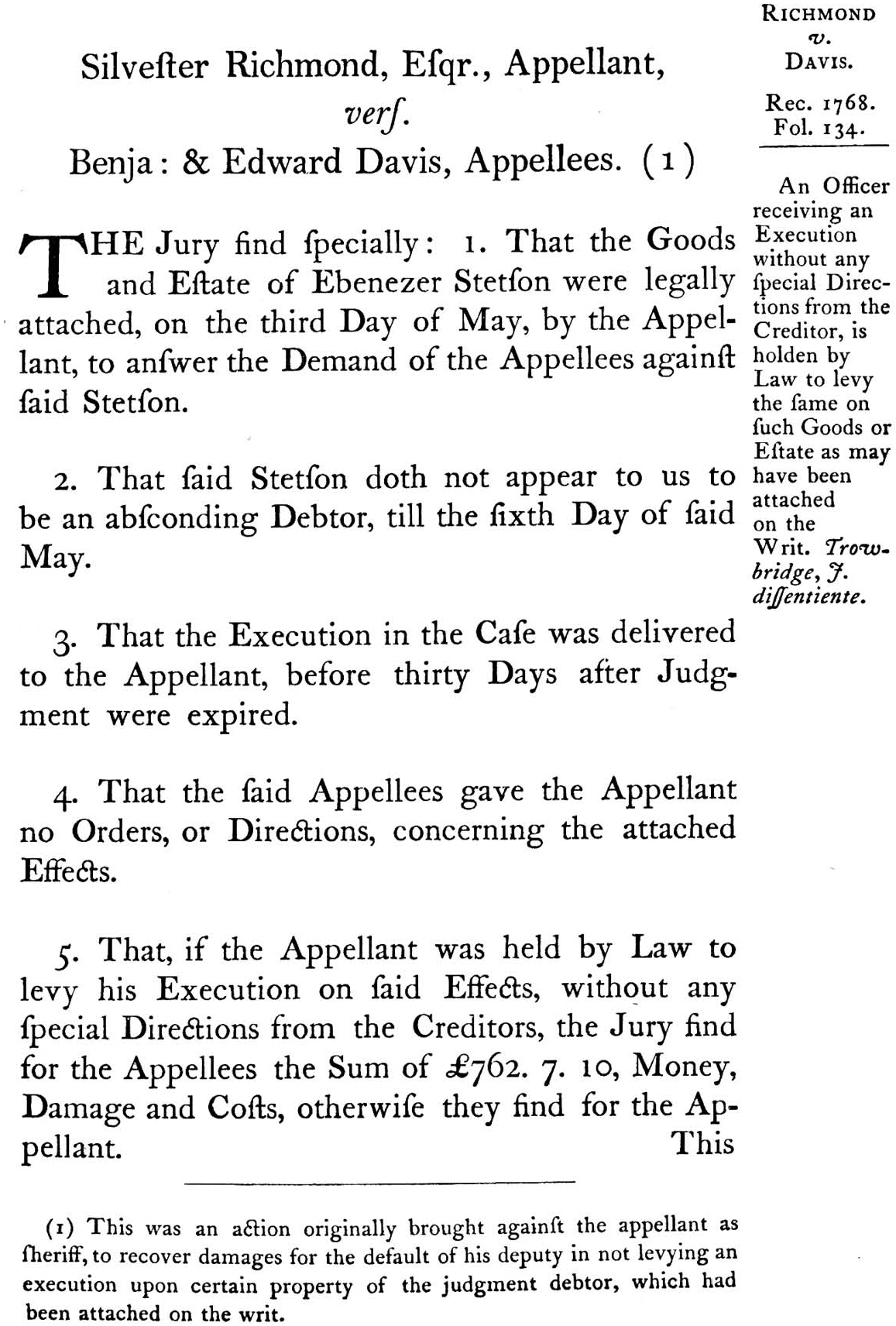
[P. 279]
Silvester Richmond, Appellant v. Benja: & Edward Davis, Appellees (1768)
8 George III (March Term) in the Superior Court of Judicature
1 · brief description
Initially this was an action brought by the creditor Davis against Richmond, as sheriff, for failure of his deputy to levy execution upon certain property of the debtor, Stetson, attached on the writ. They returned a special verdict that if Richmond were held by law to levy such execution, without special instructions from the creditors, he was liable for substantial damages. Otherwise, they found for Richmond, as the creditor gave no instructions at all. Held: four to one, no special instructions were necessary, and the sheriff was liable for the damages. Justice Trowbridge dissented, after a lengthy argument. An appeal was claimed to the King in Council, the damages greatly exceeding the £300 requirement in the Province Charter. See The Charters and General Laws, supra, Province Charter of 1691 (the “Second Charter”), 32.
2 · court records
Available at Rec. 1768, fol. 134.
3 · professionals involved
This case was reported in a very curious way, compared to the earlier reports. While Quincy indicated that the case “was largely handled at the Bar, by the Council [sic] on both sides,” he does not identify them or set out their arguments. Rather, “as the Arguments were all taken up by the Bench” he set out at length “the Learned Argument” of Justice Trowbridge. Edmund Trowbridge was a newly appointed Justice, having replaced Chambers Russell in 1767. He had been Attorney General from 1749 to 1767, and a member of the Council in 1764–1765. See short biography in Appendix 7, infra, and in William T. Davis, History of the Judiciary of Massachusetts (1900), at 97. Trowbridge was the only Justice to be trained as a lawyer. See Charles R. McKirdy, “Massachusetts Lawyers on the Eve of the American Revolution: The State of the Profession,” in Law and Colonial Massachusetts, supra, 330, 332. As discussed in the “Introduction,” supra, giving written, reasoned opinions was very rare, both in America and England. This “Argument,” clearly a kind of dissent, was a very early example of such an opinion.
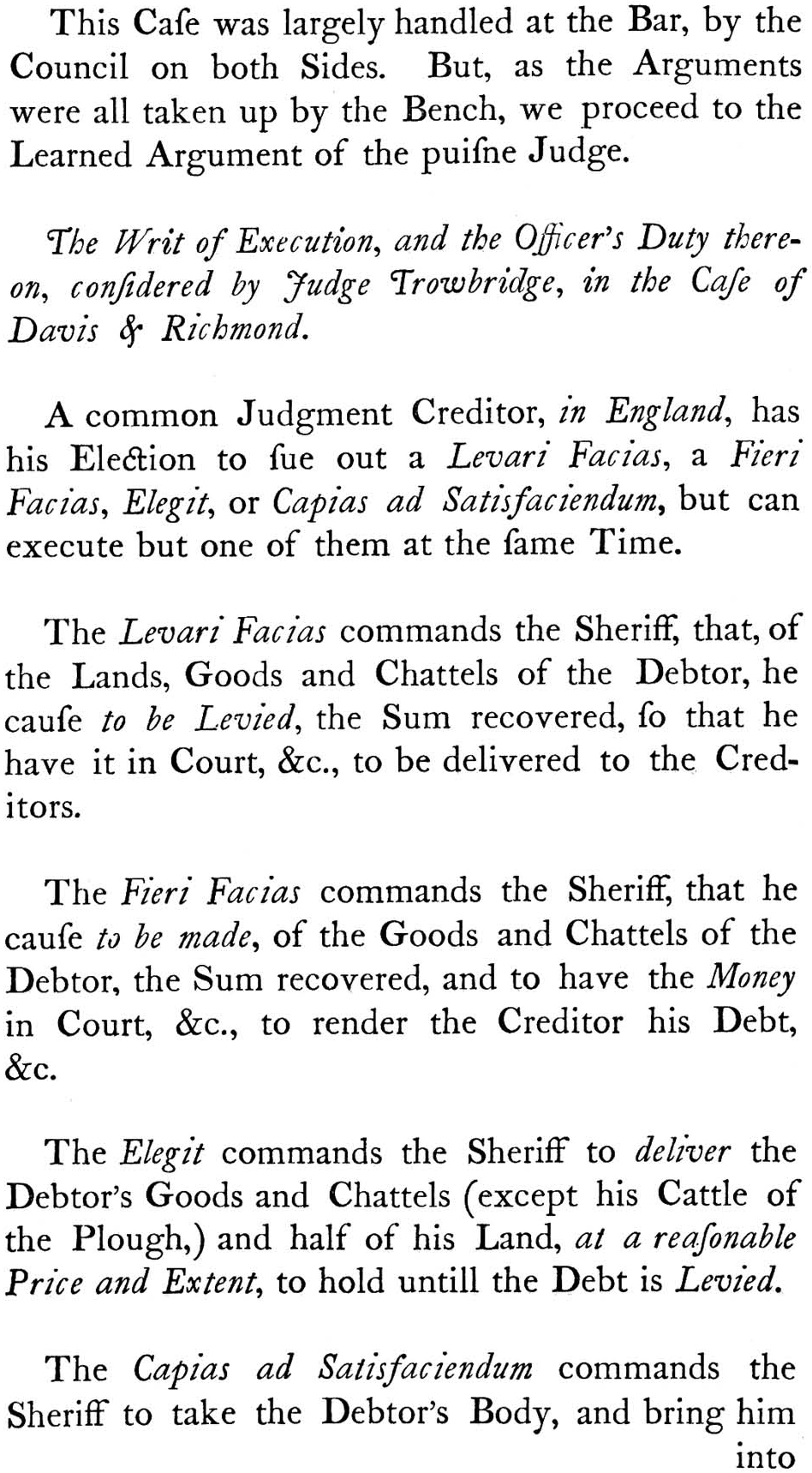
[P. 280]
Trowbridge’s colleagues “did not give their Opinions at large, as Judge Trowbridge had done,” but simply voted against him, with no explicit reasons. Quincy was evidently unimpressed by this. See discussion at Note 6, infra.
4 · authority
Trowbridge’s seventeen-page “Argument” was entirely based on English law, including his lengthy construction of 4 & 5 William & Mary (1694), c. 21. Reports, 284. “Here is not the least Intimation given, that the Officer was to raise the Money by the Sale of the Debtor’s Estate; but, on the contrary, it plainly appears, that the Makers of this Act thought that, upon the old Writ, the Creditor was obliged to take his Satisfaction in such Estate of the Debtor as was tendered or found, or go without Satisfaction; which could not be the Case, of the Officer was obliged to raise the Money by the Sale of the Estate . . .” Reports, 285. Trowbridge also relied on English case law and several other English statutes to set out, in encyclopedic detail, the power and obligation of the creditor, the debtor, and the sheriff respectively, at English law. There was considerable reliance on Matthew Bacon’s popular A New Abridgement for the Law (London, 1736), particularly the section on “Execution,” vol. 2, 326–370. See Reports, 291. Trowbridge’s conclusion was that the Creditor has a right to “Election to take his Satisfaction in any Part of the Debtor’s Estate, Real, or Personal, or to have his Body imprisoned untill he pays the Money.” Reports, 290. Therefore, “[a]s the Officer’s Duty as well as the Debtor’s Right, depends on the Creditor’s Election, the Officer cannot possibly know what he ought to do, and therefore, neither in Reason or Law is obliged to act, untill that Election is expressly made or, by some Act of the Creditor, is reasonably supposed to be made.” Reports, 290. Trowbridge concluded, “Surely Natural Justice forbids it [penalizing a sheriff for “that, which, without any Fault of his, he never had it in his Power to do . . .”]; and, therefore, he, who affirms, must shew some clear, express, positive Law, subjecting the Sheriff to an Action in such Case as this. . . .” Reports, 296.
The four other Justices, citing only “the uninterrupted Practice of Sheriffs in the Province,” held otherwise. Reports, 297.
[P. 281]
5 · later citations
Justice Trowbridge’s extraordinary “Argument” was published again in 14 Mass. 473, 473–485 (among the cases of 1817). Nevertheless, as Samuel Quincy pointed out, Massachusetts law evolved the other way. Despite the existence of creditor elections, failure by an officer to take and sell attached personal property would be actionable neglect. Samuel Quincy quoted the great Chief Justice Lemuel Shaw, “If, within thirty days after the judgment, the execution is delivered to him [the officer] for service, he must take the property on the execution.” Reports, 297, S. Quincy n. 4.
6 · notes
This case gives fascinating insight to the effect of appointing an experienced lawyer, Trowbridge, to the Court; all the other justices being laymen. See discussion at Note 4, supra. Trowbridge here argued effectively and-most unusually-in writing, for the application of English case and statutory law, particularly where the effect is to otherwise charge a public officer with, at the time, huge damages, £762.7.10. See Reports, 279. His brethren, entering judgment without opinion, as was the custom, rejected his legal authority apparently, in Quincy’s view, upon the “contemporaneous Exposition of our Laws . . . and the uninterrupted Practice of the Sheriffs in this Province.” Reports, 297. Quincy was not pleased, asking:
“Qu. Whether there is any Reliance to be made on a contemporaneous Exposition of Laws, unless such Exposition has been made, seriatim, by the King’s Judges.-Now such Exposition was never pretended:-And if the Laws will not warrant certain Proceedings, can any Practice whatever establish them against Law?
------ “Marcellus ------
“Ingreditur—Viros supereminet omnes.”
The quotation is from The Aneid, Bk. 6, Line 855–6, from the passage: “Sic pater Anchises, atque haec mirantibus addit:; ‘Aspice ut insignis spoliis Marcellus opimis; ingreditur victorque viros supereminet omnes’” (thus spoke father Aeneas these things to the wondering listeners, “Behold Marcellus, enter renowned with the richest spoils [i.e., the spoils he takes from an enemy commander in single combat, a reference to Marcellus’s victory at the 222 b.c. battle of Clastidium; he was one of only three Romans to ever win this honor], and as victor towers over all men.”) “Marcellus-appears and towers over his men” suggestively likens Trowbridge to the Roman hero Marcellus, one towering over his fellow soldiers and the other over his fellow Justices. The words are also part of Anchises’s prophecy of Rome’s rise, which Quincy perhaps symbolically linked here to the growing colony.
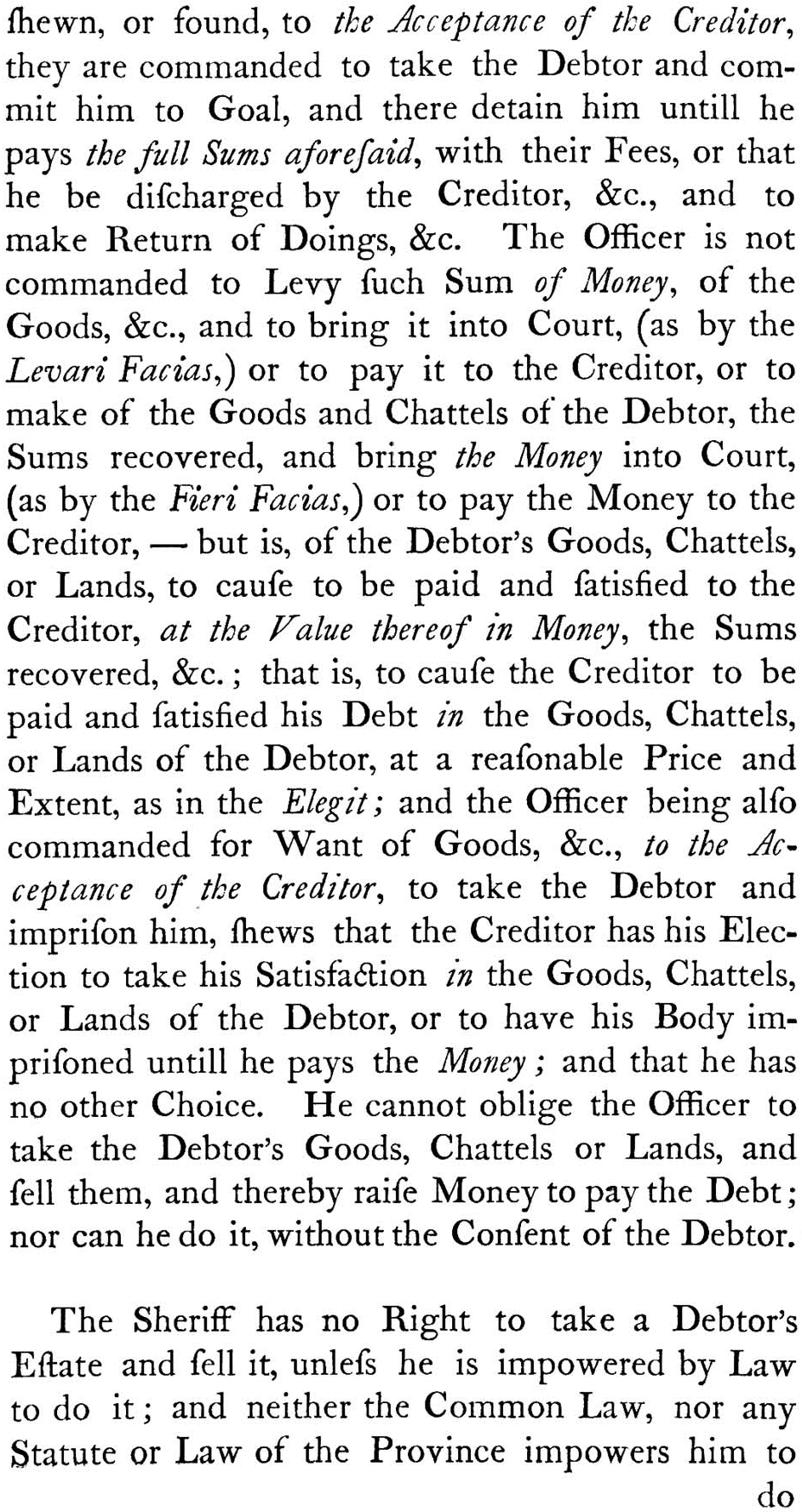
[P. 282]
An appeal was claimed to King in Council, the amount of the damages far exceeding the Charter requirement of £300. Reports, 298. See Charters and General Laws, supra, Province Charter of 1691, 31. Was Trowbridge’s written “Argument” designed to persuade the Privy Council of the error in his brethren? In any event, a search of the Privy Council records has revealed no mention of the case. (My gratitude as always in Privy Council matters to my learned colleague Sharon H. O’Connor.)
The tension between “custom,” or “uninterrupted practice” as the prevailing justices described it, and the “positive law,” prior judicial decisions or legislation, was becoming important on both sides of the Atlantic. Almost simultaneously with this case, the great William Murray, Lord Mansfield (1705–1788) was deciding some of his cases that “incorporated” mercantile practices and customs into the common law. See, for example, Luke v. Lyde (1759), 2 Burrow’s Reports (London, 1766), 882; Edie v. East India Company (1761), 2 Burrow’s Reports (London, 1766), 1216; and Pilliams v. Van Mierop (1765), 3 Burrow’s Reports (London, 1771), 1663. Mansfield’s philosophy differed from his distinguished predecessor, Sir John Holt (1642–1710). In Buller v. Crips (1704), 6 Modern Reports (London, 1713), 29, Holt refused to recognize a right by an indorsee of an inland bill of exchange against the drawer, despite testimony by leading merchants that such bills “had been used for a matter of thirty years” in that way and that it would be a “mighty convenience for trade” to recognize the action. Id., 31. The result was the passage of 3 & 4 Anne, Ch. 9 (1704, the “Act of 1704,” that made inland bills enforceable by the indorsees. See the full discussion at D. R. Coquillette, “Legal Ideology and Incorporation IV: The Nature of Civilian Influence on Modern Anglo-American Commercial Law,” 67 B.U.L. Rev. 877, 934–962 (1987). See also C. H. S. Fifoot, History and Sources of the Common Law (1949), 395–443.
This tension between recognizing and “incorporating” custom and long practice as a source of law, or rejecting it as too informal and illegitimate, can be seen in a number of Quincy’s cases. For example, Baker v. Frobisher (1761), Reports, 4, Case 2, looked to the practice of merchants in determining an implied warranty of merchantability, and in Baker v. Mattocks (1763), Reports, 69, Case 29, the Chief Justice-very much on the fence as to the legal issue of portability of entails-noted that “it has long been thought otherwise here” (i.e., fee tails not partible) in coming to his eventual decision. Reports, 74.
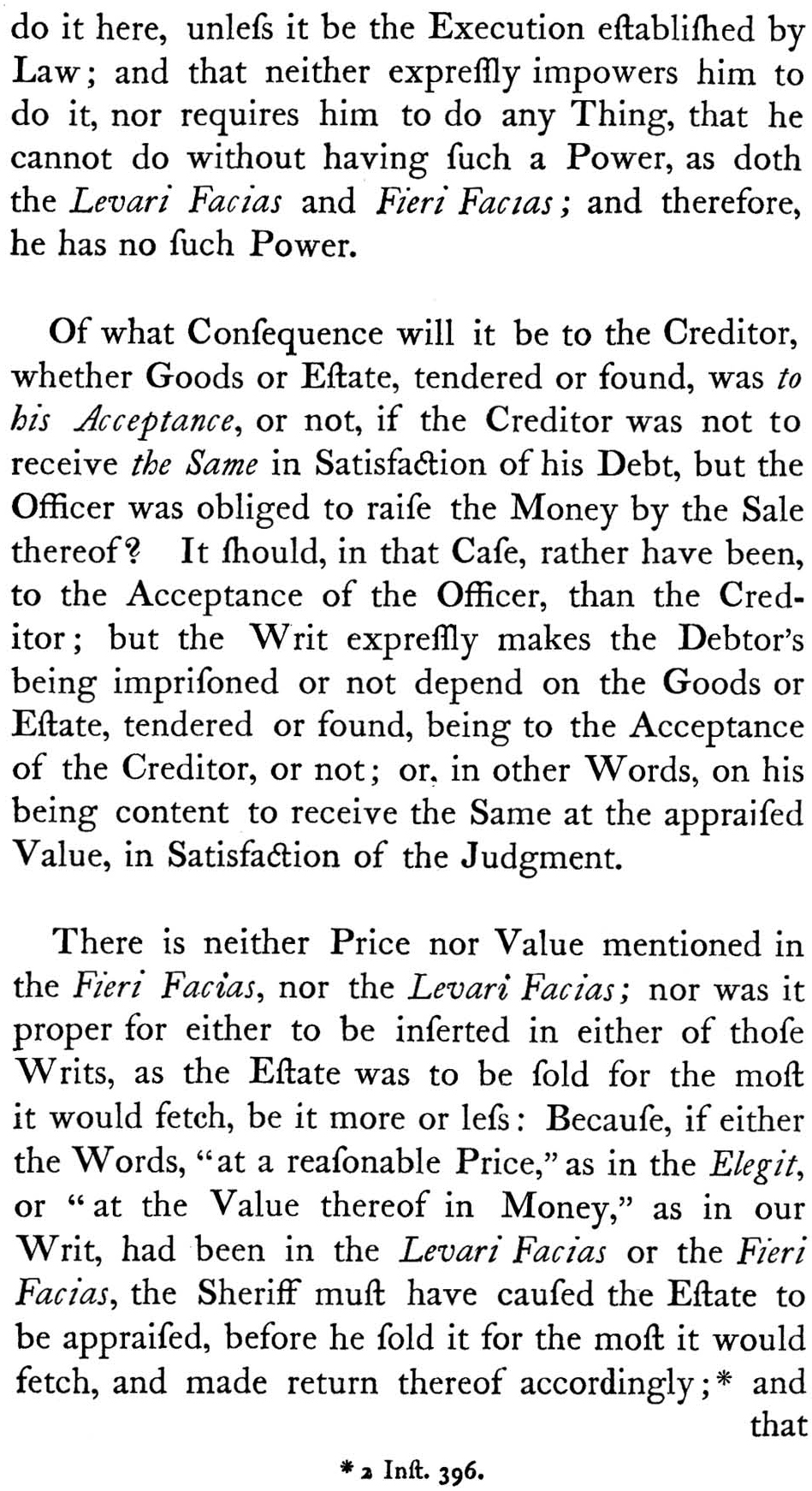
[P. 283]
And what was Quincy’s view? In the conclusion of the report of this case Quincy expresses his admiration for the one trained lawyer on the bench-Justice Trowbridge-and observed “Qu. whether there is any Reliance to be made on a contemporaneous Exposition of Laws, unless such Exposition has been made, seriatim (i.e., “severally, and in order.” Jowitt, supra, 1614-referring to a regular series of formal judicial decisions?), by the King’s Judges.” Reports, 298, italics in the original. The majority of the Court, over Trowbridge’s lengthy written dissent, was looking to “the uninterrupted Practice of the Sheriffs in this Province (italics added),” as Lord Mansfield would look to the practice of merchants. So Quincy, at least reporting in this case, would turn his back on incorporating non-judicial practice as a source of law.
Of course, the irony of such “incorporation” of practice is that once the practice is recognized as law-as the Sheriff’s practice was in this case-it is then a judicial precedent, and arguably the doctrine loses the “realistic” flexibility of actual custom once it is “built” into the formal law. The young Quincy seems to have missed most of the subtleties of this problem in his admiration for Trowbridge’s knowledge of the formal law. As he noted, “Marcellus-Ingreditur-Viros Supereminet omnes.” Reports, 298, i.e., Trowbridge [like Marcellus] “appears and towers over his men.” The Aeneid, Book 6, line 854. (As always, I am indebted to my research assistants, Elizabeth Kamali and Susannah Tobin, excellent classicists both.)
[P. 284]
[P. 285]
[P. 286]
[P. 287]
[P. 288]
[P. 289]
[P. 290]
[P. 291]
[P. 292]
[P. 293]
[P. 294]
[P. 295]
[P. 296]
[P. 297]
[P. 298]
ILLUSTRATION 15: Case files of the Inferior Court of Common Pleas, Suffolk, showing the tins in which many colonial court records are still stored. Courtesy, Social Law Library, Boston. See Law in Colonial Massachusetts (D. Coquillette, R. Brink, C. Menand, eds., Boston, 1984), 527.
CASE 62
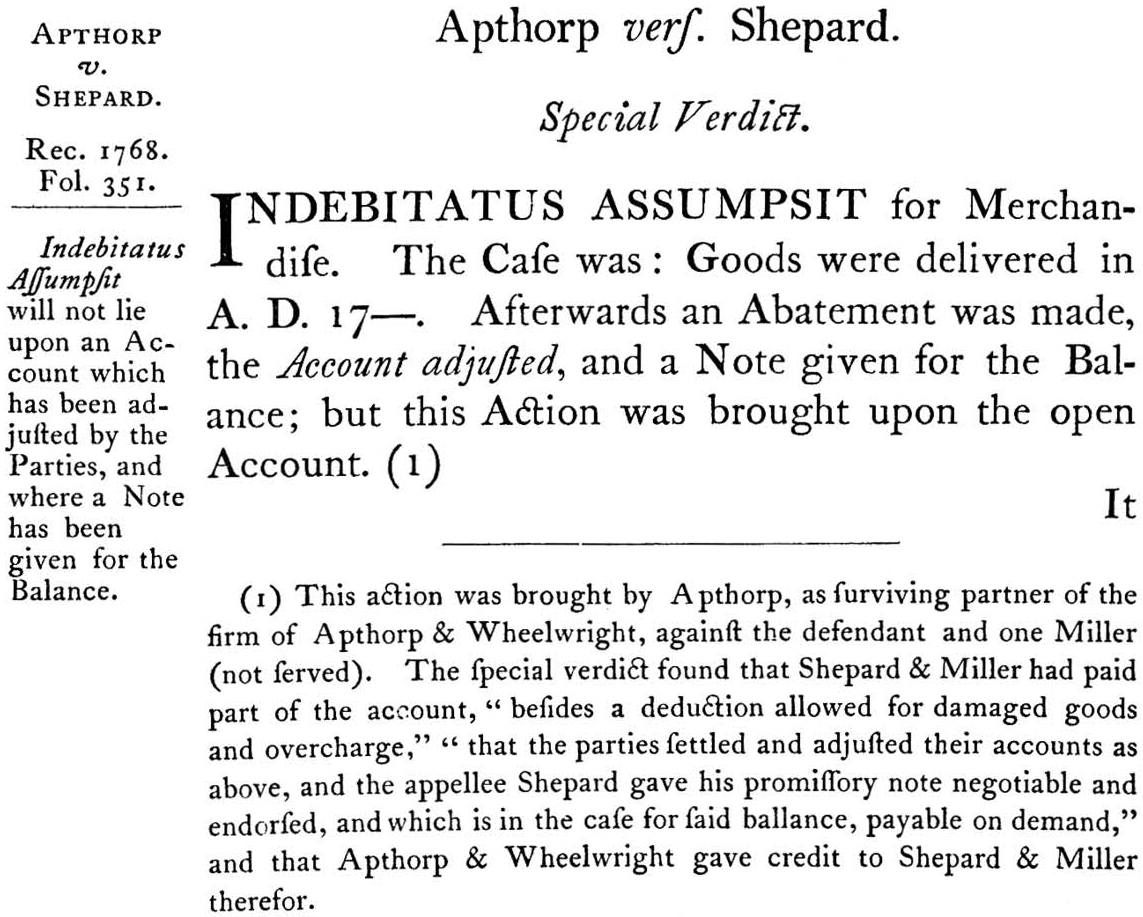
[P. 298]
8 George III (March Term) in the Superior Court of Judicature-Middlesex
1 · brief description
Plaintiff, surviving partner of Apthorp & Wheelwright, sues Shepard in indebitatus assumpsit on an open account for goods delivered. But the account had been adjusted-for damaged goods etc.-and a note given for the balance. Held: after such an adjustment, no general contract remedy on the open account is available. The correct action was insimul computassent (“they accounted together”), based on the adjustment. Reports, 299. See Earl Jowitt, supra, 979.
2 · court records
Available at Rec. 1768, fol. 351.
3 · professionals involved
For the defense was Robert Auchmuty (1723–1788). See the brief biography at Appendix 6. No counsel was named for the Plaintiff.
4 · authority
The defense relied on Millwood v. Ingraham, 2 Modern Reports (London, 1698), 43, 44. That case held that “[a] promissory Note cannot be pleaded in Bar to an Action upon simple Contract: Though a Bond may, because it extinguishes the Debt.” Opposing counsel argued that Millwood had been “denied by Holt to be Law,” citing other English cases. Reports, 299.
Judge Edmund Trowbridge, the newest member of the Court and its only legally trained member, introduced substantial additional English authority for the contrary proposition, that the note extinguished the underlying contractual obligation. See Reports, 299. (For discussion of Trowbridge’s biography and appointment, see Reports, 179, Case 61, Note 3.) The Chief Justice rather pointedly observed that Trowbridge’s authority “were not produced by Council [sic] on argument,” a clear criticism of the lawyer’s legal research.
[PP. 299–300]
5 · later citations
None. Later Massachusetts law would regard Shepard’s note as extinguishing the original claim. See Samuel Quincy’s note at Reports, 299–300, S. Quincy n. 3.
6 · notes
This case was very similar to Pateshall v. Apthorp & Wheelwright (1765), Reports, 179, Case 46, another case growing from the Wheelwright failure. See J. L. Bell, “A Bankruptcy in Boston, 1765,” Massachusetts Banker (4th quarter, 2008), 14. Wheelwright, a son-in-law of the wealthy Charles W. Apthorp, had enjoyed a distinguished public career in the Province before his financial failure and flight to Guadeloupe. See Illustrations 17 and 18, infra. He twice represented the colony in dealings with French Canada. See C. Alice Baker, True Stories of New England Captives (Cambridge, Mass., 1897), 335; Edward P. Hamilton, “Robert Hewes and the Frenchmen. A Case of Treason?,” 68 Proceedings of the American Antiquarian Society (1959), 204–209. My thanks to Mark G. Sullivan.
In Pateshall, the note given by Wheelwright was held not to extinguish the account of the company of Apthorp & Wheelwright. The action brought was the writ of account insimul computassent. See Reports, 179.
But here the issue was whether a general indebitatus assumpsit contractual remedy would lie, rather than insimul computassent, where an account had been adjusted. Samuel Quincy suggested that Trowbridge, at least, would have regarded the note as extinguishing the underlying debt-overruling Pateshall. See Reports, 299–300, S. Quincy n. 3. But the unanimous opinion of the Court seemed much narrower, i.e., that, as in Pateshall, the note did not necessarily extinguish the action, but the correct action was insimul computassent, not a general assumpsit on the open account. For “indebitatus assumpsit,” see Law Commonplace, [96], n. 9. For “insimul computassent,” see Jowitt, supra, 979.
Later Massachusetts would adopt Trowbridge’s view, but this case was about pleading, not the substantive defense of the note. See Note 5, supra. See also the discussion at Pateshall v. Apthorp and Wheelwright, Reports, 179, Case 46 (1765), Note 5, supra.
MEMORANDUM
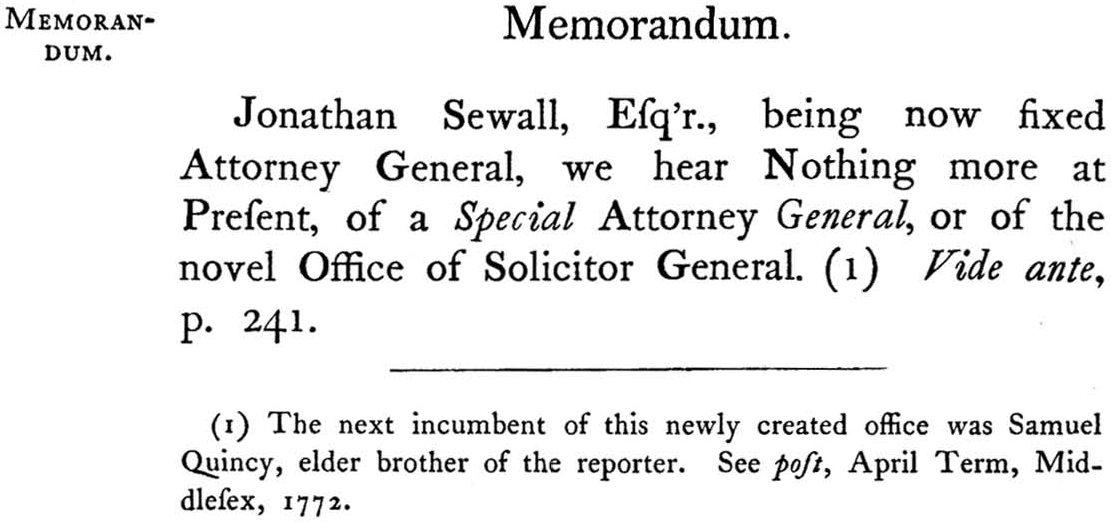
[P. 300]
note
For a brief biography of the Tory Jonathan Sewall (1729–1796), see Appendix 6, infra. Sewall had been appointed barrister in 1762 and Advocate General in Admiralty in 1767. He was proscribed in 1778, and ended up practicing law in New Brunswick. He succeeded Jeremy Gridley, who was appointed Attorney General on March 25, 1767, but died on September 10, 1767.
Samuel Quincy, the Reporter’s brother, was to be appointed to the “novel Office of Solicitor General” in 1771. See Reports, 331, and Appendix 6, infra. John Adams’s doubtful suggestion that this was to win Samuel Quincy to the Tory cause, was disputed by Samuel Quincy, the great-grandson, see Reports, 331–332, S. Quincy n. 1. See also John Adams, 10 Works, supra, 195. It was earlier suggested by Quincy himself that the “Present novel Office of Solicitor” was invented to both placate Sewell, and to satisfy Gridley, who thought that Sewell’s prior appointment as Special Attorney General was “disagreeable.” Reports, 241–242 (italics in the original). Quincy further observed that the title “Special Attorney General” was “Something of an Absurdity it in the very term.” Reports, 242. See also discussion at Reed’s Case, Reports, 331, Case 76 (1772), Note 6 and id., 331–332, S. Quincy n. 1.
CHARGE NO. 8
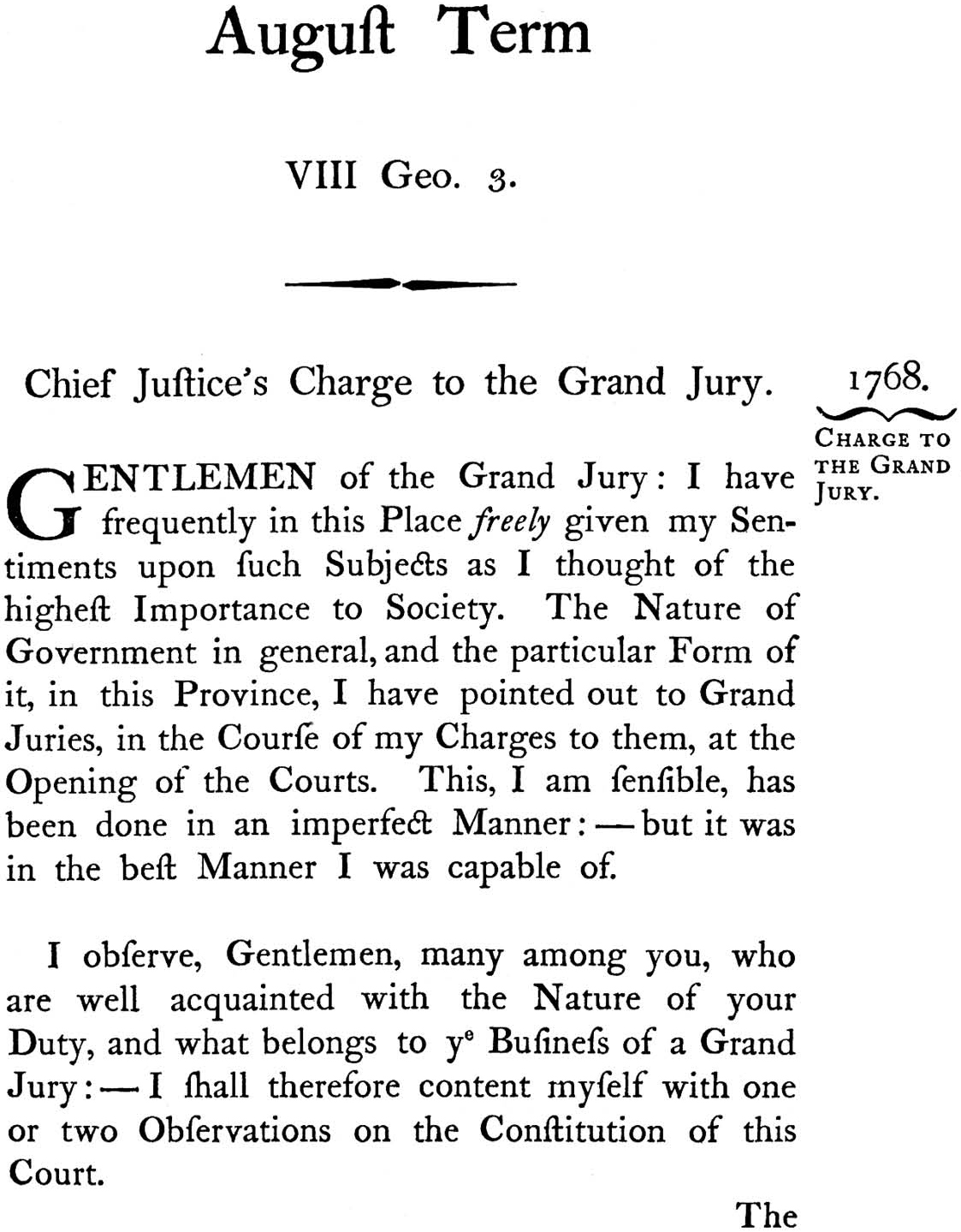
[P. 301]
Charge to The Suffolk Grand Jury by Chief Justice Hutchinson
1768-August Term
note
The Chief Justice observed to the jury that “many among you” were veterans of past grand juries, and thus he chose to address the jurors on constitutional issues, rather than use the regular charge on common or troublesome crimes. His real agenda was probably to persuade the jurors that the Massachusetts judicial system reflected local control and local sovereignty, at least more so than other colonies. It would follow, therefore, that the jurors should do their duty and bring nonpartisan indictments. This approach builds on Hutchinson’s efforts in prior charges, particularly Charge 7 in March 1768, Reports, 258, to emphasize the local roots of the Massachusetts judicial system and the traditions of law and order in the colony, going back to its founders. As an historian of the colony, Hutchinson was in a good position to do this. See his uncompleted History of the Colony and Province of Massachusetts Bay (1764–1828), and Bernard Bailyn, The Ordeal of Thomas Hutchinson (1974), 16–20, 360–361. The bottom line, in Hutchinson’s view at least, was that Massachusetts judges could only be appointed and dismissed by the Governor and Council, giving for more independence than colonies “whose Judicatories are erected at Home [i.e., England], their Judges appointed from thence, and are removable at Pleasure.” Reports, 302. (The example given was New York.) Although Hutchinson did not emphasize this, the Massachusetts judges were also paid by the colonial legislature, not directly by the Crown.
All this changed, of course, after Hutchinson was appointed Governor in 1771 and, as Samuel Quincy noted, by 1772 salaries were granted directly by the Crown and limited to the Crown alone. This caused much unhappiness. See Reports, 302, S. Quincy n. 2. In addition, as Hutchinson conceded, removal by “Governor, with the Consent of Council” was better than removal by Governor alone, but not really the equivalent of tenure “Quamdiu,” i.e., good behavior, which was accorded English judges. Id., 303 (italics in the original). (“Quam-diu” is from “quamdiu se bene gesserit” or “as long as he shall behave himself well.”) This standard was established by the Act of Settlement in 1700. Before that time, tenure was “durante bene placito” or “during the King’s will.” See Bouvier’s Law Dictionary (3d ed., Francis Rawle, ed., St. Paul, Minn., 1914), vol. 2, 2777. Doubtless, part of the reason for the change of the earlier standard by the Act was the removal of Edward Coke as Chief Justice by James I following the Case of the Commendans, Acts of the Privy Council, 1615–1616, 595. See a full account in Daniel R. Coquillette, The Anglo-American Legal Heritage (2d ed., 2004, Durham, N.C.), 342–353.
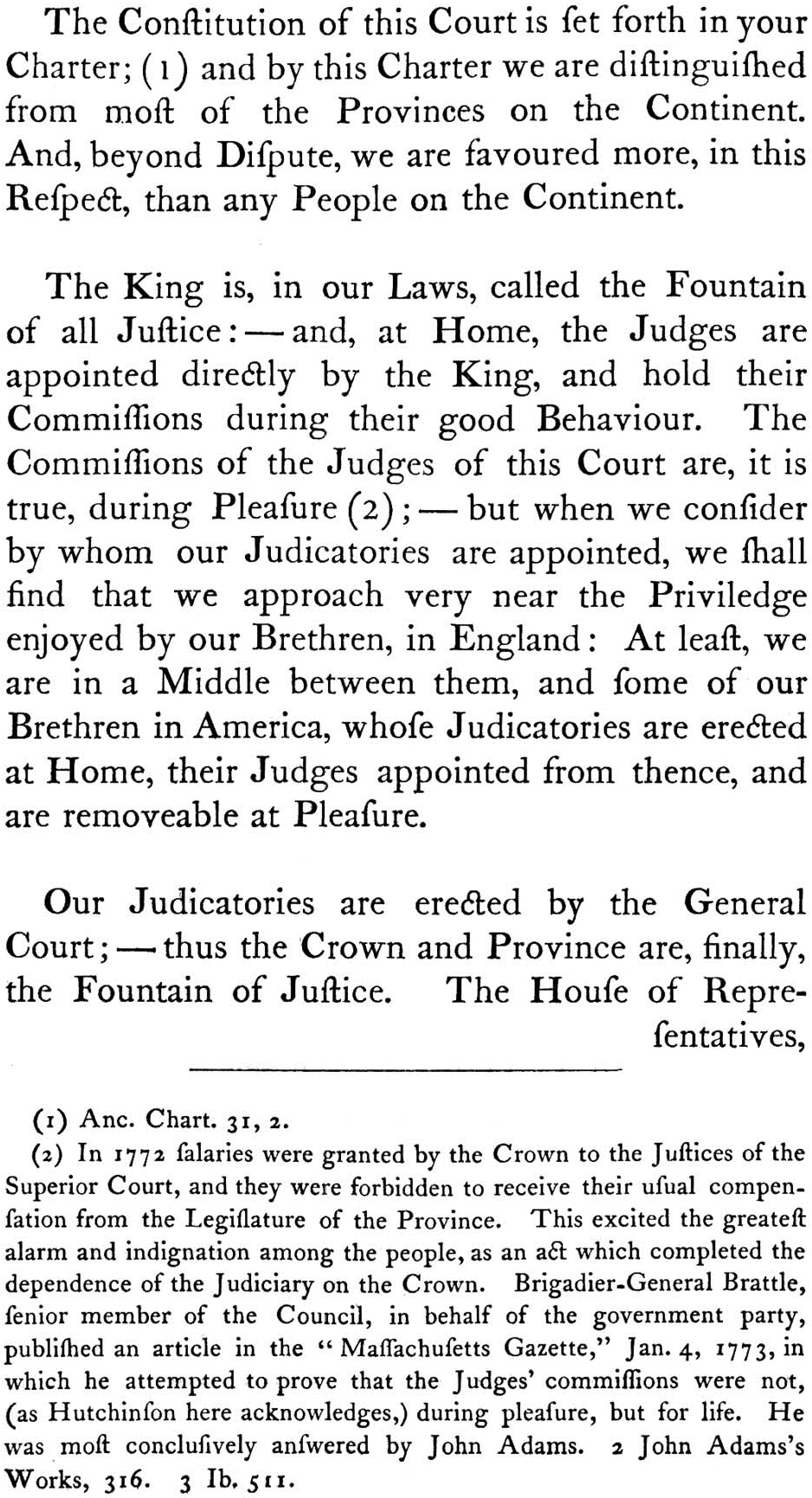
[P. 302]
Hutchinson may also have chosen this topic to contradict a rumor that he had received a Royal Commission himself as Chief Justice. Hutchinson was extremely sensitive to such reports. He had come under severe criticism in the press for continuing to serve as Lieutenant Governor (1758–1771) after being appointed Chief Justice (1761–1769). He also continued his seat on the Council, although no longer elected, on the grounds that the Lieutenant Governor was a member ex officio. This, in turn, led to the troubles described at length in Note to Charge No. 7, March 1768, Reports, 258, supra.
The conclusion of the Charge also repeated the dubious assertion that a grand juror had, by their oath, no discretion but to bring a bill if charged (i.e., “offences brought before you.”) See Reports, 305. As Quincy pointed out in his note to Charge No. 7, Reports, 258, supra, it was doubtful if “the Words of the Oath will bear any such Construction,” the statutory version reading that the juror swore only to “diligently enquire and a true Presentment make of all such Matters . . . as shall be given you in Charge.” Reports, 269, S. Quincy n. 9, quoting Prov. St. 4 W & M (1759 ed.), 26.
Quincy noted that “my absence from the Court” in 1768 prevented him from taking “Minutes of Arguments at the Bar.” Reports, 395. The fact he took the time to record the Charge indicates the importance he attributed to the Charges generally.
[P. 303]
ILLUSTRATION 16: The Old State House, Boston (1748), by Thomas Dawes Jr. and Nathaniel Hurd (Boston, 1751). Courtesy of the Museum of Fine Arts, Boston. This would show the appearance of the Old State House shortly after it was rebuilt, following the disastrous fire of 1747.
[P. 304]
[P. 305]
CHARGE NO. 9
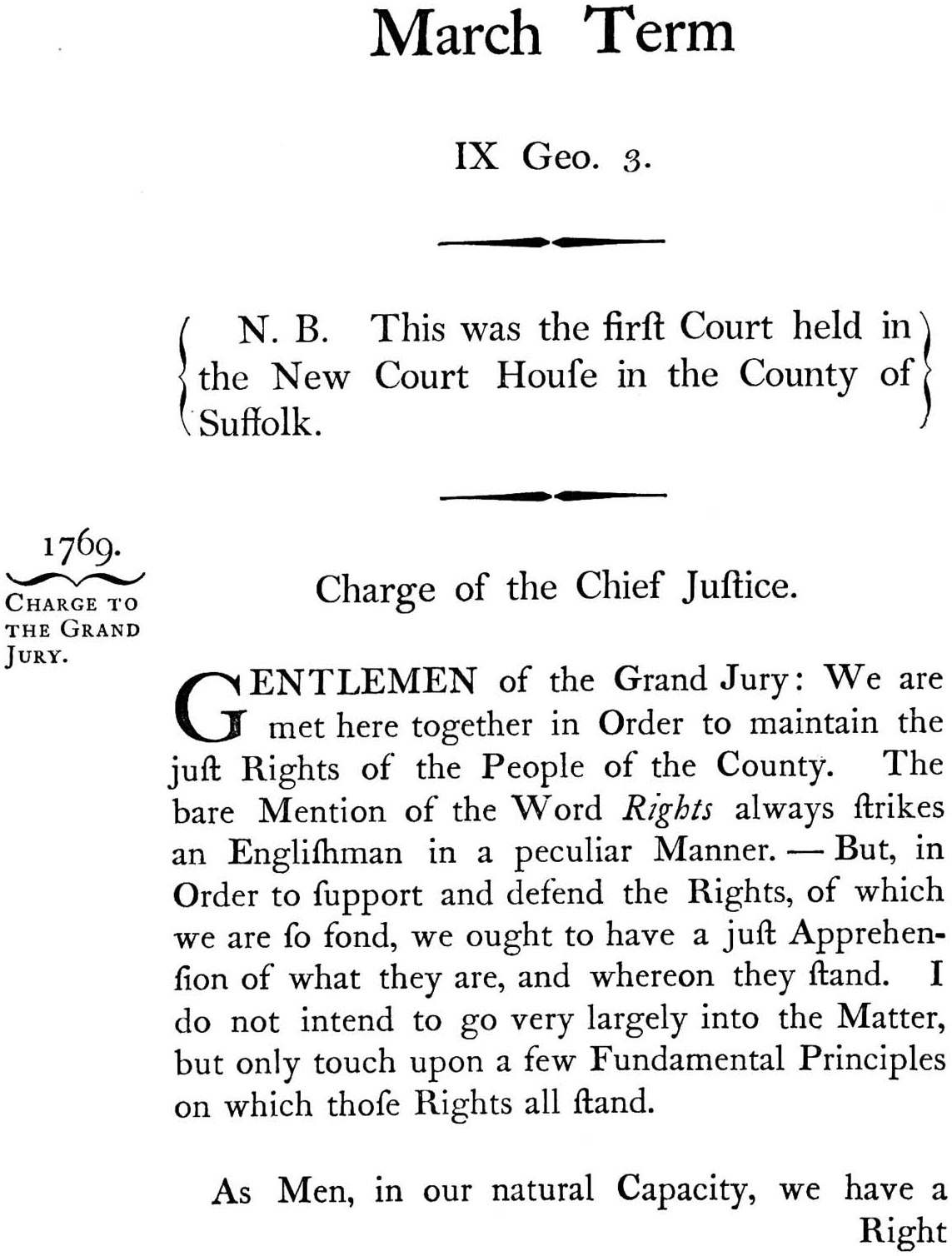
[P. 306]
Charge to The Suffolk Grand Jury by Chief Justice Hutchinson
1769-March Term
note
Reconciling natural law theories with the notion of popular sovereignty was a major issue in eighteenth-century Anglo-American jurisprudence, commencing even earlier in the writings of Thomas Hobbes (1588–1679), John Locke (1632–1704), and others. See Anglo-American Legal Heritage, supra, 372–376. It continued to be a major issue in the early days of the new American Republic. See Arthur E. Wilmarth Jr., “Elusive Foundation: John Marshall, James Wilson, and the Problem of Reconciling Popular Sovereignty and Natural Law Jurisprudence in the New Federal Republic,” 72 George Washington Law Review (2003), 113, 118–176. Indeed, it was a major issue in The Federalist debates. Id., 136–144.
This was the last charge that Hutchinson gave to a grand jury. The next charge, Charge No. 10 of the August Term, 1769, Reports, 316, was delivered by Justice Lynde, doubtless because of the growing controversy over Hutchinson’s simultaneous offices. See Note, Charge 10, August 1769, Reports, 316, supra. Very significantly, Hutchinson focused on natural law theory and its inherent limitation on some human liberties and popular sovereignty.
Hutchinson distinguished between men “in our natural capacity” and “Members of Society.” Reports, 306–307. As in Hobbes, “state of nature,” men in their natural capacity have unlimited freedom, but “we are under a Necessity of giving up some of our original Rights, in Order to [gain] a full Enjoyment of the Remainder.” He continued, “And the best Constitution of Government must certainly be that, in which we part with the fewest of our natural Rights;-that is, where we part with no more than is absolutely necessary to attain the very Ends of Society and Government.” Id., 307. Even Bentham would have approved. See Jeremy Bentham, A Fragment on Government (London, 1776), “Introduction,” paragraph 28.
But Hutchinson jumps from this argument to three other conclusions, all debatable: (1) that the present Massachusetts “Constitution of Government” is “the most happy . . . because we have never yielded up more of the Private Rights of the Individual than was needful . . . ;” (2) that, therefore, “Redress of all Grievances” must be through regular application to the ‘Legislative Body’ . . . To aim at a Redress any other Way is to bring Everything into Confusion”; and (3) that, therefore, those who “execute the Law,” such as grand jurors, “are not to enquire into the Reason and Policy of it.” Id., 307. The result of what today we would call “jury nullification” would be, in Hutchinson’s view, “the most absolute Despotism formed by a Union of Legislative and Executive Power.” Id., 308. The latter argument would doubtless irritate some of Hutchinson’s contemporaries, such as “A True Patriot” of the Boston Gazette of February 29, 1768, who saw Hutchinson himself as violating this principle by simultaneously holding the office of Lieutenant Governor and sitting on the Council, while being Chief Justice. See Note, Charge 7 of March 1768, Reports, 258, supra.
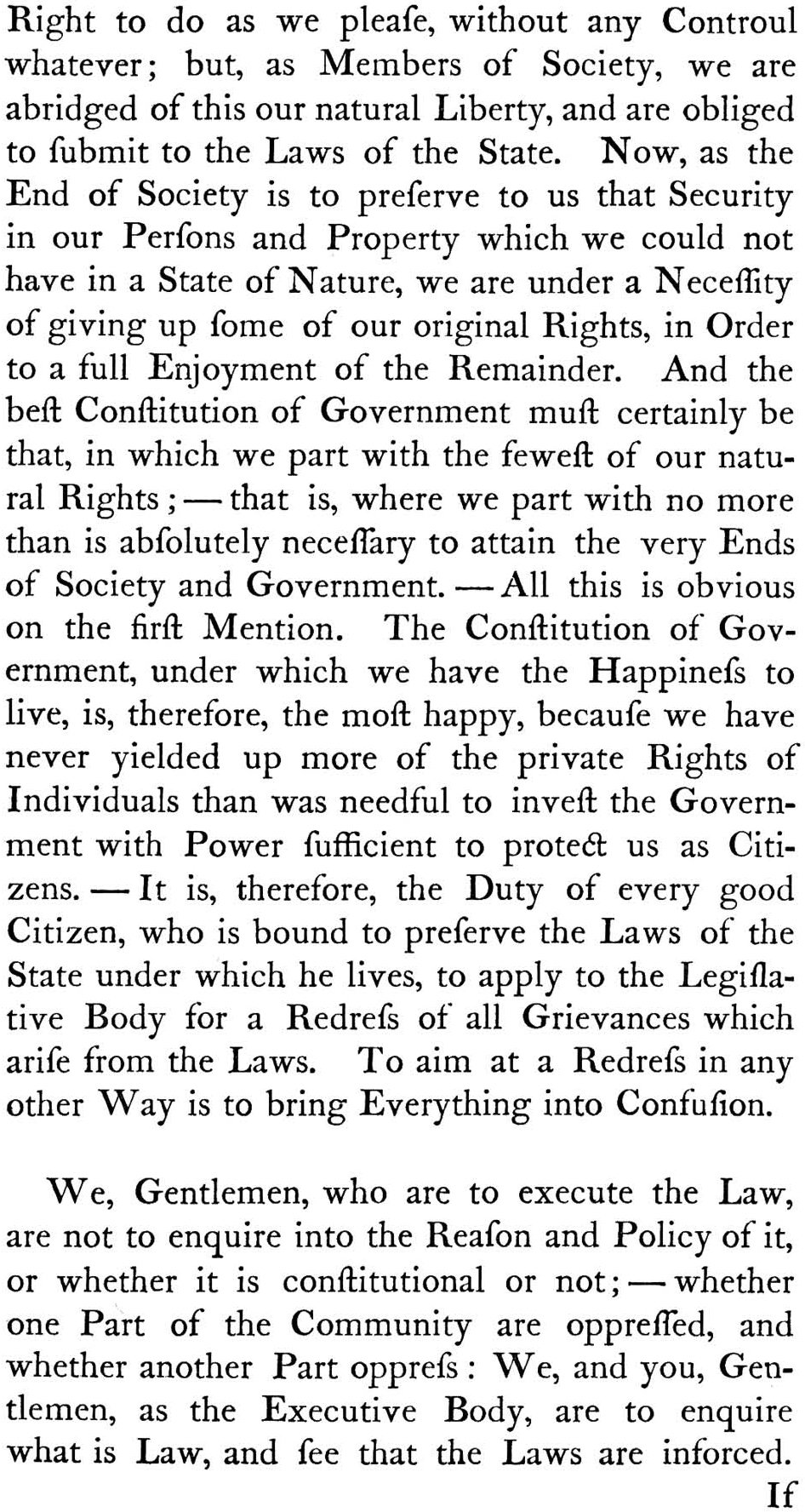
[P. 307]
It was very revealing that Hutchinson chose to make such fundamental arguments to a grand jury. Obviously he felt the legitimacy of the system itself was in doubt, and that the jurors could not be relied on to simply apply the law. Hutchinson singled out two particular areas, libel and perjury, for comment. As to libel, Hutchinson said, “I am discouraged!-My repeated Charges to Grand Juries on this Head . . . being so entirely neglected.” Id., 309. Perjury was the other concern. In his Charge 7 of March 1768, Hutchinson had also focused on perjury, with particular emphasis on smuggling. “I am sorry we have so much Reason to think this Crime is so frequently committed in out Custom-House Oaths.” Id., 261. See Note, Charge 7, March 1768, Reports, 258, supra. Now Hutchinson was concerned about this Crime, “So often committed among us, because of what is said about challenges to the legitimacy of the government itself. . . . People sometimes dispute the Constitutional Authority of the Court which requires their Oath, and hence think themselves excusable. . . .” Id., 310. Here, too, Hutchinson turns to a natural law argument, perjury is a violation of God’s law. “In my Mind, temporary Punishments would be as a Feather, compared with Divine Vengeance.” Id., 310. To this Hutchinson added “false swearing,” i.e., administering oaths without proper authority, as also a crime “in the View of God.” Id., 310–311.
The latter issue, “false swearing” resulted in one of Quincy’s longest political notes in the entire Reports. Hutchinson had a particular matter in mind “for God’s Sake, Gentlemen, exert yourselves, as this Occasion. . . .” This “occasion” was Richard Dana’s administration of the oath of resignation as Stamp-Master to the loyalist Andrew Oliver at the instance of the Sons of Liberty on December 17, 1765, under a “Liberty Tree.” See Quincy’s own note, Reports, 311. Quincy was outraged by this very late information and charge against Dana. To begin, Richard Dana was certainly one of the most senior members of the bar, listed fourth in the colony by the Memorandum of 1762. See Reports, 35, and Appendix 6, infra, Biography 28. Secondly, he was a justice of the king’s peace. The mob probably thought he was a loyalist acting, like Oliver, under coercion. His later sympathies for the colonial cause were, at least in Quincy’s view, unsuspected at the time. “The Sons, at that Time, Imagined Mr. Dana to be in a very different political Box, from that in which he afterwards approved.” Reports, 312, Quincy’s own note. In short, the whole late charge smacked of vengeance for Dana’s later political acts, such as Dana’s exchange of “exceeding high words,” with the well paid loyalist Attorney General Jonathan Sewall over the latter’s dismissal of an indictment against a British sentry for false imprisonment of a Boston merchant who failed to answer the sentry’s hail. Id., 312, Quincy’s own note. Finally, Dana (1700–1772) was an elderly gentleman by 1769. In Quincy’s view, the grand jury clearly should not find a bill, and they apparently did not.
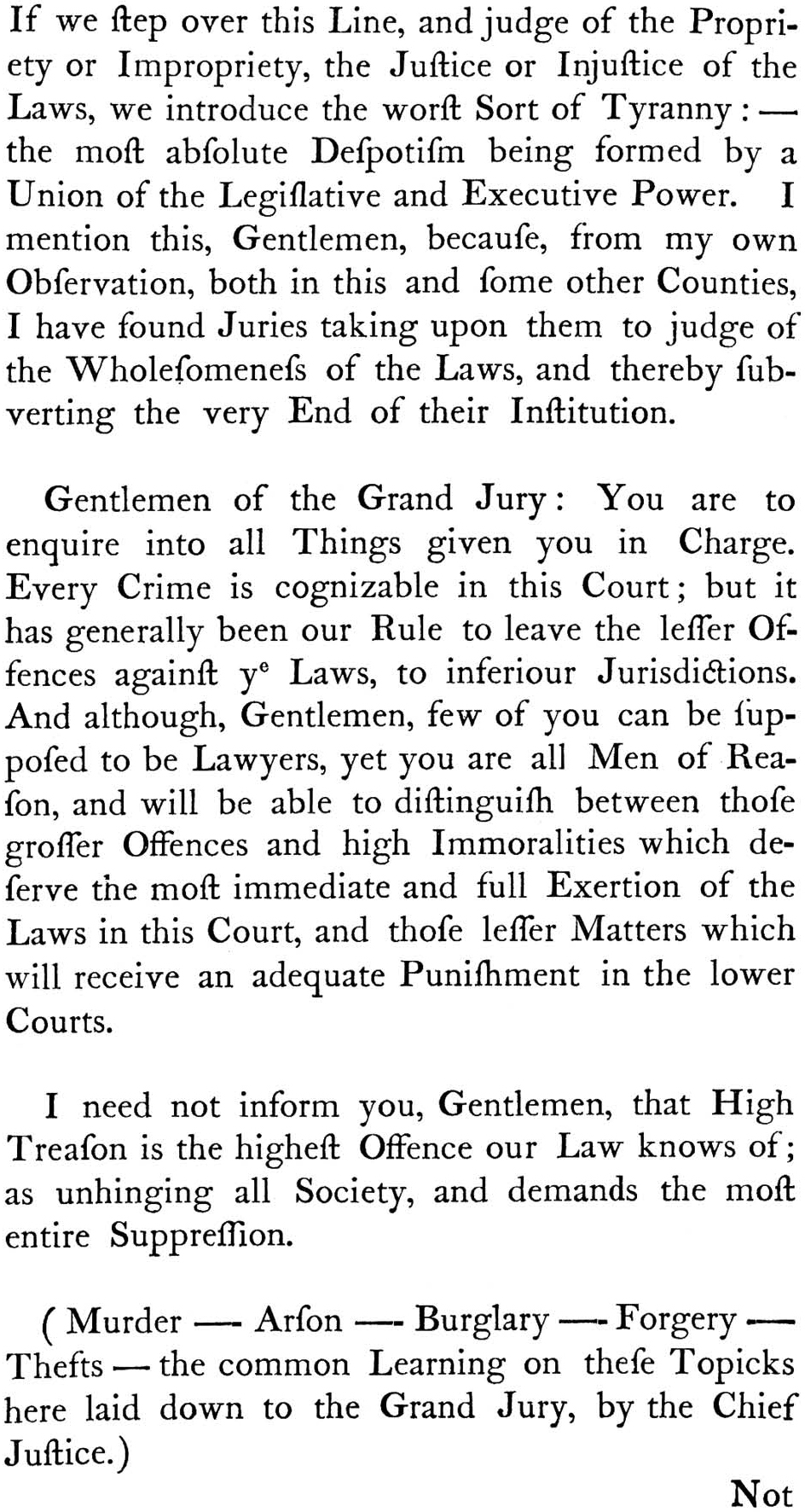
[P. 308]
Hutchinson then turned to the history of the grand jury itself, as an institution of “high Antiquity.” Id., 312. While praising the Massachusetts practice of returning impartial jurors from the town venires, he expressed “some Reason to fear” that some jurors were now selected to “connive at and pass over in Silence and entirely smother . . . Crimes of an alarming Nature,” doubtless libel, perjury, etc. Quincy’s note snorted sarcasm. “Qu. If this Insinuation has even the least Shadow of Truth. . . .” Id., 313, Quincy’s own note. Not surprisingly, Hutchinson closed by emphasizing secrecy, a topic also emphasized in early charges, with specific reference to the safety of Crown informants. See Charge 1, March 1765, Reports, 116. (“[Y]ou are to keep the Names of Informers, and Everything else that comes before you in your present capacity secret. . . .”)
All in all, this final Charge of Hutchinson was evidence of a deteriorating political situation, which threatened the very institutions that defined Hutchinson’s life. There is even a note of sympathy in Hutchinson’s conclusion, as he acknowledged “[i]t is not to be expected in this World that we should all be of the same Sentiments.” Nevertheless, he appealed to the jurors’ “Sentiments of Duty,” concluding “whatever are our Sentiments of Duty, a good Conscience will dictate to us, to act accordingly.-May the Great God bless and direct you.” Id., 315. Thus ended what was probably Hutchinson’s last opportunity to directly address a people that would drive him from his beloved Massachusetts in five years, in 1774, and cause him to die in a homesick exile, six year later. What an ironic fate for the great-great-grandson of the rebel Anne Hutchinson! See generally Bernard Bailyn’s classic account in The Ordeal of Thomas Hutchinson (1974).
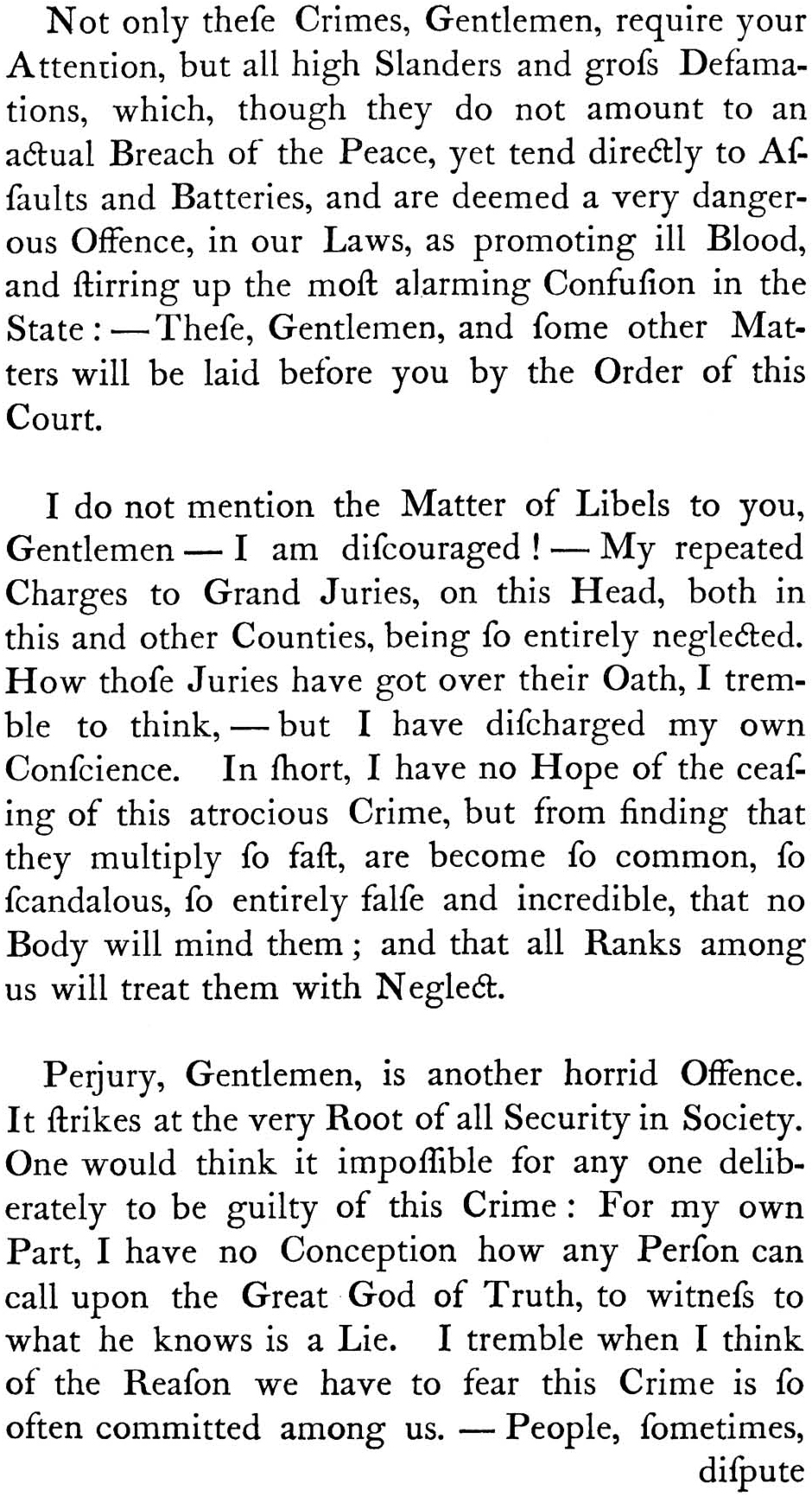
[P. 309]
As Quincy notes, this was the first session held in the “New Courthouse.” This building was erected in 1769 on the site of the old colonial prison, made famous by reference in Nathaniel Hawthorne’s The Scarlet Letter (1850). The location was just off what is today Court Street, renamed from “Queen Street” in 1784. Another courthouse was constructed near the site in 1810, and yet another in 1833–1836 by Solomon Willard. The location is clearly marked on the J. G. Hales map of 1814 and less so on the Bonner map of 1769. See Walter Muir Whitehill, Boston: A Topographical History (Cambridge, Mass., 1968), 45, 56–57. See also John Freely, Boston and Cambridge (New York, 1984), 85–86. A remote view can be seen behind the Old State House in James Brown Marston’s (1775-1817) oil painting which is the frontispiece to volume 2, supra. The cupola can also just be seen to the right of the Old State House in Paul Revere’s famous engraving of the Boston Massacre (circa 1770), which is the frontispiece of this volume. By far the best account of all this is Martha J. McNamara’s masterful From Tavern to Courthouse: Architecture and Ritual in American Law, 1658–1860 (Baltimore, 2004). See id., 46–52, 83–90, 104–106. I am also deeply grateful to her for her kind personal help with all of the above.
[P. 310]
[P. 311]
[P. 312]
[P. 313]
[P. 314]
[P. 315]
CHARGE NO. 10
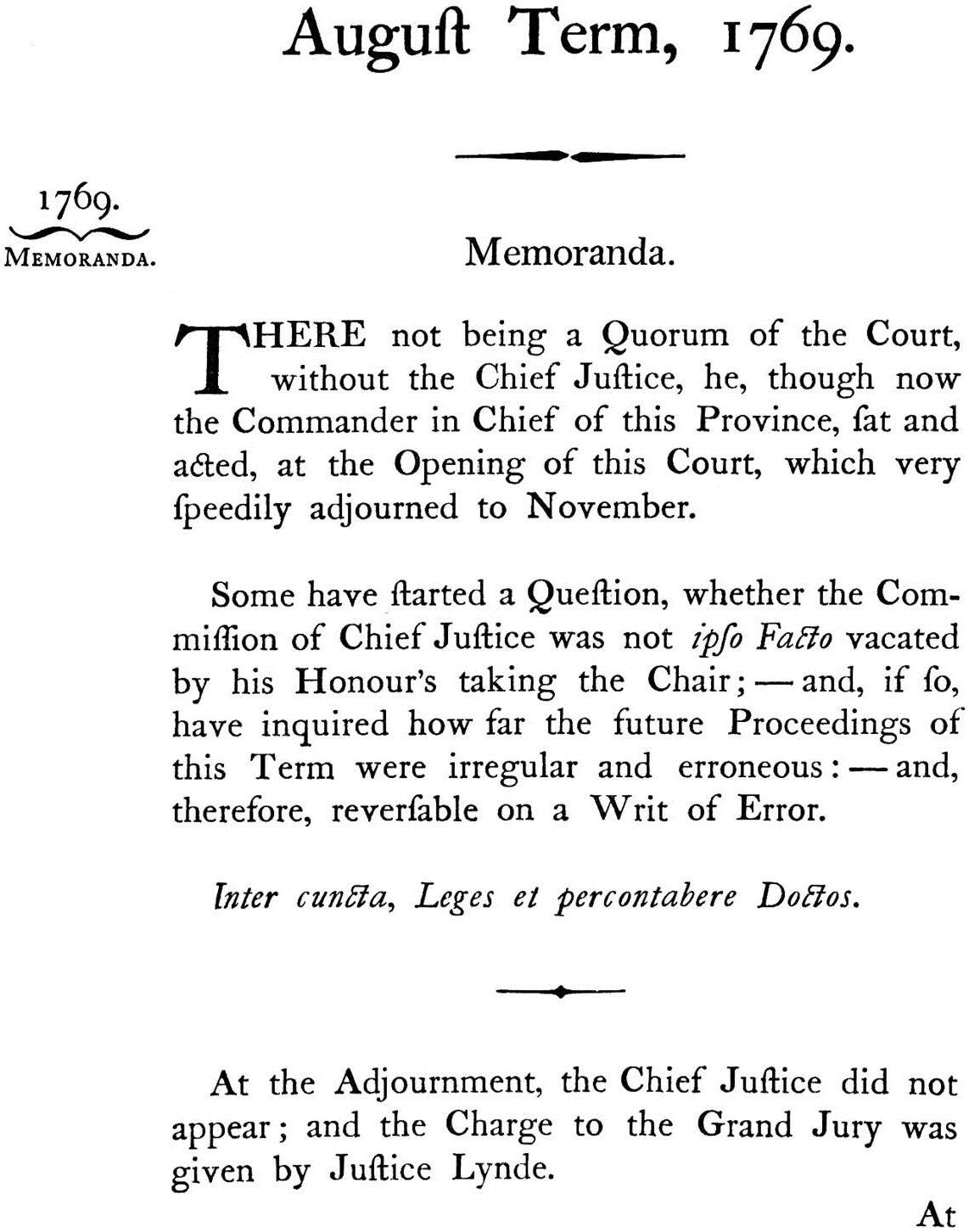
[P. 316]
Charge to The Suffolk Grand Jury by Chief Justice Lynde
1769-August Term
note
The issue of whether one should hold, simultaneously, executive or legislative positions and judicial positions, which had so incensed Hutchinson when he was attacked by the press in 1767, was now back with a vengeance. See Notes, Charge 6, August 1767, Reports, 241, Charge 7, March 1768, Reports, 285, and Charge 8, August 1768, Reports, 301. Hutchinson had become Commander and Chief of the Province and was destined to be Governor in 1771. He would soon resign, and Lynde would become Chief Justice. Quincy certainly believed that Hutchinson’s continuing as Chief Justice was “irregular and erroneous,” and threatened the legality of any court proceedings. Reports, 316. In any event, Lynde, not Hutchinson, charged the Grand Jury. There was no substantial description by Quincy.
Quincy did, however, record how he himself had appeared in the Superior Court, arguing to a jury, “unsanctified and uninspired by the Pomp and Magic of-the Long Robe.” Reports, 317. The bifurcation of the English bar into the barristers “of the long robe,” and subordinate attorneys, was a matter of interest to the American bar. In 1761, Hutchinson had attempted to establish the rank of barrister and to require gowns and wigs. The small practicing bar went along, including Adams. Adams noted in his diary that “About this time the Project was conceived, I suppose by the Chief Justice . . . , of cloathing the judges and Lawyers with Robes. Mr. [Samuel] Quincy and I were directed to prepare our Gowns and Bands and Tye Wiggs, and were admitted Barristers, having practiced three Years at the Inferior Courts, according to one our new Rules.” John Adams, Diary and Autobiography, supra, vol. 3, 276. See also John Adams, Legal Papers, supra, vol. 1, lxxviii–lxxix, John Adams, Diary, supra, vol. 1, 235–236. See also G. W. Gawalt, The Promise of Power, 33, note 29. Equally significant was the founding of the new Suffolk County Bar Association in January of 1770, with Adams as its first Secretary. See Daniel R. Coquillette, “Justinian in Braintree,” Law in Colonial Massachusetts, supra, 396–397. At the time of Hutchinson’s initiative, a “Memorandum” was conducted which listed, in order of seniority, 26 lawyers, apparently the “bar.” See Reports, 35. Some were clearly too old to practice and were included as a courtesy, such as James Otis, Senior. Only twelve appeared regularly in Quincy’s Reports. The most junior members, in 1762, were Quincy’s brother, Samuel, and John Adams. Of the total list, twelve actually appeared in court “in Barrister’s Habits,” including Adams, Samuel Quincy, Jeremy Gridley, James Otis Jr., and Robert Treat Paine. Reports, 35.
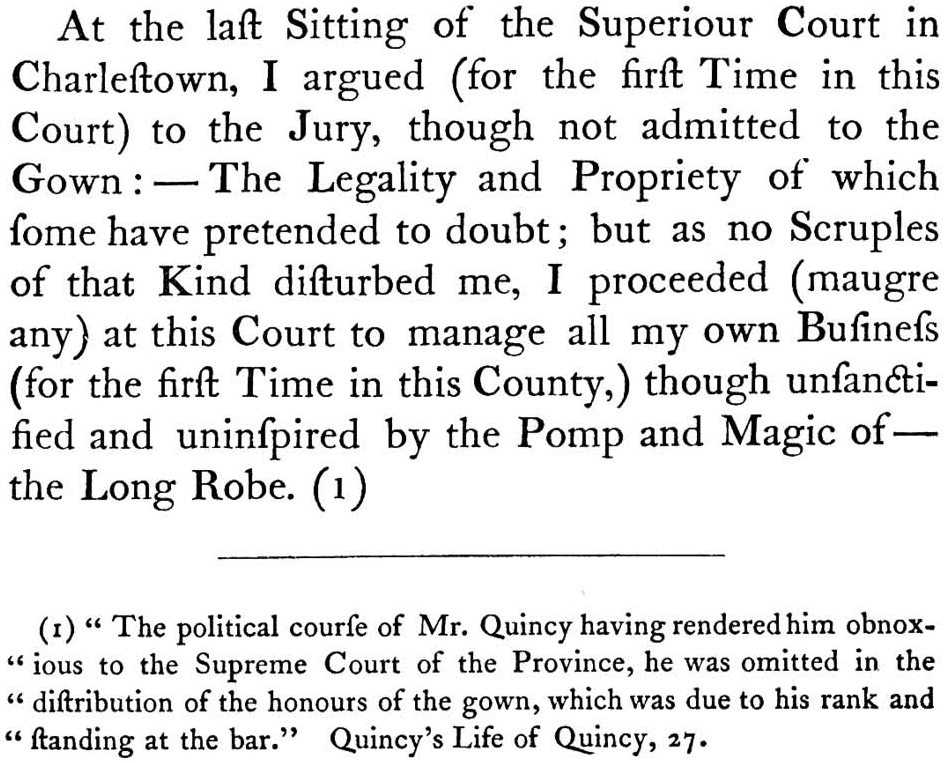
[P. 317]
By August of 1769, Quincy was clearly of seniority to join this group. See Reports, 35, “Memorandum” Rec. 1762, Fol. 400, and Appendix 6, supra. But with the confidence born of high social status, wealth and intelligence, he chose to simply disregard the slight. Nevertheless, just as the developing hierarchy of the bar was significant in the history of American professional elites, so Quincy’s exclusion in 1769 spoke volumes of an increasingly divided society-despite the brave words of Hutchinson about a harmonious and collegial bar only four years before, in 1765. See Reports, 197.
CASE 63
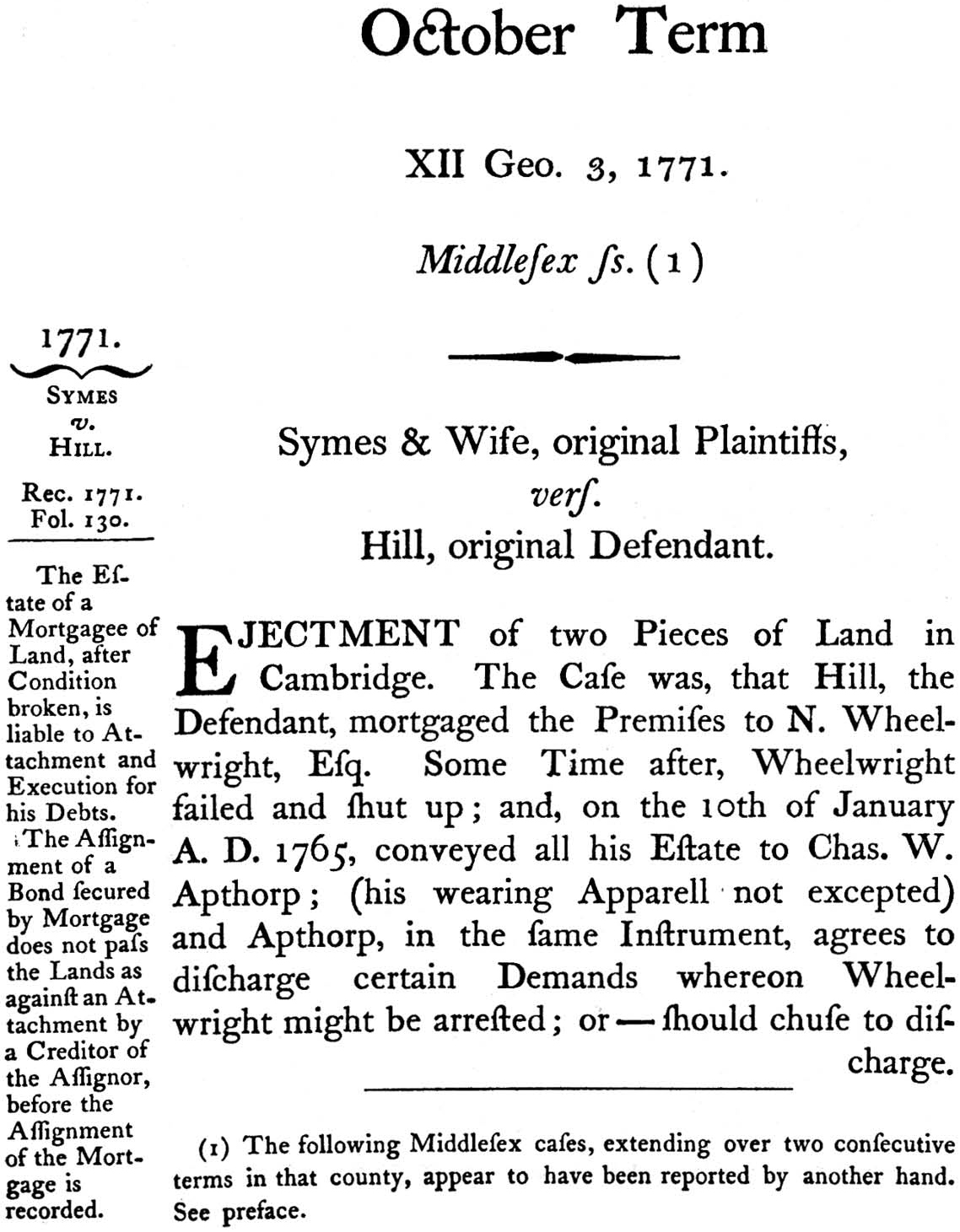
[P. 318]
Symes & Wife, original Plaintiffs v. Hill, original Defendant (1771)
12 George III (October Term) in the Superior Court of Judicature-Middlesex
1 · brief description
This was another case growing out of the Wheelwright failure. See Reports, 179, Case 46 (1765) and Reports, 298, Case 62 (1768), supra. See also Illustrations 17 and 18, supra. Defendant Hill mortgaged his land to Wheelwright. On Jan. 10, 1765, Wheelwright assigned all his estate to Apthorp, but did not record the assignment of the mortgage until March 8, 1765. On Jan. 18, 1765, Plaintiffs Symes & Wife attached the land to secure debts owed to them by Wheelwright. Held: even assuming the assignment was not fraudulent, the fee in the land was held by Wheelwright until the recording of the assignment, and thus was duly attached by the Plaintiffs. The fact a bond was assigned to Apthorp before the attachment, secured by the mortgage, did not pass the land so as to defeat the attachment.
2 · court records
Available at Rec. 1771, fol. 130.
3 · professionals involved
Counsel for the Plaintiffs was the Patriot and future President, John Adams (1735–1826). Counsel for the Defendant was Samuel Fitch (1724–1799) who was, at the time, Advocate General of the Admiralty (1770–1776), and was proscribed in 1778. See brief biographies at Appendix 6, infra.
Like Richmond v. Davis, et al. (1768), Reports, 179, Case 61, supra, this case also showcased the power and talent of Edmund Trowbridge, the only legally trained justice. See also Hooton v. Grout (1772), Case 75, infra. Trowbridge dominated the discussion and issued the direction to the jury, his brethren adding little. “I have little else to add to my Brother Trowbridge,” commented Oliver. Reports, 325.
John Adams also got carried away in the eloquence of his case, stating, “A Chose in Action cannot be assigned. ’Tis a Rudiment in Law; and necessary to abridge the powerful and aid the weak.” Reports, 321.
[P. 319]
This egalitarian appeal failed to impress the court. “Mr. Adams, we think you need not labour this Point. You may answer Mr. Fitch’s Authorities briefly, if you please.” Reports, 321.
4 · authority
The fundamental issue of whether a creditor could attach mortgaged land of which the debtor was mortagee was resolved by a series of colonial statutes starting with “An Act for Making of Lands and Tenements Liable to the Payment of Debts,” 8 William III, c.3 (1696). See also 6 Geo. I, c.2 (1719) and 8 Geo. II, c.5 (1735), at Charters and General Laws, supra, 292, 423–424, 501–502. See also the discussion at Hooton v. Grout, Reports, 343, Case 75 (1772), supra, which may have been argued at the same time. Id., Note 3.
This case is the first of a group of Middlesex cases, Reports, 318–40, Cases 63–74. These cases are not in Quincy’s hand, nor in his precise style. One clear difference is that this other Reporter took down the argument of counsel, verbatim, like Quincy, but was sloppy in recording authority and never, unlike Quincy, critically examined the authority. Also, Quincy was counsel in some of these cases, and may have hired someone to take notes while he made arguments. See Reports, 326, Case 65 and Reports, 332, Case 68.
Fitch used extensive English case authority to try to show that the transfer of a bond from Wheelwright to Apthorp, before the attachment, defeated the attachment because it was secured by the unrecorded mortgage. He also argued that the assignment “conveys the Debt in Law (i.e., the debt owed to Wheelwright by Hill is assigned to Apthorp) . . . and also the Mortgage.” Reports, 320.
Adams, after being cut short in his emotional argument by the Court, was asked to “answer Mr. Fitch’s Authorities.” Reports, 321. This he did by distinguishing those cases in equity, and otherwise challenging the precedents, case by case. “Vern. And Cases in Equity Abr. [Vernon’s Cases Argued in the High Court of Chancery (London, 1726–8); General Abridgement of Cases in Equity (London, 1732)] are Principles of Equity; and as such are true; but, as we are before a Jury, are of no Consequence.” Reports, 321. Trowbridge’s “Direction to the Jury” cited no cases, but was quite specific about the English mortgage law and the requirement for fraud. Reports, 223–224.
The only other authority cited by the bench was Twyne’s Case, 3 Coke’s Reports 80a (1601), cited by Justice Cushing for the suspicion that the conveyance was fraudulent. In Twyne’s Case a debtor assigned all his goods, mostly sheep, to another, but continued to “shore the sheep, and marked them with his own mark. . . .” Id., at 806b. As Adams argued, the conveyance to Apthorp was suspicious.
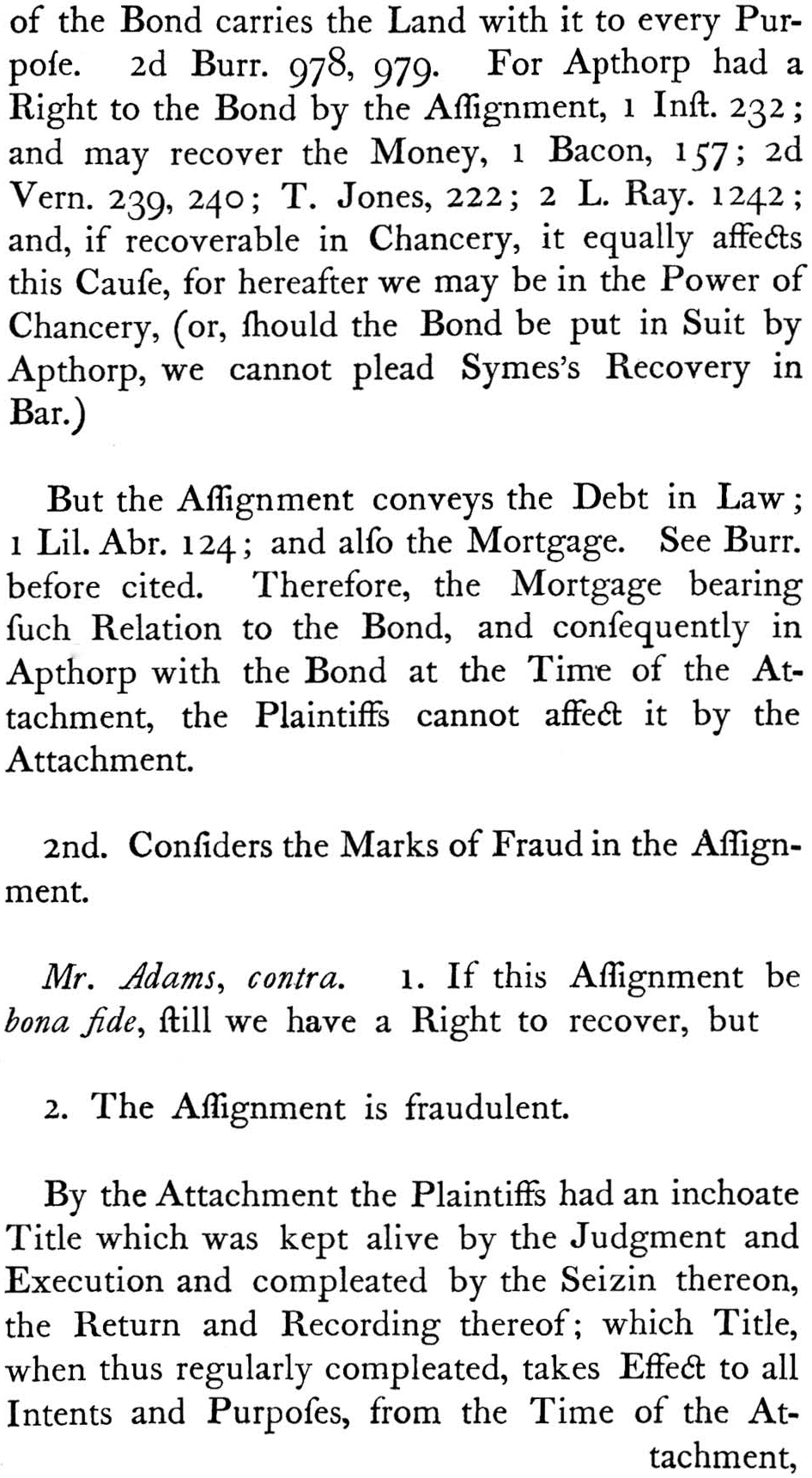
[P. 320]
5 · later citations
None. This case was probably argued with Hooton v. Grout, Reports, 343, Case 75 (1772). See Reports, 368–369, S. Quincy “Note,” Legal Papers of John Adams, supra, vol. 1, 231.
Samuel Quincy observed, “[t]he law in this commonwealth has long been settled in opposition to the doctrine here laid down.” Id., 369. But see “Editorial Note” to Prout v. Minot, Legal Papers of John Adams, supra, vol. 1, 231, which suggests the contrary.
6 · notes
Wheelwright and Apthorp were former business partners. See Pateshall v. Apthorp & Wheelwright (1765), Reports, 179, Case 46. See also Illustrations 17 and 18, infra. Wheelwright’s assignment of “all his Estate” to Apthorp; “his [Wheelwright’s] wearing Apparell not excepted,” was suspiciously like the classic fraud on creditors practiced in Twyne’s Case (1601), supra, a century and a half before, as Cushing observed. “. . . Apthorp shall pay who he pleases, and when he pleases.-’Tis such a Trust as Lord Coke says is a Mark of Fraud. Twine’s Cases is good Law.” Reports, 325. But it was not necessary for the Court to decide the fraud issue, as the mortgage assignment to Apthorp was not recorded until after the attachment by Wheelwright’s creditors. Despite the prior assignment and bond to Wheelwright, the assignment was not good against creditors until recorded.
As discussed at Note 4, supra, this case, and the following cases through Case 74, were not in Quincy’s hand, and are from a different fragment of a volume, and do not reflect Quincy’s style. See Samuel Quincy’s note at Reports, “Preface,” iii.
[P. 321]
[P. 322]
[P. 323]
[P. 324]
[P. 325]
ILLUSTRATION 17: Nathaniel Wheelwright (1721–1766), by John Singleton Copley (1738–1815), circa 1750. Courtesy, Massachusetts Historical Society. My gratitude, as always, to Mark G. Sullivan, reference librarian par excellence. For a full discussion of this well-known bankrupt son-in-law of Charles Ward Apthorp, see Pateshall v. Apthorp & Wheelwright (1765), Reports, 179, Case 46, Note 6. See Apthorp v. Eyers (1766), Reports, 229, Case 53, Apthorp v. Shepard (1768), Reports, 298, Case 62, and Symes v. Hill (1771), Reports, 318, Case 63. See also Illustration 18, infra.
CASE 64
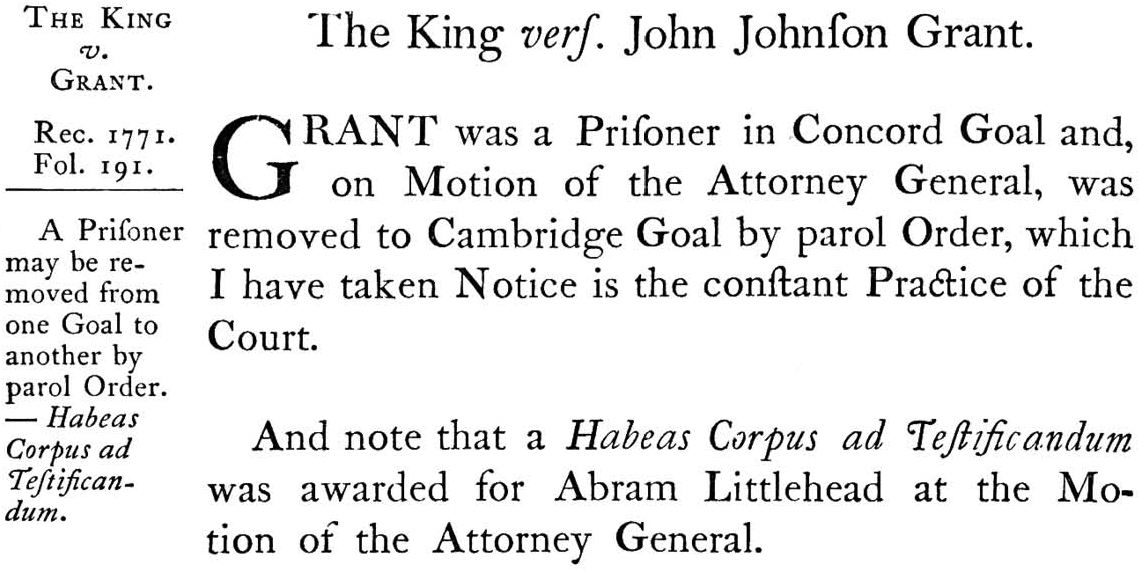
[P. 326]
The King v. John Johnson Grant (1771)
12 George III (October Term) in the Superior Court of Judicature-Middlesex
1 · brief description
Prisoners can be moved between Gaols (i.e., jails) by parol (oral) order. Habeas corpus will lie to bring up a prisoner to testify (ad testificandum).
2 · court records
Available at Rec. 1771, fol. 191.
3 · professionals involved
None Indicated.
4 · authority
Only “Constant Practice of the Court” cited.
5 · later citations
None.
6 · notes
Not Quincy’s hand or style.
CASE 65
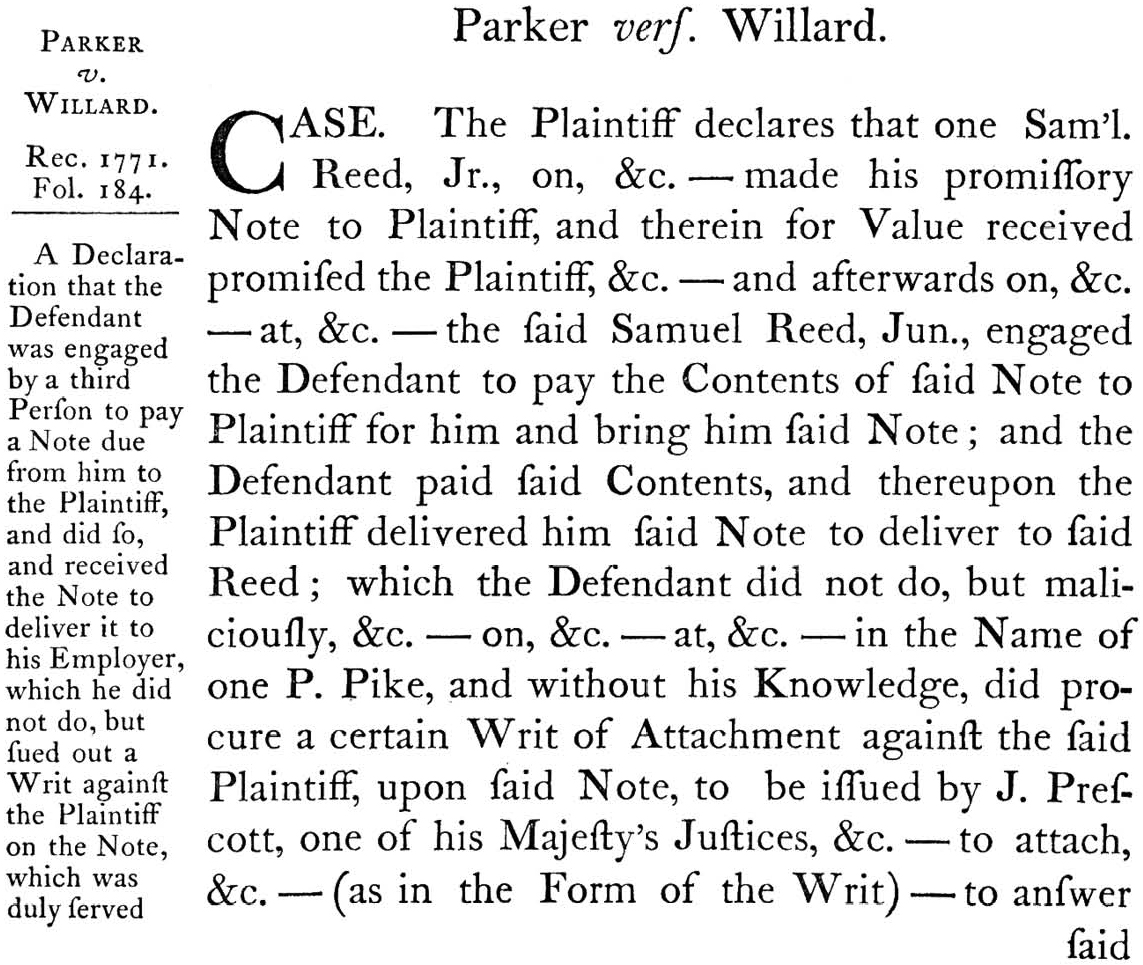
[P. 326]
12 George III (October Term) in the Superior Court of Judicature-Middlesex
1 · brief description
According to the Declaration, the Defendant Willard was engaged by one Reed to pay a promissory note owed by Reed to the Plaintiff Parker. Willard took the money to Parker, and received the note to deliver back to Reed. But instead of delivering the paid note back to Reed, doubtless for cancellation, Willard allegedly forged an endorsement on the note to one Pike, without Pike’s knowledge, and allegedly procured a Writ of Attachment against Parker on the false endorsement, causing Parker “great Expense,” etc. Held: because the declaration did not allege what judgment was rendered or other specific damages, the declaration showed no cause of action. Reports, 327.
2 · court records
Available at Rec. 1771, fol. 184.
3 · professionals involved
The Plaintiff was represented by Jonathan Sewall (1729–1796), a Charlestown practitioner, and one ‘Rogers,’ who did not appear on the Memorandum of August Term, 1762. See Reports, 35. This almost certainly was Jeremiah Dummer Rogers (1743–1784), who practiced in Littleton, Middlesex County, and who was not admitted as attorney in the Superior Court until 1769, or barrister until 1772. He was a Tory, and was proscribed in 1778, to become a wine merchant in Halifax. See Charles R. McKirdy, “Massachusetts Lawyers on the Even of the American Revolution: The State of the Profession,” Law in Colonial Massachusetts, supra, 351.
The successful lawyer for the defense was, of course, Josiah Quincy Jr., himself. As the report was neither in Quincy’s hand or style, and contained an uncharacteristic error (the exception being to the declaration, not the writ), the report was obviously prepared by another, possibly at Quincy’s request. See Reports, 327.
[P. 327]
4 · authority
None given.
5 · later citations
None.
6 · notes
As Samuel Quincy observed, these Middlesex Cases at Reports, 318–340, are from a fragment of another volume and not in Quincy’s hand. Samuel Quincy noted “[w]hether in these cases he employed an amanuensis, or whether the volume is the work of another reporter, cannot now be known, as the first pages were unfortunately destroyed by one ignorant of their value.” Reports, supra, iv.
The record, on the other hand, gives a wonderful picture of our Reporter as a trial lawyer. This was hardly a good case for the defense, given the likely misdeeds of Willard, but Quincy focused with great effect on the defects of the Declaration, and won.
[P. 328]
ILLUSTRATION 18: Massachusetts Gazette & Boston News-Letter, October 24, 1765, page 2. Courtesy of Early American Newspapers, and Archive of Americana Collection. Published by Readex (Readex.com), a division of NewsBank, inc. See discussion at Apthorp v. Sheppard (1768), Reports, 298, Case 62, Note 6, and Symes v. Hill (1771), Reports, 318, Case 63, Note 6. With much gratitude to Mark G. Sullivan.
CASE 66
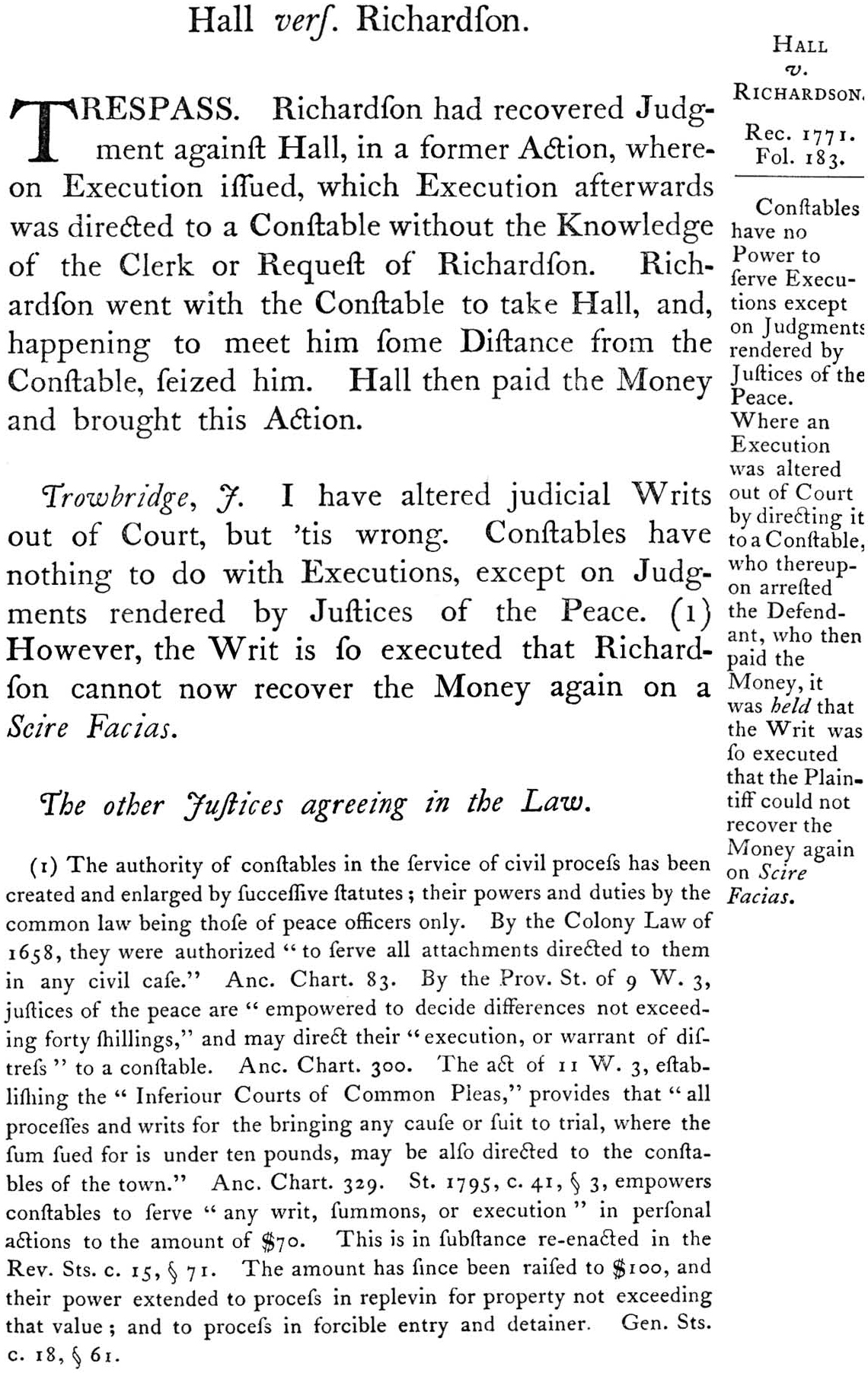
[PP. 329–330]
12 George III (October Term) in the Superior Court of Judicature-Middlesex
1 · brief description
Without the Defendant’s request, a constable was used to execute the Defendant’s judgment against the Plaintiff. This was outside the constable’s statutory authority, but the Plaintiff paid the judgment. Held: it was too late for the Plaintiff to recover the money again.
2 · court records
Available at Rec. 1771, fol. 183.
3 · professionals involved
No lawyers given. Again, Justice Trowbridge, the only lawyer on the Court, gave the reason for the decision. See discussion at Richmond v. Davis (1768), Reports, 279, Case 61, Note 3.
4 · authority
Statutory only. The power of constables had been systematically expanded by Colonial Law of 1658, Charters and General Laws, supra, 82–84; Provincial Statute 9 William III (1697), chap. 43, id., 329–330. But it did not extend to execution of a judgment.
5 · later citations
None.
6 · notes
Another of the Middlesex cases not in Quincy’s hand. See Case 65, supra, Reports, 326, Note 6. “Scire Facias” (“that you cause to know”) is the usual writ for legal relief founded upon a legal record. See Earl Jowitt, supra, 1592.
MEMORANDUM
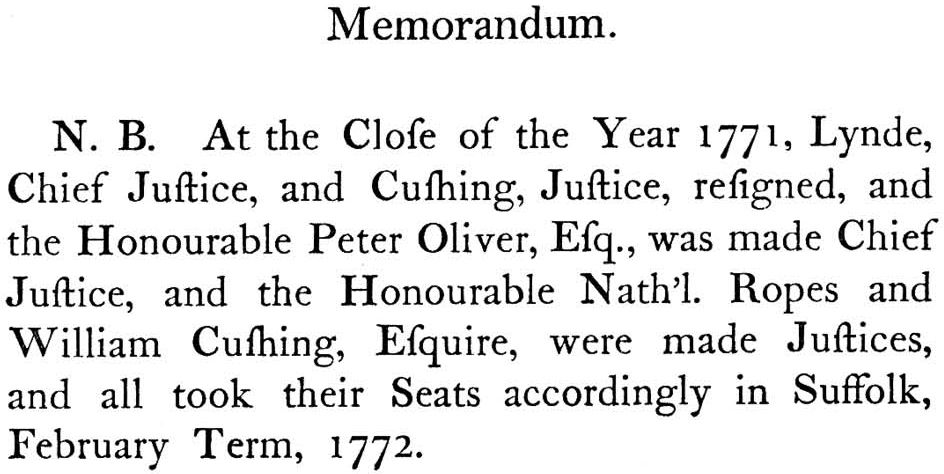
[P. 330]
Benjamin Lynde Jr. (1700–1781) succeeded Hutchinson as Chief Justice in 1769, having been an Associate Justice since 1745. He now resigns after 26 years. Justice John Cushing (1695–1778) also resigns, having been appointed in 1747, after a term of 24 years. The stalwart Tory Peter Oliver (1713–1791), the only Justice to accept his salary directly from the Crown in 1774, replaced Lynde. He went into exile in 1775. John Cushing was succeeded by his son William (1732/3–1810), who was an experienced lawyer, appointed attorney to the Superiour Court in 1758 and barrister in 1762. He was a moderate who went on to become Chief Justice of the Supreme Judicial Court (1777–1789) and a Justice of the Supreme Court of the United States (1789–1810). See Appendix 7, supra, for short biographies of all of the above. The other new appointment was Nathaniel Ropes, a merchant who graduated from Harvard College in 1745 with eleven years’ experience on the Inferior Court. He lasted only two years. See Charles R. McKirdy, “Massachusetts Lawyers on the Eve of the American Revolution,” Law in Colonial Massachusetts, supra, 332.
[P. 331]
12 George III (April Term) in the Superior Court of Judicature-Middlesex
1 · brief description
Serving as a Standing Grand Juror of the County exempts a person from serving on a “petty” or trial jury.
2 · court records
None.
3 · professionals involved
None indicated.
4 · authority
None.
5 · later citations
None.
6 · notes
This was another of the cases that were not in Quincy’s hand. See Case 65, supra, Reports, 326, Note 6. A “venire facias” (“that you cause to come”) is a “writ in the nature of a summons to appear.” See Earl Jowitt, supra, 1826. Here it was directed at the town of Littleton to produce a “petty” or trial juror. Reed’s name was returned, but he was excused because he was already on the Grand Jury of the County, the “big” jury of presentation.
Samuel Quincy, the Editor, notes that his namesake, his great-grandfather’s brother, was named Solicitor General in March 1771. Reports, 331–332, S. Quincy n. 1. The latter Samuel Quincy was certainly a loyalist, and was eventually prescribed, but, as his descendent loyally argued, there is no evidence, except for John Adams’s memory, that this was due to the competing talents of his younger brother, Josiah. See brief biography, Appendix 6, and Neil Longley York, “A life cut short,” Quincy Papers, vol. 1, 18, 45. As to Josiah Quincy’s views of the “present novel Office of Solicitor,” see Reports, 241–242, and Reports, 300, Note.
[P. 332]
ILLUSTRATION 19: Peter Oliver (1713–1791), Justice, Superior Court of Judicature, 1756–1772, Chief Justice, 1772–1775, impeached by House, 1774. By John Singleton Copley (1738–1813). Image courtesy of the Library of Congress.
CASE 68
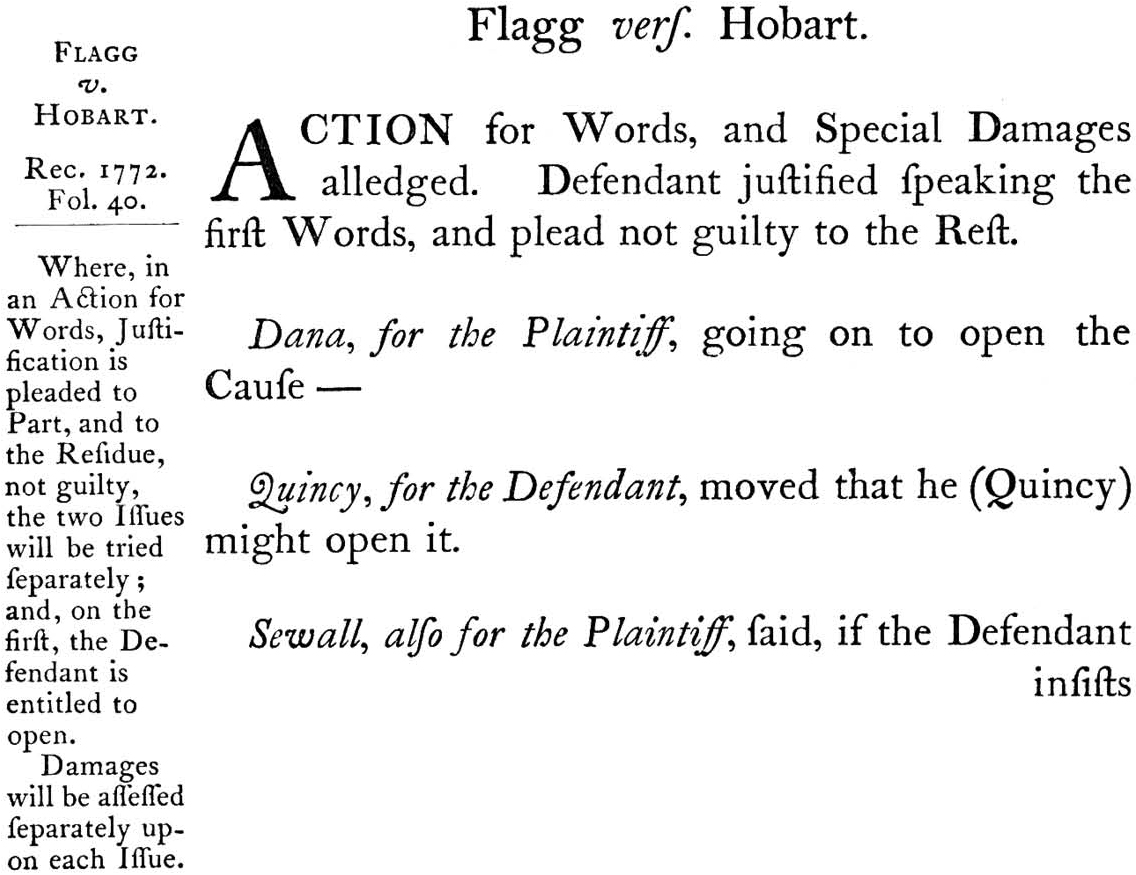
[P. 332]
12 George III (April Term) in the Superior Court of Judicature-Middlesex
1 · brief description
Defendant, a mill owner, admittedly said of the Plaintiff, a millwright, that it would have been better to give “[w]ages to a Workman than to have had my Mills so spoiled by such a ‘Blunderbuss.’” He denied having called the Plaintiff “a Logerhead,” or stating that “there was so much Liquor stirring that Flagg hardly knew what he was about,” and making other remarks. As to the first admitted remark, Defendant would justify it as preventing harm to others. Held: the two issues, the justification of the admitted remark and the “not guilty” denial of the other remarks, should be tried separately. On the issue of justification, the defense should go first. Damages would also be assessed separately.
2 · court records
Available at Rec. 1772, fol. 40.
3 · professionals involved
Richard Dana (1700–1772) and Jonathan Sewall (1729–1796) for the Plaintiff, and Josiah Quincy Jr. himself for the defense. Dana was active in opposing the Stamp Act, and died on May 17, 1772, right after this term. See short biographies, Appendix 6.
4 · authority
None given.
5 · later citations
This case was cited in Dorr v. Tremont Nat’l Bank, 128 Mass. 349, (1880) for the proposition that the early practice of the Court was to allow a Defendant to both open and close regarding justification. Id., at 358. Today, most state procedures permit the Plaintiff to open and close in all cases. See Samuel Quincy’s note, Reports, 333, S. Quincy n. 1.
[P. 333]
6 · notes
Another of the Middlesex reports that were not in Quincy’s hand. See Reports, Case 65, supra, Note 6. Again, as in Reports, 326, Case 65, Quincy actually appeared in the case, and may have arranged for another to take notes.
Quincy won the procedural point, but lost the case on the merits, with damages for £30 on the substantive slander-which clearly injured the Defendant’s professional reputation-and £5 for the other gratuitous insults. See Reports, 334, Note 3. English law still permits a Plaintiff an action for slander per se if it “is calculated to disparage him in his . . . calling, trade or business (Defamation Act, 1952, n. 2).” Jowitt, 1647–1648. There was a “qualified privilege” in most common law jurisdictions for non-malicious communication for a public good, such as to prevent harm to others. See John Bouvier, Law Dictionary and Concise Encyclopedia (1914), vol. 2, 3080–3081.
[P. 334]
ILLUSTRATION 20: Working replica of an eighteenth-century Massachusetts grist mill, Sudbury, Massachusetts. See “The Millwright Case,” Flagg v. Hobart (1772), Reports, 332, Case 68. Courtesy, Wayside Inn, Sudbury.
CASE 69
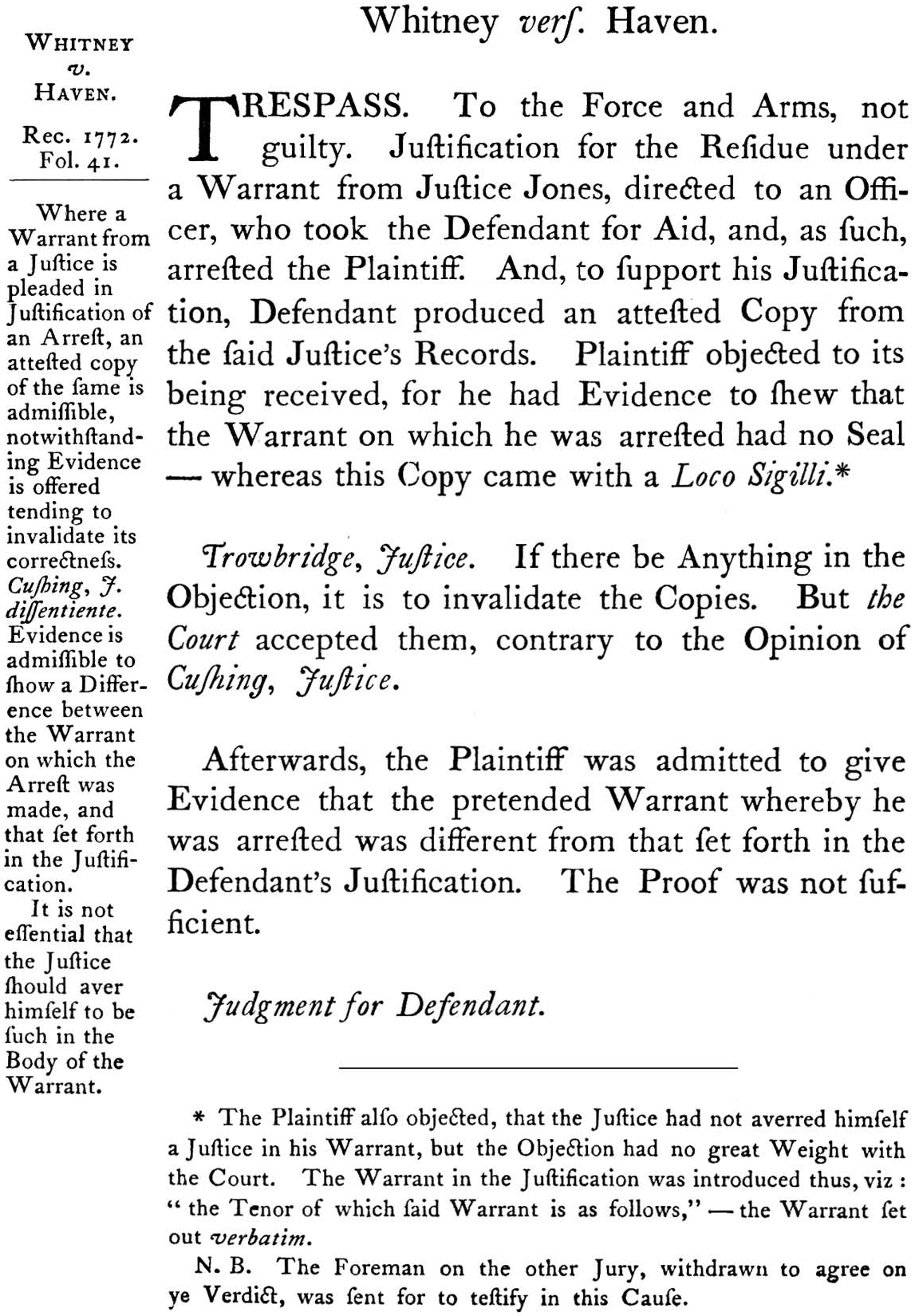
[PP. 334–335]
12 George III (April Term) in the Superior Court of Judicature-Middlesex
1 · brief description
Plaintiff brings a trespass action vi et armis (“Force and Arms”) against Defendant for aiding in Plaintiff’s arrest, alleging that the warrant that justified Defendant’s aid to the officer making the arrest was deficient. Defendant wished to enter into evidence an attested copy of the warrant from the records of the issuing judge. Plaintiff objected, on the ground that the copy was different from the warrant on which he was arrested. Held: objection overruled, copy was introduced into evidence, but Plaintiff was permitted to give evidence himself that the copy was different.
2 · court records
Available at Rec. 1772, fol. 41.
3 · professionals involved
No lawyers indicated. The newly appointed Justice William Cushing (1732/3–1810), son of the retired John Cushing (1695–1778), dissented, but no reason is indicated.
4 · authority
None cited.
5 · later citations
None.
6 · notes
This was another of the Middlesex reports that were not in Quincy’s hand. See Case 65, supra, Reports, 326, Note 6. This was a common sense solution, and it was unclear why the young Cushing did not like it. “Loco [SK] Sigilli” means “the place of the seal.” See Osborn, supra, 196.
CASE 70
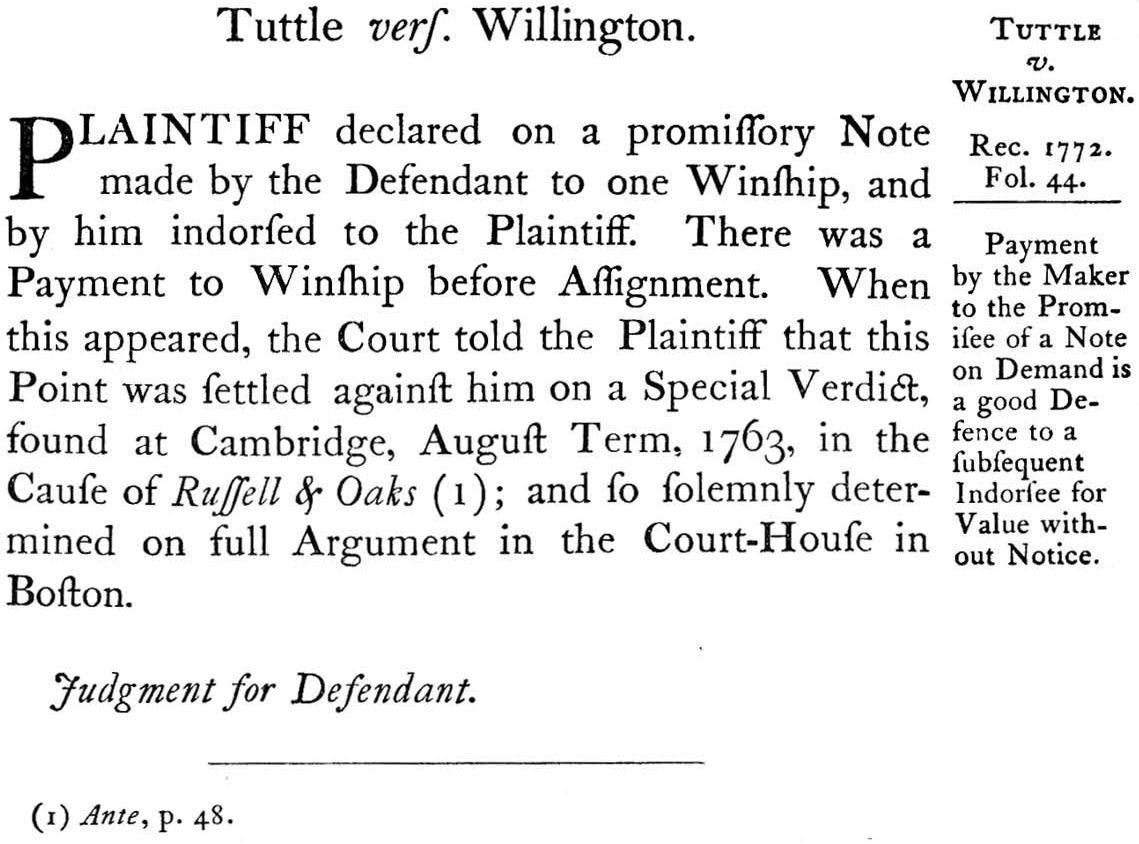
[PP. 335–336]
12 George III (April Term) in the Superior Court of Judicature-Middlesex
1 · brief description
Defendant made a promissory note payable to one Winship, who endorsed the note to the Plaintiff. Before the endorsement, Defendant made payment to Winship. Plaintiff now sued the Defendant on the note. Held: Plaintiff has no action, on the authority of Russell v. Oakes (1763), Reports, 48, Case 21.
2 · court records
Available at Rec. 1772, fol. 44.
3 · professionals involved
None indicated.
4 · authority
Except for Russell v. Oakes (1763), Reports, 48, Case 21 itself, no citations.
5 · later citations
None.
6 · notes
This was another of the Middlesex Reports that were not in Quincy’s hand. See Case 65, supra, Note 6. It was “right on point” with Russell v. Oakes (1763), Reports, 48, Case 21, supra, a very controversial case that is discussed at length at id., Note 6, supra.
CASE 71
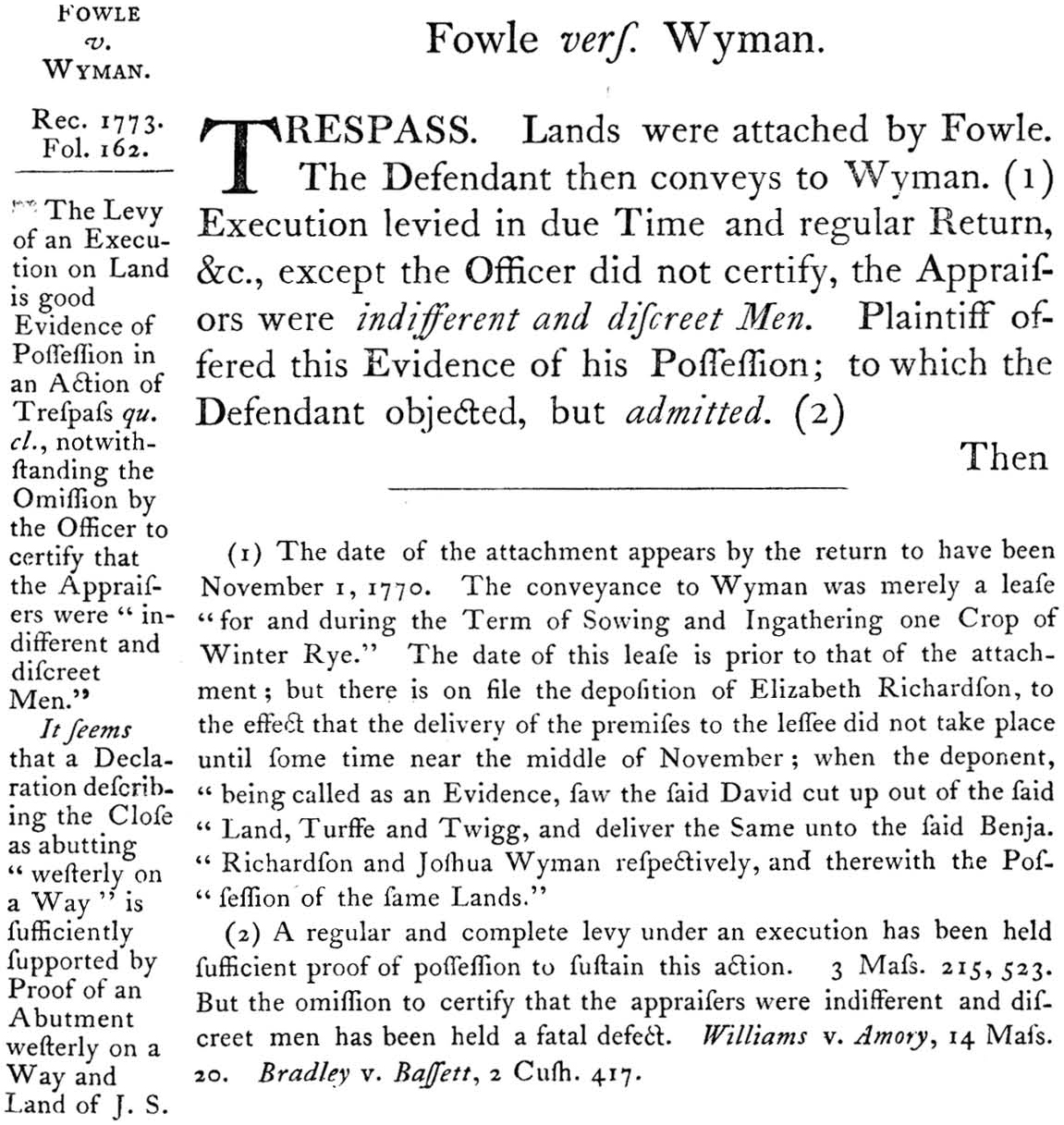
[P. 336]
12 George III (April Term) in the Superior Court of Judicature-Middlesex
1 · brief description
This case, not reported by Quincy, was so badly described that it is hard to tell what was decided. The Plaintiff attached certain lands, which were leased to Wyman after the attachment. The Plaintiff sued in trespass against Wyman, who objected that the attaching officer omitted to certify that the appraisers were “indifferent and discreet men” and that the land itself was inaccurately described. Held: It “seems” after initially agreeing with the defendant, the Court held for the Plaintiff. (See side note of Samuel Quincy, Reports, 336 and Reports, 337, S. Quincy n. 3.)
2 · court records
Available at Rec. 1773, fol. 162.
3 · professionals involved
The only lawyer indicated was Jonathan Sewall (1729–1796), who practiced in Charlestown. See the short biography at Appendix 6, supra.
4 · authority
Defendant cited “an Authority out of Salkeld, and one out of Hobart,” which the reporter failed to get down specifically-making a note “of which inquire.” Samuel Quincy finished the job, in identifying Helvis v. Lamb, 2 Salkeld’s Reports 453 (London, 1717); Reed v. Hawke, Hobart’s Reports (London, 1641), 16; and id., 176, Plant v. Thorley (1617).
5 · later citations
None.
6 · notes
This was another of the Middlesex reports that were not in Quincy’s hand. See the discussion at Reports, 326, Case 65, supra, Note 6. The sloppiness of this reporter in leaving incomplete citations was very different from Quincy. In addition, the reporter indicated that “the Declaration is not supported; and so ruled unanimously by the Court.” Reports, 337. But the record shows that the plaintiff won, as Samuel Quincy pointed out! See Reports, 337, S. Quincy n. 3. This was terrible reporting.
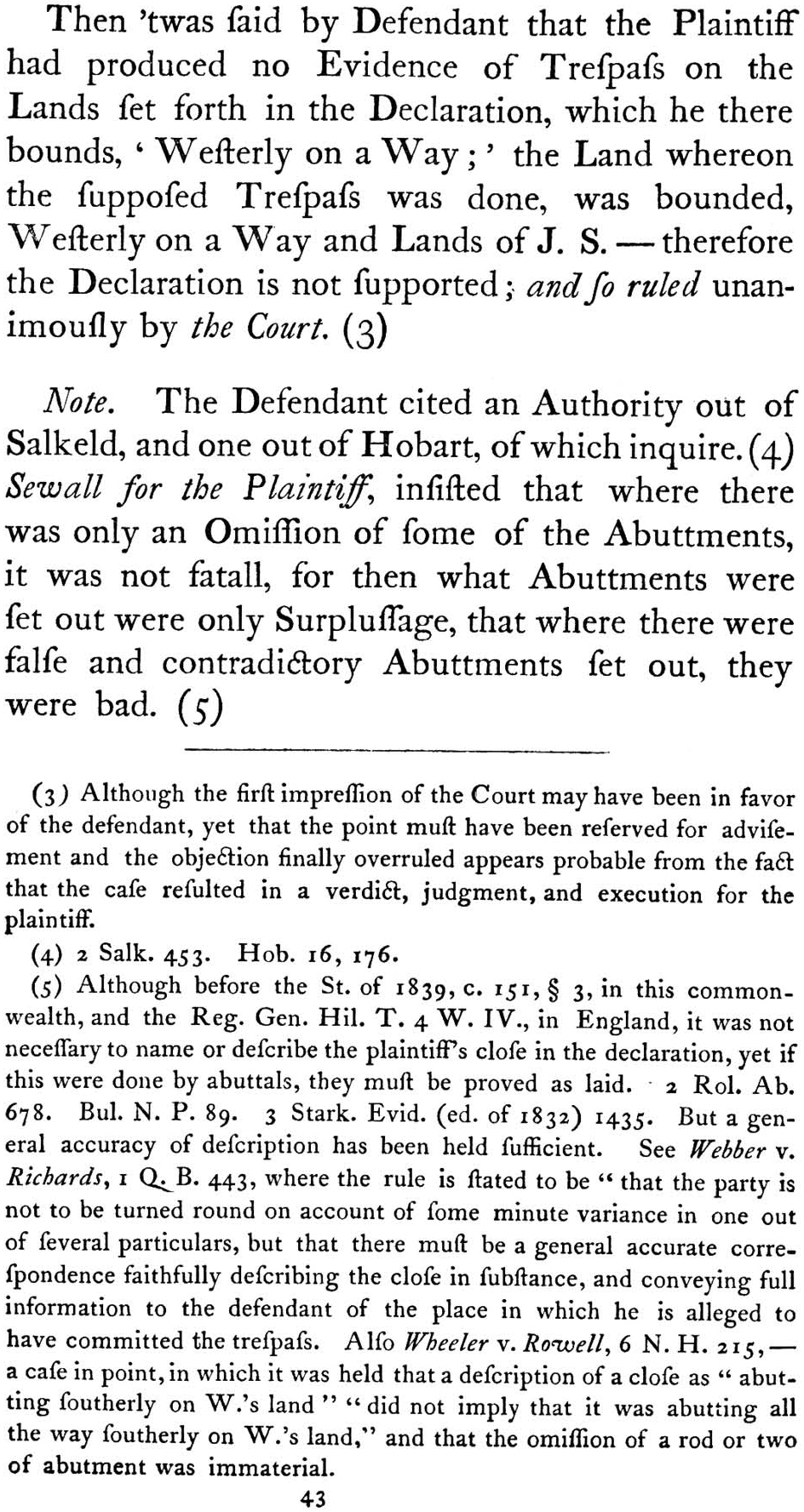
[P. 337]
CASE 72
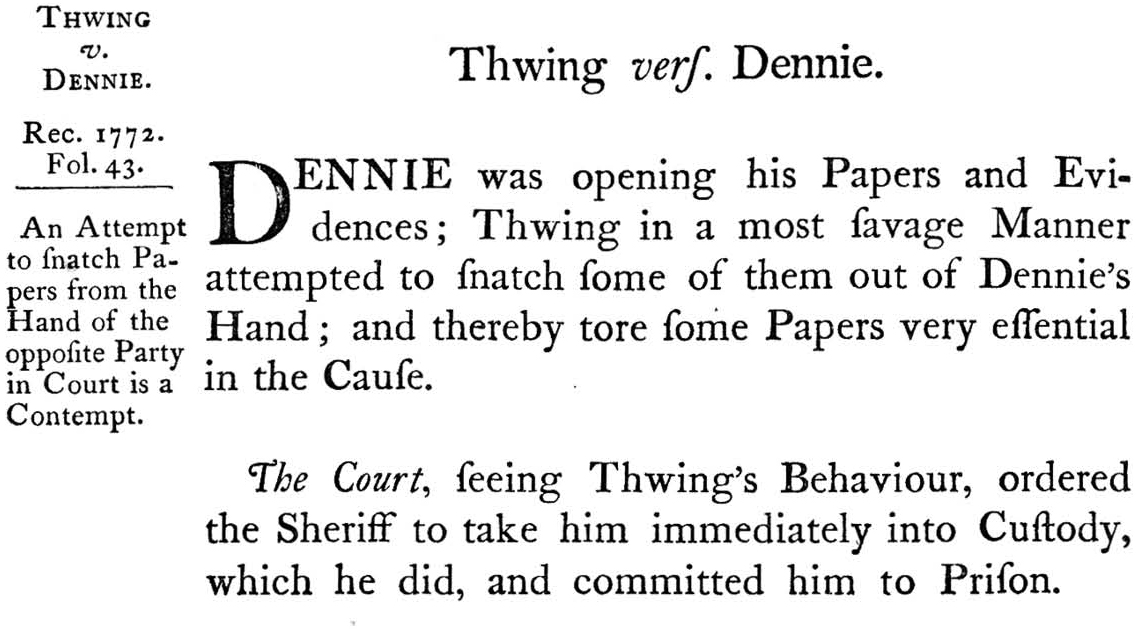
[P. 338]
12 George III (April Term) in the Superior Court of Judicature-Middlesex
1 · brief description
Thwing “in a most savage Manner attempted to snatch” papers from Dennie’s hand as Dennie was opening them in Court. He “thereby tore some Papers very essential to the Cause.” Held: Thwing was imprisoned for contempt.
2 · court records
Available at Rec. 1772, fol. 44.
3 · professionals involved
None indicated. It appears that Dennie might have been representing himself, though not certain.
4 · authority
None given.
5 · later citations
This case was cited in John W. Cartwright’s Case, 114 Mass. 230 (1873) for the inherent power of the Court to punish or contempt any obstruction of justice. Id., at 238. See also In re Whitcomb, 120 Mass. 118, 120 (1876), where it was cited by counsel in a case regarding unlawful imprisonment. It was also cited by the Supreme Court of the United States in U.S. v. Barnett, 376 U.S. 681, 713 (1964) in an appendix relating to colonial courts imposing punishments for contempt. See Appendix 5, infra.
6 · notes
Common law contempt fell into two categories: (1) failure to comply with an order or; (2) “any act which may tend to hinder the cause of justice or show disrespect for the Court’s authority.” Jowitt, supra, 469. Contempt also could be divided into acts in the Court itself, or outside the Court. “Every judge of a court of record has the power immediately to commit for a contempt committed in his presence. . . .” Id., 470. “No process or evidence is necessary.” Bouvier, supra, vol. 1, 651. This type of contempt is often referred to as “criminal contempt,” because the commitment is “punitive.” It “vindicates the dignity of the courts.” Id., vol. 1, 653. “Civil contempt” is “remedial,” and is designed to compel obedience with the Court’s orders. It is often said of civil contempt that the party “has the key to his cell in his pocket,” as obedience with the order usually means release. Not so “criminal contempt,” such as the act in this case, where the party will be committed for an appropriate period to punish the misbehavior.
Again, this was one of the Middlesex reports not in Quincy’s hand. See the discussion at Parker v. Willard (1771), Reports, 326, Case 65, Note 6.
CASE 73
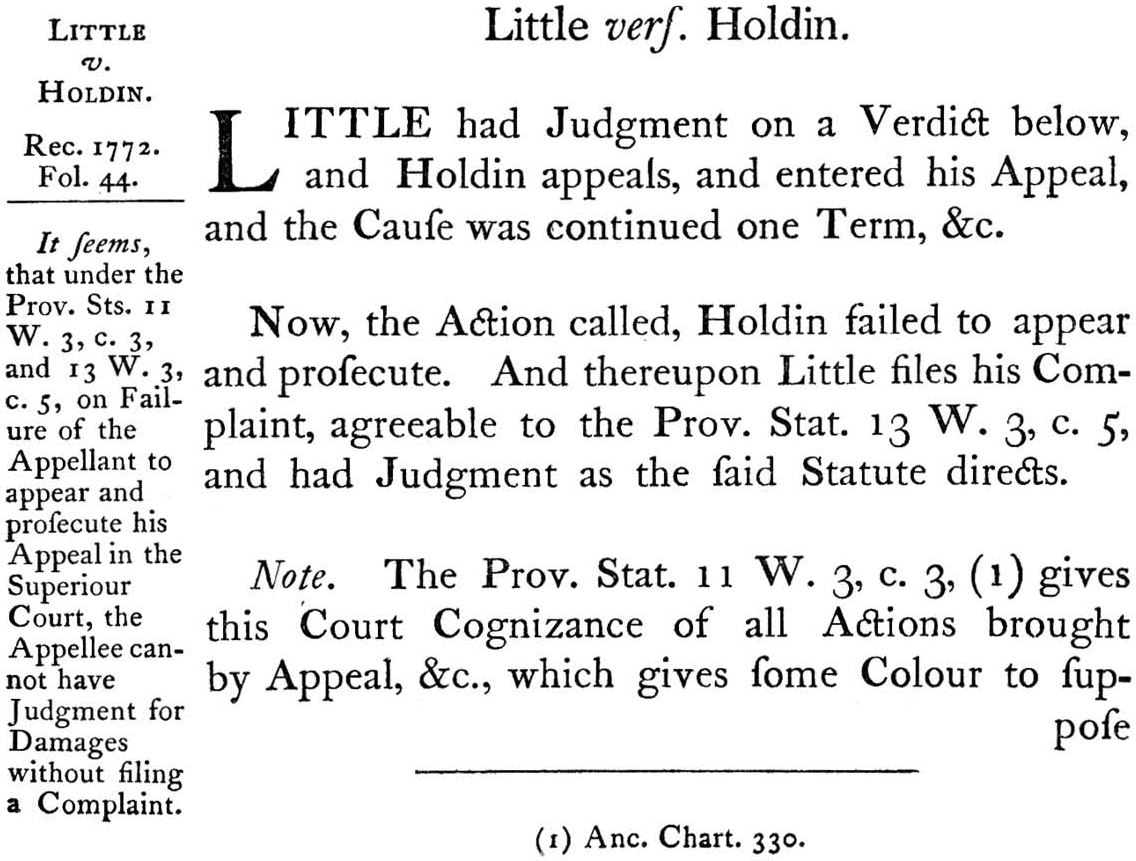
[P. 338]
12 George III (April Term) in the Superior Court of Judicature-Middlesex
1 · brief description
This was another mysterious and poorly reported case not in Quincy’s hand. The holding appears to be simple. If an appellant fails to appear to prosecute his appeal, the appellee can sue for costs and damages, but only by filing a complaint pursuant to Prov. Stat. 13 William 3d, chap. 5 (1701).
2 · court records
Available at Rec. 1772, fol. 44.
3 · professionals involved
None indicated.
4 · authority
None, except the two Provincial Statutes 11 William III, chap. 3 (1699) and 13 William III, chap. 5 (1701).
5 · later citations
This case was cited in Derick v. Taylor, 171 Mass. 444 (1898) to illustrate how colonial courts resolved discontinuance of appeals under a similarly worded colonial statute. Id., at 446.
6 · notes
This was another Middlesex case not in Quincy’s handwriting and without any of his sophistication or thoroughness. Apparently, the case simply illustrated that an appellee has to file a complaint under 13 William III, chap. 5 (1701) in order to get damages when an appellant simply does not show up to prosecute an appeal. That act provided that an appellant who “neglected to prosecute” his appeal could be sued by the appellee through a complaint filed in the Superior Court of Judicature for “cost arising upon the suit there [inferior court] and . . . further costs for entering and prosecuting the complaint aforesaid. . . .” (Section 2) Charters and General Laws, supra, 357. The other statutory citation was the act establishing the Superior Court of Judicature itself, 11 William III, chap. 3 (1699). This act, the Reporter rather vaguely observed, “gives some Colour to suppose that the Appeal being entered” and abandoned, the appellee could only get costs, not damages. But, as observed, this was changed by the later 13 William 3d, chap. 5 (1701) to give the appellee a complaint. This odd rambling account was certainly not by Quincy.
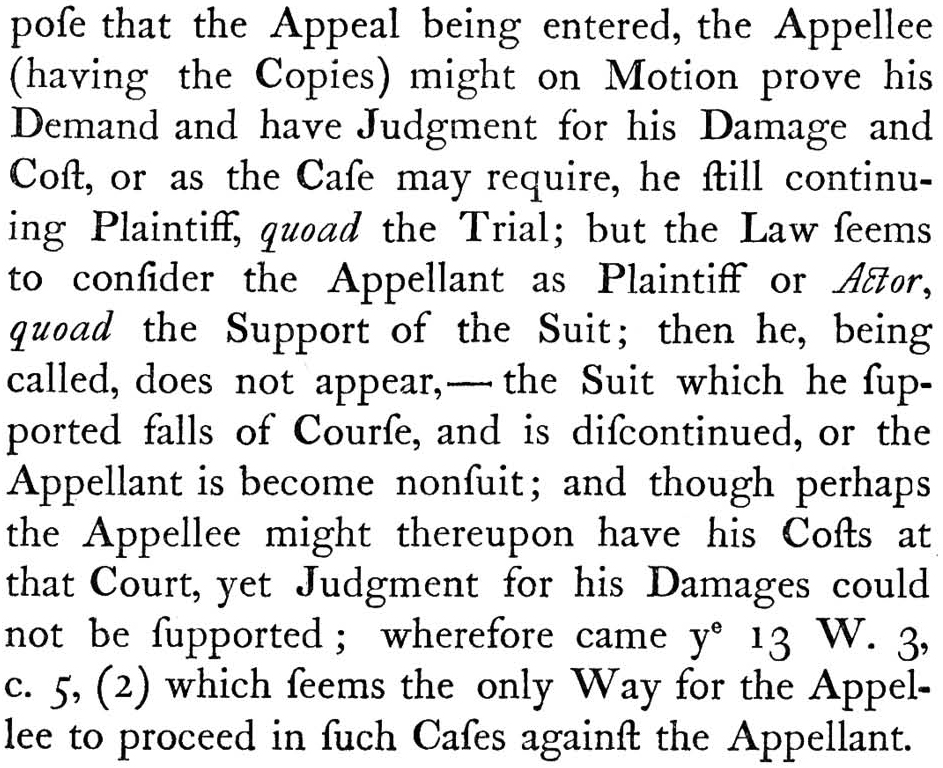
[P. 339]
CASE 74
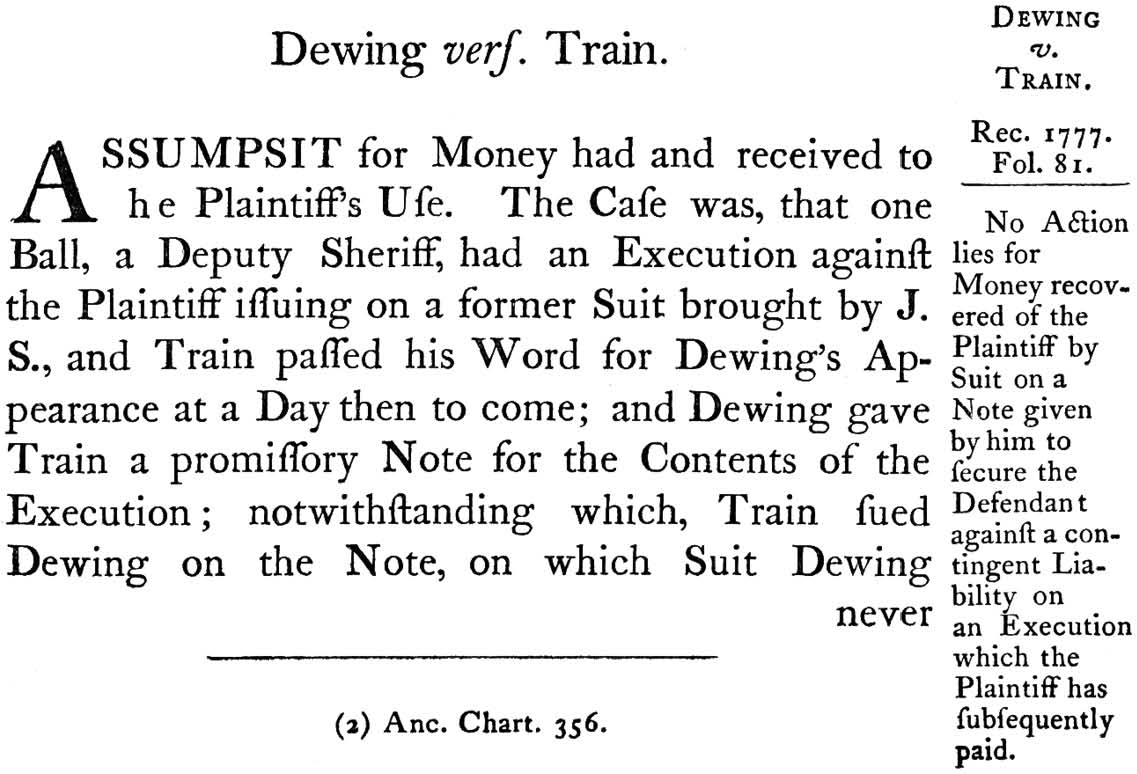
[P. 339]
12 George III (April Term) in the Superior Court of Judicature-Middlesex
1 · brief description
This case, the last of the Middlesex cases reported by an unknown hand and not by Quincy, was remarkable because it originated when the Court was a royal court, and concluded after the Court was reconstituted as a Court of the Independent Commonwealth. The continuity of Justice William Cushing, first appointed as a royal Judge in 1772 to succeed his father John Cushing, is commonly given as evidence that the Superior Court was not terminated by the Revolution and, thus, can claim to be the oldest continuous court on the North American continent. See the discussion at Editor’s Foreword, supra, 423–425. More persuasive, however, is this case, which was treated as pending in the same Court system, with various interruptions, from 1772 until it was finally resolved on November 3, 1777. See Reports, 342.
The case itself was poorly reported. This was typical of these Middlesex cases-and certain evidence that Quincy was not involved directly. See the discussion at Reports, 329, Case 65, supra, Note 6. The Plaintiff, Dewing, was sued by a “J.S.,” and the deputy Sheriff had executed against Dewing’s estate in connection with that suit. The Defendant Train apparently agreed to guarantee Dewing’s appearance in court, and Dewing gave Train a promissory note in the value of the execution-to safeguard Train if Dewing did not show up. The deputy Sheriff then committed Dewing on the original execution (because he did not show up?), and Train sued Dewing on the promissory note. Train won an uncontested judgment (because Dewing was in custody?). The execution on Dewing’s property cleared the judgment to “J.S.,” and Dewing was released. Dewing now sued in assumpsit for money “had and received” to the Plaintiff’s use to get back the money paid to Train on the note, as Train did not have to pay anything on Dewing’s behalf. Held: a general assumpsit (i.e., contractual) action was inappropriate. This case should have been sought by review of the judgment on the note. Eventually, such a review was sought, and Dewing recovered his money.
[P. 340]
2 · court records
Available at Rec. 1777, fol. 81.
3 · professionals involved
None indicated, except for Jonathan Sewall (1729–1796) for the Plaintiff. He practiced regularly in Charlestown, in Middlesex. See short biography at Appendix 6, supra.
4 · authority
None given.
5 · later citations
None. This case was consistent with later Massachusetts law that money paid under legal process cannot be recovered back by a subsequent action. Rather, it was necessary to challenge the proceeding that resulted in the payment directly, by review. See Samuel Quincy’s note 1, Reports, 340.
6 · note
This case was continued from term to term in Middlesex, from 1772 until it was finally resolved on November 3, 1777. There is no need to summarize Samuel Quincy’s exceptional history of these continuances in his “Note,” Reports, 340–342. The important fact was that there was no indication of a change in the court or its process, with the exception of replacing “King of Great Britain, France, and Ireland etc.” with the “Government and People of Massachusetts Bay in New England” by statute in May of 1776. Charters and General Laws, supra, 798–800. This was sometimes done by simply crossing out the printed process forms and writing in the new name. See the Writ of Attachment of June 25, 1776, illustrated in Law in Colonial Massachusetts, supra, 544.
Technically, Justice William Cushing was removed from office by the act of July 19, 1775 removing all officers appointed by the Governor, as of September 19, 1775. Cushing was reappointed to the Court on October 11, 1775, a hiatus of less than a month. See Reports, 341. See also the discussion at Editor’s Foreword, supra, 423–425. As soon as a Middlesex term could be held, Dewing v. Train was resolved-the Court holding the April, 1776 term in Concord, because “Charlestown is destroyed by the Enemy” (original italics), see Reports, 342.
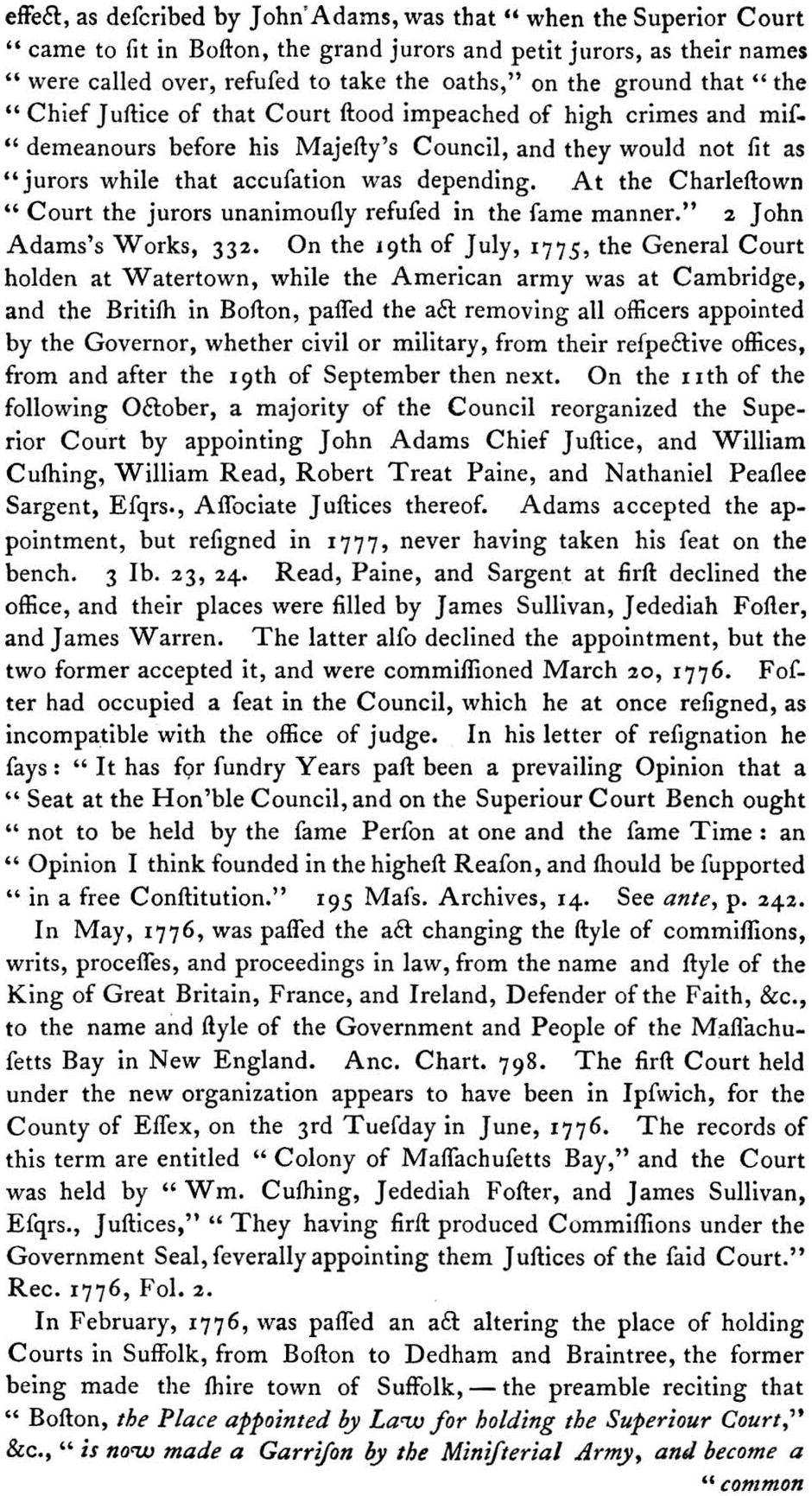
[P. 341]
The Second Charter of 1690 assumed the existence of “judicatories or courts” in providing a right of appeal from the same in civil cases in excess of £300. Charter and General Laws, supra, 32. Such courts were provided for by “An Act for the Establishing of Judicatories, and Courts of Justice, Within This Province” of November 25, 1692. See id., 217–223. Cases such as Dewing v. Train remain the strongest evidence that the Superior Court of Judicature had, in fact, a continuous history from that day in 1692 to this. See Benjamin Kaplan, “Introduction: An Address,” The History of the Law, in Massachusetts: The Supreme Judicial Court 1692–1992 (ed. R. K. Osgood, 1992), 2.
[P. 342]
ILLUSTRATION 21: Manuscript, Dewing v. Train (1772), Reports, 339, Case 74. Notice the difference in the handwriting from Illustration 2, 449 and Illustration 10, 543, supra. This is not Quincy’s hand. Courtesy, Massachusetts Historical Society (P347, Reel 4, QP 54).
CASE 75
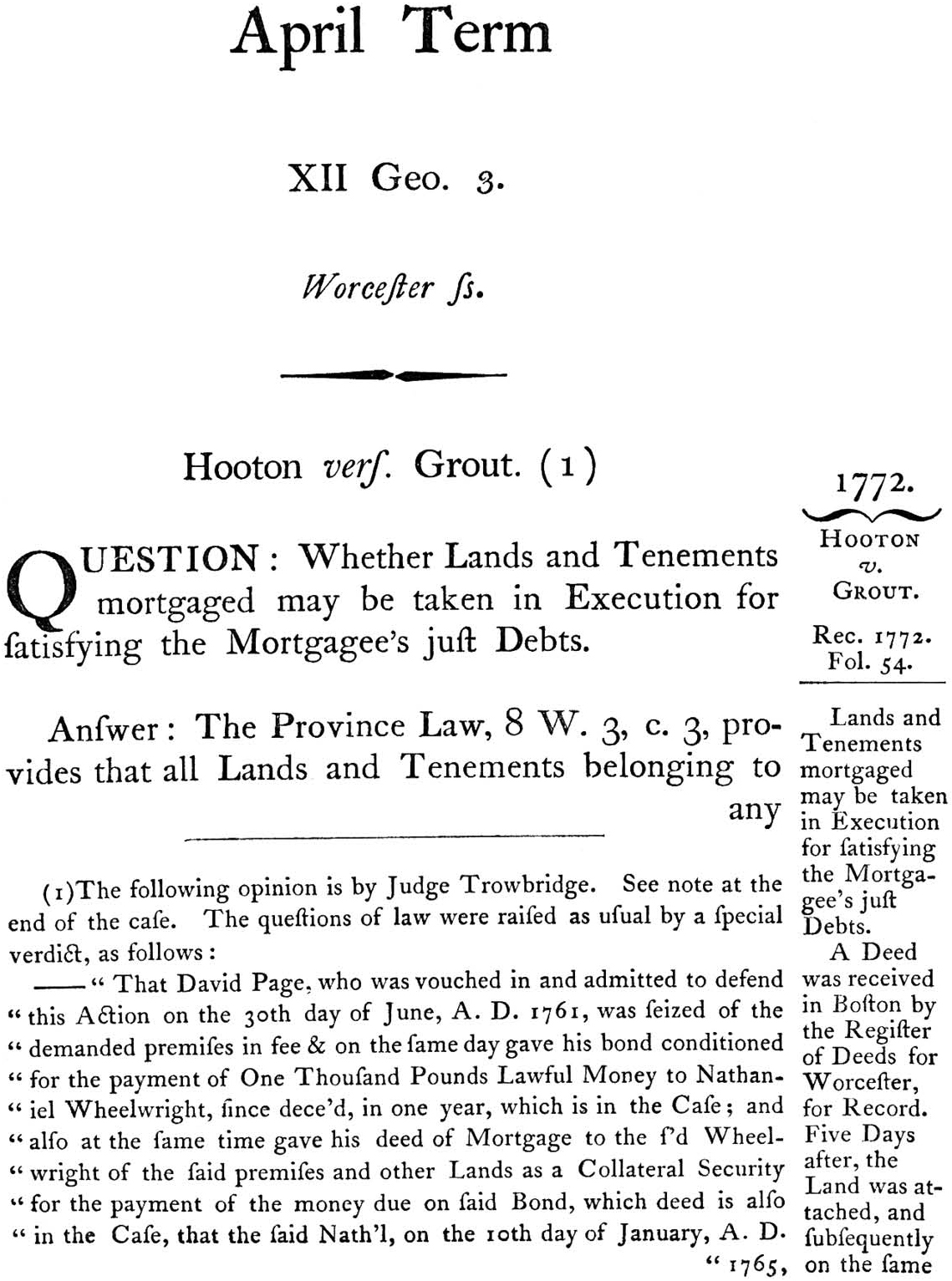
[P. 343]
12 George III (April Term) in the Superior Court of Judicature-Worcester
1 · brief description
Like the Middlesex cases (Reports, 318–342, Cases 63–74) just described, this was not really a report by Quincy, but a Trowbridge manuscript reproduced later by Samuel Quincy. It involved exactly the same issue of law as Symes v. Hill (1771), Reports, 318, Case 63, and, as Samuel Quincy indicated, the two cases were probably argued together. See Reports, 368–369. Both cases grew out of the Wheelwright failure. See also Reports, 179, 298, Cases 46 (1765) and 62 (1768). Held: mortgaged lands may be taken in execution to satisfy a mortgagee’s debts, but not pursuant to an attachment made after an assignment of the mortgage was received by Registry of Deeds to be filed to record, although it was not recorded until later.
2 · court records
Available at Rec. 1772, fol. 54.
3 · professionals involved
None indicated, but they could have been the same as in Symes v. Hill (1771), Reports, 318, Case 63, i.e., John Adams (1735–1826) for the Plaintiffs and Samuel Fitch (1724–1799) for the defense. Indeed, Adams noted the arguments of counsel, as Samuel Quincy indicated, under the joint title “Symes v. Hill & Hooton v. Grout,” Adams Papers, Microfilms, Reel No. 185. See Legal Papers of John Adams, supra, vol. 1, 231–238.
4 · authority
Trowbridge’s exhaustive written opinion reads like a treatise on mortgage law, and adds little to his much more concise treatment of the same issues in Symes v. Hill (1771), Reports, 318, Case 63, supra. The law as to attachment of mortgages to pay just debts was largely resolved by provincial statutes, beginning with 8 William III c. 3 (1696) “An Act for Making of Lands and Tenements Liable to the Payment of Debts,” 8 William III c.3 (1696). See the discussion at id., Note 4. The only real issue was whether Wheelwright’s conveyances of his mortgages to his business partner Apthorp defeated the attachments by Wheelwright’s many creditors, including the Plaintiff in this case or, as was discussed in the Symes case by Justice Cushing, these transfers were fraudulent. Thus, the treatise on the common law of mortgage written here by Trowbridge seems oddly out of place, even if consistent with his much more concise arguments recorded by Quincy in Symes v. Hill (1771), Reports, 318, Case 63, supra. Possibly this treatise was written by Trowbridge for the same reason as his long dissent in Richmond v. Davis (1768), Reports, 279, Case 61, supra, to persuade his brethren or to prepare for an appeal, although the Province Charter of 1690 prohibited appeals of real actions. See Charters and General Laws, supra, 32.
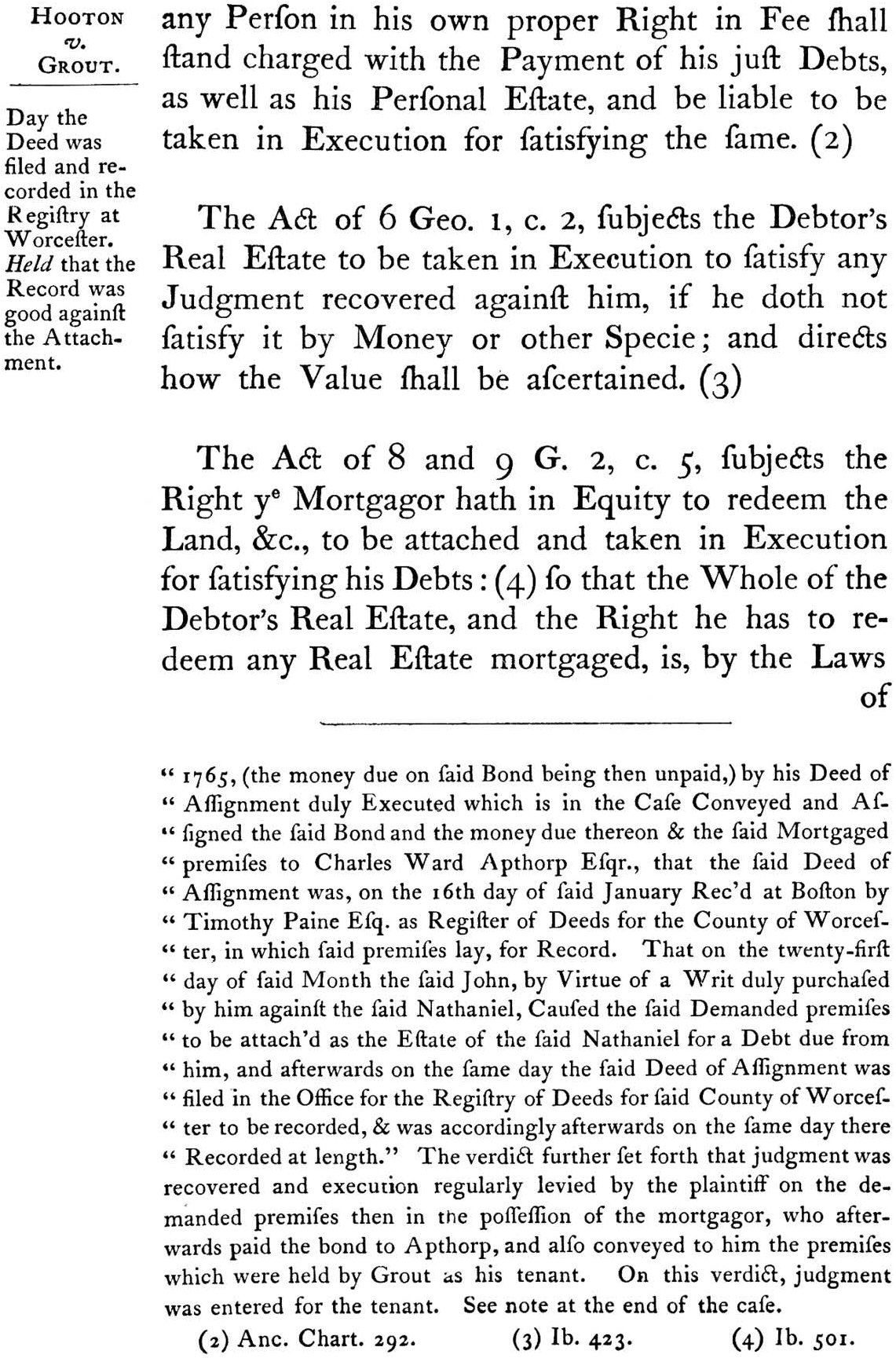
[P. 344]
There are many citations to the English common law sources popular in the colonies, such as Coke’s Reports (complete edition Parts I–XI, London, 1658), Coke on Littleton (London, 1628), and Matthew Bacon’s New Abridgement of the Law (London, 1736). See Law Commonplace, supra, [4], n. 4; [2], n. 1, and [37], n. 5 respectively. But also appearing are three citations to a new source, Blackstone’s Commentaries, which were first published in a series in Oxford (vol. 1, 1765; vol. 2, 1766; vol. 3, 1768; vol. 4, 1769) and in America, beginning in an unauthorized series published by Robert Bell of Philadelphia, vol. 1, 1771, vol. 2, 1772 etc. Trowbridge’s citations are all to volume 2. Could he be using the new American edition? See Reports, 345, 347.
5 · later citations
None. As Samuel Quincy pointed out, the law in the Commonwealth evolved differently. See Reports, 369, S. Quincy, Note. Another opinion by Trowbridge on mortgage attachment was published in 1812 as a brief essay Of mortgages, “by the late Judge Trowbridge,” 8 Mass. 551, 551–560 (1812).
6 · notes
As discussed above, this long written treatise of an opinion by Trowbridge is mysterious. Unlike its counterpart in Richmond v. Davis (1768), Reports, 279, Case 61, supra, it was not a dissent, and it was not directed at the possibility of appeal to King in Council. See discussion at id., Note 6. The final outcome of Wheelwright’s attempts to evade creditors by assigning all his worldly goods, “his wearing Apparell not excepted” Reports, 318, was sensible enough. Where Wheelwright’s creditors were able to attach mortgaged property before the mortgage assignment was recorded, as in Symes, supra, they succeeded. Where, as in this case, the assignment was received and recorded before the attachment, they failed.
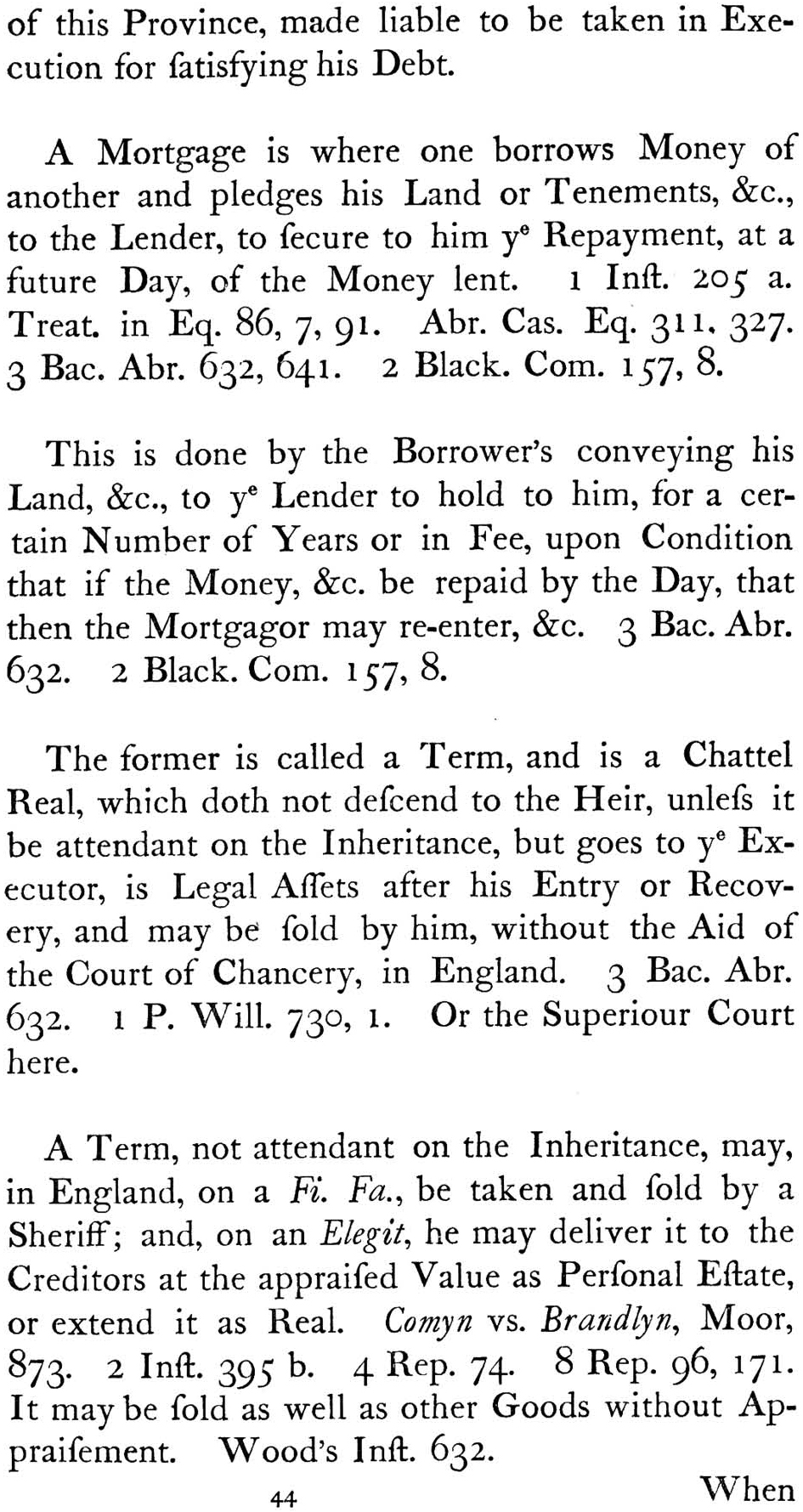
[P. 345]
As Trowbridge pointed out, there were limitations to this state of the law.
“It is true, the Mortgagor may pay ye Money to ye Mortgagee, after his Creditor has attached the Land for his Debt, without ye Mortgagor’s knowing it is attached, and thereby lose his Money: And so a Purchaser may purchase Land after it is attached, and thereby lose his Money; but that has never been thought sufficient to prevent a Debtor’s Land being attached and taken in Execution for satisfying his Debts.” Reports, 365–366. But to not permit such attachments would be much worse. “So that, if the Land cannot be taken as Mortgagee’s Estate to satisfy his Debts, he may have Ten or a Hundred Thousand Pounds secured to him by the Mortgage, which his Creditors, by no Possibility, can come at; he may shut himself up and bid Defiance to them. Surely this is not to be endured, if it can possibly be avoided: Much less should first Principles of Common Law, Judgments and Determinations of the Common Law Courts and Courts of Chancery also, be set at Nought and disregarded in Order to subject Creditors to so great an Evil.”
Possibly Trowbridge’s long opinion was an effort to forestall future legislative or judicial moves in this direction, or simply was an effort to put the colonial law of mortgages into writing for the first time. If so, it was a very early effort at American treatise writing, just as Quincy’s Reports represented embryonic American case law.
It might be wondered why the crucial date was the date that the deed of assignment was “filed” in the Office of the Registry of Deeds for the County of Worcester “to be recorded,” rather than the actual date that is was recorded. See Reports, 344. The answer is in the wording of Provincial Law 9 William III (1697), “An Act for the Registering of Deeds and Conveyances” which specified that the date on the record should be “the day, month and year when he [the “Register of deeds”] received the same . . . and the record shall bear the same date.” Charters and General Laws, supra, 305.
[P. 346]
[P. 347]
[P. 348]
[P. 349]
[P. 350]
[P. 351]
[P. 352]
[P. 353]
[P. 354]
[P. 355]
[P. 356]
[P. 357]
[P. 358]
[P. 359]
[P. 360]
[P. 361]
[P. 362]
[P. 363]
[P. 364]
[P. 365]
[P. 366]
[P. 367]
[P. 368]
[P. 369]
CASE 76
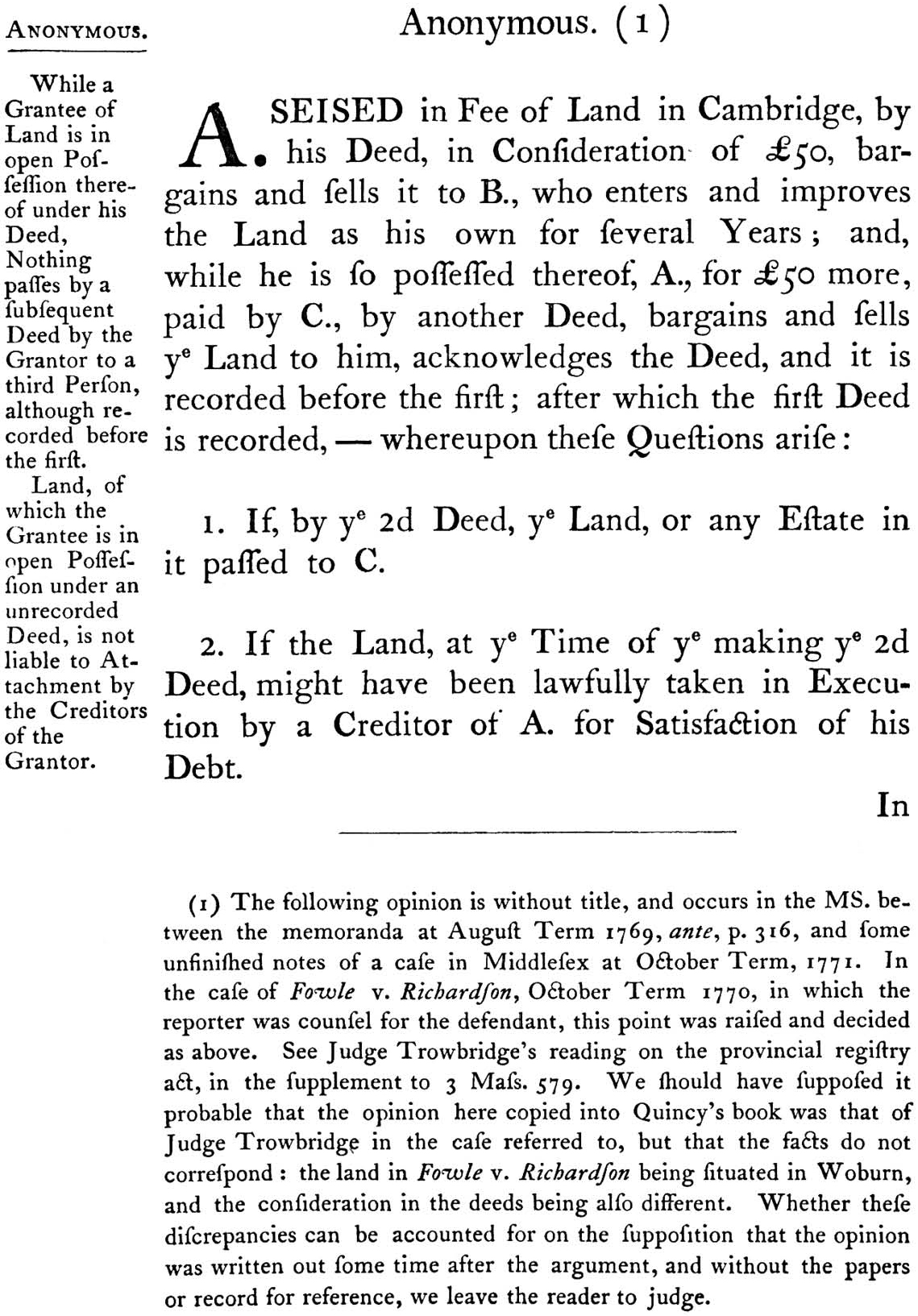
[P. 370]
11 George III (October Term) in the Superior Court of Judicature-Middlesex? [Fowle v. Richardson?]
1 · brief description
This is another mystery. It appears to be a judicial opinion, copied by Quincy. It may be Fowle v. Richardson (1770) (October Term, Middlesex) in which Quincy appeared for the Defendant, but the facts are wrong. See Samuel Quincy’s note 1, Reports, 370.
The facts given are these. A sold land to B, by deed. B enters and openly improves the land. A then sells the same land to C, by deed. C records the deed first, and then B. While B’s deed is unrecorded, A’s creditors try to attach the land for A’s debts. Held: B owns the land, not C. B’s land is not liable to attachment by A’s creditors.
2 · court records
The facts differ from Fowle v. Richardson, supra, where the record is available at Rec. 1770, fol. [35].
3 · professionals involved
The report might represent the defense in Fowle v. Richardson, supra, but there is no indication of counsel identity in this case. Despite Samuel Quincy’s speculations, the style is not very much like Trowbridge’s “Argument” in Richmond v. Davis (1768), Reports, 279, Case 61, supra. Nor is it like the three “State of the Case” arguments submitted by counsel-and possibly by Hutchinson-in Banister v. Henderson (1765), Reports, 42, Case 42. See id., Note 6. Nor does this opinion resemble Quincy’s own reporting style. If anything, it more closely resembles the style of the earlier sections of Quincy’s Law Commonplace, Quincy Works, vol. 2, [16]ff.
The primary argument for the opinion being by Trowbridge, a possibility raised by Samuel Quincy at Reports, 370, S. Quincy n. 1, was that Trowbridge was the only Justice on the Superior Court with the legal training to write a complete exposition on passage of title in Massachusetts, particularly one that showed familiarity with the Statute of Uses, 27 Hen. VIII, c.10 (1536) and the Statute of Enrollments, 27 Hen. VIII, c.16 (1536). See Reports, 371–374. But Peter Oliver (1713–1791), John Cushing (1695–1778), and Benjamin Lynde Jr. (1700–1781) had been judges of one court or another for many years. See biographies at Appendix 7, supra. They were not as formally trained as Trowbridge, and would describe themselves as “Gentlemen” or “Merchants,” but they had years to learn the provincial law. See Charles R. McKirdy, “Massachusetts Lawyers on the Eve of the American Revolution,” in Law and Colonial Massachusetts, supra, 330–332. So this opinion could have been by another Justice.
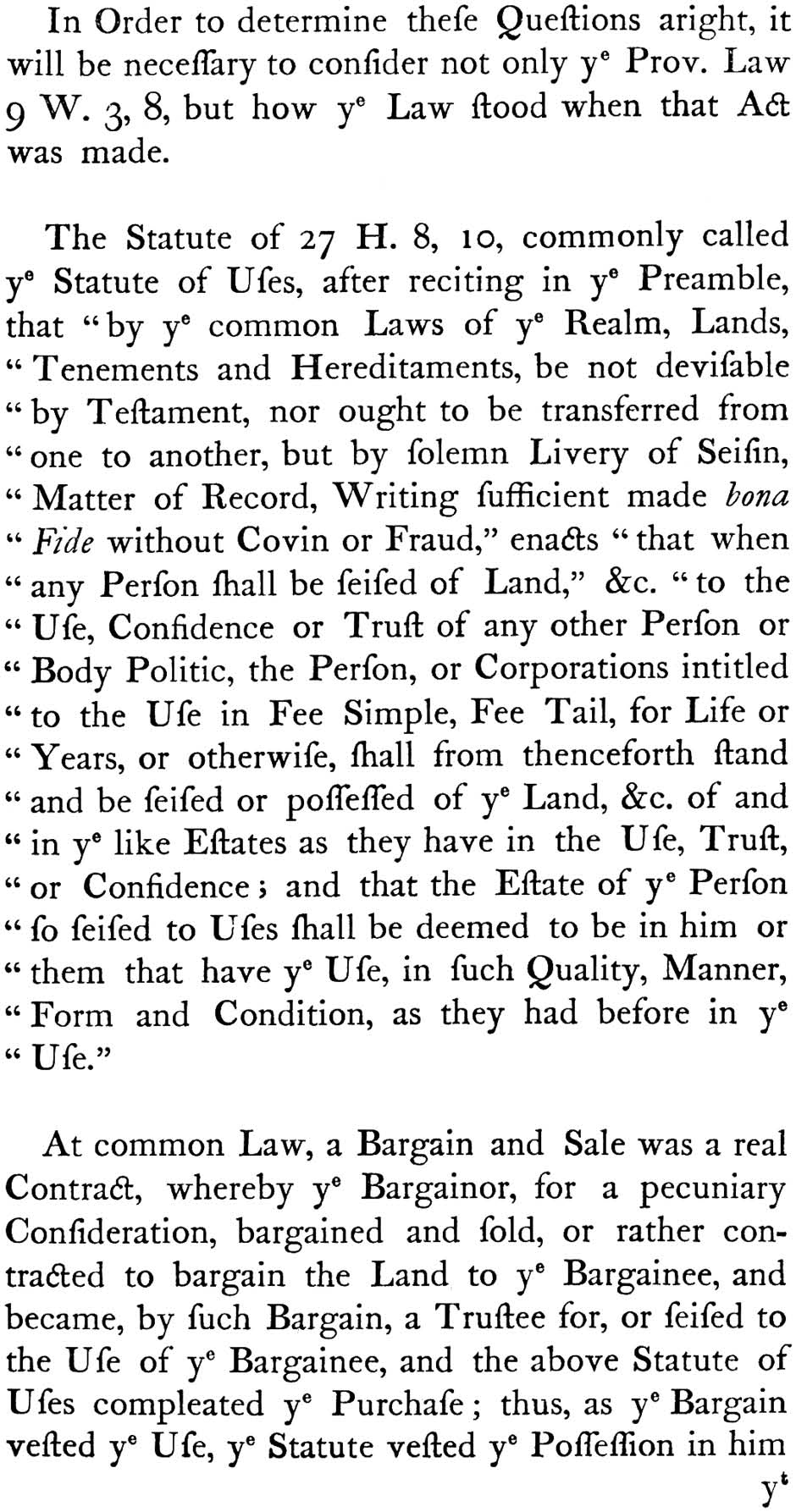
[P. 371]
Given its argumentative style, it also could have been prepared by counsel. Phrases like “If it be objected, ‘that ye Conveyance will be effectual against other Persons besides ye Grantor and his Heirs . . .’” seems curiously defensive for a judge deciding a case. See Reports, 380. Compare the long historical arguments by Auchmuty, Gridley and Otis in Bannister v. Henderson (1765), Reports, 128–145, Case 42.
The opinion or argument is probably not by Quincy himself, although he was counsel in Fowle v. Richardson, supra, for the defense, which would have relied on similar arguments. To start, the style is less sophisticated. In addition, Quincy added characteristic notes, at one point questioning the writer. See Reports, 374, 375, and 377. “Qu. If ye Estate is not in them; and also, if ye Matter of ye Exception would not have been implyed . . . etc.” Id., 375. But he would certainly have regarded the whole argument as useful, particularly for its statutory expositions. See Note 4, infra.
4 · authority
Since the Statute of Enrollments, 27 Henry VIII, c.16 (1536), passage of land title at common law has been heavily regulated by statute, and this was true in Massachusetts since 1641. See “Acts as to Conveyances, Deeds and Writings” Colony Laws, Charters and General Laws, supra, 85–86; containing ordinances of May 1641, 1651 and 1652. To prevent “clandestine and uncertain sales of homes and lands,” to protect both venders and creditors, a system of recording was established in 1697, by “An Act for Registering of Deeds and Conveyances,” (1697) 9 William III Chap. 8, Charter and General Laws, supra, 303–305.
[P. 372]
Most of the authority cited was, therefore, an analysis of both the English and American statutes, and their construction by cases such as Dymmock’s Case (1617), 2 Croke’s Reports (Jac.) 408, 408–409. These cases struggled with issues such as what happens when land is bargained and sold, and the vendor dies before enrollment. Quincy himself emphasized old English authority, three times adding citations to Coke’s Second Institutes (London, 1642), “Of Inrollments of bargaines etc.” 673; see Reports, 374, and Twyne’s Case (1601), 3 Coke’s Reports 80b at 82b, where the Elizabethan statutes against fraud were “liberally and beneficially expounded,” to set aside conveyances designed to cheat original vendees and creditors, “because fraud and deceit abound in these days more than in former times.” Id., p. 82a. (Quincy also added a citation reproduced as “9 Inst. 266,” which appears to be a citation to Coke on Littleton (London, 1628), 266a–266b (i.e., “1 Inst. 266”).
Most interestingly, this opinion, like Hooton v. Grout (1772), Reports, 343, Case 75, cited to volume 2 of Blackstone’s newly published Commentaries. Volume 2 was first published in Oxford in 1766, and then in a pirated edition by Robert Bell of Philadelphia in 1772. See Reports, 372, 378, 381 citing to 2 Blackstone’s Commentaries 338, 314, and 314 respectively. Blackstone’s emphasized that a bargain and sale vested complete legal ownership in the vendee, thanks to the execution of the equitable “use” by the Statute of Uses “As soon as it arose, and thereby ye Cestuy que Use (equitable owner) became compleat Owner of ye Land, in Law as in Equity.” Reports, 372, cited 2 Blackstone’s Commentaries 338, which stated that “the bargain first vests the use, and then the statute vests the possession,” id., 338. Thus, within only four years Blackstone was being cited authoritatively across the Atlantic! Quincy owned and annotated some volumes of Blackstone, which have not been located to date. See Appendix 8, infra. According to Samuel Quincy, Quincy owned the first volume of Blackstone (3d ed., Oxford, 1768), “with marginal notes in his handwriting.” In 1864, this book was still in possession of his son, who died that year. See Reports, 520, S. Quincy n. 22.
5 · later citations
None. As Samuel Quincy pointed out, subsequent Massachusetts law continued to protect “open and notorious possession,” despite failure to record, although statutory reforms changed the notice from “implied” to “actual,” i.e., even if the possession were notorious, only actual knowledge by the subsequent vendee or creditor will protect the possessor from neglect in not recording his or her deed. The policy was to encourage prompt recording. See Reports, 381, S. Quincy n. 5.
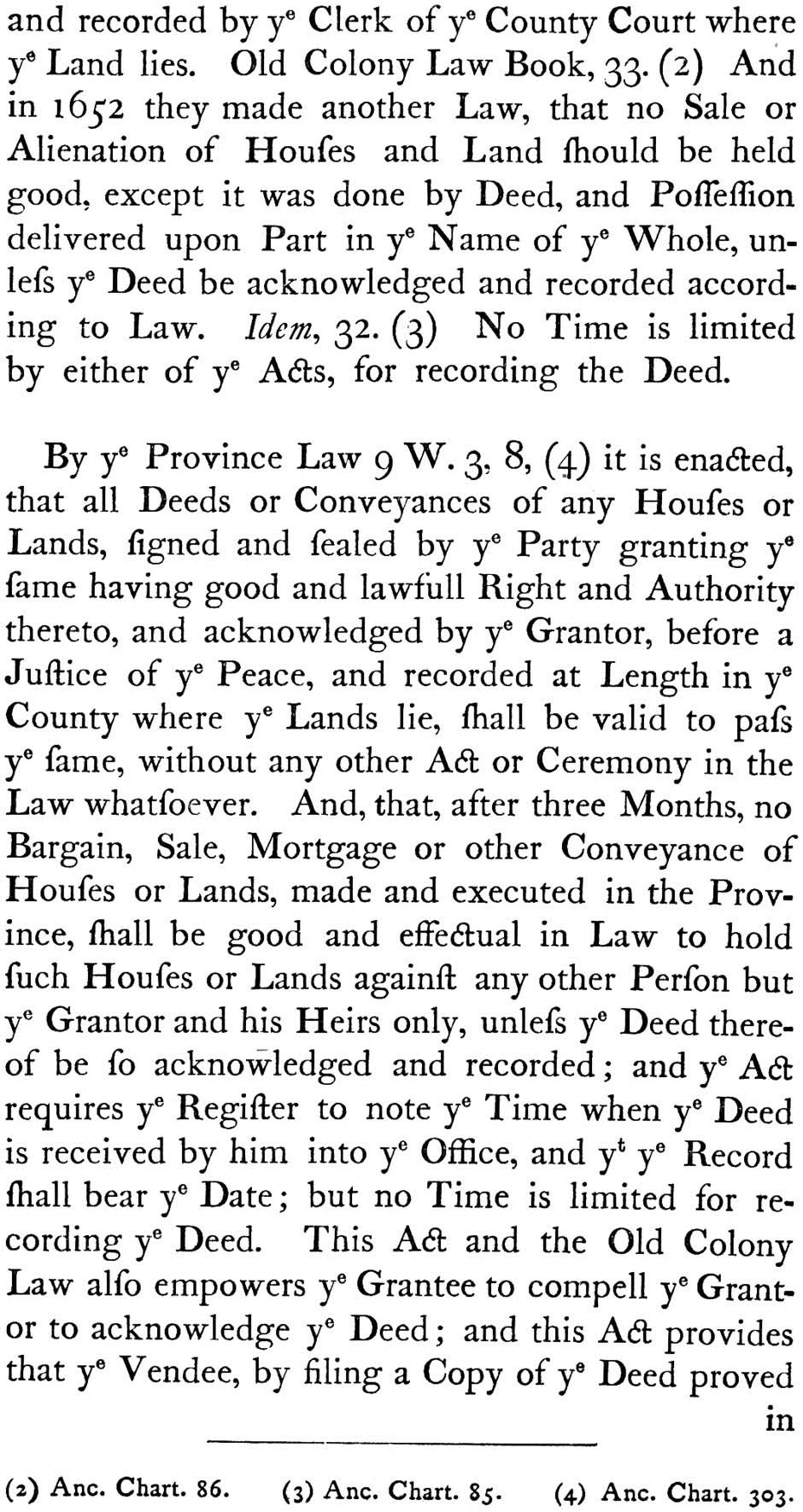
[P. 373]
6 · notes
One of the oldest issues of the common law was how to give notice of land ownership, to protect true owners, discourage fraud, and safeguard loans secured by land. The feudal system relied, as it often did, on public ceremony, such as the rites of the old livey of seisin, which could include passing a clump of dirt, or twigs, from vendor to vendee. See D. R. Coquillette, The Anglo-American Legal Heritage, supra, 118–120, for an illustration. See also J. H. Baker, supra, 305. But this policy was defeated by secret land transfers using “bargain and sale,” because such a transaction gave the vendee an equitable right “a use,” to the property, which would be enforced by equity, without a public ceremony. Henry VIII’s Statute of Uses (1536 1, supra, “solved” this problem by “executing uses,” and giving the vendee a legal title, but one which had to be enrolled within six months in a public registry pursuant to the Statute for Enrollments (1536), supra. See Reports, 371–372. As seen, a similar recording system was established in the colony by statute. See Note 4, supra.
So what happened between the “bargain and sale” and the filing of the deed to be recorded pursuant to Province Law 9 William III, chap. 8 (1697), supra? The author of this “opinion” made a strong case that the full legal title passes to the vendee, unless there is evidence of fraud, in which case the Colony Laws of 1641 and 1652, supra, would defeat the conveyance. See Charters and General Laws, supra, 85–86. The vendor has nothing left to transfer to a second vendee, so a second bargain and sale transfers nothing, even if recorded first.
“The second Bargain and Sale cannot be better than it would have been, had there not been a first. And ‘that no Man can, by Deed, convey Land to another, which a third Person is in Possession of, claiming it as his own’ is a Maxim of ye Common Law which is by no Means altered by ye Province Law. That rather confirms and established ye Rule: For it enables no other Persons to convey Land by Deed acknowledged and recorded, but such as ‘have good and lawfull Right and Authority so to do.’ And, though this Clause, when taken together with ye restrictive Clauses in ye Act, must be construed to extend to such Persons as have an apparent Right and Authority to convey, yet that don’t destroy, but establishes ye Rule of ye Common Law; since no Man has even an apparent Right to convey Land to another, that a third Person is in Possession of, claiming it as his own.” Reports, 377.
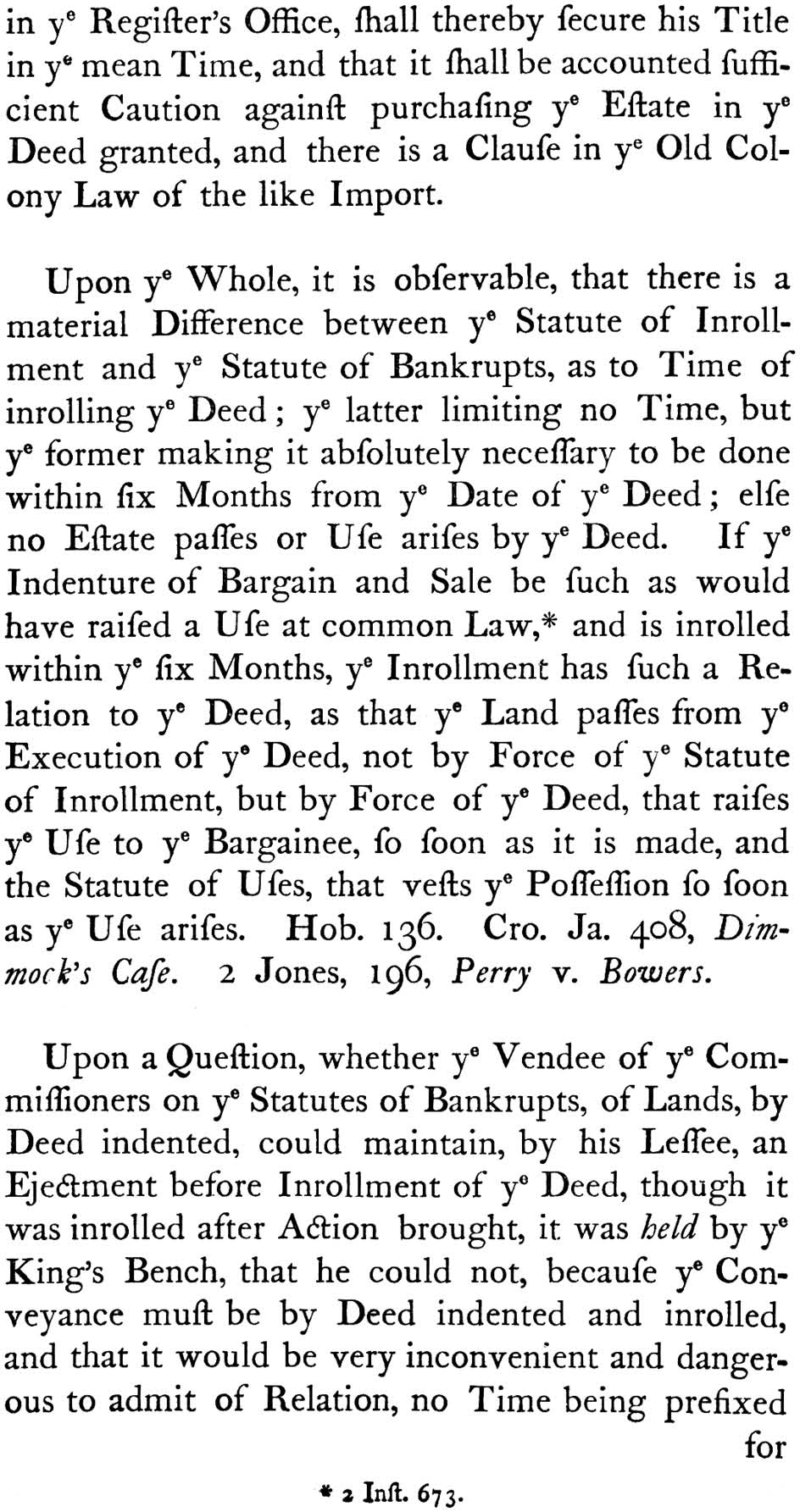
[P. 374]
But what if the land was attached by a creditor of the vendor before the deed was recorded? The Colony Laws made an exception where the vendor conveyed land to another, and remained in apparent possession without recording the deed. See Colony Law of 1641, supra, Charters and General Laws, supra, 85, and Reports, 372–373. This was an obvious trap for creditors, who would assume that the vendor still owned the land. But where, as in this case, the new owner took possession and “enters and improves the land,” the attachment should be no good. Indeed, as the author noted, citing Blackstone, such “Entry and continual Possession” was “of equal Notoriety with Livery of Seisin,” the old feudal, public ceremony. Further, the vendee’s land could be rightfully attaché by his creditors, so to permit attachment by the vendor’s creditors as well was logically impossible, “[s]urely, it is not ye Estate of both, and liable to be taken in Execution for ye Debts of both, at the same Time.” Reports, 380.
In the end, the Massachusetts colonial law struck a careful balance. On the one hand, purchasers should be encouraged to record their deeds, to protect themselves and other bona fide purchasers. “The Design of ye Province Law, as will as ye Statute of Inrollment, is to prevent fair Purchasers being defrauded and injured.” Reports, 378. On the other hand, where no fraud is intended and the possession of the purchaser with an unrecorded deed is obvious, that purchaser should not lose the land to a subsequent vendee or a creditor of the vendor. Thus, “when ye Deed is recorded or ye Grantee enters into Possession of ye Land, and improves it as his own, every one, thereby, is sufficiently cautioned against purchasing ye Land of ye former Possessor, and is in no Danger of being injured or defrauded, unless it be by an Attempt to defraud a fair bona Fide Purchaser.” Reports, 378–379.
It was a sensible solution.
[P. 375]
[P. 376]
[P. 377]
[P. 378]
[P. 379]
[P. 380]
[P. 381]
ILLUSTRATION 22: Section of Writ of Attachment, 25 June 1776, Inferior Court of Common Pleas, Suffolk. It shows George III’s title crossed out and replaced with “The Government and People of the Massachusetts Bay in New England.” This, and similar writs, were issued before the signing of the Declaration of Independence on 4 July 1776. Courtesy, Social Law Library, Boston. See Dewing v. Train (1777), Reports, 339, Case 74, Note 1 and 6.
CASE 77
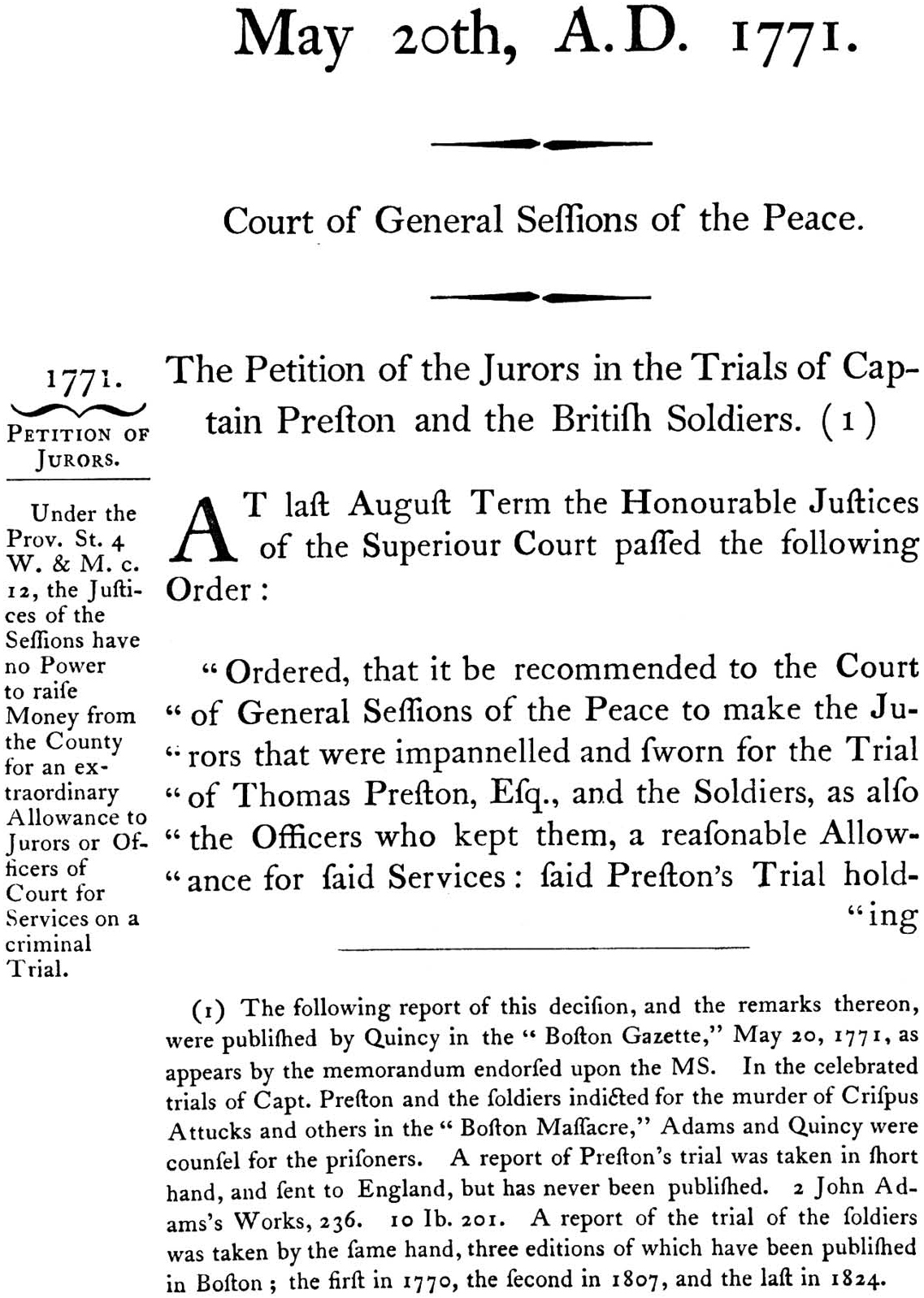
[P. 382]
The Petition of the Jurors in the Trials of Captain
Preston and the British Soldiers (1771) In the Court of General Sessions of the Peace (May 15, 1771)
1 · brief description
This was a description by Quincy of a decision by the Court of General Sessions of the Peace reached on Wednesday, May 15, 1771. He published the description in the Boston Gazette the following Monday, May 20, 1771. Despite a recommendation by the Superior Court of Judicature to the contrary, in August Term 1770, the Court of General Sessions of the Peace, see Note 3, infra, held that it did not have power under provincial statutory law Act of 4 William & Mary, chap. 12 (1692), Charters and General Laws, supra, 245 to pay an allowance to the jurors and “the officers who kept them” for the 15 days spent in the trial of Captain Preston and the British Soldiers accused of the so-called “Boston Massacre,” including the deaths of Crispus Attucks, Patrick Carr, Samuel Maverick, Samuel Ory, and James Caldwell.
2 · court records
The record of the cases of Preston and the soldiers relating to the jurors is available at Rec. 1770, fol. 52.
3 · professionals involved
Quincy indicated that “four Gentlemen of the Bar (pro & con)” argued the case “by Desire of the Honourable Justices of the Sessions,” but did not indicate who they were. In the underlying case, the Reporter himself and John Adams (1735–1826) appeared for Captain Preston and the British Soldiers, and Robert Auchmuty (1723–1788) appeared for Captain Preston. The Reporter’s brother, Samuel Quincy (1734–1789) appeared for the Crown as Solicitor General, Attorney General Jonathan Sewall (1729–1796) having “left Boston quasi-permanently,” with Robert Treat Paine (1731–1814) entering the case “as a kind of special prosecutor” at the request of the Boston Selectman. See Legal Papers of John Adams, supra, vol. 3, 5–9. It is unclear if any of the five active lawyers in the case were among the “four Gentleman of the Bar” asked to argue before the Court of General Sessions of the Peace.
[P. 383]
The Court of General Sessions of the Peace was one of the four basic divisions of the Massachusetts courts (excluding the Vice-Admiralty); the other being the Superior Court itself, the Inferior Court of Common Pleas, and the Justices of the Peace. (The latter usually sat as one-man courts “which heard petty civil and criminal cases.” See William E. Nelson, “Court Records as Sources for Historical Writing,” Law in Colonial Massachusetts, supra, 499, at 502.) The Court of General Sessions “had a jurisdiction within a single county to engage in a wide variety of administrative activities and to hear all but the most serious criminal matters.” Id., at 502. The remaining two courts, the Superior Court and the Inferior Court of Common Pleas, essentially divided the jurisdiction of the English King’s Bench, “with jurisdiction over serious crimes and appellate jurisdiction over civil disputes being reserved for the higher court and original typical jurisdiction over civil disputes reserved for the lower court.” Id., at 502. The Massachusetts Court of General Sessions of the Peace lasted from 1692 to 1827, with its jurisdiction eventually transferred to the new Superior Court, primarily a trial court, in 1859. See Catherine S. Menand, “A ‘magistracy fit and necessary’”: A Guide to the Massachusetts Court System,” Law in Colonial Massachusetts, supra, 541, at 546.
4 · authority
The sole authority cited was the provincial statute “An Act for the Settlement of the Bounds, and Defraying of the Publick and Necessary Charges Arising within Each Respective County in this Province” (1692), 4 William & Mary, chap. 12, sect. 1, Charters and General Laws, supra, 245. Quincy loosely quoted the statute in his article, adding his own capitalization, emphasis and italics. The key phrase was the power of the Justices in Quarter Sessions to raise money “for defraying the charges arising within each respective county for the necessary repairs and amendment of bridges, prisons, the maintenance of poor prisoners, and all other proper county charges.” Id., at 246.
5 · later citations
This case was recently cited in connection with a writ of mandamus directing a county treasurer to pay for court recording equipment. See O’Coins, Inc. v. Treasurer of Worcester County, 362 Mass. 507, 515 (1972), where this case, Reports, 382–386, was cited as an early example of the court recognizing the authority of lower courts to require counties to pay for expenses relating to jury service. The inherent power of the Massachusetts courts to spend public money for the adequate running of the justice system has been widely debated. See County of Barnstable v. Commonwealth, 422 Mass. 33, 43–47 (1996); Lavallee v. Justices in the Hampden Superior Court, 442 Mass. 228, 241–249 (2004).
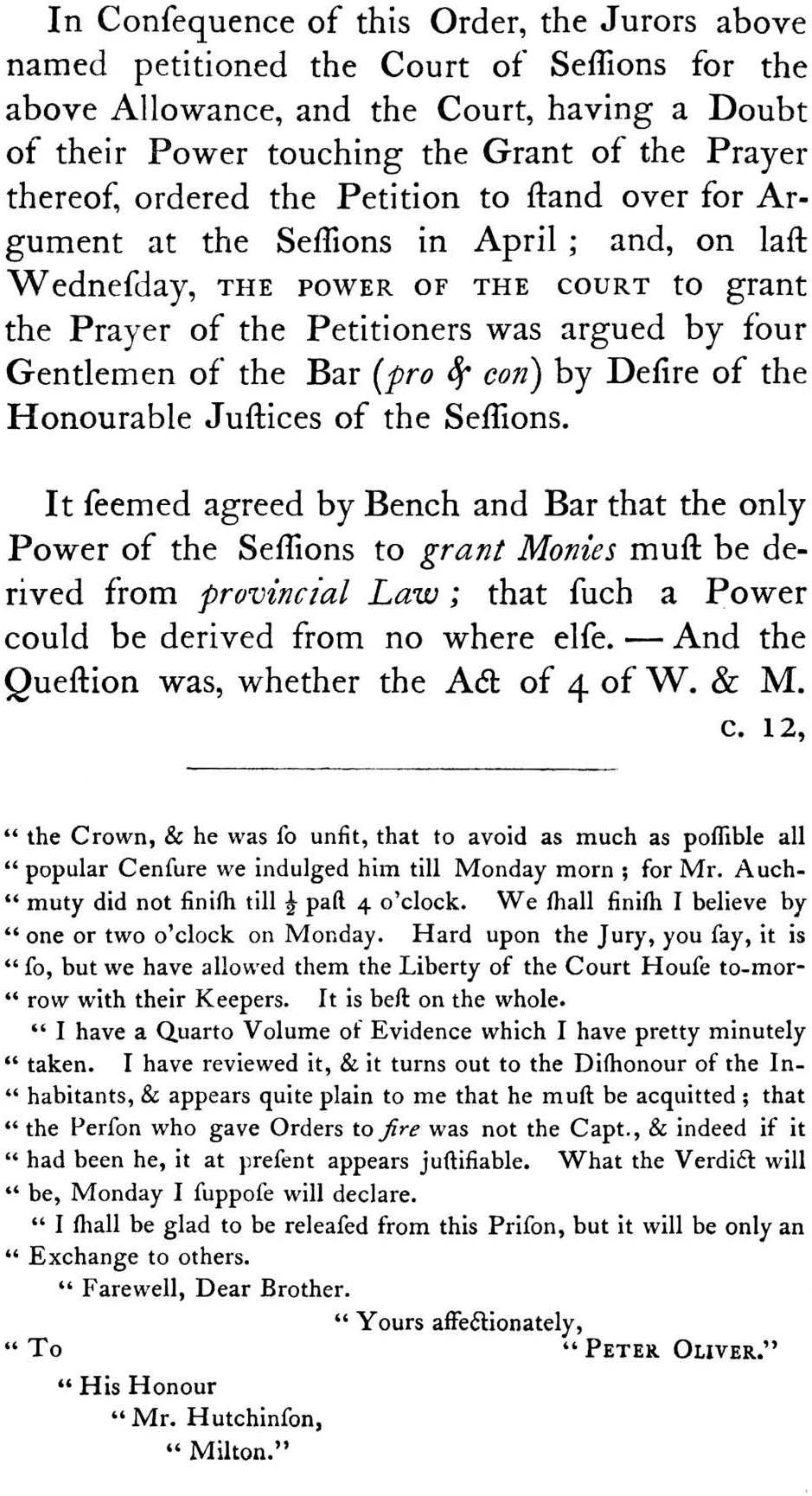
[P. 384]
6 · notes
As both Trowbridge’s papers and the contemporaneous letter from Hutchinson to Oliver indicated, jury trials that lasted more than one day were exceedingly rare, both in Massachusetts and England. See Samuel Quincy’s note 2, Reports, 383–384, and 25 Mass. Archives, 414. Not surprisingly, the jurors sought an allowance for being sequestered for fifteen days! The Superior Court, recognizing that the Court of General Sessions of the Peace was the appropriate source, formally recommended that “a reasonable allowance be paid” both to the jurors “as also the officers who kept them.” Reports, 382. As Quincy observed, the clear implication being that, in the Superior Court’s judgment, those were “other proper county charges,” as authorized by 4 William & Mary, chap. 12, sec. 1 (1692). See Reports, 382–383.
The Court of General Sessions of the Peace, after full argument, disagreed, with Justice Dunbar dissenting. While no reasons were apparently given, it “seemed agreed by Bench and Bar” that it was entirely an issue of interpreting 4 William & Mary, chap. 12, sect. 1 (1692), supra, as “such a Power could be derived from no where else.” Reports, 384.
Quincy then goes on to praise the decision of the Court of General Sessions, “[i]t gives a most sensible Pleasure in these Times to find a Court of Justice deciding a Point of Law against an Extension of their Power: especially as that Power would affect the Purse of the Subject.” Id., 385–386. In apparent contrast, he noted “deep Concern with some that the Superiour Court seem to entertain a different Opinion. . . .” Id., 386. Quincy was extremely careful not to directly criticize the Superior Court, but noted that one could “conjecture that they [the Superior Court] were of Opinion that the Court of Sessions was by Law vested with Power to take Money out of the Pocketts of the People. . . .” Id., 386.
With all respect to Quincy, the exceptional circumstances of the Boston Massacre Trials and the service of the jurors and officers would seem to be “other proper county charges,” as required by the statute. But fear of an inherent authority of courts to tax and support the justice system is not only an old one in Massachusetts, but a persistent one. Unlike federal precedents ordering public expenditures, Massachusetts Courts have repeatedly denied themselves such a fundamental power. See, e.g., County of Barnstable v. Commonwealth, 422 Mass. 33, 43–47 (1996); Lavallee v. Justices in the Hampden Superior Court, 442 Mass. 228, 241–249 (2004).
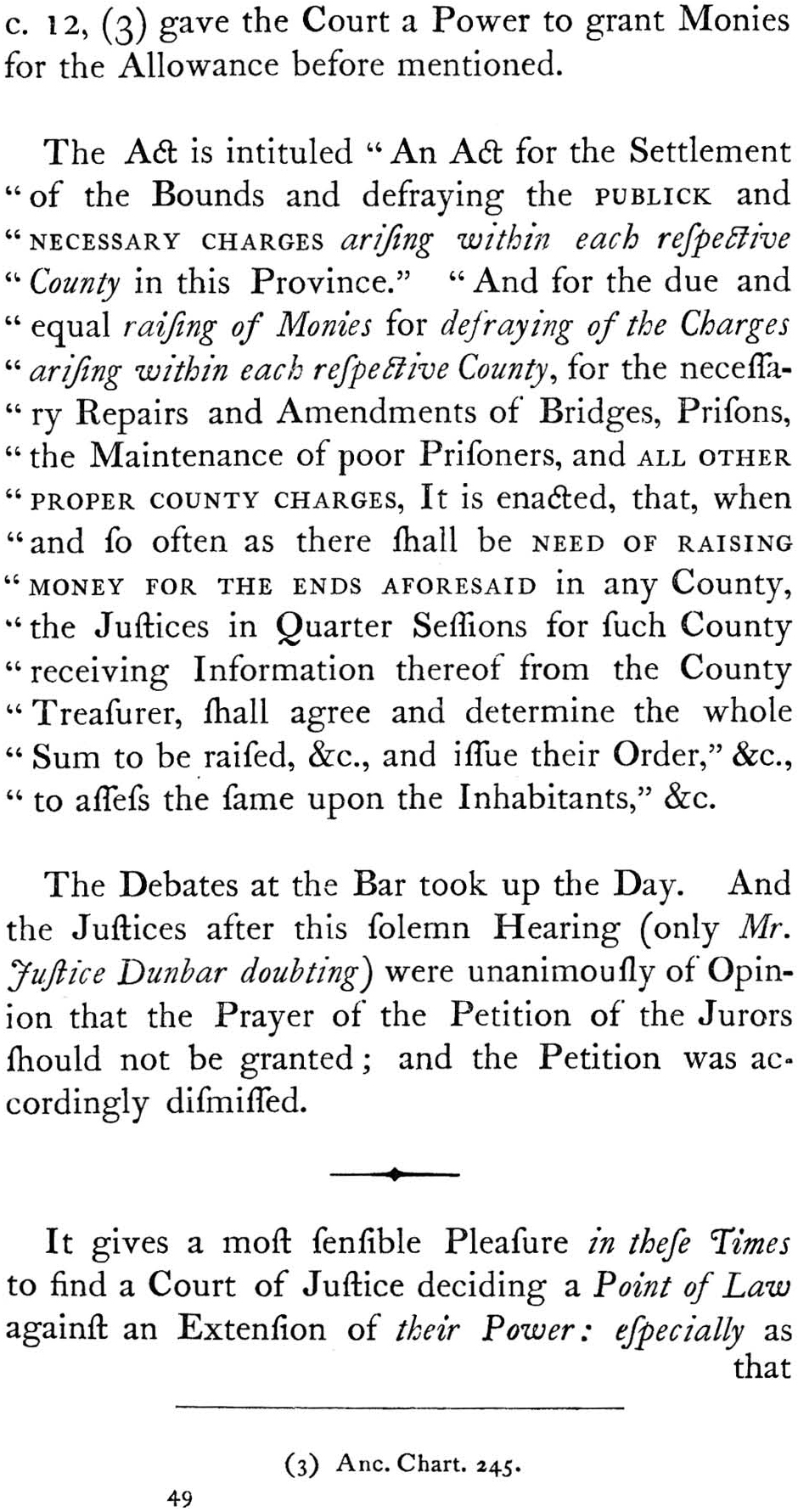
[P. 385]
For a further history of the “Boston Massacre” trials, see Legal Papers of John Adams, supra, vol. 3, 1–314, which includes Adams’s notes of the Reporter’s lengthy and eloquent “Argument for the Defense,” id., 226–239, and a copy of Gilbert Stuart’s portrait of the Reporter, facing 196. See generally Hiller B. Zobel’s excellent The Boston Massacre (New York, 1970).
[P. 386]
ILLUSTRATION 23: Boston Gazette, Monday, May 20, 1771, “Petition of the Jurors in the Trials of Captain Preston and the British Soldiers.” See Petition of the Jurors . . . (1771), Reports, 382, Case 77. Courtesy of Early American Newspapers, and Archive of Americana Collection. Published by Readex (Readex.com), a division of NewsBank, inc.
CASE 78
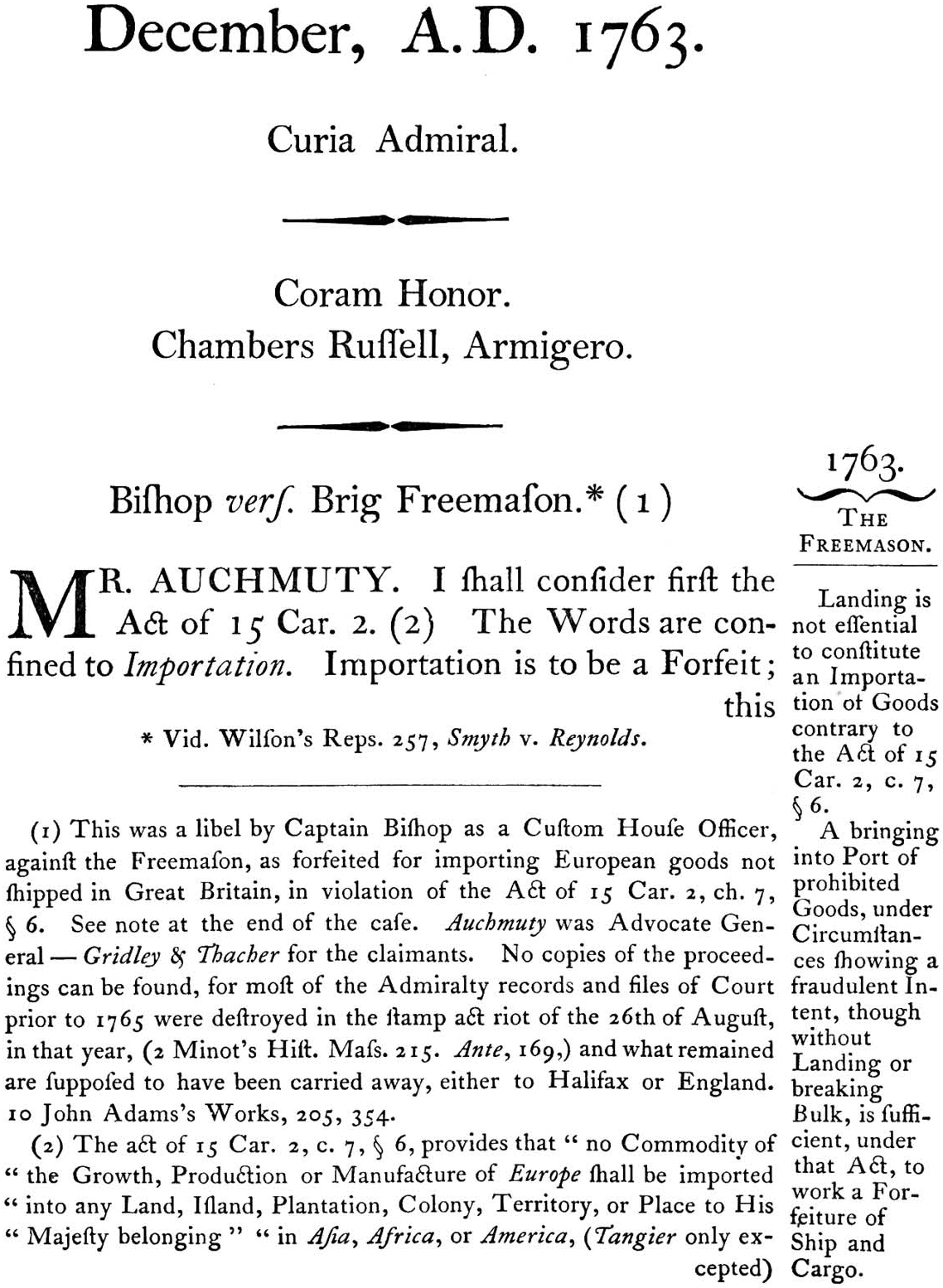
[P. 387]
Bishop v. Brig Freemason (1763)
4 George III (December) in the Vice-Admiralty Court, Massachusetts (“Curia Admiral”)
1 · brief description
This is an incomplete fragment, by Quincy, reporting a case in the Vice-Admiralty Court in 1763. Quincy would have been very young, only nineteen, at this time, and just graduating from Harvard College. Due to the destruction of the Vice Admiralty records during the 1765 Stamp Act riots, contemporary accounts such as this are particularly valuable.
This was a libel (complaint) in Admiralty by a Captain Bishop, as “Custom House Officer” against the Brig Freeman and cargo. The brig had been seized by the Sloop of War Fortune as it tried to sneak by Castle Island loaded with French wine. Its captain claimed that the Freemason was bound for St. Eustatia, and was not going land cargo, but vessel and cargo was libeled anyway in the Vice-Admiralty Court for violation of the “Navigation Act,” 15 Charles II, ch. 7, sec. 6 (1675), which prohibited the “importation” of all goods not “shipped in England, Wales or Berwick upon Tweed (Scotland).” The colonial owners of the ship and the French and Dutch owners of the cargo, the “Claimers,” contested the libel, their lawyers arguing that Captain Bishop had an improper commission and that the act required that the cargo actually be landed “or Bulk broken.” Reports, 391. At this point Quincy’s report itself broke off.
2 · court records
Apparently lost during the Stamp Act riots of August 26, 1765, or “carried away, either to Halifax or England,” where these have never been discovered. See Reports, 387, S. Quincy n. 1. For further discussion of the records and the Vice-Admiralty Court generally, see L. Kinvin Wroth, “The Massachusetts Vice-Admiralty Court,” Law and Authority in Colonial America, ed. George Athan Billias (Barre, Mass., 1965), 32–73.
An account of the outcome of the case is in a letter from Governor Bernard to the Earl of Halifax dated Dec. 2, 1763, and reproduced by Samuel Quincy at Reports, 392–394, S. Quincy n. 4. Halifax had been appointed Secretary of State for the Southern Department in 1763, and this letter was apparently based, “almost in the very same Words,” on a letter Bernard sent to the Board of Trade dated “Boston, Decr. 24, 1773.” That letter is set out in a companion series to the Quincy Papers ably edited by Colin Nicolson. See The Papers of Francis Bernard (C. Nicolson, ed.), vol. 1 (1759–1763), 445–447. (Hereafter, “Bernard Papers.”) Bernard also wrote about the Freemasons to a key British administrator, John Pownall, on December 30, 1763. See id., 451. The Board of Trade considered the Bernard letter to them on July 2, 1764, and John Pownall replied on July 12, 1764. Id., 447. Bernard’s letters indicated that the Vice Admiralty Judge, Chambers Russell, found for the libellant, and that “the Vessel & Cargo” were forfeited. Id., 393. According to Bernard, “the Claimers have appealed to the High Court for Admiralty,” and he urged Halifax and the Board of Trade “that the defense of this Decree against the appeal be supported at the expense of his Majesty” because of its importance to enforcing the customs laws in Massachusetts. Id., 394. See Bernard Papers, supra, vol. 1, 446.
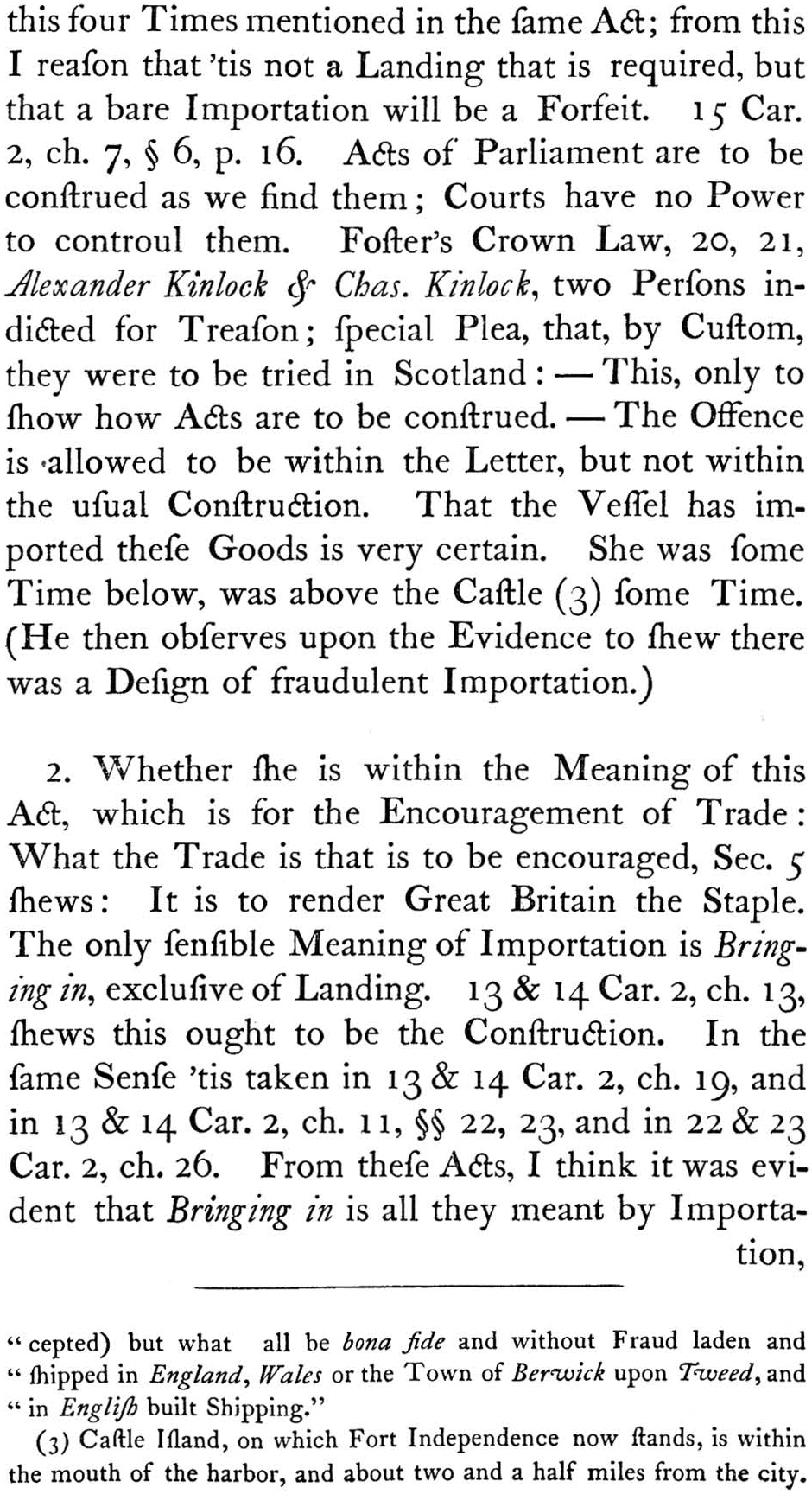
[P. 388]
3 · professionals involved
Robert Auchmuty (1723–1788) was the Advocate General in the Massachusetts Vice-Admiralty Court from 1762–1767, when he became Judge of the Court, succeeding Chambers Russell (1713–1766) on Russell’s death. (Russell was also a Justice of the Superior Court from 1752–1766). As might be expected, Auchmuty’s preferment in this most royal of colonial courts meant that he was a loyalist, and he was proscribed in 1778. Oxenbridge Thacher (1719–1765) and Jeremy Gridley (1701/2–1767) argued for the claimants. See brief biographies in Appendix 6, for the lawyers, and Appendix 7, for Chambers Russell, who was respectfully designated by Quincy as “Armigero” (“arms bearer” or “gentleman”).
4 · authority
Authority in the Vice-Admiralty Court was either “civilian,” (i.e., Roman law based continental doctrine), or statutory. See D. R. Coquillette, “Justinian in Braintree: John Adams, Civilian Learning, and Legal Elitism 1758–1775,” Law and Colonial Massachusetts, supra, 382–395; F. L. Wiswall, The Development of Admiralty Jurisdiction and Practice Since 1800 (1970), 4–7; Henry J. Bourguignon, The First Federal Court (1977), 141–178. D. R. Coquillette, The Civilian Writers of Doctors’ Commons, London (1988), 29–32, 103–148, 180–197. Some colonial Vice Admiralty cases turned on citations of Roman and civilian sources. See John Adams’s arguments in Doane v. Gage (1766–1769), Legal Papers of John Adams, supra, vol. 2, 68–97 (Case No. 43); Sewall v. Hancock (1768–1769), id., vol. 2, 173–210 (Case No. 46); and Rex v. Corbet (1769), id., vol. 2, 276–335 (Case No. 56), discussed at “Justinian in Braintree,” Law in Colonial Massachusetts, 382–395.
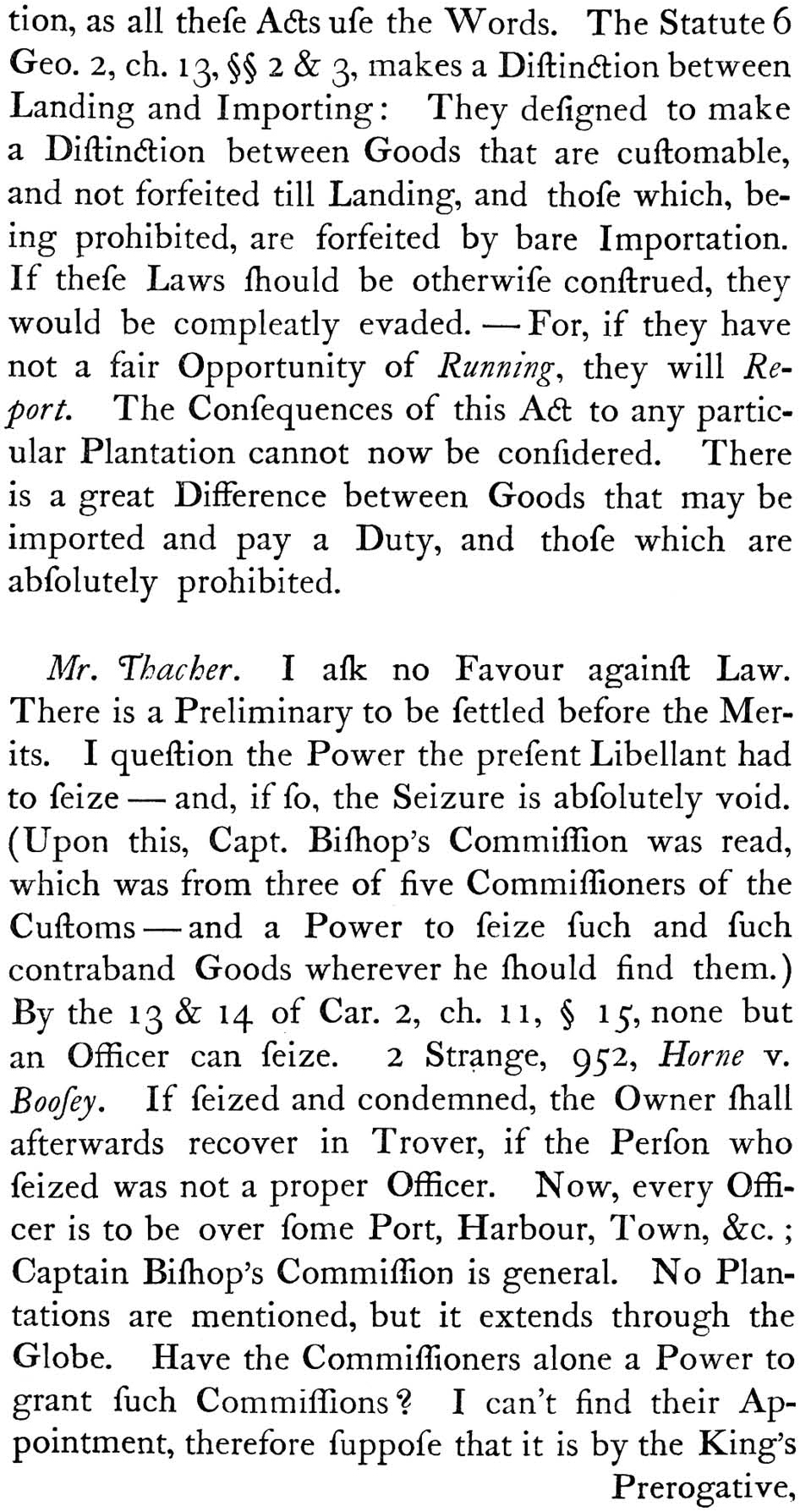
[P. 389]
This argument, as much as we have it, turned almost entirely on statutory construction of 15 Charles II, ch.7, sec. 6 (1675), as to whether “importation” required a landing, and whether the Customs Officer involved Captain Bishop, had a warrant properly grounded on 7 & 8 William III, ch. 22, sec.11 (1697). For this purpose, the advocates largely compared the statutory wording to that of other customs or navigation statutes. Auchmuty did refer to Sir Michael Foster’s Report of commission for trial of rebels in 1746, to which are added Discourses upon a few branches of the Crown law . . . (Oxford, 1762) (“Foster’s Crown Law”), 20–21, for the proposition that “Acts of Parliament are to be construed as we find them: Courts have no Power to controul them” Reports, 388. And Thacher relied on Horne v. Boosey (1733), 2 Strange’s Reports 752 for the proposal that where “one not the proper officer seized brandy” it was like “seizure by a stranger,” and the Defendant tidesman recovered-so it should be in this case because of defects in Captain Bishop’s commission. Reports, 389–390. Gridley’s argument compared the use of the word “importing” in no fewer than six customs statutes, referring for the historical context C. Carkesse’s Act of Tonnage and Poundages and Rates of Merchandize (Carkesse, Book of Rates) (London, 1702, with new editions in 1726, 1730, 1731, and a statutory supplement in 1737), 767, 772. See Sweet & Maxwell, supra, vol. 1, 324:13.
5 · later citations
None. Not surprising, given this was a fragment.
6 · notes
The Navigation Acts required that European goods “imported” into the British colonies must go through England, Wales, or Berwick upon Tweed (border of Scotland and England). These were rightly hated by the seagoing New Englanders. The Brig Freemason, slipping in and out of Boston harbor past Castle Island, was almost certainly trying to smuggle in French wine. But the cargo had not been landed “or bulk broken.” The shippers’ story was that the wine going from France to Saint Eustatius (“St. Eustatia”) in the Dutch Leeward Islands of the Caribbean. Indeed, the “claimers” on behalf of the cargo were not colonials, but “a French Merchant at Bourdeaux . . . a Dutch Merchant at St. Eustatia; and it was alleged that these goods were freighted by one to the other, and that leave was given to this Vessel to take Boston in her way to St. Eustatia: and that they had a Right to come into this Port so long as they reported & did not break bulk.” Bernard letter of Dec. 2, 1763, Reports, 393, S. Quincy n. 4. Bernard Papers, supra, vol. 1, 445–447. If that were true, it would seem a harsh extension of the statute to seize ship and cargo.
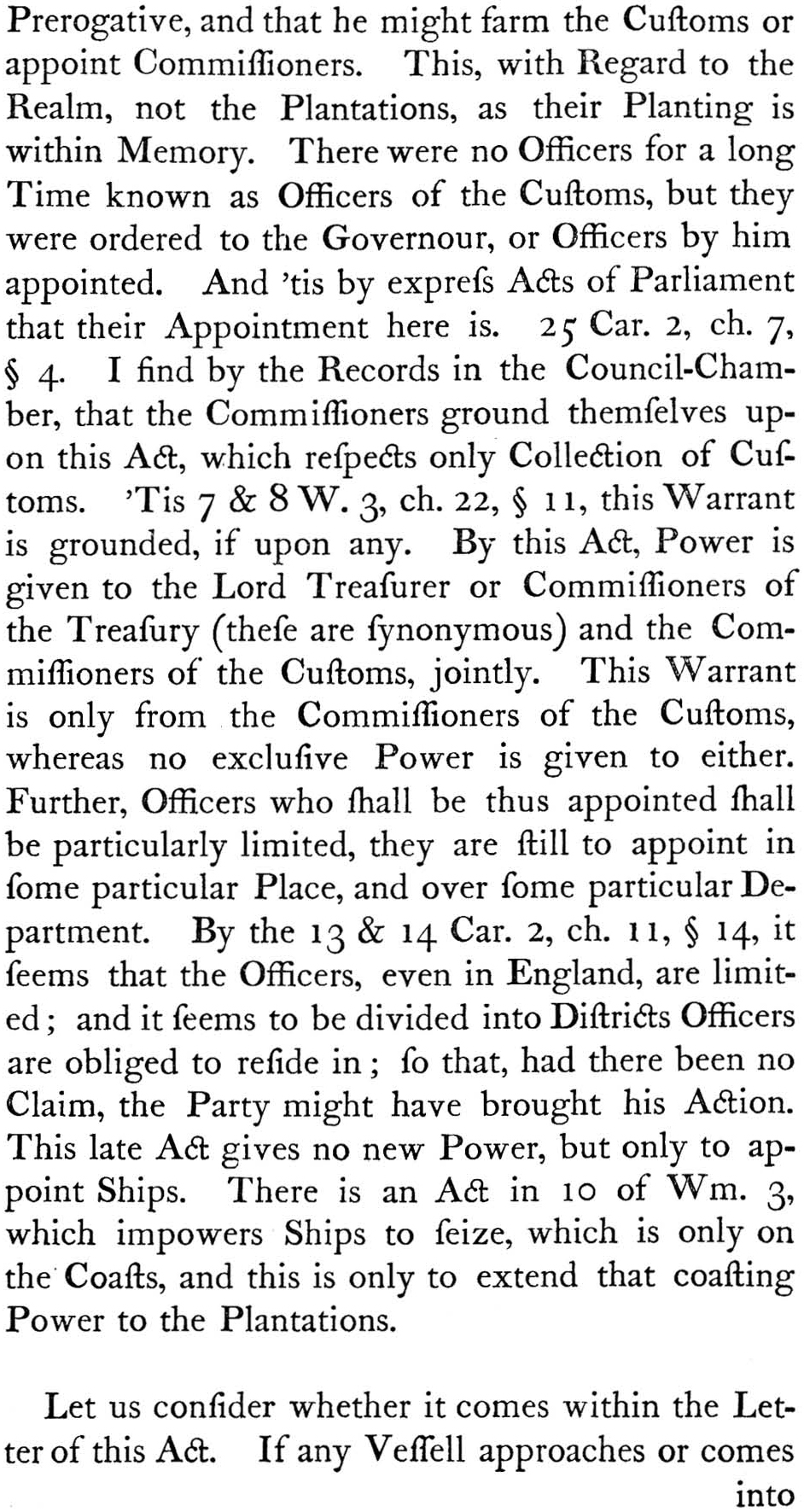
[P. 390]
So it came down to an issue of presumption. Certainly there was no proof “beyond a reasonable doubt,” or even a “preponderance of the evidence” that the brig was smuggling, and all facts shown were consistent with the alibi. On the other hand, to allow a ship like the Freemason to hang around Boston Harbor and try to catch it smuggling “in the act” of landing put an impossible burden on the customs officers. John Hancock was a past master of “landing goods before entry,” with whole cargoes of Madeira wine vanishing in thin air, and half-empty ships reporting into Boston, with stories of throwing wine overboard in storms, etc. See Doane v. Gage (1766–1769) in the legal papers of Hancock’s excellent lawyer, John Adams, Legal Papers of John Adams, supra, vol. 2, 68–97 (Case No. 43). As Governor Bernard observed, if this were the law, “it would be impossible to prevent foreign European goods coming into America” and “it would be necessary to apply to Parliament for an amendment of the 15th of Char. 2.” Reports, 393, S. Quincy n. 4; Bernard Papers, supra, vol. 1, 446.
Of course, the loyal Vice-Admiralty Judge and Tory, Chambers Russell, had little problem in finding that landing was not essential to violating the Act. There may have been convincing evidence of fraud. Bernard’s letter stated that the brig gave the wrong information, when hailed in passing “by the Man of War’s barge,” and that the “Master’s report of his Cargo . . . in the court of the trial was falsified.” Id., 393, S. Quincy n. 4. But such evidence was not mentioned by either side in the argument, and without evidence of fraud, the statutory construction arguments of Thacher and Gridley seem compelling. “Importation” requires an intent to actually import, i.e., land the goods. The correct legal solution was probably to let off the Brig Freemason and, as Bernard suggested, redraft the statute. See Bernard Papers, supra, vol. 1, 445–446.
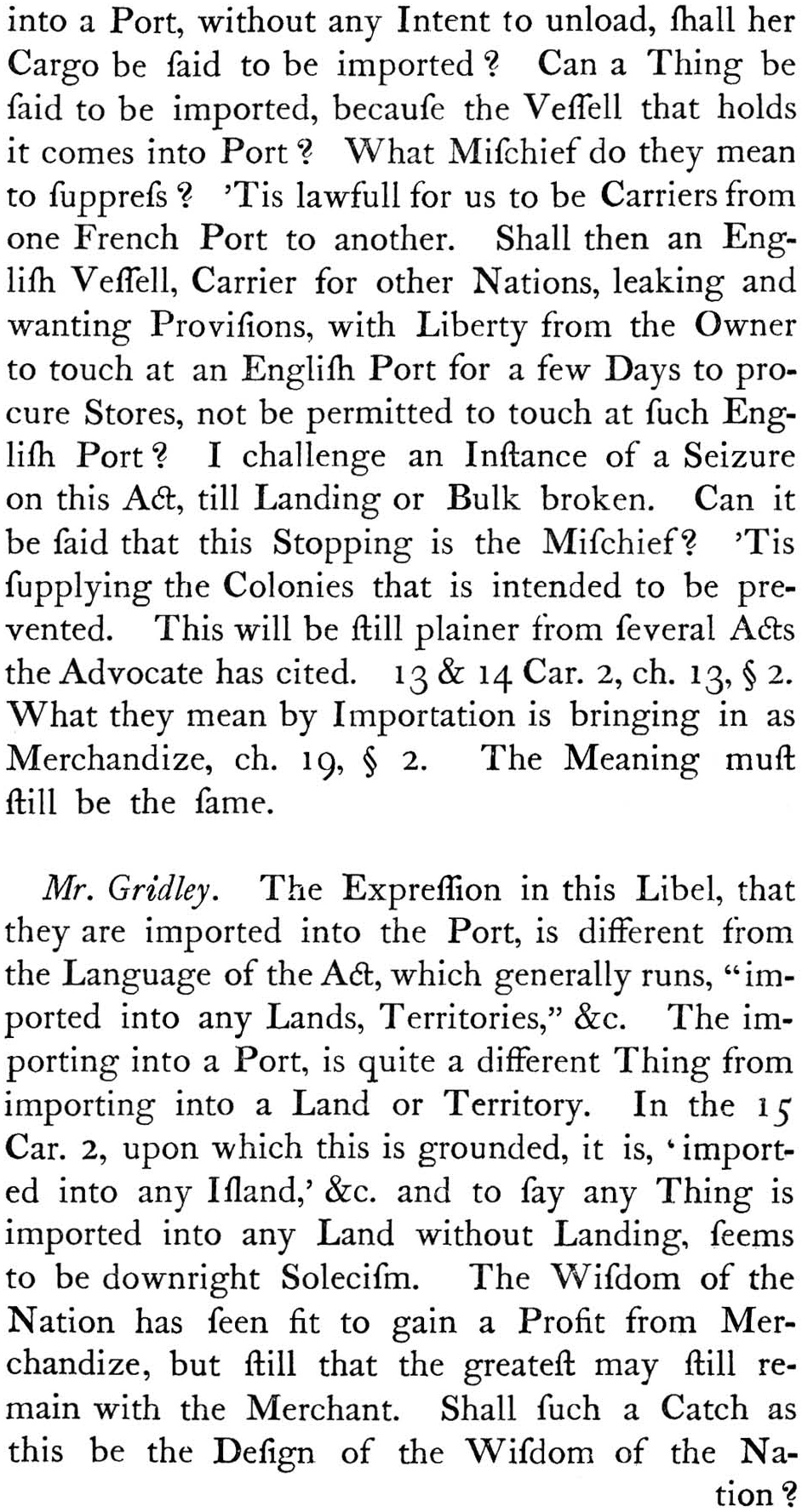
[P. 391]
[P. 392]
[P. 393]
[P. 394]

